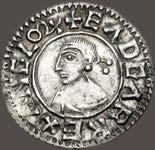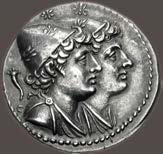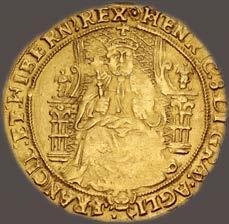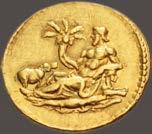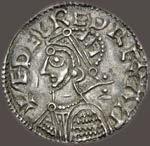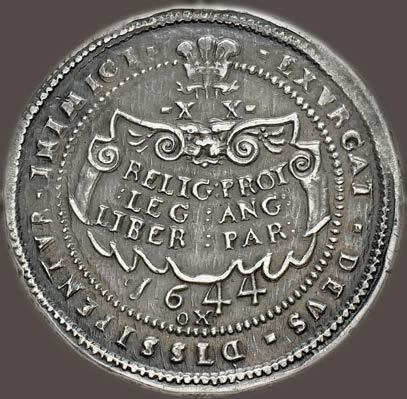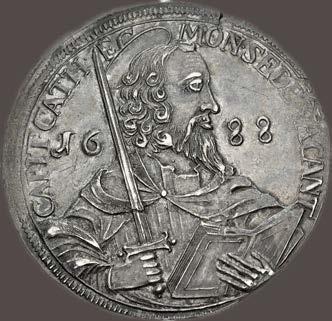CNG Feature Auction 127
September 17-18, 2024




September 17-18, 2024



To Be Conducted Live Online at the CNG Lancaster Office
Featuring:
Ancient Coins from the Ramrodivs, Dr. Adrian Carr, Wayne Scheible, and Richard J. Sullivan Collections
Selections of Ancient and World Coins from the Gerald F. Borrmann Collection
Four Dekadrachms of Syracuse
An Extremely Rare Oešo (Siva) Reverse Dinar of Vasudeva I
Further Selections of Alexandrian Coins from the Dr. Thomas E. Beniak Collection
Roman Republican Coins from the 1930s Collection of Robert W. Hubel
Further Selections of the Coinage of Carausius from the Dr. Malcolm Lyne Collection
World and British Coins from the Collection of Alexander Christopher
Genoa Zecchino of the Biennial Doges
United States Coins and Ingots from the Samuel K. Clark Collection
The Sidney W. Harl and Kenneth W. Harl Collection of Anglo-Saxon, Norman, and Scandinavian Coinage
A 1644 Cartouche Pound of Charles I
PO Box 479, Lancaster, PA 17608-0479
Phone (717) 390.9194 Fax (717) 390.9978
Noordeinde 64a, 2514GK, The Hague, NL
Classical Numismatic Group, LLC

20 Bloomsbury Street, London WC1B 3QA, UK Phone +44.20.7495.1888 Fax +44.20.7499.5916
Phone +31.851.301.541 EMAIL &
Email cng@cngcoins.com Website www.cngcoins.com
Proof Polierte Platte
Mint State/Uncirculated Stempelglanz
Extremely Fine (EF) Vorzüglich
Very Fine (VF)
Fine
Flan Bruni Fondo Specchio
Fleur de Coin Fior di Conio
Superbe
Sehr Schön
Splendido
Très Beau Bellissimo
Schön Beau Molto Bello
Good/Fair Gut
AD Anno Domini
Bien
Bello
BE Bithynio-Pontic Era IY Indictional Year
Æ Bronze BI Billon MBS Mail Bid Sale
AE Actian Era CE Common Era mm Mintmark
AH Anno Hegirae
Cf. Confer (compare) PB Lead
AR Silver c/m Countermark p. Page
AV Gold CY Civic Year (Era) pl. Plate
BBS Buy or Bid Sale
EL Electrum RPE Roman Provincial Era
BC Before Christ FPL Fixed Price List RY Regnal Year
BCE Before the Common Era g Gram SE Seleukid Era
See Bibliography on our website, www.cngcoins.com, for a complete list of reference abbreviations.
Beneficiary: Classical Numismatic Group, LLC
US$ Account:
PNC Bank, N.A.
249 Fifth Ave., Pittsburgh PA 15222
Account Number: 5005069595
ABA Number: 031000053
BIC or SWIFT: PNCCUS33
€ Account:
HSBC Bank plc
60 Queen Victoria Street, London EC4N 4TR
Account Number: 84309198
Sort code: 40 12 76
IBAN: GB82HBUK40127684309198
BIC or SWIFT: HBUKGB4B
£ Account:
HSBC Bank plc
60 Queen Victoria Street, London EC4N 4TR
Account Number: 71170910
Sort code: 40 11 60
IBAN: GB45HBUK40116071170910
BIC or SWIFT: HBUKGB4B
Classical Numismatic Group, LLC is a United States limited company. Auction license number AY002406. United Kingdom Registration No. FC035702, Branch No. BR020787.
All lots in this auction were in the possession of CNG in CNG’s Lancaster, Pennsylvania office no later than 1 August 2024. This information is provided for the protection of buyers in the event that US import restrictions are introduced subsequent to that date on any of the types of coins that are included in this auction.
Coins that have been encapsulated (“slabbed”) by a grading and/or authentication service may not be returned for any reason, including authenticity, if they have been removed from the encapsulation (“slab”).
CNG would like to thank Jan Moens (jan.moens@bvdmc.com) for creating and providing the Numismatica Medievalis font used in this sale.
This is a public and Internet auction conducted by Classical Numismatic Group, LLC (CNG). Bidding in the auction constitutes acceptance of the following terms:
1. The property listed in this catalogue is offered for sale by CNG for itself and as agent for various owners and other consignors. We reserve the right to reject any bid, to determine the opening price, to set bidding increments, to vary the order of the auction, to reopen bidding in the case of a dispute, to withdraw any lot, to bid on behalf of CNG, to bid on behalf of the consignor, to permit the auctioneer to bid on his own behalf, and to permit the consignor, where reserves have been agreed, to bid on his own lots. CNG may loan or advance money to consignors or prospective bidders, and may have an interest other than commission charges in any lot. CNG may bid on its own account as an “insider” with information not available to the public.
2. A buyer’s fee will be charged to all successful bidders as follows on the hammer price:
A. 25% for written, fax, email, and telephone bids.
B. 22.5% for floor bids placed in person at the auction and electronic bids placed directly on www.cngcoins.com. All written bids, email bids, nonlive telephone bids, live internet bid registrations, and live telephone bid registrations must be received before 5PM Eastern time on the day before the auction begins. CNG reserves the right to change the format of www. cngcoins.com at any time.
3. All coins are guaranteed genuine. Attribution, date, condition, and other descriptions are the opinion of the cataloguer, and no warranty is expressed or implied. Please note that an auction sale is not an approval sale. Lots examined prior to the sale and lots purchased by floor bidders (including bidders executing commission bids on behalf of other parties) may not be returned for any reason except lack of authenticity. All claims of misdescription and all claims of return, except claims regarding authenticity, must be made within 5 days of receipt of material. No refund will be provided due to grade or “adjectival” comments by a third party grading service if a coin is submitted for grading after the sale. Any claim of lack of authenticity must be made in writing by the original purchaser immediately after discovery that an item is not authentic, and upon making such a claim the original purchaser must immediately return the lot to CNG in the same condition as at the time of the auction. Any coin returned as “not authentic” which CNG feels is genuine will be submitted to the International Association of Professional Numismatists Authentication Bureau (IBSCC) for final decision of authenticity. No refund shall be made on such coins until the IBSCC makes their determination. This includes coins that have been submitted to a third-party grading service after the auction. Coins that have been previously encapsulated (“slabbed”) by a grading and/or authentication service may not be returned for any reason, including authenticity, if they have been removed from the encapsulation (“slab”). If payment is made by credit card, rights of return are governed by these Auction Terms which supersede any rights of return promulgated by the card issuer. Estimates are intended as a guide only and not as a statement of opinion of value.
4. Invoices are due and payable immediately upon receipt. Interest and late fees of 2.0% per month, or at the highest rate permitted by law, whichever is less, from the date of the auction, shall be payable on invoices not settled within 30 days of the auction date. Payment may be made by check or bank wire. Credit cards (Visa or MasterCard) will be accepted; credit card payments will not be accepted more than 14 days after the sale date. Payment by credit card for printed sale auctions will be charged a 2.5% handling fee. Payment by check must be made in either US dollars ($) drawn on a US bank or British sterling (£) drawn on a British bank. All successful bidders outside North America and the United Kingdom will be charged an additional $20 fee for bank charges that are the result of international wire transfer fees; this fee will be deducted for credit card or check payment as described above. CNG may reduce or compromise any charge or fee at its discretion.
5. Bidders not known to us must provide us with satisfactory credit references or pay a deposit as determined at CNG’s discretion before bidding. Minors are not permitted to bid without written consent of a parent guaranteeing payment. CNG may require payment in full from any bidder prior to delivery of lots. Title does not pass until lots are paid in full. Upon receipt of lots, the buyer assumes full responsibility for loss or damage. Delivery to the buyer’s address of record shall constitute receipt by the buyer regardless of the identity of the person accepting delivery.
6. Estimates are in U.S. dollars ($US) and bids must be in even dollar ($) amounts. CNG will execute mail bids on behalf of mail bidders. Subject to reserves and opening prices, mail bids will be executed at one bidding increment (approximately 10%) over the next highest bid. In the case of identical bids, the earliest bid wins. A mail bid has priority over an identical floor bid. Bid by lot number. No lots will be broken. Bidders are responsible for errors in bidding. Check your bid sheet carefully.
7. All lots are subject to reserve unless otherwise indicated.
8. Bidders personally guarantee payment for their successful bids, including bidders executing commission bids from other parties and bidders representing corporations or other entities. Buyers accepting commission bids from other parties do so at their own risk and remain responsible for payment under these Auction Terms.
9. At the conclusion of bidding for each lot, the sale contract is concluded and the successful bidder becomes liable for immediate payment under these Auction Terms. In the event a successful bidder fails to make full payment within 30 days of the auction date, CNG reserves the right either: (a) to require payment as provided under these Auction Terms; or (b) to deem the sale incomplete and to re-auction the material, in which case the successful bidder agrees to pay for the reasonable cost of such a sale and also to pay any shortfall between the re-auction price and the successful bidder’s purchase price. CNG reserves all rights that it is entitled to under the Pennsylvania Uniform Commercial Code, including the right to offset any sums due from a successful bidder against any future consignment or purchase or monies or goods in possession of CNG.
10. Sales tax, postage, handling and insurance are the responsibility of the buyer and are added to all invoices where appropriate. For buyers in the United Kingdom, CNG may import lots into the United Kingdom prior to shipment and charge buyers the import Value Added Tax. On any tax not paid by the purchaser which should have been paid, even if not invoiced by CNG, the purchaser agrees to pay the same on demand together with any interest or penalty that may be assessed. It is the responsibility of the buyer to comply with foreign customs and other regulations.
11. Prices realized are published after the sale and are mailed with CNG’s next publication. Prices realized are also posted after the sale on CNG’s web site: www.cngcoins.com
12. Bidders hereby waive any claim for incidental, consequential or exemplary damages arising from this auction. The sole remedy that any participant in the auction shall have for any claim or controversy arising out of the auction shall be a refund, without interest, of all or part of the purchase price paid by the participant.
13. All rights granted by CNG or otherwise available to bidders and purchasers, under these Auction Terms or otherwise, are personal and may not be assigned or transferred to any other person or entity, whether by operation of law or otherwise. No third party may rely on any benefit or right conferred by these Auction Terms. Bidders acting as agents must disclose the agency in writing to CNG prior to the auction; otherwise rights are limited to the agent and are not transferable to the undisclosed principal.
14. Any dispute regarding this auction shall be governed by the laws of Pennsylvania and shall be adjudicated only by the Lancaster County Court of Common Pleas or the U.S. District Court for the Eastern District of Pennsylvania; all bidders submit themselves to the personal jurisdiction of these courts for this purpose, consent to service of process by registered or certified mail, and waive any contrary provisions of Articles 14 or 15 of the French Civil Code and any similar provisions in any jurisdiction. All bidders consent to the confidentiality of consignors’ identities and waive any right to require disclosure of the name of the consignor or owner of any auction lot, whether such right is based on New York GOL §5-701(a) or any other provision in any jurisdiction. In any dispute regarding this auction, the prevailing party shall be entitled to recover its reasonable costs and attorney fees.

Mike Gasvoda Managing Director
Lancaster Office

Bill Dalzell Managing Numismatist Cataloging Staff
Lancaster Office

Bradley R. Nelson Senior Numismatist
Lancaster Office

Tom Mullally Numismatist
Lancaster Office

Victor England Consulting Director Lancaster Office

Lance Hickman Managing Numismatist Consignment Staff
Lancaster Office

D. Scott VanHorn Senior Numismatist
Lancaster Office

Steve Lloyd Numismatist Islamic Specialist London Office

Eric McFadden Consulting Director
London Office

Paul Hill Director, London
London Office

Caroline Holmes Numismatist
London Office

Julian Okun-Dubitsky Numismatist
Lancaster Office

Dave Michaels Director Shows & Consignments Lancaster Office

Max Tursi Director, EU EU Office

Jeffrey B. Rill Numismatist
Lancaster Office

Daniel Burch Numismatist
Lancaster Office

Katie Vint Numismatist Lancaster Office

Christian Ventura Photographer Lancaster Office

Sharon Pruzinsky Accounting Lancaster Office

Lynn Gasvoda Administrative Assistant Lancaster Office

Kan Liu (Vera) Consignments and Marketing Lancaster Office

David James III Photographer Lancaster Office

Kate Rill Customer Relations Manager Lancaster Office

Carrie Muller Shipping Lancaster Office

Steve Pruzinsky Chief Financial Officer Lancaster Office

Jennifer Ventura Interim Office Manager Lancaster Office

Julia Motter Shipping Lancaster Office

Travis Markel Manager IT & Production Lancaster Office

Dylan Ossman Interim Office Manager London Office

Dawn Ahlgren Shipping Lancaster Office
With the CNG Bidding Portal, you can:
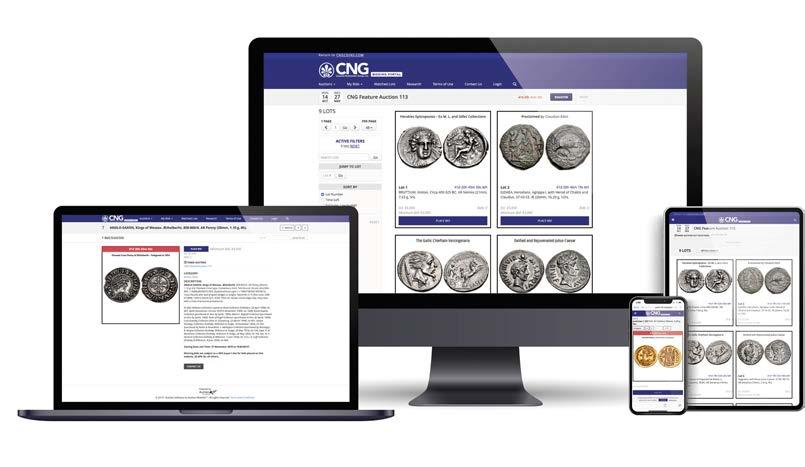
• Log on and bid at any time at auctions.cngcoins.com
• View the lots, follow the bidding, and see hammer prices as they are sold
• Hear and see the auctioneer live
• Enjoy all the advantages of an auction room bidder to win your favorite lots To bid live in this Feature auction:
• Visit our new Bidding Portal before the auction at auctions.cngcoins.com
• Register online with your email address and a password
• Once approved, you may place pre-bids up until the moment the lot opens in the auction room
• On the auction day, login to join the auction and participate live
Please Note
• If you have not already registered for our bidding platform, you must create a new registration at auctions.cngcoins.com/register. Your old cngcoins.com handle and password will not allow you to log on or bid.
• You must register to bid before 5PM EST on Monday, September 15, 2024
• All lots won through the CNG Bidding Portal will be subject to a 22.5% buyer’s fee
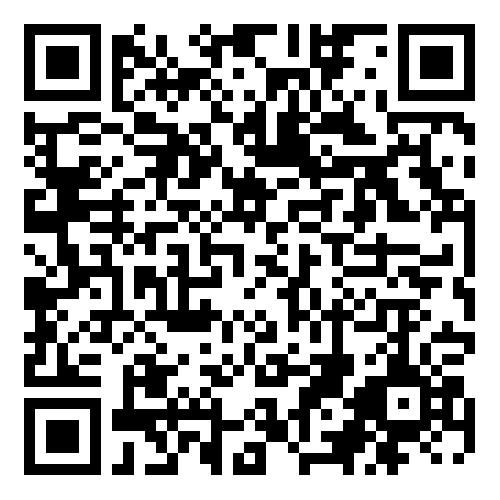
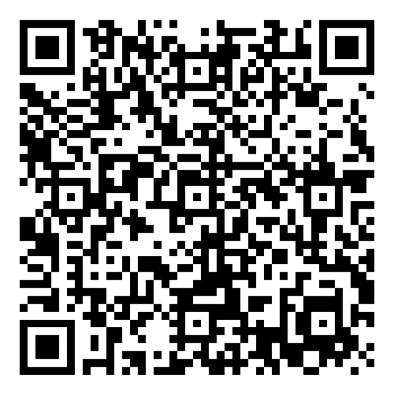




Lancaster, PA
Auction lots may be viewed at our Lancaster Office from August 19 – September 17, 2024, by appointment only Lancaster Office Hours: 10 AM - 5 PM (Monday - Friday).
Enlargements of all single lots and selected multiple lots may be viewed on the internet at

We are sorry, but photographs of individual coins in multiple lots cannot be provided.
This Sale will be conducted live Online from our Lancaster, PA Office
Lots will be mailed from our Lancaster, PA Office subsequent to the sale
Session One – Tuesday Morning – September 17 – 9:00 AM
Celtic Coinage
Greek Coinage Coinage
Oriental Greek Coinage
Session Two – Tuesday Afternoon – September 17 – 2:00 PM
Central Asian Coinage
Roman Provincial Coinage
The Beniak Collection of Alexandrian Coinage
The Robert W . Hubel Collection, Assembled 1929-1939
Roman Republican Coinage
Roman Imperial Coinage – Part 1
Session Three – Wednesday Morning – September 18 – 9:00 AM
Roman Imperial Coinage – Part 2
Byzantine Coinage
Early Medieval Coinage
Coinage
The Gerald R . Borrmann Collection of Hawaiian Numismatics
942–944
945–962
Session Four – Wednesday Afternoon – September 18 – 2:00 PM
United States Coinage
United States Silver Ingots
The Sidney W . Harl & Kenneth W . Harl Collection
British Coinage
British Medals
963–981
982–984
985–1156
1157–1247
1248–1249
Electrotypes 1250
Antiquities 1251
Sidney Wayne Harl (January 25, 1924-September 15, 2016)
Sidney Wayne Harl, a native of Illinois and veteran of the Second World War, arrived in New York as a CPA in 1948, and he quickly became a confirmed New Yorker. A year later, he married his beloved wife Virginia Anne Harl, née Mondante (July 9, 1922-February 3, 2006), a native of Glen Cove, Long Island. Sidney began collecting coins of the British Empire in 1958, but he soon focused on the English Medieval hammered pennies after he acquired his first coin of William the Conqueror from Coin Galleries. He passionately collected and studied AngloSaxon, Norman, and Angevin pennies in tandem with his study of English history. He was a long term member, fellow, and donor of the American Numismatic Society and a member of the British Numismatic Society. In his later years of retirement in New Orleans, he commenced collecting Roman Imperial and Byzantine coins, but his first love was always the Anglo-Saxon and Norman pennies. His son, Kenneth Wayne Harl, Professor Emeritus of Classical and Byzantine History at Tulane University, inherited the collection and added many of the Viking pennies of York and the contemporary Scandinavian coins in honor of his father’s memory. Given his age and health, Professor Harl, who is still an active scholar in Roman history and numismatics, has decided to return this splendid collection to market with the assistance of Classical Numismatic Group. In his opinion, neither he nor his father really owned the coins, they were merely the guardians of the coins in their lifetimes, and so it is time to entrust the coins to new guardians who will protect, study, and enjoy them as they had.


Robert William Hubel was born in Berlin, Germany in 1891. He emigrated to the United States ca. 1903. He was educated as an architect in New York and then settled in Detroit, Michigan. In 1917 he joined the firm of Albert Kahn in Detroit and rose to the position of chief designer and partner in the firm. He participated in the design of many commercial and industrial buildings including the famous Ford Rotunda which was built for the 1933 World’s Fair in Chicago.
Robert soon became an avid coin collector, acquiring his first ancient coin in 1929. He purchased coins from Stack’s in New York and many of the leading European dealers of the time including Otto Helbing, Adolph Cahn, Adolph Hess, Leo Hamburger, and Spink. Illness curtailed his collecting, and he seems to have made his last purchase in 1939. However, he remained active, apparently attending the 1940 convention of the American Numismatic Association held in Detroit. His family still retains his 1940 convention badge.
Robert’s collection was broad in scope, incorporating high quality Greek and Roman coins in gold, silver, and bronze. But his primary focus was on the Roman Republican series. His collection of these coins was quite comprehensive, including almost 600 silver and 150 bronze coins with many in superb condition.
After Robert’s death in 1944, the collection passed to his son, Roaul Robert Hubel, who stored the collection away and added nothing to it as he was not a coin collector. Upon the death of Roaul and his wife Dorothy, the collection passed to a family trust where it has remained until the present day. This is how the collection came to CNG as we have been granted the opportunity to present this collection for auction, with the first portion of the collection appearing in this sale. Further portions of the collection will be placed in auctions through the coming year. The coins all have wonderful old cabinet toning, as expected from a collection that has sat intact for more than 85 years. We are certain the collecting community will cherish these coins as much as we have enjoyed cataloging them. We thank the Hubel family for their confidence in Classical Numismatic Group.
I was born on July 30, 1947 in Milwaukee, Wisconsin to parents Edward Beniak and Evelyn Stodola Beniak. My childhood and adolescent years were spent in Cudahy, Wisconsin, a suburb of Milwaukee on the shores of Lake Michigan. I attended Cudahy public schools through high school, graduating in June of 1965. Following in the footsteps of my grandfather and father, I matriculated to Marquette University, graduating cum laude with an A.B. degree in psychology in May of 1969. I was fortunate to be accepted into the University of Minnesota’s doctoral training program in Clinical Psychology, beginning my studies in the Twin Cities in September, 1969.

Always a responsible student, college and particularly graduate school left little time if any for the hobbies I had enjoyed beginning in early childhood. Spare time in high school was largely consumed by interscholastic athletics. During college and graduate school, athletics were very limited and purely recreational. In retrospect, it was easy for me to identify a genetic pre-disposition to collect beginning with stamps and then the US coins that could be gleaned from circulation in the 50’s and 60’s. Thanks to the Stamp and Coin Department in Gimbels’s downtown store, occasional exotic foreign coins and perhaps even an ancient coin or two made the journey from New York to downtown Milwaukee and would catch my eye.
Acquiring my first ancient coin and the story behind it remain vivid in my memory. My maternal grandparents grew up on farms near Rice Lake, Wisconsin surrounded by lakes and the north woods. The highlight of each summer was to visit relatives there especially my two great uncles. Otto, the older of the two had enlisted in the Army in 1942 at 44 years of age to prevent his younger brother from being drafted. As fortune would have it, he ended up in a combat engineering outfit and traversed much of North Africa, Sicily, and the entire Italian peninsula. In June of 1959 while looking through Uncle Otto’s penny and dime jars, he blurted out “I think I’ve got a more interesting coin for you from Italy!” It came with an interesting story. His unit was assisting a British combat engineering unit clearing debris near Rome. In doing so, a clay pot was bulldozed spewing coins all over. British soldiers filled their pockets and later shared them with their American comrades and that’s how I got my first ancient coin, a beautiful extra fine sestertius of Phillip I with elephant and mahout reverse. Of course, it took me 13 years and a visit with Harlan Berk at the 1972 Central States Show to find out what it was.
Graduate studies allowed little time for hobbies. My academic interests and professional goals drifted away from traditional clinical psychology toward a relatively new subspecialty, clinical neuropsychology. Concerns over personality disorders and psychopathology were set aside and neurological disorders/patients became my focus along with how to evaluate the cognitive effects and deficits of same. Upon completion of my doctorate, I accepted a staff position at the University of Minnesota Medical Center and remained there for 10 years, working primarily with epilepsy patients, especially surgical candidates. In April of 1987, I continued this work in private practice. I also developed an active forensic neuropsychology practice which grew considerably after retiring from the university in 2015. Complete retirement essentially came on the heels of the COVID epidemic.
Despite working many long hours at my profession, I always found time to return to and indulge in my earlier passions including a love of history, classics (fostered by my father), and of course numismatics which now focused entirely on ancient coins.
Family life was also very important to me. In August of this year, my wife, Judith and I celebrated our 51st wedding anniversary. Originally trained as a nurse, Judith retired in 2017 after a long and very productive career at the University of Minnesota Academic Health Center. Her work there ranged from staff RN on the organ transplant service to the founding director of the Health Careers Center. Judith helped lead this innovative center recruiting and coaching pre-health students in their exploration of health careers for 15 years. We have two children, Alexander and Larissa. Alexander is involved in security technologies and Larissa is a medical social worker.
My return to active coin collecting, especially ancients, dates to 1972 at which time Greek silver and Roman denarii and sesterces were the focus. As of November 1984 and owning only one billon tetradrachm, I initiated the pursuit of all things Roman Egypt, this quest lasting to the present. My efforts have provided me with enormous enjoyment, satisfaction, and a wealth of knowledge. Along the way, I have also made countless friends from the ranks of both dealers and fellow collectors. Ongoing involvement in the Twin Cities Ancient Coin Club since 1974 has also contributed significantly. All have played an important role in building my collection and most importantly enjoying it. Thanks to you all.

Gerald “Jerry” Francis Borrmann was a remarkable man by any measure. He was born on June 15, 1928 as the son of Leo and Julia Borrmann, owners of a small San Francisco moving company. As he grew up in the Sunset district of San Francisco, he watched the Bay Bridge taking shape and dreamed of becoming a builder of bridges. As a boy, he began collecting coins and books, both of which became lifelong pursuits. In 1946, he earned entry into UC Berkeley, and two years later he met and married his soulmate, Carmen Wade, an athletic beauty who shared his passion for adventure, travel and collecting. He graduated with a BA in Civil Engineering from UC Berkeley in 1950 (later earning an MA in Structural Engineering), and began a career in that field before his country called him to duty in the U.S. Army. During the Korean War, as a 24-year-old second lieutenant, Jerry was entrusted with rebuilding a strategically vital bridge over the Han River near Seoul, during which he dodged snipers’ bullets. For this he earned the Bronze Star and Legion of Merit.
After the war, he joined the Earl and Wright firm and made key contributions to the San Rafael Bridge. In 1956, he joined Chevron and began a long career as an engineer in the energy industry, specializing in offshore drilling platforms, including the huge Chevron Ninian Central Platform in the North Sea. This challenging career sent Jerry, Carmen and their growing family to live abroad in locations all over the world, including the UK, Spain, and the Middle East. They established a second home on Maui, which became another mutual passion. Somehow, he also found time to be a Boy Scout troop leader and a solid club tennis player.
Jerry was an early member of the San Francisco Ancient Numismatic Society (SFANS), and as his collection grew from the 1950s forward his contributions to the monthly “show and tell” sessions began to resemble the highlights of a major museum collection. He made many fast friends among the club membership, who viewed him as a real-life Indiana Jones and were mesmerized by the accounts of his travels to exotic (and often dangerous) corners of the world, including Leptis Magna in Libya. Inspired by his personal explorations, his many sub-collections included all types and eras of Greek coinage, Persian and early Arabic issues, Roman Imperial coins, and finally the coins, currency and exonumia of Hawaii, his adoptive home.
His interest in early illuminated and printed manuscripts led to his acquisition of several pages of a medieval “Book of Hours” in England in the 1980s. After some intense research, he discovered that these pages were the missing section of a famous early work by Jean Fouquet, one of the greatest masters of the early Renaissance. He ended up making a partial donation of this priceless work to the J. Paul Getty Museum, where it still resides.
Jerry and Carmen have six children: Dianne Borrmann Slater, Dale Borrmann Fleming, Scott Borrmann, Diana Borrmann Chesser, Eric Borrmann, and Karen Borrmann Andrews; also, many grandchildren and great-grandchildren. Carmen passed away in 2020 and, after four years of mourning, Jerry followed her on May 25, 2024, just shy of his 96th birthday. A life better lived is impossible to imagine.
Jerry Borrmann has been a friend of Classical Numismatic Group’s for more than three decades. Starting with Triton XIV in 2010, Jerry began slowly selling his collection via Classical Numismatic Group’s Feature and Electronic auctions sectionby-section, using the pedigree line “From the Collection of a Northern California Gentleman.” His coins have included some of the most impressive Greek and Roman coins CNG has brought to market, and many bidders were intrigued as to who the “Northern California Gentleman” might be. The mystery may now be revealed. We are honored that his heirs have entrusted us with the core of his holdings, including his Western Greek, Persian, and Hawaiian collections, as well as several important historical manuscripts. These are being offered in CNG Feature Auction 127, Triton XXVIII (January 2025), and related Electronic Auctions.
Session 1 – Tuesday, September 17, 2024 — 9 AM



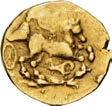
1. GAUL, Central. Arverni. 3rd century BC. AV Quarter Stater (12mm, 1.93 g, 1h). Besançon type. Imitating Philip II of Macedon type struck at Abydos under Philip III. Laureate head of Apollo left, five pellets on cheek and neck / Charioteer, holding kentron and reins, driving biga right; monogram below. Sills Group 3, Class 2, 73-9 var. (head right); Depeyrot, NC III, 115 var. (same); D&T 3012 var. (same). Lightly toned, minor scratches. VF. Extremely rare, unpublished with head left. ($2000)


2. GAUL, Northwest. Veneti. Circa 100-50 BC. BI Stater (23.5mm, 6.54 g, 4h). Celticized head right, hair flowing in tufts around; strings of pearls to right / Celticized biga right, charioteer devolved into creature above, holding a sword, horse with human head; below, hippocamp right. Depeyrot, NC VIII, 216; D&T 2306–7. Toned, porosity. VF. ($1000)
Ex Flesche Collection




3. GAUL, Northeast. Morini. Circa 60-30/25 BC. AV Quarter Stater (10mm, 1.51 g, 9h). Abstract image of boat with two riders right(?); pellet to left; all within border of small x-like ornaments / Central bar bisected by rooted tree; bent line below, crescent and three-pronged ornament in exergue. Scheers 116; Depeyrot, NC VI 295; D&T 249; Van Arsdell 69-1; SCBC 10; Flesche 226 (this coin). Lightly toned. Near VF. ($500)
Ex Christian Flesche Collection; Gorny & Mosch 164 (17 March 2008), lot 3.
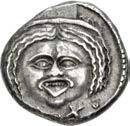


4. ETRURIA, Populonia. 3rd century BC. AR 20 Asses (22mm, 8.26 g). Diademed facing head of Metus; c/≈ (mark of value) below / Blank. EC Group XII, Series 47.120–55 (O13/R17); HN Italy 146. Attractive old collection tone, some marks under tone on edge. Good VF. ($1000)
From the Gerald F. Borrmann (Northern California Gentleman) Collection. Ex Classical Numismatic Review XXXIX.1 (Spring 2014), no. 975485; Stack’s Bowers and Ponterio 182 (10 January 2014), lot 5.


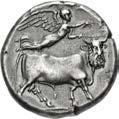

5. CAMPANIA, Neapolis. Circa 300 BC. AR Nomos (19.5mm, 7.29 g, 1h). Head of nymph right, hair in band; grape bunch behind neck, c before, s[tÅ] below / Man-headed bull standing right, head facing; above, Nike flying right, crowning bull; ˚ below. Sambon 472; HN Italy 579. Old cabinet tone, slightly compact flan. Good VF. ($750)
From the Gerald F. Borrmann (Northern California Gentleman) Collection.




6. CALABRIA, Tarentum. Circa 240-228 BC. AR Nomos (19.5mm, 6.47 g, 10h). Reduced standard. Warrior, holding Nike, who crowns him, on horse rearing right; t to upper left, ˚Ŭ¬5˚rÅ>t˙s in two lines below / Phalanthos, holding trident and Nike, who crowns him, riding dolphin left; " to right. Vlasto 965-6; HN Italy 1059. Lustrous, a hint of die wear. Superb EF. Fine style dies. Exceptional for issue. ($1000)
This remarkable nomos celebrates a military victory whose details are lost to us, struck at a time when the city was more or less subject to Rome. The cavalry rider on the obverse is depicted with exquisite detail, enabling us to determine he is likely a senior commander, or epihipparkos, abbreviated in the monogram in the upper left field. He is bearded and wears a short cuirass (linothorax, a modern term) with layered linen strips called pteryges at his waist. His ankle-high boots are equipped with spurs. Tarentum took great pride in its cavalry and honored its riders extensively on their coinage.




7. CALABRIA, Tarentum. Circa 240-228 BC. AR Nomos (19mm, 6.19 g, 10h). Reduced standard. Dioskouros, head facing, raising hand and holding rein, on horse stepping left; T and pileos to right; $E-@o˚rÅ>t˙-s in two lines below / Phalanthos, nude, head and torso facing, holding trident over shoulder and lifting drapery, riding dolphin left; to right, S above cuttlefish; waves below. Vlasto 959–61; HN Italy 1058. Old cabinet tone, with slight iridescence, traces of find patina, slight die wear. Near EF. Well centered. ($750)
Ex Robert L. Grover Collection (Superior, 11 June 1986), lot 877; Hess-Leu 31 (6 December 1966), lot 41.
Referenced by Noe – Pedigreed to 1911

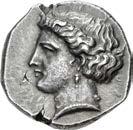


8. LUCANIA, Metapontion. Circa 400-340 BC. AR Nomos (22.5mm, 7.97 g, 5h). Head of Demeter left, wearing triple-pendant earring / Grain ear with leaf to right; ÂEtÅπo@t5@W@ upward to left, laurel leaf to right. Noe 524g (this coin); HN Italy 1545. Attractive old cabinet tone, minor die wear and tiny flan flaw in field on obverse. Near EF. Very rare, only three other examples in CoinArchives, all far inferior to this specimen. ($4000)
Ex Ars Classica XIII (27 June 1928), lot 88; J. Hirsch XXX (11 May 1911), lot 180.



9. LUCANIA, Sybaris. Circa 550-510 BC. AR Third Nomos – Drachm (18mm, 2.73 g, 12h). Bull standing left, head right; ¨µ in exergue / Incuse bull standing right, head left. S&S Class B, pl. XLVIII, 10–1; HN Italy 1736. Attractively toned, with golden hues around the devices, minor die break on reverse. Near EF. Excellent metal for issue. ($1000)
From the Gerald F. Borrmann (Northern California Gentleman) Collection. Ex CNG inventory 729533 (December 2001); Stack’s (4 December 2001), lot 47; Tkalec & Rauch (14 April 1986), lot 41.




10. LUCANIA, Thourioi. Circa 350-300 BC. AR Nomos (21.5mm, 7.59 g, 9h). Head of Athena right, wearing crested Attic helmet decorated on the bowl with Skylla throwing a stone, and sW on the neck guard / Bull butting right, head facing; above, Nike flying right, crowning bull with wreath, above EU; between hind legs, bird standing right. Cf. HN Italy 1843–5; SNG ANS –; SNG Ashmolean –; SNG Lloyd –; SNG Copenhagen 1463 var. (letters on rev.). Attractively toned, with golden hues around the devices, underlying luster. Near EF. Well centered and extremely rare. ($750)
Ex Classical Numismatic Group 46 (24 June 1998), lot 65.



11. LUCANIA, Velia. Circa 280 BC. AR Nomos (20.5mm, 7.53 g, 11h). Helmeted head of Athena left, helmet decorated with griffin; Å before crest, [f before neck], 5E within incuse square behind neck guard / Lion attacking stag left. Williams Period IX, 542 (O273/R379); HN Italy 1318; SNG Fitzwilliam 692 (same dies); SNG München 896 (same dies). Lovely old cabinet tone, traces of find patina, minor edge mark. Good VF. ($750)
From the Gerald F. Borrmann (Northern California Gentleman) Collection. Ex Paul Tinchant Collection [“Richard J. Graham”] (Schulman 243, 8 June 1966), lot 1061.

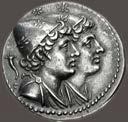


12. BRUTTIUM, The Brettii. Circa 216-214 BC. AR Nomos (20mm, 5.74 g, 6h). Reduced Tarentine standard. Jugate draped busts of the Dioskouroi right, wearing laureate pilei surmounted by stars; cornucopia and tiny ˝ to left / The Dioskouroi, wearing military attire and surmounted by stars, holding palm fronds over shoulder and raising right hand, on horses rearing right; spear below, ∫rEtt5W@ in exergue. Arslan dies 2/1’bis (this coin cited); HN Italy 1941; SNG ANS 2 (same dies); Basel 182 = Jameson 405 (this coin); Boston MFA 162 (same dies); de Luynes 655 (same dies). Attractive deep cabinet tone, small area of weak strike. EF. Exceedingly rare, with an extensive pedigree. ($20,000)
Ex A.D. Moretti Collection (Numismatica Ars Classica 13, 8 October 1998), lot 182; Hess-Leu [3] (27 March 1956), lot 286; Robert Jameson Collection (publ. 1913); William Harrison Woodward Collection; Theodor Prowe Collection (Part I, Egger [XVII], 28 November 1904), lot 138 (there noted as having been displayed in the Berlin Cabinet until 1902).
Hannibal’s invasion and long-term occupation of Italy (218-203 BC) during the Second Punic War led to a revival of coinage at some of the mints which had previously submitted to Rome in the early decades of the third century BC. Support for the Carthaginians was especially strong in Bruttium, and a league of the Brettii was formed at this time to oppose Rome’s attempts to recover control of the region. The Brettian League’s coinage commenced shortly after Rome’s catastrophic defeat at Cannae in 216 BC and continued until shortly before Hannibal’s departure from Italy. Lokri, which served as Hannibal’s principal port at this time, was probably the capital of this league down to the time of its capture by Publius Scipio (later Africanus) in 205 BC.
The coinage of the Brettian League was surprisingly extensive and exhibited considerable artistic merit. Silver was initially struck on the reduced Tarentine standard, with the main coin being a nomos-didrachm of about 5.8 grams: this exceedingly rare issue with a design depicting the “heavenly twins,” Castor and Pollux, on both sides. Intriguingly, the reverse depiction of the mounted Dioskouroi would soon be adopted by the Romans on their own silver denarius. Shortages of silver soon forced the Brettii to create a revised standard employing a drachm of about 4.7 grams along with a range of bronze denominations. After Rome’s victory in the Second Punic War, the Brettian League was forcibly disbanded and the cities subjected to harsh sanctions.



13. BRUTTIUM, Kroton. Circa 530-500 BC. AR Nomos (27mm, 7.28 g, 12h). Tripod, legs surmounted by wreaths and terminating in lion’s feet, two serpents rising inward from feet, set on basis of three lines, the center dotted / Incuse tripod as obverse, but no serpents. Gorini 1; Attianese 4; HN Italy 2075. Lightly toned, spots of roughness on reverse. Good VF. ($1000)
Ex Oslo Myntgalleri 15 (24 November 2018), lot 508; Gorny & Mosch 237 (7 March 2016), lot 1076.



14. BRUTTIUM, Kroton. Circa 425-350 BC. AR Nomos (21.5mm, 7.65 g, 1h). Eagle standing right, head left, on the edge of a cornice (in the form of a double exergue line) with dentils below; skull of goat(?) to right / Tripod with high neck surmounted by wreaths, legs terminating in lion’s feet; olive spray to right. Attianese 109; HN Italy 2147; SNG ANS 340; Basel 201 = Jameson 425 = Consul Weber 466; Boston MFA 184 = Warren 150; Kraay & Hirmer 268 = Regling, Antike 372; McClean 1699 (all from the same dies). Rich cabinet tone, with some iridescence, patches of find patina, a little off center, minor edge marks. VF. ($750)
From the Gerald F. Borrmann (Northern California Gentleman) Collection. Ex Kreisberg & Schulman (20 May 1966), lot 681.



15. BRUTTIUM, Lokroi Epizephyrioi. Circa 317-279 BC. AR Nomos (22.5mm, 7.81 g, 8h). Laureate head of Zeus left / Eagle, with wings spread, standing left on dead hare; thunderbolt to upper right. Spinelli Period II, Group V, 9.1 = Kraay & Hirmer 292 = GPCG pl. 31, 10 (same dies); HN Italy 2323; SNG Lloyd 641 (same dies); McClean 1492 (same dies). Attractively toned over underlying luster, a couple of scratches under tone, traces of undertype on reverse. Good VF. Fine style. ($1500)
From the Mesogeios Collection. Ex Belser Collection (Nomos 21, 21 November 2020), lot 56.
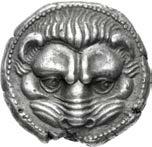


16. BRUTTIUM, Rhegion. Circa 420-415/0 BC. AR Tetradrachm (24.5mm, 17.04 g, 1h). Facing head of lion / Laureate head of Apollo right; olive sprig to left, r˙˝5@os to right. Herzfelder 65e (D37/R54 – this coin); HN Italy 2494; SNG ANS 658 (same dies); de Luynes 796 (same dies). Toned, some roughness and traces of find patina on reverse. VF. High relief. ($5000)
Ex Father & Son Collection (Classical Numismatic Group 118, 13 November 2021), lot 43, purchased from Art Ancient, 2015; Stack’s Bowers & Ponterio 185 (5 August 2014), lot 215; Conte Alessandro Magnaguti Collection (Part I, Santamaria, 12 October 1949), lot 251; J. Bougerol Collection (Bourgey, 7 June 1909), lot 117.
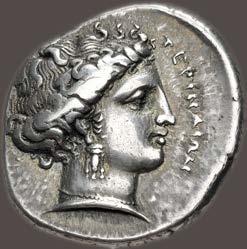



17. BRUTTIUM, Terina. Circa 400-356 BC. AR Nomos (19mm, 8.12 g, 12h). Head of the nymph Terina right, wearing triple-pendant earring and beaded necklace; tEr5@Å5W@ to right / Nike seated left on plinth, holding out right hand upon which a small bird alights, left hand resting on plinth. Regling, Terina 83 (dies OO/υυυ); Holloway & Jenkins 84 (same obv. die); HN Italy 2629; SNG ANS 852 (same obv. die); Weber 1155 (same dies). Attractively toned, a few hairlines, slight die wear on obverse. Good VF. Struck from dies of fine style. ($10,000)
Ex Jean P. Lambros Collection (J. Hirsch XXIX, 9 November 1910), lot 67; Frank Sherman Benson Collection (Sotheby, Wilkinson & Hodge, 3 February 1909), lot 164; Sir Edward Bunbury Collection (Sotheby, Wilkinson & Hodge, 15 June 1896), lot 242 (part of).
The high artistry evident on Terina’s coinage seems out of all proportion to any historical accounts for this city atop the “toe” of Italy, which so thoroughly disappeared from record that no systematic excavations were undertaken on its site until 1997. Its coinage has been known and collected since the Renaissance, where the delicate beauty of its female heads and the graceful seated Nikes were greatly admired. As author R. Holloway noted, “the nymphs of Terina recalled the maidens of the Parthenon frieze and the Victories of the reverses were the numismatic counterparts of the Victories of the Nike Temple balustrade.”
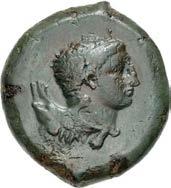
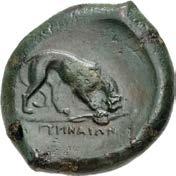
18. SICILY, Agyrion. Circa 339/8-317 BC. Æ Hemilitron (28mm, 24.43 g, 11h). Head of young Herakles (or Iolaos?) right, wearing tainia, lion skin tied around his neck / Panther standing right, gnawing on stag’s head held down by his foreclaws. Castrizio Series V, 1 (D1/R2); Campana 12; CNS 12; HGC 2, 50; Rizzo pl. LIX, 11; Virzi 730. Green-brown patina, a few spots of encrustation around edge, lightly brushed. VF. Rare. ($750)
Ex Classical Numismatic Group 121 (6 October 2022), lot 94.

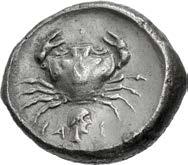

19. SICILY, Akragas. Circa 480/78-470 BC. AR Didrachm (18.5mm, 8.13 g, 5h). Sea eagle standing right / Crab; below, head of nymph right; all within incuse circle. Westermark, Coinage, Period I, Group IV, 260 (O87/R179); HGC 2, 99. Toned, patches of find patina around edge, minor flan flaw on obverse, slight doubling on reverse. Good VF. ($500)
Ex Leu Numismatik Web Auction 17 (14 August 2021), lot 110.
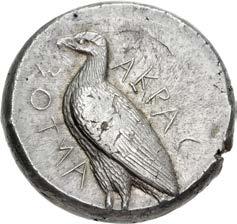



20. SICILY, Akragas. Circa 465/0–445/0 BC. AR Tetradrachm (25.5mm, 17.44 g, 4h). Sea eagle standing left / Crab within shallow incuse circle. Westermark, Coinage, Period II, Group I, 337 (O8/R27); HGC 2, 94; SNG Ashmolean 1670 (same dies); SNG Fitzwilliam 893 (same dies); SNG Lloyd 800 (same dies); Gulbenkian 158 (same dies). Toned, a few minor die breaks and tiny flan flaws. Near EF. ($2000)
From the Gerald F. Borrmann (Northern California Gentleman) Collection, purchased from Dr. Arnold Saslow, March 1985.


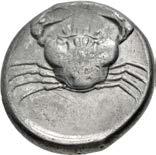
21. SICILY, Akragas. Circa 465/0–445/0 BC. AR Tetradrachm (26mm, 17.20 g, 2h). Sea eagle standing left / Crab within shallow incuse circle. Westermark, Coinage, Period II, Group I, 364 (O11/R45); HGC 2, 94; SNG München 70 (same dies); McClean 2017 (same dies); Pozzi 378 (same dies). Faintly toned, light porosity, minor lamination and die break on obverse, light scratch and slightly off center on reverse. VF. ($1500)
Ex Numismatic Naumann 110 (7 November 2021), lot 73 (hammer €2500).


22. SICILY, Akragas. Circa 415-406 BC. Æ Hemilitron (29.5mm, 22.40 g, 1h). Eagle, wings spread, standing right on, and tearing at, dead hare / Crab holding a serpent in its claw; six pellets (mark of value) around, octopus and conch shell below. Westermark, Coinage Period III, Series 2, 644 (2.O13/2:R21); CNS 17 (same dies as illustration); HGC 2, 133; SNG München 104 (same dies); McClean 2062 (same dies). Dark green patina, light earthen dusting, slight weakness to strike. VF. ($500)
From the Gerald F. Borrmann (Northern California Gentleman) Collection, purchased from Heritage, December 2013.




23. SICILY, Akragas. Punic occupation. 213-211 BC. AR Quarter Shekel (14mm, 1.53 g, 12h). Wreathed head of Triptolemos right / Free horse right; tH below; all within wreath. Walker Group I, dies II/1; CNP 117; HGC 2, 173. Old cabinet tone, traces of find patina, light scrape on edge, minor marks. Good VF. ($500)
Ex Virgil M. Brand Collection (Part V, Sotheby’s Zurich, 1 February 1984), lot 304; J. Hirsch XXXII (14 November 1912), lot 634.


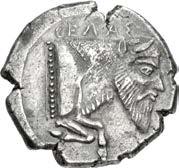

24. SICILY, Gela. Circa 465-450 BC. AR Tetradrachm (29mm, 17.00 g, 11h). Charioteer, holding kentron and reins, driving slow quadriga right; in background, column with Ionic capital set on plinth of two steps; in exergue, grain ear right / Forepart of man-headed bull right. Jenkins, Gela, Group III, 209 (O55/R112); HGC 2, 339. Old collection tone, edge splits, traces of find patina, minor die wear. Good VF. ($1500)
From the Gerald F. Borrmann (Northern California Gentleman) Collection, purchased from Nilus Coins, May 2011.



25. SICILY, Katane. Circa 450-445 BC. AR Tetradrachm (25mm, 16.98 g, 5h). Charioteer, holding kentron and reins, driving slow quadriga right / Head of Apollo right, wearing laurel wreath. Mirone 30–3; HGC 2, 566; SNG ANS 1245 (same dies); Rizzo pl. X, 1/2 (same obv./rev. dies). Old cabinet tone, light scratches and scuffs under tone on obverse. VF. Well centered and struck for issue. ($2000)
From the Gerald F. Borrmann (Northern California Gentleman) Collection. Ex CNG inventory 944835 (March 2013); Robert and Julius Diez Collection (Classical Numismatic Group Electronic Auction 294, 16 January 2013), lot 41; Gustav Philipsen Collection (Part I, J. Hirsch XV, 28 May 1906), lot 960.
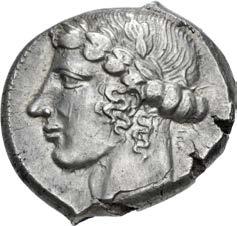

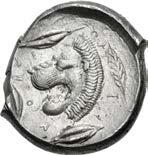

26. SICILY, Leontini. Circa 445-425 BC. AR Tetradrachm (25.5mm, 17.33 g, 9h). Laureate head of Apollo left / Head of roaring lion left; leaf with berry to right, three barley grains around. Maltese Period III, 121c (D30/R93 – this coin); Boehringer, Münzgeschichte 53 (same obv. die); HGC 2, 670 (same obv. die as illustration); BMC 39 (same dies); McClean 2339 (same dies). Lightly toned, some die wear, minor flan flaws. Near EF. ($2000)
Ex Berk BBS 68 (13 November 1991), lot 68.



27. SICILY, Messana. 420-413 BC. AR Tetradrachm (26mm, 17.34 g, 5h). The nymph Messana, holding kentron and reins, driving slow biga of mules left; two dolphins confronted in exergue / Hare springing left; below, grain ear left. Caltabiano Series XIV, 511 (D205’/R212); HGC 2, 790; SNG ANS 372; SNG Copenhagen 403 (same dies); SNG Lockett 823 (same dies); BMC 42 (same dies); Rizzo pl. XXVI, 8 = Kraay & Hirmer 55 (same dies). Iridescent tone, minor flan flaws on reverse. Good VF. ($2000)
From the Gerald F. Borrmann (Northern California Gentleman) Collection, purchased from Dr. Arnold Saslow, June 1986.

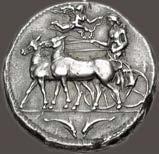

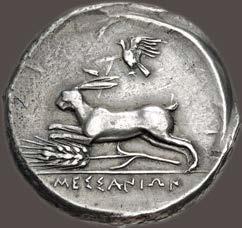
28. SICILY, Messana. 412-408 BC. AR Tetradrachm (25.5mm, 17.30 g, 8h). Charioteer, holding kentron in right hand and reins in both, driving slow biga of mules left; above, Nike flying right, crowning charioteer with wreath held in right hand and fillet in left; in exergue, two dolphins confronted / Hare springing left; above, dove flying left; below, grain ear left; µEssÅn5Wn in exergue. Caltabiano Series XVA, 624.2 (D223/R250 – this coin); HGC 2, 801; SNG Fitzwilliam 1081 (same dies); Davis 40 (same dies). Attractive old collection tone, minor scuff at edge on obverse, a little die wear and a few faint scratches on reverse. Good VF. A coin of considerable splendor, with a distinguished pedigree. ($10,000)
Ex Tradart (16 November 1995), lot 21; Armand Trampisch Collection (Vinchon, 13 November 1986), lot 71; J. Hirsch XIV (27 November 1905), lot 187.

Lot 29




Gelon I Lot 31
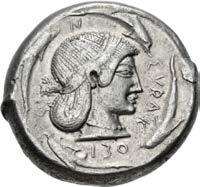
Hieron I
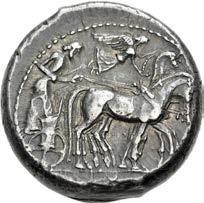
Second Democracy Lot 32


Hieron I Lot 37




Hieron I Lot 38

Hieron I Lot 33




Second Democracy Lot 34
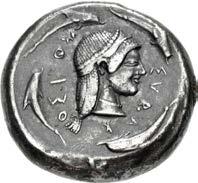
Hieron I

Second Democracy Lot 35

48 Agathokles Lot 39
Second Democracy
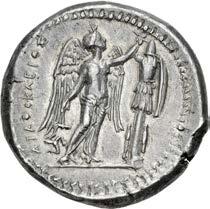

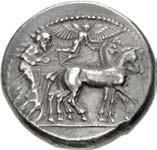
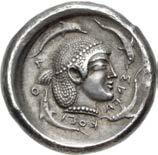

29. SICILY, Syracuse. Gelon I. 485-478 BC. AR Tetradrachm (24mm, 17.29 g, 4h). Struck circa 480-478 BC. Charioteer driving quadriga right; above, Nike flying right, crowning horses / Head of Arethousa right, wearing tainia and pearl necklace; four dolphins and saRa-˚os5-o-n around. Boehringer Series V, 59 (V31/R38); HGC 2, 1306; SNG ANS 14 (same obv. die); SNG Fitzwilliam 1174 (same dies); SNG Lockett 875 (this coin). Beautiful old cabinet tone, traces of find patina, a touch off center. Near EF. ($10,000)
Ex Richard Cyril Lockett Collection (Greek Part I, Glendining, 25 October 1955), lot 774; Ratto (4 April 1927), lot 393.



30. SICILY, Syracuse. Hieron I. 478-466 BC. AR Didrachm (21mm, 8.19 g, 10h). Struck circa 478-475 BC. Nude horseman riding right / Head of Arethusa right; three dolphins around. Boehringer Series VII, 99 (V46/R67); HGC 2, 1353; Jameson 748 (same dies); de Luynes 1158 (same dies); Pozzi 566 (same dies); Weber 1569 (same dies). Attractive collection tone, with golden hues around the devices, light horn silver. VF. ($1500)
From the Gerald F. Borrmann (Northern California Gentleman) Collection, purchased from Harlan J. Berk, 5 January 2014.
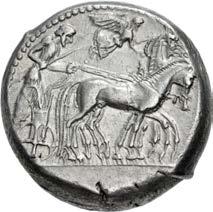



31. SICILY, Syracuse. Hieron I. 478-466 BC. AR Tetradrachm (23.5mm, 17.15 g, 11h). Struck circa 478-475 BC. Charioteer driving slow quadriga right; above, Nike flying right, crowning horses / Head of Arethousa right, wearing tainia; four dolphins around. Boehringer Series VIIIa, 104 (V48/R71); HGC 2, 1306. Faintly toned, a little die wear. Good VF. ($2000)
Ex Künker 382 (16 March 2023), lot 49.




32. SICILY, Syracuse. Hieron I. 478-466 BC. AR Tetradrachm (24.5mm, 17.29 g, 10h). Struck circa 478-475 BC. Charioteer driving slow quadriga right; above, Nike flying right, crowning horses / Head of Arethousa right, wearing tainia; four dolphins around. Boehringer Series VIIIa, 113 (V51/R78); HGC 2, 1306. Old collection tone, with some iridescence, slightly off center. VF. ($2000)
Ex Bertolami Fine Arts E-Auction 105 (21 October 2021), lot 716.




33. SICILY, Syracuse. Hieron I. 478-466 BC. AR Tetradrachm (24mm, 17.28 g, 11h). Struck circa 478-475 BC. Charioteer driving slow quadriga right; above, Nike flying right, crowning horses / Head of Arethousa right, wearing pearl tainia; four dolphins around. Boehringer Series VIIIb, 139.1 (V57/R86 – this coin, reverse illustrated on the plate); HGC 2, 1306. Old cabinet tone, minor flan flaws on reverse. Good VF. ($2000)
From the Gerald F. Borrmann (Northern California Gentleman) Collection, purchased from Abe Kosoff, 1966. Ex Tom Virzi Collection (J. Hirsch XXXII, 14 November 1912), lot 152.



34. SICILY, Syracuse. Hieron I. 478-466 BC. AR Tetradrachm (23mm, 17.23 g, 9h). Struck circa 478-475 BC. Charioteer, holding kentron and reins, driving slow quadriga right; above, Nike flying right, crowning horses with wreath / Head of Arethousa right, wearing pearl tainia, single-pendant earring, and necklace; four dolphins around. Boehringer Series XIa, 207E (V93/R139); HGC 2, 1306; Randazzo 368 (same dies); Triton XXIV, lot 116 (same dies). Attractive iridescent tone, light scratch on obverse. Good VF. Well centered. ($2000)
Ex Apollo to Apollo Collection; Peus 355 (27 April 1998), lot 656.



35. SICILY, Syracuse. Hieron I. 478-466 BC. AR Tetradrachm (23.5mm, 17.49 g, 1h). Struck circa 478-475 BC. Charioteer driving slow quadriga right; above, Nike flying right, crowning horses / Head of Arethousa right, wearing pearl tainia; four dolphins around. Boehringer Series IXa, 209.2 (V93/R144) = Bement 449 (this coin, reverse illustrated on the plate in Boehringer); HGC 2, 1306. Old cabinet tone, a little die wear on obverse, a few small scratches in field on reverse. Good VF. ($3000)
Ex Münzen und Medaillen GmbH 9 (4 October 2001), lot 90; Clarence S. Bement Collection (Naville VI, 28 January 1923), lot 449.



36. SICILY, Syracuse. Second Democracy. 466-405 BC. AR Tetradrachm (26.5mm, 17.08 g, 9h). Struck circa 466-460 BC. Charioteer driving quadriga right; above, Nike flying right, crowning horses; in exergue, ketos right / Diademed head of Arethousa right; four dolphins around. Boehringer Series XIVa, 479 (V255/R344); HGC 2, 1311. Faint iridescent tone, slightly off center, minor marks, area of weak strike on obverse. Good VF. ($2000)
Purchased by the consignor from Harlan J. Berk, Ltd.
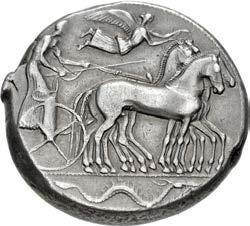
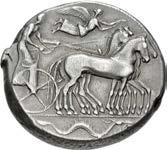


37. SICILY, Syracuse. Second Democracy. 466-405 BC. AR Tetradrachm (27.5mm, 17.13 g, 6h). Struck circa 450-440 BC. Charioteer driving quadriga right; above, Nike flying right, crowning hoses; in exergue, ketos right / Head of Arethousa right, wearing tainia; four dolphins around. Boehringer Series XVIb, 567 (V286/R385E); HGC 2, 1311; SNG Lloyd 1328 (same dies). Attractive old collection tone, with a slight iridescence around the devices, flan flaw on reverse. Good VF. ($2000)
From the Gerald F. Borrmann (Northern California Gentleman) Collection, purchased from Dr. Arnold Saslow, June 1986.

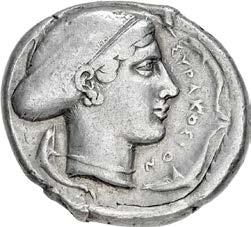

38. SICILY, Syracuse. Second Democracy. 466-405 BC. AR Tetradrachm (26mm, 17.03 g, 1h). Struck circa 430 BC. Charioteer driving quadriga right; above, Nike flying right, crowning horses / Diademed head of Arethousa right, hair in sakkos; four dolphins around. Boehringer Series XX, 644 (V327/R443); HGC 2, 1319; SNG Lloyd 1350 (same dies); BMC 113 (same dies). Toned, slightly off center, trace deposits, slightly off center on obverse, flan flaw on reverse. Good VF. Struck on a broad flan. ($1500)
From the Gerald F. Borrmann (Northern California Gentleman) Collection, purchased from Freeman & Sear, December 2008.
Signed Dies




39. SICILY, Syracuse. Second Democracy. 466-405 BC. AR Tetradrachm (26mm, 16.69 g, 6h). Dies signed by Euth– and Phrygillos. Nike as charioteer, holding reins, driving fast quadriga right; above, Nike flying left, crowning charioteer; in exergue, dolphin swimming right behind Skylla, holding trident, swimming right, E¨Q before / Wreathed head of Arethousa left; [frU]˝5¬¬/[os] in two lines below, four dolphins around. Fischer-Bossert, Coins 47 (V15/R29) = Tudeer 47; HGC 2, 1334; SNG ANS 274; SNG Ashmolean 1998 = SNG Lockett 969; SNG Lloyd 1382; Gillet 622; Gulbenkian 280; Hirsch 603; Jameson 801; de Luynes 1214–5; Regling, Antike 593; Weber 1603 (all from the same dies). Toned, porosity and roughness, bump on reverse, gouges on reverse. VF. ($2000)





40. SICILY, Syracuse. Dionysios I. 405-367 BC. AV 10 Litrai – Didrachm (9.5mm, 0.68 g, 7h). Struck circa 405 BC. Head of Athena left, wearing crested Attic helmet / Aegis with facing gorgoneion in center. Boehringer, Münzprägungen, pl. 1, 5; HGC 2, 1290 (Second Democracy). Some die rust on obverse. Near EF. ($3000)
From the Gerald F. Borrmann (Northern California Gentleman) Collection, purchased from Victor England, 27 March 1990.







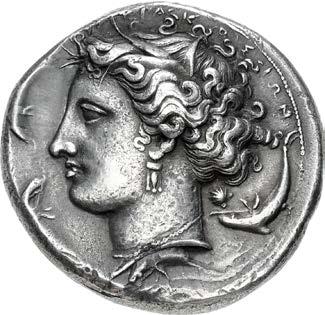


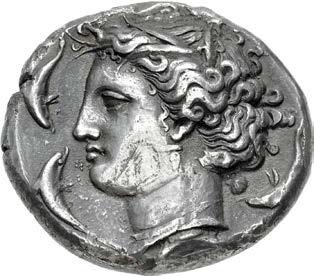


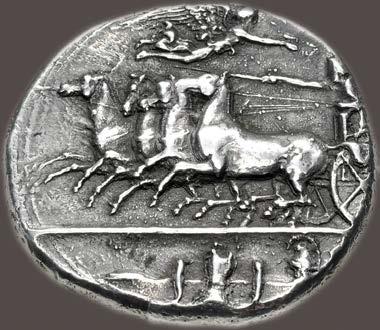
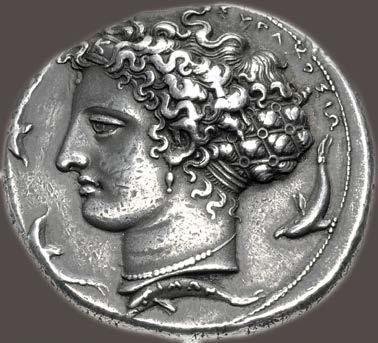

41. SICILY, Syracuse. Dionysios I. 405-367 BC. AR Dekadrachm (35mm, 43.34 g, 7h). Obverse and reverse dies signed by Kimon. Struck circa 405-400 BC. Charioteer, holding kentron in extended right hand and reins in left, driving fast quadriga left; above, Nike flying right, crowning charioteer with laurel wreath held in her extended hands; below heavy exergual line inscribed ˚5ÂW@ (only traces visible, as usual), a shield, greaves, cuirass, and Attic helmet, all connected by a horizontal spear; [ÅQ¬Å below] / Head of Arethousa left, wearing single-pendant earring and necklace, hair restrained in an ampyx, inscribed ˚, and open-weave sakkos; sUrÅ˚os5W behind hair, four swimming dolphins around, the bottom dolphin inscribed ˚5ÂW@. Jongkees 3 (dies A/γ); Scavino 3; Regling, Dekadrachmon 3; HGC 2, 1298; SNG Lockett 988; Basel 479; BMC 202–3; Boston MFA 432 = Warren 355; Dewing 869 = Bement 511; Gillet 645; Gulbenkian 303; Hunt III 27 = Gillet 646; Hunterian 64; Jameson 819; Kraay & Hirmer 118; de Luynes 1243; McClean 2734; Rizzo pl. L, 3; Pozzi 610; Ward 291; Weber 1612 (all from the same dies). Beautiful old collection tone, only a little of the usual die rust on obverse. Near EF. A masterpiece of the die engraver’s art. ($100,000)
Ex Dr. Orth Collection (Peus 380, 3 November 2004), lot 250; Hess-Leu 28 (5 May 1965), lot 90; Hess-Leu [3] (27 March 1956), lot 201.
Nothing is known about the personal life of the Syracusan master engraver Kimon, other than the approximate years he was active, circa 415-390 BC. The legacy of his art, however, is extensive and timeless. He worked in all the metals used for coinage – gold, silver and bronze – and left his distinctive signature (usually his full name KIMΩN or KI) on dies for denominations large and small. His unique style, the essence of classical beauty, and his attention to detail are apparent on all of his designs, whether a huge silver dekadrachm or a humble bronze fraction. All are masterpieces, but his most famous designs are his facing-head silver tetradrachm and the several dies he produced for the showcase coins of Syracuse, the immense silver dekadrachms struck circa 405-390 BC. The reverse (actually the “heads” side) of Kimon’s dekadrachm design features a highly individualized portrait of Arethousa, nymph of the spring of Ortygia, clearly modeled on a contemporary Greco-Sicilian woman. The head displays little of the idealization typical of his contemporary master engraver, Euainetos, and the details vary considerably from die to die. Her hair is bound in an elaborate jeweled net and a wide hairband, or ampyx, on which is placed the engraver’s initial K; a full signature is located on the dolphin below her neck. Kimon produced only six signed Arethousa dies for the dekadrachm series; another seven dies are in his distinct style, but without signature.



42. SICILY, Syracuse. Dionysios I. 405-367 BC. AR Dekadrachm (35mm, 42.27 g, 9h). Obverse and reverse dies signed by Kimon. Struck circa 405-400 BC. Charioteer, holding kentron in extended right hand and reins in left, driving fast quadriga left; above, Nike flying right, crowning charioteer with laurel wreath held in her extended hands; below heavy exergual line inscribed ˚5ÂW@ (only traces visible, as usual), a shield, greaves, cuirass, and Attic helmet, all connected by a horizontal spear; ÅQ¬Å below / Head of Arethousa left, wearing single-pendant earring and necklace, hair restrained in an ampyx and open-weave sakkos; sUrÅ˚os5W behind hair, four swimming dolphins around, the bottom dolphin inscribed ˚5ÂW@. Jongkees 4 (dies A/δ); Scavino 4; Regling, Dekadrachmon 4; HGC 2, 1298; SNG Monaco 1073 (same dies); SNG München 1073 (same dies); Rizzo pl. L, 4 (same dies). Toned, light cleaning marks, typical die rust and small scrape on obverse, area of light roughness and a few minor marks on reverse, a few minor bumps on edge. Good VF. ($30,000)
From the Gerald F. Borrmann (Northern California Gentleman) Collection, purchased from Frank Kovacs, February 1988. Reportedly ex Ed Gans Collection.



43. SICILY, Syracuse. Dionysios I. 405-367 BC. AR Dekadrachm (36mm, 42.88 g, 5h). Unsigned dies in the style of Euainetos. Struck circa 405-380/67 BC. Charioteer, holding kentron in extended right hand and reins in left, driving fast quadriga left; above, Nike flying right, crowning charioteer with wreath held in her extended hands; below heavy exergual line, [military harness, shield], greaves, cuirass, and crested Attic helmet, all connected by a horizontal spear; [ÅQ¬Å below] / Head of Arethousa left, wearing wreath of grain ears, triple-pendant earring, and pearl necklace; s-UrÅk-o-s-5W@ behind hair, shell behind neck, four dolphins swimming around. Gallatin dies R.XIV/F.VIIA; Scavino 45 (D13/R25a); HGC 2, 1299; SNG München 1080 (same dies); Pozzi 617 (same dies). Attractively toned, fields smoothed and some tooling on obverse, some light scratches on reverse. Good VF. ($15,000)
Ex Oslo Myntgalleri 28 (6 May 2022), lot 7; Oslo Mynthandel FPL (9 June 1987), no. A9.
The engraver Euainetos seems to have begun his series of signed dekadrachm dies a few years after Kimon; perhaps he began as an apprentice and “graduated” to master status. His dekadrachm design superseded that of Kimon and became a paradigm for coinage throughout the classical world. His Arethousa is less human and more divine than his predecessor’s vision. The wreath of grain ears woven into her hair symbolizes the agricultural bounty of Sicily. His racing chariot is the essence of action, almost photographically frozen in time, with the charging, rearing horses appearing to levitate above the ground line. The design was widely copied on later coinage of Syracuse, as well as by the Carthaginian forces in Sicily.



44. SICILY, Syracuse. Dionysios I. 405-367 BC. AR Dekadrachm (34mm, 42.99 g, 6h). Unsigned dies in the style of Euainetos. Struck circa 405-380/67 BC. Charioteer, holding kentron in extended right hand and reins in left, driving fast quadriga left; above, Nike flying right, crowning charioteer with wreath held in her extended hands; below heavy exergual line, [military harness, shield], greaves, cuirass, and crested Attic helmet, all connected by a horizontal spear; [ÅQ¬Å below] / Head of Arethousa left, wearing wreath of grain ears, triple-pendant earring, and pearl necklace; shell behind neck, four dolphins swimming around. Gallatin dies R.XVII/G.I; Scavino 55 (D17/R28); HGC 2, 1299; Dewing 918–20 (same dies); de Luynes 1246 (same dies); Warren 362 (same dies). Old collection tone, scrapes, usual die rust on obverse, area of repair on reverse. Good VF. ($15,000)
Ex Peus 392 (4 May 2007), lot 4199; Peus 386 (26 April 2006), lot 94.

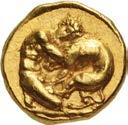

45. SICILY, Syracuse. Dionysios I. 405-367 BC. AV 100 Litrai – Double Dekadrachm (14mm, 5.80 g, 8h). Struck circa 400-370 BC. Head of Arethousa left, hair in sakkos adorned with a star, wearing single-pendant earring and necklace; sUrÅ˚os5o@ to left, pellet and star flanking neck / Herakles kneeling right, strangling the Nemean Lion; rocks below. Bérend Group III, 18 (D13/R10 – this coin); HGC 2, 1275; SNG ANS 330 (same obv. die); Jameson 825 (same obv. die). Double struck on obverse, some die wear on reverse. EF. ($10,000)
From the Gerald F. Borrmann (Northern California Gentleman) Collection, purchased from Dr. Arnold Saslow, June 1986.




46. SICILY, Syracuse. Timoleon and the Third Democracy. 344-317 BC. AV 30 Litrai – Quarter Stater (11.5mm, 2.24 g, 12h). Struck under Timoleon, 344-339/8. Laureate head of Zeus Eleutherios left / Pegasos flying left; 1 to left, three pellets below. HGC 2, 1284; SNG ANS 493; SNG Lloyd 1440; Jameson 851; Rizzo pl. LVIII, 1 (all from the same dies). Compact flan. Good VF. ($3000)
From the Gerald F. Borrmann (Northern California Gentleman) Collection. Ex Cederlind 148 (27 October 2008), lot 24.
By the early 4th century BC, Syracuse had become highly factionalized, and the political turmoil was taken advantage of by the Carthaginians. Eventually a delegation was sent by the Syracusans to Corinth to appeal to their mother city for help. Timoleon, from a prominent Corinthian family, was chosen to take control of Syracuse, drive the Carthaginian-backed government from power, and restore tranquility and prosperity to the great Sicilian city. In this endeavor Timoleon was successful, and his rule sparked a cultural and political revival. In contrast to most political strongmen of the age, termed tyrants, Timoleon never abused his power and abided by the limits of the democratic constitution he helped to create. After five years in power, he retired from public life, although his opinion was frequently sought and respected by his successors. His ascendancy is reflected in the city’s coinage, including this beautiful gold quarter stater and the silver stater in the following lot. While superficially mimicking the popular Corinthian “Pegasi” circulating widely in Greece, the style, relief, and execution are all uniquely Syracusan.



47. SICILY, Syracuse. Timoleon and the Third Democracy. 344-317 BC. AR Stater (21mm, 8.37 g, 8h). Struck under Timoleon, 344-339/8. Pegasos flying left / Head of Athena right, wearing Corinthian helmet. Pegasi 2; HGC 2, 1400. Old cabinet tone, with iridescence around the devices, minor flan flaw on obverse. VF. Lot includes a David Sear certificate of authenticity. ($1500)
From the Richard J. Sullivan Collection. Ex Tom Virzi Collection (J. Hirsch XXXII, 14 November 1912), lot 372.
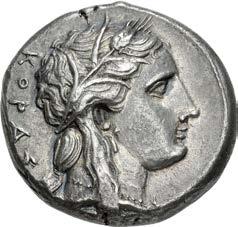



48. SICILY, Syracuse. Agathokles. 317-289 BC. AR Tetradrachm (26mm, 16.92 g, 9h). Struck circa 310-306/5 BC. Wreathed head of Kore right / Nike standing right erecting trophy to right; triskeles to lower left. Ierardi 199 (O55/R134); BAR Issue 23; HGC 2, 1536; SNG Copenhagen 766 (same dies). Attractively toned, with some iridescence around the devices. Near EF. ($2000)
From the Gerald F. Borrmann (Northern California Gentleman) Collection. Ex Classical Numismatic Review XXXIX.2 (Summer 2014), no. 980920; Heritage 3032 (10 April 2014), lot 23044; Peus 361 (3 November 1999), lot 44; G. Hirsch 176 (19 November 1992), lot 78.




49. SICILY, Syracuse. Agathokles. 317-289 BC. EL 50 Litrai – Hemistater (15.5mm, 3.51 g, 9h). Struck circa 306/5 BC. Laureate head of Apollo left; pilos to right / Tripod. Jenkins, Electrum, Group B, unlisted obv. die; BAR Issue 10; HGC 2, 1294. Trace deposit, minor marks. VF. ($1500)
From the 1930’s Collection of Robert W. Hubel of Michigan.




50. SICILY, Syracuse. Agathokles. 317-289 BC. EL 5 Litrai – Twelfth Stater (9mm, 0.71 g, 8h). Struck circa 306/5 BC. Head of Arethousa right, hair in sphendone, wearing single-pendant earring / Octopus. Jenkins Group A, dies c/b; BAR Issue 12; HGC 2, 1296; SNG ANS 620; SNG Lloyd 1436 (same dies); SNG Newnham Davis 76 (same rev. die); BMC 271 (same rev. die). Lightly toned. Good Fine. Very rare electrum fraction. ($1000)
From the Gerald F. Borrmann (Northern California Gentleman) Collection. Ex CNG inventory 949517 (May 2013); Roma V (23 March 2013), lot 140 (incorrect dies noted).
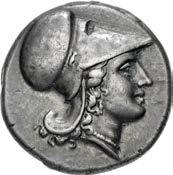
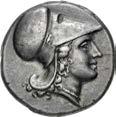

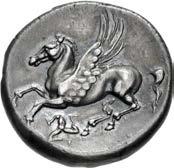
51. SICILY, Syracuse. Agathokles. 317-289 BC. AR Stater (19mm, 6.83 g, 6h). Reduced standard. Struck circa 304289 BC. Helmeted head of Athena right / Pegasos flying left; triskeles below. Pegasi 19; BAR Issue 32; HGC 2, 1408. Deeply toned, with faint blue iridescence around the devices. EF. Well centered. ($1000)
Ex Dr. Paul Stadler Szego Collection (Numismatic Fine Arts Winter Mail Bid Sale, 14 December 1989), lot 70.



52. SICILY, Syracuse. Philistis, wife of Hieron II. 275-215 BC. AR 16 Litrai – Tetradrachm (27mm, 13.24 g, 4h). Struck circa 217-215 BC. Diademed and veiled head left; star to right / Nike driving slow quadriga right; star above, ˚ to right. CCO 120 (D8/R30); BAR Issue 65; HGC 2, 1556. Light scrapes and minor chips at edge on reverse. Good VF. ($1500)
From the Wayne Scheible Collection. Ex Harlan J. Berk inventory cc55067 (13 February 2007).
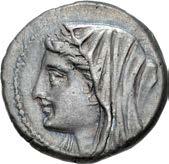



53. SICILY, Syracuse. Philistis, wife of Hieron II. 275-215 BC. AR 5 Litrai – Drachm (18.5mm, 4.51 g, 9h). Struck circa 217-215 BC. Diademed and veiled bust left / Nike driving slow quadriga right; ˚ to right. CCO 228 (D1/R1); BAR Issue 65; HGC 2, 1559; SNG Lloyd 1547 (same dies). Iridescent tone, a few old scratches under tone. Good VF. ($750) Ex North River Collection; Marion A. Sinton Collection (Classical Numismatic Group 53, 15 March 2000), lot 136.
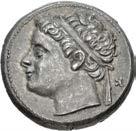
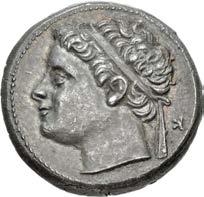

54. SICILY, Syracuse. Hieronymos. 215-214 BC. AR 10 Litrai (22mm, 8.28 g, 2h). Diademed head left; ˚ to right / Winged thunderbolt; ˚5 above. Holloway 40 (O21/R32); BAR Issue 79; HGC 2, 1567; SNG ANS 1028 (same dies); Pozzi 661 (same dies). Deep iridescent tone, traces of find patina, cleaning marks. Good VF. ($750)
From the Gerald F. Borrmann (Northern California Gentleman) Collection, purchased from Dr. Arnold Saslow, September 1986.




55. SICILY, Syracuse. Fifth Democracy. 214-212 BC. AR 12 Litrai (25mm, 10.18 g, 6h). Head of Athena left, wearing single-pendant earring, necklace, aegis, and crested Corinthian helmet decorated with coiled serpent on the bowl / Artemis standing left, drawing bow; at side, hound springing left; xÅ to left, sUrÅkos5W@ to right. Burnett, Enna 21 (dies 8/n); BAR Issue 84; HGC 2, 1412; SNG Copenhagen 878 (same obv. die); SNG Delepierre 713 (same obv. die); McClean 2957 (same dies). Deep old iridescent tone, a few marks at edge, hairlines on obverse. Near EF. ($2000)



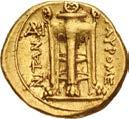
56. SICILY, Tauromenion. Circa 214-212 BC or later. AV Eighth Stater – Trihemiobol (10.5mm, 1.02 g, 11h). Laureate head of Apollo left; bee to right / Tripod; monogram to upper left. Campana 17 B/e (this coin referenced); BAR Issue 8; HGC 2, 1571. Deposits, edge marks. Good VF. Rare. ($2000)
From the Gerald F. Borrmann (Northern California Gentleman) Collection. Ex J. Olphin Collection (CNG inventory 851500, July 2009); George & Robert Stevenson Collection (Classical Numismatic Group XXVI, 11 June 1993), lot 42; Numismatic Fine Arts V (23 February 1978), lot 57.



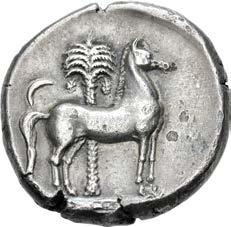
57. SICULO-PUNIC, “The Camp”. Circa 345/38-320/15 BC. AR Tetradrachm (24.5mm, 17.06 g, 4h). Possibly Entella mint. Wreathed head of Arethousa left; four dolphins around / Horse standing right; palm tree in background, crescent to upper left. Jenkins, Punic, Series 2c, 116 (O39/R105); CNP 176a; HGC 2, 277; de Luynes 1441 (same dies). Deep old iridescent tone, traces of find patina, minor delaminations. VF. A rare and desirable type in the series. ($3000)
From the Wayne Scheible Collection, purchased from Tom Cederlind, 2009. Ex Peus 396 (5 November 2008), lot 188; Auctiones AG 29 (12 June 2003), lot 550.

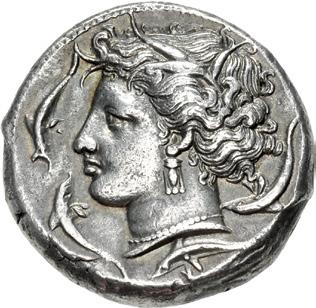


58. SICULO-PUNIC, “The Camp”. Circa 345/38-320/15 BC. AR Tetradrachm (26mm, 16.99 g, 11h). Possibly Entella mint. Head of Arethousa left, wearing wreath of grain ears, triple-pendant earring, and pearl necklace / Horse leaping left; palm tree in background. Jenkins, Punic, Series 2d, 139 (O46/R125); CNP 212; HGC 2, 279; de Luynes 1442 (same dies). Light iridescent tone over lustrous surfaces, some light marks. Near EF. ($7500)
This is one of the most starkly beautiful issues of the Siculo-Punic series, with a wonderfully athletic Punic horse caught in mid-leap. The lack of any inscription or control marks emphasizes the artistry of the composition.

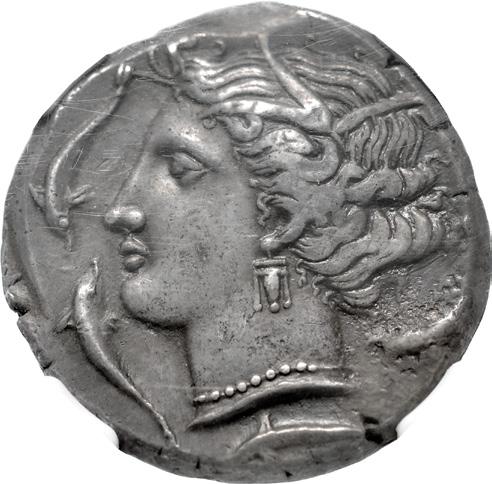

59. SICULO-PUNIC, “The Camp”. Circa 320/15-300 BC. AR Tetradrachm (25mm, 17.00 g, 10h). Possibly Entella mint. Wreathed head of Arethousa left; four dolphins around / Head of horse left; palm tree to right, †nJMM` (‘MMḤNT = “People of the Camp” in Punic) below. Jenkins, Punic, Series 3a, 197 (O59/R173 – this coin referenced); CNP 267; HGC 2, 284; SNG Ashmolean 2161 (same dies); Ward 362 (same dies). In NGC encapsulation 3762490-001, graded XF, Strike: 5/5, Surface: 5/5. ($2000)
Ex Classical Numismatic Group 97 (17 September 2014), lot 25; Pasquale del Pezzo, Duke of Cajaniello and Marquis of Campodisola, Collection (Sambon & Canessa, 27 June 1927), lot 1149.




60. SICULO-PUNIC, “The Camp”. Circa 300-289 BC. AR Tetradrachm (24mm, 16.80 g, 11h). Possibly Entella mint. Head of Herakles right, wearing lion skin / Head of horse left; club to left, palm tree to right, †nJM∆M` (‘MHMḤNT = “People of the Camp” in Punic) below. Jenkins, Punic, Series 5a, 286 (O91/R235); CNP 271e; HGC 2, 293 corr. (varying legend). Lightly toned over lustrous surfaces, diagnostic die break on obverse, slightly off center on reverse. Near EF. Attractive style. ($2500)



61. SICULO-PUNIC, “The Camp”. Circa 300-289 BC. AR Tetradrachm (24.5mm, 17.73 g, 3h). Possibly Entella mint. Head of Herakles right, wearing lion skin / Head of horse left; palm tree to right, [†nJM∆M` (‘MHMḤNT = “People of the Camp” in Punic) below]. Jenkins, Punic, Series 5a, 291 (O93/R239); CNP 271; HGC 2, 293 corr. (varying legend); SNG Fitzwilliam 1495 (same dies); SNG Lloyd 1655 (same dies); Bement 578 (same dies). Attractively toned, pitting, light scuff on reverse. Good VF. ($1500)
Ex Bonhams & Vecchi 6 (14 September 1981), lot 97.


62. SICULO-PUNIC, “The Camp”. Circa 300-289 BC. AR Tetradrachm (22.5mm, 16.67 g, 10h). Possibly Entella mint. Head of Herakles right, wearing lion skin / Head of horse left; palm tree to right, †nJM∆M` (‘MHMḤNT = “People of the Camp” in Punic) below. Jenkins, Punic, Series 5a, 304 (O96/R252); CNP 271; HGC 2, 293 corr. (varying legend). In NGC encapsulation 6766773-004, graded Ch XF, Strike: 4/5, Surface: 4/5, flan flaw. ($1500)




63. CARTHAGE. Circa 350-320 BC. AV Tenth Stater (7.5mm, 1.08 g, 5h). Carthage mint. Palm tree with two date clusters / Head of horse right. Jenkins & Lewis Group III, 136–55; CNP 239; MAA 8; SNG Copenhagen 133. Minor doubling on obverse, some marks. VF. ($750)
From the Richard J. Sullivan Collection. Ex Classical Numismatic Group Electronic Auction 433 (28 November 2018), lot 5.
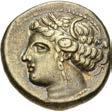


64. CARTHAGE. Circa 320-310 BC. EL Stater (18mm, 7.43 g, 12h). Carthage mint. Wreathed head of Tanit left / Horse standing right. Jenkins & Lewis Group IVc; cf. CNP 2.0; MAA 9; SNG Copenhagen –; SNG Lockett 1057. Iridescent tone, minor doubling on obverse, some die wear on reverse. VF. Rare. ($1500)
From the 1930’s Collection of Robert W. Hubel of Michigan.


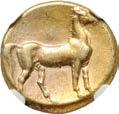
65. CARTHAGE. Circa 290-270 BC. EL Stater (18mm, 7.43 g, 12h). Carthage mint. Wreathed head of Tanit left, wearing necklace [with pendants] / Horse standing right on [exergue line]. Jenkins & Lewis Group VII; CNP 2.6; MAA 13; SNG Copenhagen 988. In NGC encapsulation 6369978-003, graded Ch XF, Strike: 5/5, Surface: 4/5, scratch. ($1500)


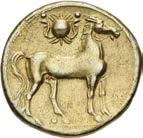
66. CARTHAGE, First Punic War. Circa 264-241 BC. EL 1½ Shekels – Tridrachm (23mm, 10.54 g, 12h). Carthage mint. Wreathed head of Tanit left, wearing necklace with nine pendants / Horse standing right; ouraios above; pellet behind forward hind hoof. Jenkins & Lewis Group Xb, 428; CNP 41i; MAA 32; SNG Copenhagen 996. Hairline flan crack, edge marks. VF. ($3000)
From the Ramrodivs Collection. Ex Harlan J. Berk inventory cc79881 (ND). Lot also includes an old Berk ticket from the 1980s (referenced on later Berk ticket).
Carthage, a Phoenician colony on the coast of North Africa, became a maritime powerhouse in the fifth century BC and challenged the Greek cities of Sicily and Southern Italy for control of the western Mediterranean. By the early third century, much of Sicily had fallen under Carthaginian control and mints were established on the island to produce coins used to pay the largely mercenary army. The stage was now set for the collision with Rome, newly dominant in Italy. Starting in 265 BC, Carthage and Rome fought three titanic wars that produced more death and destruction than any other conflict before the 20th century. This electrum piece, struck at the mother city of Carthage, was produced early in the First Punic War with Rome, which raged for more than 20 years and ended with a humiliating defeat for Carthage and the loss of Sicily to the Romans. Still, Carthage’s empire remained otherwise intact and the loss only laid the groundwork for the similarly destructive Second Punic War. The use of electrum points to the need to stretch Carthage’s gold supply while striking a coinage that would have special appeal to the mercenary soldiers that made up most of its army. A head of the Phoenician goddess Tanit adorns the obverse, while the “Punic horse” symbolic of Carthaginian cavalry stands on the reverse.
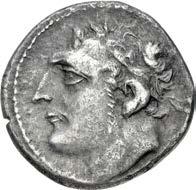
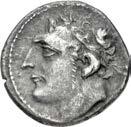


67. CARTHAGE, Second Punic War. Circa 220-205 BC. AR Shekel (21.5mm, 6.42 g, 12h). Carthage or Sicilian mint. Struck during the expedition to Sicily, circa 213-210 BC. Laureate head of Melkart left / Elephant advancing right; a (Punic A) in exergue. Visonà 55; CNP 446; MAA –; SNG Copenhagen 382. Toned, some die wear, minor marks, test cut on edge. VF. ($1500)
Ex Marti Hervera and Soler & Llach 1123 (1 December 2021), lot 16.
These coins were originally attributed to the Punic mint in Spain, but subsequent hoard evidence has established that they were struck either in Carthage or a Carthaginian mint in Sicily during the Second Punic War (see A. Walker, “Some Hoards from Sicily and a Carthaginian Issue of the Second Punic War” in Studies Mildenberg, p. 275, and note 6). Burnett (Enna) argued, based on the fixed die axes of the coins, that this issue was struck in Carthage, but for circulation in Sicily.


68. SKYTHIA, Olbia. Circa 450-440 BC. Cast Æ (71.5mm, 104.52 g). Paus(a)-, magistrate. Head of Athena left, wearing Attic helmet; to left, dolphin upward / Wheel with four spokes (‘solar disk’); πÅUs within quarters. Karyshkovskij p. 392, Таб. II=B, 1; Anokhin 164; cf. HGC 3, 1883 (smaller denomination). Dark green-brown patina, typical minor roughness in spots. Good VF. Rare. ($1500)
Ex Stack’s Bowers Galleries (14 August 2023), lot 50081.
The impressive cast bronzes of Olbia on the Black Sea in many ways presaged the development of the Aes Grave coinage in Italy, although the regions were separated by more than 1,000 miles. Olbia, a colony of Miletos located at the junction of the Hyspanis and Borysthenes rivers in the wilds of Skythia, grew prosperous on trade between the nomadic Skythians and the Greeks. It employed a unique form of coinage consisting of cast bronzes of various sizes and shapes. The smallest Olbian bronzes were made in the shape of dolphins; larger denominations were on circular flans and bore either a facing gorgon’s head or, as seen here, a helmeted head of Athena in profile. The reverse is a four-spoked wheel, also interpreted as a solar disk. Like the early Romans, the Olbians apparently traded these pieces as commodity money rather than as fiat, meaning that the largest denominations were truly immense and heavy.

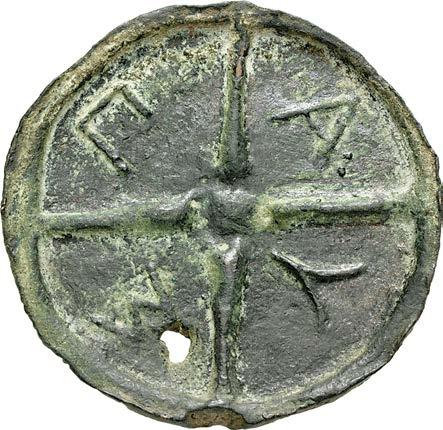
69. SKYTHIA, Olbia. Circa 450-440 BC. Cast Æ (69mm, 119.08 g). Paus(a)-, magistrate. Head of Athena left, wearing Attic helmet; to left, dolphin upward / Wheel with four spokes (‘solar disk’); πÅUs within quarters. Karyshkovskij p. 392, Таб. II=B, 1; Anokhin 164; cf. HGC 3, 1883 (smaller denomination). Dark green-brown patina, typical minor roughness in spots, natural void in flan, some cleaning marks. VF. Rare. ($1500)

70. SKYTHIA, Olbia. Circa 437-410 BC. Cast Æ (67mm, 99.35 wings spread, holding in its talons a dolphin right; Å-r-5-c 3, 1881. Brown and green surfaces, some light smoothing. EF. ($1000)

Ex William H. Birkinshaw Collection (Classical Numismatic Group 117, 19 May 2021), lot 63; Classical Numismatic Group 57 (4 April 2001), lot 239.


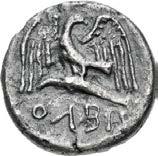

71. SKYTHIA, Olbia. Circa 315-310 BC. AR Stater – Didrachm (22.5mm, 11.54 g, 1h). Wreathed head of Demeter left / Eagle, wings spread, standing left, head right, on dolphin left. Anokhin 292; HGC 3, 1848; SNG Stancomb 361 (this coin); Frolova & Abramzon 697 (same dies). Toned, some find patina, slight roughness, minor flan flaws. VF. ($1000)
Ex Roma XXII (7 October 2021), lot 279; William Stancomb Collection (Roma XIX, 26 March 2020), lot 69; Leu 13 (29 April 1975), lot 86.
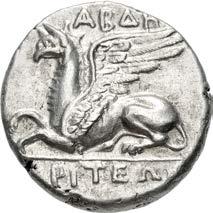

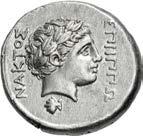

72. THRACE, Abdera. Circa 336-311 BC. AR Stater (23mm, 10.55 g, 2h). Hipponax, magistrate. Griffin couchant left / Laureate head of Apollo right; scallop shell bellow. C-N 126–35 (obv. die 2); May, Abdera, Period IX, 543; HGC 3, 1211h; CNG 126, lot 104 (same obv. die; hammer $7000). Faint golden tone, underlying luster. EF. Well centered. ($3000)
Ex Numismatik Naumann 115 (3 April 2022), lot 169.
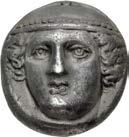

73. THRACE, Ainos. Circa 372/1-370/69 BC. AR Tetradrachm (21mm, 15.55 g, 12h). Head of Hermes facing slightly left, wearing petasos with pelleted rim / Goat standing right; to right, crested Corinthian helmet right; all within incuse square May, Ainos, Group LVII, – (A248/P293 – unlisted die combination); AMNG II 377; HGC 3, 1278. Lightly toned, some minor porosity, minor smoothing on obverse, light scuffs on reverse. VF. ($2000)
Ex Classical Numismatic Group 121 (6 October 2022), lot 164; Classical Numismatic Group 55 (13 September 2000), lot 272.

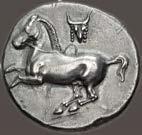


74. THRACE, Maroneia. Circa 365-330s BC. AR Stater (23mm, 11.02 g, 7h). Persic standard. Neomenio–, magistrate. Bridled horse rearing left; above, facing boukranion with fillet hanging from each horn / Grape arbor in linear square; Eπ[5] @E[o]-Â˙-@5o around; all within shallow incuse square. Schönert-Geiss Period VIII, 431.6 (V13/R18) = West 104d = Jameson 2018 (this coin); HGC 3, 1533; SNG Copenhagen 605 (same dies); SNG Lockett 1197 = Pozzi 1048 (same dies). Attractive old cabinet tone, traces of find patina, a few faint scratches under tone, some scrapes and minor test cut on edge. EF. ($7500)
Ex Münzen und Medaillen AG XIX (5 June 1959), lot 357; Robert Jameson Collection (publ. 1932).

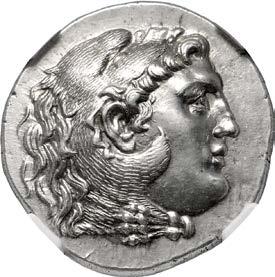

75. THRACE, Mesambria. Circa 225-175 BC. AR Tetradrachm (29mm, 16.90 g, 12h). In the name and types of Alexander III of Macedon. Head of Herakles right, wearing lion skin / ∫Å%5¬EW% ŬE$Å@droU, Zeus Aëtophoros seated left; to inner left, helmet right above g. Karayotov I – (O23/R– [unlisted monogram]); Price –; HGC 3, 1567. In NGC encapsulation 6821662-001, graded Ch AU, Strike: 5/5, Surface: 3/5. Exceptional detail, obverse struck at a very early die state. A wonderful coin in hand. Extremely rare, unpublished with this monogram. ($1000)
Ex Nomos 2 (18 May 2010), lot 61.

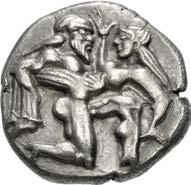

76. ISLANDS off THRACE, Thasos. Circa 480-463 BC. AR Stater (20.5mm, 8.37 g). Satyr advancing right, carrying off protesting nymph / Quadripartite incuse square. Le Rider, Thasiennes 5; HGC 6, 331. Lightly toned, a little porosity, minor edge splits. Good VF. Well centered. ($1000)
Ex G. Hirsch 357 (18 June 2020), lot 72.

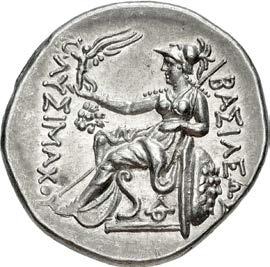

77. KINGS of THRACE, Macedonian. Lysimachos. 305-281 BC. AR Tetradrachm (29mm, 17.04 g, 10h). Lysimacheia mint. Struck circa 297/6-282/1 BC. Diademed head of the deified Alexander right, with horn of Ammon / Athena Nikephoros seated left, arm resting on shield, transverse spear in background; to inner left, head of lion left; 0 on throne. Thompson 16; Müller 51; HGC 3, 1750a. Underlying luster, flan crack. EF. ($1000)


78. KINGS of THRACE, Macedonian. Lysimachos. 305-281 BC. AR Tetradrachm (28mm, 16.95 g, 11h). Lampsakos mint. Struck 297/6-282/1 BC. Diademed head of the deified Alexander right, with horn of Ammon / Athena Nikephoros seated left, arm resting on shield, transverse spear in background; torch to inner left, star on throne. Thompson 43; Müller 381; HGC 3, 1750b; SNG BN 2538-9. Bright surfaces, some horn silver on obverse, a few marks on reverse. Good VF. Fine style portrait. ($1000)
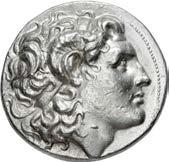

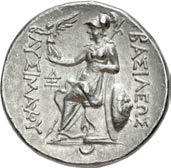
79. KINGS of THRACE, Macedonian. Lysimachos. 305-281 BC. AR Tetradrachm (28mm, 17.14 g, 1h). Lampsakos mint. Struck 297/6-282/1 BC. Diademed head of the deified Alexander right, with horn of Ammon / Athena Nikephoros seated left, arm resting on shield, transverse spear in background; B in inner left field, crescent in exergue. Thompson 49; Müller 399; HGC 3, 1750b; SNG BN 2548–9. Minor marks, tiny die break on obverse, slight die shift on reverse. Near EF. ($1500)




80. KINGS of THRACE, Macedonian. Lysimachos. 305-281 BC. AR Tetradrachm (29mm, 17.02 g, 1h). Lampsakos mint. Struck circa 297/6-282/1 BC. Diademed head of the deified Alexander right, with horn of Ammon / Athena Nikephoros seated left, arm resting on shield, transverse spear in background; to inner left, M above crescent. Thompson 61; Müller 395; HGC 3, 1750b; SNG BN 2546. In NGC encapsulation 4278691-009, graded Ch XF, Strike: 5/5, Surface: 4/5, Fine Style. ($1500)
Ex D.K. Collection (Classical Numismatic Group Electronic Auction 536, 12 April 2023), lot 41.
81. KINGS of THRACE, Macedonian. Lysimachos. 305-281 BC. AR Tetradrachm (28.5mm, 17.28 g, 1h). In the types of Alexander III of Macedon. Magnesia on the Maeander mint. Struck circa 299/8-297/6 BC. Head of Herakles right, wearing lion skin / Zeus Aëtophoros seated left; in left field, M above lion forepart left; ∆ below throne. Thompson 96; Müller 2; Price L31; HGC 3, 1749b. Lightly toned, underlying luster, faint hairlines. Near EF. Well centered. ($500)



82. KINGS of THRACE, Macedonian. Lysimachos. 305-281 BC. AR Tetradrachm (28.5mm, 16.85 g, 1h). Magnesia on the Maeander mint. Struck circa 297/6-282/1 BC. Diademed head of the deified Alexander right, with horn of Ammon / Athena Nikephoros seated left, arm resting on shield, transverse spear in background; race torch to inner left, maeander pattern in exergue. Thompson 110; Müller –; HGC 3, 1750e. Minor marks. Near EF. Well centered. ($1500)
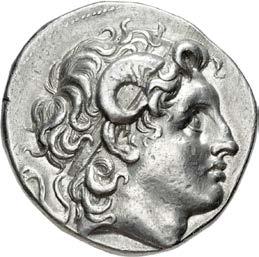
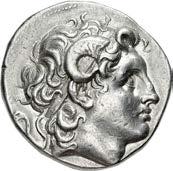

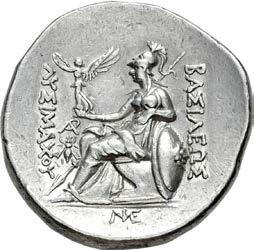
83. KINGS of THRACE, Macedonian. Lysimachos. 305-281 BC. AR Tetradrachm (28.5mm, 17.05 g, 5h). Alexandreia Troas mint. Struck 297/6-282/1 BC. Diademed head of the deified Alexander right, with horn of Ammon / Athena Nikephoros seated left, arm resting on shield, transverse spear in background; to inner left, 1 above bee; Ô in exergue. Meadows, Earliest 15 var. (monogram in exergue), dies O9/R–; Thompson 160 var. (same); Müller 432 var. (same); HGC 3, 1750h; CNG 124, lot 90 (same dies; hammer $8500). Good VF. Extremely rare variety, only two in CoinArchives (the CNG 124 coin cited above, and Künker 347, lot 659 [hammer €4400]). ($1000)
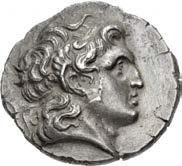

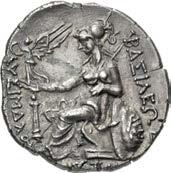
84. KINGS of THRACE, Macedonian. Lysimachos. 305-281 BC. AR Tetradrachm (29.5mm, 16.30 g, 4h). Uncertain mint in Thrace (Kabyle?). Struck under Skostokos, circa 285-281 BC. Diademed head of the deified Alexander right, with horn of Ammon / Athena Nikephoros seated left, arm resting on shield, transverse spear in background; herm to inner left, [%˚o]%to[˚oU] in exergue. Fischer-Bossert, Lysimacheier 9h (V1/R9 – this coin); Youroukova 103 (same obv. die); HGC 3, 1471; SNG Blackburn 372 (same dies); SNG Manchester 815 (same dies); Dewing 1362 (same dies). Deep cabinet tone, with slight iridescence, flan crack, cleaning marks and hairlines, minor die break on obverse. Good VF. Rare. ($750)
From the Gerald F. Borrmann (Northern California Gentleman) Collection. Ex Triton II (1 December 1998), lot 360; Hess-Leu [3] (27 March 1956), lot 258.
While previous scholars viewed Skostokos as a dynast who took control of parts of Thrace following Lysimachos’ death, Fischer-Bossert’s die study demonstrates that Skostokos was most likely a local ruler in the vicinity of Kybele, under Lysimachos, who was permitted to strike these coins near the end of Lysimachos’ reign.


85. KINGS of THRACE, Macedonian. Lysimachos. 305-281 BC. AR Tetradrachm (28.5mm, 17.25 g, 9h). Uncertain mint. Struck 3rd century BC. Diademed head of the deified Alexander right, with horn of Ammon / Athena Nikephoros seated left, arm resting on shield, transverse spear in background; Ɔ to outer left. Unpublished in the standard references. Faintly toned, slight doubling and flan flaw on reverse. Near EF. Very rare. ($1000)
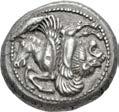


86. THRACO-MACEDONIAN REGION, Uncertain. Circa 500-480 BC. AR Stater (19mm, 8.26 g). Foreparts of winged lion and Pegasos joined at truncation, inverted from one another / Quadripartite incuse square. Tzamalis 65; HPM pl. XVII, 28. Lightly toned, die break on obverse. Good VF. Attractive style and well centered. Extremely rare. ($4000)


87. MACEDON, Chalkidian League. Circa 353 BC. AR Tetradrachm (24.5mm, 14.37 g, 11h). Olynthos mint; Archidamos, magistrate. Laureate head of Apollo left / Kithara; [Eπ]5 Å-rc5dÅ-Âo-U in tiny letters above crossbar. Robinson & Clement Group S, 104 (A69/P89); HGC 3, 500. Toned, trace deposits, small flan flaw on obverse, faint cleaning marks on reverse. VF. ($1000)





88. MACEDON, Chalkidian League. Circa 350 BC. AR Tetradrachm (24mm, 14.39 g, 11h). Olynthos mint; Ariston, magistrate. Laureate head of Apollo right / Kithara. Robinson & Clement Group V, 129–30 var. (A80/P– [unlisted rev. die]); HGC 3, 500. Toned, with slight iridescence, edge split, die break on reverse (with design and part of name re-engraved on the die break). EF. ($2000)
It is not unusual for dies to develop breaks over time, as on the reverse of this example. Judging from the sharpness of the details on the reverse, though, it is clear that this break developed quite soon after the die began to be used. Undeterred, the mint workers re-engraved the part of the designs that would have been obliterated by the break. Thus, the final three letters of the magistrate’s name can be seen running up the contour of the break, just below the corner of the kithara that also was recreated. Though such die flaws are common, such an obvious mint repair is highly unusual.
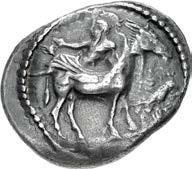
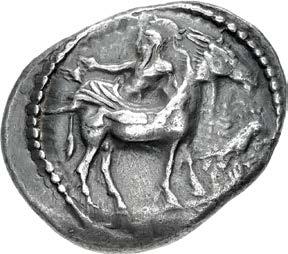

89. MACEDON, Mende. Circa 460-423 BC. AR Tetradrachm (31.5mm, 16.92 g, 6h). Inebriated Dionysos, holding kantharos, reclining left on back of an ass standing right; to right, bird standing right on ivy branch / Ethnic arrayed around vine of four grape clusters in linear square; all within incuse square. Noe, Mende 21 (same dies); HGC 3, 545. Old cabinet tone, double struck on obverse, area of flat strike on reverse. VF. ($2000)

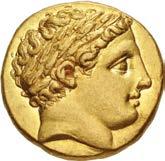

90. KINGS of MACEDON. temp. Philip II – Alexander III. Circa 340/36-328 BC. AV Stater (18mm, 8.60 g, 9h). In the name and types of Philip II. Pella mint. Laureate head of Apollo right / Charioteer, holding kentron and reins, driving biga right; kantharos below. Le Rider Group II.1, 155 (D40/R110’); SNG ANS 138–43; Boston MFA 642 = Warren 628 (same dies). Lustrous, some cleaning marks and hairlines. Near EF. Well centered. ($3000)
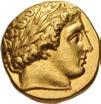

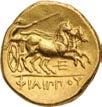
91. KINGS of MACEDON. temp. Philip II – Alexander III. Circa 340/36-328 BC. AV Stater (16.5mm, 8.59 g, 12h). In the name and types of Philip II. Pella mint. Laureate head of Apollo right / Charioteer, holding kentron and reins, driving biga right; trident head below. Le Rider Group II.1, 320 var. (D–/R244 [unlisted obv. die]); SNG ANS 153. Slight die wear on obverse. Good VF. ($2000)

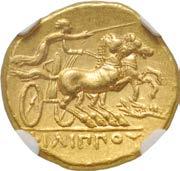

92. KINGS of MACEDON. temp. Philip II – Alexander III. Circa 340/36-328 BC. AV Stater (17mm, 8.62 g, 9h). In the name and types of Philip II. Pella mint. Laureate head of Apollo right / Charioteer, holding kentron and reins, driving biga right; below, Nike flying right. Le Rider Group II.2, 379 (D167/R281); SNG ANS 158 (same rev. die). In NGC encapsulation 4467218-005, graded Ch AU, Strike: 5/5, Surface: 4/5. ($3000)
Ex New York Sale 54 (11 January 2022), lot 16 (hammer $6250).



93. KINGS of MACEDON. Alexander III ‘the Great’. 336-323 BC. AR Tetradrachm (24mm, 17.20 g, 8h). Lampsakos mint. Struck under Kalas or Demarchos, circa 328/5-323 BC. Head of Herakles right, wearing lion skin / Zeus Aëtophoros seated left; in left field, Artemis Phosphoros standing facing, holding two torches; ∂ below throne. Price 1355; ADM II Series V, 28a–d (same obv. die). Deep iridescent tone, underlying luster. EF. ($750)


94. KINGS of MACEDON. Alexander III ‘the Great’. 336-323 BC. AR Tetradrachm (26.5mm, 17.22 g, 1h). Karne mint. Struck under Menes, circa 325/4-324/3 BC. Head of Herakles right, wearing lion skin / Zeus Aëtophoros seated left; ! in left field, erasure mark below throne. Price 3429; Duyrat, Ateliers, p. 37, n. 44; Lanz 138, lot 306 (same dies); ANS 1944.100.35115 and 1944.100.35116 (both from same obv. die). Iridescent tone, slightly off center. Good VF. Very rare, particularly without royal title; only four in Pella, five in CoinArchives (including this coin), and the present coin is the sole example in the ANS photofile. ($750)
Ex Classical Numismatic Group Electronic Auction 536 (12 April 2023), lot 44 (hammer $2750); J. Schulman 274 (23 March 1982), lot 4015.



95. KINGS of MACEDON. temp. Alexander III – Philip III. Circa 325-319 BC. AV Stater (18.5mm, 8.60 g, 12h). In the name of Alexander III. Amphipolis mint. Struck under Antipater. Helmeted head of Athena right / Nike standing left, holding wreath and stylis; in left field, trident head downward. Price 172; Troxell, Studies, p. 125, pl. 25, H. Underlying luster, a little die rust. Good VF. ($3000)



96. KINGS of MACEDON. temp. Alexander III – Kassander. Circa 325-310 BC. AV Stater (19mm, 8.59 g, 8h). In the name and types of Philip II. Pella mint. Laureate head of Apollo right / Charioteer, holding kentron and reins, driving biga right; ¶ above, thunderbolt below. Le Rider Group IIIC, 625 (D260/R452); SNG ANS 204 (same dies). Underlying luster, a few faint marks. VF. ($2000)
From the Ramrodivs Collection. Ex Harlan J. Berk inventory cc85012 (ND).


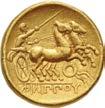
97. KINGS of MACEDON. temp. Alexander III – Kassander. Circa 325-310 BC. AV Stater (18mm, 8.48 g, 1h). In the name and types of Philip II. Uncertain mint (Pella?). Laureate head of Apollo right / Charioteer, holding kentron and reins, driving biga right; wreath(?) below. Unpublished in the standard references. Faintly toned, a couple of tiny cuts on edge. VF. Apparently unique with this symbol. ($2000)
Although this symbol appears to be unpublished for Philip II type staters, the style is clearly late, and reminiscent of Le Rider’s Pella Group IIIC.

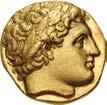
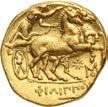

98. KINGS of MACEDON. Philip III Arrhidaios. 323-317 BC. AV Stater (17.5mm, 8.40 g, 12h). In the types of Philip II. Abydos mint. Struck under Leonnatos, Arrhidaios, or Antigonos I Monophthalmos. Laureate head of Apollo right / Charioteer, holding kentron and reins, driving biga right; star and w below. Thompson, Philip 26; Le Rider pl. 91, 14; ADM II Series VII, 107 (same dies); Hirsch 1033 (same dies). Slightly off center on reverse. EF. ($3000)

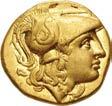


99. KINGS of MACEDON. Philip III Arrhidaios. 323-317 BC. AV Stater (18.5mm, 8.60 g, 12h). In the name and types of Alexander III. Abydos mint. Struck under Leonnatos, Arrhidaios, or Antigonos I Monophthalmos. Helmeted head of Athena right / Nike standing left, holding wreath and stylis; in left field, 9 above pentagram; cornucopia below left wing. Price 1524; ADM II Series XI, unlisted dies. Underlying luster, minor marks, a couple of tiny flan flaws in field on obverse. EF. ($3000)
100. No Lot.


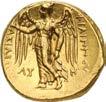
101. KINGS of MACEDON. Philip III Arrhidaios. 323-317 BC. AV Stater (17.5mm, 8.54 g, 12h). In the types of Alexander III. Babylon mint. Struck under Archon, Dokimos, or Seleukos I, circa 323-318/7 BC. Helmeted head of Athena right / Nike standing left, holding wreath and stylis; ¬U below left wing, µ below right wing. Price P178; Waggoner Issue III, obv. die 144. Lustrous, hairline flan crack on obverse, slightly off center on reverse. Near EF. ($3000)
Rare



102. KINGS of MACEDON. Philip III Arrhidaios. 323-317 BC. AV Stater (17.5mm, 8.53 g, 11h). In the types of Alexander III. Babylon mint. Struck under Archon, Dokimos, or Seleukos I, circa 323-318/7 BC. Helmeted head of Athena right / Nike standing left, holding wreath and stylis; wheel in left field, Ž below left wing, [W below right wing]. Price P187 corr. (monograms); Waggoner Issue VI, dies 221/a = BN Fonds général 1123 (same dies). Slightly off center and a couple of minor marks at edge on reverse. VF. Very rare issue, only one example noted by Waggoner, which is the only example in Pella, just two in CoinArchives. ($2000)
From the Ramrodivs Collection. Ex Harlan J. Berk inventory cc33702 (ND).




103. KINGS of MACEDON. Philip III Arrhidaios. 323-317 BC. AV Stater (17.5mm, 8.58 g, 7h). In the types of Alexander III. Babylon mint. Struck under Archon, Dokimos, or Seleukos I, circa 323-318/7 BC. Helmeted head of Athena right / Nike standing left, holding wreath and stylis; wheel in left field, ‰ below left wing, @ below right wing. Price P198a (same dies); Waggoner Issue VI, dies 224/b; Berlin obj. no. 18254693 (same dies). Underlying luster, trace deposits, a few tiny marks on reverse. Near EF. Well centered. ($3000)
From the Ramrodivs Collection. Ex Harlan J. Berk inventory cc67831 (ND).
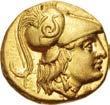
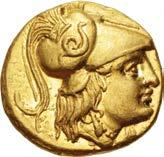
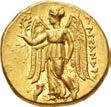
104. KINGS of MACEDON. Antigonos I Monophthalmos. As Strategos of Asia, 320-306/5 BC, or King, 306/5-301 BC. AV Stater (18mm, 8.55 g, 12h). In the name and types of Alexander III. Abydos mint. Struck circa 310-301 BC. Helmeted head of Athena right / Nike standing left, holding wreath and stylis; Â in wreath in left field, cornucopia below left wing. Price 1562; ADM II Series XX, 399 (same dies). Underlying luster, light die rust, small die break on obverse, area of weak strike on reverse, small cut on edge. Near EF. ($2500)
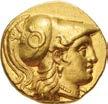


105. KINGS of MACEDON. Antigonos I Monophthalmos. As Strategos of Asia, 320-306/5 BC. AV Stater (18mm, 8.57 g, 3h). In the name and types of Alexander III. Babylon mint. Struck under Peithon, circa 315-311 BC. Helmeted head of Athena right / Nike standing left, holding wreath and stylis; below left wing, pellet above head of satyr left; ü below right wing. Price 3736; Waggoner Issue VIII, Series 4, dies 431/c; SNG Saroglos 164 (same dies); Bement 712 (same dies). A few minor scratches on obverse, doubling on reverse. Good VF. ($2000)
From the Wayne Scheible Collection.



106. KINGS of MACEDON. Antigonos I Monophthalmos. As Strategos of Asia, 320-306/5 BC. AR Tetradrachm (23mm, 16.96 g, 1h). In the name and types of Alexander III. Susa mint. Struck under Aspesias, Satrap of Susiana, circa 316311 BC. Head of Herakles right, wearing lion skin / Zeus Aëtophoros seated left; wreath in left field; below throne, Å5 above strut, Z below. Price 3857. Minor marks. Near EF. High relief. ($750)



107. KINGS of MACEDON. Demetrios I Poliorketes. 306-283 BC. AR Tetradrachm (28mm, 17.21 g, 9h). Pella mint. Struck circa 289-288 BC. Diademed and horned head right / Poseidon Pelagaios, nude, standing left, foot propped on rock, holding trident; - to outer left, A to outer right. Newell 90, unlisted obv. die; HGC 3, 1014a. Lightly toned, softly struck. Good VF. ($1000)
Ex Harlan J. Berk inventory cc51369; Bob Guynn Collection.



108. KINGS of MACEDON. Demetrios I Poliorketes. 306-283 BC. AR Tetradrachm (30mm, 17.13 g, 4h). Amphipolis mint. Struck circa 291-290 BC. Diademed and horned head right / Poseidon Pelagaios, nude to waist, seated left on rock, holding aphlaston and trident; : to inner left, A to inner right. Newell 110 var. (inner right monogram, but obv. die XCIX); HGC 3, 1013b; Triton XVII, lot 167 (same obv. die; hammer $8000). Lightly toned, traces of find patina, small die break and a couple of minor scratches on reverse. Good VF. Very rare variety unknown to Newell; four in CoinArchives. ($1000)
Ex Roma XXII (7 October 2021), lot 250.
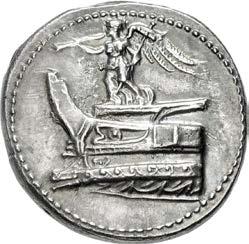



109. KINGS of MACEDON. Demetrios I Poliorketes. 306-283 BC. AR Tetradrachm (27.5mm, 17.11 g, 6h). Pella mint. Struck circa 294-293 BC. Nike standing left on prow of galley left, blowing trumpet she holds in her right hand and cradling stylis in her left arm / ∫Å-s5¬E-Ws d˙µ˙tr5oU, Poseidon Pelagaios, nude, standing left, seen from behind, preparing to throw trident held aloft in his right hand, chlamys draped over extended left arm; g to left; to right, dolphin downward. Newell 67 (dies LVII/106); HGC 3, 1012e; SNG München 1042 (same dies). Attractive iridescent tone over lustrous surfaces, a little die wear on obverse, slight die shift and a few hairlines on reverse. Superb EF. ($5000)


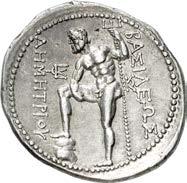
110. KINGS of MACEDON. Demetrios I Poliorketes. 306-283 BC. AR Tetradrachm (32.5mm, 17.08 g, 5h). Amphipolis mint. Struck circa 290-289 BC. Diademed and horned head right / Poseidon Pelagaios, nude, standing left, foot propped on rock, holding trident; : to inner left, ! to inner right. Newell 119, obv. die CVI; HGC 3, 1014b. Lightly toned, light cleaning hairlines, small nick on reverse. Near EF. Struck on a broad flan. ($1000)


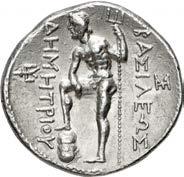
111. KINGS of MACEDON. Demetrios I Poliorketes. 306-283 BC. AR Tetradrachm (30mm, 17.14 g, 12h). Amphipolis mint. Struck circa 289-288 BC. Diademed and horned head right / Poseidon Pelagaios standing left, foot on rock, holding trident; : to outer left, M to outer right. Newell 121, obv. die CXXII; HGC 3, 1014b; Pozzi 962 (same obv. die). Faintly toned, a few minor scratches in field on reverse. Good VF. Well centered. ($1500)

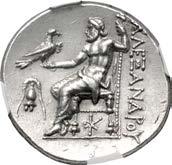
112. KINGS of MACEDON. Antigonos II Gonatas. 277/6-239 BC. Fourrée Tetradrachm (28mm, 13.69 g, 5h). In the name and types of Alexander III. Amphipolis mint. Struck circa 275-272/1 BC. Head of Herakles right, wearing lion skin / Zeus Aëtophoros seated left; Macedonian helmet in left field, ø below throne. Price 621; Mathisen, Administrative, Group VI, 6 (A26/P60); HGC 3, 1040; SNG München 359 (same dies). In NGC encapsulation 6829888-029, graded Ch AU, Strike: 5/5, Surface: 2/5, Fine Style, core visible, brushed. ($750)
Ex Classical Numismatic Group 78 (14 May 2008), lot 352 (erroneously as an official issue).




113. KINGS of MACEDON. temp. Antigonos II Gonatas – Demetrios II Aitolikos. 246/5-229 BC. AR Tetradrachm (32mm, 16.87 g, 11h). Amphipolis or Pella mint. Head of Poseidon right, wearing wreath of marine plants / Apollo, testing bow in extended right hand, seated left on prow left; f below. TEA Period III, 158a (O25/R149 – this coin, illustrated); HGC 3, 1051. Deep old collection tone, minor marks. Good VF. ($2000)
From the Wayne Scheible Collection. Ex Edward J. Waddell inventory 45719 (ND); Waddell 79 (10 December 2003), lot 28; Schweizerische Kreditanstalt 3 (19 April 1985), lot 164; Münzen und Medaillen AG 47 (30 November 1972), lot 458.



114. KINGS of MACEDON. Perseus. 179-168 BC. AR Tetradrachm (31.5mm, 17.05 g, 11h). Attic standard. Amphipolis mint. Struck circa 174-170 BC. Diademed head right / Eagle, wings spread, standing right on thunderbolt; g above, g to right, „ between legs; all within oak wreath; star below. De Luca, Tetradrachms, Group I, 10c (O6/R10 – this coin, illustrated); Mamroth, Perseus 13; HGC 3, 1091; Hirsch 1127 (same dies). Faintly toned, a few light marks on obverse. Near EF. ($1000)
Ex Bob Guynn Collection; Giessener Münzhandlung 87 (2 March 1998), lot 137.




115. THESSALY, Lamia. Circa 400-350 BC. Æ Chalkous (14.5mm, 2.26 g, 11h). Head of the nymph Lamia right, wearing earring and necklace / Philoktetes kneeling to left, his upper body to right, shooting bow at birds, one of which falls before him; quiver below. Georgiou, Mint 15; Rogers (Malia) 387; BCD Thessaly II 128.2; HGC 4, 126. Brown surfaces. Good VF. ($500)
Ex Christopher Morcom Collection (Triton XI, 8 January 2008), lot 140; Naville V (18 June 1923), lot 1800 (part of).



116. THESSALY, Larissa. Circa 400-370 BC. AR Drachm (19mm, 5.96 g, 9h). Head of the nymph Larissa facing slightly right, with hair in ampyx / Horse grazing right. L-S Group 4, Head type 19, dies O78/R1, a = Lorber, Early 52.1a (this coin, illustrated in Lorber); BCD Thessaly II –; HGC 4, 430. Lovely iridescent tone, minor scrape on obverse, a couple of light scratches and slight die shift on reverse. Good VF. ($750)
From the Wayne Scheible Collection. Ex Gemini IV (8 January 2008), lot 108; Numismatic Fine Arts XXXIII (3 May 1994), lot 933; 1989 ‘Unknown Findspot’ Hoard (CH IX, 65).



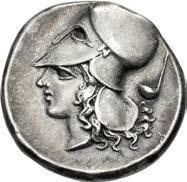
117. AKARNANIA, Leukas. Circa 350-320 BC. AR Stater (21mm, 8.51 g, 11h). Pegasos alighting right / Helmeted head of Athena left; kuathos (ladle) to right. Pegasi 110; Imhoof-Blumer, Akarnaniens 40; cf. BCD Akarnania 223; HGC 4, –. Iridescent tone, a few hairlines. Good VF. Attractive in hand. ($750)
From the 1930’s Collection of Robert W. Hubel of Michigan.

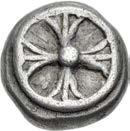

118. ATTICA, Athens. Circa 515-510 BC. AR Drachm (14.5mm, 4.18 g). “Wappenmünzen” type. Wheel with four spokes / Quadripartite incuse square, divided diagonally. Seltman pl. IV, δ; Asyut 259 (this coin); Kroll 3; HGC 4, 1622. Attractively toned. Good VF. ($3000)
Purchased by the consignor from Brian Kritt, August 2002. Ex 1968/9 Asyut Hoard (IGCH 1644 = CH 2, 17 = CH 4, 11 = CH 8, 44 = CH 9, 680).



119. ATTICA, Athens. Circa 510-500/490 BC. AR Tetradrachm (25.5mm, 17.48 g, 7h). Head of Athena right, wearing earring and crested Attic helmet decorated with tiny spiral on the back of the bowl / Owl standing right, head facing; olive spray to left, åQ3 to right; all within incuse square. Seltman Group L, unlisted dies; Svoronos, Monnaies, pl. 6, 8–9; Asyut Group IVa; HGC 4, 1589. Toned, hairlines, minor edge marks, a little die wear on reverse. Good VF. Attractive, unusual style with wavy hair on Athena, and an olive spray with three, rather than four, leaves. ($10,000)

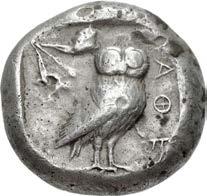

120. ATTICA, Athens. Circa 510-500/490 BC. AR Tetradrachm (22mm, 17.16 g, 1h). Helmeted head of Athena right / Owl standing right, head facing; olive spray to left; all within incuse square. Seltman Group L, unlisted dies; Asyut Group IVa; HGC 4, 1589. Lightly toned, struck with worn dies, scratches and marks. VF. Rare issue with archaic theta in ethnic. ($3000) Ex Classical Numismatic Group Electronic Auction 539 (31 May 2023), lot 106 (hammer $6000); Heritage 3091 (6 May 2021), lot 31019.
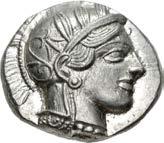

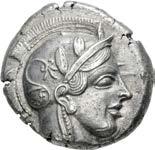
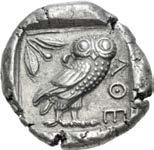
121. ATTICA, Athens. Circa 454-404 BC. AR Tetradrachm (26.5mm, 17.21 g, 10h). Helmeted head of Athena right, with frontal eye / Owl standing right, head facing, closed tail feathers; olive spray and crescent to left; all within incuse square. Kroll 8; HGC 4, 1597. Lustrous. Choice EF. High relief. ($1000)
122. ATTICA, Athens. Circa 454-404 BC. AR Tetradrachm (25mm, 16.56 g, 9h). Helmeted head of Athena right, with frontal eye / Owl standing right, head facing, closed tail feathers; olive spray and crescent to left; all within incuse square. Kroll 8; HGC 4, 1597. Toned, slight doubling around periphery. EF. Well centered on a broad flan, showing much of the crest. ($1000)
Ex Classical Numismatic Group 114 (13 May 2020), lot 165.
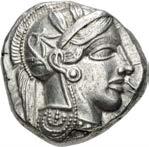



123. ATTICA, Athens. Circa 454-404 BC. AR Tetradrachm (24mm, 17.20 g, 4h). Helmeted head of Athena right, with frontal eye / Owl standing right, head facing, closed tail feathers; olive spray and crescent to left; all within incuse square. Kroll 8; HGC 4, 1597. Faintly toned, underlying luster, minor die break in field on obverse. EF. ($1000)
124. ATTICA, Athens. Circa 454-404 BC. AR Tetradrachm (24mm, 17.19 g, 4h). Helmeted head of Athena right, with frontal eye / Owl standing right, head facing, closed tail feathers; olive spray and crescent to left; all within incuse square. Kroll 8; HGC 4, 1597. In NGC encapsulation 6672356-019, graded Ch AU, Strike: 5/5, Surface: 4/5. ($1000)
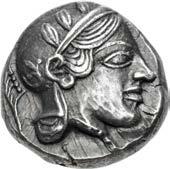



125. ATTICA, Athens. Circa 454-404 BC. AR Drachm (14mm, 4.29 g, 1h). Helmeted head of Athena right, with frontal eye / Owl standing right, head facing, closed tail feathers; olive spray and crescent to left; all within incuse square. Kroll 10; HGC 4, 1631; SNG Copenhagen 41–3; SNG München 60–4; Dewing 1599-602; Pozzi 1558. Attractive cabinet tone, slight die wear on obverse. EF. ($1500)



126. ATTICA, Athens. 3rd-early 2nd centuries BC. Bronze Counterfeiter’s Die. Dimensions: 20mm on its face, expanding to a 37mm base, with a height of 55mm. Weight 474 grams. Features the incuse of the reverse type typical of Athenian pi-style: Owl standing left, head facing, with an olive spray and crescent to right, and the ethnic to the left, with the leading leg of the alpha obscured by the neck of the owl. Unlike official pi-style coinage, which has a reverse type without an incuse, this die would produce a square incuse when striking a coin blank. Unpublished, but the lot includes a scientific analysis produced by the renowned art conservationist John Twilley, establishing the ancient origin of this piece. Brown surfaces, mostly covered by thick, rough green patina, with a small defect at its base, where a sample was taken for Twilley’s analysis. Extremely rare. ($10,000)

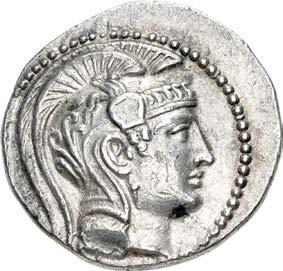
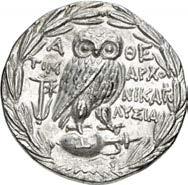
127. ATTICA, Athens. Circa 165-42 BC. AR Tetradrachm (31.5mm, 16.81 g, 12h). New Style coinage. Timarchos, Nikago–, and Lysia–, magistrates. Struck 134/3 BC. Helmeted head of Athena Parthenos right / Owl standing right, head facing, on amphora; magistrates’ names in fields, anchor and star to left, z on amphora, %f below; all within wreath. Thompson 364c (same obv. die); HGC 4, 1602. Traces of find patina, slight doubling on reverse. Near EF. ($1000)
Ex Property of a Private European Investment Consortium (Classical Numismatic Group XXXII, 7 December 1994), lot 1295 (part of).


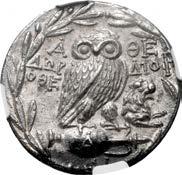
128. ATTICA, Athens. Circa 165-42 BC. AR Tetradrachm (29mm, 17.00 g, 11h). New Style coinage. Dorothe–and Dioph- magistrates. Struck 132/1 BC. Helmeted head of Athena right / Owl standing right, head facing, on amphora; magistrates’ names in fields; to right, forepart of lion right; Å on amphora, d5 below; all within wreath. Thompson 384a (same dies); Svoronos, Monnaies, pl. 46, 16 = Hermitage Sale II 931 (same dies); HGC 4, 1602. In NGC encapsulation 3955543-007, graded Ch AU, Strike: 5/5, Surface: 4/5. ($1000)
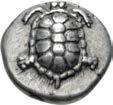

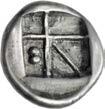
129. ISLANDS off ATTICA, Aegina. Circa 350-338 BC. AR Drachm (18mm, 5.55 g, 3h). Land tortoise with segmented shell / Incuse square with thin skew pattern; two pellets in one segment. Milbank Period V, pl. II, 16; HGC 6, 443. Old cabinet tone, cleaning scratches under tone. Good VF. ($1500)
Ex A. Hess AG 253 (8 March 1983), lot 193; Maxime Collignon Collection (Feuardent Frères, 17 December 1919), lot 263.


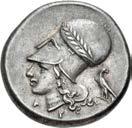
130. CORINTHIA, Corinth. Circa 350/45-285 BC. AR Stater (22mm, 8.64 g, 6h). Pegasos flying left / Helmeted head of Athena right; Å-r flanking neck truncation; to right, eagle standing left, head right. Ravel Period V, 1008; Pegasi 426; BCD Corinth 101; HGC 4, 1848. Old cabinet tone, light scratches mostly under tone. EF. ($1000)
Ex Mark & Lottie Salton Collection.
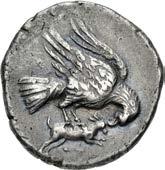



131. ELIS, Olympia. 134th-143rd Olympiad. Circa 244-208 BC. AR Drachm (18mm, 4.77 g, 5h). Eagle flying right, tearing at hare held in talons / Thunderbolt with double volutes above and wings below. Elis Hoard Group III, 13 (same dies); BCD Olympia 249 (same dies); HGC 5, 509. Iridescent tone, area of weak strike. VF. ($750)
From the Gerald F. Borrmann (Northern California Gentleman) Collection. Ex CNG inventory 830967 (September 2011); BCD Collection (not in previous BCD sales).




132. ISLANDS off ELIS, Ithaka. Mid-late 4th century BC. Æ (16mm, 3.69 g, 11h). Head of Odysseus right, wearing pilos / Thunderbolt within wreath. HGC 6, 121; SNG Copenhagen –; BMC 7–9. Dark green-brown patina, minor deposits, slight roughness. Near VF. Very rare, only two in CoinArchives: CNG 78, lot 705 (hammer $3100), and CNG 76, lot 563 (hammer $3800). ($2000)



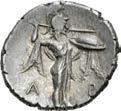
133. ARGOLIS, Argos. Circa 280-270/60 BC. AR Diobol (13.5mm, 1.57 g, 7h). Head of Hera right, wearing ornamented stephane / The Palladion right. BCD Peloponnesos 1097–9; HGC 5, 672. Old collection tone, with iridescence around the devices, area of weak strike. Near EF. Rare. ($500)
Ex Leu 79 (31 October 2000), lot 591.

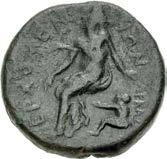

134. ARKADIA, Orchomenos. Circa 370-340 BC. Æ Dichalkon (18mm, 5.54 g, 10h). Artemis kneeling right, holding bow; to left, hound seated right / Kallisto seated left, falling backwards with arms outstretched, an arrow piercing her breast; below, the infant Arkas lying on his back, reaching upward toward Kallisto. BCD Peloponnesos 1575; HGC 5, 958. Dark green patina, light roughness. VF. Rare, and much better than the BCD example. ($500)
Ex Classical Numismatic Group 91 (19 September 2012), lot 209 (hammer $1500).
One of the nymphs who was a companion of Artemis, Kallisto was transformed into a bear and set among the stars, and, through her son Arkas, became the “bear-mother” of the Arkadians. The personage and mythology of Kallisto may have been a later addition, since the nymph’s name may derive from Kallistê (Καλλίστη), an epithet of Artemis, and the association with the bear from cult of Artemis Brauron, where its participants (prepubescent girls) were known as arktoi (αἱ ἄρκτοι), or “bears.”
According to a fragment of Hesiod’s lost work, Astronomoi (Eratosth [Cat.], frag. 1:2), and later retold by the Roman poet, Ovid (Met. 2.405-531), Kallisto was the daughter of Lykaon, the king of Arkadia. Vowing to remain a virgin, she became a companion of Artemis. Zeus, however, eventually became enamored of Kallisto, and impregnated her. Kallisto’s pregnancy was soon discovered when she was seen bathing. Angered by this, Artemis – perhaps at the insistence of Juno, according to Ovid – transformed the nymph into a bear; as a bear, Kallisto gave birth to a son named Arkas who became the eponymous founder of the Arkadians. Subsequently, either Artemis slew Kallisto, or it was Arkas himself who unwittingly did it, when his bear-mother wandered into a forbidden precinct of Zeus, or was stopped at the last moment. In recompense, Zeus then set both mother and son in the heavens as constellations – Ursa Major and Ursa Minor.









137. CYCLADES, Kythnos. Circa 530/20-500 BC. AR Tetrobol or Drachm (13mm, 4.11 g). Head of boar right / Rough incuse square. Sheedy Series I, 1–3 var. (O1/R– [unlisted rev. die]); HGC 6, 600; Traité I 983, pl. XXVIII, 7 (same obv. die). Toned. VF. ($1000)
Purchased by the consignor from Brian Kritt, 20 September 2006.




138. CYCLADES, Mykonos. 4th-3rd centuries BC. Æ (12.5mm, 1.66 g, 9h). Wreathed and bearded head of Dionysos right / Grape bunch on vine; barley grain to left. HGC 6, 616; SNG Copenhagen 698. Dark green-brown patina, a few spots of encrustation, light roughness. Good VF. ($1000)




139. TAURIC CHERSONESOS, Chersonesos. Circa 90-80 BC. AR Drachm (15.5mm, 4.12 g, 12h). Demetrios, magistrate. Head of Artemis right, bow and quiver over shoulder / Artemis Parthenos standing left, holding bow and striking with spear a stag lying left below. Anokhin, Khersonesa 191; Anokhin 817; HGC 3, 2067. Toned, some deposits, slightly off center on reverse. Near EF. Very rare, only four in CoinArchives. ($750)
Ex Numismatic Naumann 112 (2 January 2022), lot 36; Leu Numismatik Web Auction 16 (22 May 2021), lot 259; Leu Numismatik Web Auction 7 (23 February 2019), lot 1149.



140. CIMMERIAN BOSPOROS, Pantikapaion. Circa 340-325 BC. Æ (27mm, 13.43 g, 8h). Wreathed head of Pan left / Bow and arrow. Anokhin 1022; MacDonald 59; HGC 7, 106. Green-brown surfaces, a few minor surface flaws. EF. ($500)


141. KINGS of PONTOS. Mithradates VI Eupator. Circa 120-63 BC. AV Stater (19.5mm, 8.43 g, 12h). First Mithradatic War issue. In the name and types of Lysimachos of Thrace. Tomis mint. Struck circa 88-86 BC. Diademed head of the deified Alexander right, with horn of Ammon / Athena Nikephoros seated left; M¨ to inner left, to on throne; in exergue, ornate trident left. De Luca dies D1/R1; Callataÿ p. 141, D1/R1; HGC 7, 1931; SNG Copenhagen 1090 (same dies). Trace deposits, typical die wear. Good VF. ($1000)
From the Ramrodivs Collection. Ex Harlan J Berk inventory cc21328 (ND).



142. KINGS of PONTOS. Mithradates VI Eupator. Circa 120-63 BC. AR Tetradrachm (31mm, 16.62 g, 12h). Pergamon mint. Dated month 13, year 223 BE (October 74 BC). Diademed head right / Stag grazing left; to left, star-increscent above ˝˚s (year); to right, n above #; s below, 5˝ (month) in exergue; all within Dionysiac wreath of ivy and fruit. Callataÿ p. 21, unlisted dies; HGC 7, 340; DCA 692. Lightly toned, minor die breaks on obverse, double struck on reverse. EF. ($1500)
From the Mesogeios Collection.



143. BITHYNIA, Herakleia Pontike. Circa 520-510 BC. EL Hekte – Sixth Stater (10mm, 2.58 g). Head of Herakles left, wearing lion skin / Quadripartite incuse square. Fischer-Bossert, Electronhekten, Group 16, 115 (V50/R81); HGC 7, –; BMC 10. Minor edge splits, some die wear on obverse, minor marks on reverse. Good VF. ($500)

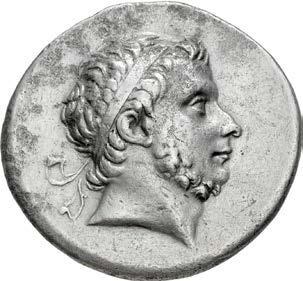

144. KINGS of BITHYNIA. Prousias I Cholos. Circa 228-182 BC. AR Tetradrachm (33mm, 16.34 g, 12h). Nikomedeia mint. Struck circa 210/00-182 BC. Diademed head right / Zeus Stephanephoros standing left; to inner left, thunderbolt above / above e. RG 9b; HGC 7, 614. Minor porosity, areas of light roughness. Good VF. ($750)
The historical record of Prousias I begins well into his reign, in 220 BC, when he defeated the forces of Byzantion, capturing their territories on the Asian side of the Thracian Bosporos; all the while his enemies, Attalos I of Pergamon and Adaios, the Seleukid general in Thrace, were supporting Prousias’ uncle as an usurper to his kingdom. Subsequently, circa 218 BC, Attalos encouraged the Galatians, who had previously murdered Prousias’ father, Ziaëlas, to invade Bithynia in order to weaken Prousias’ position, but they were decisively defeated. Prousias then allied with Philip V of Macedon during the First Macedonian War (214-205 BC), and attacked the territories of Attalos I, forcing the latter to withdraw his support from the Romans. In the aftermath of that conflict, Philip and Prousias jointly campaigned against Pergamon in the First Cretan War (205-200 BC). During the confilct, the Pergamene-controlled cities of Kios and Myrleia were destroyed, and upon their ruins Prousias founded the cities of Prousias by the Sea and Apameia, respectively. Over the next 12 years, Prousias stayed out of the region’s major conflicts, until a territorial dispute led to renewed conflict between the Attalids and Bithynians (187-183 BC). During this conflict, Prousias gave the famous Carthaginian general, Hannibal, asylum, for which the latter served as a military advisor to the Bithynian king. At the same time, Prousias expanded his kingdom by attacking the territory of Herakleia Pontike, but this venture came to a premature end when Prousias was injured in battle. This injury led to his epithet, Cholos (“the lame”). In 183 BC, the Attalid king, Eumenes II, decisively defeated the Bithynians, forcing Prousias to give up his territories in Phrygia and turn over Hannibal to the Romans (an event that the Carthaginian escaped by committing suicide). Prousias died the following year.



145. MYSIA, Kyzikos. Circa 600-550 BC. EL Hemihekte – Twelfth Stater (8mm, 1.33 g). Two tunny heads left, one above the other; to left, tunny upward; four pellets around / Incuse square. Hurter & Liewald III 17.2; cf. Von Fritze I 10 (unlisted denomination); Boston MFA –; SNG BN 168. Slight die wear. Near EF. Very rare. ($750)
From the Dr. Adrian Carr Collection. Ex Heritage 232210 (10 March 2022), lot 62104.
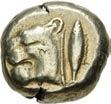


146. MYSIA, Kyzikos. Circa 550-450 BC. EL Stater (17.5mm, 16.09 g). Head of lion left; to right, tunny upward / Quadrapartite incuse square. Von Fritze I 39; Boston MFA 1414 = Warren 1537; SNG BN 178. Edge splits, small banker’s mark on obverse. Good VF. ($2000)
Ex Siren Collection (Classical Numismatic Group Electronic Auction 520, 20 July 2022), lot 105.

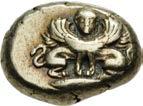

147. MYSIA, Kyzikos. Circa 550-450 BC. EL Hekte – Sixth Stater (11.5mm, 2.69 g). Double-bodied sphinx with one head facing, wearing ouraios; both atop tunny / Quadripartite incuse square. Von Fritze I 128; Boston MFA –; SNG BN 280. Attractive light toning, a little off center. VF. ($750)
From the Ramrodivs Collection. Ex Pegasi Numismatics inventory 11600146 (2000).



148. MYSIA, Kyzikos. Circa 550-450 BC. EL Stater (18mm, 15.88 g). Facing head of Silenos, protruding tongue; at sides, two tunnies upward / Quadripartite incuse square. Cf. Von Fritze I 77 (unlisted denomination); cf. Boston MFA 1424 = Warren 1465 (hekte); cf. SNG BN 208 (hekte); Hess-Divo 325, lot 210 = Sincona 10, lot 113 = Vinchon (24 Nov. 1994), lot 61 = M.J. Price, “1. A Field in Western Thrace” in CH II, 2. VF. ($2000)
Ex Classical Numismatic Group 103 (14 September 2016), lot 200.



149. MYSIA, Kyzikos. Circa 550-450 BC. EL Stater (17.5mm, 16.06 g). Forepart of winged boar left; below, tunny diagonally downward left; c/m: facing head of panther in conforming incuse / Quadripartite incuse square. Von Fritze I 61; Boston MFA 1440 = Warren 1563; SNG BN 192. Slight die shift on obverse. VF. ($1500)
Ex Siren Collection (Classical Numismatic Group Electronic Auction 513, 6 April 2022), lot 132.



150. MYSIA, Kyzikos. Circa 550-450 BC. EL Stater (22mm, 16.11 g). Harpy standing left, holding in right hand a tunny by its tail, on dotted ground line / Quadripartite incuse square. Von Fritze I 74; Boston MFA 1441 = Warren 1518; cf. SNG BN 203–4 (hektai). Edge split. VF. Rare as a stater. ($2000)
From the Ramrodivs Collection. Ex Pegasi Numismatics inventory 11850152 (20 April 2018).



151. MYSIA, Kyzikos. Circa 550-450 BC. EL Hekte – Sixth Stater (10.5mm, 2.64 g). Prow left, the lower hull decorated as a winged forepart of a wolf, the head of which forms the ship’s embolon (ram); below, tunny left / Quadripartite incuse square. Cf. Von Fritze I 80 (unlisted denomination); Boston MFA –; cf. SNG BN 210 (stater); SNG von Aulock 1183. Edge split, bankers’ marks on obverse. VF. Rare. ($500)
From the Dr. Adrian Carr Collection. Ex Numismatik Naumann 44 (7 June 2016), lot 207.
This prow type is exceptional among the electrum of Kyzikos, which typically portray deities, animals, and mythological creatures and scenes. Greenwell suggests that the prow portrayed here is probably intended to be that of the famed Argo, as the expedition of the Argonauts plays an important part in the mythological history of Kyzikos.



152. MYSIA, Kyzikos. Circa 550-450 BC. EL Hemihekte – Twelfth Stater (8mm, 1.28 g). Prow left, the lower hull decorated as a winged forepart of a wolf, the head of which forms the ship’s embolon (ram); below, tunny left / Quadripartite incuse square. Cf. Von Fritze I 80 (unlisted denomination); Boston MFA –; cf. SNG BN 210 (stater); Triton XVII, lot 255. Some minor marks. VF. Very rare as a hemihekte. ($500)
From the Dr. Adrian Carr Collection.



153. MYSIA, Kyzikos. Circa 550-450 BC. EL Stater (17.5mm, 16.03 g). Head of Athena left, wearing crested helmet with cheek guards, on tunny left / Quadripartite incuse square. Von Fritze I 67; Boston MFA 1446 = Warren 1443; SNG BN –. Edge split. VF. ($2000)
From the Dr. Adrian Carr Collection. Ex Roma E-Sale 44 (3 March 2018), lot 214.



154. MYSIA, Kyzikos. Circa 450-330 BC. EL Hekte – Sixth Stater (9.5mm, 2.63 g). Bearded head of Poseidon left, wearing helmet in the form of the scalp of a ketos; below, tunny left / Quadripartite incuse square. Hurter & Liewald I 17a; von Fritze I –; Boston MFA –; SNG BN –; SNG von Aulock 7291. Edge splits, slightly irregular flan. Good VF. Very rare. ($750)
From the Ramrodivs Collection. Ex Gemini XII (11 January 2015), lot 140; Berk BBS 194 (9 July 2015), lot 10.
The portrait has been identified by various numismatists as either Herakles, wearing a lion skin, or Perseus, wearing the skin of a griffin. Neither of these are very satisfactory. Those describing him as Herakles in a lion skin must have been referring to poorly preserved specimens, as the features on well-preserved examples clearly show that the portrait is not wearing the skin of a lion. At the same time, Perseus is unlikely to be shown wearing a beard, and the front end of the headdress has features that are inconsistent with the depiction of a griffin.
On close examination, the features of the headdress are identical to those of a ketos, a sea-monster depicted on many coins from disparate mints across the Mediterranean (most notably, Syracuse in Sicily and Halikarnassos in Caria). If the headdress is correctly that of a ketos, then the person is certainly not Perseus, but Herakles remains a possibility, as he did fight against one in his endeavor to rescuse the Trojan princess Hesione. However, another obvious candidate, given the marine nature of the portrait, would be Poseidon. Although he is most often depicted with an identifying trident, there are instances where this is not the case, particularly when his portrait is used on the obverse of a coin. Moreover, Poseidon (as Nethus) is depicted exactly as the portrait here on a group of bronzes from Etruria (cf. HN Italy 77–9 and EC I, pp. 319-21).



155. MYSIA, Kyzikos. Circa 550-450 BC. EL Hekte – Sixth Stater (10mm, 2.67 g). Head of Perseus left, wearing winged helmet; to right, tunny diagonally downward left / Quadripartite incuse square. Von Fritze I 65; cf. Boston MFA 1449 = Warren 1490 (stater); cf. SNG BN 193 (stater). Compact flan. VF. ($600)
From the Dr. Adrian Carr Collection. Ex Nomos Obolos 14 (15 December 2019), lot 177.

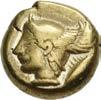

156. MYSIA, Kyzikos. Circa 550-450 BC. EL Hemihekte – Twelfth Stater (8mm, 1.31 g). Head of Perseus left, wearing winged helmet; to right, tunny diagonally downward left / Quadripartite incuse square. Cf. Von Fritze I 65 (unlisted denomination); cf. Boston MFA 1449 = Warren 1490 (stater); cf. SNG BN 193 (stater); Hurter & Liewald –. Faintly toned. VF. Extremely rare as a hemihekte, unknown to Hurter & Liewald, only two in CoinArchives (including the present coin; the other: Leu Numismatik Web Auction 20, lot 1044 = Leu Numismatik Web Auction 7, lot 1227). ($500)
From the Dr. Adrian Carr Collection. Ex Roma XX (29 October 2020), lot 204.



157. MYSIA, Kyzikos. Circa 550-450 BC. EL Stater (18.5mm, 16.02 g). Griffin standing left on tunny left / Quadripartite incuse square. Von Fritze I 99; Boston MFA 1455 = Warren 1572; SNG BN 239–40. Trace deposits, some marks, minor edge splits. VF. ($3000)
From the Gerald F. Borrmann (Northern California Gentleman) Collection. Ex Heritage 3015 (7 September 2011), lot 23106 (hammer $4250); Schweizerischer Bankverein 29 (28 January 1992), lot 124.



158. MYSIA, Kyzikos. Circa 550-450 BC. EL Hekte – Sixth Stater (11mm, 2.66 g). Hound (or wolf) at bay left on tunny left / Quadripartite incuse square. Von Fritze I 93; cf. Boston MFA 1470 = Warren 1565; SNG BN 231. Edge splits. Good VF. ($750)
From the Ramrodivs Collection. Ex Harlan J. Berk inventory cc82659 (August 2016); Berk BBS 193 (30 April 2015), lot 11.



159. MYSIA, Kyzikos. Circa 550-450 BC. EL Hekte – Sixth Stater (11mm, 2.68 g). Lioness or panther at bay left on tunny left / Quadripartite incuse square. Von Fritze I 86; Boston MFA 1472 = Warren 1529; SNG BN 219–20. Lightly toned, a couple of light scratches on reverse. Good VF. Attractive style. ($500)

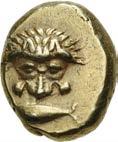

160. MYSIA, Kyzikos. Circa 550-450 BC. EL Hekte – Sixth Stater (9.5mm, 2.69 g). Lion scalp facing; below, tunny left / Quadripartite incuse square. Von Fritze I 82; cf. Boston MFA 1473 = Warren 1536 (stater); SNG BN 211. A little off center, minor mark on edge, reverse scratch. Good VF. ($1000)
From the Ramrodivs Collection, purchased from Michael Bezayiff.



161. MYSIA, Kyzikos. Circa 550-450 BC. EL Stater (18mm, 16.09 g). Nude youth, holding tunny by its tail in extended right hand, riding dolphin left; below, tunny left / Quadripartite incuse square. Von Fritze I 110; Boston MFA 1486 = Warren 1430; SNG BN –. Minor edge split, slightly off center, minor marks. Good VF. ($4000)
From the Ramrodivs Collection, purchased from Pegasi Numismatics, 2003.
This rare issue from Kyzikos depicts a nude youth riding a dolphin. Greenwell is of the opinion that this youth is Taras, son of Poseidon, and the coin is another example of the Kyzikene habit of copying the well-known designs of other states’ coins. In this case, the stater likely is copying the famous design of the Tarentine didrachm with the addition of the tunny. What the purpose was for emulating Taras’ style is unknown, but it gives us a delightful coin with a Kyzikene flavor to a Tarentine design.



162. MYSIA, Kyzikos. Circa 550-450 BC. EL Hekte – Sixth Stater (10mm, 2.70 g). Nude male kneeling left, holding a tunny by the tail / Quadripartite incuse square. Von Fritze I 112; Boston MFA 1488 = Warren 1503; SNG BN –. Toned. VF. ($750)
From the Dr. Adrian Carr Collection. Ex Noble 113 (22 November 2016), lot 4226; Classical Numismatic Group 93 (22 May 2013), lot 421.



163. MYSIA, Kyzikos. Circa 450-330 BC. EL Hekte – Sixth Stater (10mm, 2.65 g). Head of the hunter Aktaion left, with stag’s horn above forehead; below, tunny left / Quadripartite incuse square. Von Fritze I 141; cf. Boston MFA 1510 = Warren 1442 (stater); SNG BN 290. Light earthen deposits. VF. Very rare. ($500)
From the Dr. Adrian Carr Collection. Ex Leu Numismatik Web Auction 11 (23 February 2020), lot 815.
Aktaion was a famous hunter who learned his skills from the centaur Chiron. One day he accidentally came upon Artemis bathing: she was so angered by him seeing her naked that she transformed him into a stag and he was set upon and torn to pieces by his own hunting dogs. Here we see the start of the transformation process, with the horn just coming out of his head. This portrait was also used on roughly contemporary gold staters at the mint of Lampsakos (cf. SNG BN 1145).



164. MYSIA, Kyzikos. Circa 450-330 BC. EL Hemihekte – Twelfth Stater (8mm, 1.30 g). Helios, radiate and nude, crouching right, arms spread, holding the reins of two horse foreparts facing left and right in background / Quadripartite incuse square. Cf. Von Fritze I 148 (unlisted denomination); cf. Boston MFA 1515 (stater); cf. SNG BN 297 (stater); Hurter & Liewald –. A touch off center. Good VF. Apparently unique as a hemihekte. ($750)
From the Dr. Adrian Carr Collection. Ex Savoca 153 (22 January 2023), lot 82.



165. MYSIA, Kyzikos. Circa 450-330 BC. EL Stater (15.5mm, 15.93 g). Head of Attis right, wearing Phrygian headdress; below, tunny right / Quadripartite incuse punch. Von Fritze I 142; Boston MFA 1521; SNG BN 291. Trace earthen deposits, minor edge split, some minor marks. VF. ($3000)
From the Ramrodivs Collection. Ex Pars Coins inventory PCW-G670 (ND).
The portrait on this particular issue is thought to be Attis, the consort of Phrygian Kybele. The androgynous Kybele/Agdistis was castrated by the gods. From the severed parts grew an almond tree from which Attis sprang. Attis appears infrequently in Greek art, but he was raised in status when the Romans adopted the cult of Kybele.



166. MYSIA, Kyzikos. Circa 450-330 BC. EL Hekte – Sixth Stater (10mm, 2.75 g). Head of Attis right, wearing Phrygian headdress; below, tunny right / Quadripartite incuse square. Von Fritze I 142; Boston MFA 1523; SNG BN 292–3. Minor earthen deposits. Near EF. ($1000)
From the Ramrodivs Collection. Ex Harlan J. Berk inventory cc55239 (ND).

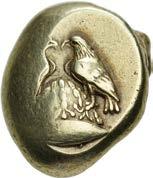

167. MYSIA, Kyzikos. Circa 450-330 BC. EL Stater (16mm, 15.98 g). Two eagles standing facing each other on ornamented omphalos; below, tunny right / Quadripartite incuse square. Von Fritze I 220; Boston MFA 1535 = Warren 1440; SNG BN 348. Lightly toned, compact oval flan. Good VF. Rare. ($4000)
From the Gerald F. Borrmann (Northern California Gentleman) Collection, purchased from B. A. Seaby, April 1981.
This rare type depicts the legend of the omphalos (navel) stone, which marked the sacred precinct of the sanctuary of Apollo at Delphi as the physical center of the earth. According to tradition, two eagles, which had been released by Zeus, one flying from the east, and the other from the west, met exactly at the site of Apollo’s sanctuary. This spot was marked for all to see by the stone omphalos, and designated as the center of the earth. The omphalos was a white stone ornamented with stripes of various kinds, and upon it were the representations of the two eagles (as seen on this coin type – the tunny fish below is the city-badge of Kyzikos). This scene was frequently represented in vase-paintings, but is extremely rare on coinage. The omphalos probably stood on the sacred hearth that was in the center of the temple.
The origins of Apollo’s temple at Delphi are described in the Homeric Hymn to Apollo. Apollo descended from Mt. Olympos and made his way through northern and central Greece until he finally found the proper site for the foundation of his oracle at Crisa under the snow-capped Mt. Parnassos. He laid out his temple and then slew a she-dragon which inhabited the area. The name of the site was subsequently called Pytho (and Apollo, the Pythian) due to the rotting body of the slain dragon. (The verb πύθειν, in Greek, means ‘to rot’.) Interestingly enough, Zeus punished Apollo for the murder of the dragon by exiling him to Thessaly for nine years. A religious festival called the Stepteria was celebrated every ninth year at Delphi to commemorate these events associated with the founding myth of the sanctuary.
After Apollo established his sanctuary, he went about the business of recruiting attendants for the temple. He noticed a ship passing by, manned by Cretans from Knossos, and on their way to Pylos. Apollo transformed himself into a dolphin (ἡ δελφίς, hence the name of the city) and leaped aboard the Cretan ship. At first the men tried to throw the dolphin back into the sea, but they were “awed” by it into a “fearful submission.” After a lengthy voyage, Apollo led the ship to Crisa, where “he leaped ashore and revealed himself as a god amid a blaze of fiery brightness and splendor.” He ordered the Cretan men to perform sacrifices and to pray to him as Apollo Delphinius. He then led them to his sanctuary and placed the Cretans in charge, predicting great wealth and prestige for his temple.
This story linked the early cult of Apollo to Crete and promoted Apollo as the god of sailors and colonization. His oracle at Delphi played a major role as the religious impetus for the Greeks in establishing their colonies, hence its importance to the residents of Kyzikos, itself a colony of Miletos. The importance of this coin type to Kyzikos may also be found in another story that has the city being settled by the Pelasgi from Thessaly, who were driven from Thessaly by the Aeolians. Their king and leader was Kyzikos, a son of Apollo, who gave his name to the city and thus established its link to Apollo and his temple at Delphi.


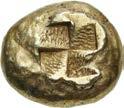
168. MYSIA, Kyzikos. Circa 450-330 BC. EL Stater (19mm, 15.93 g). Young Dionysos, holding kantharos, reclining left on panther skin draped over rock; thyrsos to left; below, tunny left / Quadripartite incuse square. Von Fritze I 155; Boston MFA 1541 = Warren 1457; SNG BN 302–3; Jameson 1425 (this coin). Lightly toned, slightly off center, minor marks, minor edge marks. VF. ($3000)
From the Ramrodivs Collection. Ex Harlan J. Berk inventory cc72065 (ND); Gemini IX (8 January 2012), lot 104; Numismatic Fine Arts V (23 February 1978), lot 141; Robert Jameson Collection (publ. 1913); J. Hirsch XIX (11 November 1907), lot 507.



169. MYSIA, Kyzikos. Circa 450-330 BC. EL Hekte – Sixth Stater (10mm, 2.66 g). Perseus crouching right, head left, holding harpa and head of Medusa; below, tunny right / Quadripartite incuse square. Von Fritze I 162; Boston MFA 1549 = Warren 1491; SNG BN 312. Slightly off center. VF. ($750)
From the Dr. Adrian Carr Collection. Ex Classical Numismatic Group Electronic Auction 411 (13 December 2017), lot 110.



170. MYSIA, Kyzikos. Circa 450-330 BC. EL Myshemihekte – Twenty-fourth Stater (7mm, 0.64 g). Eleutheria, holding wreath, seated left on rock inscribed E¬E/[UQ/Er] in tiny letters in three lines; below, tunny left / Quadripartite incuse square. Cf. von Fritze I 215 (unlisted denomination); Boston MFA –; cf. SNG BN 345 (stater); Hurter & Liewald II 215 (this coin cited). Edge split, off center on obverse. EF. Extremely rare as a myshemihekte, one listed by Hurter & Liewald (the present coin), four in CoinArchives. ($750)
From the Gerald F. Borrmann (Northern California Gentleman) Collection. Ex Münzen und Medaillen AG 41 (18 June 1970), lot 145.




171. MYSIA, Kyzikos. Mid 3rd century BC. AR Tetradrachm (30mm, 16.83 g, 12h). In the name and types of Lysimachos of Thrace. Diademed head of the deified Alexander right, with horn of Ammon / Athena Nikephoros seated left, left arm resting on shield, transverse spear in background; amphora to inner left; in exergue, boukranion facing, fillet hanging from each horn. SNG BN 2526; Müller 300. Lightly toned, underlying luster, minor marks. Good VF. Fine style. ($1500)
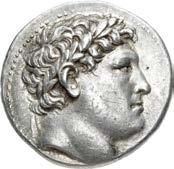

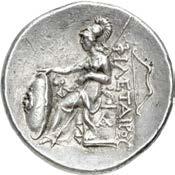
172. KINGS of PERGAMON. Eumenes I. 263-241 BC. AR Tetradrachm (29mm, 17.09 g, 12h). In the name of Philetairos. Pergamon mint. Struck circa 263-255/0 BC. Laureate head of Philetairos right / Athena enthroned left, right hand resting on shield set at her feet, left elbow resting on small sphinx seated right; transverse spear in background, ivy leaf above knee, v on throne, bow to right. Westermark Group III, obv. die XV; SNG BN 1607. Lightly toned, minor marks, shallow scratch on obverse. Near EF. ($1000)
Ex Giessener Münzhandlung 58 (9 April 1992), lot 370.
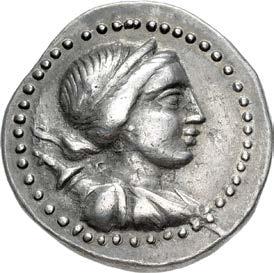
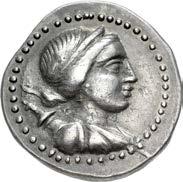
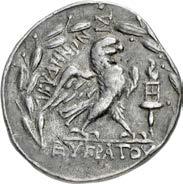
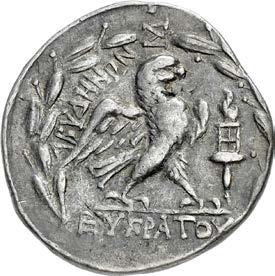
173. TROAS, Abydos. Circa 80-70 BC. AR Tetradrachm (30.5mm, 16.82 g, 12h). Stephanophoric type. Eukrates, magistrate. Draped bust of Artemis right, wearing stephane, bow and quiver over shoulder / Eagle, wings spread, standing right; % above, lit torch to right; all within wreath. Callataÿ, Abydos, dies D21/R– (unlisted rev. with sigma at top of wreath); otherwise, unpublished. Toned, some find patina, indications of undertype. Good VF. Only two examples with this magistrate known (one noted by Callataÿ, one additional in CoinArchives [Roma XIX, lot 452]), but apparently unique with a sigma at the top of the wreath. ($750)
Ex Roma XXVII (22 March 2023), lot 253.




174. TROAS, Alexandreia. Circa 171-66/5 BC. AR Tetradrachm (37mm, 14.36 g, 11h). Undated issue. Laureate head of Apollo right / Apollo Smintheos standing right, holding phiale, bow, and arrow; E to lower inner left, Ɓ to inner right. Bellinger –; Münzen und Medaillen GmbH 40, lot 221 (same obv. die); CNG E-539, lot 147 (same obv. die). Rough find patina, cleaning marks. VF. Very rare undated issue. ($1000)
175. TROAS, Ilion. Circa 185-50 BC. AR Tetradrachm (35mm, 14.54 g, 12h). Metriketes, president of the aonothetai Helmeted head of Athena right / Athena Ilias standing right, holding distaff and filleted spear; at her feet to right, owl standing right, head facing; E to inner left. Ellis-Evans dies O3/R11; Bellinger T39. Lightly toned, rough surfaces, some scratches in field on reverse, light chipping on edge. VF. Rare. ($1000)
Ex Classical Numismatic Group 121 (6 October 2022), lot 311.
Founded in the seventh century BC by Aeolians on the site of ancient Troy, Ilion prospered and ultimately developed into a successful Hellenistic and Roman city. It possessed a famous temple of Athena (‘Ilias’) which was visited by King Xerxes of Persia and later by Alexander the Great.
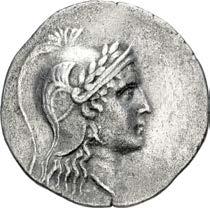


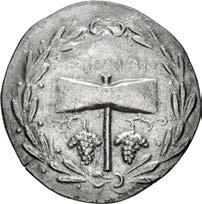
176. TROAS, Ilion. Circa 185-50 BC. AR Tetradrachm (35mm, 14.87 g, 12h). Dionysodoros, president of the Aonothetai. Helmeted head of Athena right / Athena Ilias standing right, holding distaff and filleted spear; Ƃ to inner left; to inner right, owl standing right, head facing. Ellis-Evans dies O8/R– (unlisted rev. die); Bellinger T42 (same obv. die). Lightly toned, light roughness and porosity, cleaning marks. VF. Very rare, only two examples of this issue noted by Ellis-Evans, both in a museum collection (Berlin); two in CoinArchives. ($1000)
177. ISLANDS off TROAS, Tenedos. Circa 100-70 BC. AR Tetradrachm (33mm, 13.68 g, 12h). Stephanophoric type. Janiform head of a bearded male left, laureate, and female right, wearing stephane / Labrys; grape bunches on vines flanking handle; all within wreath. Callataÿ, Tenedos 1 var. (D1/R– [unlisted rev. die]); HGC 6, 390; CNG 126, lot 221 (same dies; hammer $3000). Toned, much find patina, light roughness, faint cleaning marks. VF. Very rare issue with two grape bunches; only one noted by Callataÿ, and only four in CoinArchives. ($1000)


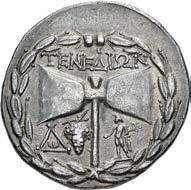

178. ISLANDS off TROAS, Tenedos. Circa 100-70 BC. AR Tetradrachm (32mm, 15.86 g, 12h). Stephanophoric type. Janiform head of a male left, laureate, and female right, wearing stephane / Labrys; tE@Ed5W@ above, " and grape bunch to left of handle; to right, Hermes standing left, holding kerykeion; all within wreath. Cf. Callataÿ, Tenedos 49–55 (drachms); cf. HGC 6, 390 (unlisted controls); Roma XXVII, lot 257 (same rev. die). Attractively toned, minor doubling. Good VF. Extremely rare denomination for issue. ($5000)
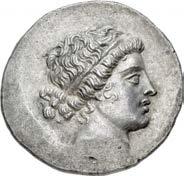
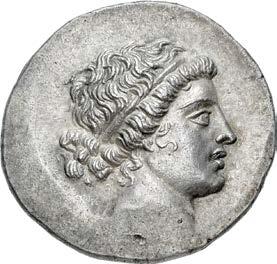

179. AEOLIS, Kyme. Circa 151/0-143/2 BC. AR Tetradrachm (30mm, 16.54 g, 12h). Stephanophoric type. Kallias, magistrate. Head of the Amazon Kyme right, wearing tainia / Horse prancing right; one-handled cup below raised foreleg; all within wreath. E-E&E-Ö, Phase III, 12; Oakley dies 31/b (this coin referenced); SNG Copenhagen 103. Attractively toned, spot of die rust on obverse, trace deposits. EF. Fine style. ($1500)
Ex J. de Wilde Collection (Classical Numismatic Group 120, 11 May 2022), lot 318; Elsen 116 (16 March 2013), lot 111; Leu 7 (9 May 1973), lot 213.
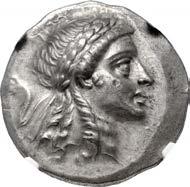

180. AEOLIS, Myrina. Circa 155-143 BC. AR Tetradrachm (30mm, 16.85 g, 12h). Stephanophoric type. Laureate head of Apollo right / Apollo Grynios standing right, holding phiale and filleted laurel branch; ï to left, omphalos and amphora at feet to right; all within laurel wreath. Sacks Issue 18, obv. die 10; SNG von Aulock 1664 (same obv. die); BMC 11 (same obv. die). In NGC encapsulation 6830065-001, graded Ch XF, Strike: 4/5, Surface: 4/5. ($750)



181. AEOLIS, Myrina. Circa 155-143 BC. AR Tetradrachm (31.5mm, 16.35 g, 12h). Stephanophoric type. Laureate head of Apollo right / Apollo Grynios standing right, holding phiale and filleted laurel branch; ï to left, omphalos and amphora at feet to right; all within laurel wreath. Sacks Issue 18, dies 11/l; Dewing 2231 (same obv. die). Faint iridescent tone, small area of weak strike on reverse. Near EF. Lot includes a David Sear certificate of authenticity. ($750)
From the Richard J. Sullivan Collection. Ex Noble 85 (24 July 2007), lot 3147; Dr. Colin Burnside Collection; Noble 64 (12 July 2000), lot 2287.




182. LESBOS, Mytilene. Circa 521-478 BC. EL Hekte – Sixth Stater (11.5mm, 2.50 g, 6h). Forepart of winged lion left / Incuse head of cock left; rectangular punch to right. Bodenstedt Em. 9.1; HGC 6, 933. Some granularity, minor edge split. VF. ($1000)
From the Ramrodivs Collection. Ex Harlan J. Berk inventory cc85009 (ND).



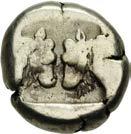
183. LESBOS, Mytilene. Circa 454-428/7 BC. EL Hekte – Sixth Stater (10mm, 2.50 g, 1h). Wreathed and bearded head of Dionysos right / Confronted calf heads; all within incuse square. Bodenstedt Em. 50; HGC 6, 976 corr. (palmette not always present). Minor edge spits. VF. ($750)
From the Ramrodivs Collection. Ex Pegasi Numismatics inventory 11450341 (April 2018).
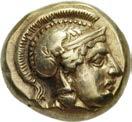



184. LESBOS, Mytilene. Circa 412-378 BC. EL Hekte – Sixth Stater (11mm, 2.55 g, 3h). Helemted head of Athena right, wearing crested Attic helmet / Head of Pharnabazos right, wearing satrapal headdress, in linear square within incuse square. Bodenstedt Em. 71; HGC 6, 997. Lightly toned, minor marks. VF. Well centered. ($500)
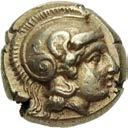



185. LESBOS, Mytilene. Circa 412-378 BC. EL Hekte – Sixth Stater (10.5mm, 2.55 g, 6h). Helmeted head of Athena right / Head of Artemis-Kybele right, wearing stephane; all in linear frame within incuse square. Bodenstedt Em. 73; HGC 6, 999. Lightly toned, area of weak strike on reverse. VF. Well centered. ($500)




186. LESBOS, Mytilene. Circa 412-378 BC. EL Hekte – Sixth Stater (10mm, 2.56 g, 6h). Head of Ariadne left, hair in sakkos decorated with three grape bunches / Lion, spearhead in jaws, right in linear square within incuse square. Bodenstedt Em. 78; HGC 6, 1004. Iridescent toning, some light deposits, tiny pit on obverse. Near EF ($1000)
Ex Classical Numismatic Group 99 (13 May 2015), lot 209.




187. LESBOS, Mytilene. Circa 377-326 BC. EL Hekte – Sixth Stater (10mm, 2.53 g, 12h). Wreathed head of Persephone right / Bull butting left in linear square within shallow incuse square. Bodenstedt Em. 88; HGC 6, 1014 corr. (bull butting left, not right). Attractive light toning. Good VF. ($500)
From the Ramrodivs Collection. Ex Harlan J. Berk inventory cc71367 (ND).




188. LESBOS, Mytilene. Circa 377-326 BC. EL Hekte – Sixth Stater (10mm, 2.56 g, 12h). Wreathed head of Dionysos right / Head of satyr facing, with no hair, in linear square within shallow incuse square. Bodenstedt Em. 90; HGC 6, 1016 corr. (symbols sometimes on rev.). Minor die wear on obverse. Good VF. ($750)
From the Ramrodivs Collection.




189. LESBOS, Mytilene. Circa 377-326 BC. EL Hekte – Sixth Stater (10mm, 2.55 g, 12h). Veiled head of Demeter right, wearing wreath of grain ears / Tripod tied with fillet in linear square within incuse square. Bodenstedt Em. 91; HGC 6, 1017. Toned, minor deposits. EF. ($750)
From the Ramrodivs Collection. Ex Berk BBS 175 (7 July 2011), lot 22.
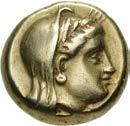



190. LESBOS, Mytilene. Circa 377-326 BC. EL Hekte – Sixth Stater (10.5mm, 2.53 g, 12h). Veiled head of Demeter right, wearing wreath of grain ears / Tripod tied with fillet in linear square within incuse square. Bodenstedt Em. 91; HGC 6, 1017. Faintly toned, hairlines, minor die wear. Good VF. ($500)
From the Gerald F. Borrmann (Northern California Gentleman) Collection, purchased from B. A. Seaby, September 1979.



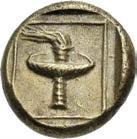
191. LESBOS, Mytilene. Circa 377-326 BC. EL Hekte – Sixth Stater (11mm, 2.53 g, 12h). Half length bust of Maenad, hair in sphendone, right / Race torch in linear square within shallow incuse square. Bodenstedt Em. 92; HGC 6, 1018. Toned, scratches and scrapes. Good VF. ($750)
From the Ramrodivs Collection. Ex Musa Numismatic Art inventory 10861 (ND).




192. LESBOS, Mytilene. Circa 377-326 BC. EL Hekte – Sixth Stater (10.5mm, 2.53 g, 6h). Laureate head of Apollo right / Head of Artemis right, hair bound in sphendone; coiled serpent behind neck; [all in linear square within shallow incuse square]. Bodenstedt Em. 100A; HGC 6, 1026. Some die rust. Good VF. ($500)
From the Ramrodivs Collection. Ex Harlan J. Berk inventory cc58186 (ND).




193. LESBOS, Mytilene. Circa 377-326 BC. EL Hekte – Sixth Stater (10.5mm, 2.55 g, 12h). Head of Zeus Meilichios right, wearing laurel wreath; small serpent before chin / Draped bust of Nike facing, head right; stars flanking above; all within linear square. Bodenstedt Em. 101; HGC 6, 1027. Die rust on obverse, minor die wear on reverse. Good VF. ($1000)
From the Ramrodivs Collection. Ex Berk BBS 174 (10 May 2011), lot 2 (hammer $4000).



194. IONIA, Ephesos. Phanes. Circa 625-600 BC. EL Hemihekte – Twelfth Stater (9mm, 1.22 g). Forepart of stag left, head right / Incuse square with raised lines within. Fischer-Bossert, Phanes 26c (O17/R27s – this coin); Weidauer 38 (same dies); K&K 28 = Head, Coins 74. Struck with somewhat worn dies. VF. ($1000)
From the Gerald F. Borrmann (Northern California Gentleman) Collection. Ex Classical Numismatic Group 70 (21 September 2005), lot 240.



195. IONIA, Ephesos. Circa 600-550 BC. EL Trite – Third Stater (14mm, 4.73 g). “Primitive” bee / Two incuse squares. Karwiese I, Series II.1, Type 2, 6–8 (same die and punches); SNG Kayhan –; SNG von Aulock 1768 (same obv. die); Rosen 257 (same die and punches). Typical die wear. Near VF. Rare. ($1000)
From the Dr. Adrian Carr Collection. Ex Heritage 232005 (31 January 2020), lot 65068.



196. IONIA, Ephesos. Circa 550-500 BC. EL Hemihekte – Twelfth Stater (7mm, 1.17 g). Bee / Incuse square. Karwiese I, Series III, 1–2; cf. SNG Kayhan 1221 (1/48th stater). Hairlines. Near VF. Very rare. ($750)



197. IONIA, Ephesos. Circa 390-325 BC. AR Tetradrachm (23mm, 15.14 g, 12h). Menoitos (I), magistrate. Class D, circa 370-360 BC. Bee with straight wings / Forepart of stag right; palm tree to left. Karwiese II, Series 11.1, 421, dies O45/ R1. Lightly toned, minor die wear on obverse, faint cleaning marks on reverse. Good VF. Rare magistrate, 13 examples noted by Karweise. ($1500)
Ex Nomos Obolos 19 (8 May 2021), lot 376.
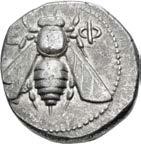

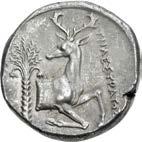
198. IONIA, Ephesos. Circa 390-325 BC. AR Tetradrachm (23mm, 15.25 g, 12h). Telestratos, magistrate. Class F, circa 360-350 BC. Bee with straight wings / Forepart of stag right; palm tree to left. Karwiese II, Series 11.1, 512, dies O82/R1; Weber 2784 (same dies). Lightly toned, minor die wear on obverse. Good VF. ($2000)



199. IONIA, Ephesos. Circa 123-119 BC. AV Stater (19mm, 8.61 g, 12h). Draped bust of Artemis right, wearing stephane, bow and quiver over shoulder / Cult statue of Artemis of Ephesos facing; bee to upper left. Jenkins, Hellenistic, –; CNG E-484, lot 299 var. (long ethnic). Traces of find patina, struck with worn obverse die, some gouges in field on reverse. VF. Extremely rare variety with short ethnic. ($2000)
From the Gerald F. Borrmann (Northern California Gentleman) Collection. Ex Classical Numismatic Group XXVI (11 June 1993), lot 103.


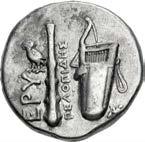
200. IONIA, Erythrai. Circa 360-342 BC. AR Tetradrachm (23.5mm, 15.11 g, 6h). Pelopides, magistrate. Head of Herakles right, wearing lion skin / Bow and bowcase; to upper left, owl standing right, head facing; unclear monogram to lower right. Kinns Period II, Phase II, Group IA, 27, dies O1/R3; Weber 5923. Lightly toned, some horn silver. VF. Very rare. ($750)



201. IONIA, Herakleia ad Latmon. Circa 140-135 BC. AR Tetradrachm (31mm, 16.66 g, 12h). Stephanophoric type. Helmeted head of Athena Parthenos right / Club; below, Nike walking left, holding wreath, flanked by ñ and V; all within oak wreath. Lavva, Silberprägung, Group II.B, 11–2 var. (V7/R– [unlisted rev. die]); SNG Lockett 2823 = Pozzi 2452. Light iridescent tone, area of flat strike on obverse, minor deposits on reverse. Good VF. ($1000)
Ex Kleinkunst Collection (Leu Numismatik 6, 23 October 2020), lot 185; Schweizerische Kreditanstalt 2 (27 April 1984), lot 225.

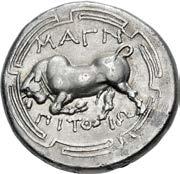

202. IONIA, Magnesia ad Maeandrum. Circa 350-325 BC. AR Didrachm (20mm, 7.08 g, 11h). Rhodian standard. Pithio(n), magistrate. Warrior, holding couched lance, on horse advancing right / Bull butting left within circular maeander pattern. SNG von Aulock 2039 var. (longer form of name). Iridescent tone. Good VF. ($1000)
Ex Elsen 49 (19 April 1997), lot 279.


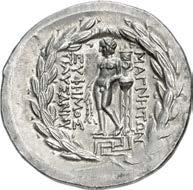
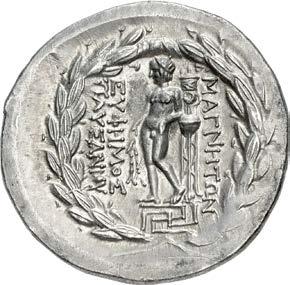
203. IONIA, Magnesia ad Maeandrum. Mid 140s BC. AR Tetradrachm (32mm, 16.64 g, 12h). Stephanophoric type. Euphemos, son of Pausanias, “magistrate”. Diademed and draped bust of Artemis right, bow and quiver over shoulder / Apollo standing left, resting on tall tripod to right, holding branch tied with fillet; maeander pattern below; all within laurel wreath. Ellis-Evans, Wreathed, dies 19/EP33; Jones obv. die 13; SNG Berry 1068. Lightly toned over lustrous surfaces, a couple of scratches. EF. ($1500)
Ex Classical Numismatic Group 121 (6 October 2022), lot 344.

204
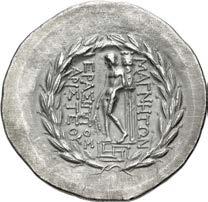

205

204. IONIA, Magnesia ad Maeandrum. Mid 140s BC. AR Tetradrachm (34.5mm, 17.06 g, 12h). Stephanophoric type. Erasippos, son of Aristeas, “magistrate”. Diademed and draped bust of Artemis right, bow and quiver over shoulder / Apollo standing left, resting on tall tripod to right, holding branch tied with fillet; maeander pattern below; all within laurel wreath. Ellis-Evans, Wreathed, dies 31/EA15; Jones obv. die 29; Pozzi 2461 (same obv. die). Lightly toned, traces of horn silver, hairlines. Near EF. ($1000)
From the Wayne Scheible Collection.
205. IONIA, Magnesia ad Maeandrum. Mid 140s BC. AR Tetradrachm (33mm, 17.16 g, 1h). Stephanophoric type. Erasippos, son of Aristeas, “magistrate”. Diademed and draped bust of Artemis right, bow and quiver over shoulder / Apollo standing left, resting on tall tripod to right, holding branch tied with fillet; maeander pattern below; all within laurel wreath. EllisEvans, Wreathed, dies 31/EA15; Jones obv. die 29; Pozzi 2461 (same obv. die). Toned, light horn silver. Near EF. Lot includes a David Sear certificate of authenticity. ($1000)
From the Richard J. Sullivan Collection.
in Hilbert
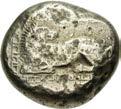


206. IONIA, Miletos. Circa 600-546 BC. EL Stater (19mm, 13.95 g). Lion reclining left, head reverted, within rectangular frame divided into smaller rectangular compartments / Central oblong punch, containing three pellets and a quadruped standing left, flanked by two punches containing, respectively, the head of stag right and a stellate pattern. Hilbert Phase 2, S50.4 (dies A24/Hk13-F16-X7 – this coin, illustrated); SNG Kayhan 440. Faintly toned, some die wear and flan flaws on obverse, marks on reverse. VF. ($3000)
From the Dr. Adrian Carr Collection, purchased from Henzen Numismatics, January 2020. Ex Henzen Numismatics inventory 102253 (2017).









207. IONIA, Phokaia. Circa 521-478 BC. EL Hekte – Sixth Stater (10mm, 2.55 g). Three seals swimming counterclockwise / Incuse square. Bodenstedt Em. 29. Toned, a little off center. VF. Rare. ($750)
208. IONIA, Phokaia. Circa 521-478 BC. EL Hekte – Sixth Stater (10.5mm, 2.56 g). Horned head of river god left; [to right, small seal upward] / Quadripartite incuse square. Bodenstedt Em. 35. Scattered marks. Good VF. ($1000)
From the Ramrodivs Collection. Ex Pegasi Numismatics inventory 11600144 (ND).
209. IONIA, Phokaia. Circa 478-387 BC. EL Hekte – Sixth Stater (10mm, 2.58 g). Head of young male left, wearing Silenos mask on top of his head; [to right, small seal downward] / Quadripartite incuse square. Bodenstedt Em. 70. Toned, light roughness, minor marks. Good VF. ($1000)
From the Dr. Adrian Carr Collection. Ex Noble 113 (22 November 2016), lot 4224; Nomos AG FPL (Winter-Spring 2014), no. 28.

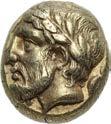

210. IONIA, Phokaia. Circa 478-387 BC. EL Hekte – Sixth Stater (9mm, 2.51 g). Laureate head of Zeus left; to right, small seal upward / Quadripartite incuse square. Bodenstedt –, but cf. Em. 76 (citing only two examples: Boston MFA 1916 and Traité II 2124–both with a similar portrait type but without laurel wreath); CNG 105, lot 322 = CNG E-459, lot 247 (same dies); Roma III, lot 209 (same dies); Roma XI, lot 321 (same dies). Toned, struck on a compact flan. Good VF. Extremely rare, one of approximately five known examples. ($1500)
From the Dr. Adrian Carr Collection. Ex Classical Numismatic Group 103 (14 September 2016), lot 272.
With Bodenstedt citing only two examples for his Em. 76 (Paris and Boston), it is possible that this type, with the laurel wreath, is part of the same emission, and that a celator simply added the laurel wreath to the portrait.

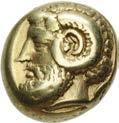







211. IONIA, Phokaia. Circa 478-387 BC. EL Hekte – Sixth Stater (9.5mm, 2.52 g). Bearded head of Zeus Ammon left; [to right, small seal downward] / Quadripartite incuse square. Bodenstedt Em. 81. Edge marks, minor die break on obverse. Good VF. Fine style. Very rare. ($750)
212. IONIA, Phokaia. Circa 478-387 BC. EL Hekte – Sixth Stater (10mm, 2.50 g). Helmeted head of Athena left; [below, small seal left] / Quadripartite incuse square. Bodenstedt Em. 91. Faintly toned, a few hairlines. Good VF. ($500)
213. IONIA, Phokaia. Circa 478-387 BC. EL Hekte – Sixth Stater (10.5mm, 2.54 g). Wreathed head of young Pan left; below, small seal left / Quadripartite incuse square. Bodenstedt Em. 97, obv. die e. Lightly toned, a few marks. Good VF. ($500)
From the Gerald F. Borrmann (Northern California Gentleman) Collection, purchased from A. Kosoff, March 1967.




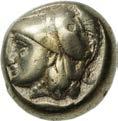

214. IONIA, Phokaia. Circa 387-326 BC. EL Hekte – Sixth Stater (10mm, 2.56 g). Laureate female head left, hair in sakkos; below, small inverted seal right / Quadripartite incuse square. Bodenstedt Em. 102. Lightly toned. Good VF. Well centered. ($500)
From the Dr. Adrian Carr Collection. Ex Classical Numismatic Group Electronic Auction 408 (25 October 2017), lot 191.
215. IONIA, Phokaia. Circa 387-326 BC. EL Hekte – Sixth Stater (9mm, 2.52 g). Helmeted head of Athena left; below, small seal left / Quadripartite incuse square. Bodenstedt Em. 111. A touch off center, some hairlines. VF. ($500)
From the Ramrodivs Collection, purchased from Harlan J. Berk, 20 April 2011.



216. IONIA, Teos. Circa 500-450 BC. AR Stater (21mm, 11.98 g). Griffin seated right, raising foreleg; Â-E below / Quadripartite incuse square. Matzke Series Ca1; Balcer Group IV, 12 corr. (A12/P16 [M not noted]); Traité I 500. Lightly toned, tiny flan flaw on obverse. VF. ($750) Ex Sovereign Rarities 7 (21 September 2022), lot 73; Classical Numismatic Group 79 (17 September 2008), lot 349.
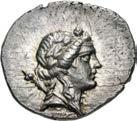


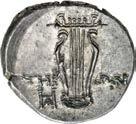
217. IONIA, Teos. Circa 204-190 BC. AR Hemidrachm (15mm, 1.79 g, 12h). Rhodian standard. Wreathed head of young Dionysos right; thyrsos over shoulder / Chelys; Ƅ to lower left. Kinns 128 corr. (monogram); Winterthur 3201 (same rev. die). Light iridescent tone, underlying luster, slight die wear, minor die shift on reverse. EF. Very rare, only two examples noted by Kinns, three additional in CoinArchives. ($500)









218. IONIA, Uncertain. Circa 650-600 BC. EL Hemihekte – Twelfth Stater (7mm, 1.15 g). Lydo-Milesian standard. Flattened striated surface / Incuse square. Weidauer Group II, 9; cf. Artemision 29 and 4 (hekte and myshiemihekte); Traité I 13; Elektron II 13–4; SNG Kayhan 681. Small scuff at edge on obverse. As made. ($750)
219. IONIA, Uncertain. Circa 650-600 BC. EL Trite – Third Stater (11.5mm, 4.62 g). Lydo-Milesian standard. Globular surface with cluster of pellets / Two incuse squares. Weidauer –; Artemision –; Traité I 3; SNG Kayhan –; SNG von Aulock 7761. As made. ($1000)
220. IONIA, Uncertain. Circa 650-600 BC. EL Hekte – Sixth Stater (10mm, 2.29 g). Lydo-Milesian standard. Globular surface with cluster of pellets / Two incuse squares. Weidauer –; Artemision –; Traité I –; SNG Kayhan –; SNG von Aulock –; Elektron 10. As made. Very rare as a hekte. ($750)






221. IONIA, Uncertain. Circa 650-600 BC. EL Hekte – Sixth Stater (9.5mm, 2.29 g). Lydo-Milesian standard. Globular surface with cluster of pellets / Two incuse squares. Weidauer –; Artemision –; Traité I –; SNG Kayhan –; SNG von Aulock –; Elektron 10. As made. Very rare as a hekte. ($750)
222. IONIA, Uncertain. Circa 650-600 BC. EL Trite – Third Stater (12mm, 4.62 g). Lydo-Milesian standard. Globular surface with cluster of pellets / Incuse rectangle. Weidauer –; Artemision –; Traité I 3 var. (incuse); SNG Kayhan –; SNG von Aulock 7761 var. (same). As made. ($1000)




223. IONIA, Uncertain. Circa 625-600 BC. EL Trite – Third Stater (11mm, 4.66 g). Lydo-Milesian standard. Geometric figure resembling a star, composed of a cross centered upon a polygon of eight sides / Rectangular incuse divided horizontally and vertically into four compartments by two perpendicular lines; the upper two compartments divided into halves by a single line, the upper halves each containing a pellet, the lower halves bisected by two small vertical lines; the lower two compartments divided into thirds by two parallel lines. McFadden 1; Konuk & Lorber fig. 14; Elektron I 16; Rosen Sale 12; Traité –; Zhuyuetang 2; SNG von Aulock –; SNG Copenhagen (Cyprus, etc.), pl. 10, 318; SNG Kayhan 697. Trace deposits. VF. ($2000)
From the Wild Rose Collection, purchased from Wayne Hansen, July 2015. Purchased by Hansen from Calgary Coin Gallery, March 2003, which had acquired the coin from Jonathan K. Kern (his ticket included).






224. IONIA, Uncertain. Circa 625-600 BC. EL Myshemihekte – Twenty-fourth Stater (6.5mm, 0.56 g). Lydo-Milesian standard. Geometric figure resembling a star, composed of a crosshatch design, with two parallel lines splayed at one end / Quadripartite incuse square punch with a pellet in the center; each quarter contains a diagonal line radiating from the central pellet; some sections contain further lines. McFadden 4; Traité –; Elektron II 16; SNG Kayhan 701. EF. ($750)
225. IONIA, Uncertain (Ephesos?). Circa 600-550 BC. EL Hekte – Sixth Stater (11mm, 2.34 g). Lydo-Milesian standard. Uncertain design (bee?) / Two incuse squares. Cf. Karwiese Serie II, 2 (trite; one rev. punch is the same or extremely similar); otherwise, unpublished in the standard references. Toned. VF. Extremely rare. ($1000)
From the Gerald F. Borrmann (Northern California Gentleman) Collection. Ex CNG inventory 968341 (December 2013); Classical Numismatic Group 94 (18 September 2013), lot 590.

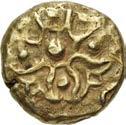

226. IONIA, Uncertain. Circa 600-550 BC. EL Hekte – Sixth Stater (10.5mm, 2.21 g). Lydo-Milesian standard. Four schematic lotus flowers cruciform around central pellet; four pellets around / Incuse square. Unpublished in the standard references. Lightly toned, a couple of light marks, minor scrape on edge. Good VF. Apparently unique. ($750)
From the Dr. Adrian Carr Collection. Ex Tauler & Fau 69 (10 November 2020), lot 2007.

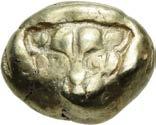




227. IONIA, Uncertain. Circa 600-550 BC. EL Trite – Third Stater (12.5mm, 4.66 g). Lydo-Milesian standard. Facing head of lion or panther within triangular incuse [on a raised area] / Two incuse squares with raised lines within. Weidauer Group XXXII, 158-9; Traité I 28; Elektron I 19; SNG von Aulock –; cf. SNG Kayhan 711 (hekte); Boston MFA 1753; cf. Rosen 267 (hekte). Typical compact flan. VF. Very rare denomination, much rarer than the hekte and hemihekte. ($1500)
This trite is part of an electrum series consisting of staters, trites, hektes, hemihektes, and twenty-fourth staters (cf. Weidauer 156-65). Miletos and Samos have been proposed as the possible mint, though the former is now discounted by R. Hilbert’s die study of the electrum issues of that mint, while the weight standard suggests that the latter mint is unlikely
228. IONIA, Uncertain. Circa 550-525 BC. EL Hekte – Sixth Stater (10.5mm, 2.35 g). Lydo-Milesian standard. Bridled forepart of winged horse left / Incuse square. Fischer-Bossert, Horses, Series II, 10 (OP9/P16 – this coin, illustrated). Light scratch on obverse. VF. Rare. ($750)
From the Dr. Adrian Carr Collection. Ex Stack’s Bowers Galleries (January 2022), lot 3070; Heritage 3035 (3 September 2014), lot 29086.






229. KINGS of LYDIA. temp. Alyattes – Kroisos. Circa 620/10-550/39 BC. EL Trite – Third Stater (13.5mm, 4.71 g). Lydo-Milesian standard. Sardes mint. Head of roaring lion right, “sun” with multiple rays on forehead / Two incuse squares. Weidauer Group XVI, 86–7; Kurth G24–5; cf. SNG Ashmolean 749–53. Good VF. ($1500)
From the Dr. Adrian Carr Collection. Ex Classical Numismatic Group Electronic Auction 461 (12 February 2020), lot 175.
230. KINGS of LYDIA. temp. Alyattes – Kroisos. Circa 620/10-550/39 BC. EL Trite – Third Stater (12.5mm, 4.70 g). Lydo-Milesian standard. Sardes mint. Head of roaring lion right, “sun” with multiple rays on forehead / Two incuse squares. Weidauer Group XVI, 86–7; Kurth G24–5; cf. SNG Ashmolean 749–53. Light scuff on obverse. VF. ($1500)
From the Gerald F. Borrmann (Northern California Gentleman) Collection. Ex Triton XIV (4 January 2011), lot 321.



231. KINGS of LYDIA. Kroisos. Circa 564/53-550/39 BC. AV Sixth Stater (8mm, 1.32 g). Light standard. Sardes mint. Confronted foreparts of lion and bull / Two incuse squares. Berk 8; Walburg Group IV; Traité I 406. Good VF. Well centered. ($1500)
From the Gerald F. Borrmann (Northern California Gentleman) Collection. Ex Classical Numismatic Group 67 (22 September 2004), lot 732.


232. KINGS of LYDIA. Kroisos. Circa 564/53-550/39 BC. AR Stater (20mm, 10.41 g). Sardes mint. Confronted foreparts of lion and bull / Two incuse squares. Berk 20; Kurth S1; Traité I 407–8; SNG Ashmolean 760. Toned, typical granular surfaces. Good VF. Well centered. ($1500)
From the Gerald F. Borrmann (Northern California Gentleman) Collection. Ex CNG inventory 714145 (November 1997).



233. CARIA, Chersonesos. Circa 480-450 BC. AR Drachm (16.5mm, 5.76 g, 9h). Forepart of lion roaring right / Facing head of bull within incuse square. Cahn X20 var. (arrangement of ethnic; same obv. die); HN Online 1849; SNG von Aulock 8077 var. (same; same obv. die); SNG Keckman 29 var. (same; same obv. die). Lightly toned, struck with worn obverse die. VF. Very rare. ($750)




234. SATRAPS of CARIA. Pixodaros. Circa 341/0-336/5 BC. AV Sixth Daric (8mm, 0.67 g, 1h). Persian standard. Halikarnassos mint. Laureate head of Apollo left / Zeus Labraundos standing right, holding scepter. Konuk, Identities –; Babelon, Perses –; HN Online 56; SNG von Aulock 2372; SNG Kayhan 896. Some marks. VF. Rare. ($750)
From the Gerald F. Borrmann (Northern California Gentleman) Collection. Ex Classical Numismatic Review XXXIX.2 (Summer 2014), no. 979015; Roma VII (22 March 2014), lot 687.

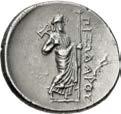
235. SATRAPS of CARIA. Pixodaros. Circa 341/0-336/5 BC. AR Didrachm (20mm, 6.96 g, 12h). Halikarnassos mint. Laureate head of Apollo facing slightly right, drapery around neck / Zeus Labraundos standing right. Konuk, Identities 30; HN Online 241. Struck with somewhat worn dies. Good VF. Well centered on a broad flan. ($500)



236. ISLANDS off CARIA, Kos. Circa 625-600 BC. EL Hekte – Sixth Stater (10mm, 2.68 g). Phokaic standard. Crab / Incuse square. Stefanaki Series I, 1–9 var. (unlisted dies); HN Online 1822; HGC 6, 1294. Minor edge splits. Good VF. Well centered. ($1000)
From the Ramrodivs Collection. Ex Harlan J. Berk inventory cc87899 (December 2016).
Unpublished Variety of a Very Rare Issue
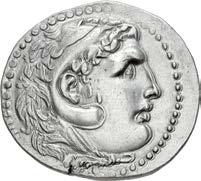


237. ISLANDS off CARIA, Kos. Circa 180-170 BC. AR Tetradrachm (33mm, 16.90 g, 12h). In the name and types of Alexander III of Macedon. Eurylokhos, magistrate. Head of Herakles right, wearing lion skin / Zeus Aëtophoros seated left; in left field, magistrate name above crab. Stefanaki Series XIV, Issue 43, 1791–5 var. (unlisted magistrate); Price –; HN Online –; HGC 6, 1318 var. (same). Minor double strike. Near EF. Very rare Alexander type from Kos, unpublished with this magistrate. ($1000)
This magistrate is unpublished for this issue of Alexanders, but a magistrate named Eurylokhos is present on the subsequent tetradrachm issue using Koan civic types (cf. HN Online 2309).


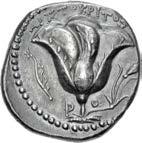

238. ISLANDS off CARIA, Rhodos. Rhodes. Circa 229-205 BC. AR Tetradrachm (23.5mm, 13.41 g, 12h). Aristokritos, magistrate. Radiate head of Helios facing slightly right / Rose with bud to right; aphlaston to left. Ashton 213; HN Online 670; HGC 6, 1432; SNG Lockett 2950 = Pozzi 2697 (this coin). Deep old find patina. Near EF. ($3000)
From the Wayne Scheible Collection, purchased from Tom Cederlind, 2008. Ex Gorny & Mosch 169 (12 October 2008), lot 546; Richard Cyril Lockett Collection (Greek Part IV, Glendining, 21 February 1961), lot 2424; Prof. S. Pozzi Collection (Naville I, 14 March 1921), lot 2697.


239. PAMPHYLIA, Aspendos. Circa 465-430 BC. AR Stater (15mm, 10.76 g). Warrior advancing right, holding shield and spear / Triskeles within incuse square. CNG E-523, lot 208; CNG E-452, lot 376; CNG E-441, lot 153; CNG E-440, lot 174; CNG E-438, lot 159; CNG E-434, lot 104; CNG E-432, lot 83; CNG E-429, lot 167; Savoca Online Auction 26, lot 240 (all from the same dies); otherwise, unpublished in the standard references. In NGC encapsulation 6156405-001, graded AU, Strike: 4/5, Surface: 5/5. Fine style for series, likely from the dies of a master engraver ($750)
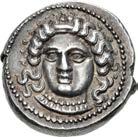


240. CILICIA, Tarsos. Tarkumuwa (Datames). Satrap of Cilicia and Cappadocia, 384-361/0 BC. AR Stater (23mm, 10.87 g, 6h). Struck circa 380 BC. Female head facing slightly left, hair in ampyx, wearing necklace / Bearded male head (Ares?) right, wearing crested Attic helmet. Casabonne Type 1; Moysey Issue 4; SNG BN 258-70; SNG Levante 79. Attractively toned, with light golden hues around the devices, minor scrape on reverse. Near EF ($750)
Ex Classical Numismatic Group 46 (24 June 1998), lot 465; Classical Numismatic Review XXII.2 (Spring/Summer 1997), no. 30.


241. CILICIA, Tarsos. Tarkumuwa (Datames). Satrap of Cilicia and Cappadocia, 384-361/0 BC. AR Stater (24mm, 10.47 g, 11h). Struck circa 380 BC. Female head facing slightly left, hair in ampyx, wearing necklace / Bearded male head (Ares?) right, wearing crested Attic helmet. Casabonne Type 1; Moysey Issue 4; SNG BN 258–70; SNG Levante 79. Deep iridescent tone, some pitting and cleaning marks. Good VF. ($500)
From the Gerald F. Borrmann (Northern California Gentleman) Collection. Ex Paul Tinchant Collection [“Richard J. Graham”] (Schulman 243, 8 June 1966), lot 1266; E. Bourgey (20 December 1921), lot 51.
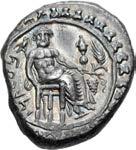


242. CILICIA, Tarsos. Tarkumuwa (Datames). Satrap of Cilicia and Cappadocia, 384-361/0 BC. AR Stater (22mm, 10.70 g, 12h). Struck circa 370 BC. Baal of Tarsos seated right, head and torso facing, holding grain ear and grape bunch, cradling eagle-tipped scepter in arm; thymiaterion in background; all within crenellated wall / Ana, nude, standing right, extending hand and pointing at the head of Tarkumuwa, standing left, wearing chlamys, leaning on staff and raising hand; thymiaterion between; all within square dotted border in linear border. Casabonne Series 3; Moysey Issue 5; SNG BN 294 = de Luynes 2841 = Traité II 618. Deep iridescent tone. Near EF. ($750)
From the Mesogeios Collection. Ex Classical Numismatic Group 87 (18 May 2011), lot 597; Numismatica Ars Classica 52 (7 October 2009), lot 184; Peus 396 (5 November 2008), lot 410.

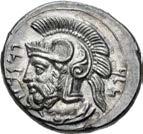


243. CILICIA, Tarsos. Pharnabazos. Persian military commander, 380-374/3 BC. AR Stater (23.5mm, 10.51 g, 11h). Struck circa 380-379 BC. Baal of Tarsos seated left, holding lotus-tipped scepter / Helmeted and bearded male head (Ares?) left. Casabonne Series 4; Moysey Issue 2; SNG BN 252. Toned, with some iridescence, traces of find patina. Near EF. ($750)
From the Mesogeios Collection. Ex Leipziger Münzhandlung 42 (10 December 2004), lot 1112.
244. CILICIA, Tarsos. Mazaios. Satrap of Cilicia, 361/0-334 BC. AR Stater (24mm, 10.95 g, 1h). Baal of Tarsos seated left, head and torso facing, holding eagle, grain ear, grape bunch and lotus-tipped scepter; rt (TN in Aramaic) to left, M (M in Aramaic) below throne / Lion left, attacking bull left. Casabonne Series 2, Group D; SNG BN 335. Lovely iridescent tone. Near EF. ($750)
Ex Nomos Obolos 19 (8 May 2021), lot 416.



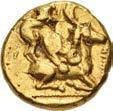
245. CYPRUS, Kition. Pumiathon. Circa 362/1-312 BC. AV Hemistater (12.5mm, 4.13 g, 6h). Dated RY 9 (354/3 BC). Herakles advancing right, holding club, bow, and arrow, lion skin draped over arm; e to right / Lion right, biting into the back of a stag couchant right; zzzzzzzz (date, in Phoenician) to right; all in dotted square border. Markou, L’or 50 (D3/R4 – this coin, illustrated); Zapiti & Michaelidou –; Tziambazis 36; DCA2 671. Compact flan, deposits, a few marks, struck with worn dies. VF. ($3000)
From the Gerald F. Borrmann (Northern California Gentleman) Collection, purchased from Dr. Arnold Saslow, March 1985. Ex Coin Galleries (28 March 1977), lot 3.



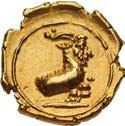
246. CYPRUS, Salamis. Evagoras I. Circa 411-374/3 BC. AV Tenth Stater (9mm, 0.71 g, 12h). Head of Herakles right, wearing lion skin / Forepart of man-headed goat right. Markou, L’or, Variant A, 228 (D8/R13 – this coin, illustrated); Zapiti & Michaelidou 15; Tziambazis 112. Lustrous, minor edge splits. EF. Well struck. ($1000)
From the Gerald F. Borrmann (Northern California Gentleman) Collection, purchased from Dr. Arnold Saslow, March 1985. Ex Sotheby’s (1 July 1981), lot 74; Hesperia Art Bulletin XL/XLI (ND [early-mid 70’s]), no. 136; Superior (24 September 1970), lot 9.



247. SELEUKID EMPIRE. Seleukos I Nikator. Second satrapy and kingship, 312-281 BC. AV Stater (17.5mm, 8.53 g, 11h). In the name and types of Alexander III of Macedon. Babylon I mint. Struck circa 311-300 BC. Helmeted head of Athena right / Nike standing left, holding wreath and stylis; ü below left wing, Â5 below right wing. SC 81.1; Price 3745; HGC 9, 3a. Underlying luster, light die rust on obverse, slight doubling on reverse. Near EF. ($3000)

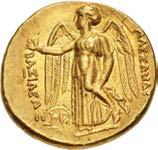

248. SELEUKID EMPIRE. Seleukos I Nikator. Second satrapy and kingship, 312-281 BC. AV Stater (17mm, 8.42 g, 6h). In the name and types of Alexander III of Macedon. Babylon I mint. Struck circa 311-300 BC. Helmeted head of Athena right, griffin on helmet / Nike standing left, holding wreath in extended hand and cradling stylis in arm; ˙ in left field, ü below left wing. SC 81.6-7 var. (position of controls, serpent on helmet); Price 3707 var. (same); HGC 9, 3a; SNG Saroglos 158. Underlying luster, minor marks. Good VF. ($2000)



249. SELEUKID EMPIRE. Seleukos I Nikator. Second satrapy and kingship, 312-281 BC. AV Stater (17mm, 8.60 g, 4h). In the types of Alexander III of Macedon. Seleukeia on the Tigris mint I. Struck circa 300-296/5 BC. Helmeted head of Athena right / Nike standing left, holding wreath and stylis; A below left wing. SC 115.2 var. (monogram and position); HGC 9, 4d; ANS 1977.158.105 var. (same; same obv. die); Triton XIX, lot 2066 (same dies; hammer $10,000). Underlying luster, a hint of die wear, slight die shift on reverse. Near EF. ($3000)



250. SELEUKID EMPIRE. Seleukos I Nikator. Second satrapy and kingship, 312-281 BC. AR Tetradrachm (27mm, 16.94 g, 1h). Seleukeia on the Tigris I mint. Struck circa 300-281 BC. Head of Herakles right, wearing lion skin / Zeus Nikephoros seated left; Q in left field. SC 117.4a; ESM 26 var. (monogram; A26/P– [unlisted rev. die]); HGC 9, 12i. Lightly toned, underlying luster, minor scrape at edge on reverse. EF. ($750)



251. SELEUKID EMPIRE. Seleukos I Nikator. Second satrapy and kingship, 312-281 BC. AR Drachm (16.5mm, 3.72 g, 5h). Seleukeia on the Tigris mint II. Struck circa 296/5-281 BC. Head of Zeus right, wearing laurel wreath / Athena, brandishing spear overhead in right hand, shield on left arm, in quadriga of elephants right; anchor above, pentagram behind Athena, Q between shield and elephants. SC 131.10c; ESM 90; HGC 9, 32a. Lightly toned, light porosity. Good VF. ($500)




252. SELEUKID EMPIRE. Seleukos I Nikator. Second satrapy and kingship, 312-281 BC. AR Tetradrachm (27mm, 17.14 g, 11h). Susa mint. Struck circa 300-295 BC. Head of hero (Alexander or Seleukos?) right, wearing helmet covered with panther skin and adorned with the ear and horns of a bull / Nike standing right, placing wreath on trophy; ' to lower left, ( in lower middle field. SC 173.4; ESMS Tr.31 (A26/P20); Marest-Caffey Group 1.4; HGC 9, 20. Lightly toned, slight die shift on obverse. Near EF. ($3000)
Powerful Portrait of Seleukos I
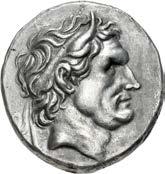


253. SELEUKID EMPIRE. Antiochos I Soter. 281-261 BC. AR Tetradrachm (27mm, 17.09 g, 6h). Sardes mint. Struck circa 276-274/1 BC. Diademed and horned head of Seleukos I right / Apollo, nude, holding bow, seated left on omphalos; Ø to inner left, “ in exergue. SC 323.2c; WSM 1367α–γ (same obv. die); HGC 9, 130; Triton XXIV, lot 752 (same obv. die; hammer $8500). Lightly toned, traces of horn silver on obverse, light cleaning marks and small scuff on reverse, a couple of minor edge marks. Good VF. An excellent portrait of Seleukos. ($3000)
Shortly after his death in 281 BC, Seleukos I Nikator, the founder of the Seleukid dynasty, was deified by his son and heir, Antiochos I. Almost immediately, Antiochos struck coins at a mint in Baktria bearing the portrait of his deceased father, to whose portrait was added a bull’s horn. This feature recalled a famous incident while Nikator served as a companion of Alexander the Great. In this event, Nikator barehandedly subdued a bull that had been brought for sacrifice, after it had broke loose from its restraints. This horn became a standard feature of all the posthumous portraits of Seleukos I. In 276 BC, Antiochos moved his residence from Baktria to Sardes, in order to deal with new threats arising in the West. Newell originally thought that the Seleukos portrait issues at Sardes began early in the reign of Antiochos I, contemporary with the Baktrian issues. However, later studies have suggested that the Alexander type tetradrachms in the name of Antiochos began first, and the Seleukos portraits followed, likely beginning once Antiochos took residence there.




254. SELEUKID EMPIRE. Antiochos II Theos. 261-246 BC. AR Tetradrachm (28.5mm, 17.11 g, 11h). Antioch on the Orontes mint. Diademed head right / Apollo, nude, testing arrow and placing hand on grounded bow, seated left on omphalos; M to outer left, 8 to outer right. SC 571.2b; Le Rider, Antioche 46 (A4/P25); HGC 9, 238o. Slight doubling on obverse, traces of horn silver on reverse. Near EF. ($500)
255. SELEUKID EMPIRE. Antiochos II Theos. 261-246 BC. AR Tetradrachm (27mm, 17.23 g, 6h). Ekbatana mint. Diademed head right / Apollo, nude, testing three arrows and placing hand on grounded bow, seated left on omphalos; to inner left, é above arm, ë below; at feet, forepart of horse grazing left. SC 607b; HGC 9, 238v. Lightly toned. Good VF. Very rare, only one recorded in ESM (in Berlin), none in SCO, three in CoinArchives. ($500)

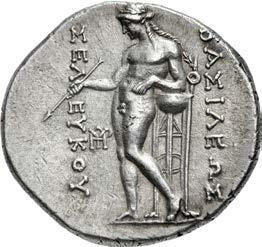

256. SELEUKID EMPIRE. Seleukos II Kallinikos. 246-225 BC. AR Tetradrachm (28.5mm, 16.98 g, 12h). Uncertain mint 39, in northern Syria or northern Mesopotamia. Diademed head right / Apollo, nude, standing left, testing arrow, and leaning on tripod to right; ® to inner left. SC 724.1; Le Rider, Antioche, p. 69, 6 (obv. die A2); HGC 9, 303v. Iridescent tone, minor flan flaw on reverse. Near EF. ($500)


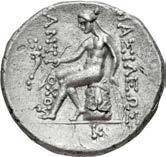
257. SELEUKID EMPIRE. Antiochos III ‘the Great’. 222-187 BC. AR Tetradrachm (27mm, 16.19 g, 12h). Antioch on the Orontes mint. Struck circa 192/0-187 BC. Diademed head right / Apollo, nude, testing arrow and placing hand on grounded bow, seated left on omphalos; cornucopia to outer left, ˚ in exergue. SC 1046.3a; Le Rider, Antioche, Series 4, 241–5 var. (unlisted dies); HGC 9, 447u. Lightly toned, porosity, some flan flaws. Good VF. Very rare. ($1000)

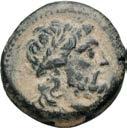


258. SELEUKID EMPIRE. Molon. Usurper, 222-220 BC. Æ (20.5mm, 7.35 g, 6h). Seleukeia on the Tigris mint. Struck circa 221-220 BC. Laureate head of Zeus right / Apollo Kitharodeos, draped, standing right, holding plektron and cradling kithara in arm; ¨ to outer left. SC 949.3 corr. (monogram as 949.2); ESM 228β (same rev. die); HGC 9, 430. Earthen dark green patina. VF. Extremely rare, three noted in ESM (all in public collections [Athens, BM, and Berlin]), with none in SCO, and only two in CoinArchives. ($3000)
Molon was a Seleukid noble who was elevated to satrap of Media by Antiochos III, shortly after his acclamation as king. After Antiochos departed Babylonia to receive his crown in Antioch, Molon and his brother, Alexander, who was satrap of Persis, revolted. Molon defeated two armies sent against him, and entered Seleukeia on the Tigris in 221 BC, at which time the present issue was struck. Eventually, Antiochos, who had been campaigning against the Ptolemies, was forced to turn his attention to the revolt. Molon was compelled to move his army east, towards Media, as Antiochos approached from the west, but the Seleukid king was able to confront and defeat Molon’s forces near Apollonia (Sittake). Although Molon and his brother survived the confrontation, they committed suicide upon realizing the futility of their position.

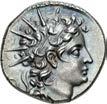

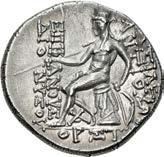
259. SELEUKID EMPIRE. Antiochos VI Dionysos. 144-142 BC. AR Drachm (17.5mm, 4.34 g, 1h). Antioch on the Orontes mint. Dated SE 170 (143/2 BC). Radiate and diademed head right / Apollo, nude, testing arrow and placing hand on grounded bow, seated left on omphalos; – between legs, or (date) and %tÅ in exergue. SC 2002.2e; HGC 9, 1036a; DCA2 122. Vibrant iridescent tone. EF. ($500)
From the Wayne Scheible Collection. Ex Gemini IV (8 January 2008), lot 220 (hammer $1500).



260. SELEUKID EMPIRE. Antiochos VI Dionysos. 144-142 BC. AR Drachm (17mm, 4.11 g, 1h). Antioch on the Orontes mint. Dated SE 170 (143/2 BC). Radiate and diademed head right / Apollo, nude, testing arrow and placing hand on grounded bow, seated left on omphalos; – between legs, or (date) and %tÅ in exergue. SC 2002.2e; HGC 9, 1036a; DCA2 122. In NGC encapsulation 3956722-007, graded Ch AU, Strike: 5/5, Surface: 3/5. ($500)
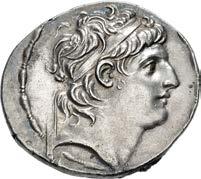


261. SELEUKID EMPIRE. Antiochos VII Euergetes (Sidetes). 138-129 BC. AR Tetradrachm (33mm, 16.62 g, 12h). Antioch on the Orontes mint. Diademed head right / Athena Nikephoros standing left, cradling spear in arm and resting hand on grounded shield; to outer left, : above K; all within wreath. SC 2061.1n; Lorber, Die, Phase 1, Group 5, 390 (A47/P2 – this coin [incorrectly marked as a plate coin]); HGC 9, 1067d. Iridescent tone, traces of find patina. Near EF. ($500)
Ex Gemini IX (8 January 2012), lot 158.
Ex Houghton Collection – Pedigreed to 1967




262. SELEUKID EMPIRE. Antiochos IX Eusebes Philopator (Kyzikenos). 114/3-95 BC. AR Tetradrachm (29mm, 16.43 g, 11h). Tarsos mint, first reign. Struck circa 114/3-112 BC. Diademed head right within fillet border / Sandan standing right on back of horned lion-griffin standing right upon garlanded altar with baldachin; to outer left, Ï above /. SC 2350b (this coin referenced); HGC 9, 1230; CSE 496 (this coin). Deeply toned over lustrous surfaces, minor die break on obverse, a few light scratches under tone on reverse. Near EF. ($1500)
Ex Russel Bement, Jr. Collection (Classical Numismatic Group 51, 15 September 1999), lot 553; Arthur Houghton Collection; Kricheldorf XVII (8 May 1967), lot 146.


263. PHOENICIA, Arados. Uncertain king. Circa 420-400 BC. AR Shekel (17.5mm, 10.73 g, 1h). Laureate head of Ba’al-Arwad right / Galley right, Pataikos on prow, above waves; ^M (M ’ in Aramaic) above; all in half-square incuse with semicircle bottom. E&E-A Group III.1.1; HGC 10, 29. Lightly toned, somewhat irregular flan. Good VF. ($500)
From the Gerald F. Borrmann (Northern California Gentleman) Collection. Ex Patrick C. Tan Collection (Heritage 3032, 10 April 2014), lot 23338.
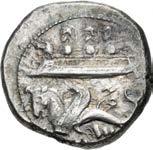


264. PHOENICIA, Byblos (Gebal). ‘Ozba’al. Circa 400-365 BC. AR Shekel (25mm, 13.28 g, 2h). Three hoplites, holding shields, on galley left above waves, prow ending in lion’s head; below, hippocamp left above murex shell, Zo (‘Z in Phoenician) above dorsal fin / Lion attacking bull left. E&E-B Series IV.2.1.c, 505–7 (O14/R18); HGC 10, 133 corr. (letters on obv. not noted). Iridescent tone, traces of find patina, struck with somewhat worn dies, slight die shift on reverse. Near EF. ($750)
Ex Kirk Davis FPL 79 (2021), no. 40; Jim Gilman Collection, purchased from Freeman & Sear, February 2009.

Referenced in E&E-B


265. PHOENICIA, Byblos (Gebal). ‘Ozba’al. Circa 400-365 BC. AR Shekel (26mm, 13.28 g, 9h). Three hoplites, holding shields, on galley left above waves, prow ending in lion’s head; below, hippocamp left above murex shell, Zo (‘Z in Phoenician) above dorsal fin / Lion attacking bull left. E&E-B Series IV.2.1.c, 593 (O14/R? – this coin); HGC 10, 133 corr. (letters on obv. not noted). Lightly toned, minor doubling. Near EF. ($750)
Ex Classical Numismatic Group 46 (24 June 1998), lot 498.



266. PHOENICIA, Sidon. Ba`alšillem (Sakton) II. Circa 401-365 BC. AR Dishekel (30mm, 27.48 g, 11h). Phoenician galley left; B (B in Phoenician) above, waves below / Persian king, raising hand, and driver, holding reins, in chariot left; to right, king of Sidon, in Egyptian style garments, holding cultic scepter, walking left. E&E-S Group IV.1.1a, 604–12 (D33/ R42); HGC 10, 236. Toned, some porosity, light scratches. VF. ($1000)
Ex Rauch 117 (8 December 2023), lot 490 (hammer €3600).
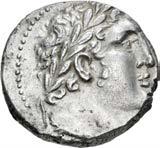



267. PHOENICIA, Tyre. 126/5 BC-AD 65/6. AR Shekel (26mm, 14.28 g, 12h). Dated CY 89 (38/7 BC). Laureate head of Melkart right, lion skin around neck / Eagle standing left on prow; palm frond in background; to left, ∏Q (date) above club; i to right; b (Phoenician B) between legs. DCA-Tyre 308; HGC 10, 357; DCA2 946. Faintly toned, traces of find patina, slightly off center, scrapes on reverse. Near EF. ($1000)
268. PHOENICIA, Tyre. 126/5 BC-AD 65/6. AR Shekel (24mm, 14.32 g, 1h). Lifetime of Christ issue. Dated CY 136 (AD 10/11). Laureate head of Melkart right, [lion skin around neck] / Eagle standing left on prow; palm frond in background; to left, r¬? (date) above club; to right, ˚r above …; Å (Phoenician A) between legs. DCA-Tyre 486 var. (letter between legs; same obv. die as illustration); HGC 10, 357; DCA2 947. In NGC encapsulation 6977123-002, graded AU, Strike: 4/5, Surface: 4/5. Rare date, and among the finest known. ($1000)
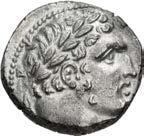
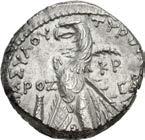


269. PHOENICIA, Tyre. 126/5 BC-AD 65/6. AR Shekel (23mm, 14.04 g, 1h). Dated CY 177 (AD 51/2). Laureate head of Melkart right, [lion skin around neck] / Eagle standing left on prow; palm frond in background; to left, roZ (date) above club; to right, ˚r above 4v; b (Phoenician B) between legs. DCA-Tyre 663 (same obv. die as illustration); HGC 10, 357; DCA2 947. Lightly toned, compact flan, some porosity on obverse, a little off center on reverse. EF. ($1000)
Ex David Welsh Collection, purchased from Superior Stamp & Coin, September 2006.
270. JUDAEA, Jewish War. 66-70 CE. Æ Quarter Shekel (22mm, 7.80 g, 6h). Jerusalem mint. Dated year 4 (69/70 CE). Two lulav branches / Etrog. MCR FJR-14, dies O1/R2; Kadman 33; Hendin 6397; Meshorer 213. Deep blue-green patina, trace earthen deposits, slight roughness. VF. ($1500)



271. JUDAEA, Bar Kochba Revolt. 132-135 CE. AR Zuz – Denarius (17.5mm, 3.17 g, 12h). Dated year 2 (133/4 CE). Legend in two lines within wreath / Kithara with three strings. Mildenberg 15 (O3/R10); Hendin 6418; Meshorer 238a (same dies as illustration). Toned, overstruck on a drachm or denarius of Trajan (his portrait visible on the reverse). Good VF. ($750)
From the Temple Collection.


272. NABATAEA. Malichos I. Circa 59/8-30 BC. AR Quarter Shekel – “Drachm” (16.5mm, 3.36 g, 12h). Petra mint. Dated RY 26 (35/4 BC). Diademed head right / Eagle standing left; palm frond to left; l ˚4 (date) to right. CN 10; Hoover & Barkay 15 = Barkay, Silver 1; Al-Qatanani 22; Meshorer, Nabataea 12 var. (no palm frond); HGC 10, 679; DCA 957. Toned, scratches under tone. Good VF. ($1000)
Ex Classical Numismatic Group 123 (23 May 2023), lot 241 (hammer $1800).

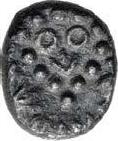




273. ARABIA, Northwestern. Lihyan. Circa 350-250 BC. AR Drachm (12mm, 3.66 g, 6h). Imitating Athens. Stylized helmeted head of Athena right, with frontal eye / Schematic representation of owl standing left; 7v (ŠM in Arabian) to left, [“scepter” to right]. Huth, Athenian, p. 235, f = Huth 37 (same dies); Triton XIX, lot 318 (hammer $1700). Toned, some find patina, typical compact flan, light roughness. Good VF. Well struck for issue. Rare. ($500)
274. ARABIA, Eastern. Mleiha. Uncertain. 1st century BC – 2nd century AD. BI Drachm (15.5mm, 3.74 g, 3h). Imitating Alexander III of Macedon. Head of Herakles right, wearing lion skin / Male figure seated left, holding scepter, extending right arm; on right arm, horse standing right; palm tree and trident in left field. Van Alfen, Die, NS 6.3, 155 (O2/ R3); Potts Class XLIV; Huth 134 (same dies). Black surfaces, trace earthen deposits. EF. Rare. ($500) From the Robert J. Weinstein Collection. Ex Album 13 (18 May 2012), lot 12.
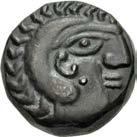

275. ARABIA, Eastern. Mleiha. Uncertain. 1st century BC – 2nd century AD. BI Tetradrachm (22mm, 15.91 g, 12h). Imitating Alexander III of Macedon. Head of Herakles right, wearing lion skin, pellet on cheek / Male figure seated left, holding scepter, extending right arm; on right arm, horse standing right; palm tree and trident in left field. Van Alfen, Die, NS 10.1, 212–20 var. (unlisted dies); Huth –; Potts Class XLVII. Deeply toned. Good VF. ($500)


276. ARABIA, Southern. Ma’in (Minaia)(?). Circa 250-150 BC. AR BLṬT – “Tetradrachm” (20mm, 16.02 g, 1h). Imitating Athens. Stylized helmeted head of Athena right / Owl standing right, wings folded; traces of olive spray and crescent to left, zo (South Arabian Z and ‘ayin) downward to right. Cf. M. Huth, “The ‘folded flan’ coinage of eastern Arabia: some preliminary comments” in Arabian Archaeology and Epigraphy 9 (1998), 1; M. Huth, “Monetary Circulation in South West Arabia” in CCK, p. 85, 8 = Huth 156 (same rev. die). Toned. Near VF. Extremely rare. ($1000)
This fascinating coin of derivative Athenian type was struck on a folded flan of another coin, and was originally attributed by Huth (1998) to a mint in eastern Arabia, where all of the six then-extant examples had been found. The discovery of the al-Jawf hoard in 2002, however, definitively changed his view of this intriguing coinage. In his analysis of the hoard (in CCK), Huth determined that all of the previous six coins, and those found in the hoard, were struck at the same mint, in three phases that employed increasingly simplified methods. In the first phase, the coins were struck on previous tetradrachms that were folded over twice, forming a triangular shaped flan upon which derivative Athenian types were struck (the present coin is from this phase). The second phase consisted of coins struck on previous coins that had only been folded over once, forming a semicircular shaped flan. Finally, in the third phase, the host tetradrachms were cut into two halves that were then each folded once, then both halves were placed upon each other and joined by hammering, resulting in a triangular shape. The identification of the undertype used for this series in uncertain. While Huth originally surmised that Alexanders were the common host coin, his analysis of the al-Jawf hoard suggested that this was not likely. Though the question of the undertype remains unresolved, the hoard provided strong evidence that this series was not of eastern Arabian origin, but rather from a mint in the region of Wadi al-Jawf, in the Minaian trading sphere.



277. PERSIA, Achaemenid Empire. temp Darios I to Xerxes I. Circa 505-480 BC. AV Daric (14mm, 8.31 g). LydoMilesian standard. Sardes mint. Persian king or hero, wearing kidaris and kandys, quiver over shoulder, in kneeling-running stance right, drawing bow / Incuse punch. Carradice Type II (pl. XI, 11); Meadows, Administration 319; BMC Arabia –; Sunrise 19. VF. ($5000)
From the Gerald F. Borrmann (Northern California Gentleman) Collection. Ex MoneyMuseum, Zurich Collection (Triton XVIII, 5 January 2015), lot 765; Martin Huth Collection.



278. PERSIA, Achaemenid Empire. temp Darios II to Artaxerxes II. Circa 420-375 BC. AV Daric (15.5mm, 8.33 g). Lydo-Milesian standard. Sardes mint. Persian king or hero, wearing kidaris and kandys, quiver over shoulder, in kneelingrunning stance right, holding spear and bow / Incuse punch. Carradice Type IIIb, Group C (pl. XIV, 42); cf. Meadows, Administration 323; BMC Arabia pl. XXV, 12; Sunrise 28. Softly struck on obverse. Good VF. ($1500)
From the Gerald F. Borrmann (Northern California Gentleman) Collection, purchased from B. A. Seaby, January 1979.

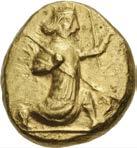

279. PERSIA, Achaemenid Empire. temp Artaxerxes II to Darios III. Circa 375-336 BC. AV Daric (15mm, 8.33 g). Lydo-Milesian standard. Sardes mint. Persian king or hero, wearing kidaris and kandys, quiver over shoulder, in kneelingrunning stance right, holding spear and bow / Patterned incuse punch. Carradice Type IIIb Late (pl. XV, 50); Meadows, Administration –; BMC Arabia pl. XXV, 24; Sunrise 39 corr. (references). Toned, light scuffs. VF. ($1500)
From the Dr. Adrian Carr Collection. Ex Numismatik Naumann 78 (1 October 2017), lot 431.



280. PTOLEMAIC KINGS of EGYPT. Ptolemy I Soter. As satrap, 323-305/4 BC. AR Tetradrachm (27.5mm, 17.11 g, 12h). Attic standard. In the name of Alexander III of Macedon. Alexandreia mint. Struck circa 312/311 BC. Diademed head of the deified Alexander right, wearing elephant skin, aegis around neck / Athena Alkidemos advancing right; to right, eagle standing right on thunderbolt above d5. CPE 40; Svoronos 33; Zervos Issue 16, obv. die 268; SNG Copenhagen –. Attractive old collection tone with a slight iridescence, underlying luster. Near EF. Well centered. ($5000)
From the Wayne Scheible Collection. Ex Nomos 1 (6 May 2009), lot 126.
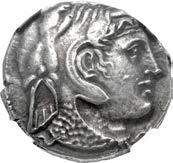
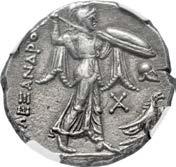
281. PTOLEMAIC KINGS of EGYPT. Ptolemy I Soter. As satrap, 323-305/4 BC, or king, 305/4-282 BC. AR Tetradrachm (25mm, 15.78 g, 1h). Ptolemaic standard. In the name of Alexander III of Macedon. Alexandreia mint. Struck circa 306-300 BC. Diademed head of the deified Alexander right, wearing elephant skin, aegis around neck with tiny d in scales / Athena Alkidemos advancing right, brandishing spear and wearing shield on arm; to right, helmet, (, and eagle standing right on thunderbolt. CPE 69; Svoronos 162; Zervos Issue 28, dies 494/– (unlisted rev. die); SNG Copenhagen 29. In NGC encapsulation 6330726-016, graded Ch XF, Strike: 4/5, Surface: 4/5. ($1500)
Ex Heritage 3102 (2 November 2022), lot 32192.
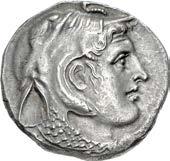


282. PTOLEMAIC KINGS of EGYPT. Ptolemy I Soter. As satrap, 323-305/4 BC, or king, 305/4-282 BC. AR Tetradrachm (28mm, 15.74 g, 12h). Ptolemaic standard. In the name of Alexander III of Macedon. Alexandreia mint. Struck circa 306-300 BC. Diademed head of the deified Alexander right, wearing elephant skin, aegis around neck with tiny d in scales / Athena Alkidemos advancing right, brandishing spear and wearing shield on arm; to right, helmet, (, and eagle standing right on thunderbolt. CPE 69; Svoronos 162; Zervos Issue 28, dies unlisted; SNG Copenhagen 29. Iridescent tone, indications of undertype. Near EF. ($1500)
Ex Mercury Group Collection (Classical Numismatic Group 118, 13 September 2021), lot 609.
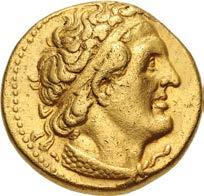



283. PTOLEMAIC KINGS of EGYPT. Ptolemy I Soter. 305/4-282 BC. AV Trichryson – ‘Pentadrachm’ (22mm, 17.71 g, 12h). Alexandreia mint. Struck circa 294-282 BC. Diademed head right, wearing aegis around neck, small d behind ear / ∫Ås5¬EWs πto¬EµÅ5oU, eagle standing left on thunderbolt; , to left. CPE 152; Svoronos 208; SNG Copenhagen –. Scattered tiny marks, a few light scratches and graffito on reverse. VF. ($7500)




284. PTOLEMAIC KINGS of EGYPT. Ptolemy I Soter. 305/4-282 BC. AR Diobol (12mm, 1.17 g, 1h). Uncertain mint 12, in Coele-Syria. Struck circa 294-293 BC. Diademed head right, wearing aegis around neck / Eagle standing left on thunderbolt; Å to left. CPE 255; Svoronos –; SNG Copenhagen –; H. Gitler & C. Lorber, “Small silver coins of Ptolemy I” in INJ 14 (2002), 2. Deeply toned, traces of find patina. Good VF. Extremely rare, only three noted in CPE, none in PCO, and only one in CoinArchives. ($1000)
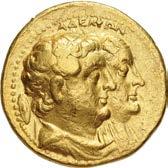


285. PTOLEMAIC KINGS of EGYPT. Ptolemy II Philadelphos, with Arsinöe II, Ptolemy I, and Berenike I. 285246 BC. AV Mnaieion – ‘Oktadrachm’ (27.5mm, 27.66 g, 1h). Alexandreia mint. Struck circa 272-261/0 BC. Conjoined busts of Ptolemy II and Arsinöe II right; Ptolemy is diademed and draped, Arsinöe is diademed and veiled; ÅdE¬fW@ above, shield to left / Conjoined busts of Ptolemy I and Berenike I; Ptolemy is diademed and draped, Berenike is diademed and veiled; QEW@ above. CPE 313; Svoronos 603; Olivier & Lorber dies 7/21, 41 (this coin); SNG Copenhagen 132; Adams III 2083; Boston MFA 2274; Dewing 2752; Kraay & Hirmer 801; Noeske 37. Minor marks, edge marks. VF. ($7500)
Ex MACM inventory MMoCA15C; Triton XIII (5 January 2010), lot 1353.

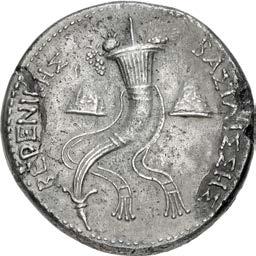
286. PTOLEMAIC KINGS of EGYPT. Berenike II, wife of Ptolemy III. Circa 244/3-221 BC. AR Pentakaidekadrachm (42mm, 51.57 g, 12h). Alexandreia mint(?). Struck under Ptolemy III, 245 BC. Veiled and draped bust right / ∫Å%5¬5%%˙% ∫ErE@5˚˙%, cornucopia, bound with fillet, between two laureate pileoi. CPE 734; Svoronos 988; D. Vagi, “The Ptolemaic Pentakaidekadrachm” in SAN XX.1 (1997), pp. 5-10; H.A. Hazard, Ptolemaic Coins (Toronto, 1995), c1052 (dodekadrachm); SNG Copenhagen –; BMC –. Toned, flan crack, edge broken and repaired, some porosity, scratches, a couple of chips at edge on reverse. VF. ($10,000)
From the Gerald F. Borrmann (Northern California Gentleman) Collection, purchased from Frank Kovacs, late 1990s.
The issue has traditionally been attributed to Berenike II, the daughter of Magas of Kyrene, and wife of Ptolemy III Euergetes. Hazard had proposed instead that it honored Berenike Syra, the sister of Ptolemy III and widow of the Seleukid king Antiochos II Theos. He argued that the coins were struck in Syria from locally-acquired silver to pay the Ptolemaic army deployed there to press the claim of Berenike’s child to the Seleukid throne, though the two had been murdered in the interim, and that these coins were carried back to Egypt by the soldiers as pay. However, his argument was contingent upon the recognition that these were struck on the Attic standard, which is now not accepted. As noted in CPE this issue actually was a silver companion to a massive gold double mnaieion (double oktadrachm), that together represented a ceremonial coinage at Alexandreia whose types suggested they were associated with the Third Syrian War. If so, they presumably were issued to celebrate the successful return of Ptolemy III to Egypt from the battlefield.


287. PTOLEMAIC KINGS of EGYPT. Berenike II, wife of Ptolemy III. Circa 244/3-221 BC. AV Mnaieion –‘Oktadrachm’ (27mm, 27.64 g, 12h). Ptolemaic standard. Alexandreia mint. Struck under Ptolemy IV, circa 211-204 BC. Veiled and draped bust right, wearing necklace / ∫Å%5¬5%%˙% ∫ErE@5˚˙%, filleted cornucopia. CPE 895; Svoronos 1113; van Driessche obv. die D4; SNG Copenhagen 169; Boston MFA Supp. 322; Hirsch 1814; de Luynes 3580. Smoothing, light cleaning marks. VF. Well centered. ($5000)
From the Ramrodivs Collection. Ex Berk BBS 175 (7 July 2011), lot 59.



288. PTOLEMAIC KINGS of EGYPT. Ptolemy IV Philopator. 222-205/4 BC. AR Tetradrachm (27mm, 14.17 g, 12h). Alexandreia mint. Struck circa 219-217 BC. Jugate draped busts right of Serapis and Isis / Eagle standing left, head right, on thunderbolt; filleted double cornucopia over shoulder, d5 between legs. CPE 892; Svoronos 1123–4; Landvatter Group 4, 45 (O12/R35 [mislabelled as 44a and R 34 on the plate]); SNG Copenhagen 197–8. Lightly toned, traces of horn silver, faint cleaning marks on obverse. Near EF. ($2000)
This type is thought to have been issued in celebration of the Ptolemaic victory over the Seleukids at the battle of Raphia during the Fourth Syrian War. Official propaganda proclaimed that these two deities, Serapis and Isis, had intervened on behalf of the Egyptians, saving them from defeat (see C. Lorber, “The Ptolemaic Era Coinage Revisited,” NC 2007, p. 116, and L. Bricault, “Serapis et Isis, Sauveurs de Ptolémé IV à Raphia,” Chronique d’Égypte LXXIV (1999), pp. 334-43).
Thomas Landvatter, in his die study cited above that appeared in the 2012 ANS American Journal of Numismatics (Second Series, Vol. 24, p. 88), suggests that this issue was “carrying a very specific ideological message directed more widely throughout the empire: Ptolemy IV was equating himself and his wife Arsinoe with the divine sibling-spouses Serapis and Isis.” Landvatter also notes that “[t]his was an ideological statement made during wartime, meant to have wide appeal and explicitly associate the Ptolemaic king and queen with two of the most popular deities in the Eastern Mediterranean.” Indeed, the popularity of the Serapis/Isis cult would outlive the Ptolemaic dynasty and continue well into the Roman Imperial period, only to be eventually usurped by the Christian and Muslim faiths.



289. PTOLEMAIC KINGS of EGYPT. Ptolemy VI Philometor. Second sole reign, 163-145 BC. AR Tetradrachm (27mm, 14.22 g, 12h). Alexandreia mint. Diademed head of Ptolemy I right, wearing aegis around neck / Eagle standing left on thunderbolt; no control marks. Svoronos 1489; Olivier 3974–5 (obv. die D74); SNG Copenhagen 262–8. Beautiful deep iridescent tone, faint die break in field on obverse. Superb EF. Well struck. ($1000)

290. PTOLEMAIC
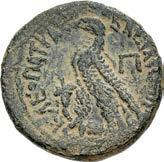
of


51-30 BC. Æ Diobol – 80 Drachmai (26.5mm, 18.53 g, 12h). Alexandreia mint. Diademed and draped bust right / Eagle standing left on thunderbolt; cornucopia to left, ∏ (mark of value) to right. Svoronos 1871; SNG Copenhagen 419–21. Earthen dark green surfaces, roughness, some light scratches on obverse. Good Fine. ($750)
KINGS of EGYPT. Kleopatra VII Thea Neotera. 51-30 BC. Æ Diobol – 80 Drachmai (27mm, 18.25 g, 12h). Alexandreia mint. Diademed and draped bust right / Eagle standing left on thunderbolt; cornucopia to left, ∏ (mark of value) to right. Svoronos 1871; SNG Copenhagen 419–21. Dark green-brown patina, minor deposits, light roughness. Near VF. ($750)




292. KYRENAICA, Kyrene. temp. Ophellas. Ptolemaic governor, second reign, 312-308 BC. AV Tenth Stater (6.5mm, 0.77 g, 1h). The(upheides?), magistrate. Youthful head of Karneios left; Q-E flanking neck / Head of female (Libya?) left. Naville 145–6 (same obv. die); SNG Copenhagen 231 var. (no letters); BMC 213 (same obv. die). Minor marks, a couple of light nicks on edge. Good VF. Rare. ($750)
From the Dr. Adrian Carr Collection. Ex Leu Numismatik Web Auction 16 (22 May 2021), lot 1525.




293. KYRENAICA, Kyrene. Second Revolt of the Kyrenaikans. Circa 305-300 BC. AV Tenth Stater (8.5mm, 0.76 g). Head of Ammon right / Upright thunderbolt; stars flanking. Naville 183–217; SNG Copenhagen 1233; BMC 216–20. A few minor marks, slightly off center. Near EF. ($500)
From the Dr. Adrian Carr Collection. Ex Leu Numismatik Web Auction 18 (18 December 2021), lot 1620.
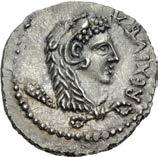



294. KINGS of MAURETANIA. Juba II. 25 BC-AD 24. AR Denarius (17mm, 3.02 g, 11h). Caesarea mint. Dated RY 42 (AD 17/8). Head right, wearing lion skin, club over shoulder / Bull standing right, head facing, wearing Isis crown; rxxxxii (date) below. Spoerri-Butcher Group 41, dies K24/R4; Mazard 226; MAA 172; SNG Copenhagen 589. Attractive iridescent toning, slightly off center. EF. ($1000)
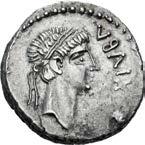



295. KINGS of MAURETANIA. Juba II, with Kleopatra Selene. 25 BC-AD 24. AR Denarius (16.5mm, 2.89 g, 2h). Caesarea mint. Diademed head right / Crocodile standing left. Mazard 343; MAA 104; SNG Copenhagen 592. Lightly toned, area of flat strike, slight die wear. Near EF. ($750)
Ex Classical Numismatic Auctions II (7 December 1987), lot 221.
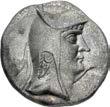


296. KINGS of PARTHIA. Arsakes I. 247-211 BC. AR Drachm (18mm, 4.02 g, 12h). Nisa(?) mint. Head right, wearing bashlyk and earring / År%Å˚oU to right, ÅUt o˚rÅtoro% to left, archer (Arsakes I) seated left on backless throne, holding bow. Sellwood 1.1; A&S 1/3; Sunrise 234 = Shore 1 (same dies). Toned with hint of iridescence, slight areas find patina, traces of deposits and porosity, hairline flan crack, granular surfaces. VF. Extremely rare. The first Parthian coin. ($3000)




297. KINGS of PARTHIA. Artabanos III. 126-122 BC. AR Tetradrachm (33mm, 15.70 g, 1h). Seleukeia on the Tigris mint. Struck circa 129 BC. Diademed bust right / Demeter seated left, holding cornucopia and Nike, who crowns her with wreath; winged tritoness supporting throne; to outer left, horse’s head left, ûs in exergue. Sellwood 21.4 (Artabanos I) var. (no horse’s head); Sunrise 275 var. (same); Shore –. Iridescent toning, traces of deposits and porosity, marks and hairlines. Good VF. ($1000)
From the Saeed S. Ghobash Collection. Ex Triton V (15 January 2002), lot 1600 (part of).
298. KINGS of PARTHIA. Artabanos III. 126-122 BC. AR Tetradrachm (30mm, 16.20 g, 12h). Seleukeia on the Tigris mint . Struck circa 129 BC. Diademed bust right / Demeter seated left, holding cornucopia and Nike, who crowns her with wreath; winged tritoness supporting throne; to outer left, horse’s head to left, ûs in exergue. Sellwood 21.4 (Artabanos I) var. (no horse’s head); Sunrise 275 var. (same); Shore –. Iridescent toning, traces of deposits and porosity, light marks. Good VF. ($1000)
From the Saeed S. Ghobash Collection. Ex Triton V (15 January 2002), lot 1599 (part of).


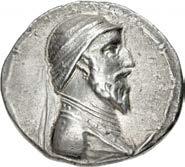
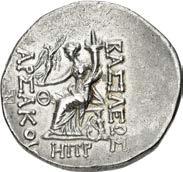
299. KINGS of PARTHIA. Artabanos III. 126-122 BC. AR Tetradrachm (32mm, 15.88 g, 12h). Seleukeia on the Tigris mint. Dated SE 188 (125 BC). Diademed bust right / Demeter seated left, holding cornucopia and Nike, who crowns her with wreath; winged tritoness supporting throne; r to outer left to outer left, ˙∏r (date) in exergue. Sellwood 21.1 (Artabanos I); Sunrise –; Shore – ; DCA2 357. Light iridescent toning, light porosity, light scratches, area of delamination on reverse. Good VF. ($750)
From the Saeed S. Ghobash Collection. Ex Triton V (15 January 2002), lot 1599 (part of).
300. KINGS of PARTHIA. Artabanos III. 126-122 BC. AR Tetradrachm (31mm, 15.99 g, 12h). Seleukeia on the Tigris mint. Dated SE 188 (125 BC). Diademed bust right / Demeter seated left, holding cornucopia and Nike, who crowns her with wreath; winged tritoness supporting throne; r to outer left to outer left, œto inner left, ˙∏r (date) in exergue. Sellwood 21.2 (Artabanos I); Sunrise –; Shore – ; DCA2 357. Iridescent toning, porosity, roughness, tiny edge ding. Good VF. ($750)
From the Saeed S. Ghobash Collection. Ex Triton V (15 January 2002), lot 1600 (part of).


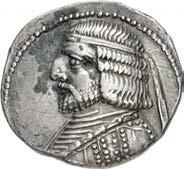

301. KINGS of PARTHIA. Artabanos III. 126-122 BC. AR Tetradrachm (30mm, 15.68 g, 12h). Seleukeia on the Tigris mint. Dated SE 188 (125 BC). Diademed bust right / Demeter seated left, holding cornucopia and Nike, who crowns her with wreath; winged tritoness supporting throne; r to outer left to outer left, œE to inner left, ˙∏r (date) in exergue. Sellwood 21.3 (Artabanos I); Sunrise 276; Shore – ; DCA2 357. Iridescent toning, porosity, roughness, tiny edge flaw. VF. ($750)
From the Saeed S. Ghobash Collection. Ex Triton V (15 January 2002), lot 1599 (part of).
302. KINGS of PARTHIA. Arsakes XVI. 78/7-62/1 BC. AR Tetradrachm (31mm, 15.26 g, 12h). Seleukeia on the Tigris mint. Diademed and draped bust left / Archer (Arsakes I) seated right on throne, holding bow; x above bow. Sellwood 30.2 (Unknown King); Sunrise 311; Shore –. Toned with iridescence, areas of deposits, marks, graffiti on obverse. VF. ($750)



303. KINGS of PARTHIA. Vologases V. Circa AD 191-208. AR Drachm (19mm, 3.71 g, 12h). Ekbatana mint. Diademed facing bust, wearing long beard and with hair in bunches above head and over ears / Archer (Arsakes I) seated right on throne, holding bow; ë below bow; GLM ySGLy (wlkši mlk in Parthian) above. Sellwood 86.3; Sunrise 455; Shore 448. Toned, with iridescence. EF. Bold portrait. ($500)


304. KINGS of ELYMAIS. Kamnaskires II Nikephoros. Circa 147-139 BC. AR Tetradrachm (27mm, 15.31 g, 1h). Susa mint. Diademed head right; ( to left; all within bead-and-reel border / Apollo, holding arrow and bow, seated left on omphalos. van’t Haaff Type 2.1.1-2b; Alram 431. Toned with iridescence, slight porosity and die rust, minor obverse smoothing. Good VF. Very rare. ($1000)
From the Saeed S. Ghobash Collection. Ex Spink 170 (6 October 2004), lot 57.


305. KINGS of PERSIS. Vādfradād (Autophradates) I. 3rd century BC. AR Tetradrachm (30mm, 16.68 g, 12h). Istakhr (Persepolis) mint. Diademed head right, wearing kyrbasia / Fire temple of Ahura-Mazda; to left, Vādfradād standing right, raising hand; standard to right; ®†PrD† (wtprdt in retrograde Aramaic) to outer right; Y‹ !KR†RP (prtrk’zy in Aramaic) in exergue; bR (br in retrograde Aramaic) to left of altar. van’t Haaff, Persis, Type 540/542g; K&M –; cf. Alram 540 and 542 (for type). Find patina, deposits, scratches. Good VF. Overstruck on a fire altar type of Baydād (Bagadat). ($1500)

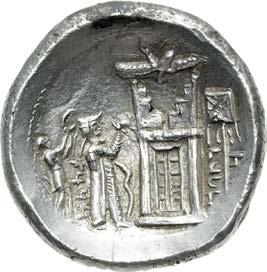

306. KINGS of PERSIS. Vādfradād (Autophradates) I. 3rd century BC. AR Tetradrachm (30mm, 17.21 g, 3h). “Victory” type. Istakhr (Persepolis) mint. Diademed head right, wearing kyrbasia / Fire temple of Ahura-Mazda; to left, Vādfradād standing right, being crowned with wreath by Nike standing behind; bow set on ground before; standard to right; RP†w/†D (wtprdt in Aramaic) in two lines down right, traces of âKR†Rp (prtrk’... in Aramaic) in exergue, †r r4? (br rt in Aramaic) up inner left. Cf. van’t Haaff, Persis, Type 544; K&M –; Alram –; Sunrise 573 var. (no legend up left); Zeno –. Iridescent toning, thick deposits on edge, obverse triple struck, tiny edge split. EF. Extremely rare variety of an extremely rare type. ($3000)




307. KINGS of PERSIS. Šabuhr (Shahpur), son of Pāpag (Papak). Circa AD 211/2-213. AR Drachm (23mm, 3.62 g, 11h). Istakhr (Persepolis) mint. Bearded bust of Šabuhr left, wearing diadem and Parthian-style tiara decorated with pellet-increscent / Bearded bust of Pāpag left, wearing diadem and Parthian-style tiara with leaf ornament. van’t Haaff, Persis, Type 654Aa; K&M –; Alram 654; Saeedi 1; Sunrise 687. Toned with iridescence, deposits in devices, porosity, a few marks. Good VF. ($1500)
From the Saeed S. Ghobash Collection. Ex Bellaria Collection (Classical Numismatic Group Electronic Auction 102, 24 November 2004), lot 70; Lanz 102 (28 May 2001), lot 335.




308. BAKTRIA, Local issues. Circa 295/3-285/3 BC. AR Didrachm (20mm, 7.96 g, 6h). Local standard. Imitating Athens. Uncertain mint in the Oxus region. Head of Athena right, wearing earring and crested Attic helmet decorated with three olive leaves over visor and a spiral palmette on the bowl; ¥ to left / Owl standing right, head facing; to upper left, prow of galley right above grape bunch on vine with leaf. Taylor, Birds, Group 2.14, 111 (dies A14/P26) = Nicolet-Pierre & Amandry 48; Bopearachchi, Sophytes, Group 1A and pl. I, 8; SNG ANS 6; HGC 12, 5. Lightly toned. Near EF. ($750)
From the Richard J. Sullivan Collection.




309. BAKTRIA, Greco-Baktrian Kingdom. Diodotos I Soter. Circa 255-235 BC. AV Stater (19mm, 8.31 g, 6h). In the name of Antiochos II of Syria. Mint A (near Aï Khanoum). Diademed head right / Zeus Bremetes, seen from behind, advancing left, extended left arm draped with aegis, preparing to hurl thunderbolt in right hand; in inner left field, @ above eagle standing left. Kritt, New, A7, Style 1; cf. Holt Series A, Group 7 (tetradrachm); Bopearachchi –; Bopearachchi & Rahman –; SNG ANS –; SC 629.1 (Antiochos II of Syria) var. (same); HGC 9, 233. Lightly toned, slight marks, traces of underlying luster, typical obverse test cut. EF. ($2000)
From the Richard J. Sullivan Collection.



310. BAKTRIA, Greco-Baktrian Kingdom. Euthydemos I Theos Megas. Circa 225-200/195 BC. AR Tetradrachm (28mm, 15.98 g, 12h). Mint A (near Aï Khanoum). Struck circa 210/08-206 BC. Diademed middle-aged head right / Herakles seated left on rock, holding club set on rocks; d to right of rock. Kritt A17; Bopearachchi 11A; MPHB A Group II, 149 (O40/ R115 – this coin); SNG ANS 141 var. (monogram); HGC 12, 40. Minor porosity. Good VF. ($1000)
From the Richard J. Sullivan Collection. Ex Classical Numismatic Group Electronic Auction 255 (4 May 2011), lot 148.



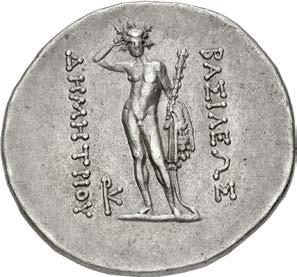
311. BAKTRIA, Greco-Baktrian Kingdom. Demetrios I Aniketos. Circa 200-185 BC. AR Tetradrachm (28mm, 16.95 g, 12h). Diademed and draped bust right, wearing elephant skin / Herakles standing facing, crowning himself, holding club and lion skin; } to inner left. Bopearachchi 1C; MPHB Group IIIA, – (O53/R134 [unlisted die combination]); SNG ANS 187; HGC 12, 63. Lightly toned with traces of iridescence, a couple of light scratches on reverse. Good VF. ($1500)
From the Richard J. Sullivan Collection, purchased from Kirk Davis.
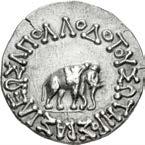



312. BAKTRIA, Greco-Baktrian Kingdom. Apollodotos I Soter. Circa 180-160 BC. AR Drachm (16.5mm, 2.12 g, 12h). Round module. Elephant standing right on ground line / Zebu advancing right. Bopearachchi 2A; SNG ANS 299-302; HGC 12, 117. Light iridescent toning, reverse deposits hairline flan crack. EF. Rare. ($500)
From the Richard J. Sullivan Collection. Ex Pars Coins inventory PCW-G3965 (ND).
Attractive Portrait



313. BAKTRIA, Greco-Baktrian Kingdom. Antimachos I Theos. Circa 180-170 BC. AR Tetradrachm (30mm, 16.80 g, 12h). Diademed and draped bust right, wearing kausia / Poseidon, laureate, standing facing, holding trident and filleted palm; K to inner right. Bopearachchi 1D; MPHB Group III 201–16 var. (O23/R– [unlisted rev. die]); SNG ANS 276-7; HGC 12, 106. Lightly toned, light horn silver, hint of underlying luster. Good VF. Attractive portrait. ($1500) Ex Roma E-Sale 100 (28 July 2022), lot 600.
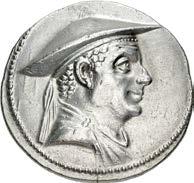
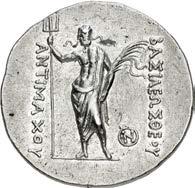


314. BAKTRIA, Greco-Baktrian Kingdom. Antimachos I Theos. Circa 180-170 BC. AR Tetradrachm (32mm, 16.80 g, 12h). Diademed and draped bust right, wearing kausia / Poseidon, laureate, standing facing, holding trident and filleted palm; K to inner right. Bopearachchi 1D; MPHB Group III, 211 (O23/R83); SNG ANS 276-7; HGC 12, 106. Light iridescent toning, light field marks, flan flaw on reverse. Good VF. ($1000)
From the Richard J. Sullivan Collection.
315. BAKTRIA, Greco-Baktrian Kingdom. Eukratides I Megas. Circa 170-145 BC. AR Tetradrachm (32mm, 16.92 g, 12h). Diademed, draped, and cuirassed bust right, wearing crested helmet adorned with bull’s horn and ear / The Dioskouroi, holding couched spears and palm fronds, on horses rearing right; Í to lower right. Bopearachchi 6E; SNG ANS 465; HGC 12, 131. In NGC encapsulation 8228934-001, graded Ch AU, Strike: 5/5, Surface: 3/5, brushed. ($1000)



316. BAKTRIA, Greco-Baktrian Kingdom. Eukratides I. Circa 170-145 BC. AR Drachm (19mm, 4.15 g, 12h). Diademed and draped bust right / The Dioskouroi, holding couched spears and palm fronds, on horses rearing right; Å to upper left, à to lower right. Bopearachchi 2D; SNG ANS –; HGC 12, 135. Bright surfaces with spot of toning on reverse, slight multiple strike on obverse, itself struck with slightly worn die, traces of underlying luster. EF. ($500)


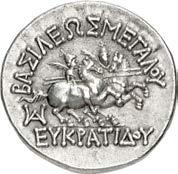
317. BAKTRIA, Greco-Baktrian Kingdom. Eukratides I Megas. Circa 170-145 BC. AR Tetradrachm (26mm, 17.26 g, 12h). Diademed, draped, and cuirassed bust right, wearing crested helmet helmet adorned with bull’s horn and ear / The Dioskouroi, holding couched spears and palm fronds, on horses rearing right; T to lower left. Bopearachchi 6W; SNG ANS 469-71; HGC 12, 131. Iridescent toning, light marks. EF. Struck on a compact flan. Lot includes a David Sear certificate of authenticity. ($750)
From the Richard J. Sullivan Collection.




318. BAKTRIA, Greco-Baktrian Kingdom. Eukratides I Megas. Circa 170-145 BC. AR Drachm (21mm, 4.24 g, 12h). Diademed, draped, and cuirassed bust right, wearing crested helmet helmet adorned with bull’s horn and ear / The Dioskouroi, holding couched spears and palm fronds, on horses rearing right; T to lower right. Bopearachchi 7I; SNG ANS 479-82; HGC 12, 136. Lightly toned, die break on edge of reverse with associated flan crack and lamination. EF ($750)



319. BAKTRIA, Greco-Baktrian Kingdom. Eukratides I. Circa 170-145 BC. AR Tetradrachm (33mm, 16.90 g, 12h). Heroic bust left, seen from behind, wearing crested helmet helmet adorned with bull’s horn and ear, brandishing spear in right hand / The Dioskouroi, holding couched spears and palm fronds, on horses rearing right; D below horses. Bopearachchi 8B; SNG ANS 484-5; HGC 12, 132. Deeply toned with iridescence. Good VF. ($3000)
From the Wayne Scheible Collection. Ex CNG inventory 806822 (January 2008); Triton IX (10 January 2006), lot 1125; Antiqua FPL X (2001), no. 109; Giessener Munzhandlung 96 (7 June 1999), lot 281; Classical Numismatic Group XXXI (9 September 1994), lot 551.



320. BAKTRIA, Greco-Baktrian Kingdom. Eukratides II Soter. Circa 145-140 BC. AR Tetradrachm (34mm, 16.78 g, 12h). Diademed and draped bust right / Apollo, holding arrow in hand, standing left and leaning on bow set on ground; à to inner left. Bopearachchi 1I; SNG ANS 623; HGC 12, 161. Lightly toned, traces of horn silver and porosity, a few cleaning marks, slight doubling on obverse, tiny flan flaw on reverse, tiny edge split. Near EF. ($500)
From the Richard J. Sullivan Collection. Ex Pars Coins 21 (15 December 2021), lot 81.
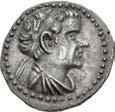

321. BAKTRIA, Greco-Baktrian Kingdom. Eukratides II Soter. Circa 145-140 BC. AR Drachm (19.5mm, 3.97 g, 12h). Diademed and draped bust right / Apollo, holding arrow in hand, standing left and leaning on bow set on ground; V to inner left at feet. Cf. Bopearachchi 2A, pl. 23, A = MIG Type 165a = BMBI 5, pl. V, 5 (for type); Bopearachchi & Rahman –; SNG ANS –; cf. Zeno 209791, 133214, and 13046; Triton XVII, lot 444; Triton XV, lot 1347. Toned with iridescence, traces of deposits, hint of smoothing, some surface crystallization. Good VF. Rare. ($1000)
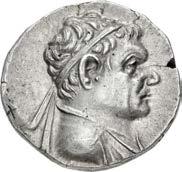

322. BAKTRIA, Greco-Baktrian Kingdom. Heliokles Dikaios. Circa 145-130 BC. AR Tetradrachm (33mm, 16.62 g, 12h). Diademed and draped bust right / Zeus standing facing, holding thunderbolt and scepter; D to inner left. Bopearachchi 1U; SNG ANS 642-8; HGC 12, 169. Iridescent toning, traces of deposits, light porosity, cleaning marks, light scratch on reverse, edge split with associated hairline flan crack. Near EF. ($500)
From the Richard J. Sullivan Collection. Ex Pars Coins 17 (26 July 2021), lot 35.
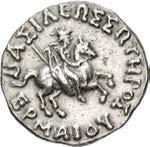



323. BAKTRIA, Indo-Greek Kingdom. Hermaios Soter. Circa 105-90 BC. AR Drachm (17mm, 2.69 g, 12h). Hermaios in military attire and with quiver slung over shoulder, on horse right / Zeus enthroned facing slightly left, raising hand and holding scepter; 3 to right. Senior, Hermaios –, but cf. H2cD; Bopearachchi 8A corr. (monogram); SNG ANS –; Zeno –; HGC 12, 296. Iridescent toning, deposits in devices. Near EF. Clear monogram. Extremely rare. ($750)
From the Richard J. Sullivan Collection.

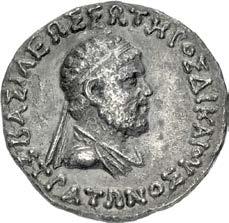

324. BAKTRIA, Indo-Greek Kingdom. Strato I. Circa 105-85/0 BC. AR Tetradrachm (28mm, 9.69 g, 12h). Diademed and draped bearded bust right / Athena Alkidemos standing right, brandishing thunderbolt and aegis; H to lower left. Bopearachchi 11A = MIG Type 322a = Haughton, Silver 7 = Whitehead, Notes, 31 (same rev. die); Bopearachchi & Rahman –; SNG ANS –; HGC 12, 323; Triton XVIII, lot 845 (same dies). Light iridescent toning, areas of find patina, areas of porosity and corrosion. VF. Extremely rare. ($4000)
The Triton XVIII example (graded there in EF) hammered for $8000.
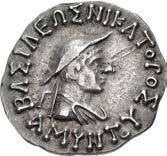
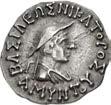


325. BAKTRIA, Indo-Greek Kingdom. Amyntas Nikator. Circa 80-65 BC. AR Drachm (19mm, 2.36 g, 12h). Diademed and draped bust right, wearing kausia / Zeus enthroned facing slightly left, holding statue of Athena, scepter, and palm frond; D to inner left. Bopearachchi 7A; SNG ANS 1244; HGC 12, 424. Toned with iridescence, porosity, scrape and hairline die break on obverse. Good VF. Rare. ($500)
From the Richard J. Sullivan Collection. Ex Nomisma E-Auction 18 (8 November 2020), lot 25.

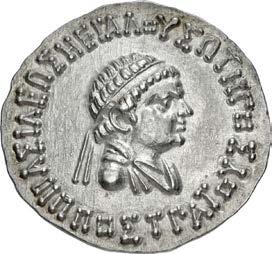

326. BAKTRIA, Indo-Greek Kingdom. Hippostratos Soter. Circa 65-55 BC. AR Tetradrachm (30mm, 9.67 g, 12h). Diademed and draped bust right / Hippostratos, in military attire, on horse rearing right on ground line; 2 below. Bopearachchi 3A; SNG ANS 1622-3; HGC 12, 449. Iridescent toning, slight porosity, light cleaning marks. EF. ($500)
From the Richard J. Sullivan Collection.


327. BAKTRIA, Indo-Greek Kingdom. Hippostratos Soter. Circa 65-55 BC. AR Tetradrachm (30mm, 9.55 g, 1h). Diademed and draped bust right / Hippostratos, in military attire, on horse rearing right on ground line; m (mam in Kharosthi) to left; O to right; & (pri in Kharosthi) in exergue. Bopearachchi 5F; SNG ANS 1625; HGC 12, 450. In NGC encapsulation 6763613-010, graded Ch XF, Strike: 4/5, Surface: 4/5. ($500)
End of Session 1
Session 2 – Tuesday, September 17, 2024 — 2 PM


328. YUEZHI. Anonymous. Early-mid 1st century BC. AR Tetradrachm (28mm, 8.76 g, 12h). Imitating a tetradrachn of Euthydemos I of Baktria. Uncertain mint in Sogdiana. Bust right, wearing diadem and headdress with earflaps / Herakles seated left on highly schematized stool or rock outcropping, holding club on knee; m’lht y’vg (great yabghu in Sogdian Aramaic) around. Senior A18.5T; ATEC 1654; ANS Kushan –; HGC 12, p. 189. Toned with iridescence, traces of deposits, minor porosity. Good VF. ($750)
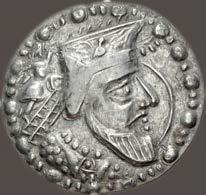


329. KHWAREZMIA. Ärtramūš I. First half of 3rd century AD. AR Tetradrachm (33.5mm, 12.80 g, 12h). Diademed bust right, wearing cap-like headdress decorated with eagle; to left, Nike right, crowning him with wreath; crescent to right; all within bead-and-reel border / E5¨E∑5E52¨[...]$ above, zMwp rIawnww (wrtrmwš mlk’ in Khwarezmian) below, King on horseback right; Í to left. Vainberg Б1 IV and pl. XXII, Б1 IV = Zeno 85992; Tolstov –; Whitehead –; Göbl, Dokumente –; MIG –; Sunrise – Zeno –; CNG 126, lot 407. Toned with iridescence, traces of deposits, small laminations, multiple strikes. VF. Good metal. Extremely rare. ($7500)
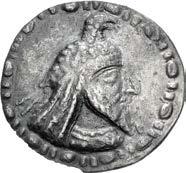

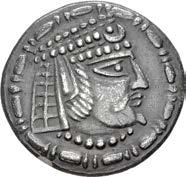

330. KHWAREZMIA. Wazamar. Second half of 3rd century AD. AR Tetradrachm (31mm, 7.82 g, 12h). Diademed bearded bust right, wearing headdress in form of falcon, all within a bead-and-reel border / ¨E2x∑$∑¨ above, zMwpMfnww (wzm’r mlk’ in Khwarezmian) below, King on horseback right; 5 to left. Vainberg Б2 V; Tolstov pl. I, 1; Whitehead –; Göbl, Dokumente –; cf. MIG Type 499; Sunrise – Zeno –. Toned with iridescence, areas of find patina, porous, edge chipped, crystallized. VF. ($2000)
331. KHWAREZMIA, Afrighids. Hamwasp(?)/Ramik. Second third of 6th century AD. AR Tetradrachm (31.5mm, 9.50 g, 12h). Diademed and crowned bust right; crown decorated wite crescent; all within a bead-and-reel border / King on horseback right, holding whip; 5 to left. Vainberg Г1; Sunrise 518. Find patina, slightly chipped and worn at high points, a few cleaning marks. VF. Extremely rare. ($2000)

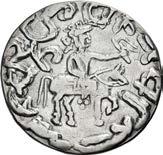
332. KHWAREZMIA, Afrighids. Šaram. Early-mid 7th century AD. AR Reduced Tetradrachm (27mm, 4.64 g, 1h). Crowned and diademed bust right; crown decorated with three pellets in crescent / King on horseback right, holding whip; 5 to left. Vainberg Type ΓIII; cf. Zeno 78199. Iridescent toning, hint of die rust, slight double strike on reverse. Good VF. Very rare. ($1500)
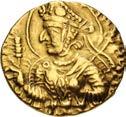


333. INDIA, Kushan Empire. Huvishka. Circa AD 151-190. AV Dinar (21mm, 7.92 g, 12h). Subsidiary mint in Gandhara (Peshawar?). Late phase. Nimbate, diademed, and crowned half-length bust left on clouds, holding mace-scepter and filleted spear / Mao, nimbate, lunar “horns” at shoulders, standing facing, head left, holding diadem and sword; & to left. MK 353/4 (this coin); ANS Kushan –; Donum Burns –. Toned, scrapes and cleaning marks, ex jewelry. VF. ($750) Ex Général de Grandprey Collection (Ciani, 20 February 1935), lot 248 (purchased by Allotte de la Fuÿe for FF 260).
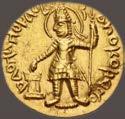
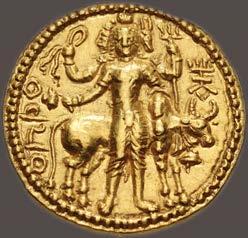

334. INDIA, Kushan Empire. Vasudeva I. Circa AD 190-230. AV Dinar (21mm, 8.06 g, 12h). Main mint in Baktria (Balkh?). Early phase. saO˜a˜OsaO bO z dIO ˚Os˜O, Vasudeva, nimbate, helmeted, and diademed, standing facing, head left, holding trident, sacrificing over altar to left / OIsO up left, triple-headed (two human and one a horned animal) and ithyphallic Siva standing facing, flames at shoulders, holding a garland or diadem in upper right hand, lotus in lower right, and trident tin upper left; lower left hand resting on hump of the bull Nandi standing behind left, wearing bell around neck; ^ to upper right. MK 500 var. (all three heads human); ANS Kushan –; Donum Burns 402 = C.A. Burns, “Topi Hoard of Kushana, Dinaras” Numismatic Digest 14 (1990/1), p. 20 (Second Workshop) = C.A. Burns, “Coinage of the King of Kings, Vasudeva, Kushana,” Numismatic Digest XI (1987), Fig. 20 (Workshop “B”). Lightly toned, whisper of die rust on obverse. Near EF. Extremely rare with the only other published example being the Donum Burns coin, only this example in CoinArchives. ($10,000)
Ex Classical Numismatic Group 108 (16 May 2018), lot 424.




335. SASANIAN KINGS. Šābuhr (Shahpur) I. AD 240-272. AV Dinar (23mm, 7.11 g, 3h). Mint I (“Ctesiphon”). Phase 1b, circa AD 244-252/3. Bust right, wearing diadem and mural crown with korymbos and ribbons / Fire altar; flanked by two attendants wearing mural crowns, each with korymbos. SNS type IIc/1a, style A ou Ater (?); Saeedi AV9; Sunrise –. Lightly toned, slight roughness and double strike. Near EF. ($2500)


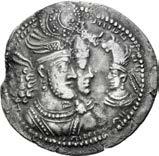

336. SASANIAN KINGS. Vahrām (Bahram) II, with Queen and Prince 4. AD 276-293. AR Drachm (33mm, 4.32 g, 3h). Style A. ‘Ctesiphon’ mint. Jugate busts of Vahrām (Bahram), wearing winged crown with korymbos, and his queen, wearing kolah with boar’s head, right, vis-a-vis bust of Prince 4, wearing kolah with eagle’s head, left / Fire altar; flanked by two attendants facing outward, each wearing winged crown with korymbos; > to left of flames. SNS type VIa(1)/2(1a), Style A; Sunrise –. Iridescent toning. Good VF. ($500)
Ex Classical Numismatic Group 121 (6 October 2022), lot 686; Classical Numismatic Group 88 (14 September 2011), lot 644.
337. SASANIAN KINGS. Vahrām (Bahram) II, with Queen and Prince 4. AD 276-293. AR Drachm (27mm, 3.90 g, 8h). Style H. Sakastan mint. Jugate busts of Vahrām (Bahram), wearing winged crown with korymbos, and his queen, wearing kolah with boar’s head, right, vis-a-vis bust of Prince 4, wearing kolah with eagle’s head, left / Fire altar; flanked by two attendants facing outward, each wearing winged crown with korymbos; trace of > to right of flames. SNS type VIc(1)/2(1a), Style H and pl. 23, A77 var. (six-rayed star to left of flames); Sunrise –. Find patina, die rust, flan crack, edge chipped. VF. Rare variety without the additional star on the reverse. ($750)
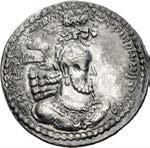
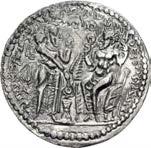
338. KUSHANO-SASANIANS. Ohrmazd (Hormizd) I. Circa AD 270-300. AR Drachm (25mm, 3.09 g, 12h). Investiture issue. MRWY (Merv mint). Crowned bust right, wearing lion headdress, surmounted by artichoke / Hormizd standing right, holding investiture wreath over altar in right hand and raising left hand in benedictional gesture to Anahita rising left from throne, holding investiture wreath in raised right hand and sceptre in left; (MRWY in Palahvi) between. Cribb 59; MK 1031; ANS Kushan –; cf. Göbl, Dokumente, pl. 7, XIX/1 = cf. Göbl, Antike, 3670 (attributed to Harid mint); Donum Burns –. Areas of find patina and iridescence, some porosity and crystallized surfaces, scratch on reverse. VF. Very rare. ($1000)



339. GAUL, Nemausus. Augustus, with Agrippa. 27 BC-AD 14. Æ Dupondius (27mm, 12.77 g, 7h). Struck circa 9/8-3 BC. Heads of Agrippa left, wearing rostral crown and laurel wreath, and Augustus right, wearing laurel wreath, back to back / Crocodile right chained to palm frond with short fronds; wreath with long ties above, palms fronds below. RPC I 524; SNG Copenhagen 699. Dark green patina, flan adjustment marks. Good VF. ($750)
Ex G. Hirsch 361 (24 September 2020), lot 2265; Guy Weill Goudchaux Collection (Triton XIII, 5 January 2010) lot 307; Classical Numismatic Group 72 (14 June 2006), lot 1129.



340. THRACE, Philippopolis. Geta. AD 209-211. Æ (30mm, 15.52 g, 6h). Struck AD 210-211. Laureate, draped, and cuirassed bust right, seen from the front / Orpheus, wearing Phrygian cap, seated right on rocks, playing lyre; animals around: panther, heron, bear, stork, goat, lion, and ram. Varbanov, Philippopolis XVI 18.6 (this coin); Mouchmov, Philippopolis 443; Varbanov 1642. Brown patina, roughness and deposits, a bit off center. Good Fine. Rare. ($750)
Ex Classical Numismatic Group Electronic Auction 308 (7 August 2013), lot 223 (hammer $1,500).
A native of Thrace, Orpheus was renowned for his music and augural abilities. When his wife, Eurydice, was struck down by a serpent, Orpheus traveled to Hades to win her release. When his attempt ultimately proved unsuccessful, since he forgot the god’s command not to look on his wife’s shade until they had reached the upper world, Orpheus returned to Thrace. According to Ovid (Metamorphoses XI), it was there that he was attacked by a band of Maenads and torn to pieces. The burial places of these pieces soon became shrines and a cult with mysteries developed. Practitioners followed the Orphikos bios, or way of life, which included celibacy and veganism.
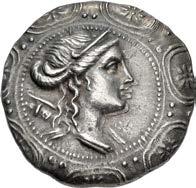

341. MACEDON, Roman Republican period. First Meris. Circa 174/3-149 BC. AR Tetradrachm (32mm, 16.87 g, 12h). Amphipolis mint. Struck circa 156-2nd half of 2nd century BC. Diademed and draped bust of Artemis right, with bow and quiver over shoulder; all in the center of a Macedonian shield / Club right; π above, ∂ and ` below; all within oak wreath; thunderbolt to left. Prokopov, Silver, Group II.A, 230 var. (O59/R– [unlisted rev. die]); HGC 3, 1103. Iridescent tone, minor doubling on obverse. Good VF. ($500)
From the 1930’s Collection of Robert W. Hubel of Michigan.
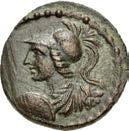

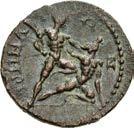
342. ATTICA, Athens. Antonine Era. Circa AD 140-175. Æ Drachm (21mm, 4.85 g, 3h). Draped bust of Athena left, wearing crested Corinthian helmet and aegis, shield and spear before / Theseus, holding club in his right hand, left hand holding a horn of the Minotaur kneeling right, whom he is preparing to slay. Kroll 276 var. (bust type); RPC IV.1 Online 3462 var. (same); Svoronos, Monnaies pl. 96, 1-7 var. (same); SNG Copenhagen 341 var. (same); BMC 764 var. (same). Greenbrown patina, small area of flat strike on reverse, flan adjustment marks. Good VF. Unpublished with this bust type, possibly unique. ($1500)
Ex Christopher Morcom Collection (Triton XI, 8 January 2008), lot 169 (hammer $2,400).
Theseus, son of Aegeus, the king of Athens, was known for a number of heroic feats on the model of Herakles. The most famous of these feats was his slaying of the Minotaur. Because the city was a tributary subject to Minos, the king of Crete, it was forced each year to send seven youths and seven maidens to the Cretan capital of Cnossus to feed the Minotaur, a half-man, half-bull who lived in the Labyrinth. To liberate Athens from this humiliating tribute, Theseus connived with his father to join the next shipment of youths. Once in Crete, he would slay the Minotaur, free his fellow victims, and return home. If successful, his returning ship would bear a white sail; if not, the sail would remain the black with which he left. With the help of Minos’ daughter, Ariadne, who had developed a passion for him, Theseus entered the Labyrinth and slew the Minotaur. On his return voyage, however, Theseus forgot to replace the black sail, and Aegeus, seeing this, hurled himself in despair into the sea which now is called Aegean.

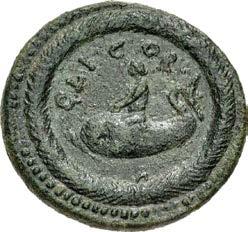
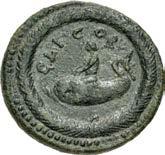
343. CORINTHIA, Corinth. Lucius Verus. AD 161-169. Æ (27mm, 10.81 g, 4h). Laureate and cuirassed bust right, seen from the front / Melikertes-Palaimon riding on dolphin left, within pine wreath. BCD Korinth 752 (same dies); RPC IV.1 5177.8 (this coin); NCP p. 11, 11. Green patina, light roughness. EF. Very rare. ($1500)
Ex Group CEM (Classical Numismatic Group 88, 14 September 2011), lot 819; David Simpson Collection (Triton V, 15 January 2002), lot 1706; Virgil Brand Collection (Part 7, Sotheby’s, 25 October 1984), lot 349.
The Corinthians credited their king Sisyphos with founding the Isthmian Games at the funeral of the boy-hero Melikertes-Palaimon at Isthmia. Adjacent to the early sanctuary of Poseidon was the Palamaion, an extensive cult area with sacrificial pits and a circular temple of Hadrianic date, which was transformed during the joint reign of Marcus Aurelius and Lucius Verus. According to Pausanias (I, 70-72 and III, 4-16), within the temple was a statue of Melikertes-Palaimon riding on a dolphin. Athamas, the son of Aiolos and king of Orchomenos in Boeotia, was driven mad by Hera because he had sheltered Dionysos. After he killed his son Learchos, he pursued Ino into the sea with their son Melikertes, where both were transformed into marine deities. Ino became Leukothea, and Melikertes changed to Palaimon and a dolphin carried his body ashore on the Sardonic Gulf.




344. KINGS of BOSPORUS. Sauromates I, with Hadrian. AD 93/4-123/4. AV Stater (19mm, 7.77 g, 12h). Dated BE 420 (AD 123/4). BACIΛЄωC CAYPOMATOY, diademed and draped bust of Sauromates I right / Laureate head of Hadrian right, KY (date) below. Frolova p. 111, pl. VII, 15 (dies A-a) = RPC III 818.1 = Burachkov (pub. 1884), pl. XXVIII, 147 (this coin); Anokhin 1540; MacDonald 394. Red hue, minor flan crack, hairlines, reverse die shift. EF. Extremely rare, only this coin known to RPC, a second cited in Anokhin. ($2000)
From the 1930’s Collection of Robert W. Hubel. Ex A. Hess (7 March 1935), lot 20; Hermitage Museum Collection (Schlessinger 11, 26 February 1934), lot 213; Burachkov Collection.


345. PONTUS, Amasia. Severus Alexander. AD 222-235. Æ (34mm, 24.43 g, 12h). Dated CY 229 (AD 229/30). Laureate, draped, and cuirassed bust right, seen from behind / Europa seated on back of bull standing right; ЄT CK/Θ (date) to right. Dalaison 583 (D146/R454); RPC VI Online 6469; RG 106a corr. (rev. legend). Dark brown surfaces. Good VF. Rare, only three in CoinArchives. ($500)
Extremely Rare and Unpublished


346. PONTUS, Amisus. Caracalla. AD 198-217. Æ (32mm, 22.17 g, 6h). Dated CY 241 (209/10 AD). Laureate, draped, and cuirassed bust left, holding spear forward and shield decorated with gorgoneion; c/m: capricorn right within oval incuse / Caracalla and Geta in military dress, on horseback galloping right; CMA (date) in legend. RG –; SNG BN –; SNG von Aulock –; SNG Copehagen –; BMC –; Giessener Münzhandlung 84, lot 5507. Unpublished in the standard references. For c/m; Howgego 299. Dark brown patina with light earthen highlights, porosity. Near VF. Extremely rare. ($750)

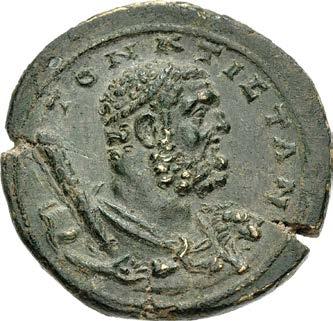
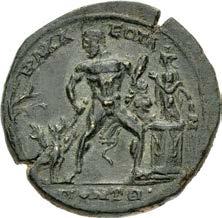
Heraclaea Pontica. temp. Gordian III. AD 238-244. Æ Octassarion (36.5mm, 27.38 g, 7h). Herakles’ 12th Labor. Diademed bust of Herakles right, lion’s skin around neck, holding club over shoulder / Herakles advancing right, head left, holding Cerberus by his leash in right hand, club and lion’s skin in left; to right, Pomona standing left on cippus, holding apple and ears of grain, to left, tree . Dalaison, Coinage 6; RPC VII.2 2092.3 (this coin); RG 71 (same dies); SNG BN 267. Dark green patina, flan cracks, scrape on obverse, light smoothing. Good VF. ($4000)
Ex David Simpson Collection (Triton V, 15 January 2002), lot 1712 (hammer $4,500); Hauck & Aufhäuser 15 (21 March 2000), lot 100.
Herakles, made temporarily insane by the goddess Hera, murdered his wife and children. Once recovered, and distressed by his actions, Herakles consulted the Delphic Oracle to find a means of expiating his sin. As a punishment, Apollo replied that the hero would have to serve his cousin Eurystheus, the king of Tiryns, a man whom Herakles despised, for a period of twelve years. Because Eurystheus also hated Herakles, he devised a series of ten feats of such difficulty that either they would be unachievable or they would end in Herakles’ death. Because Herakles received assistance in completing two of the tasks, Eurystheus added two more. Each labor became more fantastic, and eventually Herakles was compelled to break the bonds of the supernatural in order to complete his task. Once he accomplished the Labors, Herakles was absolved of his guilt, and preceded to perform many other heroic feats.
For his final Labor, Herakles was sent to the underworld to capture Cerberus. In order to complete this most difficult task, Herakles was initiated in the Eleusinian Mysteries so that he could learn how to enter and exit the underworld alive, as well as absolve himself of his past crime of killing the Centaurs in his Fourth Labor. Finding the entrance to the underworld, he again enlisted the assistance of Athena, while Hermes, the conveyor of souls, guided him along. While there, Herakles was able to free Theseus, who had been imprisoned by Hades for attempting to kidnap Persephone, but could not do the same for Theseus’ accomplice, Pirithous. Herakles sought the permission of Hades and Persephone to take Cerberus. The gods assented on condition that Herakles did not harm the creature in any way. Wrestling Cerberus into submission he brought it to the upper world through an entrance in the Peloponnese. When he returned with Cerberus to the palace, Eurystheus was so afraid of the fearsome beast that he jumped into a large storage jar to hide. With this, Herakles’ punishment was complete, and he was now freed of his guilt.




348. BITHYNIA, Nicaea. Caracalla. Caesar, AD 196-198. Æ Diassarion (26mm, 14.00 g, 1h). Bareheaded and draped bust right, seen from the front / Triptolemus driving biga of winged serpents right. RG 123 corr. and var. (Marcus Aurelius as Caesar, rev. legend arrangement); SNG von Aulock 588 (this coin). Brown patina, light porosity. Near EF. Extremely rare, presently unique. ($750)
Ex Auctiones AG 7 (7 June 1977), lot 375; Hans von Aulock Collection.


349. BITHYNIA, Nicaea. Gordian III. AD 238-244. Æ Hectassarion (32mm, 18.21 g, 1h). Radiate, draped, and cuirassed bust left, holding spear and shield decorated with gorgoneion / Hercules reclining left upon lion advancing right, extending right hand to small Eros to left, holding club in left. RG 700; RPC VII.2 1894.6 (this coin). Dark brown patina, some weakness and porosity at the periphery. VF. Very rare. ($500)
Ex Dr. George Spradling Collection (Classical Numismatic Group Electronic Auction 347, 25 March 2015), lot 347.
RPC Plate Coin
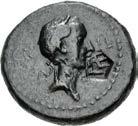


350. MYSIA, Lampsacus. Julius Caesar. 45 BC. Æ (22.5mm, 8.50 g, 12h). Q. Lucretius and L. Pontius, duoviri. Laureate. head right; c/m: LAE monogram within pentagram incuse / Priest plowing with yoke of oxen right. RPC I 2269.10 (this coin); FITA p. 246, (2), pl. VIII, 6. For c/m: Howgego –. Dark brown surfaces, slight roughness. Coin: VF; c/m: Good VF. A detailed monogram. ($1000)
Ex Agora Auctions 100 (4 May 2021), lot 79.

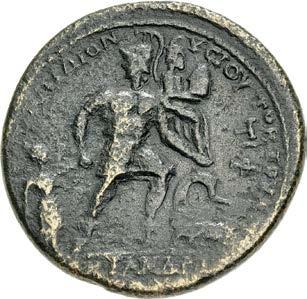

351. TROAS, Antandrus. Caracalla. AD 198-217. Æ (34mm, 22.39 g, 7h). Dionysios, strategos for the second time. Laureate, draped, and cuirassed bust right / Aeneas advancing right, head left, leading Ascanius by the hand, and holding Anchises on his shoulder; prow of galley to right. C. Fontana, “Note su alcune monete inedite o poco conosciute della serie urbica greca coniate durante l’Impero Romano” in RIN 1967, 18 (this coin). Yellow-brown surfaces, porosity. Near VF. Unique. ($750)
Ex Classical Numismatic Group 43 (24 September 1997), lot 964.
According to Vergil (Aeneid, Book 2), Aeneas, the son of the goddess Venus and the Trojan Anchises, fled with some remnants of the inhabitants of Troy as it fell to the Greeks, taking with him his son, Ascanius, his elderly father, Anchises, and the Palladium, or ancient sacred statue of Athena. The Trojans eventually made their way west to resettle in Italy. There they intermarried with the local inhabitants and founded the town of Lavinium, and thereby became the nucleus of the future Roman people. One of the descendants of Aeneas’ son Ascanius (known now as Iulus) was Rhea Silvia. Impregnated by the god Mars, she gave birth to the twins, Romulus and Remus. Exposed by their great-uncle, Amulius, the twins were suckled by a she-wolf unitl they were eventually rescued. Romulus later founded the city of Rome, and consequently the image of the she-wolf and the twins became the symbol of the city. The mythological depictions on this coin reinforce the importance of Ilium, not only as the seedbed of the future Roman people, but also as the mother city of the future caput mundi



352. TROAS, Ilium. Marcus Aurelius. AD 161-180. Æ (33.5mm, 26.57 g, 7h). Laureate, draped, and cuirassed bust right, seen from behind / Poseidon advancing right, holding trident and applying mortar to brick held by Apollo standing left, holding laurel branch, foot on bricks; in background, city walls of Troy with three towers. Bellinger –; RPC IV.2 Online 3139.3 (this coin); von Fritze, Ilion –. Rough brown surfaces, spot of corrosion on reverse. Near VF. Extremely rare, only three recorded in RPC. ($1500)
Ex Cornelius C. Vermeule Collection (Stack’s, 28 April 2010), lot 239.
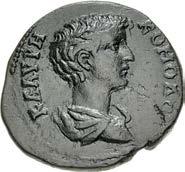


353. TROAS, Ilium. Commodus. As Caesar, AD 166-177. Æ (30mm, 14.37 g, 12h). Struck circa AD 176-177. Bareheaded and draped bust right / Ilus reclining right, looking toward figure of Zeus descending from heavens, holding Palladium in right hand and scepter in left; to right, cow suspended from tree, being sacrificed by a man who clutches its horn with left hand and holds a sacrificial knife in right. Bellinger –; Amandry, Ilium p. 212, type E; RPC IV.2 Online 9211.2 (this coin); von Fritze, Ilion –. Dark brown patina, slight double strike, minor porosity and metal flaws, some details enhanced. VF. Extremely rare, one of two known. RPC plate coin. ($3000)
Ex Classical Numismatic Group 97 (17 September 2014), lot 472 (hammer $6,830).


354. TROAS, Ilium. Commodus. AD 177-192. Æ (36mm, 20.23 g, 7h). Struck circa AD 180-182. Laureate, draped, and cuirassed bust right, seen from behind / Hector, helmeted, driving galloping quadriga right, holding transverse spear in right hand and shield in left. Bellinger T184; RPC IV.2 Online 120; von Fritze, Ilion 78. Brown surfaces, slight porosity, small edge nick. Near VF. Extremely rare, only four known to RPC. ($750)
For nine years in the Trojan War, the fortunes of both sides ebbed and flowed. During the tenth year, Achilles, upset over the loss of the woman Chryseis to Agamemnon, the commander of the Greeks, withdrew to his tent and refused to fight. The loss of the greatest of the Greek warriors allowed the Trojans under the command of Hector, the eldest son of Priam, to gain the upper hand. At that point, Patroclus then offered to put on Achilles’ armor in order to rouse the Greeks to fight. Thinking that Achilles had returned to battle, Hector dashed out on to the field of battle in his chariot (Hom. Il. 16. 367-369):
(“But the swift-footed horses did carry forth Hektor with his equipage, and he left behind the Trojan host, whom unwilling the excavated trench held back”). Hector killed the clearly ill-matched Patroclus, and, in order to avenge his friend, Achilles returned to the field to slay Hector.
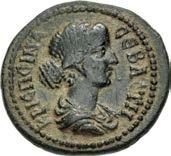
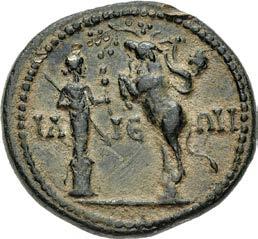
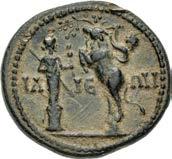
355. TROAS, Ilium. Crispina. Augusta, AD 178-182. Æ (28mm, 11.92 g, 6h). Draped bust right, wearing stephane / Statue of Athena of Ilium right on decorated short column, holding transverse spear and Palladium; to right, cow suspended left from tree, man sacrificing her from behind with knife. Bellinger T198; RPC IV.2 Online 131.14 (this coin); von Fritze, Ilion 85. Earthen brown patina, scrape on obverse. VF. ($1000)
Ex David Simpson Collection (Triton V, 16 January 2002), lot 1721; Auctiones AG 17 (7 June 1988), lot 343; Sternberg XI (20 November 1981), lot 276.
Ilos was the legendary founder of Troy, which he named after his father, Tros. Ilos had followed a cow until it rested, and there built the city after having prayed for a sign that he had chosen the right spot. The sign that Zeus had provided was a statue that was sacred to Athena, the Palladium (Athena Ilias). Ilos built a temple to house the statue, and Troy was safe from foreign enemies as long as the Palladium remained within the city walls (Homer, Iliad 21.231-236; Apollodorus 3.12.2-3)



356. ISLANDS off IONIA, Samos. Tranquillina. Augusta, AD 241-244. Æ (29mm, 10.04 g, 7h). Draped bust right, wearing stephane / Nude hunter (Ankaios?) advancing right, thrusting his spear at a boar, which is emerging left from a cave. RPC VII.1 591.4; BMC 312; SNG von Aulock 2316. Red-brown surfaces, porosity, slight obverse die shift. Near VF. ($500)

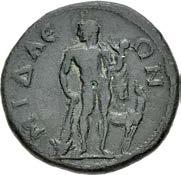
357. PHRYGIA, Midaeum. Severus Alexander. AD 222-235. Æ (20mm, 13.61 g, 7h). Laureate, draped, and cuirassed bust right, seen from behind / Herakles standing facing, head left, leaning on club to left, holding infant Telephus and lion’s skin in right; to right, stag standing right, looking left. von Aulock, Phrygiens 815-6; RPC VI Online 5731. Brown patina with earthen deposits, some obverse roughness. Near VF. Extremely rare, one of three known and the only example in private hands. ($500)
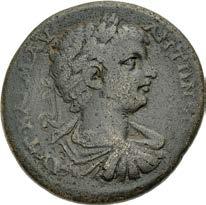

358. PHRYGIA, Sebaste. Caracalla. AD 198-217. Æ (34mm, 21.25 g, 6h). Lucilius Antonius, archon. Laureate, draped and cuirassed bust right, seen from behind / Perseus standing right, head left, cutting of the head of Medusa with harpa, who kneels before; to left stands Athena holding spear and shield. BMC 34; SNG Copenhagen –; SNG von Aulock –. Brown patina, light porosity. Fine. Extremely rare. ($500)
Ex Classical Numismatic Group 43 (24 September 1997), lot 993.
Scenes from the hero-cycle of Perseus are found on numerous Greek and Provincial bronzes, but none as dramatic as this. The half-nude hero is shown subduing the horrid Medusa, his cloak streaming out behind him as he draws his blade across the monster’s throat. His patron Athena stands at his side, and to assist his conquest, positions her shield in such a manner that Perseus can see Medusa’s reflection to slay her without looking directly upon her and thereby turning to stone.


359. PHRYGIA, Stectorium. Philip I. AD 244-249. Æ (37mm, 19.30 g, 6h). Aurelius Demetrius, asiarch. Laureate and cuirassed bust right, seen from the front, gorgoneion on breastplate / Hero Mygdon(?) stepping on to galley left, holding torch in raised right hand, shield and spear in left. RPC VIII Online 20573 (this coin cited); SNG Copenhagen 692. Brown surfaces, light porosity, slight obverse die shift. VF. Extremely rare. ($2000)
Ex G. Hirsch 166 (16 May 1990), lot 1314.

Illustrated in RPC Online


360. PHRYGIA, Temenothyrae. temp Philip I. AD 244-249. Æ (30mm, 14.74 g, 6h). Gaius Arruntius Nikomachos Tiberinianus, archiereus and primary archon for the second time. Bare head of Herakles right / The Dioscuri standing facing, each holding spear and wearing pileus, star above heads. RPC VIII Online 20265 (this coin cited and illustrated); Winterthur 4234. Brown patina with traces of earthen highlights. Good VF. Extremely rare, only four recorded in RPC. ($1500)
Ex Group CEM (Classical Numismatic Group 90, 23 May 2012), lot 1066 (hammer $2750).

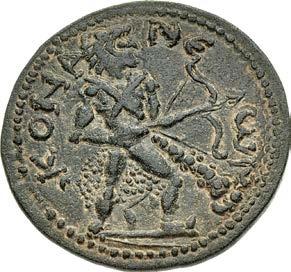

361. PISIDIA, Conana. Gallienus. AD 253-268. Æ (32mm, 13.45 g, 6h). Laureate head right / Herakles, wearing lion’s skin headdress, advancing right, drawing bow and arrow; club resting on bucranium leans against his left leg. von Aulock, Pisidiens 861-75; RPC X Online 63416; SNG von Aulock 5072. Brown patina with earthen highlights, slight doubling on the reverse. Near EF. Among the finest known. ($500)


362. CILICIA, Aegeae. temp. Caracalla. AD 198-217. AR Tetradrachm (27mm, 11.05 g, 6h). Dated CY 263 (AD 216/7). Bust of Asclepius right, wearing taenia and with slight drapery on both shoulders; to right, serpent-entwined staff / Statue of Asclepius standing facing, head left, leaning on serpent-entwined staff, within octastyle temple; below, goat right; Γ-Ξ/C (date) across field. Haymann 110a. Toned, light porosity. VF. Extremely rare, only one known to Haymann. ($750)
As patron deity of Aegeae, which was renowned for its doctors, the appearance of Asclepius is not surprising, but the type must also allude to Caracalla’s well being. The emperor’s health had declined precipitously in the final years of his reign. On his way to campaign in the east in AD 214, he visited the great shrine of Asclepius at Pergamum in hopes of finding a cure. This visit was commemorated with a remarkable series of medallions issued at Pergamum, and around the same time Asclepius was honored on Caracalla’s imperial coinage. The exact circumstances that led to this rare tetradrachm being struck at Aegeae are unknown. It is possible that Caracalla visited the important port town on his journey east.
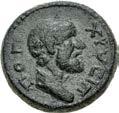

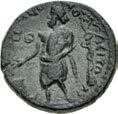
363. CILICIA, Pompeiopolis. Antonine era, AD 138-192. Æ Assarion (19mm, 5.59 g, 12h). Dated CY 209 (143/4 AD). XPYCIΠ ΠOC, Bareheaded, bearded, and draped bust of the philosopher Chrysippos to right / ΠOMΠHIO ΠOΛEITΩN, Asclepius standing facing, head left, holding caduceus over altar in his right hand and his left hand holding his chlamys; to right, serpent coiled around tree. RPC IV.3 Online 17500 corr. (altar not described); SNG BN –; SNG Levante –; Leu 10, lot 2278; Nomos 21, lot 228. Dark green patina, minor roughness. VF. Extremely rare, the third known. ($750)
Ex Classical Numismatic Group 120 (11 May 2022), lot 641.
Chrysippos of Soloi was a Greek philosopher of the Stoic school of Athens. He was born in Soloi, but moved to Athens as a young man after losing considerable land when it was confiscated by the king’s treasury. He soon became a disciple of Cleanthes, then the head of the Stoic school, which was located at the north end of the Athenian agora. Chrysippos was a prolific writer, composing more than 700 works, and succeeded Cleanthes as head of the Stoic school upon his death, around 230 BC. Chrysippos died during the 143rd Olympiad at the age of 73. It is said that he died in a fit of laughter after watching a donkey eat some figs.



364. CILICIA, Tarsus. Maximinus I. AD 235-238. Æ (35mm, 28.05 g, 1h). Radiate, draped, and cuirassed bust right, seen from behind / The Judgment of Paris: Paris seated left on rock, wearing Phrygian cap and holding apple and pedum, facing Aphrodite, nude, standing right, drawing drapery from shoulders, veiled Hera enthroned right, and Athena standing right, resting shield on ground before her and holding spear. RPC VI Online 7109; SNG BN 1587 (same dies); SNG Levante –. Earthen green patina, light porosity. Near VF. Rare. ($2000)
Before the birth of her second son, Hekaba, wife of King Priam of Troy, dreamed that she had brought forth a flaming firebrand that destroyed the city, and the newborn child was therefore exposed on Mount Ida. Brought up by a shepherd, he was called Paris, and later, by his courage, earned the name Alexander or ‘defender of men’. He was beloved by the nymph Oenone, but he deserted her as a result of a tempting suggestion by Aphrodite which led to the Judgement of Paris. When Hermes came to Mount Ida with the three goddesses, he called Paris and said to him: “Come here and decide which is the more excellent beauty of face, and to the fairer give this apple’s lovely fruit.” (Colluthus, The Rape of Helen 130). While Paris reflected, the goddesses, who for the occasion had bathed their immortal bodies, offered him bribes in order to win the apple award of beauty: Athena offered him the command of Phrygia and the destruction of Hellas, or as some say, that he would be bravest of mortals and skilled in every craft. Likewise Hera offered him, besides wealth, the dominion over Asia and Europe. But Aphrodite offered him the hand of Helen, whose beauty was famous worldwide, and this bribe won the apple.


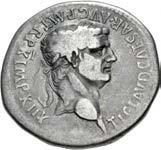

365. GALATIA, Ancyra. Caracalla. AD 198-217. Æ (25mm, 9.58 g, 6h). Asclepian Games issue. Laureate, draped, and cuirassed bust right, seen from behind / Agonistic prize crown with palm set upon four-legged table, flanked by two purses; below, five apples. Arslan B87; BMC 25. Dark brown patina. Choice EF. Very rare. ($500)
366. ASIA MINOR, Uncertain. Claudius, with Agrippina Junior. AD 41-54. AR Cistophorus (26mm, 10.86 g, 7h). Uncertain mint (Ephesus?). Struck AD 51. Laureate head of Claudius right / Draped bust of Agrippina right. RPC I 2223 (Cistophoric mint); RSC 2. Lightly toned, small metal flaw on obverse, slight porosity, scratches. Near VF. ($750)
Ex John L. Cowan Collection (Classical Numismatic Group Electronic Auction 469, 3 June 2020), lot 378, purchased from Pegasi Numismatics, 4 September 2014.
367. No Lot.


368. SELEUCIS and PIERIA, Antioch. Galba. AD 68-69. AR Tetradrachm (27mm, 15.32 g, 12h). Dated “New Holy Year” 2 (AD 68/9). Bare head right / Eagle standing left on wreath, with wings displayed, holding wreath in beak; palm frond to left, ЄTOYC B (date) in exergue. McAlee 308; RPC I 4198; Prieur 100. Toned, light deposits, scratches and minor porosity. VF. Excellent portrait. ($500)


369. SELEUCIS and PIERIA, Antioch. Otho. AD 69. AR Tetradrachm (27mm, 14.74 g, 12h). Dated RY 1 (AD 69). Laureate head right / Eagle standing left on wreath, with wings displayed, holding wreath in beak; palm branch to left, crescent between legs, ЄT[OYC A] (date) below. McAlee 316; RPC I 4199; Prieur 101. Lightly toned, slight die shift on obverse. Near EF. ($750)
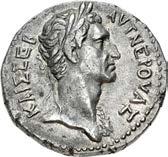

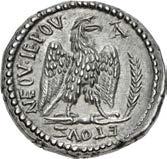
370. SELEUCIS and PIERIA, Antioch. Nerva. AD 96-98. AR Tetradrachm (27.5mm, 15.52 g, 12h). Dated “New Holy Year” 1 (AD 96/7). Laureate bust right, wearing aegis on shoulder / Eagle standing right on thunderbolt, with wings displayed, palm frond to right; barred A (date) above wing. McAlee 419; RPC III 3476; Prieur 149. Lightly toned, faint hairlines, minor obverse deposits. Good VF. Well centered on a broad flan. ($1000)
Ex Benito Collection (Classical Numismatic Group 114, 14 May 2020), lot 521 (hammer $2000); Roma XX (29 October 2020), lot 376.



371. SELEUCIS and PIERIA, Antioch. Septimius Severus. AD 193-211. AR Drachm (17mm, 3.13 g, 11h). Struck AD 202. [...] CЄ OYHPO CЄB, laureate head right / ΔHMAPX ЄΞ OYCIAC YPA Γ, Tyche standing left, holding Palladium and long scepter, Nike on her shoulder. McAlee –; Prieur –. Toned, light roughness. VF. Extremely rare, apparently unpublished. ($500)
From the Wild Rose Collection, purchased from Rauch, December 2006.



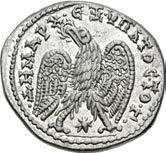
372. SELEUCIS and PIERIA, Laodicea ad Mare. Septimius Severus. AD 193-211. BI Tetradrachm (26.5mm, 13.67 g, 1h). Struck AD 208-209. Laureate head right / Eagle standing facing, head left, with wings displayed, holding wreath in beak; star between legs. Prieur & Amandry Group III, 36; McAlee, Severan, Group 3, 26; Prieur 1148. Lustrous, minor marks and scratches. EF. ($500)
373. SELEUCIS and PIERIA, Laodicea ad Mare. Caracalla. AD 198-217. BI Tetradrachm (27mm, 12.87 g, 12h). Struck AD 209-212. Laureate and draped bust right, seen from the front / Eagle standing facing, head and tail left, with wings displayed, holding wreath in beak; star between legs. Prieur & Amandry Group IV, 49; McAlee, Severan Group 4, 32; Prieur 1173B. Small obverse die flaw and scratches. EF. ($500)

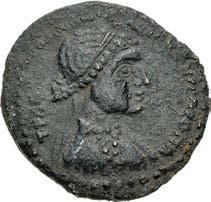
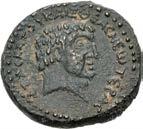
374. COELESYRIA, Chalcis ad Belum. Mark Antony and Cleopatra. 32-31 BC. Æ (23mm, 9.01 g, 5h). Dated RY 21 (Egyptian) and 6 (Phoenician) of Cleopatra (32/1 BC). Diademed and draped bust of Cleopatra right / Bare head of Antony right. RPC I 4771; Rouvier 438-40; Svoronos 1887; Sofaer 43. Dark green patina, light roughness, minor deposits, struck on a broad flan. Good VF. Excellent portraits. ($750)

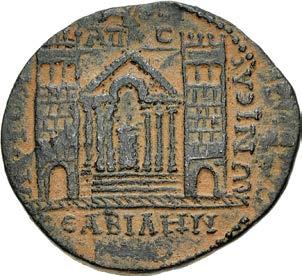

375. DECAPOLIS, Abila. Elagabalus. AD 218-222. Æ (33mm, 15.88 g, 12h). Dated CY 281 (AD 218). Laureate and cuirassed bust right, seen from the front / Flaming altar within hexastyle temple with central arch, pediment surmounted by Nike, and two flanking towers with arched doors and window; ΑΠ-C (date) above. Spijkerman 21; RPC VI Online 9239; Rosenberger 21 var. (date); Sofaer 22. Green patina with orange earthen highlights. VF. Rare. ($500)

376


377

376. DECAPOLIS, Nysa-Scythopolis. Antoninus Pius. AD 138-161. Æ (29mm, 17.73 g, 12h). AYTOKP ANTωNINOC ЄBЄV CЄB HC, laureate head right / Zeus seated left, holding Nike and long scepter, at feet left, eagle; all within tetrastyle temple with central bay, pellet in pediment. Barkay 14 var. (obv legend); Spijkerman 13 (text and plates don’t match); RPC IV.3 6471 corr. (L. Verus, legends); Rosenberger 13 var. (same); Sofaer 14 var. (same). Earthen green patina. Good VF. Very rare variety. ($750)
377. PHOENICIA, Sidon. Julia Maesa. Augusta, AD 218-224/5. Æ (29mm, 19.97 g, 12h). Draped bust right / Dido seated left on throne, holding patera. RPC VI Online 8442; Rouvier 1592. Earthen brown patina, light porosity, flan adjustment marks. Near VF. Extremely rare, only three known to RPC. ($500)
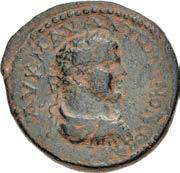
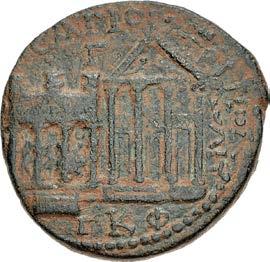

378. PHOENICIA, Tripolis. Caracalla. AD 198-217. Æ (30mm, 17.05 g, 12h). Dated CY 523 (AD 211/2). Laureate, draped, and cuirassed bust right, seen from behind / Tetrastyle temple with statue of Zeus Hagios with central altar flanked by statues of Sol and Luna; to right, taller tetrastyle temple with two reclining figures in pediment; Γ above, ΓKΦ (date) in exergue. BMC 79. Earthen red-brown patina, small scrape on obverse. VF. Rare. ($500)



379. PHOENICIA, Tyre. Volusian. AD 251-253. Æ (27.5mm, 16.27 g, 12h). Laureate and cuirassed bust right, seen from the front / Cadmus standing left, holding patera in right hand, transverse spear and drapery in left; at feet left, recumbent heifer; to right, murex shell; to upper left, city gate of Thebes; ΘH/BЄ in left field. RPC IX 2018; Rouvier 2482. Earthen green patina, light roughness. Near VF. ($750)
While traveling through Greece in search of his abducted sister Europa, the Phoenician prince Cadmus consulted the Delphic oracle, where he was instructed to follow a sacred cow and found a city on the spot where it should finally take rest. Cadmus followed the instructions, and the spot where the cow stopped became the great city of Thebes in Boeotia.


380. PHOENICIA, Tyre. Gallienus. AD 253-268. Æ (30.5mm, 17.66 g, 12h). Radiate, draped, and cuirassed bust right, seen from the front / Diomedes standing left, with foot on rock, holding palladium in right hand and scepter in left; murex shell to left. RPC X Online 62980; Rouvier 2542. Earthen green surfaces, light roughness. Good VF. Extremely rare. ($750)


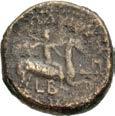
381. JUDAEA, Herodians. Agrippa I, with Agrippa II. 37-43 CE. Æ (18.5mm, 7.32 g, 12h). Caesarea Panias (Caesarea Philippi) mint. Dated RY 2 of Agrippa I (37/8 CE). Diademed head of Agrippa I right / Agrippa II, holding reins and raising hand, on horse galloping right; LB (date) below. Meshorer 113; Hendin 6268; RPC I 4974; Sofaer 147-8. Red-brown surfaces, porosity. Good Fine. Very rare. ($750)


382. JUDAEA, Aelia Capitolina (Jerusalem). Caracalla. 198-217 CE. BI Tetradrachm (26mm, 12.79 g, 12h). Struck 215-217 CE. Laureate head right / Eagle standing facing on filleted thyrsus, head and tail left, with wings displayed, holding wreath in beak; wine jar between legs. Meshorer 89 var. (bust type); Prieur 1625; Sofaer –. Minor marks and scratches. VF. Extremely rare, only one known to Prieur, none in CoinArchives. ($500)

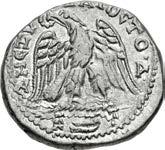


383. JUDAEA, Ascalon. Caracalla. 198-217 CE. BI Tetradrachm (27mm, 13.85 g, 12h). Struck 215-217 CE. Laureate head right / Eagle standing facing on palm frond, head and tail left, with wings displayed, holding wreath in beak; in exergue, dove right with olive branch in beak. Prieur 1654; Sofaer 177. Slight obverse die shift. VF. ($500)
384. JUDAEA, Ascalon. Diadumenian. As Caesar, 217-218 CE. BI Tetradrachm (26mm, 12.78 g, 12h). Bareheaded, draped bust right, seen from the front / Eagle standing facing, head left, with wings displayed, holding wreath in beak, on palm branch; below, dove right, olive branch in its beak. Prieur 1656 (this coin); Sofaer –. Toned, some roughness, die flaw on reverse. Near VF. Extremely rare, only this coin known to Prieur, one more in CoinArchives. ($750)
Ex Andre Ronde Collection; Michel Prieur Collection.



385. JUDAEA, Neapolis. Caracalla. 198-217 CE. BI Tetradrachm (25.5mm, 14.48 g, 12h). Struck 215-217 CE. Radiate and cuirassed bust right, seen from behind / Eagle standing facing, head and tail left, with wings displayed, holding wreath in beak; between legs, three-horned altar. Kropp –; Prieur 1310 (Byblus). Lustrous, minor marks. Good VF. Extremely rare, only one known to Prieur, one in CoinArchives (but incorrectly attributed). ($1000)
Dr. Kropp has reattributed this series, by die study, from Byblus to Neapolis in Judaea (see Dr. Andreas Kropp, “A Roman altar on Mt. Gerizim: Rediscovering a civic icon on tetradrachms of Neapolis (Samaria)” in JRA 34 [2021]. pp. 220-236).


386. ARABIA, Philippopolis. Divus Julius Marinus. Died circa AD 246/7. Æ (30mm, 19.54 g, 7h). Struck at Antioch, circa AD 247-249. Bareheaded and draped bust right, supported by eagle standing right, head and tail left, with wings displayed / Roma seated left, holding in right hand two figures standing on eagle left, and spear in left; shield at her side, S C across field. Butcher, Two pl. 25, 10; Spijkerman 1; RPC VIII Online 2417; Sofaer 1. Dark brown patina with earthen highlights, minor pitting. VF. Very rare. ($750)


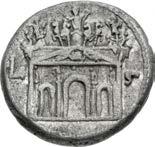
387. EGYPT, Alexandria. Domitian. AD 81-96. BI Tetradrachm (25.5mm, 13.21 g, 12h). Dated RY 6 (AD 86/87). Laureate head right / Triumphal arch with three bays between columns surmounted by statues; on the triangular pediment, two Nikai supporting a disc; roof surmounted by statuary group of Domitian driving quadriga between trophies and captives; L ς (date) across field. Köln 349; Dattari (Savio) 449; K&G 24.53; RPC II 2524; Emmett 220.6 (R3). Lightly toned, minor deposits, a few light surface cracks. VF. Very rare. ($750)



388. EGYPT, Alexandria. Hadrian. AD 117-138. Æ Drachm (35mm, 23.64 g, 11h). Dated RY 12 (AD 127/8). Laureate, draped, and cuirassed bust right, seen from the front / Nilus reclining left on crocodile, holding reed and cornucopia from which emerges a Genius; Iς above, L ΔωΔЄK (date) in exergue. Köln 990 var. (date spelled ∆ω∆EKA); Dattari (Savio) 1807; K&G 32.460; RPC III 5716.28 = Weber 8336 (this coin); Emmett 1014.12. Brown and red patina with patches of green deposits. Good VF. ($1000)
Ex Sir Hermann Weber Collection (†1918). Reportedly found in Luxor, 1894.



389. EGYPT, Alexandria. Antinoüs. Died AD 130. Æ Hemidrachm (28mm, 14.17 g, 12h). Struck RY 19 of Hadrian (AD 134/5). ANTINOOV HPωOC, draped bust right, wearing hem–hem crown / Antinoüs, cloaked and holding caduceus, on horseback right; L/I Θ (date) in field. Köln –; Dattari (Savio) 8007-9; K&G 34a.2; RPC III 6073; Blum 10; Emmett 1347.19 (R3). Attractive reddish-brown patina with touches of green. Near VF. Rare. ($1000)
Ex Peter J. Merani Collection (Classical Numismatic Group Electronic Auction 490, 21 April 2021), lot 135, purchased from Wayne G. Sayles.


390. EGYPT, Alexandria. Antoninus Pius. AD 138-161. Æ Drachm (35mm, 31.87 g, 12h). Dated RY 2 (AD 138/9). Bare bust right, traces of drapery on shoulders / Harpocrates standing right, head left, wearing skhent, raising finger to lips, resting right elbow on column and holding cornucopia in left; at feet right, small altar; L B (date) across field. Köln –; Dattari (Savio) 8456-7; K&G –; RPC IV.4 69; Emmett 1526.2 (R5). Dark brown patina, edge split. VF. Extremely rare. ($1000)



391. EGYPT, Alexandria. Antoninus Pius. AD 138-161. Æ Drachm (33mm, 20.72 g, 12h). Labors of Herakles series. Dated RY 10 (AD 146/7). Laureate head right / The Labor of the Augean Stables – Herakles standing right, lion’s skin over left shoulder, attempting with both hands to turn rock outcropping from which water flows through a human-headed protome into a basin below; by his left knee, a muck rake set on edge of the basin; L ΔЄKATO V (date) around. Köln 1540; Dattari (Savio) 8497 = RPC IV.4 995.22 = Ramage 129 = Figari & Mosconi 619 (this coin); K&G 35.343; Emmett 1539.10 (R3). Brown patina with spots of verdigris. VF. ($5000)
Ex James E. Cain Collection (Triton XI, 8 January 2008), lot 535; David Simpson Collection (Triton V, 16 January 2002), lot 1784; Spink Numismatic Circular XCIII.3 (April 1983), no. 1794; Giovanni Dattari Collection.
Because he had been assisted in completing some of his earlier tasks, Herakles was compelled to undergo two more labors. The first of these was to steal the Apples of the Hesperides, nymphs who lived in a grove at the far western edge of the world. Herakles tricked the Titan Atlas, whose task it was to hold up the heavens, to retrieve the apples in return for holding up the heavens while he did so. Having accomplished the task, Atlas was reticent to give up his freedom, and told Herakles that he would take back the apples to Mycenae. Once again, Herakles tricked the Titan, requesting that Atlas hold the heavens, while Herakles adjusted his cloak to be more comfortable.



392. EGYPT, Alexandria. Antoninus Pius. AD 138-161. Æ Drachm (34mm, 23.90 g, 12h). Labors of Herakles series. Dated RY 10 (AD 146/7). Laureate head right / Herakles and the Apples of the Hesperides – Herakles standing right, lion’s skin and club over his left shoulder, holding club with his left hand and reaching with his right hand for the Apples of the Hesperides hanging from branch of tree to right; the serpent Ladon coiled around the tree’s trunk, arrow pierced through its neck; L ΔЄKA TOV (date) around. Köln 1545; Dattari (Savio) 2604 & 8495-6; K&G 35.354; RPC IV.4 980; Emmett 1554.10. Brown patina with minor deposits. VF. Rare. Emmett lists this types as being struck for three of Pius’ regnal years: 5, 6, and 10. ($1000)



393. EGYPT, Alexandria. Antoninus Pius. AD 138-161. Æ Drachm (33mm, 18.58 g, 12h). Dated RY 18 (AD 154/5). Laureate bust right, slight drapery on left shoulder / Lykurgos and the Vines of Dionysos – King Lykurgos right, his left knee kneeling on a vine stump, his arms pulled behind him by the vines, his head tilted up and his axe between his legs; [L I H (date) across field]. Köln –; Dattari (Savio) 8842; K&G 35.650; RPC IV.4 1700.6 (this coin); Emmett 1603.18 (R5). Earthen green patina, edge splits. Near VF. Extremely rare. ($1500)
Ex Triton II (1 December 1998), lot 658.
A rather obscure myth, in one version King Lykurgos is credited with defeating the army of Dionysos when the god invaded Thrace. Dionysos escaped by plunging into the sea and sought refuge in Thetis’ grotto. Dionysos’ mother, Rhea, upset by her son’s misfortune, drove Lykurgos mad and then helped her son’s army to escape. Lykurgos, in his madness, killed his own son Dryas with an axe (believing he was cutting down a vine, hence the coin type), and then pruned the corpse of its nose, ears, fingers, and toes. Dionysos, returning from the sea, told the people of Thrace that Lykurgos would have to be killed or the land would remain barren as punishment for Lykurgos’ crime. King Lykurgos was then killed by being drawn and quartered by wild horses.


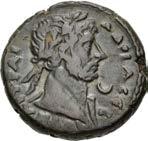

395. EGYPT, Alexandria. Hadrian. AD 117-138. BI Tetradrachm (24mm, 12.39 g, 12h). Dated RY 4 (AD 119/20). Laureate bust right, slight drapery on left shoulder; to right, crescent / Harpocrates standing facing, head left, wearing hem-hem crown, raising finger to mouth and holding cornucopia; L Δ (date) across field. Köln 786 var. (no crescent); Dattari (Savio) 1376; K&G 32.113; RPC III 5220; Emmett 850.4 (R4). Deeply toned. VF. Extremely rare, three known to RPC. ($500)
From the Dr. Thomas E. Beniak Collection, purchased from Athena Numismatics, 23 January 2015.

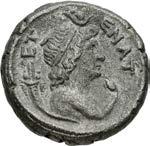
396. EGYPT, Alexandria. Hadrian. AD 117-138. BI Tetradrachm (24mm, 13.43 g, 12h). Dated RY 9 (AD 124/5). Laureate, draped, and cuirassed bust right, seen from behind / Bust of Harpocrates right, wearing tainia and hem-hem crown, raising finger to mouth; at right shoulder, cornucopia; ЄΤ ЄΝΑΤ (date) around. Köln –; Dattari (Savio) 1374; K&G 32.297; RPC III 5499; Emmett 849.9 (R5). Lightly toned, minor roughness. VF. Extremely rare, five known to RPC. ($500)
From the Dr. Thomas E. Beniak Collection, purchased from Nilus Coins, 14 February 2012.


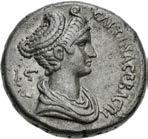
397. EGYPT, Alexandria. Hadrian, with Sabina. AD 117-138. BI Tetradrachm (24mm, 13.31 g, 11h). Dated RY 16 (AD 131/2). Laureate, draped, and cuirassed bust of Hadrian right, seen from behind / CABЄINA CЄBACTH, draped bust of Sabina right, wearing stephane; hair on top of head woven with pearls; L Iς (date) to left. Köln 1040; Dattari (Savio) 1250; K&G 32.515; RPC III 5787; Emmett 886.16. Toned with golden iridescence, scattered light marks. VF. Popular dual portrait type. ($500)
From the Dr. Thomas E. Beniak Collection. Ex Harvey J. Hoffer Collection of coins of Hadrian (Harmer Rooke, 12 December 1986), lot 984.


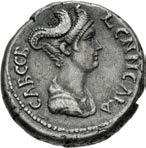
398. EGYPT, Alexandria. Hadrian, with Sabina. AD 117-138. BI Tetradrachm (24mm, 12.55 g, 12h). Dated RY 19 (AD 134/5). Laureate head of Hadrian left / Draped bust of Sabina right, wearing stephane; hair on top of head woven with pearls; CAB CЄB L ЄNNЄAK Δ (date) around. Köln 1149; Dattari (Savio) 1256; K&G 32.622; RPC III 5942; Emmett 886.19 (R3). Toned, minor porosity, scratches, slight doubling on obverse. VF. Rare and popular dual portrait type. ($500)
From the Dr. Thomas E. Beniak Collection, purchased from Holyland Numismatics, 23 April 2010.

399
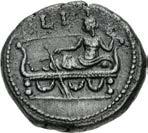

400
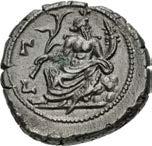
399. EGYPT, Alexandria. Faustina Junior. Augusta, AD 147-175. BI Tetradrachm (22.5mm, 11.33 g, 1h). Dated RY 10 of Marcus Aurelius (AD 169/70). Draped bust right / Tyche reclining left on garlanded lectisternium, holding rudder with her right hand, supporting head with left propped on pillow; L I (date) above. Köln 2119; Dattari (Savio) 3615; K&G 38.34; RPC IV.4 3159; Emmett 2286.10 (R4). Toned, reverse porosity. VF. Rare and finer than any illustrated in RPC. ($500)
From the Dr. Thomas E. Beniak Collection, purchased from Holyland Numismatics, 8 January 2010.
400. EGYPT, Alexandria. Lucius Verus. AD 161-169. BI Tetradrachm (24.5mm, 13.23 g, 12h). Dated RY 3 (AD 162/3). Laureate, draped, and cuirassed bust right, seen from behind / Nilus seated left, holding reed and cornucopia, crocodile climbing rocks below; L Γ (date) to left. Köln –; Dattari (Savio) 9412; K&G –; RPC IV.4 2408; Emmett 2352.6 (RY 3 unrecorded). Toned, patch of green on reverse, short flan crack. Near EF. Extremely rare. ($750)
From the Dr. Thomas E. Beniak Collection, purchased from Nilus Coins, 4 April 1997. Ex Classical Numismatic Auctions X (21 March 1990), lot 394.



401. EGYPT, Alexandria. Lucius Verus. AD 161-169. BI Tetradrachm (23mm, 12.46 g, 12h). Dated RY 5 (AD 164/5). Laureate head right / APMЄ NIA, trophy consisting of a cuirass, helmet, shields and spears; below, Armenian captive, seated right, wearing Phrygian cap, hands bound behind his back, looking left; L Є (date) in field. Köln 2163 var. (bust); Dattari (Savio) 9434; K&G 39.110 var. (same); RPC IV.4 Online 2738; Emmett 2362.5. Toned, light porosity. VF. Very rare variety. ($500)
From the Dr. Thomas E. Beniak Collection, purchased from Tom Cederlind, 14 July 2005.
Although Lucius Verus was not primarily known as a military emperor, preferring the political theater of Rome, Verus was dispatched to deal with the Parthian invasion in the east while his brother was ill in Rome. He began his advance east in AD 161. He spent the majority of the war as an administrative leader from Antioch, delegating command of his army to his generals. Finally, in AD 164, having never seen battle and under pressure from the Senate and his generals, Verus recovered Armenia and captured the Parthian capital of Ctesiphon. Although defeated, Vologases IV would not cede western Mesopotamia to Rome for another two years. The trophy and legend on the reverse of this coin commemorate the capture of the Parthian capital.


402. EGYPT, Alexandria. Septimius Severus. AD 193-211. BI Tetradrachm (23mm, 12.91 g, 12h). Dated RY 2 (AD 193/4). Laureate head right / Zeus enthroned left, holding thunderbolt and long scepter; L B (date) across field. Köln 2268 var. (throne without back); Dattari 9707; K&G 49.6 var. (same); Emmett 2694.2. Dark brown patina, some edge roughness. Near VF. ($500)
From the Dr. Thomas E. Beniak Collection, purchased from Nilus Coins, 25 May 2005.
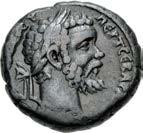
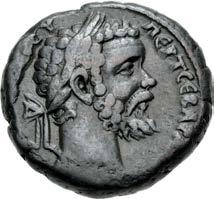

403. EGYPT, Alexandria. Septimius Severus. AD 193-211. BI Tetradrachm (23mm, 12.30 g, 12h). Dated RY 4 (195/6). Laureate head right / Eagle standing right on thunderbolt, head left, holding wreath in beak; L Δ (date) across field. Köln 2270; Dattari (Savio) 4004; K&G 49.10; Emmett 2666.4. Dark gray-brown surfaces. VF. ($500)
From the Dr. Thomas E. Beniak Collection. Ex Hermanubis Collection (Classical Numismatic Group Electronic Auction 359, 9 September 2015), lot 214 (hammer $1,300).
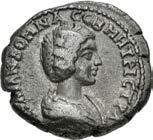
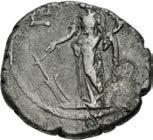
404. EGYPT, Alexandria. Julia Domna. Augusta, AD 193-217. BI Tetradrachm (25mm, 11.59 g, 12h). Dated RY 3 of Septimius Severus (AD 194/5). Draped bust right / Tyche standing facing, head left, holding rudder and cornucopia. Köln –; Dattari –; K&G –; Emmett 2741.3 (R5). Toned, porosity, off center on reverse. Near VF. Extremely rare, possibly unique. ($750)
From the Dr. Thomas E. Beniak Collection. Ex Classical Numismatic Group XXXI (9 September 1994), lot 1399.

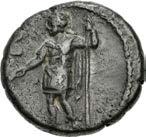
405. EGYPT, Alexandria. Caracalla. As Caesar, AD 196-198. BI Tetradrachm (23.5mm, 12.89 g, 12h). Dated RY 6 of Septimius Severus (AD 197/8). M AYP ANTωNINO KAICAΠ ΩΛA sic, laureate, draped, and cuirassed bust right, seen from behind / Caracalla standing left, holding patera and scepter; L ς(?)(date) to left. Unpublished. Toned, porous, scratches. VF. Extremely rare and unpublished. ($1500)
From the Dr. Thomas E. Beniak Collection. Ex Phil Peck (Morris) Collection (Heritage 271933, 18 August 2019), lot 35067, purchased from NASCA, 1968.



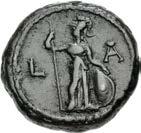
406. EGYPT, Alexandria. Severus Alexander. AD 222-235. Potin Tetradrachm (23mm, 9.87 g, 12h). Dated RY 7 (AD 227/8). Laureate and cuirassed bust right, seen from the front / Conjoined busts of Nilus, wearing grain ear wreath and with cornucopia on shoulder, and Euthenia, draped and wearing grain ear wreath, right; L Z (date) to lower right. Köln 2445; Dattari (Savio) 9937; K&G 62.93; RPC VI Online 10369; Emmett 3128.7. Brown patina, porosity. VF. ($500)
From the Dr. Thomas E. Beniak Collection, purchased from Tom Cederlind, 26 April 2012.
407. EGYPT, Alexandria. Gordian I. AD 238. Potin Tetradrachm (23mm, 13.57 g, 12h). Dated RY 1 (AD 238). Laureate, draped, and cuirassed bust right, seen from the front / Athena standing facing, head left, holding spear, hand on grounded shield; L A (date) across field. Köln 2599 var. (obv. legend); Dattari (Savio) 4654-5; K&G 68.3; RPC VII.2 3632; Emmett 3340.1. Brown patina, traces of die rust. VF. ($750)
From the Dr. Thomas E. Beniak Collection, purchased from Nilus Coins, 13 November 2009.


408. EGYPT, Alexandria. Gordian I. AD 238. Potin Tetradrachm (24mm, 12.05 g, 11h). Dated RY 1 (AD 238). Laureate, draped, and cuirassed bust right, seen from the front / Nilus reclining on hippopotamus left, holding cornucopia and reed; L A (date) to left. Köln 2603; Dattari (Savio) 4660 var. obv. legend); K&G 68.12; RPC VII.2 3637; Emmett 3347.1. Red-brown patina. Good VF. Exceptional for the type. ($750)
From the Dr. Thomas E. Beniak Collection, purchased from Nilus Coins, 20 March 2004.



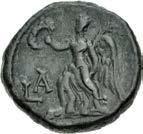
409. EGYPT, Alexandria. Balbinus. AD 238. Potin Tetradrachm (22mm, 13.67 g, 11h). Dated RY 1 (AD 238). Laureate, draped, and cuirassed bust right, seen from the front / Homonoia standing facing, head left, raising hand and holding double cornucopia; L A (date) to lower left. Köln 2611 var. (obv. legend); Dattari (Savio) 10171; K&G 70.7 var. (same); RPC VII.2 3673; Emmett 3374.1 (R4). Dark brown patina, roughness on reverse. VF. Very rare. An interesting correction to a die engraver’s error, with the A recut over a Δ. ($500)
From the Dr. Thomas E. Beniak Collection, purchased from Praefectus Coins, 18 February 2020.
410. EGYPT, Alexandria. Pupienus. AD 238. Potin Tetradrachm (23mm, 12.72 g, 12h). Dated RY 1 (AD 238). Laureate, draped, and cuirassed bust right, seen from behind / Nike advancing left, holding wreath and palm frond over shoulder; L A (date) to lower left. Köln 2607; Dattari (Savio) 10162-3; K&G 71.5; RPC VII.2 3658; Emmett 3365.1. Dark brown patina, slight roughness, traces of verdigris. VF. ($500)
From the Dr. Thomas E. Beniak Collection, purchased from Frank Kovacs. Ex Henry Clay Lindgren Collection.
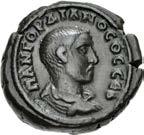

411. EGYPT, Alexandria. Gordian III. As Caesar, AD 238. Potin Tetradrachm (23mm, 12.63 g, 11h). Dated RY 1 (AD 238). Bareheaded, draped, and cuirassed bust right, seen from behind / Athena Nikephorus seated left, holding spear; shield at side of throne, L A (date) to left. Köln –; Dattari 10190-1; K&G 72.5; RPC VII.2 3685.2 (this coin); Emmett 3381.1 (R4). Brown patina. Good VF. Extremely rare, only four known to RPC, this being the finest illustrated. ($500)
From the Dr. Thomas E. Beniak Collection. Ex Classical Numismatic Group Electronic Auction 409 (8 November 2017), lot 473; Classical Numismatic Auctions VI (1 March 1989), lot 322; Empire Coins 8 (7 December 1987), lot 678; Duke of Argyll Collection.



412. EGYPT, Alexandria. Aemilian. AD 253. Potin Tetradrachm (23mm, 9.42 g, 12h). Dated RY 2 (AD 253). Laureate and cuirassed bust right, seen from the front / Eagle standing right with wings displayed, wreath in beak; behind, transverse palm frond; L B (date) to right. Köln –; Dattari (Savio) 5139-40; K&G 85.1; RPC IX 2329; Emmett 3696.2. Dark brown patina, some silvering remains. VF. ($500)
From the Dr. Thomas E. Beniak Collection, purchased from Harlan J. Berk, 7 October 1997.

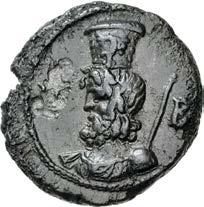

413. EGYPT, Alexandria. Aemilian. AD 253. Potin Tetradrachm (22mm, 10.18 g, 11h). Dated RY 2 (AD 253). Laureate and cuirassed bust right, seen from the front / Draped bust of Serapis, wearing ornate calathus, left; scepter over left shoulder; L B (date) across field. Köln –; RPC IX 2332.4 = Dattari (Savio) 10514 (this coin); K&G 85.7; Emmett 3700.2 (R5). Brown patina, edge split, corrosion on reverse. VF. Very rare, only five known to RPC. ($750)
From the Dr. Thomas E. Beniak Collection, purchased from Pegasi Numismatics, 29 April 1995. Ex Numismatic Fine Arts IX (10 December 1980), lot 605; Giovanni Dattari Collection.
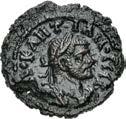

414. EGYPT, Alexandria. Diocletian. AD 284-305. Potin Tetradrachm (20.5mm, 6.64 g, 12h). Dated RY 11 (AD 294/5). Laureate and cuirassed bust right, seen from the front / Head of Zeus Ammon right, wearing ram’s horn; L IA (date) across field. Köln –; Dattari (Savio) 10683; K&G –; RPC X Online 86279; Emmett –. Dark brown patina, minor marks, metal flaw on obverse. Good VF. Extremely rare, only two known to RPC. ($1000)
From the Dr. Thomas E. Beniak Collection.


415. EGYPT, Alexandria. Maximianus. First reign, AD 286-305. Potin Tetradrachm (19mm, 6.97 g, 12h). Dated RY 10 (AD 294/5). Laureate, draped, and cuirassed bust right, seen from behind / Cuirassed bust of Maximianus left, wearing Corinthian helmet, shield and spear; L I (date) across field. Köln 3339; Dattari (Savio) 10695; K&G 120.105; RPC X Online 76750; Emmett 4146.10 (R5). Red-brown patina, traces of verdigris. Near EF. Extremely rare. ($500)
From the Dr. Thomas E. Beniak Collection, purchased from Barry Murphy, 5 January 2012.
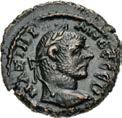

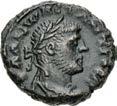
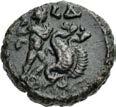
416. EGYPT, Alexandria. Maximianus. First reign, AD 286-305. Potin Tetradrachm (20mm, 7.12 g, 11h). Dated RY 11 (AD 295/6). Laureate head right / Draped bust of Serapis right, wearing ornate calathus; to right, palm; L I A (date) across field. Köln 3310; Dattari (Savio) 10743 var. (date arrangement); K&G –; RPC X Online 76321; Emmett 4151.11 (R3). Dark brown patina. VF. Very rare. ($500)
From the Dr. Thomas E. Beniak Collection, purchased from Holyland Numismatics, 24 April 2008.
417. EGYPT, Alexandria. Constantius I. As Caesar, AD 293-305. Potin Tetradrachm (19mm, 7.51 g, 12h). Dated RY 4 (AD 295/6). Laureate, draped, and cuirassed bust right, seen from behind / Triptolemus driving biga of winged serpents right; L Δ (date) above. Köln –; Dattari (Savio) 10772; K&G –; RPC X Online 76373; Emmett 4199.4 (R5). Dark brown patina. Good VF. Very rare, only five known to RPC. ($500)
From the Dr. Thomas E. Beniak Collection, purchased from Holyland Numismatics, 24 April 2008.

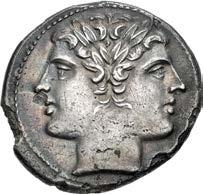

418. Anonymous. Circa 225-212 BC. AR Didrachm – Quadrigatus (22mm, 6.50 g, 8h). Rome mint. Laureate head of Janus, no annulets at top of head, curved truncation / Jupiter, hurling thunderbolt and holding scepter, in galloping quadriga driven right by Victory; rOÂa incuse on raised tablet in exergue. Crawford 28/3; Sydenham 64; HN Italy 334; RSC 23; RBW 64. Cabinet toning with iridescence, scratches, edge chip. Good VF. ($500)
From the 1930’s Collection of Robert W. Hubel of Michigan.



419. Anonymous. Circa 225-212 BC. AR Didrachm – Quadrigatus (23mm, 6.57 g, 9h). Rome mint. Laureate head of Janus, two small annulets at top of head, curved truncation / Jupiter, hurling thunderbolt and holding scepter, in galloping quadriga driven right by Victory; rOÂa incuse on raised tablet in exergue. Crawford 28/3; Sydenham 64; HN Italy 334; RSC 23; RBW 65–6. Toned with find patina, obverse scrapes, flan crack. Good VF. ($750)
From the 1930’s Collection of Robert W. Hubel of Michigan. Ex Cahn 71 (14 October 1931), lot 1220.



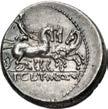
420. M. Aburius M.f. Geminus. 132 BC. AR Denarius (19mm, 3.87 g, 8h). Rome mint. Helmeted head of Roma right; • (mark of value) below chin / Sol, holding reins and whip, driving quadriga right. Crawford 250/1; Sydenham 487; Aburia 6; RBW 1027. Toned with hints of iridescence, light marks, trace deposits. Good VF. ($300)
From the 1930’s Collection of Robert W. Hubel of Michigan, purchased from John G. Watson, April 1929.
421. Appius Claudius Pulcher, T. Manlius Mancius, and Q. Urbinius. 111-110 BC. AR Denarius (18mm, 3.89 g, 11h). Rome mint. Helmeted head of Roma right; quadrangular device to left / Victory, holding reins, driving triga right. Crawford 299/1a; Sydenham 570; Claudia 2; RBW 1141. Old cabinet toning with iridescence, patches of find patina. Near EF. ($300)
From the 1930’s Collection of Robert W. Hubel of Michigan.

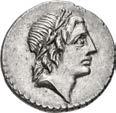
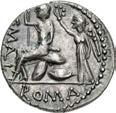

422. C. Malleolus, A. Albinus Sp.f., and L. Caecilius Metellus. 96 BC. AR Denarius (19mm, 4.03 g, 12h). Rome mint. Laureate head of Apollo right / Roma seated left on pile of shields, holding spear and parazonium, being crowned by Victory to right, standing left. Crawford 335/2; Sydenham 614; Poblicia 4; RBW 1202. Lightly toned with iridescence, minor marks. Good VF. Struck on a broad flan. Rare. ($500)
From the 1930’s Collection of Robert W. Hubel of Michigan.



423. D. Silanus L.f. 91 BC. AR Denarius (18mm, 3.95 g, 3h). Rome mint. Diademed head of Salus right; p below chin; all within torque / Victory, holding whip, palm frond, and reins, driving galloping biga right; grasshopper below. Crawford 337/2f; Sydenham 645c; Junia 17; RBW –. Light iridescence, trace porosity. Near EF. ($300)
From the 1930’s Collection of Robert W. Hubel of Michigan.



424. L. Calpurnius Piso Frugi. 90 BC. AR Denarius (18mm, 3.97 g, 11h). Rome mint. Laureate head of Apollo right; star behind, p below chin / Horseman, holding palm frond and reins, galloping right; Í/• in upper field. Crawford 340/1; Sydenham 665g; Calpurnia 11; RBW 1260 var. (controls). Toned with blue iridescence, slight porosity, minor marks, small scrape on obverse. Near EF. ($300)
From the 1930’s Collection of Robert W. Hubel of Michigan, purchased from Michele Baranowsky, April 1937.

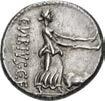
425. C. Vibius C.f. Pansa. 90 BC. AR Denarius (16.5mm, 3.95 g, 4h). Rome mint. Laureate head of Apollo right; flower below chin / Ceres advancing right, holding torch in each hand; to lower right, pig advancing right. Crawford 342/3b; Sydenham 683a; Vibia 6; RBW 1283 var. (control). Toned, light porosity, scrape on obverse. Near EF. ($300)
From the 1930’s Collection of Robert W. Hubel of Michigan.
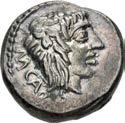


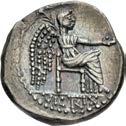
426. M. Cato. 89 BC. AR Quinarius (13.5mm, 2.02 g, 9h). Rome mint. Wreathed head of Liber right; Â below / Victory seated right, holding palm frond and patera. Crawford 343/2b; Sydenham 597; King 46; Porcia 7a; RBW 1298 var. (control). Iridescent toning. EF. Among the finest known. ($500)
From the 1930’s Collection of Robert W. Hubel of Michigan.


427. C. Annius T.f. T.n and L. Fabius L.f. Hispaniensis. 82-81 BC. AR Denarius (18mm, 3.72 g, 6h). Mint in northern Italy or Spain. Draped bust of Anna Perenna right, wearing stephane; winged caduceus to left, scales to right, vexillum below neck / Victory, holding palm frond and reins, driving galloping quadriga right; œ • above. Crawford 366/1a; Sydenham 748; Annia 2a; RBW 1375 var. (control). Cabinet toning with light iridescence, scrape on obverse, minor marks. Good VF. ($300)
From the 1930’s Collection of Robert W. Hubel of Michigan, purchased from John G. Watson, April 1929.




428. C. Servilius Vatia. Restored issue, 82-80 BC. AR Denarius (18.5mm, 3.92 g, 3h). Rome mint. Laureate head of Apollo right; to left, B above lituus; mark of value below chin / Warrior (M. Servilius Pulex Geminus) on horseback galloping left, holding shield inscribed  (Marcus), and piercing with spear another warrior to left, holding shield and sword, on horseback galloping left. Crawford 370/1b; Sydenham 720; Servilia 7; RBW 1390. Lightly toned, minor marks, small edge chip. Good VF. ($300)
From the 1930’s Collection of Robert W. Hubel of Michigan.
The reverse type celebrates M. Servilius Pulex Geminus, who was elected augur in 211 BC and held that office for about forty years. He was made consul in 202 BC. According to Plutarch, he received numerous wounds in twenty-three single combats, being victorious in all (Plutarch, Paulus Aemilius, xxxi).
429. C. Marius C.f. Capito. 81 BC. AR Serrate Denarius (18mm, 3.94 g, 10h). Rome mint. Draped bust of Ceres right, wearing wreath of grain ears; uiiii at end of legend / Husbandman with yoke of oxen plowing left; uiiii above. Crawford 378/1a; Sydenham 744; Maria 7; RBW 1401 var. (controls). Cabinet toning with iridescence, flan flaw on reverse. Near EF. ($300)
From the 1930’s Collection of Robert W. Hubel of Michigan.



430. P. Galba. 69 BC. AR Denarius (18mm, 4.16 g, 6h). Rome mint. Veiled and draped bust of Vesta right / Emblems of the pontificate: secespita, simpulum, and securis. Crawford 406/1; Sydenham 839; Sulpicia 7; RBW 1454. Iridescent cabinet toning, small scrapes and scratches. Good VF. Attractive in hand. ($300)
From the 1930’s Collection of Robert W. Hubel of Michigan.
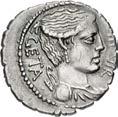

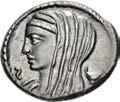

431. C. Hosidius C.f. Geta. 64 BC. AR Serrate Denarius (19.5mm, 3.86 g, 5h). Rome mint. Draped bust of Diana right, bow and quiver over shoulder / Calydonian boar standing right, pierced by spear and attacked by dog. Crawford 407/1; Sydenham 904; Hosidia 2; RBW 1455. Lightly toned with iridescence, slightly off center, banker’s mark. Near EF. ($300)
From the 1930’s Collection of Robert W. Hubel of Michigan, purchased from Michele Baranowsky, April 1937.
432. L. Cassius Longinus. 60 BC. AR Denarius (20mm, 3.95 g, 6h). Rome mint. Veiled and draped bust of Vesta left; S to left, cylix to right / Voter standing left, dropping tablet inscribed u (Uti rogas) into cista to left. Crawford 413/1; Sydenham 935; Cassia 10; RBW 1493 var. (control). Toned with iridescence, scratches, reverse die break. Near EF. ($400)
From the 1930’s Collection of Robert W. Hubel of Michigan, purchased from John G. Watson, April 1929.
Lucius Cassius Longinus was the brother of Gaius Cassius Longinus, later famous as one of Julius Caesar’s principal assassins. He was elected as one of the tresviri monetales for 60 BC; the types he chose allude to one of the family’s illustrious ancestors, L. Cassius Ravilla, Consul in 127 BC, who proposed a new method of jury voting by secret ballot. Known as the Lex Cassia Tabellaria, it provided that in most court cases tried by jury, jurors could mark their verdict on a small tablet and drop it into a basket to be counted by a court official. The practice was also extended to voting on laws in the people’s assemblies, the Comitia Tributa and the Concilium Plebis. This reverse type commemorates that proposal becoming law. The V on the tablet stands for VTI ROGAS, “I approve” of the proposed law.
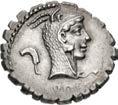


433. L. Roscius Fabatus. 59 BC. AR Serrate Denarius (19mm, 3.99 g, 6h). Rome mint. Head of Juno Sospita right, wearing goat skin headdress; sickle to left / Female standing right, feeding serpent to right; sheaf of grain to left. Crawford 412/1 (symbol 162); Sydenham 915; Roscia 3; RBW –. Toned with iridescence, small lamination on reverse. Near EF. Rare symbol pair, only two in CoinArchives. ($300)
From the 1930’s Collection of Robert W. Hubel of Michigan.




434. M. Aemilius Lepidus. 58 BC. AR Denarius (18mm, 4.04 g, 5h). Rome mint. Head of Alexandria right, wearing mural crown / M. Lepidus standing left, crowning the young Ptolemy V, who stands facing, holding staff. Crawford 419/2; Sydenham 831; Aemilia 23; RBW 1511. Toned with traces of find patina, slightly off center, banker’s mark on reverse. Good VF. Elegant portrait. Rare. ($750)
From the 1930’s Collection of Robert W. Hubel of Michigan. Ex Cahn 75 (30 May 1932), lot 521.
435. M. Aemilius Scaurus and Pub. Plautius Hypsaeus. 58 BC. AR Denarius (16mm, 3.85 g, 2h). Rome mint. Nabatean king Aretas kneeling to right, holding reins and olive branch before camel standing right / Jupiter driving quadriga left, holding reins and hurling thunderbolt. Crawford 422/1a; Sydenham 912; Aemilia 9; RBW –. Deep cabinet toning with iridescence. Good VF. ($300)
From the 1930’s Collection of Robert W. Hubel of Michigan.


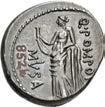
436. Q. Pomponius Musa. 56 BC. AR Denarius (17mm, 3.99 g, 5h). Rome mint. Laureate head of Apollo right; volumen to left / Clio, the Muse of History, standing left, holding and reading from an open scroll, resting left elbow on draped column. Crawford 410/3; Sydenham 813; Pomponia 11; RBW 1485. Toned with light iridescence, off center on obverse, collector’s inventory number 852b in ink in field on reverse. Good VF. ($750)
From the 1930’s Collection of Robert W. Hubel of Michigan.

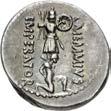


437. C. Memmius C.f. 56 BC. AR Denarius (19.mm, 3.89 g, 5h). Rome mint. Wreathed head of Ceres right / Naked captive, his hands tied behind, kneeling right at foot of trophy of arms with a Greek shield. Crawford 427/1; Sydenham 920; Memmia 10; RBW 1531. Iridescent cabinet toning. Near EF. Very attractive in hand. ($300)
From the 1930’s Collection of Robert W. Hubel of Michigan.
438. Q. Cassius Longinus. 55 BC. AR Denarius (19mm, 4.30 g, 8h). Rome mint. Veiled head of Vesta right / Curule chair within Temple of Vesta; urn to left, voting tablet inscribed AC (Absolvo Condemno) to right. Crawford 428/1; Sydenham 917; Cassia 9; RBW 1533. Toned with light iridescence, small test cut, collector’s inventory number 81 in ink in field on reverse. Near EF. ($300)
From the 1930’s Collection of Robert W. Hubel of Michigan, purchased from John G. Watson, April 1929.


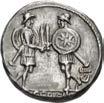
439. C. Servilius C.f. 53 BC. AR Denarius (17mm, 3.58 g, 7h). Rome mint. Head of Flora right, wearing wreath of flowers; lituus to left / Two warriors facing each other, each holding shield and upright sword. Crawford 423/1; Sydenham 890; Servilia 15; RBW 1521. Toned, minor marks, small red deposit on obverse. Good VF. ($300)
From the 1930’s Collection of Robert W. Hubel of Michigan.

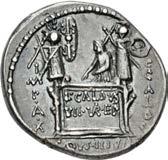

440. C. Coelius Caldus. 53 BC. AR Denarius (18mm, 3.98 g, 3h). Rome mint. Bare head of C. Coelius Caldus right; to left, signum inscribed hiÍ; below chin, boar atop signum / Veiled figure seated left on inscribed lectisternium; trophies flanking. Crawford 437/2b; Sydenham 895; Coelia 9; RBW –. Old cabinet tone with blue iridescence. Good VF. A beautiful coin in hand. Rare. ($500)
From the 1930’s Collection of Robert W. Hubel of Michigan. Ex Dr. Karl Hahn Collection (Cahn 61, 3 December 1928), lot 337.
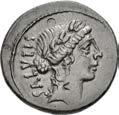
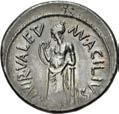


441. Moneyer issues of Imperatorial Rome. Man. Acilius Glabrio. 49 BC. AR Denarius (19.5mm, 3.92 g, 12h). Rome mint. Laureate head of Salus right / Valetudo (Salus) standing left, holding serpent and resting arm on column to right. Crawford 442/1a; CRI 16; Sydenham 922; Acilia 8; RBW 1556. Deep cabinet toning with bright iridescence and luster on reverse, bankers’ marks on obverse. Good VF. ($300)
From the 1930’s Collection of Robert W. Hubel of Michigan, purchased from John G. Watson, April 1929.
The Acilia house claimed to have introduced the first Greek physicians to the city of Rome; thus, the deities Salus, Asclepius, and Valetudo are a common theme on the coins of the Acilia gens. 442. Moneyer issues of Imperatorial Rome. C. Clodius C.f. Vestalis. 43 BC. AR Denarius (20mm, 3.83 g, 9h). Rome mint. Draped bust of Flora right, wearing wreath of flowers; lily to left / Vestal virgin seated left, holding cymbium (two-handled bowl). Crawford 512/2; CRI 317; Sydenham 1135; Claudia 13; RBW 1790. Iridescent toning, reverse struck off center with peripheral weakness, banker’s mark, collector’s inventory number 389 in ink in field on reverse. Good VF. ($300)
From the 1930’s Collection of Robert W. Hubel of Michigan. Ex Helbing 63 (29 April 1931), lot 97 (collector’s ink added since).
David Sear (CRI p. 194) writes: “The reverse type of a seated Vestal, one of the six sacerdotes Vestales (the sole female priesthood in Rome), may represent nothing more than a punning allusion to the moneyer’s cognomen. Grueber and Crawford, however, both attempt more precise identifications, the former describing her as Claudia Quinta, the Vestal Virgin who was instrumental in bringing the image of Cybele (Magna Mater) from Asia Minor to Rome in 204 BC, the latter preferring Claudia, daughter of Appius Claudius Pulcher (consul 143 BC), another noted Vestal, who protected her father against an intercessio (veto) following his unauthorized triumph. The obverse type depicting Flora, the Italian goddess of flowering or blossoming plants, probably relates to the foundation of the festival of the Floralia during the consulship in 240 BC of an ancestor of the moneyer, C. Claudius Centho.”



443. Moneyer issues of Imperatorial Rome. L. Livineius Regulus. 42 BC. AR Denarius (17mm, 3.87 g, 1h). Rome mint. Bare head right / Venatio scene: in foreground, lion charging right toward a bestiarius who spears it; in background on left, a wounded bear sits right; on right, another bestiarius, holding sword and shield, defends himself against a tiger charging left. Crawford 494/30; CRI 179; Sydenham 1112; Livineia 12; RBW 1735. Toned, minor marks, off center, collector’s inventory number 662 in ink in field on obverse, die flaws on reverse. Good VF. ($500)
From the 1930’s Collection of Robert W. Hubel of Michigan.
This popular type depicts a venatio, a contest between bestiarii and various animals. Such activities served as the morning entertainment during a day at the games, with the “main event” – the gladiatorial contests – taking place in the afternoon.

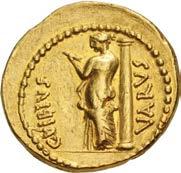
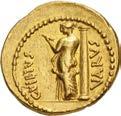
444. Moneyer issues of Imperatorial Rome. C. Vibius Varus. 42 BC. AV Aureus (19.5mm, 8.02 g, 7h). Rome mint. Laureate head of Apollo right / Venus, half nude and seen from behind, standing left beside a column, looking at herself in mirror. Crawford 494/34; CRI 190; Sydenham 1137; Bahrfeldt 36; Calicó 33; RBW 1738. Light scratches, edge marks from prior mount, small die flaw on reverse. VF. ($3000)
From the 1930’s Collection of Robert W. Hubel of Michigan.
David Sear relates both the head of Apollo on the obverse and the Venus on the reverse to the gens Iulia. The aureus thus commemorates the murdered Caesar, which is certainly related to the struggle of the triumvirs against the assassins of Caesar. The extraordinarily extensive coinage in 42 served to finance this struggle and was made possible by proscriptions and tax collections.




445. Moneyer issues of Imperatorial Rome. P. Accoleius Lariscolus. 41 BC. AR Denarius (17.5mm, 4.09 g, 11h). Rome mint. Draped bust of Diana Nemorensis right / Triple cult statue of Diana Nemorensis facing, supporting on their hands and shoulders a beam, above which are five cypress trees; the figure on left holding poppy, that on right holding lily. Crawford 486/1; CRI 172; Sydenham 1148; Accoleia 1; RBW 1701–2. Toned with light iridescence, minor marks, test cut. Good VF. ($300)
From the 1930’s Collection of Robert W. Hubel of Michigan, purchased from John G. Watson, April 1929.
Diana Nemorensis, the triform goddess representing the goddess of the hunt, the moon, and the nether world, has her origins in the Etruscan pantheon. Her temple was situated on the northern shore of Lake Nemi, where, as early as the 6th century BC, the Nemoralia, a three-day festival devoted to her, took place on the ides of August every year. These celebrations eventually transformed into the festivities at the Temple of Diana on the Aventine Hill in Rome.
446. Moneyer issues of Imperatorial Rome. P. Accoleius Lariscolus. 41 BC. AR Denarius (18mm, 4.04 g, 9h). Rome mint. Draped bust of Diana Nemorensis right / Triple cult statue of Diana Nemorensis facing, supporting on their hands and shoulders a beam, above which are five cypress trees; the figure on left holding poppy, that on right holding lily. Crawford 486/1; CRI 172; Sydenham 1148; Accoleia 1; RBW 1701–2. Toned, reverse die clash. Good VF. ($300)
From the 1930’s Collection of Robert W. Hubel of Michigan, purchased from John G. Watson, April 1929.


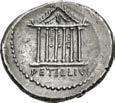
447. Moneyer issues of Imperatorial Rome. Petillius Capitolinus. 41 BC. AR Denarius (18mm, 3.98 g, 2h). Rome mint. Bare head of bearded Jupiter right / The Temple of Jupiter Capitolinus: richly decorated hexastyle façade with ornamented pediment and garlands hanging within three openings. Crawford 487/1; CRI 173; Sydenham 1149; Petillia 1; RBW 1703. Light iridescent toning, minor marks, collector’s inventory number 799 in ink in field on obverse. Good VF. ($500)
From the 1930’s Collection of Robert W. Hubel of Michigan. Ex Baranowsky (25 February 1931), lot 1089.
Petillius Capitolinus was one of the last moneyers to strike an independent senatorial coinage prior to the Triumvirs seizing control of the minting process in 41 BC. The types he chose – a majestic portrait of Jupiter on the obverse, and the façade of the Temple of Jupiter Capitolinus on the reverse – are doubtless a play on his name. It is possible, though not certain, that he was the same Petillius Capitolinus who was later accused of peculation and acquitted. Horace mentions him in his Satires; a later Roman commentator embellished the tale, claiming that Capitolinus was custodian of the Capitoline temple, and was accused of stealing the golden crown from the statue of Jupiter. His acquittal was supposedly due to his close friendship with Augustus.
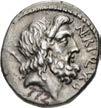



448. The Pompeians. Cn. Nerius. Spring 49 BC. AR Denarius (16.5mm, 3.99 g, 1h). Rome mint. Head of Saturn right; harpa to left / Aquila right between two signa inscribed h (for Hastati) and p (for Principes), respectively. Crawford 441/1; CRI 2; Sydenham 937; Neria 1; RBW –. Light iridescent toning, slightly off center, collector’s inventory number 772 in ink in field on obverse. Good VF. ($400)
From the 1930’s Collection of Robert W. Hubel of Michigan.
449. The Caesarians. Julius Caesar. April-August 49 BC. AR Denarius (18mm, 3.81 g, 3h). Military mint traveling with Caesar. Elephant advancing right, trampling on horned serpent / Emblems of the pontificate: simpulum, aspergillum, securis, and apex. Crawford 443/1; CRI 9; Sydenham 1006; RSC 49; RBW 1557. Toned with faint porosity. Good VF. Well centered. ($750)
From the 1930’s Collection of Robert W. Hubel of Michigan.

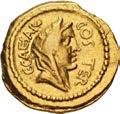


450. The Caesarians. Julius Caesar. Early 46 BC. AV Aureus (19mm, 7.94 g, 12h). Rome mint; A. Hirtius, praetor. Veiled head of female (Vesta or Pietas?) right; C • CAeÍAr COÍ Ter around / Emblems of the augurate and pontificate: lituus, capis, and securis; A • hirTiuÍ • pr around from lower left. Crawford 466/1; Molinari 135-9 (D10/R215); CRI 56; Sydenham 1018; Calicó 37; Biaggi –; RBW 1634. Multiple marks and scratches, obverse die flaw, irregular edge. VF. Well centered. ($4000)
From the 1930’s Collection of Robert W. Hubel of Michigan. Ex Cahn 66 (6 May 1930), lot 547.
Aulus Hirtius, friend and confidant of Julius Caesar, was praetor in 46 BC, and thus charged with the distribution of the first truly large issue of Roman gold coins to date. The aurei were for distribution to the general’s successful troops after their final victory over the Pompeians in Africa at Thapsus. Each legionary received 5000 denarii (200 aurei), centurions twice that. Since Caesar had at least 40,000 legionnaires at Thapsus, the amount of coin needed was immense. But the amount of booty collected from Caesar’s many campaigns was also colossal, and Hirtius seems to have been able to supply the need. Hirtius later finished the dictator’s memoirs after his assassination and was himself killed at the Battle of Mutina in 43 BC.

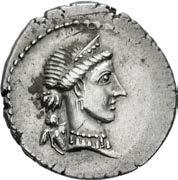

451. The Caesarians. Julius Caesar. Late 46-early 45 BC. AR Denarius (19mm, 4.02 g, 4h). Military mint traveling with Caesar in Spain. Diademed head of Venus right, with Cupid over her shoulder / Trophy of Gallic arms, composed of helmet and cuirass, oval shield and carnyx in each hand; two seated captives at base, the one on left a female in attitude of dejection, the one on right a bearded male with hands bound behind him. Crawford 468/1; CRI 58; Sydenham 1014; RSC 13; RBW 1639. Light porosity, deposits, small scrape on obverse. Good VF. Struck on a broad flan. ($500)
From the 1930’s Collection of Robert W. Hubel of Michigan. Ex Cahn 75 (30 May 1932), lot 762.



452. The Caesarians. Julius Caesar. Late 46-early 45 BC. AV Aureus (20.5mm, 7.95 g, 6h). Rome mint; L. Munatius Plancus, praefectus Urbi. Draped and winged bust of Victory right, hair rolled back and collected into a knot behind; C • CAeÍ upward to left, DiC • Ter downward to right / Guttus (single-handled sacrificial jug); L • pLANC upward to left, prAeF • œB downward to right. Crawford 475/1a; CRI 60; Sydenham 1019; Bahrfeldt 20; Calicó 45; RBW 1663. Minor marks and scratches, metal flaws and softly struck on reverse. Near VF. ($3000)
From the 1930’s Collection of Robert W. Hubel of Michigan. Ex Cahn 75 (30 May 1932), lot 774.
The aurei of L. Munatius Plancus were distributed during Caesar’s triumph of October 45 BC, celebrating his final defeat of the Pompeians at Munda the previous year. This triumph raised some concerns in Rome, as it marked a victory over fellow Romans, an event never before deserving a triumph. Such actions only heightened the fears in some quarters over Caesar’s intentions, fears which lead to his assassination six months later.
Before his murder, Caesar appointed Plancus governor of Transalpine Gaul, where he founded the colony of Lugdunum.




453. The Caesarians. Julius Caesar. February-March 44 BC. AR Denarius (18mm, 2.93 g, 3h). Lifetime issue. Rome mint; P. Sepullius Macer, moneyer. Laureate and veiled head right; CAeÍAr downward to right, DiCT perpeTuO upward to left / Venus Victrix standing left, holding Victory in extended right hand and vertical scepter in left; shield set on ground to right; p • ÍepuLLiuÍ downward to right, ÂACer downward to left. Crawford 480/13; Alföldi Type IX, 1-6 (A23/R9); CRI 107d; Sydenham 1074; RSC 39; RBW 1685. Lightly toned, porosity, minor marks. Near VF. ($750)
From the 1930’s Collection of Robert W. Hubel of Michigan.
454. The Caesarians. Julius Caesar. 40 BC. AR Denarius (17mm, 3.83 g, 1h). Rome mint; Ti. Sempronius Gracchus, quaestor designatus. Laureate head right / Signum, aquila, plow, and decempeda (measuring rod); Í C across field. Crawford 525/3; CRI 327; Sydenham 1128; RSC 48; RBW –. Toned, porosity, small scrapes, bankers’ marks on obverse. Near VF. ($1000)
From the 1930’s Collection of Robert W. Hubel of Michigan. Ex Cahn 75 (30 May 1932), lot 780.




455. The Republicans. Brutus. Spring-early summer 42 BC. AR Quinarius (13mm, 1.80 g, 11h). Military mint traveling with Brutus and Cassius in western Asia Minor or northern Greece. Diademed head of Libertas right / Stem of prow and anchor in saltire. Crawford 506/3; CRI 210; Sydenham 1288; King 79; RSC 5a; RBW 1779. Toned with iridescence, edge marks; porosity, metal flaw, and off center on obverse. VF. ($300)
From the 1930’s Collection of Robert W. Hubel of Michigan. Ex Cahn 75 (30 May 1932), lot 793.



456. The Republicans. Brutus. Spring-early summer 42 BC. AR Denarius (19mm, 3.69 g, 12h). Military mint traveling with Brutus in southwestern Asia Minor; L Sestius, proquaestor. Veiled and draped bust of Libertas right / Tripod; securis to left, simpulum to right. Crawford 502/2; CRI 201; Sydenham 1290; RSC 11; RBW 1768. Toned with iridescence, scrapes and scratches on obverse, edge marks. VF. ($750)
From the 1930’s Collection of Robert W. Hubel of Michigan.



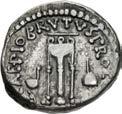
457. The Republicans. Brutus. Spring-early summer 42 BC. AR Quinarius (13.5mm, 1.85 g, 12h). Military mint traveling with Brutus in southwestern Asia Minor; L Sestius, proquaestor. Quaestorial chair, against which rests staff; modius below / Tripod; simpulum to left, apex to right. Crawford 502/4; CRI 203; Sydenham 1292; RSC 13; RBW 1770. Toned, scratches, find patina. VF. ($500)
From the 1930’s Collection of Robert W. Hubel of Michigan.

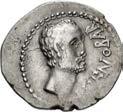


458. The Republicans. Cn. Domitius L.f. Ahenobarbus. 41-40 BC. AR Denarius (20mm, 3.93 g, 8h). Uncertain mint in the region of the Adriatic or Ionian Sea. Bare head of Ahenobarbus right, wearing short beard / Prow right surmounted by a military trophy. Crawford 519/2; CRI 339; Sydenham 1177; Domitia 21; RBW 1803. Toned with light iridescence, some peripheral weakness, slight die shift on obverse. VF. ($750)
From the 1930’s Collection of Robert W. Hubel of Michigan. Ex Baranowsky (25 February 1931), lot 960; Joseph Martini Collection (Part 3, R. Ratto, 24 February 1930), lot 588.




459. The Triumvirs. Mark Antony and Octavian. Spring-early summer 41 BC. AR Denarius (18mm, 3.93 g, 1h). Ephesus mint; M. Barbatius Pollio, quaestor pro praetore. Bare head of Mark Antony right / Bare head of Octavian right, with slight beard. Crawford 517/2; CRI 243; Sydenham 1181; RSC 8a; RBW 1798. Deep cabinet tone. Near EF. Two excellent portraits. ($750)
From the 1930’s Collection of Robert W. Hubel of Michigan.



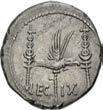
460. The Triumvirs. Mark Antony. Summer 32 BC. AR Denarius (19mm, 3.78 g, 11h). Athens mint. Bare head right; small p (signature) in hair below ear / ANTONiuÍ/Aug • iÂp • iii in two lines. Crawford 542/2; CRI 347; Sydenham 1209; RSC 2; RBW 1831. Toned with light iridescence, scrapes and slight porosity on obverse, striking weakness on reverse. VF. ($300)
From the 1930’s Collection of Robert W. Hubel of Michigan.
The only such instance of an engraver’s signature on a Roman Republican coin, the “P” marking behind Antony’s ear is so well concealed that it was not discovered until 1920.
461. The Triumvirs. Mark Antony. Autumn 32-spring 31 BC. AR Denarius (17mm, 3.47 g, 6h). Legionary type. Patrae(?) mint. Praetorian galley right / Aquila between two signa; Leg ix across lower field. Crawford 544/23; CRI 359; Sydenham 1227; RSC 37; RBW –. Iridescent cabinet toning, scratches. Good VF. ($400)
From the 1930’s Collection of Robert W. Hubel of Michigan.

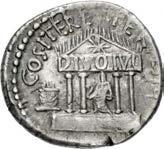

462. The Triumvirs. Octavian. Spring-early summer 36 BC. AR Denarius (18mm, 3.85 g, 5h). Southern or central Italian mint. Bare head right, wearing slight beard / Tetrastyle temple of Divus Julius: statue of Julius Caesar as augur standing within, DiuO iuL on architrave, star within pediment, figures along roof line; lighted altar to left. Crawford 540/2; CRI 315; Sydenham 1338; RSC 90; RBW 1829. Toned with hints of iridescence, minor marks and scratches. VF. ($300)
From the 1930’s Collection of Robert W. Hubel of Michigan.
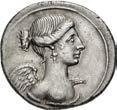


463. The Triumvirs. Octavian. Autumn 31-summer 30 BC. AR Denarius (19mm, 3.94 g, 2h). Uncertain mint in Italy (Rome?). Winged bust of Victory right / Octavian, as Neptune, standing left, foot set on globe, holding apluster and scepter. CRI 409; RIC I 256; RSC 60. Lightly toned, minor porosity, faint graffito, slight striking weakness on reverse. Good VF. ($500)
From the 1930’s Collection of Robert W. Hubel of Michigan. Ex Cahn 75 (30 May 1932), lot 857.
This coin type was part of the large issues of Octavian in celebration of his victory over Antony at Actium. The reverse type on this particular issue is especially notable: first, it is a direct reference to the naval battle itself, and second, it is the first instance of Octavian appearing as a deity, foreshadowing his active encouragement of the notion of his own divinity.


464. Anonymous. Circa 225-217 BC. Æ Aes Grave As (63mm, 284.5 g, 12h). Rome mint. Head of bearded Janus; no mark of value; all on a raised disk / Prow of galley right; i (mark of value) above; all on a raised disk. Crawford 35/1; ICC 75; Sydenham 72; HN Italy 337; RBW 84–5. Attractive dark green patina with touches of red, minor deposits. Good VF. ($3000)
Ex William H. Birkinshaw Collection (Classical Numismatic Group 117, 19 May 2021), lot 433.
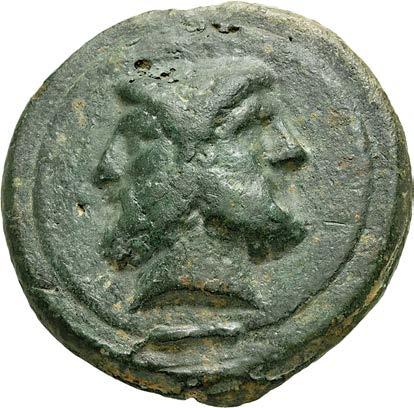
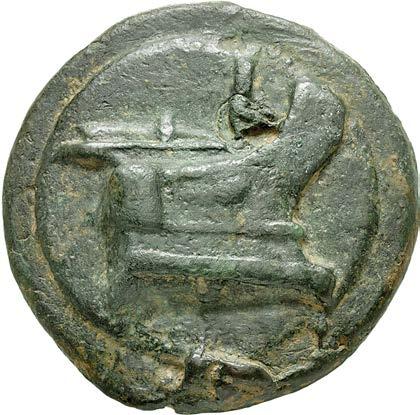
465. Anonymous. Circa 225-217 BC. Æ Aes Grave As (63mm, 254.9 g, 12h). Rome mint. Head of bearded Janus; no mark of value; all on a raised disk / Prow of galley right; i (mark of value) above; all on a raised disk. Crawford 35/1; ICC 75; Sydenham 72; HN Italy 337; RBW 84–5. Green patina, a few minor casting flaws. Near VF. ($1500)
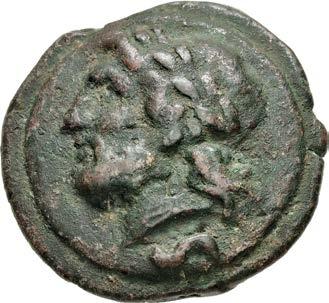
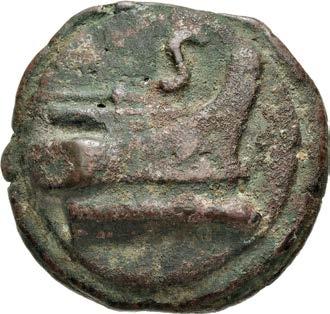
466. Anonymous. Circa 225-217 BC. Æ Aes Grave Semis (51mm, 137.3 g, 12h). Rome mint. Laureate head of Saturn left; Í (mark of value) horizontally below; all on raised disk / Prow of galley right; Í (mark of value) above; all on raised disk. Crawford 35/2; ICC 76; Sydenham 73; HN Italy 338; RBW 86. Green-brown patina, light porosity. VF. ($1000)
Ex CGB (7 September 2021), lot 73; Thierry de Craeker Collection.


467. Anonymous. Circa 225-212 BC. AR Didrachm – Quadrigatus (22mm, 6.85 g, 6h). Rome mint. Laureate head of Janus, no annulets at top of head, curved truncation / Jupiter, hurling thunderbolt and holding scepter, in galloping quadriga driven right by Victory; rOÂa incuse on raised tablet in exergue. Crawford 28/3; Sydenham 64; HN Italy 334; RSC 23; RBW 64. Lightly toned. In NGC encapsulation 6056125-052, graded XF, Strike: 5/5, Surface: 3/5. ($750)




468. Anonymous. 211-208 BC. AV 60 Asses (14mm, 3.36 g, 11h). Rome mint. Helmeted head of Mars right; çc (mark of value) to left / Eagle standing right on thunderbolt, with wings spread. Crawford 44/2; Sydenham 226; Bahrfeldt 4a; Biaggi 3; RBW 160–1. Slight die rust, minor edge marks. EF. ($4000)
Purchased by the consignor from Glenn W. Woods.
The Roman Republic’s earliest large-scale issue of gold coins was part of the massive overhaul of Rome’s coinage system circa 211 BC, at the height of the Second Punic War against Carthage. A whole new system of coinage replaced the old one based on the silver didrachm, or quadrigatus, and clumsy cast Aes Grave. At the top end of the value scale, three gold coin denominations were now issued, all marked with their value in copper asses. All gold coins bore the same design: A helmeted head of Mars on the obverse, and an eagle standing on a thunderbolt on the reverse (the eagle represented Jupiter and was one of the identifying standards carried into battle by the legions). These included a gold 60-as piece, weighing about 3.4 grams, marked with a çc (VI times X); a 40-as piece (XXXX), and a 20-as piece (XX). A comparison of the weights of values of the precious metal denominations indicates the relative ratio of silver to gold at this time was about 12 to one. The gold for this considerable issue likely came from Rome’s capture and sack of Syracuse in 212 BC. Unlike the accompanying silver denarius and bronze denominations that were introduced during this reform, the gold issues were discontinued after a few years, and Rome would not resume any coinage in gold for another century and a half.

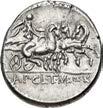

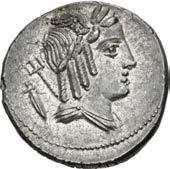



469. Appius Claudius Pulcher, T. Manlius Mancius, and Q. Urbinius. 111-110 BC. AR Denarius (16.5mm, 3.86 g, 12h). Rome mint. Helmeted head of Roma right; triangular device to left / Victory, holding reins, driving triga right. Crawford 299/1a var. (quadrangular device); Sydenham 570 var. (circular device); Claudia 2 var. (quadrangular device); RBW 1141 corr. (triangular device). Light iridescent toning, some metal flaws. Good VF. ($500)
Ex Andrew McCabe Collection (Classical Numismatic Group Electronic Auction 436, 23 January 2019), lot 451; Naville Numismatics 13 (22 February 2015), lot 114; Tkalec (9 May 2011), lot 76; Tkalec (29 February 2008), lot 41.
470. L. Julius Bursio. 85 BC. AR Denarius (19mm, 3.91 g, 5h). Rome mint. Laureate, winged, and draped bust of Apollo Vejovis right, trident over shoulder; dagger to left / Victory, holding wreath and reins, driving galloping quadriga right; XXXXV above. Crawford 352/1c; De Ruyter dies 153; Sydenham 728a; Julia 5a; RBW –. Lightly toned with underlying luster, some minor porosity. EF. ($500)
Ex Numismatica Ars Classica 120 (6 October 2020), lot 543; Tkalec (7 May 2009), lot 92.
471. Pub. Crepusius. 82 BC. AR Denarius (18mm, 3.73 g, 4h). Rome mint. Laureate head of Apollo right, with scepter over shoulder; p behind; bird (heron) below chin / Horseman galloping right, brandishing spear; uncertain control to left. Crawford 361/1c; Sydenham 738a; Crepusia 1; RBW –. Lightly toned with faint iridescence and underlying luster, scratches, small scrape on obverse, slightly off center on reverse. EF. ($500)
Ex Asta del Titano 72 (1 March 1998), lot 137.



472. C. Mamilius Limetanus. 82 BC. AR Serrate Denarius (20mm, 3.82 g, 6h). Rome mint. Draped bust of Mercury right, wearing winged petasus; to left, I above caduceus / Ulysses, wearing pileus and mariner’s dress, walking right, leaning on staff and extending his hand toward his dog, Argus, who advances toward him. Crawford 362/1; Sydenham 741; Mamilia 6; RBW 1370 var. (control). Lightly toned, lustrous, some roughness. EF. ($1000)
The obverse and reverse of this coin refer to the lineage of the gens Mamilia, who claimed their descent from Mamilia, the daughter of Telegonus, the son of Ulysses and Circe, and a descendant of Mercury. The reverse scene depicts the moment when, returning home from his long wanderings in the guise of a beggar so as to surprise and kill the many suitors of his wife Penelope, Ulysses’ aged dog Argus recognizes him:
Soon as he perceived Long-lost Ulysses nigh, down fell his ears Clapped close, and with his tail glad sign he gave Of gratulation, impotent to rise, And to approach his master as of old. Ulysses, noting him, wiped off a tear Unmarked.
. . . Then his destiny released Old Argus, soon as he had lived to see Ulysses in the twentieth year restored. At last, seeing his master after so many years, the old dog dies.
(Hom. Od. 17.290 [Cowper’s translation]).



473. L. Censorinus. 82 BC. AR Denarius (17mm, 3.83 g, 9h). Rome mint. Laureate head of Apollo right / Marsyas standing left, raising hand and holding wineskin over shoulder; to right, column surmounted by statue of Minerva(?) standing right. Crawford 363/1d; Sydenham 737; Marcia 24; RBW 1372. Attractive old cabinet toning with iridescence, scratches, scrape on reverse. EF. ($500)
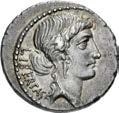

474. Q. Servilius Caepio (M. Junius) Brutus. 54 BC. AR Denarius (19mm, 3.86 g, 6h). Rome mint. Head of Libertas right, no jewels in hair / The consul L. Junius Brutus walking left between two lictors, each carrying axe over shoulder, preceded by an accensus. Crawford 433/1; Sydenham 906a; Junia 31a; RBW 1542. Toned with iridescence, minor marks, some wear on high points. Good VF. ($500)
Ex Naville Numismatics 69 (14 November 2021), lot 328.
This early coin of Marcus Junius Brutus, later known as Q. Servilius Caepio Brutus, refers to the illustrious ancestry of the clan, which included one of the legendary first consuls of the nascent Roman Republic, L. Junius Brutus. Because of his name and reputation for integrity, Brutus was recruited by conspirators against Julius Caesar and became the figurehead leader of the assassins.



475. Moneyer issues of Imperatorial Rome. L. Hostilius Saserna. 48 BC. AR Denarius (17.5mm, 3.95 g, 12h). Rome mint. Head of Gallic captive (Vercingetorix?) right; Gallic shield to left / Two warriors in galloping biga right: one driving, holding whip and reins, and the other, facing backward, holding shield and brandishing spear. Crawford 448/2a; CRI 18; Sydenham 952; Hostilia 2; RBW 1569. Minor marks and scratches. VF. ($1500)
Ex Leu Numismatik Web Auction 18 (18 December 2021), lot 2509; Red Ox Collection; collection of the Czech musician Adolf Picek (circa 1885-1978); formerly in the possession of an Italian banker, whose life was saved by Mr. Picek in the Battles of the Piave River on the Italian Front in 1917-1918 and who presented his savior with ‘four socks of old coins’ in reward.
The portrait on the obverse has sometimes been identified as the famous chief of the Arverni, Vercingetorix, whom Julius Caesar captured in 52 BC in Alesia. It is difficult to imagine anyone placing such a dramatic portrait of a defeated foe on their coinage, but it is clear from surviving sources of the period that the Romans had a good deal of respect for the Gauls as honorable warriors. Crawford and Sear believe this identification is unlikely, but the large, distinctive, and carefully engraved head suggests the die cutter worked with an eye toward creating an individualized portrait, rather than a stylized personification of a Gaul. The reverse is also of particular historical interest, in that it depicts the manner in which chariots were used in Celtic Gaul, and perhaps in Britain as well.
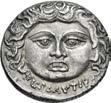

476. Moneyer issues of Imperatorial Rome. L. Plautius Plancus. 47 BC. AR Denarius (18mm, 3.76 g, 1h). Rome mint. Facing mask of Medusa with disheveled hair, without serpents / Victory (or winged Aurora) flying right, head slightly left, holding reins and conducting four rearing horses of the sun. Crawford 453/1c; CRI 29a; Sydenham 959b; Plautia 14; RBW 1585. Lightly toned with hints of iridescence, minor marks. Good VF. ($500)
Purchased by the consignor from Owl Ltd., 30 May 1981.




477. The Pompeians. Sextus Pompey. 40-39 BC. AR Denarius (17mm, 3.88 g, 9h). Uncertain Sicilian mint. The Pharos of Messana surmounted by statue of Neptune standing right, with foot on prow, holding trident and rudder; in foreground, galley to left, with aquila on prow and scepter, trident, and grappling-iron in stern / The monster Scylla left, her torso of dogs and fishes, wielding a rudder as a club with both hands. Crawford 511/4c; CRI 335a; Sydenham 1348; RSC 2b; RBW 1786-7 var. (rev. legend). Deeply toned with some iridescence, minor areas of weakness and slightly off center. Near EF. ($1500)



478. The Pompeians. Sextus Pompey. 37/6 BC. AR Denarius (19mm, 3.79 g, 12h). Uncertain Sicilian mint. Bare head of Pompey the Great right; capis to left, lituus to right / Neptune standing left, holding apluster and resting foot on prow between the Catanaean brothers Anapias and Amphinomus running in opposite directions, bearing their parents on their shoulders. Crawford 511/3a; CRI 334; Sydenham 1344; RSC 17 (Pompey the Great); RBW 1785. In NGC encapsulation 4241286-008, graded Ch VF, Strike: 4/5, Surface: 4/5. ($1000)
Ex Classical Numismatic Group Electronic Auction 506 (15 December 2021), lot 328; Heritage 3061 (7 January 2018), lot 29342.
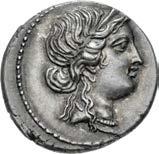
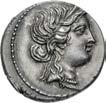


479. The Caesarians. Julius Caesar. Late 48-47 BC. AR Denarius (17mm, 3.83 g, 6h). Military mint traveling with Caesar in North Africa. Diademed head of Venus right / Aeneas advancing left, holding palladium and bearing Anchises on his shoulder. Crawford 458/1; CRI 55; Sydenham 1013; RSC 12; RBW 1600. Deep cabinet toning with iridescence, small die crack on obverse. EF. ($1000)
Ex Classical Numismatic Group 46 (24 June 1998), lot 1093.
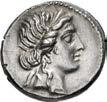

480. The Caesarians. Julius Caesar. Late 48-47 BC. AR Denarius (17mm, 4.03 g, 7h). Military mint traveling with Caesar in North Africa. Diademed head of Venus right / Aeneas advancing left, holding palladium and bearing Anchises on his shoulder. Crawford 458/1; CRI 55; Sydenham 1013; RSC 12; RBW 1600. Lightly toned with hints of iridescence, minor scratches, a few edge marks. Near EF. ($750)
From the Richard J. Sullivan Collection, purchased from Moruzzi Numismatica (inventory MR51042 [ND]).
Julius Caesar traced his descent all the way back to the Trojan hero Aeneas, legendary founder of the Romans. Aeneas, in turn, was the product of a liaison between the goddess Venus and Anchises, a herdsman who was related to the Trojan royal family. In a scene recounted by Virgil in the Aeneid, when the Greeks torched Troy, Aeneas escaped from the burning city carrying the aged Anchises on his shoulder and the sacred Palladium, a cult statue of Pallas Athena rescued from the household shrine. The scene is depicted on the reverse of this denarius of Caesar, struck in 48-47 BC, at least two decades before the Aeneid was composed. Venus, the mother of Aeneas (and thus the divine antecedent of Caesar) appears on the obverse.

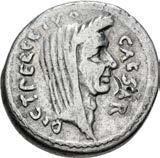

481. The Caesarians. Julius Caesar. February-March 44 BC. AR Denarius (27mm, 3.71 g, 4h). Lifetime issue. Rome mint; P. Sepullius Macer, moneyer. Laureate and veiled head right / Venus Victrix standing left, holding Victory and scepter; shield set on ground to right. Crawford 480/13; Alföldi Type IX, 88-90 (A47/R37); CRI 107d; Sydenham 1074; RSC 39; RBW 1685. Lightly toned, banker’s mark on obverse. VF. Well centered and struck. ($1500)
Ex Classical Numismatic Group Electronic Auction 519 (29 June 2022), lot 376.
P. Sepullius Macer was the most prolific of the moneyers striking Julius Caesar’s portrait coinage in 44 BC, with a remarkable number of subtle variations. Virtually nothing is known about him aside from his evident support for the Caesarians, as he struck coins for Mark Antony as well. Many of his coins show signs of being struck in great haste, probably reflecting preparations for Caesar’s planned Parthian campaign. Veiled portraits, such as this example, allude to Caesar’s role as Pontifex Maximus and do not necessarily mean the portrait is posthumous, although some varieties clearly were struck after the Ides of March.


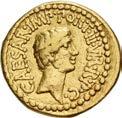

482. The Triumvirs. Mark Antony and Octavian. Spring-early summer 41 BC. AV Aureus (20mm, 7.99 g, 12h). Ephesus mint; M. Barbatius Pollio, quaestor pro praetore. Bare head of Mark Antony right; Â • ANT if Yg iii uir • r
•  BArBAT • œ • p around / Bare head of Octavian right, with slight beard; CAeÍAr • iÂp • pONT • iii
p
C
p
• C • around. Crawford 517/1a; CRI 242; Sydenham 1180; Bahrfeldt 77; Calicó 109; Biaggi 66; BMCRR East 98; Kestner 3792; RBW 1797. Minor marks. VF. ($7500)
Ex MACM inventory MMoCA32C; Künker 168 (12 March 2010), lot 7563.

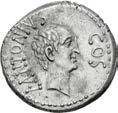
483. The Triumvirs. Mark Antony and Lucius Antony. Summer 41 BC. AR Denarius (19mm, 3.78 g, 6h). Ephesus mint; M. Cocceius Nerva, proquaestor pro praetore. Bare head of Mark Antony right / Bare head of Lucius Antony right. Crawford 517/5a; CRI 246; Sydenham 1185; RSC 2; RBW 1799. Cleaning marks, graffito, slight pitting. Near EF. ($750)
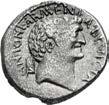
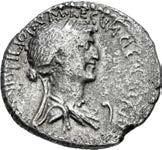
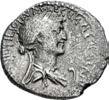
484. The Triumvirs. Mark Antony and Cleopatra. Autumn 34 BC. AR Denarius (17.5mm, 3.40 g, 1h). Alexandria mint(?). Bare head of Mark Antony right; Armenian tiara to left / Diademed and draped bust of Cleopatra right; at point of bust, prow right. Crawford 543/1; CRI 345; Sydenham 1210; RSC 1; RBW 1832. Porous, scratches. Near VF. ($3000)
Ex Gorny & Mosch 284 (7 March 2022), lot 605.
The consensus of opinion on the date and mint of this coin was relatively uniform until the publication by R. Newman, “A Dialogue of Power in the Coinage of Antony and Octavian” in AJN 2 (1990), pp. 37-64. Sear (CRI) follows Newman in calling it an issue from Alexandria struck for Antony’s Armenian triumph of the autumn of 34 BC, when the “celebrated and enigmatic” (per Sear) “Donations of Alexandria” took place. Newman states the minting of this coin “must have taken place in 34, the year of Antony’s Alexandrian triumph, since it would otherwise be without context.” The legends on this coin could be translated as “[coin] of Antony, with Armenia being Conquered, for Cleopatra, Queen of Kings and of her Sons, being Kings.” The Armenian crown behind Antony represents his victorious Roman army, the prow beneath Cleopatra (which appears on no other Roman coin of hers) stands for the mighty Egyptian fleet; combined they symbolize the full array of forces that Antony would soon marshal against Octavian.



485. The Triumvirs. Mark Antony. Summer 32 BC. AR Denarius (17mm, 3.80 g, 3h). Athens mint. Bare head right; small p (signature) in hair below ear / ANTONiuÍ/Aug • iÂp • iii in two lines. Crawford 542/2; CRI 347; Sydenham 1209; RSC 2; RBW 1831. Lustrous, slight porosity, minor weakness, slightly off center on reverse. Good VF. ($500)
Ex Leu Numismatik Web Auction 17 (14 August 2021), lot 2262.
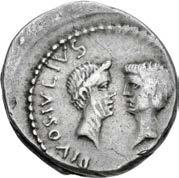
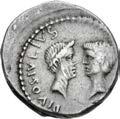

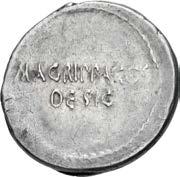
486. The Triumvirs. Octavian, Divus Julius Caesar, and Agrippa. 38 BC. AR Denarius (20mm, 4.09 g, 6h). Military mint traveling with Agrippa in Gaul or Octavian in Italy. Laureate head of the deified Julius Caesar right, vis-à-vis bare head of Octavian left / Â • AgrippA COÍ/DeÍig in two lines. Crawford 534/2; CRI 306; Sydenham 1330; RSC 129; RBW –. Lightly toned, minor scratches, slightly off center. VF. Very rare. Two fine portraits. ($2000)
Ex Leu Numismatik Web Auction 17 (14 August 2021), lot 2269.

Octavian’s Actian Arch



487. The Triumvirs. Octavian. Autumn 30-summer 29 BC. AR Denarius (19.5mm, 3.74 g, 3h). Uncertain mint in Italy (Rome?). Bare head right / Octavian’s Actian arch (arcus Octaviani), showing a single span surmounted by Octavian in facing triumphal quadriga; iÂp • CAeÍAr on the architrave. CRI 422; RIC I 267; RSC 123; BMCRR Rome 4348 = BMCRE 624; BN 66. Lightly toned with some luster, a few short digs, minor marks, hairlines. EF. ($3000)



488. Augustus. 27 BC-AD 14. AR Denarius (18mm, 3.65 g, 11h). Emerita mint; P. Carisius, legatus pro praetore. Struck circa 25-23 BC. Bare head left / Celtiberian helmet facing between dagger to left and bipennis to right. RIC I 7b; RSC 405. Vivid iridescent cabinet toning. Good VF. ($750)
From the 1930’s collection of Robert W. Hubel of Michigan. Ex Cahn 80 (27 February 1933), lot 566; Joseph Martini (Part 3, R. Ratto, 24 February 1930), lot 1522.



489. Augustus. 27 BC-AD 14. AR Denarius (20.5mm, 3.48 g, 6h). Uncertain Spanish mint (Colonia Caesaraugusta?). Struck 19-18 BC. Head left, wearing oak wreath / Two laurel branches (or trees) upright. RIC I 33b; RSC 48. Appealing iridescent cabinet toning. Near EF. Well struck on a broad flan. ($2000)
From the 1930’s collection of Robert W. Hubel of Michigan.
On this denarius, Augustus celebrates the honors conferred upon him by the Roman Senate on 16 January 27 BC: the corona civica or civic wreath of oak leaves. This wreath was typically awarded to a soldier, who in the midst of battle saved the life of a fellow soldier. In this instance, however, it refers to Octavian saving the entire state. The laurel trees represent those planted outside the entrance to Augustus’ home, and symbolize honor and respect.
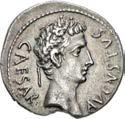


490. Augustus. 27 BC-AD 14. AR Denarius (20.5mm, 3.67 g, 6h). Uncertain Spanish mint (Colonia Caesaraugusta?). Struck circa 18 BC. Head right, wearing oak wreath / DIVVS • IVLIVS across field, comet with eight rays and tail. RIC I 37a; RSC 98. Wonderful iridescent cabinet toning, scratches under tone, collector’s number 614 in ink on reverse, edge marks/tests. Good VF. Attractive in hand. ($750)
From the 1930’s collection of Robert W. Hubel of Michigan. Ex Cahn 71 (14 October 1931), lot 1423 (collector’s ink added since).



491. Augustus. 27 BC-AD 14. AR Denarius (21mm, 3.83 g, 6h). Uncertain Spanish mint (Colonia Patricia?). Struck 19-18 BC. Bare head right / Mars standing left, head right, holding aquila and signum. RIC I 41; RSC 259. Deep iridescent cabinet toning, bankers’ marks on obverse. Good VF. A very handsome coin in hand. ($500)
From the 1930’s collection of Robert W. Hubel of Michigan. Ex Cahn 75 (30 May 1932), lot 793.
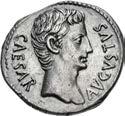



492. Augustus. 27 BC-AD 14. AR Denarius (20.5mm, 3.51 g, 6h). Uncertain Spanish mint (Colonia Patricia?). Struck circa 19 BC. Bare head right / Oak wreath with ties upward. RIC I 75a; RSC 210. Lightly toned, minor marks and hairlines. Good VF. Struck on a broad flan. ($750)
493. Augustus. 27 BC-AD 14. AR Denarius (18.5mm, 3.63 g, 6h). Uncertain Spanish mint (Colonia Patricia?). Struck circa 18-17/16 BC. Bare head left / Mars standing left, holding vexillum and parazonium. RIC I 150b; RSC 326. Attractive light toning, minor marks under tone. Good VF. Rare. ($500)
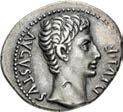


494. Augustus. 27 BC-AD 14. AR Denarius (20mm, 3.69 g, 6h). Lugdunum (Lyon) mint. Struck 15 BC. Bare head right / Apollo Citharoedus of Actium, standing left, holding plectrum and lyre. RIC I 171a; Lyon 28; RSC 144. Deep iridescent cabinet toning, banker’s mark on obverse, minor flan flaw and a few scratches under tone on reverse. Good VF. A pretty coin in hand. Excellent portrait. ($500)
From the 1930’s collection of Robert W. Hubel of Michigan.

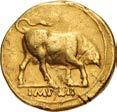
495. Augustus. 27 BC-AD 14. AV Aureus (18mm, 7.76 g, 11h). Lugdunum (Lyon) mint. Struck 10 BC. Laureate head left / Bull butting right, lashing his tail. RIC I 186b; Lyon 54; Calicó 223. Toned, scattered marks, scratches, scuffs, deposits, struck off center on obverse. VF. ($2000)
From the 1930’s collection of Robert W. Hubel of Michigan.
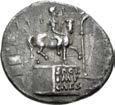

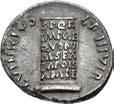
496. Augustus. 27 BC-AD 14. AR Denarius (18.5mm, 3.55 g, 4h). Rome mint; L. Vinicius, moneyer. Struck 16 BC. Equestrian statue of Augustus riding right on a low square pedestal inscribed S • P • Q • R/ IMP/ CAES in three lines; all before city wall with arched entrance / Cippus inscribed S • P • Q • R/ IMP • CAE/ QVOD • V/ M
EX/ EA
P
QIS/ AD
A
DE in six lines. RIC I 362; RSC 543; CNR III, 476 (this coin). Toned, light roughness, a few scrapes and scratches, hairline flan crack. Good VF. Well centered. ($1000)
Ex Numismatica Ars Classica 92 (Part II, 24 May 2016), lot 2025; Westfälische Auktionsgesellschaft 49 (9 February 2009), lot 189; Münzen & Medaillen AG XXVIII (19 June 1964), lot 260.
Statues to Augustus were erected near the Porta Flaminia, outside the city. The obverse of this coin may represent one of them.
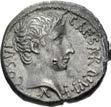
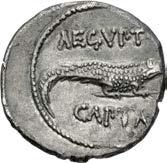
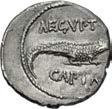
497. Augustus. 27 BC-AD 14. AR Denarius (18mm, 3.61 g, 3h). Uncertain mint (Pergamum?). Struck 28 BC. Bare head right; small capricorn below neck / Crocodile standing right on ground line. RIC I 545; RSC 4. Toned, granular surfaces, some scratches and marks under tone, small banker’s mark on obverse, off center on reverse, a couple of test cuts on edge. VF. A detailed crocodile. ($2000)
From the Mesogeios Collection. Ex Marti Hervera and Soler & Llach 1122 (26 October 2021), lot 529, purchased from J. Fernández, December 1999.



498. Divus Augustus. Died AD 14. Æ Dupondius (29mm, 11.35 g, 6h). Rome mint. Struck under Tiberius, circa AD 2223. Radiate head of Divus Augustus left / Round hexastyle temple flanked by calf right and lamb left, standing on stone bases. RIC I 74 (Tiberius); Elkins, Monuments Figure 67. Deep red-brown patina, minor smoothing. Good VF. ($1000)
Ex Artemide LV (24 April 2021), lot 414.
The temple honors the deified Augustus. This is one of only four different architectural reverses produced during the reign of Tiberius.

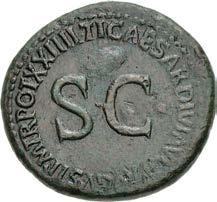

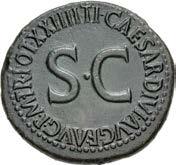
499. Julia Augusta (Livia). Augusta, AD 14-29. Æ Sestertius (34.5mm, 27.38 g, 2h). Rome mint. Struck under Tiberius, circa AD 22-23. Ornamented carpentum drawn right by two mules / Legend around large S • C. RIC I 50 (Tiberius). Greenbrown patina, minor smoothing, some roughness. Near EF. The rarer variety with the obverse legend in two lines rather than three. ($1500)
Ex Artemide LIV (7 November 2020), lot 270; Classical Numismatic Group 61 (25 September 2002), lot 1620.
500. Julia Augusta (Livia). Augusta, AD 14-29. Æ Dupondius (28.5mm, 13.60 g, 6h). Rome mint. Struck under Tiberius, circa AD 22-23. Diademed and draped bust of Justitia right / Legend around large S • C. RIC I (Tiberius) 46 corr. (rev. legend). Green-brown patina, smoothed. Good VF. ($1000)
Ex Tareq Hani Collection (Goldberg 117, 15 September 2020), lot 2237.
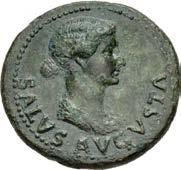

501. Julia Augusta (Livia). Augusta, AD 14-29. Æ Dupondius (30mm, 13.37 g, 12h). Rome mint. Struck under Tiberius, circa AD 22-23. Bareheaded and draped bust of Julia Augusta (Livia) as Salus Augusta right, wearing waved hair and fastened in a knot at the back / Legend around large S • C. RIC I 47 (Tiberius). Green patina, minor smoothing. Good VF. ($1000)
Ex David Feinstein Collection (Triton XXIV, 19 January 2021), lot 1003.

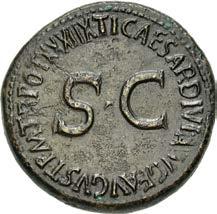


502. Tiberius. AD 14-37. Æ Sestertius (35.5mm, 27.34 g, 6h). Rome mint. Struck AD 36-37. Empty horse-drawn quadriga right, its side ornamented with trophy, captive seated left, Victory standing right, erecting trophy, and wreath / Legend around large S • C. RIC I 66. Handsome light brown patina. Good VF. ($750)
Ex Numismatica Ars Classica Spring Sale 2020 (25 May 2020), lot 864.
503. Agrippina Senior. Died AD 33. Æ Sestertius (34mm, 26.93 g, 6h). Rome mint. Struck under Gaius (Caligula), AD 37-41. Draped bust right, hair falling in queue down her neck / Carpentum drawn left by two mules, the cover supported by standing figures at the corners, and with ornamented side; eight spokes in wheel. RIC 55 (Gaius); Trillmich Group I; CNR XII 27/1 (this coin). Dark brown patina. VF. ($750)
Ex Numismatica Ars Classica Spring Sale 2020 (25 May 2020), lot 868 (hammer CHF 2,000); Kunst und Münzen [1] (7 December 1967), lot 193.
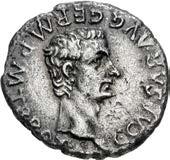

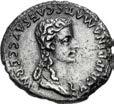

504. Gaius (Caligula), with Agrippina Senior. AD 37-41. AR Denarius (18mm, 3.40 g, 9h). Lugdunum (Lyon) mint. 2nd emission, 1st phase, late AD 37. Bare head of Gaius (Caligula) right / Draped bust of Agrippina right. RIC I 8; Lyon 162 (unlisted dies); RSC 4 (Caligula and Agrippina Senior). Toned, porous surfaces, marks, edge chips. VF. ($1500)
Ex MACM inventory MMoCA61C.

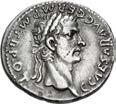

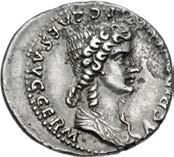
505. Gaius (Caligula), with Agrippina Senior. AD 37-41. AR Denarius (19mm, 3.76 g, 6h). Lugdunum (Lyon) mint. 2nd emission, 2nd phase, late AD 37-early 38. Laureate head of Gaius (Caligula) right / Draped bust of Agrippina right. RIC I 14 (Rome mint); Lyon 169 (D–/R115 [unlisted obv. die]); RSC 2. Toned, minor roughness, marks. VF. ($2000)
Ex Forvm Ancient Coins inventory SH76413 (ND).



506. Divus Claudius. AD 41-54. AV Aureus (19mm, 7.49 g, 6h). Rome or Lugdunum (Lyon) mint. Struck under Nero, AD 54-55. Laureate head left / Slow quadriga right, with tensa (car) in form of small temple, showing front, the tensa with pediment like a temple and decorated with two pateras and a lituus, surmounted by four miniature horses, flanked by Victories left and right; on the side and front are figures (Victory and Virtus(?) and wreath). RIC I 4 (Nero); von Kaenel Type 53 (Divus Claudius [Nero] – unlisted dies); Lyon (Nero) 1 (unlisted dies); Calicó 354. Contact marks, edge test cut, edge marks. Near VF. ($2500)


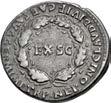
507. Nero, with Agrippina Junior. AD 54-68. AR Denarius (17.5mm, 3.53 g, 9h). Lugdunum (Lyon) mint. Struck December AD 54. Bare head of Nero right, facing draped bust of Agrippina Junior left / EX • S C within oak wreath. RIC I 2 (Rome); WCN 36; Lyon 5 (unlisted dies); RSC 7. Toned. Good VF. Two attractive portraits. ($1500)
From the Wild Rose Collection. Ex Roma XV (5 April 2018), lot 508; Triton V (15 January 2002), lot 1894.


508. Nero. AD 54-68. Æ Sestertius (37mm, 27.41 g, 6h). Lugdunum (Lyon) mint. Struck circa AD 65. Laureate head left, globe at point of neck / Roma seated left on cuirass, holding Victory and parazonium; shields to right. RIC I 443; WCN 428; Lyon 119. Green patina, smoothing, tooling. Good VF. ($750)
Ex Tauler & Fau 60 (24 June 2020), lot 158.


509. Nero. AD 54-68. Æ Sestertius (38mm, 27.12 g, 7h). Rome mint. Struck circa AD 63. NERO CLAVD CAESAR • AVG GERM P M TR P IMP P P, laureate head left / CONG II DAT POP, Nero on left, seated right on high platform; before him, an official seated right on another platform handing congiarium to togate citizen standing with one foot on a flight of steps, right hand extended, holding fold of toga; on right, small boy stands left; in background, on left, Minerva standing left, holding owl in right hand and spear in left, and, on right, Liberalitas standing right, holding up tessera in right hand. RIC I 101 var. (bust type); WCN 72 var. (same). Rough red-brown surfaces. VF. Very rare. ($1000)
Ex Leu Web Auction 16 (22 May 2021), lot 3397.



510. Nero. AD 54-68. Æ Sestertius (35mm, 28.26 g, 6h). Rome mint. Struck circa AD 64. Laureate bust right, wearing aegis / Nero on horseback prancing right, holding spear; behind him, soldier on horseback, holding vexillum over shoulder. RIC I 170; WCN 108. Attractive dark green patina, nick at edge on obverse. Good VF. ($750)
Ex Numismatica Ars Classica Spring Sale 2020 (25 May 2020), lot 895; Rev. Edward A. Sydenham Collection (Glendining, 10 December 1941), lot 32.



511. Nero. AD 54-68. Æ Sestertius (34mm, 20.99 g, 6h). Rome mint. Struck circa AD 64. Laureate bust right, wearing aegis / Port of Ostia: seven ships within the harbor; at the top is a pharus surmounted by a statue of Neptune; below is a reclining figure of Tiber, holding a rudder and dolphin; to left, crescent-shaped pier with portico, terminating with figure sacrificing at altar and with building; to right, crescent-shaped row of breakwaters or slips, terminating with a figure seated on rock. RIC I 178; WCN 120; Elkins, Monuments Figure 83. Brown-green surfaces, minor roughness, tooling on obverse. VF ($2500)
Ex Gadoury (16 November 2018), lot 54.
While Julius Caesar recognized the value of expanding Rome’s port facilities at Ostia, it was Claudius who began actual building in AD 42. As part of the construction, one of Caligula’s pleasure galleys was scuttled and filled with cement; above it was constructed a lighthouse surmounted by a statue of Neptune. Although the actual date of completion is not certain, it must have occurred shortly before this sestertius was minted. A further expansion of the facilities was required under Trajan and Hadrian. By the fourth century, however, the port’s importance began to diminish as a result of silting. Soon the region became a breeding ground for malaria and was abandoned.



512. Nero. AD 54-68. Æ Dupondius (28.5mm, 15.20 g, 6h). Rome mint. Struck circa AD 64. Radiate head right / Façade of the Macellum Magnum: statue standing facing on base within cylindrical tetrastyle entrance set on tiered base, upper tristyle story surmounted by ornate conical dome; two-story distyle porch on left, two-story tristyle porch on right; II (mark of value) in exergue. RIC I 187; WCN 197; Elkins, Monuments Figue 82. Green patina, lightly smoothed. Good VF. Well struck reverse. ($1000)
Ex Classical Numismatic Group 114 (14 May 2020), lot 763.
The Macellum Magnum was Nero’s great provision-market, probably dating from AD 59. This magnificent structure, originally occupying the middle of a square lined with porticoes and shops, was located on the Caelian Hill. It survived in its original state until the late 4th century, when its dilapidated condition necessitated a major reconstruction. During the turbulent 5th century the building again fell into partial ruin and in the latter part of the century it was transformed under Pope Simplicius (468-482) into the church of S. Stefano Rotondo.


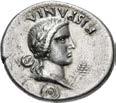
513. Galba. AD 68-69. AR Denarius (19mm, 3.30 g, 6h). Uncertain Spanish mint (Tarraco?). Struck circa April to late AD 68. Galba, bareheaded, in military dress, riding left, right hand raised / Laureate and draped bust of Hispania right; two javelins above a round shield to left; two grain ears to right. RIC I 2; CSB 21; RSC 77. Light iridescent toning, numerous scratches. Good VF. ($750)
Ex Scipio Collection (Gorny & Mosch 289, 10 October 2022), lot 758.

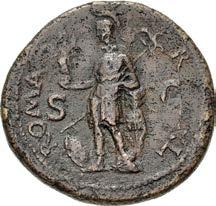
514. Galba. AD 68-69. Æ Sestertius (35mm, 26.41 g, 6h). Rome mint, 1st officina. Struck circa November AD 68. SER • GALBA • IMP • CAES • AVG TR P, laureate head right / ROMA R XL, S C across field, Roma, helmeted and in military dress, standing left, holding statue of Fortuna on globe in right hand and transverse aquila in left, resting left arm on top of trophy and left foot on helmet; at feet to left, a shield. RIC I 451 corr. (Victory on globe); ACG 8 (A16/P22); BMCRE 84; BN 229; Cohen 193. Brown surfaces, pitting. Near VF. Rare with R XL on reverse. ($750)
Ex Kenneth W. Dorney inventory 7380 (ND).
The legend R XL stands for remissa quadragesima, celebrating Galba’s repeal of the 2 1/2 percent tax on goods entering Gaul in appreciation of the help which Gaul and Spain had lent him. According to Suetonius (Suetonius Vespasian., 16), that very tax was reimposed by Vespasian shortly thereafter. The statue which Roma holds has been variously described by the major references: RIC calls it Victory, which it cannot be, since the statue has no wings and is holding no wreath; ACG and BN identify the statue as Pax, but Pax is not usually portrayed standing on a globe and typically holds an olive branch and scepter; BMCRE and Cohen identify the statue as Fortuna, which makes the most sense, since Fortuna commonly holds a cornucopia and is depicted in the presence of a globe.



515. Vitellius. AD 69. Æ Sestertius (34.5mm, 26.64 g, 6h). Rome mint. Struck circa late April-20 December. Laureate and draped bust right / Pax standing left, holding olive branch and cornucopia. RIC I 118. Brown and green patina, areas of roughness on reverse. VF. Great portrait. ($1500)
Ex Numismatica Ars Classica Spring Sale 2020 (25 May 2020), lot 927 (hammer CHF 3750).
Plated in Biaggi’s Le Preziose Patine

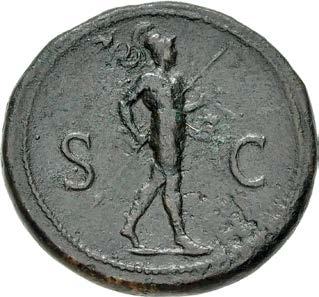
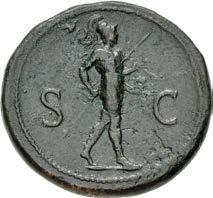
516. Vitellius. AD 69. Æ Sestertius (35mm, 26.33 g, 6h). Rome mint. Struck circa late April-20 December. Laureate and draped bust right / Mars, helmeted, naked except for cloak floating round his waist, holding transverse spear and aquila over shoulder. RIC I 121; Biaggi, Le Preziose Patine 118 (this coin illustrated). Dark green-brown patina, areas of light smoothing. VF. Rare. ($2000)
Ex Numismatica Ars Classica Spring Sale 2021 (10 May 2021), lot 1243.

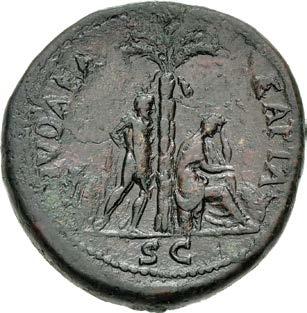
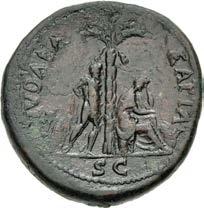
517. Vespasian. AD 69-79. Æ Sestertius (34mm, 24.45 g, 6h). “Judaea Capta” commemorative. Rome mint. Struck AD 71. Laureate head right / IVDAEA CAPTA, S C in exergue, palm tree; to left, bound male captive standing right; to right, Judaea seated right on cuirass in attitude of mourning; both figures surrounded by arms. RIC II.1 159; Hendin 6530. Slightly rough red-green patina. VF. ($1000)
Ex Naville Numismatics 58 (14 June 2020), lot 521.

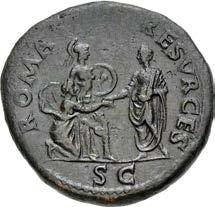
518. Vespasian. AD 69-79. Æ Sestertius (35mm, 26.80 g, 6h). Rome mint. Struck AD 71. Laureate bust right, slight drapery / ROMA RESVRGES, S C in exergue, Vespasian, laureate and togate, standing left, left arm at side, right hand extended to raise up Roma, a draped woman, kneeling right in front of him, and holding out her right hand to him; in the background stands the goddess Roma, helmeted and in military dress, holding [spear] and round shield. RIC II.1 195 (R2; same rev. die as illustration on back of dust jacket); BMCRE 565 (same dies); BN 531 (same obv. die). Brown patina, smoothed. VF. Very rare. ($2000)
Ex Numismatica Ars Classica Spring Sale 2020 (25 May 2020), lot 934; Rauch 86 (12 May 2010), lot 669; Numismatica Ars Classica 25 (25 June 2003), lot 410.




519. Divus Vespasian. Died AD 79. Æ Sestertius (32mm, 24.90 g, 12h). Rome mint. Struck under Titus, AD 80-81. Deified Vespasian seated right, holding scepter and Victory in cart drawn by a quadriga of elephants with riders / Legend around large S • C. RIC II.1 258 (Titus). Even brown and olive-green surfaces, areas of very light smoothing. VF. ($750)
Ex Naville Numismatics 58 (14 June 2020), lot 526; Classical Numismatic Group 66 (19 May 2004), lot 1409.
520. Titus. AD 79-81. Æ Sestertius (34mm, 24.06 g, 6h). Rome mint. Struck AD 79. Laureate head right / Vesta seated left, holding Palladium and scepter. RIC II.1 66. Brown surfaces, shallow scratches, lightly smoothed. Good VF. ($1500)
Ex Numismatik Naumann 128 (7 May 2023), lot 750; Numismatik Naumann 126 (5 March 2023), lot 845; Bertolami Fine Arts 29 (22 March 2017), lot 459.
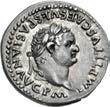
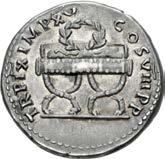
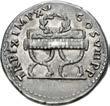
521. Titus. AD 79-81. AR Denarius (18mm, 3.43 g, 6h). Rome mint. Struck 1 January-30 June AD 80. Laureate head right / Wreath above curule chair. RIC II.1 108; RSC 318. Toned. Good VF. ($500)
Ex Benito Collection (Classical Numismatic Group 114, 14 May 2020), lot 807.

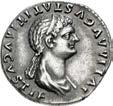

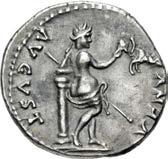
522. Julia Titi. Augusta, AD 79-90/1. AR Denarius (18mm, 3.51 g, 6h). Rome mint. Struck under Titus, AD 80-81. Diademed and draped bust right; hair in long plait / Venus, seen half from behind, naked to the hips, standing right, resting elbow on column, holding transverse scepter and crested helmet. RIC II.1 388 (Titus); RSC 14. Beautifully toned, some faint hairlines under tone. Near EF. ($2000)
Ex Classical Numismatic Group 123 (23 May 2023), lot 621; Thomas A. Palmer Collection (Classical Numismatic Group 118, 14 September 2021), lot 1040, purchased from Classical Numismatic Group, August 1995; Leu 59 (17 May 1994), lot 264; Leu 45 (26 May 1988), lot 323.



523. Domitian. AD 81-96. AV Aureus (20.5mm, 7.74 g, 6h). Rome mint. Struck AD 84. Laureate bust right, wearing aegis / Minerva standing left, holding spear and resting hand on hip. RIC II.1 190 (R2); Calicó 904; Biaggi 421. A few shallow scratches, hairlines, deposits, minor marks on edge. VF. Very rare. ($3000)
From the Wayne Scheible Collection.


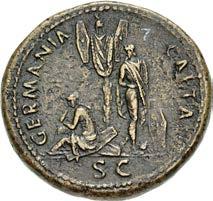
524. Domitian. AD 81-96. Æ Sestertius (35mm, 27.64 g, 6h). Rome mint. Struck AD 85. Laureate bust right, wearing aegis / GERMANIA CAPTA, S C in exergue, trophy; on left, German woman seated left on shields in attitude of mourning, head propped on hand, elbow resting on knee; on right, German warrior standing right, head left, hands tied behind back. RIC II.1 274. Brown patina, minor smoothing and roughness, scrape on obverse. VF. ($1000)
Ex Vico 158 (14 April 2021), lot 480.


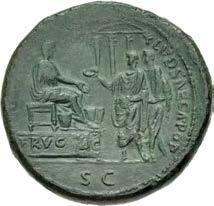
525. Domitian. AD 81-96. Æ Sestertius (35mm, 27.55 g, 6h). Ludi Saeculares (Secular Games) issue. Rome mint. Struck 14 September-31 December AD 88. Laureate head right / Domitian seated right on chair set on low platform on left, holding patera; to right, two citizens standing left, the one closest to Domitian holding patera over two baskets set on platform; another basket in front of Domitian’s feet; in background, tetrastyle temple. RIC II.1 608. Green patina, some tooling in legend on obverse. Near EF. ($1000)
Honoring the original system for the celebration of the games, Domitian held the Ludi Saeculares in October AD 88, coming close to the traditional 110-year standard.

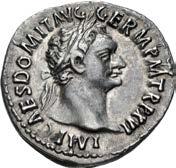

526. Domitian. AD 81-96. AR Denarius (19mm, 3.09 g, 6h). Rome mint. Struck 14-18 September AD 96. IMP CAES DOMIT AVG GERM P M TR P XVI, laureate head right / IMP XXII COS XVII CENS P P P, Minerva standing left, holding thunderbolt and spear; shield set on ground to right. RIC II.1 819; RSC 297. Toned, faint hairlines on reverse. Good VF. Rare last issue, struck in the final five days of Domitian’s reign. ($1000)
From the I.L. Collection.



527. Trajan. AD 98-117. Æ Sestertius (34.5mm, 23.91 g, 6h). Rome mint. Struck AD 101-102. IMP CAES NERVA TRAIAN AVG GERM P M, laureate bust right, slight drapery / TR POT COS IIII P P, S C in exergue, Pax, draped, seated left on throne, holding olive branch in extended right hand and transverse scepter in left. RIC II 432 var. (bust type); Woytek 107b; Strack 338; Banti 337; BMCRE 745, note; BN 144-5. Glossy green patina, minor smoothing. EF. Boldly struck, with a magnificent portrait. ($7500)
Ex Classical Numismatic Group 117 (19 May 2021), lot 521 (hammer $22,000).
When Trajan entered his fourth consulship in AD 101, the Roman Empire seemed securely at peace, as celebrated by the figure of Pax on the reverse of this attractive sestertius. This peace, however, was not to be sustained as Trajan was already planning a massive campaign against the Dacian King Decebalus, who had humiliated Roman armies on two occasions during Domitian’s reign.



528. Trajan. AD 98-117. Æ Sestertius (32.5mm, 26.39 g, 6h). Rome mint. Struck circa mid AD 107-110. Laureate bust right, wearing aegis / Arched, single-span bridge with seven posts across river; single-bay arches at either end; boat sailing left in river below. RIC II 569 var. (bust type); Woytek 314cD (this coin illustrated); Banti 267; cf. Elkins, Monuments Figure 117 (for rev. type). Green-brown patina. VF. ($750)
Ex LHS 100 (23 April 2007), lot 477 (hammer CHF 2200).
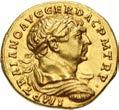


529. Trajan. AD 98-117. AV Aureus (19mm, 7.32 g, 6h). Rome mint. Struck circa AD 108-110. IMP TRAIANO AVG GER DAC P M TR P, laureate, draped, and cuirassed bust right / COS V P P S P Q R OP TIMO PRINC, Ceres, draped, wearing wreath of grain ears, standing left, holding grain ears pointed downward in right hand and long vertical torch in left. RIC II 109 var. (bust type); Allen Series 42, Type IX (dies – [unlisted obv. die]/ix.1); Woytek 291f; Calicó 996a (same rev. die as illustration); BMCRE 258-9; BN 413-5; Biaggi 469 var. (break in rev. legend); Mazzini 65 v. Lustrous, faint hairlines. Near EF. Portrait of artistic merit. ($5000)
From the Wild Rose Collection. Ex Numismatica Ars Classica 119 (with Jesús Vico, 6 October 2020), lot 47; Leu 33 (3 May 1983), lot 46.



530. Trajan. AD 98-117. AV Aureus (19.5mm, 7.11 g, 6h). Rome mint. Struck circa spring AD 113-summer 114. IMP TRAIANO AVG GER DAC P M TR P COS VI P P, laureate, draped, and cuirassed bust right / S • P • Q • R • OPTI MO PRINCIPI, Trajan’s Column: column surmounted by statue of Trajan standing left, holding globe in right hand and scepter in left, and set on podium decorated with two eagles. RIC II 292 var. (bust type); Beckmann, Early Type XI, 3 (dies a53/C2); Woytek 424f; Strack 197; Calicó 1117; BMCRE 450 (same dies); BN –; Biaggi 543; cf. Elkins, Monuments Figure 121 (for rev. type). Toned. VF. Very rare. ($7500)
Trajan’s Column was the crowning glory of the Forum Traiani, built with the spoils of the Dacian Wars. Covered by a continuous frieze of the war’s events, the column was capped with a gilded heroic statue of the emperor, while an inscription on the base recounted the feat of engineering in the forum’s construction. After Trajan’s death, the column became the repository of his ashes.
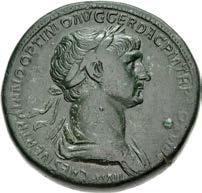


531. Trajan. AD 98-117. Æ Sestertius (33mm, 25.73 g, 5h). Rome mint. Struck winter AD 114-early 116. Laureate and draped bust right / Trajan seated right on sella castrensis set on daïs, addressing a group of soldiers who hold three signa; two officers standing at Trajan’s side; at base of daïs, an officer stands right. RIC II 658; Woytek 549v; Banti 80. Attractive green patina, minor weakness. VF. ($750)
Ex Numismatica Ars Classica Spring Sale 2020 (25 May 2020), lot 997.
Trajan extended the Empire’s borders to their greatest limit. After two major campaigns (AD 101-103 and 105-106), he incorporated Dacia as a Roman province. In AD 114, in consequence of the installation of a Parthian puppet on the throne of Armenia, Trajan annexed the area as another Roman province and then extended operations into Mesopotamia. The reverse of this coin depicts Trajan’s acclamation by the troops as imperator for the ninth time, which occurred with the fall of the city of Singara in AD 115 during the campaigns on the eastern frontier.
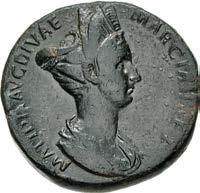

532. Matidia. Augusta, AD 112-119. Æ Sestertius (33mm, 25.90 g, 6h). Rome mint. Struck under Trajan, September AD 112-117. Draped bust right, wearing double stephane, erect on top of her head, on which her hair is built up; her hair is massed and coiled on the back of her head / Matidia standing left, placing her hands on heads of two children, Sabina and Matidia the younger, who stands looking up and raising hands to her. RIC II 761 (Trajan); Woytek 730–11 (same rev. die as illustration); Banti 1. Green-brown patina, minor roughness, scratch on obverse. Near VF. ($750)
Ex Roma 78 (17 December 2020), lot 1430.



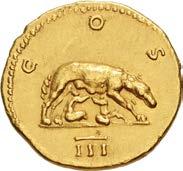
533. Hadrian. AD 117-138. AV Aureus (19.5mm, 7.16 g, 6h). Rome mint. Struck circa AD 124-125. Laureate bust right, slight drapery / She-wolf standing right, suckling the Twins (Romulus and Remus). RIC II.3 711; Calicó 1231; BMCRE 444-7; Biaggi 597; NAC Spring Sale 2020, lot 1011 (same dies). Minor edge marks. Good VF. ($3000)
From the Wayne Scheible Collection.



534. Hadrian. AD 117-138. Æ Sestertius (32mm, 26.12 g, 11h). “Travel series” issue. Rome mint. Struck circa AD 129130. Laureate and draped bust left / Galley moving left, with rowers, steersman in stern. RIC II.3 1293; Banti 367. In NGC encapsulation 6054830-015, graded XF, Strike: 5/5, Surface: 3/5, Fine Style. ($750)
Ex T. R. Fehrenbach Collection (Heritage 3089, 21 January 2021), lot 32197.


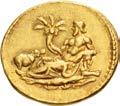
535. Hadrian. AD 117-138. AV Aureus (20mm, 6.66 g, 6h). “Travel series” issue (“Provinces cycle”) – The province alone. Rome mint. Struck circa AD 130. HADRIANVS • AVG COS III P P, bareheaded, draped, and cuirassed bust right / Nilus, naked to waist, reclining left, holding cornucopia in right hand, resting left arm on sphinx; to left, hippopotamus standing right; below, in water, crocodile right. RIC II.3 1437; Beckmann, Gold, dies e2/NN6; Strack 309; Calicó 1159; BMCRE 867; Biaggi 670 (same obv. die). Edge filing. Good VF. Rare. ($4000)

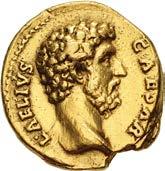
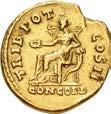
536. Aelius. Caesar, AD 136-138. AV Aureus (18mm, 7.04 g, 5h). Rome mint. Struck under Hadrian, AD 137. Bare head right / Concordia seated left, feet on footstool, holding patera in extended right hand, leaning left arm on cornucopia set on ground. RIC II.3 2706; Calicó 1444 (same dies as illustration); BMCRE 997; Adda 170 (same dies); Biaggi 688 (same dies). Toned, marks, edge split, nick at edge on obverse. VF. ($4000)
From the Ramrodivs Collection. Ex Harlan J Berk inventory cc54531 (ND); Numismatica Ars Classica L (18 May 2001), lot 1868; Marian A. Sinton Collection (Triton III, 30 November 1999), lot 1083.



537. Aelius. Caesar, AD 136-138. AV Aureus (19mm, 7 .47 g, 6h). Rome mint. Struck under Hadrian, AD 137. L • AELIVS CAESAR, bare head left / TRIB POT COS II, CONCORD in exergue, Concordia seated left, feet on footstool, holding patera in extended right hand, leaning left arm on cornucopia set on seat. RIC II.3 2707 (same obv. die as first illustration); Strack 3981/δ o; Calicó 1445 (same obv. die as illustration); BMCRE 999 (Hadrian; same obv. die); Biaggi 689 (same obv. die); Jameson 112; Mazzini 12 (same dies). Lustrous, minor deposits, some faint hairlines. Near EF. Portrait of artistic merit. ($7500)
From the Wayne Scheible Collection. Ex Numismatica Ars Classica 31 (26 October 2005), lot 47; Distinguished American Collection (Leu 52, 15 May 1991), lot 202; Nelson Bunker Hunt Collection (Part III, Sotheby’s New York, 4 December 1990), lot 135; Leu 10 (29 May 1974), lot 157

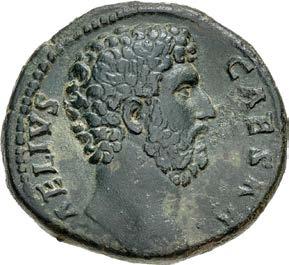

538. Aelius. Caesar, AD 136-138. Æ Sestertius (31.5mm, 25.70 g, 6h). Rome mint. Struck under Hadrian, AD 137. Bare head right / Pannonia standing left, holding vexillum and hitching robe. RIC II.3 2656; Banti 14. Green patina, traces of earthen deposits. VF. ($750)
Ex Tauler & Fau 103 (1 February 2022), lot 1574.
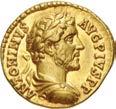


539. Antoninus Pius. AD 138-161. AV Aureus (19mm, 6.35 g, 6h). Rome mint. Struck AD 145-147. Laureate, draped, and cuirassed bust right / Felicitas standing left, holding capricorn and long caduceus. RIC III 131; Calicó 1513; Leu Numismatik Web Auction 6, lot 967 (same dies). Lustrous, traces of deposits. Good VF. ($3000)
From the Wayne Scheible Collection.


540. Antoninus Pius. AD 138-161. Æ Sestertius (31mm, 24.54 g, 12h). Rome mint. Struck AD 147-148. Laureate head right / Antoninus Pius seated left on platform on right, extending right hand; on platform to left, Liberalitas standing left, holding abacus and cornucopia; below, citizen standing right holding up fold of toga with both hands to receive distribution. RIC III 775; Banti 214. Dark brown patina, some minor smoothing. Good VF. ($500)
Ex Nomos 25 (20 November 2022), lot 294.
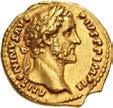
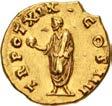
541. Antoninus Pius. AD 138-161. AV Aureus (18mm, 7.40 g, 6h). Rome mint. Struck AD 155-156. Laureate head right / Antoninus Pius standing left, holding globe and volumen. RIC III 256a; Calicó 1673; Adda 220 (same dies). Toned, a few shallow scratches. Good VF. ($2000)
Ex Goldberg 126 (15 February 2022), lot 814.



542. Faustina Senior. Augusta, AD 138-140/1. AV Aureus (18.5mm, 7.08 g, 6h). Rome mint. Struck under Antoninus Pius, circa AD 138-141. Draped bust left, wearing hair bound in pearls on top of her head / Vesta seated left, holding palladium and scepter. RIC III 334 (Pius); Calicó 1807. Slight wave in flan, traces of deposits, minor marks. VF. Rare. ($2000)
From the Wayne Scheible Collection.



543. Diva Faustina Senior Died AD 140/1. AV Aureus (19mm, 7.13 g, 7h). Rome mint. Struck under Antoninus Pius, circa AD 145-147. Draped bust right, wearing hair bound in pearls on top of her head / Ceres standing left, holding torch and scepter. RIC III 356 (Pius); Beckmann dies df63/CA18, a (this coin referenced); Calicó 1763b. Good VF. ($3000)
From the Wayne Scheible Collection. Ex Berk BBS 63 (29 August 1990), lot 8.



544. Diva Faustina Senior. Died AD 140/1. AV Aureus (20.5mm, 7.33 g, 6h). Rome mint. Struck under Antoninus Pius, circa 146-161. Draped bust right, wearing hair bound in pearls on top of her head / Ceres, veiled, standing left, holding torch in outstretched right hand and cradling scepter in left arm. RIC III 356a (Pius); Beckmann dies df1/CA11; Strack 469; Calicó 176a; BMCRE 395 and 397 (Pius); Biaggi 812. Hint of die rust. EF. ($3000)
From the Fendi Collection.

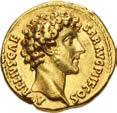
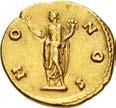

545. Marcus Aurelius. As Caesar, AD 139-161. AV Aureus (19mm, 6.98 g, 6h). Rome mint. Struck under Antoninus Pius, AD 140-144. AVRELIVS CAE SAR AVG PII F COS, bare head right / HO NOS, Honos, togate, standing left, holding branch in raised right hand and cradling cornucopia in left arm. RIC III 422 (Pius); Calicó 1864 (same dies as illustration); BMCRE 263 (Pius – same dies); Biaggi 852 (same dies). Lustrous. Good VF. Extremely rare, one of two in CoinArchives. ($5000)
From the Fendi Collection. Ex Classical Numismatic Group 100 (7 October 2015), lot 1888.
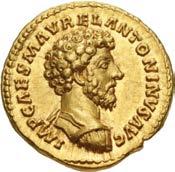
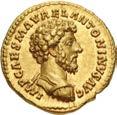


546. Marcus Aurelius. AD 161-180. AV Aureus (19mm, 7.33 g, 6h). Rome mint. Struck AD 161. IMP CΛES M ΛVREL ΛNTONINVS ΛVG, bareheaded and cuirassed bust right / CONCORDIΛE ΛVGVSTOR TR P XV around, COS III in exergue, Marcus Aurelius and Lucius Verus, both togate, standing facing each other, clasping right hands, each holding volumen in left hand. RIC III 9; MIR 18, 15-2/15; Calicó 1823 (same obverse die); BMCRE p. 386, note 7; Adda 257 (this coin). Lustrous. Choice EF. ($5000)
From the Wayne Scheible Collection. Ex Numismatica Ars Classica 7 (1 March 1994), lot 748; Distinguished American Collection (Leu 52, 15 May 1991), lot 205; Victor A. Adda (†1965) Collection (Christie, Manson & Woods, 7 October 1986), lot 236.
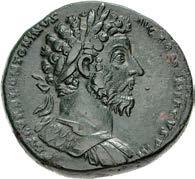

547. Marcus Aurelius. AD 161-180. Æ Sestertius (32mm, 25.32 g, 12h). Rome mint. Struck AD 164. Laureate and cuirassed bust right / Victory advancing right, holding trophy in both hands; at feet to right, Armenia seated right in attitude of mourning. RIC III 891; MIR 18, 95-6/35; Banti 490. Green patina, some red, smoothing. Good VF. Excellent portrait. ($500)
Ex Leu Numismatik Web Auction 20 (16 July 2022), lot 2486; G. Hirsch 317 (18 February 2016), lot 2183; G. Hirsch 300 (24 September 2014), lot 157.


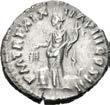
548. Marcus Aurelius. AD 161-180. AR Denarius (18mm, 3.24 g, 6h). Rome mint. Struck AD 165. Laureate and cuirassed bust left / Annona standing left, holding cornucopia and grain ears over modius; prow to lower right. RIC III 142 var. (bust type); MIR 18, 115-4/45; RSC 484 var. (same). Toned, struck with worn revesre die. Near EF. Rare with bust left. ($500)
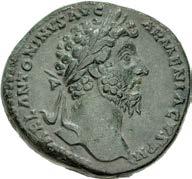

549. Marcus Aurelius. AD 161-180. Æ Sestertius (31.5mm, 24.40 g, 11h). Rome mint. Struck AD 165. Laureate head right / Marcus Aurelius, in military dress, standing left, raising right hand and holding spear; two signa to left, two signa to right. RIC III 909; MIR 18, 96-6/30; Banti 424. Attractive green patina. VF. ($750)
Ex Leu Numismatik Web Auction 20 (16 July 2022), lot 2487; Artemide LV (24 April 2021), lot 462.



550. Faustina Junior. Augusta, AD 147-175. AV Aureus (19mm, 6.75 g, 5h). Rome mint. Struck under Marcus Aurelius and Lucius Verus, circa AD 161. Draped bust left / Diana Lucifera, wearing crescent on head, draped, standing left, holding transverse, lighted torch in both hands. RIC III 673 (Aurelius); Beckmann, Faustina, dies fm43/D2; MIR 18, 7-2/20a; Calicó 2051 (same rev. die as illustration). Near EF. ($3000)
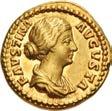


551. Faustina Junior. Augusta, AD 147-175. AV Aureus (18.5mm, 7.00 g, 5h). Rome mint. Struck under Marcus Aurelius and Lucius Verus, circa AD 161. Draped bust right / Juno standing left, holding child on left arm and extending right downward; at her sides, two children, both standing left and raising right hands. RIC III 692 (Aurelius); Beckmann, Faustina, dies fm64/IL5; MIR 18, 18-2a; Calicó 2064. Edge nick. Good VF. ($2000)



552. Faustina Junior. Augusta, AD 147-175. AV Aureus (20mm, 6.89 g, 6h). Rome mint. Struck under Marcus Aurelius and Lucius Verus, circa AD 161. Draped bust left / Juno standing left, holding child on left arm and extending right downward; at her sides, two children, both standing left and raising right hands. RIC III 693 (Aurelius); Beckmann, Faustina, dies fm61/ IL3; MIR 18, 18-2/20a; Calicó 2065 (same dies as illustration). Toned. Good VF. ($3000)
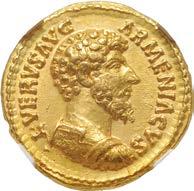


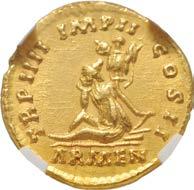
553. Lucius Verus. AD 161-169. AV Aureus (19mm, 7.35 g, 6h). Rome mint. Struck under Marcus Aurelius and Lucius Verus, AD 164. • L • VERVS ΛVG ΛRMENIΛCVS, bareheaded and cuirassed bust right / TR P IIII IMP II COS II, ΛRMEN in exergue, Armenia, wearing cloak, breeches and pointed cap, seated left in attitude of mourning, propping head on right hand, left hand on bow and quiver; to right, behind her, trophy. RIC III 508 (Aurelius); MIR 18, 68-12/15 corr. (obv. legend); Calicó 2107 (same dies as illustration); BMCRE 297 note (Aurelius and Verus); Biaggi 947 (same dies); Mazzini 7 (same dies). In NGC encapsulation 2154299-011, graded Ch XF, Strike: 5/5, Surface: 4/5. ($5000)




554. Lucilla. Augusta, AD 164-182. AV Aureus (21mm, 7.22 g, 12h). Rome mint. Struck under Marcus Aurelius and Lucius Verus, AD 161-162. Draped bust right / Venus standing left, holding apple and scepter. RIC III 783 (Aurelius); MIR 18, 16-2(a); Calicó 2218 (same dies as illustration); Adda 359 (same dies); Biaggi 978 (same dies); Mazzini 69 (same dies). Scrapes on reverse and on edge. Good VF. ($4000)
From the Wayne Scheible Collection.

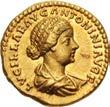


555. Lucilla. Augusta, AD 164-182. AV Aureus (18mm, 6.82 g, 12h). Rome mint. Struck under Marcus Aurelius and Lucius Verus, AD 161-162. LVCILLΛE ΛVG ΛNTONINI ΛVG F, draped bust right / VOTΛ/ PVBLI/CΛ in three lines within laurel wreath. RIC III 790 (Aurelius); MIR 18, 22-2(a); Calicó 2219b (same dies as illustration); BMCRE 328 (Marcus Aurelius and Lucius Verus); Adda 360; Biaggi 979-80; Mazzini 97 (same obv. die). Near EF. ($5000)
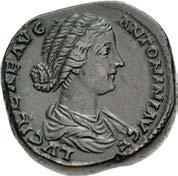

556. Lucilla. Augusta, AD 164-182. Æ Sestertius (29mm, 29.26 g, 6h). Rome mint. Struck under Marcus Aurelius and Lucius Verus, AD 161-162. Draped bust right / Hilaritas standing left, holding long palm frond and cornucopia. RIC III 1742 (Aurelius); MIR 18, 7-6a; Banti 18. Brown patina. Good VF. ($500)
Ex Naville II (12 June 1922), lot 1008.


557. Lucilla. Augusta, AD 164-182. Æ Sestertius (31mm, 26.78 g, 5h). Rome mint. Struck under Marcus Aurelius and Lucius Verus, AD 161-162. Draped bust right / Pietas standing left, holding acerra (incense box) and sacrificing over lighted and garlanded altar to left. RIC III 1756 (Aurelius); MIR 18, 11-6a; Banti 33. Green-brown patina, edge split. VF. ($750)
Ex A. Cahn 40 (23 February 1920), lot 608.


558. Lucilla. Augusta, AD 164-182. Æ Sestertius (30mm, 20.87 g, 6h). Rome mint. Struck under Marcus Aurelius and Lucius Verus, AD 161-162. Draped bust right / Pietas standing left, holding acerra (incense box) and sacrificing over lighted and garlanded altar to left. RIC III 1756 (Aurelius); MIR 18, 11-6a; Banti 33. Exceptional green patina, slightly granular surfaces, encrustation on reverse. Near VF. ($500)
Ex Numismatica Ars Classica I (19 May 1999), lot 2093; Santamaria [18] (25 May 1926), lot 546.

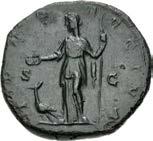
559. Lucilla. Augusta, AD 164-182. Æ As (24mm, 11.65 g, 6h). Rome mint. Struck under Marcus Aurelius and Lucius Verus, mid AD 164. Draped bust right / Juno standing left, holding patera and scepter; at feet to left, peacock standing left. RIC III 1752 (Aurelius); MIR 18, 35-7c. Dark green-brown patina. VF. ($500)
Ex Leo Benz Collection (Lanz 94, 22 November 1999), lot 661; Leu 22 (8 May 1979), lot 283; Clarence S. Bement Collection (Ars Classica VIII, 25 June 1924), lot 1093; Egger XXXIX (15 January 1912), lot 1048.


560. Commodus. AD 177-192. Æ Medallion (38.5mm, 52.35 g, 12h). Rome mint. Struck AD 184-185. Laureate and draped bust right / Commodus, veiled and togate, sacrificing over a tripod, accompanied by four robed citizens. On the left, two men, one of whom plays a double tibia, a young boy, and the victimarius preparing to sacrifice a bull; hexastyle temple in background. Gnecchi 168, pl. 89, 4 (same dies as illustration); MIR 18, 1110-2/34; Banti 504 (same dies as illustration). Dark brown patina, some pitting and corrosion, smoothing, tooling. VF. Rare. ($2000)
Ex Künker eLive 67 (19 July 2021), lot 300.

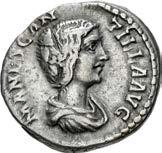

561. Manlia Scantilla. Augusta, AD 193. AR Denarius (18mm, 3.02 g, 12h). Rome mint. Struck under Didius Julianus. Draped bust right / Juno standing left, holding patera and scepter; at feet, peacock standing left. RIC IV 7a (Julianus); RSC 2. Toned, traces of deposits. VF. ($1000)
Ex Classical Numismatic Group 45 (18 March 1998), lot 2154.

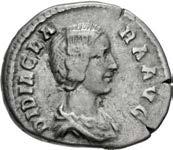

562. Didia Clara. Augusta, AD 193. AR Denarius (18.5mm, 3.09 g, 6h). Rome mint. Struck under Didius Julianus. Draped bust right / Hilaritas standing left, holding long palm frond and cornucopia. RIC IV 10 (Julianus); RSC 3. Toned. VF. ($1000)

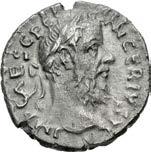

563. Pescennius Niger. AD 193-194. AR Denarius (16.5mm, 2.00 g, 6h). Antioch mint. IMP CAES C PESC NIGER IVST, laureate head right / CERERI FRVFER [sic], Ceres standing left, holding long and lighted torch with both hands. RIC IV –; RSC –; Leu Numismatik Web Auction 23, lot 3836 (same dies). Light porosity. VF. Rare. ($750)
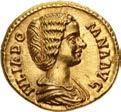

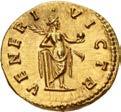
564. Julia Domna. Augusta, AD 193-217. AV Aureus (19.5mm, 7.29 g, 6h). Rome mint. Struck under Septimius Severus, circa AD 193-196. IVLIA DO MNA AVG, draped bust right / VENERI • VICTR, Venus Victrix, with drapery falling below hips, standing with back turned, head right, resting left arm on low column, holding apple in extended right hand and in left, palm frond sloped upward to left. RIC IV 536 (Septimius); Calicó 2641; BMCRE 48 (Wars of Succession; same obv. die); Adda 412 (same obv. die); Biaggi 1155; Jameson 173 (same obv. die). Lightly toned, small flan flaw on obverse. Superb EF. Wonderful portrait. ($7500)
From the Wayne Scheible Collection.
Illustrated in Biaggi’s Le Preziose Patine
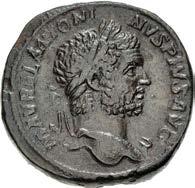


565. Caracalla. AD 198-217. Æ Sestertius (32mm, 28.73 g, 11h). British Victory type. Rome mint. Struck AD 211. Laureate bust right, slight drapery / Victory erecting trophy, foot set on helmet; on right, Britannia with hands behind back; at her feet, a captive seated left. RIC IV 483d var. (rev. legend); Banti 133; SCBC 659A; Biaggi, Le Preziose Patine 485 (this coin illustrated). Brown patina, some erosion spots. VF. ($1000)
From the Dr. Malcolm Lyne Collection. Ex ArtCoins Roma 15 (27 April 2015), lot 699.
Septimius Severus died in Eboracum (York) in 211 during the British campaign. Upon the death of his father, Caracalla made peace with the hostile Caledonians and determined to return to Rome. Under the terms of the peace, the Romans removed to the southern side of Hadrian’s wall which had recently been repaired by the Severans. While ‘victory’ was a generous term for the ultimate arrangement, the occasion of the successful British campaign was sufficient cause for Caracalla and Geta to continue striking issues commemorating the British Victory.


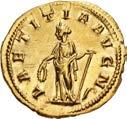

566. Gordian III. AD 238-244. AV Aureus (20.5mm, 4.88 g, 12h). Rome mint, 3rd officina. 8th-11th emissions, late AD 240-early 243. Laureate, draped, and cuirassed bust right / Laetitia standing left, holding wreath in right hand, left hand placed on grounded anchor to right. RIC IV 101; Calicó 3202a (same dies as illustration); Biaggi 1359. Lustrous, a few shallow scratches. EF. ($3000)
From the Wayne Scheible Collection.




567. Philip I. AD 244-249. AV Aureus (21mm, 4.59 g, 6h). Rome mint. 3rd emission, AD 245-247. IMP M IVL PHILIPPVS AVG, laureate, draped, and cuirassed bust right / ANNONA AVGG, Annona, draped, standing left, holding cornucopia in left hand and grain ears in right over modius filled with grain ears set on ground to left. RIC IV 28a; Bland, Gold 24g (dies PI 27/Annona 02 – this coin); Calicó 3246 (this coin illustrated); Biaggi 1378. Minor scratches and hairlines, a few edge marks. Good VF. ($7500)
From the Wayne Scheible Collection. Ex Berk BBS 150 (8 August 2006), lot 9; Numismatica Ars Classica 33 (6 April 2006), lot 558; Münzen und Medaillen AG XVII (2 December 1957), lot 542.


568. Trajan Decius. AD 249-251. Æ Double Sestertius (36mm, 43.70 g, 12h). Rome mint, 4th officina. 3rd emission, AD 250. Radiate and cuirassed bust right / Felicitas standing left, holding long caduceus and cornucopia. RIC IV 115a; Banti 9. Green patina, some cleaning scratches and earthen deposits. VF. ($1000)
Ex Classical Numismatic Group 38 (6 June 1996), lot 1107; Gilbert Steinberg Collection (Numismatica Ars Classica/Spink Tasei, 16 November 1994), lot 690.
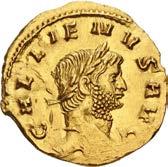



569. Gallienus. AD 253-268. AV Aureus (18.5mm, 2.88 g, 12h). Rome mint. 7th emission, AD 262. Laureate head right / Laetitia standing left, holding wreath and anchor. RIC IV 54 var. (bust type); MIR 36, 479c; Calicó 3532 (this coin illustrated). Hairlines. EF. ($3000)
From the Wayne Scheible Collection. Ex Numismatics Fine Arts XXVI (14 August 1991), lot 292; Munzen und Medaillen AG 66 (22 November 1984), lot 825.




570. Gallienus. AD 253-268. AR Denarius (19.5mm, 2.42 g, 12h). Rome mint. 8th emission, circa AD 264-265. GALLIENVS P F A VG, bust left, wearing crested Corinthian helmet and cuirass decorated with an aegis on the breast, balteus across chest, holding in right hand a spear over his far shoulder, shield decorated with aegis on left arm / P M T P XIII C VI P P [sic], Mars, holding transverse spear in right hand and round shield in left, descending right through the air to Rhea Silvia, who is reclining, naked to waist, asleep on the ground, hands behind her head. Cf. MIR 36, 945-6 for reverse type with alternate legends; CNG 114, lot 977 (same dies; hammer $27,500). Toned, slightly granular surfaces. Good VF. The second known example. ($7500)
The reverse type of this coin has been studied by Jean-Marc Doyen (Recherches sur la chronologie et la politique monétaire des empereurs Valérien et Gallien, vol. 2a: Etude des émissions monétaires de Milan, PhD thesis, Louvain-la-Neuve 1989, pp. 101-3, available online), and it is copied from a rare series of Antoninus Pius, struck in AD 140 (as ref. RIC III 694a and aureus ref. Calicó 1689), which celebrated with some advance the 900th birthday of Rome. It was first used by Gallienus in 260, with the legend TRIB POT VIII COS III and a laureate bust left, on a coin struck in Mediolanum (Milan) (ref. MIR 36, 945gg = Doyen 49), and again with the legend TRIB POT COS IIII (MIR 36, 946gg = Doyen 71). It shows Mars descending toward Rhea Silvia, daughter of King Numitor and a Vestal virgin who is depicted as sleeping in the forest, just before raping her. This mythological episode (told by Ovid, Fast. III.V.11 and Livy, Ab Urbe Condita I) is of the utmost importance for the story of Rome, as the intercourse led to the conception of the twins Romulus and Remus, legendary founders of Rome. The same iconography can be found on wall paintings from Pompeii and in the baths of Titus (see LIMC II/1 pp. 459-51 and II/2 pls 415-6), but also on mosaics, reliefs, silverware, and gems.


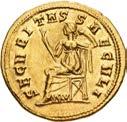

571. Probus. AD 276-282. AV Aureus (20.5mm, 5.51 g, 12h). Cyzicus mint. 3rd emission, AD 280-282. Laureate, draped, and cuirassed bust right / Securitas seated left, holding scepter, elbow on back of chair, raising hand to head. RIC V 896; Pink VI/1, p. 44; Calicó 4191. A couple of small flat spots on edge. Good VF. ($3000)
From the Wayne Scheible Collection.


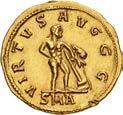
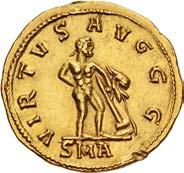
572. Numerian. As Caesar, AD 282-283. AV Aureus (20mm, 4.27 g, 11h). Antioch mint. 2nd emission, last third of February, AD 283. IMP C M AVR NVMERIANVS NOB C, laureate, draped, and cuirassed bust right / VIRTVS AVGGG, Hercules, naked, standing right, right hand behind back, and with left, leaning on club, lion skin over left arm; SMA. RIC V 375; Pink VI/2, p. 55; Calicó 4339 (no photo or line drawing); Perret (pub. 1958) 132 (this coin). Some scratches, hairlines, traces of deposits, edge marks/scrapes. Good VF. Very rare. ($6000)
From the Wayne Scheible Collection. Ex Gemini III (9 January 2007), lot 445; 445; R. Perret Collection (Leu 91, 10 May 2004), lot 659.

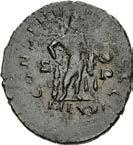
573. Diocletian. AD 284-305. Antoninianus (22mm, 4.02 g, 6h). Londinium (London) mint. Struck under Carausius, circa AD 286-circa 293. IMP C DIOCLETIANVS P F AVG, radiate, draped, and cuirassed bust right / CONSERV AT AVGGG, Hercules standing right, holding club set on ground to left and lion’s skin and globe; S|P//MLXXI. RIC V.5 3537 (forthcoming); RIC V, p. 551, 3 (this coin cited and illustrated); Bourne 9. Toned trace silvering and dark green-brown patina, minor rough deposits. VF. Extremely rare. ($750)
From the Dr. Malcolm Lyne Collection. Ex Baldwin’s 100 (27 September 2016), lot 869; Richard Cyril Lockett Collection (Part I, Glendining, 6 June 1955), lot 181 (part of), purchased from P. Webb.




574. Diocletian. AD 284-305. AV Aureus (19.5mm, 5.35 g, 6h). Vicennalia issue. Nicomedia mint. Struck AD 303. DIOCLETIA NVS AVGVSTVS, laureate head right / XX/ DIOCL/ETIAN/I AVG in four lines within wreath; SMN. RIC VI 13; Depeyrot 7/2; Calicó 4593; Biaggi 1750. Lustrous, tiny spot of die rust on obverse. EF. The wreath strangely inverted on the reverse. ($5000)




575. Diocletian. AD 284-305. AV Aureus (18.5mm, 5.27 g, 7h). Cyzicus mint. Struck AD 291. DI OCLETIANVS AVGVSTVS, laureate head right / CONSVL IIII P P PROCOS, Diocletian, togate, standing left, holding globe and short vertical scepter. RIC V 285; Depeyrot 11/1; Calicó 4434. Lustrous. EF. ($5000)
From the Wayne Scheible Collection. Ex Berk BBS 86 (11 July 1995), lot 25.
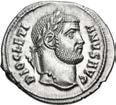

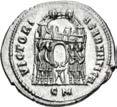
576. Diocletian. AD 284-305. AR Argenteus (18.5mm, 3.33 g, 12h). Cyzicus mint. Struck circa AD 294-295. Laureate head right / The tetrarchs sacrificing over tripod before city gate with six turrets; CM. RIC VI 5a; Gautier, Argent 7d (this coin, illustrated); RSC 490b. Lustrous. Superb EF. Rare. ($750) Ex Classical Numismatic Group 38 (6 June 1996), lot 1140.


577. Maximianus. First reign, AD 286-305. Antoninianus (24mm, 4.33 g, 6h). Londinium (London) mint. Struck under Carausius, circa AD 286-circa 293. IMP C MAXIMIANVS P F AVG, radiate and cuirassed bust left, holding spear over shoulder and shield / PA X AVG, Pax standing left, holding olive branch and transverse scepter; S|P//MLXXI. RIC V.5 3612 (forthcoming; this coin cited and illustrated); RIC V –; Bourne –. Green-blue and brown patina, light roughness. VF. Unique. The only example noted in RIC V.5. ($500)
From the Dr. Malcolm Lyne Collection, purchased from David Miller, 14 December 2005.
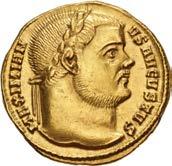


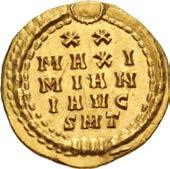
578. Maximianus. First reign, AD 286-305. AV Aureus (18.5mm, 5.35 g, 12h). Vicennalia issue. Ticinum mint. Struck AD 303-304. MAXIMIAN VS AVGVSTVS, laureate head right / XX/ MAXI/MIAN/I AVG in four lines within wreath; SMT. RIC VI 11b; Depeyrot 7/2; Calicó 4770; Biaggi –. Toned, light scratches. EF. Very rare. ($5000)
From the Ramrodivs Collection. Ex Gemini XI (12 January 2014), lot 526.

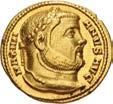


579. Maximianus. First reign, AD 286-305. AV Aureus (18.5mm, 5.74 g, 6h). Siscia mint. Struck AD 293. MAXIMI ANVS AVG, laureate head right / HERCVLI PACIFERO, Hercules standing left, holding olive branch, lion’s skin, and club; *SIS. RIC VI 13; Depeyrot 4/3; Calicó 4665; Biaggi –. Toned, edge marks, minor deposits. Near EF. Extremely rare. ($5000)
From the Wayne Scheible Collection. Ex Gemini III (9 January 2007), lot 451.
The first group from this outstanding collection appeared in Triton XXVII. This is a subsequent offering of coins from this very impressive collection of British issues, which includes many incredible rarities of the Romano-British usurpers Carausius and Allectus. These coins are almost exclusively extremely rare or very rare. Furthermore, many unique coins are being offerered here as well. As such, individual headers indicating rarity have been forgone in this section. Classical Numismatic Group would once again like to thank Sam Moorhead for the updated forthcoming RIC V.5 reference numbers for these coins.



580. Carausius. Romano-British Emperor, AD 286-293. AR Denarius (17.5mm, 2.57 g, 6h). ‘RSR’ mint. Laureate and draped bust right / Clasped right hands; RSR. RIC V.5 50 (forthcoming); RIC V 548; cf. Shiel pp. 101-2, 16-19. Toned, slightly bent, porosity, a couple of old scrapes, scratches. VF. Rare. ($1000)
From the Dr. Malcolm Lyne Collection, purchased from David Miller, 25 October 2013.



581. Carausius. Romano-British Emperor, AD 286-293. AR Denarius (17.5mm, 2.78 g, 6h). ‘RSR’ mint. IMP CARAVSIVS P F AV, laureate and draped bust right / RENOVAT RVMANO, She-wolf standing right, head facing, suckling the twins (Romulus and Remus); RSR. RIC V.5 121 (forthcoming); RIC V 571; cf. Shiel p. 111, 68-72. Toned, find patina, light roughness, minor scratches. VF. Very rare. ($1500)
From the Dr. Malcolm Lyne Collection, purchased from Baldwin’s, August 2001.

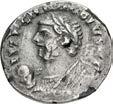


582. Carausius. Romano-British Emperor, AD 286-293. Fourrée Denarius (18.5mm, 3.05 g, 12h). Imitating an official issue of the ‘RSR’ mint. IMP CARAVSIVS AVG, laureate and trabeate bust left, holding globe / VBERITA AV, woman milking cow standing right, head facing; RSR. RIC V.5 154 note (forthcoming); cf. RIC V 582 (for official issue); cf. Shiel p. 114, 87 (same). Toned, chips in plating. VF. Extremely rare. ($1000)
From the Dr. Malcolm Lyne Collection, purchased from David Miller, 26 September 2019.


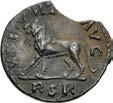

583. Carausius. Romano-British Emperor, AD 286-293. AR Denarius (18mm, 2.29 g, 2h). ‘RSR’ mint. IMP [CAR] AVSIVS P F AV, laureate, draped, and cuirassed bust right / VIRT[VS] AVG, lion walking left; RSR. RIC V.5 168 (forthcoming; this coin cited and illustrated); cf. RIC V 592 (for similar); Shiel –. Toned, chipped, minor scratches, deposits. Good VF. Unique. The only example noted in RIC V.5. ($1500)
From the Dr. Malcolm Lyne Collection. Ex Dix Noonan Webb 184 (3 November 2020), lot 571; found at Alton Pancras, Dorset, 2019 (PAS ID FASAM-45F1EE).


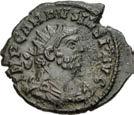
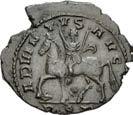
584. Carausius. Romano-British Emperor, AD 286-293. AR Denarius (20.5mm, 3.87 g, 6h). ‘RSR’ mint. IMP C CARAVSIVS P F A, laureate and draped bust right / REVNOVAT SAEC, Carausius standing left, holding scepter and raising up kneeling figure of Britannia to left; altar between; RSR. RIC V.5 288 (forthcoming; this coin cited and illustrated); RIC V –; Shiel –. Toned, roughness. Near VF. Unique, the only example noted in RIC V.5. ($750)
From the Dr. Malcolm Lyne Collection, purchased from David Miller, 8 June 2016.
585. Carausius. Romano-British Emperor, AD 286-293. Antoninianus (20.5mm, 2.90 g, 12h). ‘RSR’ mint. IMP CARAVSIVS P AVG, radiate and draped bust right / ADVENTVS AVG, Carausius on horseback riding left, raising hand and holding transverse scepter; RSR. RIC V.5 527 (forthcoming; this coin cited and illustrated); cf. RIC V 598 (for similar). Dark green and brown patina. Good VF. Unique. The only example noted in RIC V.5. ($500)
From the Dr. Malcolm Lyne Collection. Ex Collection of a Classicist (Baldwin’s 99, 4 May 2016), lot 751.
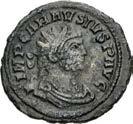
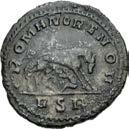
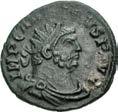

586. Carausius. Romano-British Emperor, AD 286-293. Antoninianus (21.5mm, 3.21 g, 9h). ‘RSR’ mint. IMP CARAVSIVS P AVG, radiate and draped bust right / ROMANO RENOV, She-wolf standing right, head facing, suckling the twins (Romulus and Remus); RSR. RIC V.5 601 (forthcoming); cf. RIC V 615. Toned, horn silver, light roughness, smoothing scratches. VF. Very rare. ($500)
From the Dr. Malcolm Lyne Collection, purchased from David Miller, 20 August 2008. 587. Carausius. Romano-British Emperor, AD 286-293. Antoninianus (19mm, 2.95 g, 9h). ‘RSR’ mint. IMP CARAVSIVS P AVG, radiate, draped, and cuirassed bust right / ROMANO RENOV, She-wolf standing right, head facing, suckling the twins (Romulus and Remus); RSR. Cf. RIC V.5 603 (forthcoming); RIC V 615 var. (obv. legend). Dark green patina, area of hard deposits. VF. Very rare. ($500)
From the Dr. Malcolm Lyne Collection. Ex Barry Feirstein Collection (Numismatica Ars Classica 42, 20 November 2007), lot 190.



588. Carausius. Romano-British Emperor, AD 286-293. AR Denarius (17.5mm, 2.75 g, 12h). Londinium (London) mint. IMP CARAVSIVS P F IN AVG, laureate and draped bust right / VIRT[VS IN] AVG, Carausius standing right, holding transverse spear and globe; L. RIC V.5 186 (forthcoming; this coin cited and illustrated); cf. RIC V 9; cf. Shiel p. 95, 2. Toned, find patina, minor scratches. VF. Unique. The only example noted in RIC V.5. ($1500)
From the Dr. Malcolm Lyne Collection, purchased from Spink, 21 March 2005.


589. Carausius. Romano-British Emperor, AD 286-293. AR Denarius (20.5mm, 4.13 g, 6h). Londinium (London) mint. IMP CARAVSIVS P F AVG, laureate and draped bust right / PA X A VG, Pax standing left, holding olive branch and transverse scepter; L|–//–. RIC V.5 187 (forthcoming); RIC V –; Shiel –. Toned, find patina, hairline flan crack, minor cleaning scratches. VF. Unique. The only example noted in RIC V.5. ($1000)
From the Dr. Malcolm Lyne Collection. Ex Spink 170 (6 October 2004), lot 252 (part of).
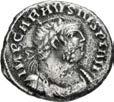
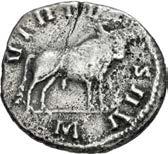

590. Carausius. Romano-British Emperor, AD 286-293. AR Denarius (18.5mm, 3.19 g, 6h). Londinium (London) mint. IMP CARAVSIVS P F AV, laureate, draped, and cuirassed bust right / VIRTV S AV, bull standing right; M. RIC V.5 189 (forthcoming; this coin cited and illustrated); RIC V –; Shiel –. Toned, flan crack, porosity, minor scratches. Near VF. Unique. The only example noted in RIC V.5. ($1000)
From the Dr. Malcolm Lyne Collection. Ex Noonans 184 (3 November 2020), lot 573 (hammer £7,000).


591. Carausius. Romano-British Emperor, AD 286-293. Antoninianus (19.5mm, 3.07 g, 6h). Legionary issue. Londinium (London) mint. Radiate and draped bust right / LEG XXX VLPIA, Neptune, nude, standing left, holding dolphin and trident. RIC V.5 1073 (forthcoming); RIC V 84. Dark green and brown patina. VF. Very rare. ($750)
From the Dr. Malcolm Lyne Collection, purchased from David Miller, 18 August 2017.
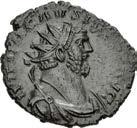


592. Carausius. Romano-British Emperor, AD 286-293. Antoninianus (22mm, 3.24 g, 8h). Legionary issue. Londinium (London) mint. Radiate, draped, and cuirassed bust right / LEG II PARTH, centaur walking left, holding globe and rudder; ML. RIC V.5 1888 (forthcoming); RIC V 62. Dark olive brown patina, slight porosity, light cleaning scratches. Near EF. Very rare. ($750)
From the Dr. Malcolm Lyne Collection, purchased from Spink, 18 November 2003.

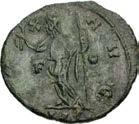


593. Carausius. Romano-British Emperor, AD 286-293. Antoninianus (22.5mm, 3.69 g, 12h). Londinium (London) mint. Radiate and cuirassed bust left, holding eagle-tipped scepter / Pax standing left, holding olive branch and vertical scepter; F|O//ML. RIC V.5 2048 (forthcoming); RIC V 104. Green patina. VF. Extremely rare. ($500)
From the Dr. Malcolm Lyne Collection. Ex Roma XIII (23 March 2017), lot 1135.
594. Carausius. Romano-British Emperor, AD 286-293. Antoninianus (22mm, 4.70 g, 6h). Londinium (London) mint. IMP C CARAVSIVS P F AVG, radiate, draped, and cuirassed bust right / SALV S AVG, Salus standing right, feeding serpent held in arms from patera; S|P//ML. RIC V.5 2242 (forthcoming); RIC V –. Toned, near complete silvering with some spots of verdigris. Near EF. Very rare. ($500)
From the Dr. Malcolm Lyne Collection. Ex Gemini I (11 January 2005), lot 441.




595. Carausius. Romano-British Emperor, AD 286-293. Antoninianus (20mm, 2.50 g, 12h). Rotomagus (Rouen) mint. IMP C CARAVSIVS A, radiate, draped, and cuirassed bust right / TVTEL A AVG, Tutela standing left, dropping incense into altar to left and holding cornucopia; IOI. RIC V.5 473 (forthcoming); cf. RIC V 684. Dark brown patina with green highlights. Near EF. ($500)
From the Dr. Malcolm Lyne Collection, purchased from David Miller, 22 July 2020. Lot includes an old ticket from Spink & Son.
596. Carausius. Romano-British Emperor, AD 286-293. Antoninianus (23.5mm, 3.78 g, 6h). ‘C’ mint. Radiate, helmeted, and cuirassed bust left, holding spear over shoulder and shield / LIBERALITAS AVG, Carausius, seated left on curule chair on low platform, holding olive branch; to right, Liberalitas standing left holding tesserae and cornucopia; to left, citizen ascending steps to platform; C. RIC V.5 2427 (forthcoming); RIC V 278. Dark green and brown patina. Near VF. Extremely rare. ($500)
From the Dr. Malcolm Lyne Collection. Ex Roma XIII (23 March 2017), lot 1162.




597. Carausius. Romano-British Emperor, AD 286-293. Antoninianus (24mm, 4.68 g, 7h). ‘C’ mint. IMP CARAVSIVS P AVG, radiate and draped bust right / PACI FER AVG, Hercules, nude, standing left, holding olive branch and lion’s skin and club; C. RIC V.5 2465 (forthcoming; this coin cited and illustrated); RIC V –. Toned partial silvering and olive patina. Good VF. Unique. The only example noted in RIC V.5. A wonderful strike and a lovely coin in hand. ($750)
From the Dr. Malcolm Lyne Collection, purchased from David Miller, 22 July 2020.
598. Carausius. Romano-British Emperor, AD 286-293. AR Denarius (20mm, 3.35 g, 6h). Uncertain mint. IMP CARAVSIVS P [...], laureate and draped bust right / CONCORD MILITV, Carausius standing right, clasping hands with Concordia, standing left. RIC V.5 230 (forthcoming); RIC V –; Shiel –. Toned, light horn silver, metal flaws, substantial flan crack. VF. Very rare. ($1500)
From the Dr. Malcolm Lyne Collection, purchased from Spink, 30 November 2012.



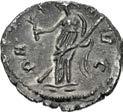
599. Carausius. Romano-British Emperor, AD 286-293. AR Denarius (17.5mm, 2.57 g, 12h). Uncertain mint. IMP CARAVSIVS P F AV, laureate and draped bust right / FORT V AVG, Fortuna standing left, holding rudder set on globe to left and cornucopia. RIC V.5 242 (forthcoming; this coin cited and illustrated); RIC V –; Shiel –. Toned, find patina, light porosity. VF. Unique; the only example noted in RIC V.5. ($1500)
From the Dr. Malcolm Lyne Collection, purchased from David Miller, 25 January 2011.
600. Carausius. Romano-British Emperor, AD 286-293. AR Denarius (19.5mm, 2.83 g, 5h). Uncertain mint. Laureate and draped bust right / Pax standing left, holding olive branch and transverse scepter. RIC V.5 267 (forthcoming); RIC V –; Shiel –. Attractive golden and iridescent toning, light porosity, deep scratch. VF. Very rare. ($1000)
From the Dr. Malcolm Lyne Collection, purchased from Baldwin’s, 22 July 2003.

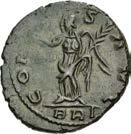


601. Carausius. Romano-British Emperor, AD 286-293. Antoninianus (21.5mm, 4.45 g, 8h). Uncertain mint. IMP CARAVSIVS P F AVG, radiate and draped bust right / COM [E] S AVG, Victory standing left, holding wreath and palm frond; BRI. RIC V.5 624 (forthcoming); RIC V –. Attractive green patina, slightly off center on reverse. Good VF. Extremely rare. ($750)
From the Dr. Malcolm Lyne Collection, purchased from David Miller, 18 August 2017.
602. Carausius. Romano-British Emperor, AD 286-293. Antoninianus (19.5mm, 3.16 g, 6h). Uncertain mint. IMP CARAVSIVS P F AVG, radiate, draped, and cuirassed bust right / INV I CTVS, Sol advancing left, raising hand and holding globe; star to left. RIC V.5 629 (forthcoming); cf. RIC V 807 (for similar issue). Dark brown-green patina. VF. Extremely rare. ($500)
From the Dr. Malcolm Lyne Collection, purchased from Spink, 21 October 2003.


603. Carausius. Romano-British Emperor, AD 286-293. Antoninianus (21mm, 3.96 g, 6h). Uncertain mint. IMP CARAVSIVS P AVG, radiate and draped bust right / AP OLLINI CONS, griffin walking left. RIC V.5 792 (forthcoming); RIC V 739 var. (obv. legend). Green patina, slight roughness. VF. Extremely rare. RIC 739 is R2 in RIC, none in CoinArchives for both 739 and this variety. ($500)
From the Dr. Malcolm Lyne Collection, purchased from Nigel Mills, 24 June 2004.



604. Carausius. Romano-British Emperor, AD 286-293. Antoninianus (22mm, 3.68 g, 7h). Uncertain mint. IMP CARAVSIVS P F AVG, radiate and draped bust right / IOVI STA[TORI], Jupiter standing left, head right, holding scepter and thunderbolt. RIC V.5 1006 (forthcoming); cf. RIC V 815 (for similar issue). Dark olive brown patina, somewhat off center on reverse. Good VF. Extremely rare. ($500)
From the Dr. Malcolm Lyne Collection, purchased from Spink, 15 February 2002.
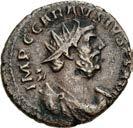

605. Carausius. Romano-British Emperor, AD 286-293. Antoninianus (21.5mm, 4.69 g, 6h). Uncertain mint. IMP C CARAVSIVS P F AVG, radiate and draped bust right / ADVENT V[S CARAVSI], Carausius on horseback riding left, holding a globe raised in both hands. RIC V.5 1063 (forthcoming; this coin cited and illustrated); RIC V 734 var. (obv. legend); P. Webb, “The Reign and Coinage of Carausius” in NC 1907, 824 var. (same); Hunter 208 var. (same; same rev. die). Dark red-brown patina with trace toning, slight roughness, off center on reverse. VF. Unique, The only example noted in RIC V.5. ($500)
From the Dr. Malcolm Lyne Collection, purchased from David Miller, 4 May 2010. RIC, Webb, and Hunter all refer to the same coin in the Hunter cabinet. That example is struck from the same reverse die as this coin, though with a different obverse legend variety, IMP CARAVSIVS AVG.
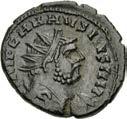

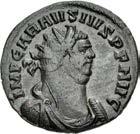

606. Carausius. Romano-British Emperor, AD 286-293. Antoninianus (20.5mm, 4.88 g, 7h). Uncertain mint. IMP CARAVSIVS AV, radiate and draped bust right / PAX AXG, Pax standing left, holding olive branch and vertical scepter. Cf. RIC V.5 1236 (forthcoming); RIC V 890. Attractive dark green patina, a touch off center. Good VF. ($500)
From the Dr. Malcolm Lyne Collection, purchased from David Miller, 20 October 2009. Reportedly ex 1907 Little Orme’s Head Hoard, North Wales.
607. Carausius. Romano-British Emperor, AD 286-293. Antoninianus (23mm, 4.03 g, 7h). Uncertain mint. IMP CARAVSIVS P F AVG, radiate, draped, and cuirassed bust right / PROV IDENTI, Providentia standing left, holding baton near globe at feet to left and cornucopia. RIC V.5 1487 (forthcoming); cf. RIC V 961 (for similar type). Dark brown patina with some olive-green and red highlights, a couple spots of weakness. Near EF. Rare. A wonderful flan and strike. Well centered and with excellent details. ($500)
From the Dr. Malcolm Lyne Collection, purchased from Spink, 20 August 2002.


608. Carausius. Romano-British Emperor, AD 286-293. Antoninianus (21.5mm, 4.37 g, 6h). Uncertain mint. [IMP] C M CARAVSIV[S ...], radiate and draped bust right / SAECVLI [FELICITA]S, Carausius standing right, wearing helmet and military attire, holding transverse spear and globe in outstretched hand. RIC V.5 1545 (forthcoming); RIC V 980 (this coin cited); P. Webb, “The Reign and Coinage of Carausius” in NC 1907, 1097 (this coin cited); CHRB III, 20469 = Lord Selborne, “On a Hoard of Roman Coins Found at Blackmoor, Hants” in NC 1877, 122 (this coin). Dark red-brown patina with some light green deposits, struck somewhat off center, areas of weakness, light scratch. VF. Extremely rare. ($500)
From the Dr. Malcolm Lyne Collection, purchased from David Miller, 29 October 2007. Ex The Blackmoor Hoard of Third Century Roman Bronze Coins (Christie’s, 9 December 1975), lot 291; Blackmoor, Selborne, October 1873 Hoard (IRBCH 914).
This coin bearing this uncommon obverse legend for the type is the same coin cited in each reference going back from RIC in 1933 to the 1907 NC and finally the 1877 NC detailing the Blackmoor Hoard. The hoard comprised over 4,000 coins including 545 for Carausius, 117 of which were new types unlisted in Cohen. This coin was not listed in Cohen and is detailed in the hoard catalog by Selborne as having the exact same weakness in both the obverse and reverse legend as is found on this coin. Additionally, the diameter given by Webb in his 1907 catalog is identical and the coin’s surfaces are consistent with other examples from the 1873 hoard. No other example of this coin has appeared at recent auction. This coin is verifiably the Lord Selborne coin detailed in 1877 and subsequently cited by Webb and the authors of RIC. The most detailed cataloging appears in the 1982 Coin Hoards from Roman Britain catalog of the Blackmooor Hoard – CHRB III. It was still with the Blackmoor Hoard collection held by the 4th Lord Selborne when the hoard was sold at Christie’s in 1975. Appearing as lot 291, this coin was illustrated in the catalog removing all doubt as to its incredible provenance.


609. Carausius. Romano-British Emperor, AD 286-293. Antoninianus (26mm, 3.81 g, 6h). Uncertain mint. IMP CARAVSIVS P F AVG, radiate, draped, and cuirassed bust right / VICT O RIA AVG, Victory walking left, holding wreath, at feet to left, bound captive seated left. RIC V.5 1688 (forthcoming); RIC V –. Even dark brown patina, minor spots of weakness. Good VF. Extremely rare. ($500)
From the Dr. Malcolm Lyne Collection, purchased from David Miller, 15 August 2008. Ex Dr. J. S. Vogelaar Collection (Spink 194, 26 March 2008), lot 1160.




610. Carausius. Romano-British Emperor, AD 286-293. Antoninianus (22.5mm, 3.32 g, 12h). ‘C’ mint (?). IMP C CARAVSIVS P F A, radiate, draped, and cuirassed bust right / PA X AVG, Pax standing left, holding olive branch and vertical scepter; C (?). RIC V –. Green patina, somewhat irregular flan. VF. ($500)
611. Carausius. Romano-British Emperor, AD 286-293. Antoninianus (23mm, 4.50 g, 12h). Uncertain mint. IMP CARAVSIVS P F AVGG, radiate and draped bust right / PA X AVG, Pax standing left, holding olive branch and spear; S|R//–. RIC V –. Dark green patina, irregular flan, smoothing scratches. Good VF. Extremely rare and unpublished. ($500)
An interesting coin. The obverse with the less common two GG’s at the end of the legend. On the reverse, Pax oddly holding a spear and with an unusual mint mark combination across the field.

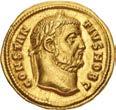


612. Constantius I. As Caesar, AD 293-305. AV Aureus (18.5mm, 5.63 g, 6h). Cyzcius mint. Struck AD 294. CONSTAN TIVS NOB C, laureate head right / FIDES M I LITVM, Fides standing facing, head right, holding vertical signum in right hand and transverse signum in left. RIC VI 1; Depeyrot 15/1; Calicó 4826 (same dies); Biaggi 1847 (same dies). Toned, edge marks, minor graffito, light hairlines, spot of light deposits, light scratch on reverse. Near EF. Very rare. ($5000)
Ex Bastien Collection and the 1922 Beaurains Hoard




613. Galerius. As Caesar, AD 293-305. AV Aureus (17mm, 5.24 g, 6h). Treveri (Trier) mint. Struck 20 November AD 303. MAXIMI ANVS NOB C, laureate head right / IOVI CONSERVAT AVGG ET CAESS NN, Jupiter, draped at waist, seated left on throne, holding thunderbolt and scepter; TR. RIC VI 53; Depeyrot 10B/3; Calicó 4914 (same dies as illustration); Beaurains 329 (this coin); Adda 560; Biaggi 1859 (same dies); Mazzini 121 (same dies). Wonderful reddish tone, light scrape on edge. Good VF. Rare. ($7500)
Ex Jonathan K. Kern Collection; Triton XXIV (29 January 2021), lot 1151; Pierre Bastien Collection (Part II, Numismatica Ars Classica 114, 6 May 2019), lot 855; Ciani & Vinchon (6 May 1955), lot 439; 1922 Arras – Beaurains Hoard.
The Beaurains (or Arras) Treasure is an important Roman coin hoard found in Beaurains, a suburb of Arras, France on 21 September 1922. Soon after its discovery by workmen in a clay pit much of the treasure was dispersed. A.B. Brett, in her article on the hoard in the 1933 Numismatic Chronicle, wrote that “its final reconstruction will be for ever impossible in an exact sense. The general composition of the hoard is, however, well known.” In 1977, P. Bastien (the previous owner of the present coin), along with C. Metzger, published a reconstruction of the hoard from the known coins in public collections, as well as a careful analysis of coins that had been offered in the market since 1922. Although they admit the corpus is not complete, they were able to catalog 472 aurei and medallions, and surmised that the original total was upwards of 700 pieces. Due to the composition of the hoard, the authors suggest that the hoarder must have been a soldier at Trier who was present for the many donativa that occurred between AD 285-310.
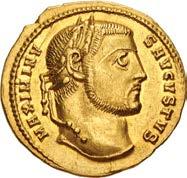



614. Maximinus II. AD 310-313. AV Aureus (20.5mm, 5.56 g, 12h). Thessalonica mint. Struck AD 310. Laureate head right / Jupiter standing left, nude but for chlamys draped over shoulder, holding thunderbolt and scepter; at feet to left, eagle standing left, head right, holding wreath in beak; –|%//•SM•TS•. RIC VI 44b; Depeyrot 5/3; Calicó 5016a; Biaggi 1893. Toned, hairlines, thin die break on obverse. Near EF. Rare. ($4000)
From the Wayne Scheible Collection. Ex Classical Numismatic Group 72 (14 June 2006), lot 1765; Rauch 76 (17 October 2005), lot 640.



615. Constantine I, with Crispus and Constantine II Caesars. AD 307/310-337. AR Miliarense (21mm, 4.08 g, 6h). Sirmium mint. Struck AD 320. CONSTANTINVS MAX AVG, bare head of Constantine I right / CRISPVS ET CONSTANTINVS CC, confronted bareheaded busts of Crispus and Constantine II; SIRM. RIC VII 14; Gnecchi p. 59, 1 & pl. 29, 8; Bastien, Donativa, p. 76, note 11; RSC 3. Toned, minor edge chip. EF. Rare. ($5000)
Ex Classical Numismatic Group 117 (19 May 2021), lot 618.
This rare dynastic type, struck at the Danubian mint of Sirmium, depicts on the reverse Constantine’s two elder sons — Flavius Julius Crispus, the issue of his liaison with one Minervina (his first wife or perhaps concubine), and Flavius Claudius Constantinus, the eldest of his three sons by Flavia Maxima Fausta, daughter of the emperor Maximianus. The bust of Crispus, who was probably aged between 18 and 25 at the time of the issue, is depicted larger and more mature than that of his half-brother, who was likely only three or four. This base silver coin, which is sometimes described as a ‘small medallion’ or a ‘multiple,’ is of an experimental denomination, which preceded the reintroduction of pure silver coinage circa AD 325. It should probably be called a miliarense (or miliarensis), which is the name applied to the pure silver coin of similar weight (4.5 grams = 1/72 of a pound) struck regularly after AD 325. Constantine’s dynastic hopes for Crispus were dashed six years after this issue when he abruptly ordered his eldest son’s execution under circumstances that remain mysterious.

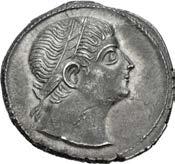

616. Constantine I. AD 307/310-337. AR Siliqua (18.5mm, 3.18 g, 12h). Thessalonica mint. Struck AD 326-327. Diademed head right, eyes to God / Victory advancing left, holding wreath and palm frond; SMTS. RIC VII 152; RSC 97c. Toned, minor metal flaws, tiny chip. Good VF. ($1000)
Ex Classical Numismatic Group Electronic Auction 483 (6 January 2021), lot 523.




617. Constantine I. AD 307/310-337. AV Solidus (19mm, 4.50 g, 6h). Nicomedia mint, 5th officina. Struck AD 330. CONSTANTI NVS MAX AVG, rosette-diademed, draped, and cuirassed bust right / PIETAS AVGVSTI NOSTRI, Constantine I, wearing military attire, standing left, holding transverse scepter, extending hand to raise turreted female kneeling right, presented by soldier resting right hand on female figure and holding shield; to right, Victory standing left, crowning Constantine with palm frond; SMNM. RIC VII 167; Depeyrot 42/1; Biaggi –. Toned, heavy hairlines, light deposits. Near EF. Extremely rare. Only two known to Depeyrot in his 2004 corpus. One additional since in CoinArchives (NAC 33, 596) which hammered at CHF 12,000. ($7500)


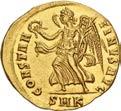
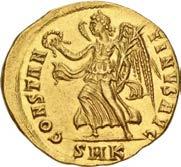
618. Constantine I. AD 307/310-337. AV Solidus (19.5mm, 4.47 g, 6h). Cyzicus mint. Struck AD 325. Rosette-diademed, draped, and cuirassed bust right / Victory advancing left, holding wreath and palm frond; SMK. RIC VII 75; Depeyrot 17/1; Biaggi –. Toned, faint hairlines. Near EF. Extremely rare. Only two known to Depeyrot in his 2004 corpus. One additional since in CoinArchives (Künker 136, 1245; hammer €11.000). A detailed Victory. Lot includes a David Sear certificate of authenticity. ($4000)
From the Richard J. Sullivan Collection. Ex John L. Cowan Collection (Classical Numismatic Group 114, 13 May 2020), lot 1007; Classical Numismatic Group 108 (16 May 2018), lot 681.

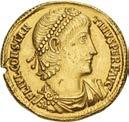
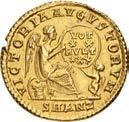
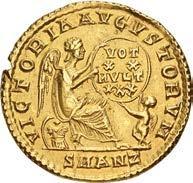
619. Constantine II. AD 337-340. AV Solidus (20.5mm, 4.52 g, 6h). Antioch mint, 7th officina. Pearl-diademed, draped, and cuirassed bust right / Victory, seated right on cuirass, shield to left, inscribing VOT/ X X/ MVLT/ XXX in four lines on shield set on left knee and supported by left hand; to right, small genius standing left supporting the shield with both hands; SMANZ. RIC VIII 23; Depeyrot 5/1; Biaggi 2090 var. (officina). Toned, trace deposits, marks, small cut on edge. Good VF. Very rare. ($1500)
Ex John L. Cowan Collection (Classical Numismatic Group 114, 13 May 2020), lot 1007; Classical Numismatic Group 108 (16 May 2018), lot 681.

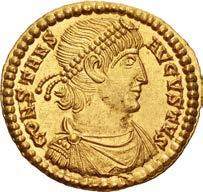
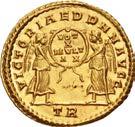
620. Constans. AD 337-350. AV Solidus (22mm, 4.41 g, 6h). Decennalia issue. Treveri (Trier) mint. Struck AD 345. Pearl-diademed, draped, and cuirassed bust right / Two Victories standing vis-à-vis, holding between them a wreath inscribed VOT/ X/ MVLT/ XX in four lines; TR. RIC VIII 135; Depeyrot 6/3; Biaggi 2123. Toned, minor die breaks and rust, minor marks and tiny scrapes, hairlines. EF. ($1500)
From the Ramrodivs Collection, purchased from Harlan J. Berk, 24 October 2012.

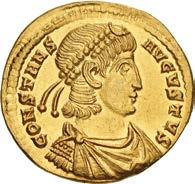
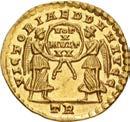
621. Constans. AD 337-350. AV Solidus (21mm, 4.46 g, 12h). Decennalia issue. Treveri (Trier) mint. Struck AD 345. Pearl-diademed, draped, and cuirassed bust right / Two Victories standing vis-à-vis, holding between them a wreath inscribed VOT/ X/ MVLT/ XX in four lines; TR. RIC VIII 135; Depeyrot 6/3; Biaggi 2123. Toned with some luster, hairlines, minor die break on reverse. EF. Lot includes a David Sear certificate of authenticity. ($1500)
From the Richard J. Sullivan Collection.
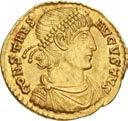
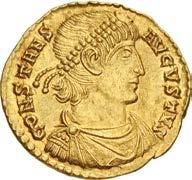

622. Constans. AD 337-350. AV Solidus (21mm, 4.25 g, 6h). Decennalia issue. Treveri (Trier) mint. Struck AD 345. Pearl-diademed, draped, and cuirassed bust right / Two Victories standing vis-à-vis, holding between them a wreath inscribed VOT/ X/ MVLT/ XX in four lines; TR. RIC VIII 135; Depeyrot 6/3; Biaggi 2123. Toned, minor die breaks and die rust. Near EF. ($1500)


623. Constans. AD 337-350. AV Solidus (21.5mm, 4.50 g, 6h). Thessalonica mint. Struck AD 337-340. Rosettediademed, draped, and cuirassed bust right / Victory advancing left, holding trophy set on ground and palm frond; TES. RIC VII 28; Depeyrot 4/3; Biaggi –. Toned. Near EF. ($1000)
From the Wayne Scheible Collection.



624. Constans. AD 337-350. AV Solidus (21mm, 4.44 g, 12h). Thessalonica mint. Struck AD 337-340. Rosette-diademed, draped, and cuirassed bust right / Constans standing left, wearing military attire, holding a trophy mounted on a spear and resting hand on shield set on ground to right, flanked by seated captives; the one on his left with hands bound behind back, and the one on his right holding his head in one hand and resting the other on ground; both captives looking upward at the emperor; TES. RIC VIII 34; Depeyrot 4/7; Biaggi 2126. Toned, a few light scratches. EF. A wonderful reverse composition. Lot includes a David Sear certificate of authenticity. ($1500)
From the Richard J. Sullivan Collection. Ex CNG inventory 151673 (February 2004); Münzen und Medaillen AG 94 (16 December 2003), lot 478.

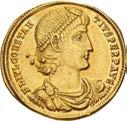


625. Constantius II. AD 337-361. AV Solidus (20.5mm, 4.38 g, 12h). Antioch mint, 5th officina. Struck AD 347-355. Pearl-diademed, draped, and cuirassed bust right / Roma seated facing, holding spear, and Constantinopolis seated left, holding scepter and resting right foot on prow, supporting between them a shield inscribed VOT/ XX/ MVLT/ XXX in four lines; SMANЄ. RIC VIII 81; Depeyrot 6/3; Biaggi 2137 var. (officina). Attractive collection toning, thin die break on reverse. Near EF. ($1000)
From the 1930’s collection of Robert W. Hubel of Michigan. Ex Cahn 68 (26 November 1930), lot 717.

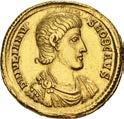

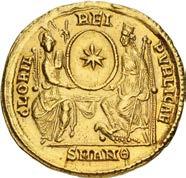
626. Julian II. As Caesar, AD 355-360. AV Solidus (20.5mm, 4.45 g, 6h). Antioch mint, 9th officina. Bareheaded, draped, and cuirassed bust right / Roma seated facing, holding spear, and Constantinopolis seated left, holding scepter and resting right foot on prow, supporting between them a shield inscribed with an eight-rayed star; SMANΘ. RIC VIII 166 var. (unlisted officina); Depeyrot 10/2 var. (same); Biaggi –. Richly toned with some luster, light cleaning scratches, trace deposits. Good VF. The first known in this officina from an already very rare issue; extremely rare thus. No examples cited in Depeyrot’s corpus for this officina and none in CoinArchives. ($1000)
From the Richard J. Sullivan Collection.
Extremely Rare – Illustrated in Depeyrot




627. Julian II. As Caesar, AD 355-360. AV Semissis (16.5mm, 2.26 g, 5h). Antioch mint. Bareheaded, draped, and cuirassed bust right / Victory seated right on cuirass with shield behind, holding stylus and inscribing a large star on shield set on left knee and supported by left hand; to right, small genius standing left supporting the shield with both hands; •SMAN•. RIC VIII 176 var. (no dots in mint mark); Depeyrot 13/2 (this coin cited and illustrated); Biaggi –. Toned. VF. Extremely rare. The only example cited by Depeyrot. One other in CoinArchives (Gorny & Mosch 121, lot 514). This example the first known. ($2000)
From the Richard J. Sullivan Collection. Ex Numismatica Ars Classica 111 (24 September 2018), lot 246; Andre Constantine Dimitriadis Collection (Heritage 3032, 10 April 2014), lot 23677; Dr. Anton C. R. Dreesmann Collection (Part 1, Spink 238, 13 April 2000), lot 211; Vinchon (23 April 1976), lot 275.



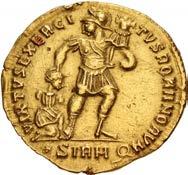
628. Julian II. AD 360-363. AV Solidus (20.5mm, 4.53 g, 6h). Sirmium mint. Struck AD 361-363. Pearl-diademed, draped, and cuirassed bust right / Soldier, wearing helmet and military attire, advancing right, head left, dragging kneeling and bound captive to left by the hair and holding trophy over shoulder; *SIRM դ . RIC VIII 96; Depeyrot 21/1; Biaggi 2219. Toned, area of cleaning marks, thin die break on reverse. Near EF. ($2000)
From the Wayne Scheible Collection. Ex Marc Poncin Collection (Classical Numismatic Group 72, 12 June 2006), lot 1813; Gorny & Mosch 134 (11 October 2004), lot 3123.


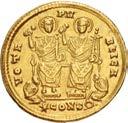
629. Valentinian I. AD 364-375. AV Solidus (21mm, 4.49 g, 6h). Consular issue. Constantinople mint. Struck October AD 367. Consular bust left, wearing pearl-diadem and imperial mantle, holding mappa and scepter / Valentinian I and Valens enthroned facing, both nimbate, both holding mappa and scepter; bound captive flanking to left and right; *CONS դ . RIC IX 29a; Depeyrot 22/1; Biaggi 2244. Toned, a couple of thin scrapes, minor marks. Good VF. Rare. ($1000)

630

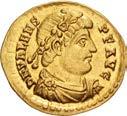
631
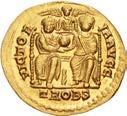
630. Valentinian I. AD 364-375. AV Solidus (21.5mm, 4.50 g, 6h). Nicomedia mint, 6th officina. Struck AD 364. Rosette-diademed, draped, and cuirassed bust right / Valentinian standing facing, head right, holding labarum and Victory on globe left; SMNS. RIC IX 2b.2; Depeyrot 10/1; Biaggi –. Toned, light scratches. Near EF. ($750)
From the Wayne Scheible Collection.
631. Valens. AD 364-378. AV Solidus (21mm, 4.39 g, 11h). Treveri (Trier) mint, 2nd officina. Struck mid AD 373-April 375. Rosette-diademed, draped, and cuirassed bust right / Valentinian I and Valens enthroned facing, holding globe between them; Victory behind and above throne, with wings spread; palm frond set on ground between; TROBS. RIC IX 17e.3; Depeyrot 43/2; Biaggi –. Toned with some luster, faint hairlines on obverse. Good VF. ($750)
From the Ramrodivs Collection. Ex Harlan J. Berk inventory cc48636 (ND).




632. Gratian. AD 367-383. AV Solidus (21mm, 4.45 g, 6h). Treveri (Trier) mint, 2nd officina. Struck mid AD 373-mid 374. Rosette-diademed, draped, and cuirassed bust right / Valentinian I and Gratian enthroned facing, holding globe between them; Victory behind and above throne, with wings spread; palm frond set on ground between; TROBS. RIC IX 17g.4; Depeyrot 43/3; Biaggi –. Toned, light scratch, trace deposits. Near EF. ($1000)
From the Ramrodivs Collection. Ex Harlan J. Berk inventory cc58108 (ND).
633. Gratian. AD 367-383. AV Solidus (21.5mm, 4.48 g, 12h). Treveri (Trier) mint, 3rd officina. Struck mid AD 373-April 375. Pearl-diademed, draped, and cuirassed bust right / Valens and Gratian enthroned facing, holding globe between them; Victory behind and above throne, with wings spread; palm frond set on ground between; TROBT. RIC IX 39d.3; Depeyrot 45/2; Biaggi –. Toned, a few minor marks, some light hairlines. EF. ($1000)
From the Richard J. Sullivan Collection.
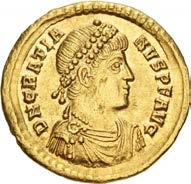


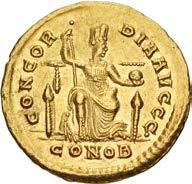
634. Gratian. AD 367-383. AV Solidus (21mm, 4.47 g, 6h). Constantinople mint. Struck AD 380. Pearl-diademed, draped, and cuirassed bust right / Constantinopolis, turreted, seating facing, head right, right foot on prow, holding scepter and globe; CONOB. RIC IX 43a; Depeyrot 30/1; Biaggi –. Lustrous. Near EF. Very rare, only four cited by Depeyrot, two in CoinArchives. ($1000)
Ex Bob Guynn Collection.
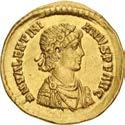

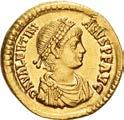
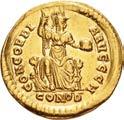
635. Valentinian II. AD 375-392. AV Solidus (20.5mm, 4.47 g, 12h). Constantinople mint, 9th officina. Struck AD 388392. Rosette-diademed, draped, and cuirassed bust right / Constantinopolis enthroned facing, head right, right foot on prow, holding scepter and globe; Θ//CONOB. RIC IX 46d.4; Depeyrot 45/2; Biaggi –. Toned, light graffiti, heavy brush marks. Near EF. Lot includes a David Sear certificate of authenticity. ($750)
From the Richard J. Sullivan Collection.
636. Valentinian II. AD 375-392. AV Solidus (20mm, 4.36 g, 6h). Constantinople mint, 8th officina. Struck AD 388-392. Pearl-diademed, draped, and cuirassed bust right / Constantinopolis enthroned facing, head right, right foot on prow, holding scepter and globe; H//CONOB. RIC IX 46c.2; Depeyrot 46/2; Biaggi –. Toned, small metal flaw, light graffito, a few light scratches. Good VF. Very rare. ($750)
From the Ramrodivs Collection, purchased from Harlan J. Berk, 24 October 2012.



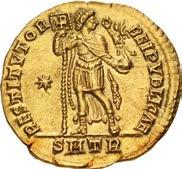
637. Magnus Maximus. AD 383-388. AV Solidus (19.5mm, 4.46 g, 6h). Treveri (Trier) mint. Struck AD 383-384. Rosettediademed, draped, and cuirassed bust right / Maximus, diademed and wearing military attire, standing facing, head right, holding labarum and Victory standing left on globe holding wreath and palm frond; *|–//SMTR. RIC IX 76.2; Depeyrot 50/1 corr. (position of star); Biaggi 2309. Toned, minor deposits, hairlines on obverse, minor die break on reverse. Near EF. ($4000)
From the Wayne Scheible Collection.



638. Contorniates. Late 4th century AD. Æ Contorniate (37.5mm, 23.53 g, 7h). In the name of Trajan. DIVO NERVA E TRAIANO, laureate head right, slight drapery / Skylla, to right, attacking Odysseus’ ship and crew, to left; three crew members fighting right on ship’s prow, two helpless in sea below. Alföldi, Kontorniat p. 156, Rs. 85 and pls. 146, 9-12; 147, 1-12; and 148, 1-4. Red-brown patina, slight roughness, pierced. Good Fine. ($1500)
Ex Philip DeVicci Collection (Classical Numismatic Group 54, 14 June 2000), lot 1869; Harlan J. Berk BBS 85 (9 March 1995), lot 557.
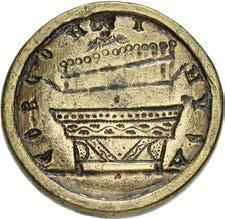

639. Contorniates. Late 4th century AD. Æ Contorniate (36mm, 28.22 g, 12h). GORGON I MVSA, figure standing behind and playing a hydraulis (water organ); all in intaglio / EVDOX E MVSA, tibicen standing facing on ground line, head right, holding tibia in each hand; all in intaglio. Cf. Alföldi, Kontorniat, p. 211 and pl. 206, 4-5 (for similar reverse) and pls. 80, 9-12 and 81, 1-2 (for similar reverse depicting a hydraulis). Toned brassy surfaces, slight porosity, areas of deposits. Good VF. A wonderful depiction of a hydraulis. ($500)
End of Session 2
Session 3 – Wednesday, September 18, 2024 — 9 AM


640. Theodosius II. AD 402-450. AV Solidus (21.5mm, 4.45 g, 12h). Ravenna mint. Struck August-November AD 423. Pearl-diademed, draped, and cuirassed bust right / Theodosius standing right, foot on captive, holding labarum and Victory on globe; R|V//COMOB. RIC X 1329 and 1801; Ranieri 66-67; Depeyrot 7/3; Biaggi –. Toned, trace deposits. Good VF. Lot includes a David Sear certificate of authenticity. ($750)
From the Richard J. Sullivan Collection.
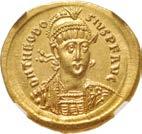



641. Theodosius II. AD 402-450. AV Solidus (20.5mm, 4.50 g, 6h). Constantinople mint, 2nd officina. Struck AD 408-420. Pearl-diademed, helmeted, and cuirassed bust facing slightly right, holding spear over shoulder and shield / Constantinopolis seated facing, head right, right foot on prow, holding scepter and Victory on globe left; star to left; B//CONOB. RIC X 202; Depeyrot 73/2; Biaggi –. Toned. In NGC encapsulation 2154299-008, graded MS, Strike: 5/5, Surface: 4/5. ($750)
642. Theodosius II. AD 402-450. AV Solidus (20mm, 4.47 g, 6h). Constantinople mint, 2nd officina. Struck AD 408-420. Pearl-diademed, helmeted, and cuirassed bust facing slightly right, holding spear over shoulder and shield / Constantinopolis seated facing, head right, right foot on prow, holding scepter and Victory on globe left; star to left; B//CONOB. RIC X 202; Depeyrot 73/2; Biaggi –. Toned. In NGC encapsulation 2154299-003, graded Ch AU, Strike: 5/5, Surface: 5/5. ($750)




643. Theodosius II. AD 402-450. AV Semissis (17mm, 2.16 g, 6h). Constantinople mint. Struck AD 408-430. Pearldiademed, draped, and cuirassed bust right / Victory, draped at waist, seated right on cuirass; supporting shield set on left knee with left hand and inscribing XX/ XXX in two lines on it with stylus; star and shield to left, staurogram to right; CONOB. RIC X 246 corr. (reverse legend and description); Depeyrot 73/4; Biaggi –. Toned with some luster, minor graffiti. Near EF. ($500)
Ex Glenn W. Woods inventory 11874 (ND); Gorny & Mosch 121 (10 March 2003), lot 527.

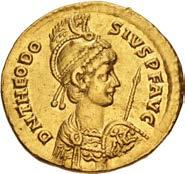

644. Theodosius II. AD 402-450. AV Solidus (20mm, 4.34 g, 6h). Quindecennalia issue. Constantinople mint. Struck AD 415. Diademed, helmeted, and cuirassed bust right, holding spear and shield / Roma and Constantinopolis enthroned facing, heads turned towards each other, Constantinopolis with right foot on prow, both holding scepter, together holding between them a shield inscribed VOT/ XV/ MVL/ XX in four lines; star to left; CONOB. RIC X 207; Depeyrot 61/1; Biaggi –. Toned, edge marks and some edge filing. Good VF. ($1000)
Ex Glenn W. Woods inventory 05802 (ND).




645. Theodosius II. AD 402-450. AV Solidus (21.5mm, 4.46 g, 6h). Constantinople mint, 6th officina. Struck AD 420422. Pearl-diademed, helmeted, and cuirassed bust facing slightly right, holding spear over shoulder and shield / Victory standing left, holding long jeweled cross; S//CONOB. RIC X 219; Depeyrot 74/2; Biaggi –. Toned and lustrous, slightly clipped, thin die breaks, faint hairlines, minor deposits. Superb EF. A wonderful strike from detailed dies. Lot includes a David Sear certificate of authenticity. ($500)
From the Richard J. Sullivan Collection. Ex Triton III (30 November 1999), lot 1259.
646. Theodosius II. AD 402-450. AV Solidus (21mm, 4.47 g, 6h). Constantinople mint. Struck AD 420-422. Pearldiademed, helmeted, and cuirassed bust facing slightly right, holding spear over shoulder and shield / Victory standing left, holding long jeweled cross; CONOB. RIC X 219; Depeyrot 74/2; Biaggi –. Toned and lustrous, trace deposits, slight die rust and minor die breaks on obverse. Superb EF. Lot includes a David Sear certificate of authenticity. ($500)
From the Richard J. Sullivan Collection.
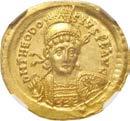



647. Theodosius II. AD 402-450. AV Solidus (21.5mm, 4.49 g, 6h). Constantinople mint, 2nd officina. Struck AD 424425. Pearl-diademed, helmeted, and cuirassed bust facing slightly right, holding spear over shoulder and shield / Theodosius standing facing, holding labarum and globus cruciger; star to left; B//CONOB. RIC X 232; Depeyrot 77/1; Biaggi –. Toned. In NGC encapsulation 2154301-005, graded MS, Strike: 5/5, Surface: 3/5, die shift. ($750)
648. Theodosius II. AD 402-450. AV Solidus (21.5mm, 4.47 g, 12h). Constantinople mint. Struck January-October AD 425. Pearl-diademed, helmeted, and cuirassed bust facing slightly right, holding spear over shoulder and shield / Theodosius II seated facing on curule chair and Valentinian III seated facing, both wearing consular robes, both holding mappa and cruciform scepter; star above; CONOB. RIC X 234; Depeyrot 78/1; Biaggi –. Lustrous, tiny die breaks on reverse. EF ($750)
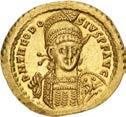



649. Theodosius II. AD 402-450. AV Solidus (20.5mm, 4.27 g, 6h). Constantinople mint, 5th officina. Struck October AD 425-429. Pearl-diademed, helmeted, and cuirassed bust facing slightly right, holding spear over shoulder and shield / Theodosius II and Valentinian III enthroned facing, both nimbate and wearing consular robes, both holding mappa and cruciform scepter; star above; Є//CONOB. RIC X 237; Depeyrot 79/1; Biaggi –. Toned over lustrous surfaces, edge filing. EF. A wonderful strike. Lot includes a David Sear certificate of authenticity. ($750)
From the Richard J. Sullivan Collection.
650. Theodosius II. AD 402-450. AV Solidus (21mm, 4.45 g, 6h). Constantinople mint, 4th officina. Struck AD 430-440. Pearl-diademed, helmeted, and cuirassed bust facing slightly right, holding spear over shoulder and shield / Constantinopolis seated left on throne, holding globus cruciger and scepter, right foot on prow; shield to right side side of throne; star to right; Δ//CONOB. RIC X 257; Depeyrot 81/1; Biaggi –. Toned over lustrous surfaces. EF. ($500)
Ex Glenn W. Woods inventory 07225 (ND).


651. Theodosius II. AD 402-450. AV Solidus (20mm, 4.45 g, 5h). Constantinople mint, 9th officina. Struck AD 441. Pearl-diademed, helmeted, and cuirassed bust facing slightly right, holding spear over shoulder and shield / Soldier, helmeted and wearing military attire, dragging bound captive by the hair and holding trophy over shoulder; star to right; Θ//CONOB. RIC X 284; Depeyrot 83/1; Biaggi –. Toned. In NGC encapsulation 2154299-001, graded Ch MS, Strike: 5/5, Surface: 5/5. ($1000)


652. Theodosius II. AD 402-450. AV Solidus (20mm, 4.33 g, 6h). Constantinople mint. Struck AD 443-450. Pearldiademed, helmeted, and cuirassed bust facing slightly right, holding spear over shoulder and shield / Constantinopolis seated left, holding globus cruciger and scepter, right foot on prow; shield to right; star to left; COMOB. RIC X 293; Depeyrot 84/1. Toned. In NGC encapsulation 2154301-006, graded Ch AU, Strike: 5/5, Surface: 3/5, clipped. ($750)
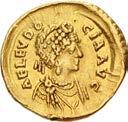



653. Aelia Eudocia. Augusta, AD 423-460. AV Tremissis (14mm, 1.30 g, 12h). Constantinople mint. Struck under Theodosius II. Pearl-diademed and draped bust right, wearing earring and necklace / Cross within wreath; CONOB*. RIC X 253 (Theodosius II); Depeyrot 72/2; Biaggi –. Toned, clipped, light graffiti, marks. VF. ($500)
From the Ramrodivs Collection. Ex. Harlan J. Berk inventory cc57189 (ND).


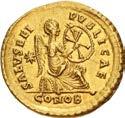

654. Aelia Pulcheria. Augusta, AD 414-453. AV Solidus (20.5mm, 4.47 g, 6h). Constantinople mint. Struck under Theodosius II, AD 414. Pearl-diademed and draped bust right, wearing earring and necklace; drapery decorated with Christogram on shoulder; being crowned by manus Dei above / Victory, draped, seated right on cuirass; supporting shield set on left knee with left hand and inscribing Christogram on it with stylus; star and shield to left; CONOB. RIC X 205; Depeyrot 60/2; Biaggi –. Toned, area of hairlines, minor deposits. Near EF. ($2500)
Ex Glenn W. Woods inventory 00197 (ND).



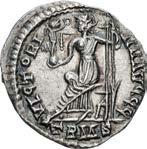
655. Constantine III. AD 407-411. AR Siliqua (16.5mm, 1.16 g, 6h). Treveri (Trier) mint. Struck AD 408-411. Pearldiademed, draped, and cuirassed bust right / Roma seated left on stylized cuirass and throne, holding Victory on globe and reversed spear; TRMS. RIC X 1533; RSC 4a. Attractive iridescent toning. Near EF. ($1000)
Ex Elsen 85 (10 September 2005), lot 453.

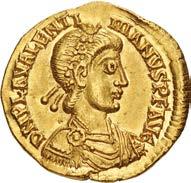

656. Valentinian III. AD 425-455. AV Solidus (20.5mm, 4.41 g, 6h). Mediolanum (Milan) mint. Struck AD 430-455. Rosette-diademed, draped, and cuirassed bust right / Valentinian, wearing military attire, standing facing, foot on humanheaded serpent coiled below, holding long cross and Victory on globe; M|D//COMOB. RIC X 2025; Toffanin 514/1; Depeyrot 20/2; Biaggi –. Toned. Near EF. ($750)
From the Wayne Scheible Collection. Ex Marc Poncin Collection (Classical Numismatic Group 72, 14 June 2006), lot 1911.



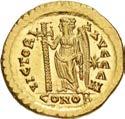
657. Valentinian III. AD 425-455. AV Solidus (20.5mm, 4.47 g, 12h). Ravenna mint. Struck AD 426-455. Rosettediademed, draped, and cuirassed bust right / Valentinian, wearing military attire, standing facing, foot on human-headed serpent coiled below, holding long cross and Victory on globe; R|V//COMOB. RIC X 2018-9; Ranieri 96; Depeyrot 17/1; Biaggi 2349. Toned with some luster, minor metal flaws at edge. EF. ($1000)
From the Richard J. Sullivan Collection.
658. Marcian. AD 450-457. AV Solidus (20mm, 4.47 g, 6h). Constantinople mint, 7th officina. Pearl-diademed, helmeted, and cuirassed bust facing slightly right, holding spear over shoulder and shield / Victory standing left, holding long jeweled cross; star to right; Z//CONOB. RIC X 510; Depeyrot 87/1. Toned and lustrous, thin reverse die break. Superb EF. Lot includes a David Sear certificate of authenticity. ($750)
From the Richard J. Sullivan Collection.
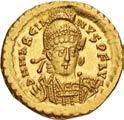



659. Marcian. AD 450-457. AV Solidus (20mm, 4.46 g, 6h). Constantinople mint, 7th officina. Pearl-diademed, helmeted, and cuirassed bust facing slightly right, holding spear over shoulder and shield / Victory standing left, holding long jeweled cross; star to right; Z//CONOB. RIC X 510; Depeyrot 87/1. Toned and lustrous, thin die break and minor metal flaws on reverse. EF. ($750)
Ex Glenn W. Woods inventory 06662 (ND).
660. Leo I. AD 457-474. AV Solidus (20mm, 4.49 g, 6h). Constantinople mint, 5th officina. Struck AD 457-circa 468. Pearl-diademed, helmeted, and cuirassed bust facing slightly right, holding spear over shoulder and shield / Victory standing left, holding long jeweled cross; star to right; Є//CONOB. RIC X 605; Depeyrot 93/1; Biaggi –. Lustrous, a few small die breaks on reverse. EF. ($500)
From the Ramrodivs Collection. Ex. Harlan J. Berk inventory cc75102 (14 March 2012).



661. Leo II, with Zeno. AD 474. AV Solidus (20.5mm, 4.35 g, 6h). Constantinople mint. Struck 18 January-17 November. Pearl-diademed, helmeted, and cuirassed bust facing slightly right, holding spear over shoulder and shield / Leo and Zeno seated facing on double throne, both nimbate and holding mappa; star and cross above; CONOB. RIC X 803; Depeyrot 98/1; Biaggi –. Toned with some luster, lightly clipped, light deposits, punchmark on reverse. EF. ($1000)
From the Wayne Scheible Collection.
Leo II’s grandfather and namesake Leo I was not expected to produce an imperial dynasty. In fact, his appointment and expected tenure as emperor which came about through the covert maneuvering of the powerful magister militum and patrician, Aspar, was likely intended to be short. Aspar may well have placed Leo I on the throne in order to bide his time in solidifying his own imperial dynastic ambitions. Writing on Leo I’s appointment, Crawford noted that “such a combination of poor lineage, obscurity, age and close connections to Aspar makes it seem that Leo meant as a place-holder, elevated to allow Aspar to pave the way for the accession of his own family” (Crawford, 45). However, Leo proved to be more strong-willed than Aspar bargained for. Leo I and his wife harbored dynastic ambitions, and managed to produce a son. This potential heir, however, soon died in infancy. Leo I’s daughter, Aelia Ariadne, consequently became an extremely important factor in the imperial succession. Leo was first persuaded to betroth Ariadne to Aspar’s second son Patricius. However, Leo later reneged on the betrothal and instead married her to an Isaurian soldier named Zeno, who had brought about the downfall of Aspar’s eldest son Ardaburius on accusations of treason. Aspar lost control of his puppet and was ultimately eliminated. If the new Leonid dynasty was to endure, Leo I would need a viable heir. Ariadne and Zeno soon produced a son, Leo II, who became Leo I’s presumptive successor. When the elder Leo’s health began to falter, he raised his eponymous grandson to the rank of Caesar in October AD 473, then Augustus in January AD 474. Leo I died a few days later, and the sickly seven-year-old Leo II became sole emperor. Leo’s widow Aelia Verina arranged for Leo II to appoint his own father, Zeno, co-emperor on 9 February AD 474, an arrangement that lasted until Leo II died in November of the same year. Afterwards, Zeno ruled as sole emperor. This solidus was struck during their brief joint-reign.




662. Libius Severus (Severus III). AD 461-465. AV Tremissis (13mm, 1.42 g, 6h). Mediolanum (Milan) mint. Pearldiademed, draped, and cuirassed bust right / Cross within wreath with large central jewel; COMOB. RIC X 2727 (same dies as illustrated example); Toffanin 524/1 (same obv. die as illustrated example); Lacam Type A, Variety 1 and pl. XCVIII (same dies as eighth and ninth illustrations); Depeyrot 28/2; Biaggi –. Toned, minor deposits, attempted piercing. VF. Rare. ($1500)
Ex Classical Numismatic Group Electronic Auction 491 (5 May 2021), lot 509.
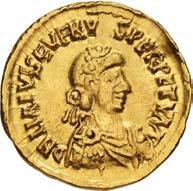



663. Libius Severus (Severus III). AD 461-465. AV Solidus (21.5mm, 4.44 g, 12h). Mediolanum (Milan) mint. Struck AD 462-465. Rosette-diademed, draped, and cuirassed bust right / Severus, wearing military attire, standing facing, foot on human-headed serpent coiled below, holding long cross and Victory on globe left; M|D//COMOB. RIC X 2723 (same dies as illustrated example); Toffanin 523/2; Lacam Type A, Variety C and pls. XCIV (fourth illustration) and 17, 39 (same dies); Depeyrot 27/3 (same dies as illustrated example); Biaggi 2372 (same dies). Toned, minor deposits, die wear, light hairline scratches on reverse. VF. Very rare. ($3000)
From the Wayne Scheible Collection. Ex Marc Poncin Collection (Classical Numismatic Group 72, 14 June 2006), lot 1943.
Possibly Unique – Published in 1949 – Pedigreed to


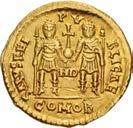

664. Anthemius. AD 467-472. AV Solidus (21.5mm, 4.44 g, 12h). Mediolanum (Milan) mint. Struck AD 467-470. D N ANTHEMIV S P F AVG, pearl-diademed, helmeted, and cuirassed bust facing slightly right, holding spear over shoulder and shield / SALVS REI PV BLICAE, crowned facing figures of Leo I and Anthemius, both wearing military attire and holding spear in outer hand, together holding globus cruciger between them; MD//COMOB. RIC X 2888 (this coin cited); UlrichBansa, Moneta 125 and pl. XII, 125 (this coin); Toffanin 526/3; Lacam Class I, Type 1, p. 481 and pl. CXXIV (this coin cited and illustrated); Depeyrot 29/5 (this coin cited). Toned, marks, graffiti and scrape on reverse. Good VF. Extremely rare and possibly unique. The only example cited by every reference as recently as Depeyrot’s 2004 corpus and by Toffanin in 2014. Published first by Ulrich-Bansa in 1949. ($2000)
From the Wayne Scheible Collection. Ex Consul Eduard Friedrich Weber Collection (J. Hirsch XXIV, 10 May 1909), lot 2843.


665. Anthemius. AD 467-472. AV Solidus (20.5mm, 4.28 g, 6h). Ravenna mint. Pearl-diademed, helmeted, and cuirassed bust facing slightly right, holding spear over shoulder and shield / Nimbate figures of Leo I, standing left, and Anthemius, standing facing, head left, both holding globe, together holding long cross between them; R|V//COMOB. RIC X 2869; Ranieri 162 var. (obv. legend break); Lacam Type III, p. 424 and pl. CVI; Depeyrot 28/1. Toned, a few light scratches, minor deposits on reverse. Good Fine. Very rare. ($1500)
Ex Classical Numismatic Group Electronic Auction 491 (5 May 2021), lot 510; Marc Poncin Collection (Classical Numismatic Group Electronic Auction 135, 15 March 2006), lot 274.




666. Anastasius I. 491-518. AV Solidus (19.5mm, 4.49 g, 8h). Constantinople mint, 10th officina. Struck 492-507. Helmeted and cuirassed bust facing slightly right, holding spear over shoulder and shield / Victory standing left, holding long jeweled cross; star to right; I//CONOB. DOC 3i; MIBE 4a; SB 3. Toned with some luster, minor die rust, small metal flaw on reverse. EF. ($500)
From the Ramrodivs Collection. Ex Harlan J. Berk inventory cc75148 (27 February 2012).
667. Anastasius I. 491-518. AV Solidus (21.5mm, 4.48 g, 6h). Constantinople mint, 8th officina. Struck 507-518. Helmeted and cuirassed bust facing slightly right, holding spear over shoulder and shield / Victory standing left, holding staff surmounted by reversed staurogram; star to left; H//CONOB. DOC 7h; MIBE 7; SB 5. Lustrous, minor die rust on obverse, tiny metal flaw on reverse. EF. A wonderful strike. ($500)
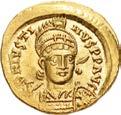



668. Justin I. 518-527. AV Solidus (19.5mm, 4.47 g, 6h). Constantinople mint, 3rd officina. Struck 522-527. Helmeted and cuirassed bust facing slightly right, holding spear over shoulder and shield / Angel standing facing, holding long cross and globus cruciger; star to right; Γ//CONOB. DOC 2c; MIBE 3; SB 56. Toned and lustrous, some clashing, minor hairlines on reverse. Superb EF. A very bold strike. ($500)
From the Ramrodivs Collection, purchased from Harlan J. Berk.
669. Justin I. 518-527. AV Solidus (20.5mm, 4.50 g, 6h). Constantinople mint, 4th officina. Struck 522-527. Helmeted and cuirassed bust facing slightly right, holding spear over shoulder and shield / Angel standing facing, holding long cross and globus cruciger; star to right; Δ//CONOB. DOC (2d); MIBE 3; SB 56. Lustrous. EF. ($500)
Ex Glenn W. Woods inventory 03627 (ND).


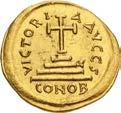
670. Tiberius II Constantine. 578-582. AV Solidus (19mm, 4.45 g, 6h). Carthage mint. Dated RY 6 (579/80). Crowned and cuirassed bust facing, holding globus cruciger and shield on left shoulder / Cross potent set on four steps; S//CONOB. DOC (58b); MIBE 13; SB 462. Lightly toned and lustrous, thin die break on obverse. EF ($750)
Ex Glenn W. Woods inventory 00119 (ND); “An Important Private Collection of Byzantine Coins” (Sotheby’s New York, 2 November 1998), lot 130.




671. Justinian II. First reign, 685-695. AV Solidus (19mm, 4.45 g, 7h). Constantinople mint, 6th officina. Struck 692695. Nimbate facing bust of Christ Pantokrator, raising hand in benediction and holding Gospels / Justinian standing facing, wearing crown and loros, holding cross potent set on two steps and akakia; S//[CONOP]. DOC 7e.bis; MIB 8a; SB 1248. Lightly toned, lustrous. EF. A lovely example. ($2000)
From the Richard J. Sullivan Collection. Ex Classical Numismatic Group Electronic Auction 484 (27 January 2021), lot 982.
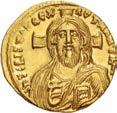


672. Justinian II. First reign, 685-695. AV Solidus (19mm, 4.36 g, 6h). Constantinople mint, 9th officina. Struck 692695. Facing bust of Christ Pantokrator, raising hand in benediction and holding Gospels / Justinian standing facing, wearing crown and loros, holding cross potent set on two steps and akakia; Θ//CONOP. DOC 7g; MIB 8a; SB 1248. Toned with some luster, lightly clipped, hairlines. EF. A wonderful portrait of Christ. ($2000)
Ex Glenn W. Woods inventory 08297 (ND).



673. Leontius. 695-698. AV Solidus (19mm, 4.43 g, 6h). Constantinople mint, 7th officina. Crowned facing bust, wearing loros, holding akakia and globus cruciger / Cross potent set on three steps; Z//CONOB. DOC 1g.2; MIB 1; SB 1330. Lightly toned and lustrous, faint hairlines on reverse. EF. ($1000)
From the Richard J. Sullivan Collection. Ex Triton XXIII (14 January 2020), lot 926.




674. Tiberius III (Apsimar). 698-705. AV Solidus (18.5mm, 4.31 g, 6h). Constantinople mint, 4th officina. Crowned and cuirassed facing bust, holding transverse spear and shield on left shoulder / Cross potent set on three steps; Δ//CONOB. DOC 1c; MIB 1; SB 1360. Lightly toned and lustrous, light scratch, a few die marks on reverse, minor filing on edge. EF. ($500)
From the Richard J. Sullivan Collection. Ex Classical Numismatic Group Electronic Auction 129 (21 December 2005), lot 404.
675. Tiberius III (Apsimar). 698-705. AV Solidus (20.5mm, 4.41 g, 6h). Constantinople mint, 10th officina. Crowned and cuirassed facing bust, holding transverse spear and shield on left shoulder / Cross potent set on three steps; I//CONOB. DOC (1i); MIB 1; SB 1360. Toned, with some luster, slightly clipped, hairlines, some doubling and minor weakness on reverse. EF. Very well struck and with excellent detail. ($500)
Ex Glenn W. Woods inventory 04592 (ND).
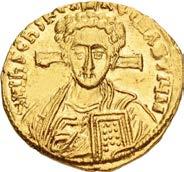



676. Justinian II. Second reign, 705-711. AV Solidus (20mm, 4.21 g, 6h). Constantinople mint. Struck 705. Nimbate facing bust of Christ Pantokrator, raising hand in benediction and holding Gospels / Crowned facing bust of Justinian, wearing loros, holding cross potent set on three steps and patriarchal globus cruciger inscribed PAX. DOC 1; MIB 1; SB 1413. Lustrous, minor doubling, edge filing, minor deposits. EF. ($2000)
From the Ramrodivs Collection. Ex Harlan J. Berk inventory cc52083 (ND).


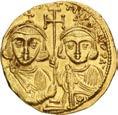

677. Justinian II, with Tiberius. Second reign, 705-711. AV Solidus (19mm, 4.48 g, 6h). Constantinople mint. Struck 705-711. Nimbate facing bust of Christ Pantokrator, raising hand in benediction and holding Gospels / Crowned facing busts of Justinian, with slight beard, and Tiberius, both wearing chlamys and holding cross potent set on two steps between them. DOC 2b; MIB 2b; SB 1415. Lightly toned and lustrous, faint hairlines, light deposits, slightly off center on reverse. EF. Lot includes a David Sear certificate of authenticity. ($1000)
From the Richard J. Sullivan Collection.




678. Justinian II, with Tiberius. Second reign, 705-711. AV Tremissis (14.5mm, 1.27 g, 6h). Constantinople mint. Nimbate facing bust of Christ Pantokrator, raising hand in benediction and holding Gospels / Crowned facing busts of Justinian, with slight beard, and Tiberius, both wearing chlamys and holding cross potent between them. DOC 6b; MIB 6b; SB 1421. Toned, clipped. Near EF. ($750)
Ex Glenn W. Woods inventory 09679 (ND).
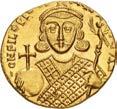


679. Philippicus (Bardanes). 711-713. AV Solidus (18.5mm, 4.48 g, 6h). Constantinople mint, 2nd officina. Crowned facing bust, wearing loros, holding globus cruciger and eagle-tipped scepter / Cross potent set on three steps; B//CONOB. DOC 1b; MIB 1; SB 1447. Toned and lustrous, light hairlines. EF. ($1000)
Ex Glenn W. Woods inventory 03634 (ND).
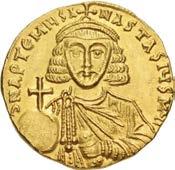

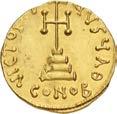

680. Anastasius II Artemius. 713-715. AV Solidus (19mm, 4.44 g, 6h). Constantinople mint, 1st officina. Crowned facing bust, wearing chlamys, holding globus cruciger and akakia / Cross potent set on three steps; AΘ//CONOB. DOC 3 var. (unlisted officina); MIB 3 (this coin cited); Füeg 2.L.1 (this coin cited and illustrated); SB 1464. Toned, minor marks and hairlines on reverse. EF. Extremely rare. The only example cited by MIB and with only one other cited by Füeg twenty-six years later in his corpus. This example the superior of the two. ($2000)
From the Richard J. Sullivan Collection. Ex Nomisma S.p.a. 53 (20 October 2015), lot 309; Münzen und Medaillen AG XXVIII (19 June 1964), lot 565.


681. Anastasius II Artemius. 713-715. AV Solidus (20mm, 4.37 g, 6h). Constantinople mint, 4th officina. Crowned facing bust, wearing chlamys, holding globus cruciger and akakia / Cross potent set on three steps; Δ//CONOB. DOC 2c; MIB 2; Füeg 2.D.2.1; SB 1463. Toned with some luster. EF. A very rare officina, especially so with this legend ending combination. Only two listed by Füeg in his corpus. ($1000)
Ex Glenn W. Woods inventory 03922 (ND).
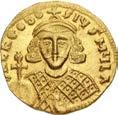


682. Theodosius III of Adramytium. 715-717. AV Solidus (19.5mm, 4.47 g, 6h). Constantinople mint, 4th officina. Crowned facing bust, wearing loros, holding patriarchal globus cruciger and akakia / Cross potent set on three steps; Δ// CONOB. DOC 1 var. (unlisted officina); MIB 1; Füeg 1.B.4; SB 1487. Toned and lustrous, trace deposits. EF. Very rare. Cited by Füeg in his corpus. ($3000)
From the Richard J. Sullivan Collection. Ex Edward J. Waddell inventory 54308 (ND); Gorny & Mosch 195 (7 March 2011), lot 522 (hammer €7500).


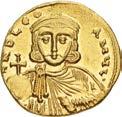
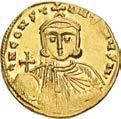
683. Leo III the “Isaurian”. 717-741. AV Solidus (19.5mm, 4.47 g, 6h). Constantinople mint, 7th officina. Struck 717-720. Crowned facing bust, wearing chlamys, holding globus cruciger and akakia / Cross potent set on three steps; Z// CONOB. DOC 1 var. (unlisted officina); MIB 1; Füeg 1.B.7; SB 1502. Lustrous, minor spots of weakness, slight die clashing on obverse. EF. Lot includes a David Sear certificate of authenticity. ($750)
From the Richard J. Sullivan Collection.
684. Leo III the “Isaurian”, with Constantine V. 717-741. AV Solidus (19.5mm, 4.26 g, 6h). Constantinople mint. Struck circa circa 725-732. Crowned facing bust of Leo, wearing chlamys, holding globus cruciger and akakia / Crowned facing bust of Constantine, wearing chlamys, holding globus cruciger and akakia. DOC 5; Füeg 5.A.3; SB 1504. Toned and lustrous. EF. Lot includes a David Sear certificate of authenticity. ($500)
From the Richard J. Sullivan Collection.




685. Leo III the “Isaurian”, with Constantine V. 717-741. AV Semissis (17mm, 2.21 g, 6h). Constantinople mint. Struck circa 737-741. Crowned facing bust of Leo, wearing chlamys, holding globus cruciger and akakia / Crowned facing bust of Constantine, wearing chlamys, holding cross potent set on globe and akakia. DOC 13; SB 1506. Attractively toned and lustrous, tiny metal flaw. EF. ($500)
Ex Glenn W. Woods inventory 06696; Malcolm W. Heckman Collection (Triton VIII, 10 January 2005), lot 1404; Classical Numismatic Group 36 (5 December 1995), lot 2529.

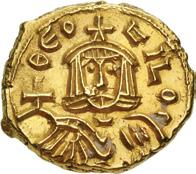


686. Theophilus. 829-842. AV Solidus (15.5mm, 3.79 g, 6h). Syracuse mint. Crowned facing bust of Theophilus, wearing loros, holding cross potent / Crowned facing bust of Theophilus, wearing chlamys, holding globus cruciger. DOC 24; Anastasi 530b; SB 1670. Toned, deposits. EF. Lot includes a David Sear certificate of authenticity. ($500)
From the Richard J. Sullivan Collection.
687. John I Zimisces. 969-976. AV Histamenon Nomisma (21.5mm, 4.40 g, 6h). Constantinople mint. Facing bust of Christ Pantokrator, raising hand in benediction and holding Gospels / Crowned facing half-length figure of John, wearing loros, holding patriarchal cross and being crowned by the Theotokos to right; manus Dei to upper left. DOC 3; Füeg 3; SB 1785. Toned. Good VF. ($750)
From the Ramrodivs Collection, purchased from Harlan J. Berk.
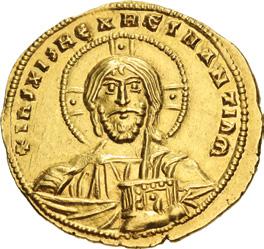

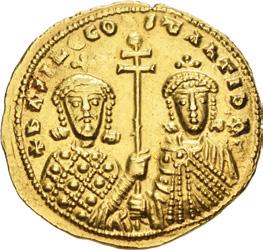
688. Basil II Bulgaroktonos, with Constantine VIII. 976-1025. AV Histamenon Nomisma (21.5mm, 4.36 g, 6h). Constantinople mint. Struck 977-circa 989. Nimbate facing bust of Christ Pantokrator, raising hand in benediction and holding Gospels; pellet in each arm of nimbus cross / Crowned facing busts of Basil, wearing loros, and Constantine, wearing chlamys, holding patriarchal cross between them; • at top of cross. DOC 2; Füeg II 2.BB; SB 1796. Lightly toned with some luster. Near EF. Lot includes a David Sear certificate of authenticity. ($750)
From the Richard J. Sullivan Collection.
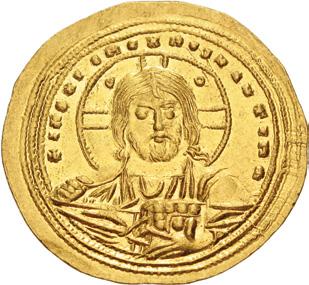


689. Constantine VIII. 1025-1028. AV Histamenon Nomisma (25mm, 4.43 g, 6h). Constantinople mint. Nimbate facing bust of Christ Pantokrator, raising hand in benediction and holding Gospels; upturned crescents in upper two quarters of nimbus / Crowned facing bust of Constantine, wearing jeweled loros, holding labarum and akakia. DOC 1; Füeg II 1.B.7; SB 1815. Toned, doubling and hairlines on reverse. EF. ($750)
Ex Glenn W. Woods inventory 08993 (ND); Triton IX (9 January 2006), lot 1665 (part of).
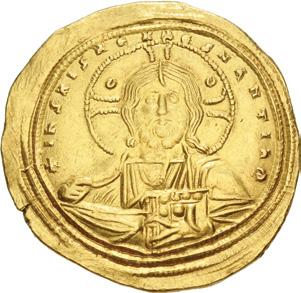

690. Constantine VIII. 1025-1028. AV Histamenon Nomisma (24.5mm, 4.41 g, 6h). Constantinople mint. Nimbate facing bust of Christ Pantokrator, raising hand in benediction and holding Gospels; upturned crescents in upper two quarters of nimbus / Crowned facing bust of Constantine, wearing jeweled loros, holding labarum with pellet on shaft and akakia. DOC 2; Füeg II 2.A.7; SB 1815. Toned, trace deposits, minor die breaks on reverse. Near EF. Lot includes a David Sear certificate of authenticity. ($750)
From the Richard J. Sullivan Collection.
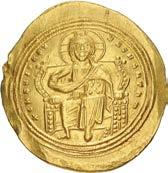

691. Constantine IX Monomachus. 1042-1055. AV Histamenon Nomisma (27.5mm, 4.42 g, 6h). Constantinople mint. Christ Pantokrator enthroned facing on suppedion / Crowned facing bust, wearing loros, holding cruciform scepter with tendril ornament and patriarchal globus cruciger. DOC 1a; Füeg II 1.A.2.1; SB 1828. Toned, a few light scratches, tiny scuff. EF. Lot includes a David Sear certificate of authenticity. ($500)
From the Richard J. Sullivan Collection.


692. Constantine IX Monomachus. 1042-1055. AV Histamenon Nomisma (27.5mm, 4.33 g, 6h). Constantinople mint. Struck circa 1054-1055. Facing bust of Christ Pantokrator, raising hand in benediction and holding Gospels / Crowned facing bust of Constantine, wearing jeweled chlamys, holding globus cruciger and sword; two stars flanking crown. DOC 4a; Füeg II 4.A; SB 1831. Toned, area of light deposits, metal flaws on obverse. Good VF. Rare. A popular type. ($3000)
From the Ramrodivs Collection. Ex Harlan J. Berk inventory cc84876 (17 June 2015).
The meaning of the stars that appear on these rare histamena flanking the imperial bust has been a matter of much discussion. Hendy (DOC III, p. 734) suggested that they represented the 1054 appearance of SN 1054, a celestial event that was widely seen and recorded by Chinese, Japanese, and Arab astronomers, as well as the Mimbres and Anasazi in North America. Visible even in daylight from when it first appeared in the constellation of Taurus on 4 July 1054 until it faded in April 1056, Grierson (DOC III, p. 736) concluded that the supernova could not have escaped the notice of anyone interested in astronomy and “may conceivably have found its way onto the coins [since] the dates, at all events, seem to agree.”




693. Theodora. 1055-1056. AV Tetarteron (17.5mm, 3.98 g, 6h). Constantinople mint. Facing bust of Christ Pantokrator, raising hand in benediction and holding Gospels / Crowned facing bust of Theodora, wearing loros, holding jeweled scepter and globus cruciger. DOC 2; Füeg II 2.x; SB 1838. Toned, light scrape. EF. Very well struck. ($2000)
From the Ramrodivs Collection. Ex Harlan J. Berk inventory cc28332 (ND).


694. Eudocia, with Michael VII and Constantius. 1071. AV Histamenon Nomisma (26.5mm, 4.35 g, 6h). Constantinople mint. Christ Pantokrator enthroned facing on suppedion, nimbate, raising hand in benediction and holding Gospels / Crowned facing figures of Eudocia, holding jeweled scepter, standing facing on suppedion, flanked by her sons Michael, to left, holding globus cruciger and akakia, and Constantius, to right, holding akakia and globus cruciger, all wearing loros. DOC 1; Füeg II 1.v var. (unlisted obv. legend); SB 1857. Toned. In NGC encapsulation 2154301-008, graded Ch AU, Strike: 5/5, Surface: 4/5, light marks. ($750)




695. AXUM. Endubis. Circa 295-310. AV (17mm, 2.58 g, 12h). Draped bust right, wearing head-cloth, between two grain ears; pellet-in-crescent above / Draped bust right, wearing head-cloth, between two grain ears; pellet-in-crescent above. Hahn, Aksumite 1; Munro-Hay type 1; BMC Axum 1; SACAM 1. Hint of double strike, tiny edge bump. EF. Attractive for issue. ($750)
From the Richard J. Sullivan Collection.


696. CAROLINGIANS. Charlemagne (Charles the Great). As Charles I, King of the Franks, 768-814. AR Denier (18mm, 1.26 g, 6h). Class 2. Medolus (Melle) mint. Struck 771-793/4. ⍛ A ⌴ / ǮVs in two lines / ȓĩዝ⌴ 8 VS around central ornament. Coupland, Charlemagne 4; Depeyrot 605; M&G 268 corr. (rev. legend); MEC I, 727. Toned, areas of find patina, some porosity. VF. Rare. ($1000)
Ex Agora Auctions 104 (8 February 2022), lot 210; Joseph R. Lasser Collection for the benefit of The Colonial Williamsburg Foundation (Triton XVIII, 6 January 2015), lot 1379; Elsen 101 (12 September 2009), lot 342.
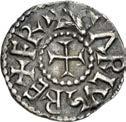
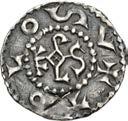
697. CAROLINGIANS. Charlemagne (Charles the Great). As Charles I, King of the Franks, 768-814. AR Denier (21mm, 1.58 g, 5h). Class 3. Tolusa (Toulouse) mint. Struck circa 793/4-812.
, cross pattée / แ
, ü²⎀⌴ǮVs monogram. Coupland, Charlemagne 7b; Depeyrot 993; M&G 181; MEC 1, –. Iridescent toning, cleaning marks, flan puncture. VF. ($1000)
Ex Agora Auctions 104 (8 February 2022), lot 211; Künker 254 (6 October 2014), lot 2032.


698. CRUSADERS, Christian Arabic Dirhams. Mid to late 13th century. AR Dirham (21mm, 2.64 g, 11h). [Akka (Acre) mint]. [Dated AD 1251 (in Arabic)]. allāh wāhid hu/wa al-īmān/wāhid/al-ma‘mūdiyya wāhid (one God, one faith, one baptism in Arabic) across field; lis above nūn of īmān; all within linear and pelleted quadrate border; marginal Arabic legend: Struck in Acre in the year one thousand two hundred, one and fifty from the incarnation of the Messiah / al-āb wa’l-ibn/ wa’l-rīh al-qudus/ilāh wāhid (The Father, the Son, and the Holy Spirit in Arabic) across field; lis above hā’ of ilāh; all within linear and pelleted quadrate border; marginal Arabic legend: ilāh wihid/lahu al-majd/ ilā abad/al-abadīn amīn (One Divinity, His is the glory for ever and ever, amen, amen). Balog & Yvon 47; Metcalf, Crusades –; CCS 17. Iridescent toning, areas of peripheral weakness. Near EF. ($500)


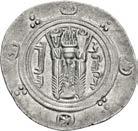

699. Pre-reform issues, Tabaristan (‘Abbasid governors). Nusayr (or Sa‘d). AH 168 / AD 784/5. AR Hemidrachm (24mm, 2.07 g, 12h). al-Rayy mint. Dated AH 168 = PYE 133 (AD 784/5). Crowned Tabaristan-type bust right; GDH monogram and ‘pzwt in Pahlavi to left; nsyl in Pahlavi to right; ‘pd and nwk’ in outer margin / Fire altar flanked by attendants; star and crescent flanking flames; b-al-rayy in Arabic (mint) to left; thaman wa sittin wa mi’a (date) in Arabic to right; alternating triple pellets and star-in-crescents in outer margin. Malek 212.1-3; SICA 1, 352; Album L73; CNG 109, lot 789. Light iridescent toning, deposits in devices, slight porosity. EF. Extremely rare and excellent for issue. ($2000)
Album notes that Nusayr has been tentatively identified as Nusayr al-Wasif, chief of intelligence under the ‘Abbasid caliph al-Mahdi.




700. Pre-reform issues, Tabaristan (‘Abbasid governors). Nusayr (or Sa‘d). AH 168 / AD 784/5. AR Hemidrachm (23.5mm, 2.14 g, 6h). al-Rayy mint. Dated AH 168 = PYE 133 (AD 784/5). Crowned Tabaristan-type bust right; GDH monogram and ‘pzwt in Pahlavi to left; nsyl in Pahlavi to right; ‘pd and nwk’ in outer margin / Fire altar flanked by attendants; star and crescent flanking flames; b-al-rayy in Arabic (mint) to left; thaman wa sittin wa mi’a (date) in Arabic to right; alternating triple pellets and star-in-crescents in outer margin. Malek 212.1-3; SICA 1, 352; Album L73; CNG 109, lot 789. Light iridescent toning, slight porosity, areas of weak strike. EF. Extremely rare and excellent for issue. ($2000)




701. ‘Abbasid Caliphate. al-Muti’. AH 334-363 / AD 946-974. AR Dirham (20.5mm, 2.94 g, 3h). Donative type. Without mint name. Undated issue. Caliph on horseback riding left, right hand holding reins, left hand on the hilt of a sword which hangs at his side; to either side of his head: lillah al-fadl in Arabic / Horned bull (or zebu) kneeling to left, with hump on his back and decorated flanks; above: al-muti‘ lillah in Arabic. Ilisch B I 5 (citing a single specimen, not illustrated). Exmount, light scratches on reverse. Near VF. Excessively rare. ($4000)
Ex Classical Numismtic Group Islamic Auction 2 (27 October 2022), lot 182; Morton & Eden 69 (10 April 2014), lot 82.
This remarkable type is ultimately derived from the bull-and-horseman drachms of the Hindu Shahi dynasty, struck circa AD 850-950. AlMuqtadir issued similar donatives in both gold and in silver, including one variety which preserves two Brahmi characters above the bull on the reverse. It is not clear why the type should have been revived under al-Muti‘, who was under the ‘protection’ of the Buwayhids throughout his caliphate and whose influence was largely confined to religious matters.


702. Almohads (al-Muwahhidun). Abu’l-’Ula Idris II. AH 665-668 / AD 1266-1269. AV Dinar (30mm, 4.64 g, 12h). Without mint name. Undated issue. Hazard 537; Album 494. In NGC encapsulation 6485542-002, graded MS 63. Rare issue of the last of the al-Muwahhidun rulers. ($500)


703. Timurids. Zahir al-Din Muhammad Babur. Second reign at Samarqand AH 903, 905-906 / AD 1498-1501. AR Tanka (28mm, 4.66 g, 10h). Samarqand mint. Dated AH 906 (AD 1500/1). Rahman 46-01 (same dies, but with countermark); Album K2462; Zeno 322949 (this coin). Toned with iridescence, areas of weak strike, light marks. VF. Extremely rare. ($500)
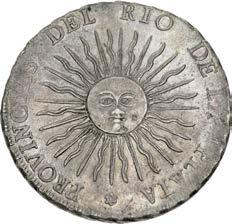


704. ARGENTINA, Provinces of the Rio de la Plata. 1810/6-1831. AR 8 Reales (37mm, 26.85 g, 12h). Potosí mint. Dated 1815 (PTS) F. Radiant sun with face / Coat-of-arms within wreath. KM 14. Toned. In NGC encapsulation 6898712003, graded MS 62. ($1000)
From the Alexander Christopher Collection.


705. AUSTRIA, Holy Roman Empire. Ferdinand I. As King of Bohemia, 1526-1564. AR Taler (37mm, 29.09 g, 2h). Jáchymov (Joachimstal) mint; mm: rosette/cup. Struck circa 1535. Crowned and armored bust right, holding scepter and hilt of sword / Nimbate eagle facing with wings spread, head left; coat-of-arms on breast. Dietiker 118; Vogelhuber 40; Davenport 8039. Toned, a few scattered marks and scratches, minor edge marks. Good VF. ($750)
From the Alexander Christopher Collection.


706. AUSTRIA, Holy Roman Empire. Rudolf II. Emperor, 1576-1611. AR Dreifacher Taler – 3 Taler (46mm, 84.84 g, 11h). Hall mint. Dated 1604. Laureate, armored, and draped bust right, wearing ruff / Crowned and collared coatof-arms. Moser & Tursky 361/363 (dies 1/3); Davenport 3003; KM 59. Toned, scratches and hairlines, minor edge marks. Good VF. ($2000)
From the Alexander Christopher Collection.



707. AUSTRIA, Holy Roman Empire. Ferdinand II. Archduke, 1590-1619. AR Taler (40mm, 28.35 g, 7h). Graz mint. Dated 1617. Crowned and armored bust right, wearing ruff, holding scepter over shoulder and resting hand on hilt of sword / Crowned and collared coat-of-arms. Herenik 55; Davenport 3311; KM 187. Toned. In NGC encapsulation 6908078-003, graded MS 62. ($1000)
From the Alexander Christopher Collection.


708. AUSTRIA, Holy Roman Empire. Leopold V. Archduke, 1619-1632. AR Doppeltaler (46mm, 57.25 g, 12h). Hall mint. Dated 1626. Crowned and armored half-length bust right / Crowned eagle facing with wings spread, head left; wreath above. Moser & Tursky 459b; Davenport 3336; KM 609.2. Toned. In NGC encapsulation 2158732-001, graded AU 58. ($1000)
From the Alexander Christopher Collection.



AUSTRIA, Holy Roman Empire. Leopold V, with Claudia de’ Medici. Archduke, 1619-1632. AR Doppeltaler (47mm, 57.58 g, 11h). Hall mint. Posthumous issue, struck 1635. Crowned jugate busts of Leopold, armored and draped, and Claudia right, each wearing ruff / Crowned eagle facing, head left, wings spread; garlanded wreath above. Moser & Tursky 486; Davenport 3331; KM 639. Toned, a few deposits, very minor edge marks. Near EF. ($500)
From the Alexander Christopher Collection. Ex Stack’s (4 May 1995), lot 2542.

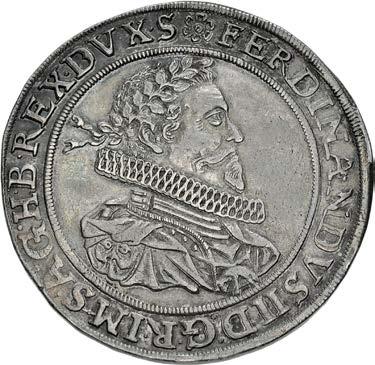

AUSTRIA, Holy Roman Empire. Ferdinand II. Emperor, 1619-1637. AR Taler
28.70 g, 2h).
mint. Dated 1632 IZ. Laureate, armored, and cuirassed bust right, wearing ruff / Crowned double-headed eagle facing with wings spread, holding sword and scepter; crowned and collared coat-of-arms on breast. Herinek 559; Davenport 3161; KM 129.12 (Silesia). Toned. In NGC encapsulation 6896874-007, graded AU 58. Top Pop. ($1500)



711. AUSTRIA, Holy Roman Empire. Ferdinand Karl. Archduke, 1646-1662. AR Doppeltaler (47mm, 57.58 g, 12h). Hall mint. Struck 1654. Crowned, armored, and draped bust right within wreath / Crowned eagle facing with wings spread, head left; all within wreath. Moser & Tursky 511; Davenport 3364; KM 985. Deep iridescent toning, scattered marks, obverse wiped. Near EF. ($750)
From the Alexander Christopher Collection.

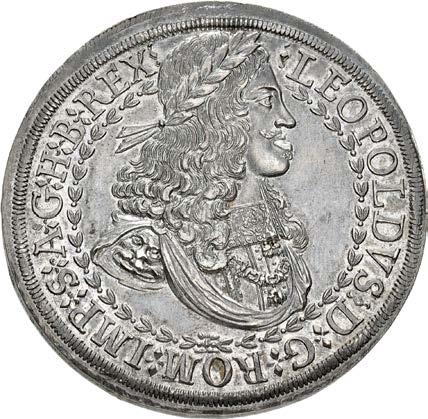
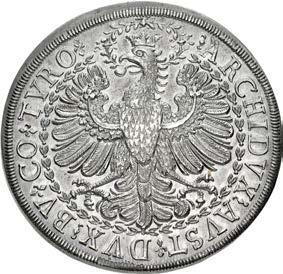
712. AUSTRIA, Holy Roman Empire. Leopold I. Emperor, 1658-1705. AR Doppeltaler (47mm, 57.25 g, 12h). Hall mint. Struck circa 1670. Laureate, draped, and armored bust right within wreath; lion’s head on armor / Crowned and wreathed eagle facing, head left, with wings spread; all within wreath. Moser & Tursky 708; Davenport 3247; KM 1119.1. Attractively toned with underlying luster. AU. ($1000)
From the Alexander Christopher Collection.




713. AUSTRIA, Holy Roman Empire. Leopold I. Emperor, 1658-1705. AR Schautaler (43mm, 25.91 g, 12h). The Relief of Vienna by Jan III Sobieski. Wien (Vienna) mint. Dated 14 July 1683. Crowned double-headed eagle standing left on globe, holding sword and scepter; to upper left, radiant eye of God; to lower right, downward facing crescent moon descending into clouds / Legend in twenty-two lines. Voglhuber 239; Hutten-Czapski 2468. Iridescent toning, cleaned. AU. ($500)
From the Alexander Christopher Collection.
The Siege of Vienna in 1683 was the second attempt by the Ottoman Empire to seize control of the city and conquer the rest of Austria. A relief army consisting of various Holy Roman Empire contigents and forces from the Kingdom of Poland-Lithuania led by their king Jan III Sobieski rushed to relieve the city before it could fall to the Ottomans. The garrison of Vienna was able to repel numerous Ottoman assaults and the arrival of the Polish and HRE forces split their attention. Successes by the Polish and HRE infantry enabled Sobieski to order a cavalry charge that crushed the remaining Ottoman resistance. Sobieski summarized the battle by paraphrasing Julius Caesar, “Venimus, vidimus, Deus Vicit.” The massive defeat sent the Ottoman Empire into a downward spiral, marking the end of their territorial expansion into Europe and the loss of Hungary and many of their other European possessions.
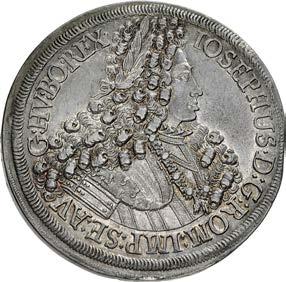

714. AUSTRIA, Holy Roman Empire. Josef I. Emperor, 1705-1711. AR Doppeltaler (47mm, 57.54 g, 12h). Hall mint. Struck 1710-1711. Laureate and armored bust right / Crowned and wreathed eagle facing with wings spread, head left. Moser & Tursky 813; Davenport 1016; KM 1445. Iridescent toning with traces of luster, a few faint hairlines. AU. ($1000)
From the Alexander Christopher Collection.
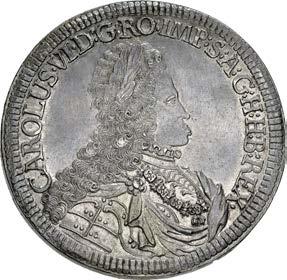

715. AUSTRIA, Holy Roman Empire. Karl VI. Emperor, 1711-1740. AR Doppeltaler (47mm, 57.04 g, 12h). Hall mint. Laureate, draped, and armored bust right / Crowned double-headed eagle facing with wings spread, crowned and collared coat-of-arms on breast, holding sword and scepter. Moser & Tursky 864; Davenport 1049; KM 1523. Iridescent toning, spot of discoloration, hairlines, small test cut on edge. AU. ($1000)
From the Alexander Christopher Collection.
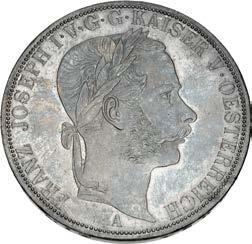
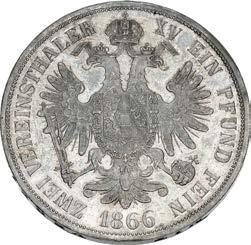
716. AUSTRIA, Austrian Empire. Franz Josef I. 1848-1867. AR Doppeltaler (40mm, 37.02 g, 12h). Wien (Vienna) mint. Dated 1866 A. Laureate head right / Crowned double-headed eagle facing with wings spread, holding sword and globus cruciger; crowned and collared coat-of-arms on breast. Herinek 417; Davenport 24; KM 2250. Deeply toned. In NGC encapsulation 6898707-004, graded MS 63. ($1500)
From the Alexander Christopher Collection.
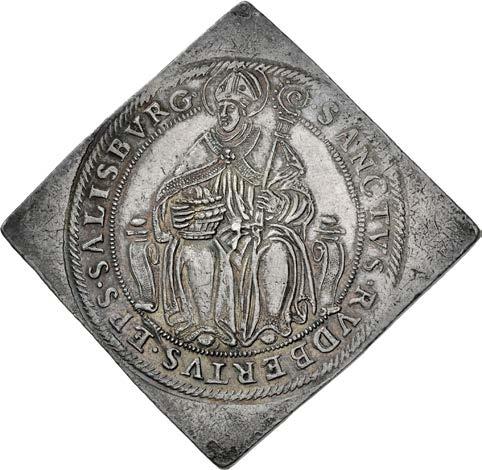

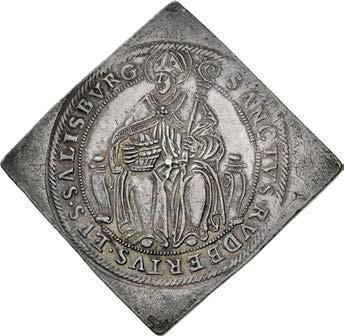
717. AUSTRIA, Salzburg (Prince-Archbishophric). Wolf Dietrich von Raitenau. 1587-1612. AR Taler Klippe (42x43mm, 28.70 g, 12h). Coat-of-arms surmounted by tasseled gallero / St. Rupert seated facing slightly left, holding crozier and salt cellar. Zöttl 978; Probszt 823; Davenport 8184. Toned. In NGC encapsulation 2158732-002, graded AU 58. Top Pop ($750)
From the Alexander Christopher Collection.



718. AUSTRIA, Salzburg (Prince-Archbishophric). Johann Ernst Graf von Thun und Hohenstein. 1687-1709. AR Halbtaler (34mm, 14.43 g, 12h). Dated 1694. Coat-of-arms surmounted by tasseled gallero / St. Rupert seated right, holding salt cellar and crozier, and St. Virgil seated left, holding crozier, facing one another; church to lower right. Zöttl 2183; Probszt 1817; KM 253. Toned. In NGC encapsulation 6908078-001, graded MS 63. ($500)
From the Alexander Christopher Collection.


719. BOLIVIA, Colonial (as Alto Perú). Felipe II. King of Spain, 1556-1598. AR 8 Reales (40mm, 27.51 g, 8h). Potosí mint. Struck 1574-1595. Crowned coat-of-arms; P/[...] to left / Quartered coat-of-arms of Spain within polylobe. Cf. Menzel Po-49 (for type). Toned. In NGC encapsulation 6821728-017, graded AU 53. Assayer initial off flan. ($750)
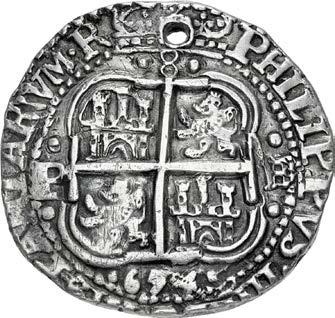

Enlargements of Lot 720


720. BOLIVIA, Colonial (as Alto Perú). Felipe IV. King of Spain, 1621-1665. AR 8 Reales (37mm, 26.75 g, 11h). Royal presentation strike. Cob type. Potosí mint. Dated 1654 P. Coat-of-arms / Crowned Pillars of Hercules set on ocean waves. Menzel Po-279; ME 6567; Calicó y Trigo 413; KM R21. Toned, holed, a few scratches. Good VF. A rare royal presentation piece. ($3000)
From the Gerald F. Borrmann (Northern California Gentleman) Collection. Ex Patrick H.C. Tan Collection (Triton XIV, 4 January 2011), lot 1464; Heritage 458 (6 January 2008), lot 50281.
Many assayers at the Spanish crown’s new world mints struck “royal” or “presentation” pieces. Particular care was taken in the striking of these coins, which generally exhibit full or nearly full legends and careful, well-centered strikes. Often found holed, these coins, “...give an idea of what the mints were actually capable of doing when they devoted the necessary effort to minting full-design, high-quality cob coins” (Menzel p. 31)

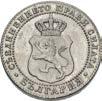
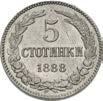

721. BULGARIA, Principality Ferdinand I. 1887-1908. CU-NI 5 Stotinki (17mm, 3.00 g, 6h). Brussels mint. Dated 1888. Crowned coat-of-arms / Denomination and date within wreath. CBC p. 12; KM 9. In NGC encapsulation 6909480-011, graded MS 65. ($750)
From the Alexander Christopher Collection.


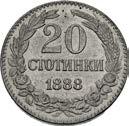

722. BULGARIA, Principality. Ferdinand I. 1887-1908. CU-NI 20 Stotinki (21mm, 5.02 g, 6h). Brussels mint. Dated 1888. Crowned coat-of-arms / Denomination and date within wreath. CBC p. 13; KM 11. In NGC encapsulation 6909478-007, graded MS 64. ($500)
From the Alexander Christopher Collection.



723. BULGARIA, Principality. Ferdinand I. 1887-1908. AR 50 Stotinki (17mm, 2.48 g, 6h). Kremnitz mint. Dated 1891 KБ. Bare head left / Denomination and date within wreath. CBC p. 13; KM 12. In NGC encapsulation 6909480-014, graded MS 62. ($500)
From the Alexander Christopher Collection.


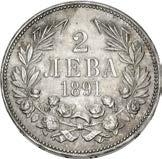
724. BULGARIA, Principality. Ferdinand I. 1887-1908. AR 2 Leva (26mm, 9.98 g, 6h). Kremnitz mint. Dated 1891 KБ. Bare head left / Denomination and date within wreath. CBC p. 14; KM 14. Iridescent toning. In NGC encapsulation 6909478-006, graded MS 64. Top Pop ($1500)
From the Alexander Christopher Collection.


725. BULGARIA, Principality. Ferdinand I. 1887-1908. AR 5 Leva (37mm, 25.00 g, 6h). Kremnitz mint. Dated 1894 KБ. Bare head left / Denomination and date within wreath. CBC p. 16; KM 18. In NGC encapsulation 6909480-012, graded MS 60. ($500)
From the Alexander Christopher Collection.
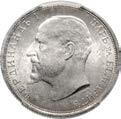


726. BULGARIA, Tsardom. Ferdinand I. 1908-1918. AR 50 Stotinki (17mm, 6h). Kremnitz mint. Dated 1913. Bare head left / Denomination within wreath. CBC p. 26; KM 30. Lustrous. In PCGS encapsulation 42272287, graded MS 66. ($750)



727. CAMBODIA. Anonymous. 1643-1845. AV Quarter Tical (12mm, 3.83 g). Hamsa bird standing left / Blank. Panish –; cf. Mitchiner, Non-Islamic 3029 (AR half baht); Zeno 134297 = Noble 105, lot 3118; CNG E-453, lot 689 (hammer $1800). Near EF. Extremely rare. ($750)
Mitchiner (p. 392) notes that Gabriel Quiroga visiting the Cambodian Court in 1595 recorded that ‘[t]his Kingdom has its own coinage in gold and silver on which is inscribed a cock...” The present example appears stylistically consistent with the later series, and its rarity suggests that this was perhaps a presentation or other special issue.
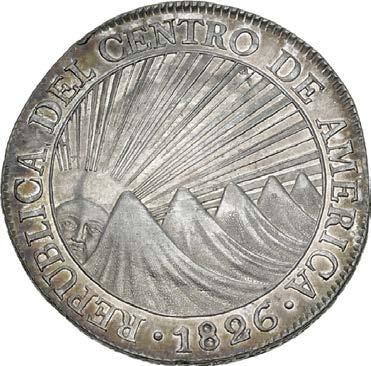



728. CENTRAL AMERICAN REPUBLIC, Federal coinage. 1823-1839. AR 8 Reales (36mm, 26.97 g, 12h). Guatemala mint. Dated 1826 NG M. Sun rising over mountain range / Ceiba tree. KM 4. Deep iridescent toning over underlying luster resulting in a charming cameo effect. In NGC encapsulation 6898712-007, graded MS 62. ($1000)
From the Alexander Christopher Collection.

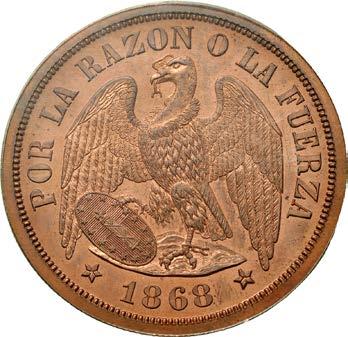

729. CHILE, Republic. 1818-present. Proof Pattern CU Peso (37mm, 6h). Struck at the Philadelphia mint (though naming Santiago). By James B. Longacre and Anthony Paquet. Dated 1868 So. REPUBLICA DE CHILE So UN PESO, plumed coat-of-arms within wreath / POR LA RAZON O LA FUERZA (star) 1868 (star), condor standing left, wings spread, holding serpent in beak and resting claw on shield. KM PnA18. In PCGS encapsulation 7419141, graded PR 66 RB. Rare and in superb condition. ($3000)
From the Alexander Christopher Collection.
In March 1866, Chilean representatives in the United States visited the Philadelphia mint to meet with Chief Engraver James B. Longacre about engraving dies for a new Chilean coinage. Longacre was interested, but awaited consultation from the Treasury Department, which approved the work provided that Longacre supervise another engraver in its creation, a role which ultimately fell to Anthony Paquet. Paquet completed the dies for the Peso and Decimo in late February 1867. Copper patterns were then struck at the Philadelphia mint and delivered to Chilean representatives. A few were evidently retained by Longacre himself, as four appear in the January 1870 auction of his collection by M. Thomas.

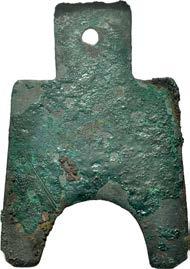


730. CHINA, Eastern Zhou dynasty - Warring States Period. State of Wèi. City of Daliang. Circa 400-300 BC. Æ Arched Foot Spade (33x45mm, 7.6 g). Liang(?) Ban Jin in jīnwén (bronzeware script) / Blank. Cf. BN Chinoises I 203-4 (for similar atttributed to Ying); Hartill 3.21. Green-brown patina. In GBCA encapsulation 117893844, graded 82. ($500)
From the Norman Frank Collection.
731. CHINA, Eastern Zhou dynasty - Warring States Period. State of Wèi. City of Daliang. Circa 400-300 BC. Æ Arched Foot Spade (61x40mm, 28.90 g). Linag Chong Jin Wu Shi Er Dang Lie in jīnwén (bronzeware script) / Blank. BN Chinoises I 163; Hartill 3.48. Green-brown earthen patina. In GBCA encapsulation 1117893842, graded 82. ($500)
From the Norman Frank Collection.
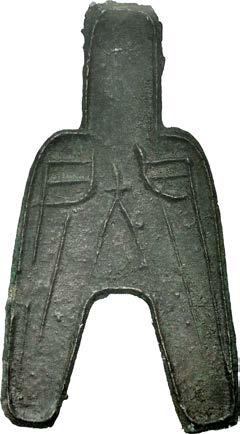

732. CHINA, Eastern Zhou dynasty - Warring States Period. State of Zhào. City of Lin. Circa 350-250 BC. Æ Round Foot Spade (72x38mm, 10.10 g). Lin in jīnwén (bronzeware script) / Yi in jīnwén (bronzeware script). BN Chinoises I 138; Hartill 3.482 var. (rev. numeral). Green-brown patina. In GBCA encapsulation 1117893843, graded 82. Rare. ($750)
From the Norman Frank Collection.


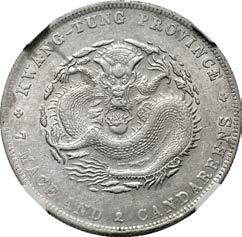
733. CHINA, Qīng dynasty. Guǎngdōng province. AR Dollar – 7 Mace 2 Candareens (39mm, 12h). In the name of Dézōng (Guāngxù). Guangzhou mint. Struck 1890-1908. Legend in Hànzì characters around central legend in Manchu script / Flying imperial dragon facing, coiled leftward around fireball and surrounded by stylized clouds. L&M 133; KM (Y) 203. In NGC encapsulation 6974540-004, graded AU 53. ($750)


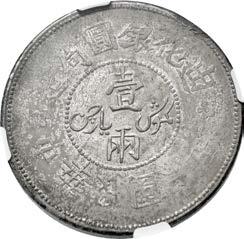
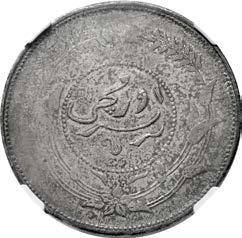
734. CHINA, Republic of China. General issues 1912-1949. AR 50 Cents – 3 Mace 6 Candareens (32mm, 12h). Comemmorating General Táng Jìyáo. Kunming mint. Struck 1916. Uniformed bust right / Crossed flags; star above. L&M 862; KM (Y) 480. Toned. In PCGS encapsulation 50319569, graded XF Details, cleaned. ($750)
735. CHINA, Republic of China. Provincial issues. Xīnjiāng. 1912-1949. AR Tael (38mm, 18.14 g, 10h). Tihwa (Ürümqi) mint. Dated year 6 (AD 1917). Legend in Hànzì characters / Legend in Persian within wreath. L&M 837; KM (Y) 45. Toned. In NGC encapsulation 6844159-002, graded AU 55. ($1000)
From the Libertas Collection.


736. CHINA, Soviet Republic of China. Sìchuān–Shǎnxī Soviet. 1931-1937. CU 500 Cash (34mm, 12h). Dated 1934. Hammer and sickle on star / Denomination. Duan 59; KM (Y) 512.2. In PCGS encapsulation 50319568, graded XF 45. ($750)



737. COLOMBIA, Republic of Colombia (Gran Colombia). Provincia de la Nueva Granada 1819-1831. AR 2

Reales (25mm, 5.15 g, 6h). Nueva Granada mint. Dated 1819 JF. Head of Native American left, wearing feathered headdress / Pomegranate. KM 76. In NGC encapsulation 6898643-006, graded VF Details, cleaned. Struck on a Caracas imitative 2 Reales dated ‘184’ (KM (C) 13.1). Very rare with so clear an undertype. ($2000)
From the Alexander Christopher Collection.



738. CROATIA, Adriatic Coastal Cities. Ragusa (Dubrovnik). Republic of Ragusa. 1358-1807/1814. AR Libertina –2 Ducati (40mm, 28.98 g, 12h). Dated 1794 GA. Bust of Ragusa right / Crowned coat-of-arms within wreath. Viščević 15.33; Davenport 1641; KM 21. Toned. In NGC encapsulation 689874-003, graded MS 61. ($1000)
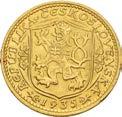


739. CZECHOSLOVAKIA, Republic. 1918-1939. AV Dukát (20mm, 3.48 g, 12h). Dated 1935. Coat-of-arms / Halflength bust of Václav I facing slightly left, holding banner and shield. KM 8; Friedberg 2. In NGC encapsulation 6891659-001, graded MS 62. ($750)
From the Alexander Christopher Collection.


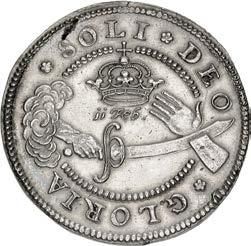
740. DENMARK. Frederik III. 1648-1670. AR Krone (40mm, 21.93 g, 2h). Københaven (Copenhagen) mint. Dated 2 February 1659. Crowned monogram set on clouds / Hand holding sword reaching from the clouds, cutting off outstreched hand to right reaching for Danish crown above. Hede 100A; KM 223; Davenport 3576. In NGC encapsulation 6898697-009, graded UNC Details, spot removals. ($750)
From the Alexander Christopher Collection.
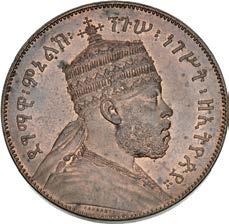


741. ETHIOPIA, Ethiopian Empire. Menelik II. 1889-1913. CU Gersh (37mm, 25.05 g, 6h). Paris mint; différents: cornucopia and fasces. Dated EE 1888 A (AD 1896). Crowned bust right / Denomination. Gill p. 106; KM 8. In NGC encapsulation 6909390-003, graded MS 62 RB. Mintage of only 200. ($1000)
From the Alexander Christopher Collection.

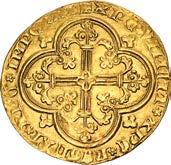
742. FRANCE, Royal. Jean II le Bon (the Good). 1350-1364. AV Franc à cheval (27mm, 3.87 g, 10h). Authorized 5 December 1360. Jean, crowned and in full armor, left on caparisoned horse, holding sword / Cross tréflée and feuillue; at center, pellet within quadrilobe; all within quadrilobe, trefoil fleurée at end of each arc; trilobe in spandrels. Duplessy 294; Ciani 361; Friedberg 279. In NGC encapsulation 6865696-029, graded MS 61. ($1500)


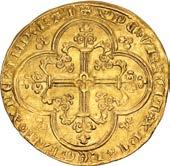
743. FRANCE, Royal. Jean II le Bon (the Good). 1350-1364. AV Franc à cheval (28mm, 3.86 g, 2h). Authorized 5 December 1360. Jean, crowned and in full armor, left on caparisoned horse, holding sword / Cross tréflée and feuillue; at center, pellet within quadrilobe; all within quadrilobe, trefoil fleurée at end of each arc; trilobe in spandrels. Duplessy 294; Ciani 361; Friedberg 279. In NGC encapsulation 6865696-042, graded MS 62. ($2000)




744. FRANCE, Royal. Charles V le Sage (the Wise). 1364-1380. AV Franc à pied (27mm, 3.76 g, 4h). Authorized 20 April 1365. King standing facing within Gothic arch; semé of seven lis to left and right, holding sword and main de Justice / Cross tréflée; in center of cross, pellet within angled quadrilobe; lis in first and fourth quarters, crown in second and third; all within angled quadrilobe; lis in spandrels. Duplessy 360; Ciani 457; Friedberg 284. In NGC encapsulation 6532187-050, graded MS 63. ($1000)
745. FRANCE, Royal. Charles V le Sage (the Wise). 1364-1380. AV Franc à pied (27mm, 3.83 g, 1h). Authorized 20 April 1365. King standing facing within Gothic arch; semé of seven lis to left and right, holding sword with annulet pommel, and main de Justice / Cross tréflée; in center of cross, pellet within angled quadrilobe; lis in first and fourth quarters, crown in second and third; all within angled quadrilobe; lis in spandrels. Duplessy 360A; cf. Ciani 458-60; Friedberg 284. In NGC encapsulation 6532187-054, graded MS 63. ($1000)
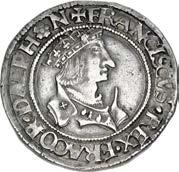


746. FRANCE, Royal. François I. 1515-1547. AR Teston du Dauphiné (30mm, 9.18 g, 8h). Grenoble mint. Struck 1527-1528. Crowned and armored bust right / Coat-of-arms; small cross above. VG 294B; Duplessy 826A; Ciani –. Toned. In NGC encapsulation 9898717-004, graded XF 45. A rare variety. ($500)
From the Alexander Christopher Collection.



747. FRANCE, Royal. Louis XIV le Roi Soleil (the Sun King). 1643–1715. AR Écu de Navarre à la mèche longue (39mm, 27.19 g, 6h). Saint-Palais mint; différents: V flanked by stars/inverted heart. Dated 1654. Laureate, draped, and cuirassed bust right, with long hair; ★ V ★ below / Crowned coat-of-arms. Sobin 43; VG 203; Duplessy 1473; cf. Ciani 1854; KM 180. Toned. In NGC encapsulation 6906700-007, graded AU 58. ($1500)
From the Alexander Christopher Collection.

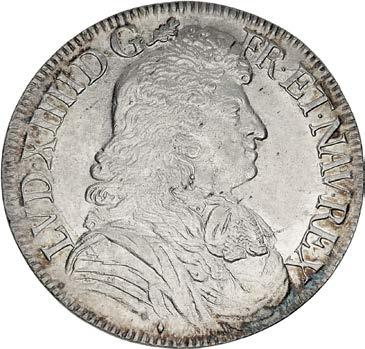
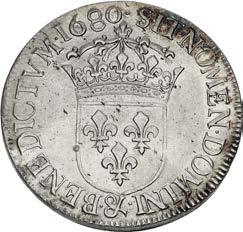
748. FRANCE, Royal. Louis XIV le Roi Soleil (the Sun King). 1643–1715. AR Écu à la cravate (40mm, 27.32 g, 6h). Aix en Provence mint; différents: palm frond. Dated 1680 &. Armored and draped bust right, wearing cravat / Crowned coatof-arms. Sobin 6; VG 210; Duplessy 1493; Ciani 1872; KM 226.12. Lustrous with traces of iridescent toning at periphery. In NGC encapsulation 6898674-004, graded MS 63. Top Pop ($2000)
From the Alexander Christopher Collection.
This type is called by Sobin a “Parliamentary bust,” as the cravat worn by the king resembles that of the advocates of the Paris Parliament.



749. FRANCE, Royal. Louis XIV le Roi Soleil (the Sun King). 1643–1715. AR Écu aux huit L (40mm, 27.20 g, 6h). Amiens mint; différent: sun. Dated 1690 X. Draped bust right; pellet below D in LVD / Crowned cruciform opposed Ls; lis in quarters; X at center. Sobin 9; VG 216; Duplessy 1514; Ciani 1889; KM 275.15. Richly toned. In NGC encapsulation 6906700-012, graded AU 53. A very rare variety struck on a fresh flan, rather than the usual overstrike. ($750)
From the Alexander Christopher Collection.
This wonderful écu is struck on a fresh planchet, rather than being overstruck on an earlier type, as is the case with the vast majority of this issue. In addition, the reverse lacks any différent, depicting neither the heart différent of Michel Mollard nor the trefoil of Claude Hardy. Sobin, in the sale of his collection, notes that the few known 1690 “new planchet” écus of Ameins occur with the trefoil on the reverse and a secret mark: a small pellet below the D in LVD, which is present on this coin.



750. FRANCE, Royal. Louis XIV le Roi Soleil (the Sun King). 1643–1715. AR Écu aux palmes (40mm, 27.07 g, 5h). Lille mint; différents: scallop/cinquefoil. Dated 1695/4 W. Cuirassed bust right / Crowned coat-of-arms set on palm fronds. Sobin 10; VG 217; Duplessy 1520A; Ciani 1894; KM 298.20. Toned. In NGC encapsulation 6906700-008, graded AU 55. Overstruck on a 1691 Écu aux huit L. ($750)
From the Alexander Christopher Collection.


751. FRANCE, Royal. Louis XIV le Roi Soleil (the Sun King). 1643–1715. AR Écu aux huit L (43mm, 27.23 g, 6h). Paris mint; différent: cinquefoil. Dated 1704 A. Cuirassed bust right / Crowned cruciform opposed Ls; lis in quarters; coatof-arms at center; scallop above. Sobin 12; VG 224; Duplessy 1551A; Ciani 1924; KM 362.1. Toned. In NGC encapsulation 6898697-008, graded MS 61. Overstruck on a 1702 Écu aux insignes. ($1000)
From the Alexander Christopher Collection.
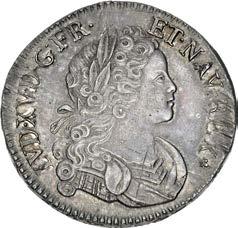

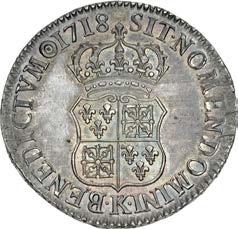
752. FRANCE, Royal. Louis XV le Bien-Aimé (the Well-Beloved). 1715–1774. AR Écu de Navarre (39mm, 24.38 g, 6h). Bordeaux mint; différents: lis/annulet. Dated 1718 K. Laureate, draped, and cuirassed bust right / Crowned coat-of-arms. Sobin 18; VG 318; Duplessy 1657; Ciani 2101; KM 435.11. Deep iridescent toning. In NGC encapsulation 6898697-002, graded AU 58. An attractive example with significant eye appeal. ($500)
From the Alexander Christopher Collection.


753. FRANCE, Royal. Louis XVI. 1774–1793. AR Écu aux rameaux d’olivier (40mm, 29.26 g, 12h). Rouen mint; différents: peacock/lamb. Dated 1777 B. Bust left / Coat-of-arms within wreath of olive branches. Sobin 24; VG 356; Duplessy 1708; Ciani 2187; KM 564.3. Iridescent toning. In NGC encapsulation 6898697-005, graded AU 58. Very rare. A key date, with records showing only 8215 struck. Only one example reported by Sobin. None in CoinArchives. ($500)
From the Alexander Christopher Collection. Ex George Sobin Collection (Lepczyk 20, 7 March 1977), lot 202.


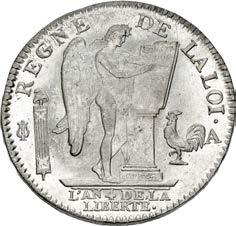
754. FRANCE, Royal. Louis XVI. 1774–1793. AR Écu – 6 Livres (38mm, 29.48 g, 7h). Constitutional issue. Paris mint; différents: leopard/lyre. Dated L’An 4 and 1792 A. Head left, hair tied in ribbon / Winged genius of France standing right, inscribing tablet set on column; to left, fasces surmounted by liberty cap; to right, rooster standing left. Sobin 25; VG 55; Duplessy 1718; Ciani 2238; KM 615.1. Frosty luster. In NGC encapsulation 6906700-004, graded MS 62. ($750)
From the Alexander Christopher Collection.

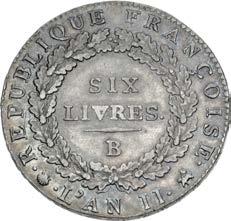
755. FRANCE, First Republic. National Convention. 1792-1795. AR Écu – 6 Livres (38mm, 29.15 g, 6h). Rouen mint; différents: scallop and lamb. Dated L’An II (AD 1793/4). Winged genius of France standing right, inscribing tablet set on column; to left, fasces surmounted by liberty cap; to right, rooster standing left / Denomination within wreath. Sobin 51; VG 60; KM 625.1. Toned. In NGC encapsulation 6906700-009, graded XF 45. ($750)
From the Alexander Christopher Collection.
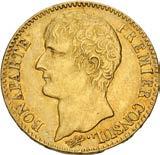


756. FRANCE, First Republic. Consulat. Napoléon Bonaparte. Premier Consul, 1799-1804. AV 40 Francs (26mm, 12.90 g, 1h). Paris mint; différents: signature/rooster. Dated L’An 12 (AD 1803/4). Bare head left / Denomination within wreath. VG 1080; KM 652; Friedberg 479. Toned. In NGC encapsulation 6890912-011, graded AU 55. ($750)
From the Alexander Christopher Collection.
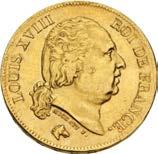

757. FRANCE, Royal (Restored). Louis XVIII. 1814-1824. AV 40 Francs (25mm, 12.92 g, 6h). Lille mint; différents: horse’s head/caduceus. Dated 1818 W. Head right / Crowned coat-of-arms within wreath. VG 1092; KM 713.6; Friedberg 532. In NGC encapsulation 6890883-001, graded MS 62. ($600)
From the Alexander Christopher Collection.
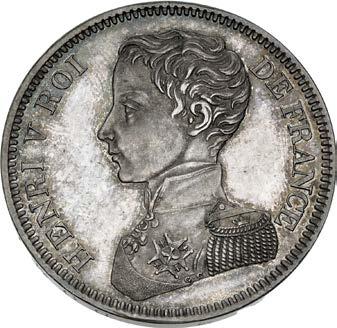


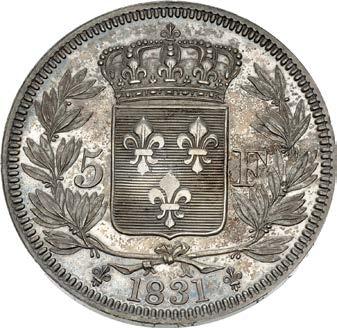
758. FRANCE, Royal (Restored). Henri V. Prétendant et comte de Chambord, 1820-1883. AR Essai de 5 Francs (36mm, 24.60 g, 6h). Dies by Giuseppe Cerbera(?). Dated 1831. HENRI V ROI DE FRANCE, uniformed bust left / Crowned coat-of-arms within wreath of olive branches; 5 F flanking, ჭ 1831 ჭ below. Mazard 905; KM (X) 35. Richly toned. In NGC encapsulation 6909498-006, graded MS 63. ($750)
From the Alexander Christopher Collection.


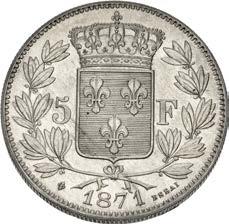
759. FRANCE, Royal (Restored). Henri V. Prétendant et comte de Chambord, 1820-1883. Proof AR Essai de 5 Francs (37mm, 25.96 g, 6h). By Capel. Dated 1871. HENRI V ROI DE FRANCE, bare head left / Crowned coat-of-arms within wreath of olive branches; 5 F flanking, ჭ 1871 ESSAI below. Edge: reeded. Mazard 926; KM (X) 37.2. Toned. In NGC encapsulation 6909515-009, graded PF 62. ($1000)
From the Alexander Christopher Collection.


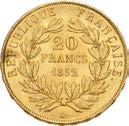
760. FRANCE, Second Republic. Louis Napoléon. President, 1848-1852. AV 20 Francs (21mm, 6.46 g, 6h). Paris mint; différents: dog’s head and hand. Dated 1852 A. Bare head right / Denomination and date within wreath. VG 1060; KM 774; Friedberg 568. In NGC encapsulation 6890883-005, graded MS 65. ($500)
From the Alexander Christopher Collection.




761. FRANCE, Second Empire. Napoléon III. 1852-1870. AV 5 Francs (17mm, 1.61 g, 6h). Paris mint; différents: hand and anchor. Dated 1858 A. Bare head right / Denomination and date within wreath. VG 1001; KM 787.1; Friedberg 587a. In NGC encapsulation 6890883-003, graded MS 65. ($500)
From the Alexander Christopher Collection.



762. FRANCE, Second Empire. Napoléon III. 1852-1870. AV 50 Francs (28mm, 16.14 g, 6h). Paris mint; différents: bee/anchor. Dated 1866 A. Laureate head right / Crowned, collared, and mantled coat-of-arms over crossed scepters. VG 1112; KM 804.1; Friedberg 582. In NGC encapsulation 6890883-007, graded MS 63. ($750)
From the Alexander Christopher Collection.


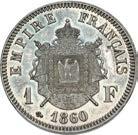
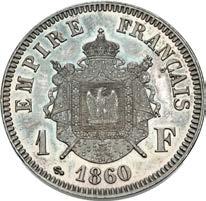
763. FRANCE, Second Empire. Napoléon III. 1852-1870. Proof AR Essai de 1 Franc (22mm, 5.00 g, 6h). Paris mint; différent: anchor. Dated 1860. NAPOLEON III EMPEREUR (anchor), laureate head left / EMPIRE FRANÇAIS, crowned, mantled, and collared coat-of-arms over crossed scepters; 1 F flanking; (anchor) 1860 below. Edge: plain. Mazard 1668 var. (edge); KM PnA93. Deep iridescent toning. In NGC encapsulation 6909359-007, graded PF 63. ($3000)
From the Alexander Christopher Collection.




764. FRANCE, Second Empire. Napoléon III. 1852-1870. Proof AR Essai de 1 Franc (22mm, 5.00 g, 6h). Paris mint. Dated 1861 E. NAPOLEON III EMPEREUR (star), laureate head left / EMPIRE FRANÇAIS, 1/ FRANC/ 1861 within wreath; E below. Edge: plain. Mazard 1669 var. (edge); KM PnB93. Deep iridescent toning. In NGC encapsulation 6909501010, graded PF 66 Cameo. Top Pop ($2000)
From the Alexander Christopher Collection.


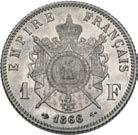

765. FRANCE, Second Empire. Napoléon III. 1852-1870. Proof AR Essai de 1 Franc (23mm, 4.99 g, 6h). Paris mint; différents anchors. Dated 1866 E. NAPOLEON III EMPEREUR, laureate head left / EMPIRE FRANÇAIS, crowned, mantled, and collared coat-of-arms over crossed scepters; 1 F flanking; (anchor) 1866 (anchor) below. Edge: reeded. Mazard 1673 var. (edge); KM –. Deep iridescent toning. In NGC encapsulation 6909501-009, graded PF 64. ($4000)
From the Alexander Christopher Collection.




766. FRANCE, Second Empire. Napoléon III. 1852-1870. Proof AR Essai de 50 Centimes (17mm, 2.50 g, 6h). Paris mint; différents anchors. Dated 1860 E. (anchor) NAPOLEON III EMPEREUR (anchor), bare head left; ESSAI below / EMPIRE FRANÇAIS, crown; below, 50 CENT./ 1860/ E. Edge: plain. Mazard 1679; KM –. Deep iridescent toning. In NGC encapsulation 6909359-008, graded PF 63 Cameo. ($2000)
From the Alexander Christopher Collection.




767. FRANCE, Second Empire. Napoléon III. 1852-1870. Proof AR Essai de 20 Centimes (14mm, 1.00 g, 6h). Paris mint; différents anchors. Dated 1860 E. (anchor) NAPOLEON III EMPEREUR (anchor), bare head left; ESSAI below / EMPIRE FRANÇAIS, crown; below, 20 CENT./ 1860/ E. Edge: plain. Mazard 1690; KM –. Deep iridescent toning. In NGC encapsulation 6909501-008, graded PF 63. Top Pop ($2500)
From the Alexander Christopher Collection.
The Sole Issue of the Paris Commune



768. FRANCE, Paris Commune. 1871. AR 5 Francs (37mm, 24.96 g, 6h). Paris mint; différents: trident and anchor. Dated 1871 A. Hercules standing facing between personifications of Liberty standing slightly right, holding scepter surmounted by Hand of Justice, clasping hands with Equality standing slightly left, holding level; laurel branch to left / Denomination within wreath. Sobin 73; VG 744; KM 823. Deep cabinet toning. In NGC encapsulation 6891668-005, graded MS 63+. ($750)
From the Alexander Christopher Collection. Silver 5 Francs bearing the trident différent were struck under the Paris Commune, with Zéphyrin Camélinat as mint master and treasurer
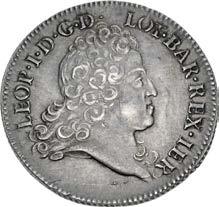

769. FRANCE, Provincial. Lorraine (duchy). Leopold. 1675-1690. AR Écu d’Aubonne (36mm, 20.30 g, 6h). Nancy mint. Dated 1725. Bare head right / Crowned coat-of-arms. Flon 147; Boudeau 1581; KM 108. Toned. In NGC encapsulation 6906700-003, graded AU 58. ($500)
From the Alexander Christopher Collection.


770. GERMANY, Anhalt-Dessau (Duchy). Leopold Friedrich. 1817-1871. AR Taler (33mm, 18.51 g, 11h). Berlin mint. Dated 1863 A. Bare head left / Crowned coat-of-arms within oak wreath. AKS 35; Davenport 510; KM 15. Deep cabinet toning. In NGC encapsulation 6908067-015, graded MS 66. High grade. ($500)
From the Alexander Christopher Collection.
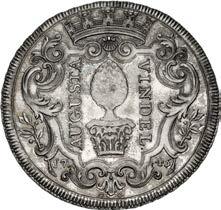


771. GERMANY, Augsburg (city). nomine Franz I. Holy Roman Emperor, 1745-1765. AR Halbtaler (35mm, 14.64 g, 12h). Dated 1745 T. Turreted ornate coat-of-arms / Crowned double-headed eagle facing with wings spread, holding scepter, sword, and globus cruciger; crowned and collared coat-of-arms on breast. Forster 558; KM 156. Old cabinet toning over significant luster. In NGC encapsulation 698674-001, graded MS 64. ($500)
From the Alexander Christopher Collection.



772. GERMANY, Baden (Grand Duchy). Leopold I. 1830-1852. AR Doppeltaler (40mm, 37.11 g, 12h). Commemorating the erection of a monument to Karl Friedrich. Karlsruhe mint. Dated 1844. Bare head right / Monument to Karl Friedrich. Lettered edge. Wielandt 938; Davenport 525; KM 217.1. Deeply toned. In NGC encapsulation 6898674-006, graded MS 63. Top Pop ($500)
From the Alexander Christopher Collection.



773. GERMANY, Bayern (Kingdom). Ludwig I. 1825-1848. AR Taler (37mm, 28.04 g, 12h). Construction of the King Otto Chapel in Kiefersfelden. München (Munich) mint. Dated 1836. Bare head right / View of the chapel. Davenport 579; KM 786. Lustrous. In NGC encapsulation 6909509-008, graded MS 62 PL. ($500)
From the Alexander Christopher Collection.



774. GERMANY, Brandenburg-Ansbach (Margravate). Alexander. 1757-1791. AR Taler (39mm, 28.01 g, 1h). Schwabach mint. Dated 1777 G. Armored and draped bust right / Collared coat-of-arms surmounted by ornately crested helmets. Davenport 2014; KM 304. Toned. In NGC encapsulation 6908067-013, graded MS 62. ($1000)
From the Alexander Christopher Collection.

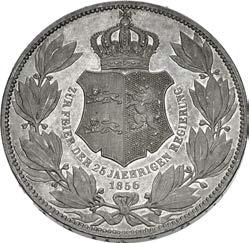
775. GERMANY, Braunschweig (Duchy). Wilhelm. 1831-1884. AR Doppeltaler (40mm, 37.07 g, 12h). Commemorating the 25th Year of the Duke’s Reign. Hannover mint. Dated 1856 B. Bare head right / Crowned coat-of-arms within wreath. Welter 3090; Davenport 635; KM 1149. Richly toned, hints of luster in fields. In NGC encapsulation 6902302-007, graded MS 63. ($500)
From the Alexander Christopher Collection.



776. GERMANY, Braunschweig-Lüneburg-Calenberg (Principality). Johann Friedrich. 1665-1679. AR Taler (48mm, 28.68 g, 10h). Zellerfeld mint. Dated 1679 RB. Draped and cuirassed bust right / Palm tree growing from rock. Welter 1707; Davenport 6575; KM 229. Toned, cleaned. VF. ($750)
Ex BAC Numismatics Online Auction 32 (7 September 2021), lot 404; Künker 290 (15 March 2017), lot 3503.


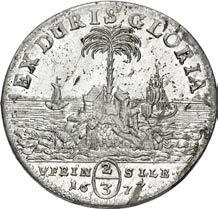
777. GERMANY, Braunschweig-Lüneburg-Calenberg (Principality). Johann Friedrich. 1665-1679. AR 2/3 Taler –Gulden (36mm, 14.62 g, 12h). Hannover mint. Dated 1677. Draped and cuirassed bust right / Palm tree on rocky outcropping flanked by two ships. Welter 1728; Davenport 377A; KM A224. Lustrous. In NGC encapsulation 6902290-002, graded MS 63. ($500)
From the Alexander Christopher Collection.
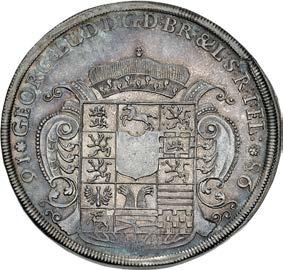
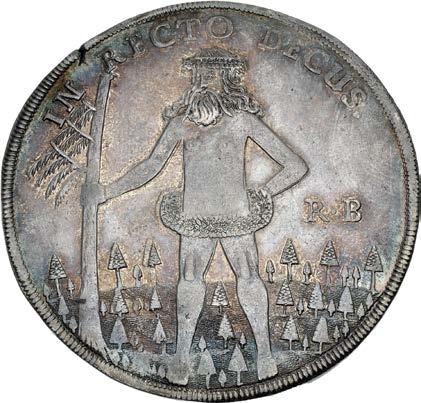
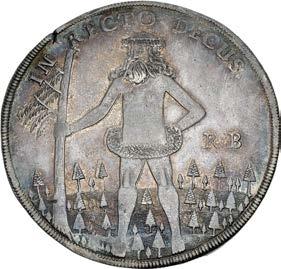
778. GERMANY, Braunschweig-Lüneburg-Calenberg-Hannover (Principality & Electorate). Georg I. As Prince & Elector, 1698-1727. AR Taler (46mm, 11h). Zellerfeld mint. Dated 1698 RB. Coat-of-arms surmounted by Elector’s cap / Wild man standing facing, head left, holding tree. Welter 2142; Davenport 6652; KM 18. Iridescent toning. In NGC encapsulation 2158786-001, graded AU 58. ($500)
From the Alexander Christopher Collection.
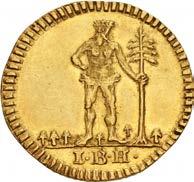
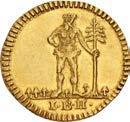

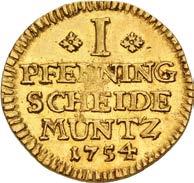
779. GERMANY, Braunschweig-Lüneburg-Calenberg-Hannover (Principality & Electorate). Georg II. King of Great Britain & Elector, 1727-1760. AV Pfennig abschlag – Off metal strike (22mm, 3.47 g, 12h). Zellerfeld mint. Dated 1754 IBH. Wildman standing left, holding tree / Denomination and date. Cf. Smith 190 (for business strike in copper); cf. Welter 2650 (same); KM – (but cf. Pn11-Pn16 for other gold strikes of pfennigs). Lustrous, scratches and marks, area of weak strike. Near EF. Very rare, this date not listed in KM, none in CoinArchives. ($1000)
From the Alexander Christopher Collection.

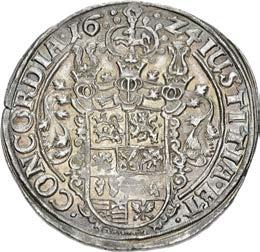
780. GERMANY, Braunschweig-Lüneburg-Celle (Principality). Christian. 1611-1633. AR Taler (42mm, 29.04 g, 12h). Clausthal mint; mm: hook. Dated 1624 HS. Armored bust right wearing large ruff / Coat-of-arms surmounted by three ornately plumed helmets. Welter 921; Davenport 6456; KM 9.17. Golden iridescent toning. In NGC encapsulation 6902290001, graded MS 63. Top Pop – the finest graded by NGC. ($500)
From the Alexander Christopher Collection.

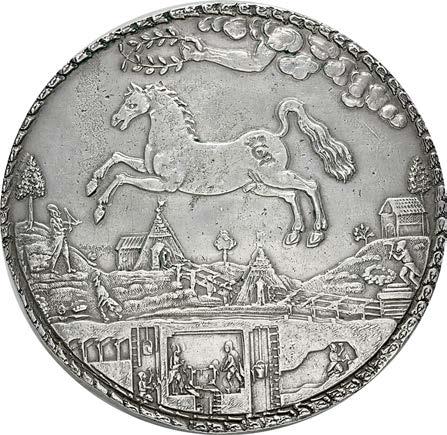
781. GERMANY, Braunschweig-Lüneburg-Celle (Principality). Christian Ludwig. 1648-1665. AR 3 Taler (71mm, 85.83 g, 9h). Clausthal mint; mm: crossed hooks. Dated 1664 LW. Crowned CL monogram within laurel wreath surrounded by 14 crowned coats-of-arms set on wreath / Horse leaping left, monogram on flank; above, arm holding laurel wreath reaching from the clouds; in background, scene of Clausthal countryside; below, mining scene. Welter 1496; Davenport 188; KM 222.5. Toned, wiped, green deposits. Good VF. ($2000)
From the Alexander Christopher Collection.


782. GERMANY, Braunschweig-Wolfenbüttel (Principality). Heinrich der Jüngere (the Younger). 1514-1568. AR Taler (42mm, 28.44 g, 5h). Goslar mint. Dated 1568. Mantled bust right, wearing cap, resting hand on collared coat-of-arms; to right, wildman standing left, holding tree / Crowned double-headed eagle with globus cruciger on breast. Welter 396; Davenport 9052. Lightly toned, a few scattered marks and hairlines, minor edge marks. Good VF. ($500)
Ex Antykwariat Numizmatyczny/Michal Niemczyk 29 (26 June 2021), lot 5120.



783. GERMANY, Braunschweig-Wolfenbüttel (Principality). Julius. 1568-1589. AR Taler – “Brillentaler” (41mm, 29.06 g, 4h). Goslar mint. Dated 1588. Coat-of-arms surmounted by three elaborately crested helmets / Wildman standing left, holding lit candle and uprooted tree trunk; skull, hourglass, and spectacles hung from left arm; to left, horse leaping left, head reverted. Welter 581; Davenport 9067. Toned, areas of weak strike, minor edge marks. Good VF. ($500)
Ex Westfälische Auktionsgesellschaft 119 (16 May 2021), lot 934; Künker 308 (19 June 2018), lot 2041; Künker 32 (6 March 1996), lot 3558.

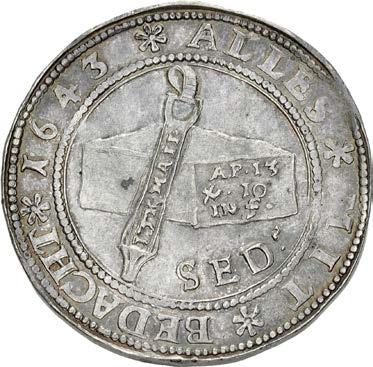

784. GERMANY, Braunschweig-Wolfenbüttel (Principality). August der Jüngere (the Younger). 1635-1666. AR Taler (42mm, 28.84 g, 12h). ‘Glockentaler’ – Fourth Bell Taler type. Zellerfeld mint. Dated 1643. Armored half-length bust left, holding baton and plumed helmet / Clapper of bell leaning on box. Welter 812; Davenport 6371; KM 425. Iridescent toning with hints of luster, minor hairlines and edge marks. Good VF. ($500)
Ex Künker elive 390 (24 June 2023), lot 3868 (hammer €1350).
As a type, the glockentaler (bell taler), appears to reflect the changing sentiment of the leadership of the Dukes of Brunswick-Wolfenbüttel during the Thirty Years’ War (1618-1648). In 1622, Christian von Braunschweig-Wolfenbüttel (1616-1626), issued an unusual series of doppeltalers and talers (see Davenport 6319-6323). Reputedly minted from silver plate taken from the Imperial abbey of Corvey, this type features religious legends in both French and German. The reverse depicts God’s right arm extending from the clouds, armored and holding a sword that may, or may not, support a crown. In keeping with Christian’s aggressive advocacy of the Protestant cause, the German reads GOTTES FREVNDT DER PFAFFEN FEINDT (God’s friend; the priests’ enemy). By the time of Auguste der Jüngere, however, German territories, including Braunschweig-Wolfenbüttel, had been the site of much of the devastating fighting during the war. The departure in 1634 of the imperial armies from his territories was a cause of celebration. To commemorate this event, a series of seven taler types were struck. Collectively known as glockentalers, since a bell features prominently into the design of six of the types (the fourth type shows a stone block and a bell clapper), all of these coins have the common reverse legend ALLES MIT BEDACHT (everything with deliberation), which suggests that the consequences of the impulsive policy of Christian von Braunschweig-Wolfenbüttel and almost twenty years of devastation, brought sober reflection with the onset of peace.
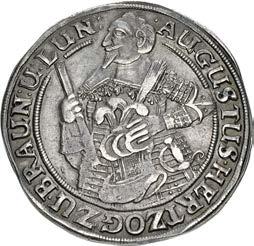
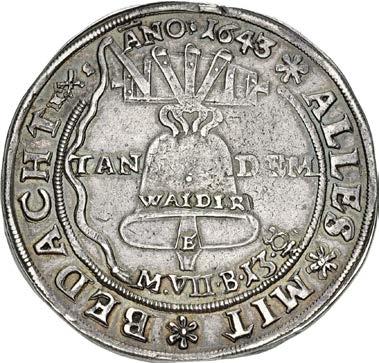

785. GERMANY, Braunschweig-Wolfenbüttel (Principality). August der Jüngere (the Younger). 1635-1666. AR Taler (42mm, 28.79 g, 4h). ‘Glockentaler’ – Fifth Bell Taler type. Zellerfeld mint; mm: crossed hooks. Dated 1643 HS Armored half-length bust left, holding baton and plumed helmet / Bell. Welter 814; Davenport 6373A; KM 427. Iridescent toning, slight double strike, minor edge mark, short scratch. Near EF ($750)
Ex Harald Möller 79 (13 June 2022), lot 164; Künker 361 (21 March 2022), lot 135.
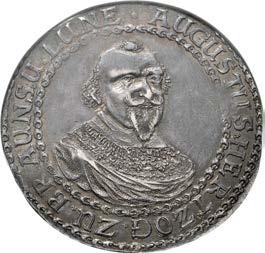
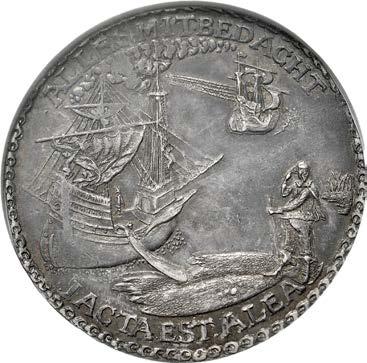

786. GERMANY, Braunschweig-Wolfenbüttel (Principality). August der Jüngere (the Younger). 1635-1666. AR Taler (41mm, 2h). Zellerfeld mint. Struck circa 1650. Mantled bust facing slightly right; all within wreath / Figure standing left on shore, looking out on two ships under sail right. Welter 804A; Davenport 6358; KM 446. Deep iridescent toning. In NGC encapsulation 6062353-017, graded AU 58. ($1000)
Ex Heritage 3101 (25 August 2022), lot 31160 (hammer $2000).


787. GERMANY, Braunschweig-Wolfenbüttel (Principality). August der Jüngere (the Younger). 1635-1666. AR Taler (44mm, 5h). Zellerfeld mint. Dated 1666 HS. Mantled bust right, wearing skullcap, being crowned by Fame flying right from clouds, holding wreath and blowing trumpet / Coat of arms surmounted by five ornately crested helmets, with wildman supporters. Welter 803; Davenport 6355; KM 445. Toned. In NGC encapsulation 2886439-001, graded AU 55. ($750)

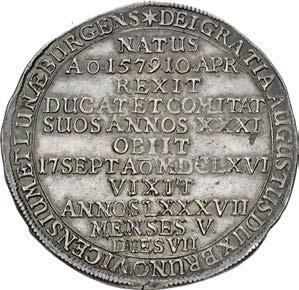

788. GERMANY, Braunschweig-Wolfenbüttel (Principality). August der Jüngere (the Younger). 1635-1666. AR Taler (49.5mm, 28.80 g, 8h). On his death. Zellerfeld mint. Dated 10 April 1579 and 17 September 1666. Biographical legend in eleven lines / Tree mostly bare of leaves; skull at base. Welter 824; Davenport 6376; KM 477. Richly toned, minor edge marks. Near EF. ($750)


789. GERMANY, Braunschweig-Wolfenbüttel (Principality). Rudolf August. 1666-1704. AR Taler (46mm, 29.28 g, 12h). Commemorating the Capture of the City of Braunschweig. Clausthal mint. Dated 12 June 1671 RB. Draped and cuirassed bust left / Open book set on drum; swords, pikes, and cannon in background. Welter 1837; Davenport 6383B; KM 513.1. Toned. Near EF. ($500)
Ex Künker elive 390 (24 June 2023), lot 3873.


790. GERMANY, Braunschweig-Wolfenbüttel (Principality). Rudolf August. 1666-1704. AR Taler (46mm, 29.16 g, 6h). Commemorating the Capture of the City of Braunschweig. Clausthal mint. Dated 12 June 1671. Draped and armored bust left / Open book set on drum; swords, pikes, and cannon in background. Welter 1837; Davenport 6384; KM 513.2 (this coin illustrated for 513.1 and 513.2). Toned, a few minor hairlines and marks. Near EF. ($500)
From the Alexander Christopher Collection.


791. GERMANY, Braunschweig-Wolfenbüttel (Principality). Rudolf August. 1666-1704. AR Taler (45mm, 12h). Commemorating the Capture of the City of Braunschweig. Clausthal mint. Dated 12 June 1671. Armored and draped bust left / Open book set on drum; crossed flags and weapons in background. Welter 1837; Davenport 6385; KM 514. Toned. In NGC encapsulation 2132363-001, graded AU 58. ($750)


792. GERMANY, Erfurt (Swedish occupation). Gustav II Adolf. King of Sweden, 1611-1632. AR Taler (42mm, 28.97 g, 2h). Commemorating the second anniversary of the victory at Leipzig. Dated 1632. Radiate Tetragrammaton; floral spray below / Legend in eleven lines. AAJ 12; Delzanno 352; Davenport 4546; KM 59. Toned, deposit on edge, minor marks and hairlines. VF. ($500)
Ex Peus 426 (16 June 2020), lot 856; Peus 371 (24 April 2002), lot 2070.


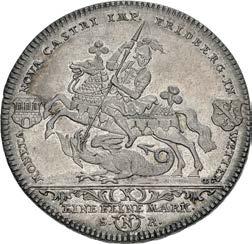
793. GERMANY, Friedburg (Free city). nomine Josef II. Holy Roman Emperor, 1765-1790. AR Taler (42mm, 28.06 g, 12h). Nürnberg mint. Dated 1766 SNR. Crowned double-headed eagle facing, clutching two coats-of-arms in claws; globus cruciger on breast / St. George on horseback, slaying dragon below; two coats-of-arms flanking. Davenport 2251; KM 72. Toned, a few minor hairlines and scratches. UNC. ($750)
From the Alexander Christopher Collection.
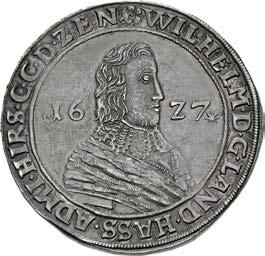
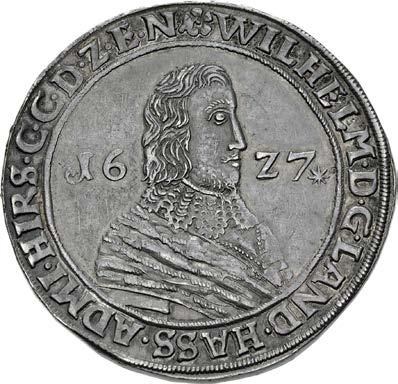
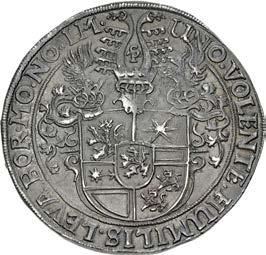
794. GERMANY, Hessen-Kassel (Landgravate). Wilhelm V. 1627-1637. AR Taler (42mm, 29.14 g, 6h). Portrait type. Kassel mint. Dated 1627 (TS). Armored and draped bust right, wearing lace collar / Coat-of-arms surmounted by three ornately plumed helmets. Schütz 731; Davenport 6734; KM 96. Toned. In NGC encapsulation 6896874-001, graded AU 55. ($2000)


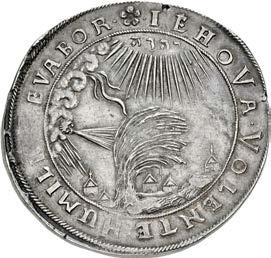
795. GERMANY, Hessen-Kassel (Landgravate). Wilhelm V. 1627-1637. AR Taler (44mm, 29.16 g, 4h). Kassel mint. Dated 1634. Crowned coat-of-arms / Wind and rain emitting from clouds to left, blowing tree to right; buildings in background; radiant Tetragrammaton above. Schütz 839.1; Davenport 6749; KM 115.6. Toned, flan flaw, a few minor edge marks. Good VF. ($500)
Ex Westfälische Auktionsgesellschaft 119 (16 May 2021), lot 985; Harald Möller 76 (16 November 2020), lot 171.
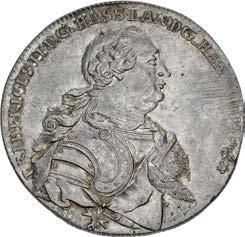

796. GERMANY, Hessen-Kassel (Landgravate). Friedrich II. 1760-1785. AR Taler (40mm, 12h). Kassel mint. Dated 1765 FU. Armored bust right / Crowned coat-of-arms with leonine supporters, the right lion crouched. Schütz 1842; Davenport 2300; KM 476. Toned with underlying luster. In NGC encapsulation 6909509-012, graded MS 62. ($1000)
From the Alexander Christopher Collection.


797. GERMANY, Hohenzollern (Principality). Friedrich Willhelm IV. King of Preußen, 1840-1861. AR Gulden (29mm, 10.62 g, 12h). Berlin mint. Dated 1852 A. Bare head right / Denomination and date within wreath. Neumann 52; KM 5. Patchy toning. In NGC encapsulation 6909509-010, graded PF 65. Top Pop ($500)
From the Alexander Christopher Collection. Ex Heritage 387 (23 September 2005), lot 13027. Prussia took control of the Principality of Hohenzollern following the abdication of Prince Friedrich Wilhelm Constantin in 1849, following the unrest of the previous year. They issued a single coinage on the local gulden standard in 1852 before subsuming the principality into the rest of the Prussian monetary system.
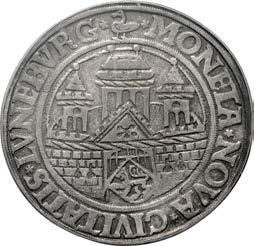

798. GERMANY, Lüneburg (City). AR Taler (40mm, 3h). Dated 1547. View of city walls / Face right in crescent moon. Davenport 9419. Toned. In PCGS encapsulation 37029285, graded XF 40. ($750)
Ex Stack’s Bowers Galleries (16 August 2021), lot 40339.

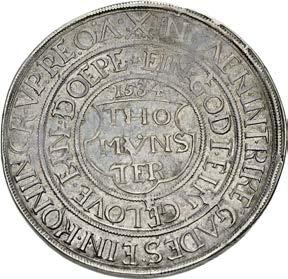
799. GERMANY, Münster (city). AR 1 1/2 Taler (48mm, 42.96 g, 12h). Engelbert Ketteler, mintmaster. Dated 1534 K, though struck 1638-1656. Legend in six lines / THO/ MVNS/TER on shield. Geisberg 7; Davenport 9583 note. Toned, edge marks. Near EF. ($500)
Ex Gorny & Mosch 298 (11 October 2023), lot 2222 (hammer €1800); Gorny & Mosch 285 (9 March 2022), lot 2250; Felzmann 173 (16 November 2021), lot 141.
In 1534, the Anabaptist followers of Jan van Leyden took control of Münster from the Catholic church. They commemorated the event by issuing the “Anabaptist taler,” which was subsequently restruck on several occasions. This example, with the K mark of mintmaster Engelbert Ketteler, was struck in the 1640s. It was likely presented as a token to envoys who visited Münster to negotiate the end of the Thirty Years War.



800. GERMANY, Münster (bishophric). Sede vacante. 1683. AR Taler (42mm, 26.98 g, 12h). In the name of Leopold I, Holy Roman Emperor. Dated 1683 GS. Laureate, draped, and armored bust right / Coat-of-arms surmounted by ornately crested helmet. Schulze 125a; Davenport 5607; KM 95 (this coin illustrated). Richly toned. In NGC encapsulation 6898712013, graded MS 61. Wonderful high relief. ($1000)
From the Alexander Christopher Collection.



801. GERMANY, Münster (bishophric). Sede vacante. 1688. AR Taler (42mm, 27.91 g, 12h). In the name of Leopold I, Holy Roman Emperor. Dated 1688 GS. Laureate, draped, and armored bust right / Bust of St. Paul right, holding sword over shoulder and open book. Schulze 126a; Davenport 5608; KM 97. Toned. In NGC encapsulation 6896874-006, graded AU 58. ($2000)
From the Alexander Christopher Collection.

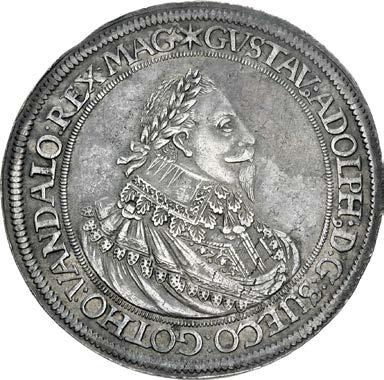

802. GERMANY, Nürnberg (Swedish occupation). Gustav II Adolf. King of Sweden, 1611-1632. AR Taler (42mm, 28.72 g, 11h). Dated 1632. Laureate, draped, and armored bust right, wearing lace collar / Crowned coat-of-arms. AAJ 5; Delzanno 380; Davenport 4550; KM 118. Deeply toned, minor marks and scratches. EF. ($1000)
Ex V.L. Nummus 15 (25 October 2020), lot 741 (hammer €2000).



803. GERMANY, Pommern (Duchy). Bogislaw XIV. 1620-1637. AR Taler (42mm, 28.89 g, 10h). Stettin (Szczecin) mint. Dated 1629 GT. Armored half-length bust right, holding scepter and plumed helmet / Coat-of-arms surmounted by elector’s cap. Davenport 7268B and 7269 var. (legends); KM –. Toned. In NGC encapsulation 6896874-010, graded AU 53. Top Pop ($1500)
Ex Künker 147 (5 February 2009), lot 465.


804. GERMANY, Preußen (Kingdom). Friedrich Wilhelm III. 1797-1840. AR Taler (35mm, 22.13 g, 12h). Stettin (Szczecin) mint. Dated 1808 G. Bust left / Crowned coat-of-arms with wildman supporters. Neumann 6; Davenport 755; KM 368. Toned. In NGC encapsulation 6902302-009, graded AU 58. Key date. ($500)
From the Alexander Christopher Collection.


805. GERMANY, Regensburg (city). AR 1½ Taler Klippe (31x31mm, 8.73 g, 12h). Dated 1608. Angel facing, head left, holding two coats-of-arms; rosettes in margins / Legend in seven lines. Plato 78; Davenport A5742; KM 5. Toned. In NGC encapsulation 6898717-007, graded MS 62. Rare. Top Pop. ($600)
From the Alexander Christopher Collection. Ex Virgil M. Brand Collection (Part IV, Leu 69, 5 June 1991), lot 4940.



806. GERMANY, Regensburg (city). AR Halbtaler (34mm, 14.08 g, 12h). In the name of Leopold II, Holy Roman Emperor. Dated 1792/1 K CGB. Laureate head right / City view. KM 463. Deeply toned. In NGC encapsulation 6898697-011, graded MS 62. ($500)
From the Alexander Christopher Collection.


807. GERMANY, Sachsen (Duchy & Electorate [Albertine line]). Johann Georg II. Elector, 1656-1680. AR Taler (44mm, 28.97 g, 2h). Dresden mint. Dated 1665 CR. Half-length bust right, wearing electoral robes, holding sword over shoulder and elector’s cap on pillow / Coat-of-arms surmounted by eight ornately crested helmets. Clauss & Kahnt 388; Schnee 909; Davenport 7617; KM 474. Toned. In NGC encapsulation 6902290-011, graded AU 55. Top Pop. ($500)
From the Alexander Christopher Collection.

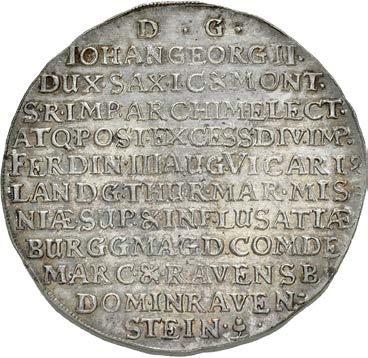
808. GERMANY, Sachsen (Duchy & Electorate [Albertine line]). Johann Georg II. Elector, 1656-1680. AR Breiter Doppeltaler (62mm, 58.36 g, 12h). On the Vikariat. Dresden mint; mm: acorn. Dated 1657. Mantled figure of Johann Georg right on horseback, holding sword over shoulder and reins; coat-of-arms below / Legend in 12 lines. Clauss & Kahnt 489; Davenport 398; Schnee 897; KM 460. Richly toned. In NGC encapsulation 6906690-001, graded MS 64. ($4000)
From the Alexander Christopher Collection.

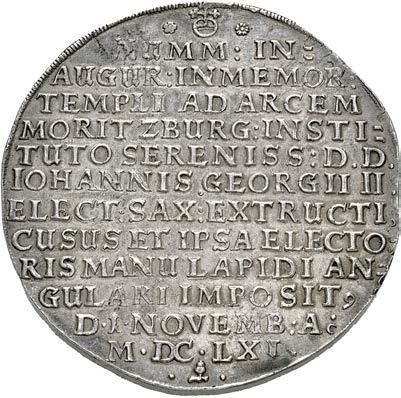
809. GERMANY, Sachsen (Duchy & Electorate [Albertine line]). Johann Georg II. Elector, 1656-1680. AR Doppeltaler (65mm, 57.77 g, 7h). Commemorating the laying of the foundation stone in the chapel of Moritzburg Castle. Dresden mint; mm: acorn. Dated 1 November 1661. Crossed sword and palm front surmounted by plumed helmet, alls et on monument; crowned open book to left; to right, crossed swords within wreath surmounted by elector’s cap; radiant Tetragrammaton above / Legend in twelve lines. Clauss & Kahnt 508; Schnee 912; Davenport 401; KM 496. Toned, edge marks. AU. ($1500)
From the Alexander Christopher Collection.
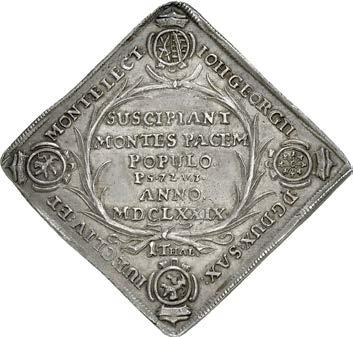


810. GERMANY, Sachsen (Duchy & Electorate [Albertine line]). Johann Georg II. Elector, 1656-1680. AR Taler Klippe (40x41mm, 23.05 g, 6h). Commemorating the Treaty of Nijmegen. Dresden mint. Dated 1679 (in Roman numerals). Legend in six lines within wreath; crowned coats-of-arms in corners / Hercules standing slightly left on clouds, being crowned by manus Dei. Clauss & Kahnt 541; Davenport 7637; KM 564. Old cabinet toning. In NGC encapsulation 2157019-001, graded AU 55. ($500)
From the Alexander Christopher Collection.


811. GERMANY, Sachsen (Duchy & Electorate [Albertine line]). Johann Georg IV. Elector, 1691-1694. AR Taler Klippe (40x40mm, 23.22 g, 3h). Commemorating his receiving the Order of the Garter. Dresden mint. Dated 1693 IK Crowned JG 4 monogram within garter; coats-of-arms in corners / Crowned crossed swords over wreath; crowned coats-ofarms in corners. Clauss & Kahnt 692; Davenport 7649 var. (no mintmaster initials); KM 642. Toned. In NGC encapsulation 2157019-002, graded AU 58. ($500)
From the Alexander Christopher Collection.


812. GERMANY, Sachsen (Duchy & Electorate). Xaver. Regent, 1763-1768. AR Taler (40mm, 27.97 g, 12h). Dresden mint. Dated 1765 EDC. Armored bust right / Coat-of-arms surmounted by elector’s cap. Kahnt 1021; Schnee 1055; Davenport 2678; KM 976. Golden toning with traces of underlying luster. In NGC encapsulation 6902302-002, graded MS 63. ($600)
From the Alexander Christopher Collection.


813. GERMANY, Sachsen (Duchy & Electorate). Friedrich August III. Elector, 1763-1806. AR Taler (40mm, 28.08 g, 12h). Vikariat issue. Dresden mint. Dated 1790 IEC. Head right / Nimbate double-headed eagle facing with wings spread; on breast, coat-of-arms surmounted by elector’s cap. Kahnt 1154; Schnee 1088; Davenport 2697; KM 1023. Lustrous with light golden toning. In NGC encapsulation 6902302-004, graded MS 64. ($500)
From the Alexander Christopher Collection.
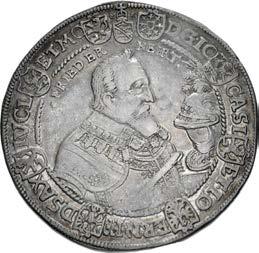

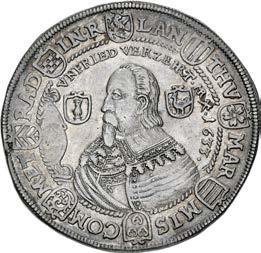
814. GERMANY, Sachsen-Coburg (Duchy). Johann Kasimir, with Johann Ernst. 1596-1633. AR Taler (42mm, 28.86 g, 10h). Saalfeld mint; mm: crossed hooks. Dated 1633 MR. Armored half-length bust right, holding baton and plumed helmet / Armored bust left, wearing lace collar, holding plumed helmet; two coats-of-arms flanking. KOR 276; Schnee 191; Davenport 7432; KM 135 (Saxe-old-Gotha). Toned. In NGC encapsulation 6902290-006, graded AU 53. Very rare, only three on CoinArchives. Top Pop ($2000)
From the Alexander Christopher Collection.
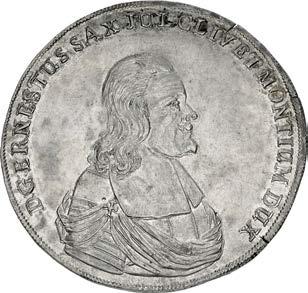

815. GERMANY, Sachsen-Gotha & Altenburg (Duchy). Ernst I. 1672-1675. AR Taler (50mm, 29.06 g, 12h). On his death. Gotha mint. Dated 25 December 1601, 26 March 1675, and 4 June 1675. Armored and draped bust right / Biographical legend in nine lines; nineteen coats-of-arms around, the topmost crowned. Davenport 7458; KM 68. Toned. In NGC encapsulation 2157019-005, graded MS 62. ($1000)
From the Alexander Christopher Collection.


816. GERMANY, Sachsen-Gotha-Altenburg (Duchy). Friedrich III. 1732-1772. AR Halbtaler (32mm, 14.05 g, 12h). Gotha mint; mm: crane. Dated 1764. Head right / Crowned coat-of-arms with crowned leonine supporters. Merseberger 3245; KM 316 corr. (denomination). Richly toned. In NGC encapsulation 6902302-001, graded MS 63. Top Pop ($500)
From the Alexander Christopher Collection.

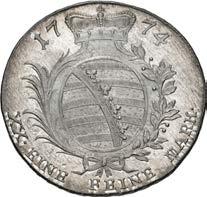
817. GERMANY, Sachsen-Gotha-Altenburg (Duchy). Ernst II. 1772-1804. AR Halbtaler (33mm, 14.06 g, 12h). Gotha mint; mm: crane. Dated 1774. Head right / Crowned coat-of-arms within wreath of palm frond and olive branch. Merseberger 3279; KM 331. Deep iridescent toning with splashes of luster. In NGC encapsulation 6902302-003, graded MS 64+. ($500)
From the Alexander Christopher Collection. KM Plate Coin



818. GERMANY, Sachsen-Weißenfels (Duchy). Johanna Magdalena. Duchess, 1680-1686. AR Taler (42mm, 29.06 g, 12h). On her death. Weißenfels mint. Dated 14 January 1656 and 22 January 1686. Biographical legend in eight lines / Christ standing right, head left, holding shepherd’s staff and lamb over shoulders. Davenport 7663; KM 20 (this coin illustrated). Richly toned. In NGC encapsulation 2157019-004, graded MS 62. Rare. ($1500)
From the Alexander Christopher Collection.


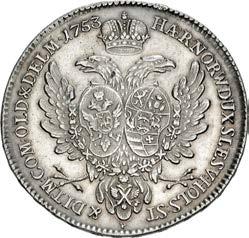
819. GERMANY, Schleswig-Holstein-Gottorp (Duchy). Karl Peter Ulrich. 1739-1762. AR Taler (40mm, 27.95 g, 11h). Mannheim mint. Dated 1753 SP. Armored bust right / Crowned double-headed eagle with two collared coats-of-arms on breast. Bitkin 61; Davenport 1353; KM 226.1. Toned. In NGC encapsulation 6908067-011, graded AU Details, harshly cleaned. ($1500)
From the Alexander Christopher Collection.
Karl Peter Ulrich would go on to rule as Tsar of Russia for six months in 1762, despite being unable to speak the language. His strong German ties made him extremely unpopular, soon leading to his overthrow in favor of his wife, Catherine II.
For an issue of Karl Peter Ulrich as Tsar of Russia, see lot 900, below.
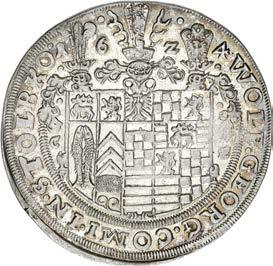


820. GERMANY, Stolberg-Stolberg (County). Wolfgang Georg. 1615-1631. AR Taler (45mm, 28.88 g, 3h). Stolberg mint. Dated 1624 CZ. Coat-of-arms surmounted by three ornately plumed helmets / Stag standing left. Davenport 7778; KM 52. Golden iridescent toning with significant luster, minor double strike, hairlines. AU. ($500)
From the Alexander Christopher Collection.


821. GERMANY, Würzburg (Bishophric). Franz Ludwig von Erthal. 1779-1795. AR Taler (41mm, 28.03 g, 11h). Dated 1781 MP. Draped bust right / Crown over mantled and crowned coat-of-arms; sword and crozier behind. Davenport 2904; KM 413. Toned. In NGC encapsulation 6898674-007, graded MS 62. ($500)
From the Alexander Christopher Collection.



822. GERMANY, Würzburg (Bishophric). Franz Ludwig von Erthal. 1779-1795. AR Doppeltaler – ‘Prize Doppeltaler’ (41mm, 56.18 g, 12h). Würzburg mint. Dated 1786 MP. Bust right / Cherub seated right on plinth, head left, holding wreath in raised and hand vessel overflowing with coins; on plinth to right, glove, open book, and map. Davenport 2906; KM 427. Toned, minor delamination, a few hairlines. EF. ($750)
From the Alexander Christopher Collection.


823. GERMANY, German Empire. Preußen (Kingdom). Wilhelm I. Emperor, 1871-1888. AR 5 Marks (37mm, 27.78 g, 12h). Hannover mint. Dated 1875 B. Bare head right / Crowned eagle facing with wings spread, head left; collared coat-of-arms on breast. Jaeger 97; Davenport 786; KM 503. Toned. In NGC encapsulation 6909390-012, graded MS 65. Top Pop ($1000)
From the Alexander Christopher Collection, purchased from Kagin’s.


824. GERMANY, German Empire. Preußen (Kingdom). Wilhelm II. Emperor, 1888-1918. Proof AR 5 Marks (37mm, 27.77 g, 12h). Berlin mint. Dated 1904 A. Bare head right / Crowned eagle facing with wings spread, head left; collared coatof-arms on breast. Jaeger 104; Davenport 789; KM 423. Iridescent toning. In NGC encapsulation 6909390-010, graded PF 65. ($1000)
From the Alexander Christopher Collection.


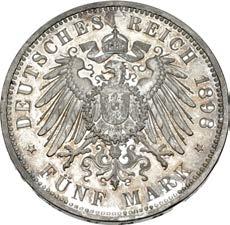
825. GERMANY, German Empire. Hessen-Darmstadt (Grand Duchy). Ernst Ludwig. 1892-1918. Proof AR 5 Marks (37mm, 27.78 g, 12h). Berlin mint. Dated 1898 A. Bare head left / Crowned eagle facing with wings spread, head left; collared coat-of-arms on breast. Jaeger 73; Davenport 711; KM 369. Iridescent toning. In NGC encapsulation 6909390-001, graded PF 64 Cameo. Rare. Mintage of only 240 in proof. ($2000)
From the Alexander Christopher Collection.


826. GERMANY, German Empire. Sachsen-Coburg-Gotha (Duchy). Carl Eduard. 1900-1918. Proof AR 2 Mark (27mm, 11.09 g, 12h). Berlin mint. Dated 1905 A. Bare head right / Crowned eagle facing with wings spread, head left; collared coat-of-arms on breast. Jaeger 147; KM 166. Toned. In NGC encapsulation 6909501-014, graded PF 64. ($750)
From the Alexander Christopher Collection.
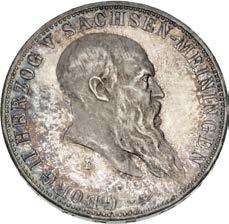

827. GERMANY, German Empire. Sachsen-Meiningen (Duchy). Georg II. 1866-1914. AR 5 Mark (37mm, 27.77 g, 12h). Commemorating Georg’s 75th Birthday. München mint. Dated 1901 D. Head right / Crowned double-headed eagle facing with wings spread, head left; collared coat-of-arms on breast. Jaeger 150; KM 197. Mottled old collection toning. In NGC encapsulation 6898717-001, graded MS 65. ($750)
From the Alexander Christopher Collection.
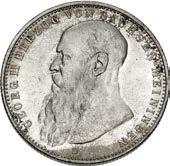

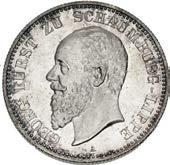

828. GERMANY, German Empire. Sachsen-Meiningen (Duchy). Georg II. 1866-1914. AR 2 Mark (28mm, 11.11 g, 12h). München mint. Dated 1913 D. Head left / Crowned double-headed eagle facing with wings spread, head left; collared coatof-arms on breast. Jaeger 151b; KM 199. Iridescent toning. In NGC encapsulation 6909515-011, graded MS 66. ($600)
From the Alexander Christopher Collection.
829. GERMANY, German Empire. Schaumburg-Lippe (Principality). Georg. 1893-1911. AR 2 Mark (27mm, 11.13 g, 12h). Berlin mint. Dated 1904 A. Bare head left / Crowned eagle facing with wings spread, head left; collared coat-of-arms on breast. Jaeger 164; KM 49. Peripheral iridescent toning. In NGC encapsulation 6909390-004, graded MS 66. Low mintage of only 2000. ($750)
From the Alexander Christopher Collection.
Stunning Cameo 5 Mark



830. GERMANY, German Empire. Württemberg (Kingdom). Wilhelm II. 1891-1918. Proof AR 5 Mark (37mm, 27.78 g, 12h). Stuttgart mint. Dated 1913 F. Bare head right / Crowned eagle facing with wings spread, head left; collared coat-of-arms on breast. Jaeger 176; Davenport 964; KM 632. In NGC encapsulation 6909390-008, graded PF 65 Cameo. Stunning mirror-like fields and frosty cameo devices. Top Pop. ($1000)
From the Alexander Christopher Collection. 828 829


831. GERMANY, Weimar Republic. 1918-1933. Pattern NI 5 Mark (34mm, 18.37 g, 12h). Berlin mint. Dated 1932 A DEUTCHES · REICH (oak leaf) FUNF · REICHSMARK (oak leaf), eagle facing with wings spread, head left; “Probe” across legs / EINIGKEPT · UND · RECHT · UND · FREIHEIT, oak tree; 19 32 across fields; A below. Edge: plain. Schaaf 331 M10; KM Pn353a. In NGC encapsulation 6909490-013, graded MS 65. ($750)
From the Alexander Christopher Collection.



832. GREECE, First Hellenic Republic. Ioannis Antonios Kapodistrias. Governor, 1828-1831. AR Phoenix (22mm, 4.15 g, 6h). Aegina mint. Dated 1828. Phoenix rising from flames, head upturned left, with wings spread; rays to upper left, long cross above; all in solid circle / Denomination in two lines; all within wreath. Divo 1; Karamitsos 20; KM 4. Toned. In NGC encapsulation 6909480-005, graded MS 63. Rare. ($3000)
From the Alexander Christopher Collection.
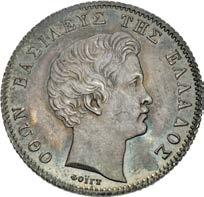


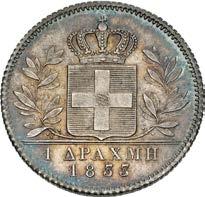
833. GREECE, Kingdom. Othon. 1833-1862. AR Drachma (22mm, 4.49 g, 6h). Munich mint. Dated 1833. Bare head right / Crowned coat-of-arms between olive branches. Divo 12c; Karamitsos 103; KM 15. Deep iridescent toning. In NGC encapsulation 6909480-004, graded MS 65. ($750)
From the Alexander Christopher Collection.



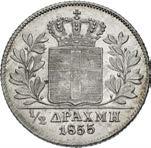
834. GREECE, Kingdom. Othon. 1833-1862. AR ½ Drachma (17mm, 2.22 g, 6h). Vienna mint. Dated 1855. Bare head left / Crowned coat-of-arms between olive branches. Divo 15b; Karamitsos 101; KM 34. Light iridescent toning. In NGC encapsulation 6909480-007, graded MS 64. ($500)
From the Alexander Christopher Collection.

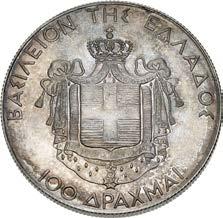
835. GREECE, Kingdom. Georgios II. Second reign, 1935-1947. AR 100 Drachmai (37mm, 25.03 g, 12h). Commemorating the fifth anniversary of the restoration. Heaton (Birmingham) mint. Dated 25 November 1935, though struck 1939. Bare head left / Crowned and mantled coat-of-arms. Sweeny Gr4a; Divo 113; Karamitsos 181; KM 75. Toned. In NGC encapsulation 6909501-005, graded PF 64. Mintage of 500. ($1500)
From the Alexander Christopher Collection.

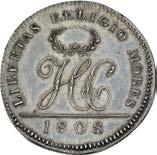

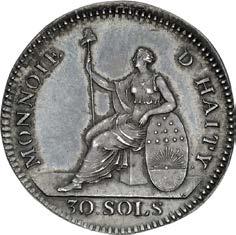
836. HAITI, State of Haiti. Henri Christophe. President, 1807-1811. Essai de 30 Sols (25mm, 5.57 g, 12h). Soho (Birmingham) mint. Dated 1808. LIBERTAS RELIGIO MORES, HC cypher crowned by laurel wreath; 1808 in exergue / MONNOIE D HAITY, Liberty seated left, holding liberty cap on pole and resting arm on shield; 30 SOLS in exergue. Lissade 11; Arroyo HA#P8; KM Pn8. Toned. In NGC encapsulation 6909490-011, graded MS 62. ($750)
From the Alexander Christopher Collection.
On 25 January 1808, Jean Gabriel Peltier, president Christophe’s commercial agent in London, approached Matthew Boulton to secure dies and machinery for a new coinage. By August, the dies were complete and samples were delivered to Peltier of the proposed coinage of 7½, 15, and 30 Sol pieces in silver. Twenty-seven coins of all denominations were presented in varying silver fineness. Additionally, Boulton secured a manual coin press at the cost of 70 guineas. The bill was apparently paid, but no further coins were struck by Christophe from his mint in Cap-Haitien.


837. HUNGARY, Holy Roman Empire. Kingdom of Hungary. Ferdinánd I. 1526-1564. AR Taler (45mm, 28.62 g, 6h). Körmöcbánya (Kremnitz) mint. Dated 1556 KB. Crowned and armored half-length bust right, holding scepter over shoulder and resting hand on hilt of sword / Nimbate eagle facing with wings spread, head left, coat-of-arms on breast; all within coat-of-arms surmounted by Madonna with child. Huszár 913; Davenport 8032. Toned. In NGC encapsulation 2156024-001, graded MS 62. Top Pop ($1000)
From the Alexander Christopher Collection.
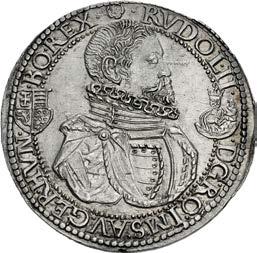


838. HUNGARY, Holy Roman Empire. Rudolf. 1576-1608. AR Taler (41mm, 26.68 g, 12h). Nagybánya (Frauenbach) mint. Dated 1604 NB. Armored bust right, wearing ruff; coat-of-arms and Madonna with child in legend / Crowned doubleheaded eagle facing, holding sword and scepter; globus cruciger on breast. Huszár 1041; Davenport 3013; KM 18. Toned. In NGC encapsulation 6908078-004, graded MS 63. ($2000)
From the Alexander Christopher Collection.
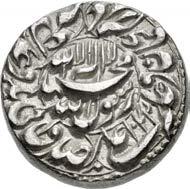


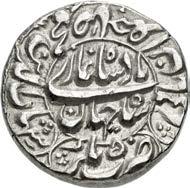
839. INDIA, Mughal Empire. Shihab al-Din Muhammad Shah Jahan. AH 1037-1068 / AD 1627-1658. AR Rupee (21mm, 11.47 g, 12h). Bhakkar mint. Dually dated AH 1042; RY 5 (19 January/14 February AD 1632 – 18 January/13 February AD 1633). Shahada within circular linear frame; oaths of Rashidun and AH date in outer margin / Name and title of Shah Jahan circular linear frame; continuation of legend, mint formula, and RY date in outer margin. IMC (Wright) 921 var. (1043/6); cf. Hull 1598; KM 227.4; Zeno 325602 (this coin). Light iridescence, tiny flan flaw on reverse, banker’s mark on edge. Near EF. ($500)
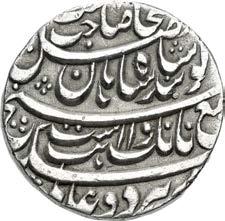
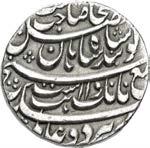


840. INDIA, Independent States. Sikhs (Khalsa Fauj). Baba Banda Singh Bahadur. 1670-1716. AR Rupee (25mm, 11.98 g, 6h). Amritsar mint. Dated Year 2 (AD 1711). Nankshahi couplet 1 / Mint and year formula: zarb khalsa mubarak bakht ba-aman as-dahur zinat at-takht mashwarat shahr sanat 2 in six lines in Persian. SS p. 14, 1; Herrli 01.01.04; Zeno 261002 (this coin). Lightly toned, cleaning marks, slight peripheral weakness. VF. Extremely rare. None in CoinArchives. ($1500)


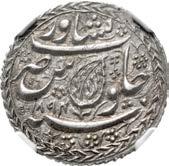
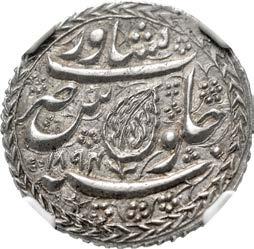
841. INDIA, Independent States. Sikh Empire. temp. Ranjit Singh. VS 1858-1896 / AD 1801-1839. AR Rupee (25mm, 11.07 g, 7h). Issue of Hari Singh Nalwa. Peshawar mint. Dated VS 1894/1894 (AD 1837). Gobindshahi couplet; VS date to left; all within wreath / Mint and date formula; pipal leaf; VS date to right; all within wreath. Edge: |||||. SS PW 207; Herrli 13.04.04; KM – . In NGC encapsulation 2892100-001, graded AU 58. Very rare. Top Pop. ($1500)

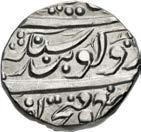


842. INDIA, Independent States. Sikh Empire. temp. Ranjit Singh. VS 1858-1896 / AD 1801-1839. AR Rupee (23mm, 11.05 g, 3h). Mankera mint. Dated VS 1880 (AD 1823). Herrli Gobindshahi couplet Ib / Mint and date formula; pipal leaf. SS 1bd; Wiggins & Goron Type VI (Mulkerian); Herrli 33.02.04; KM 72 (Malkarian). Lightly toned, deposits. Good VF. Rare mint. ($1500)
Ex Triton XXVI (10 January 2023), lot 1079.




843. INDIA, Colonial. British India. Madras Presidency. 1653-1835. AR Half Pagoda (36.5mm, 21.27 g, 12h). Second issue. Madras mint. Struck 1808-1812. Gōpuram (temple porch or entrance) set on ground; nine stars to left, nine to right; all within buckled garter inscribed HALF PAGODA and nim hun phuli (half a flower, or star, pagoda) in Persian / Vishnu, holding sword in hand, standing facing, rising from lotus; floral and pellet design to left and right; all surrounded by triple-pelleted border; star above; all within swallowtail banner inscribed arai pu vara kun in Tamil and ara pu vara hun (half a flower, or star, pagoda) in Telegu; no stop in legend. CEEIC 3.144 (dies Q/X); Pridmore 171A; KM 353. Richly toned. In NGC encapsulation 6381631-041, graded AU 55. Very rare variety. Overstruck on a Colonial (possibly Mexico City mint) 8 Reales of Charles III of Spain. ($1500)
Ex Robert P. Puddester Collection.
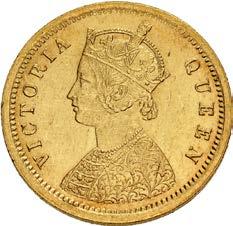
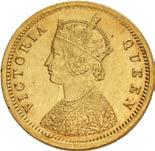
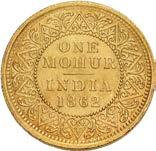

844. INDIA, Colonial. British India. Victoria. Queen of the United Kingdom, 1837-1901; Empress of India, 1876-1901. AV Mohur (26mm, 11.64 g, 12h). Calcutta mint. Dated 1862. Crowned bust left; V at truncation of bust / ONE/MOHUR/–/ INDIA/1862 in five lines; all within ornate floral border. UIC 4.6; Pridmore 6; Friedberg 1598. In NGC encapsulation 6908072008, graded MS 61. ($2000)
From the Alexander Christopher Collection.



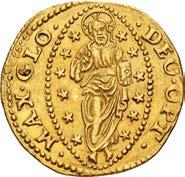
845. ITALY, Genova. The Biennial Doges. 1528-1797. AV Zecchino (21mm, 3.52 g, 7h). Copying the types of Venice. Genova mint. Struck circa 1554. St. John standing right, presenting banner to doge kneeling left / Christ standing facing within mandorla containing twelve stars. Scarfea, Imitazioni 350; MIR 210; Friedberg 435. Toned with traces of luster. Near EF. Very rare. ($10,000)
In the 16th century, the Venetian zecchino was the de facto trade coinage of the Mediterranean world. The Genovese began striking their own Venetian-style coins, including both the gold zecchino and various silver denominations, in 1554. The coins are today extremely rare. They were most likely withdrawn shortly after the initial issue, possibly due to protests from the Venetians. Other areas, particularly in India, continued to copy the zecchino with abandon, striking increasingly stylized imitations as late as the 20th century.

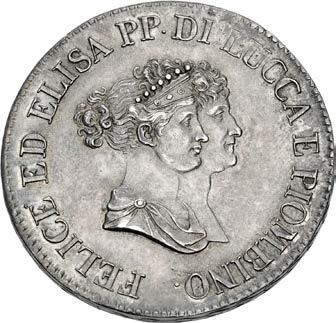

846. ITALY, Lucca & Piombino (Principality). Elisa Bonaparte & Felice Baciocchi. 1805-1814. AR 5 Franchi – Scudo (36mm, 25.00 g, 6h). Lucca mint. Dated 1805. Jugate busts of Elisa, crowned and draped, and Felice right / Denomination within wreath. MIR 244; Davenport 203; KM 24.1. Toned. In NGC encapsulation 6903643-004, graded MS 62. ($750)
From the Alexander Christopher Collection.

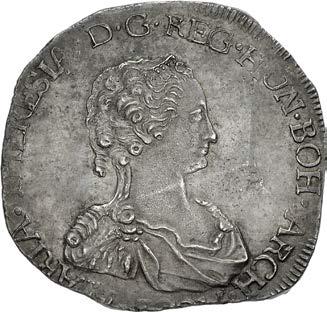

847. ITALY, Milano (Duchy). Maria Theresa d’Asburgo. 1740-1780. AR Filippo (37mm, 27.86 g, 10h). Dated 1749 Crowned and draped bust right / Crowned coat-of-arms between olive branch and palm frond. MIR 419/5; Crippa 2/D; Davenport 1384; KM 164. Toned. In NGC encapsulation 6896874-002, graded MS 62. Very rare. ($3000)
Ex Heritage 3061 (7 January 2018), lot 32396 (there in NGC MS 63; hammer $7000).


848. ITALY, Papal (Papal state). Alexander VIII. 1689-1691. AR Testone (31mm, 9.12 g, 12h). Rome mint. Dated RY 2 and 1690. Bust right, wearing camauro, mozzetta, and pallium / Sts. Magnus, holding croizer and raising hand in benediction, and Bruno, holding and gesturing towards open book, standing facing one another. MIR 2083/1; Muntoni 14; Berman 2175; KM A523. Toned with underlying luster. In NGC encapsulation 6898674-014, graded AU 58. ($500)
From the Alexander Christopher Collection.
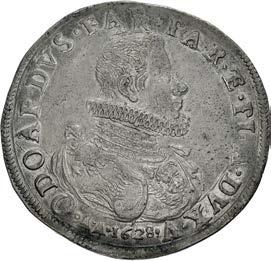


849. ITALY, Parma & Piacenza (Duchy). Odoardo Farnese. 1622-1646. AR Scudo (43mm, 28.12 g, 12h). Parma mint. Dated 1628 AA. Armored and draped bust of Odoardo right, wearing ruff / Armored bust of St. Vitale right, holding scepter over shoulder. MIR 1013/6; Davenport 4120 = KM (DAV) 4120. Toned. In NGC encapsulation 6896874-009, graded AU 55. ($3000)
Ex Triton XIII (5 January 2010), lot 2015 (hammer $5500).

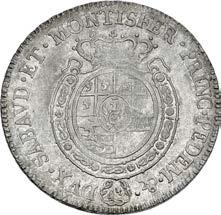


850. ITALY, Sardegna (Kingdom). Vittorio Amadeo III. 1773-1796. AR Mezzo scudo (36mm, 17.60 g, 6h). Torino mint. Dated 1791. Laureate and cuirassed bust left / Crowned and collared coat-of-arms. MIR 988r; KM 72. Even gold and gray toning. In NGC encapsulation 6903643-008, graded MS 61. Top Pop ($500)
From the Alexander Christopher Collection.
851. ITALY, Sardegna (Kingdom). Carlo Felice. 1821-1831. AR 5 Lire (36mm, 24.95 g, 6h). Genova mint; differenti: P and anchor. Dated 1827. Bare head right / Crowned and collared coat-of-arms within wreath. MIR 1035j; Davenport 135; KM 116.2. Deeply toned. In NGC encapsulation 6903643-007, graded MS 62. ($500)
From the Alexander Christopher Collection.
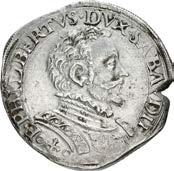

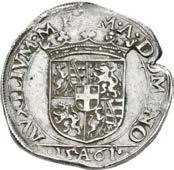
852. ITALY, Savoia (Duchy). Emanuele Filiberto. 1553-1580. AR Testone (28mm, 9.29 g, 6h). Asti(?) mint. Dated 1561 A. Armored bust right, wearing ruff / Crowned coat-of-arms. MIR 510. Toned, flan split, light deposits and faint scratches. Near EF. Rare. ($1500)
From the J. Eric Engstrom Collection. Ex Monnaies de Collection Monaco 4 (15 November 2018), lot 973.


853. ITALY, Sicilia (Kingdom). Ferdinando III di Borbone. 1759-1816. AR Oncia (48mm, 68.19 g, 12h). Palermo mint. Dated 1793 Nd OV. Cuirassed bust right / Phoenix rising from flames; head right, wings spread; radiant sun above. MIR 598/1; Spahr 3; KM 227. Toned. In NGC encapsulation 2156706-002, graded AU 55. ($1500)
From the Alexander Christopher Collection.

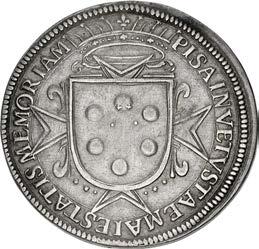
854. ITALY, Toscana (Grand Duchy). Ferdinando I de Medici. 1587-1609. AR Tallero (41mm, 28.24 g, 6h). Pisa mint. Dated 1601. Radiate and armored half-length right, holding scepter over shoulder / Crowned and collared coat-of-arms with star of St. Stephen in background. MIR 443/3; Davenport 4186; KM 15. Toned. In NGC encapsulation 6898707-007, graded AU 55. ($750)
From the Alexander Christopher Collection.

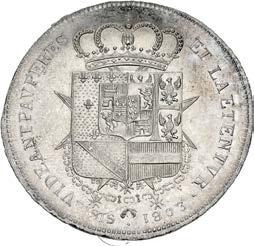
855. ITALY, Toscana (Grand Duchy). Lodovico I di Borbone. 1801-1803. AR Scudo da 10 Paoli – Francescone (40mm, 27.17 g, 6h). Firenze mint; differenti: hammer and monogram. Dated 1803. Bare head right / Crowned and collared coat-of-arms with star of St. Stephen in background. MIR 415/3; Davenport 151; KM (C) 42.2. Lightly toned with luster. In NGC encapsulation 6903643-009, graded MS 63. ($500)
From the Alexander Christopher Collection.


857. ITALY, Venezia (Venice). Lot of two-hundred (200) AR Grosso. Includes: mostly issues of Antonio Veniero. Some with porosity. Fine to Good VF. Two-hundred (200) coins in lot. LOT SOLD AS IS, NO RETURNS. ($5000)


858. ITALY, Venezia (Venice). Provisional Government. 1797-1798. AR 10 Lire (40mm, 28.31 g, 12h). Dated 1797 AS Liberty standing left, holding Liberty cap on pole and resting hand on fasces; cannon and flags in background / Denomination in three lines within wreath. Paolucci, Zecca 918; Davenport 1576; KM 776. Patchy toning, deposits, die break. Good VF. Rare. ($750)
From the Alexander Christopher Collection.



859. ITALY, Piedmontese Republic. 1798-1799. AR Mezzo scudo (35mm, 17.59 g, 6h). Torino mint. Dated year 7 of the French Republic (AD 1799). Helmeted figure standing right, head left, resting hand on liberty cap set on fasces / Denomination within wreath. MIR 1006; KM (C) 2. Lightly toned and lustrous. In NGC encapsulation 6903643-003, graded MS 65. ($2000)
From the Alexander Christopher Collection.



860. ITALY, Kingdom of Italy (Napoleonic). Napoleone. 1805-1814. AV 40 Lire (25mm, 12.90 g, 6h). Milano mint; differenti: pomegranate and inverted cup. Dated 1814 M. Bare head left / Crowned and mantled eagle with collared coat-of-arms on breast; crossed halberds in background. MIR 488/7; Crippa 25/G; KM 12; Friedberg 5. Lustrous. In NGC encapsulation 6908072-001, graded MS 62. ($1000)
From the Alexander Christopher Collection.




861. ITALY, Kingdom of Italy (Napoleonic). Napoleone. 1805-1814. AV 20 Lire (21mm, 6.44 g, 12h). Milano mint; differenti: pomegranate and inverted cup. Dated 1810 M. Bare head left / Crowned and mantled eagle facing, head left, coatof-arms within collar on breast; crossed halberds behind. MIR 489/3; Crippa 26/C; KM 11; Friedberg 7. In NGC encapsulation 6890874-015, graded MS 62. Top Pop ($500)
From the Alexander Christopher Collection.


862. ITALY, Kingdom of the Two Sicilies. Ferdinando II. 1830-1859. AR 120 Grana – Piastra (37mm, 27.53 g, 5h). Napoli mint. Dated 1852. Head right / Crowned coat-of-arms. MIR 503/1; Pannuti-Riccio 81; KM 370. Lustrous. In NGC encapsulation 6909478-015, graded MS 64. ($500)
From the Alexander Christopher Collection.



863. LOW COUNTRIES, Spanish Netherlands. Albrecht & Isabella. 1598-1621. AR Dukaton (44mm, 32.47 g, 10h). Antwerp in Brabant mint; mm: hand. Dated 1619. Jugate busts of Albrecht, draped and armored, and Isabella, both wearing ruffs / Crowned coat-of-arms with leonine supporters; vuurijzer below. Vanhoudt 617.AN; G&H 309-1; Delmonte, Argent 248; Davenport 4428; KM 49.1. Toned, a few hairlines and flan flaws. Good VF. ($500)


864. LOW COUNTRIES, Spanish Netherlands. Filips V. 1700-1712. AR Dukaton (42mm, 32.62 g, 12h). Antwerp in Brabant mint; mm: hand. Dated 1703. Armored and draped bust right / Crowned and collared coat-of-arms with leonine supporters. Vanhoudt 737; G&H 365-1c; Delmonte, Argent 354c; Davenport 1707; KM 131.3. Toned. In NGC encapsulation 6896874-005, graded AU 58. ($1500)


865. LOW COUNTRIES, Austrian Netherlands. Jozef II. 1780-1790. AR Kroon – Kronentaler (40mm, 29.44 g, 6h). Brussels mint; mm: angel’s head. Dated 1782. Laureate head right / Cross saltire fleurée; three crowns and Order of the Golden Fleece in quarters. Vanhoudt 852; Delmonte, Argent 393; Davenport 1284; KM 32. Toned with significant luster, hairlines. UNC. ($600)
From the Alexander Christopher Collection.
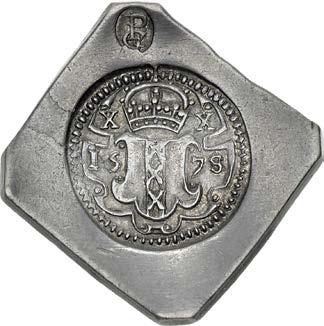

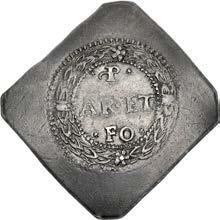

866. LOW COUNTRIES, Dutch Revolt. Amsterdam. Besieged by the States-General, December 1577-8 February 1578. AR 20 Stuiver (28x27mm, 13.44 g, 12h). Dated 1578. Crowned city coat-of-arms; X X flanking crown, 15 78 flanking arms; all within circular pearl border; soldeervaasje (solder pot) stamp above / (star) P (star)/AR · ET/(star) FO (star) in three lines; all within wreath. Korchnak 20; P&W Am 02; CNM 2.02.4. Deeply toned. In NGC encapsulation 6898707-009, graded AU 58. ($750)
From the Alexander Christopher Collection.

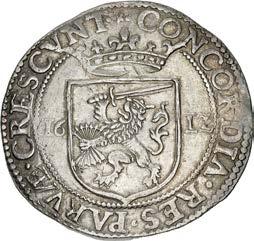
867. LOW COUNTRIES, Republic of the Seven Netherlands (Dutch Republic). Gelderland. 1581-1795. AR Rijksdaalder – Taler (40mm, 28.33 g, 10h). Mm: cross-crosslet. Dated 1612. Laureate and armored bust right, wearing ruff, holding sword over shoulder and coat-of-arms from ribbon / Crowned coat-of-arms. P&W Ge73; CNM 2.17.121; Delmonte, Argent 938; Davenport 4828; KM 16.1. Lightly toned. In NGC encapsulation 6898707-012, graded AU 58. Top Pop. ($500)
From the Alexander Christopher Collection.


868. MEXICO, Colonial. Felipe V. King of Spain, second reign, 1724-1746. AR 8 Reales (40mm, 25.06 g, 12h). Cob coinage. Mexico City mint. Dated 1733 Mo F. Crowned coat-of-arms; Mo/F to left, [*]/8/* to right / Cross pattée, arms of Castile and Leon in opposite quarters; all within ornate polylobe. BW 15.9; KM 48. Porous as usual, sea salvaged. VF. ($500)
Ex Classical Numismatic Group Electronic Auction 366 (13 January 2016), lot 1040.

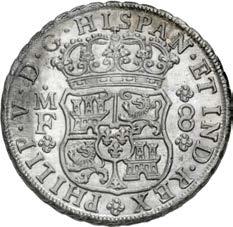

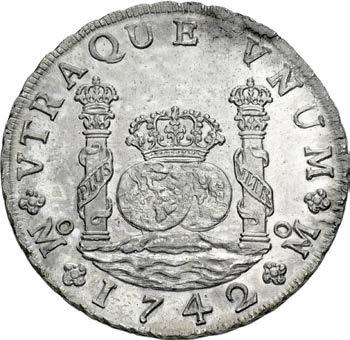
869. MEXICO, Colonial. Felipe V. King of Spain, second reign, 1724-1746. AR 8 Reales (38mm, 27.14 g, 12h). Columnario type. Mexico City mint. Dated 1742 Mo MF. Crowned coat-of-arms / Crowned hemispheres between crowned pillars ornamented with banners; all set on waves. Gilboy M-8-4; BW 28.1; KM 103. Minor cleaning marks and traces of shipwreck effect. Choice EF. A superbly preserved shipwreck coin. ($750)
Ex Libertas Collection (Classical Numismatic Group 124, 19 September 2023), lot 916, purchased August 1981; 1747 Reijgersdaal wreck. On 24 October 1747, the Dutch East Indiaman Reijgersdaal (or Reygjersdahl) anchored to resupply near Dassen Island, just north of Cape Town, South Africa. But during a storm, the ship’s anchor line snapped and she was dashed on the rocks. A handful of the crew survived and attempted to salvage the eight chests of coins held aboard, but only one was recovered, as the area was too dangerous. Modern recovery efforts began in 1979.


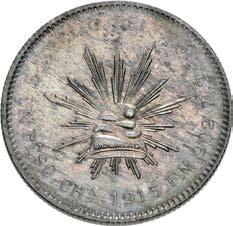

870. MEXICO, Mexican Revolution. State of Chihuahua. Army of the North. AR Peso (38mm, 25.89 g, 6h). Struck at the Guadalajara mint under General José Delgado. Dated 1915 CHA FM. Eagle standing facing on cactus, wings spread, grasping snake in beak and right talon; all within laurel and oak wreath / Liberty cap; glory of rays in background. G&B 72; BW 287.2; KM 619. Toned. In NGC encapsulation 6908078-008, graded MS 63. ($750)
From the Alexander Christopher Collection.

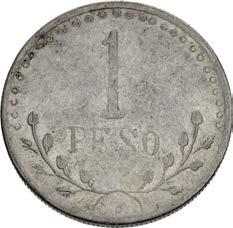
871. MEXICO, Mexican Revolution. State of Chihuahua. Hidalgo del Parral. AR Peso (39mm, 27.37 g, 6h). Issued under Pancho Villa. Dated 1913. H/ DEL/ PARRAL between arch of annulets and half-wreath with berries; 1913. below / 1/ PESO between arch of annulets and half-wreath; annulet below. G&B 79; BW 286.1; KM 611. Toned. In NGC encapsulation 6908078-006, graded AU 53. ($1000)
From the Alexander Christopher Collection.


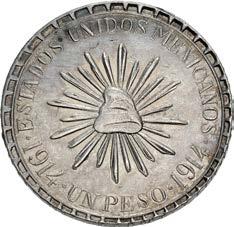
872. MEXICO, Mexican Revolution. State of Durango. Cuencamé. AR Peso (39mm, 22.88 g, 5h). “Muera Huerta” type. Issued under the Ejército Constitucionalista. Dated 1914. Eagle standing facing on cactus, wings spread, grasping snake in beak and right talon; all within laurel and oak wreath / Liberty cap; glory of rays in background. G&B 86; BW 288.4; KM 621a. Toned. In NGC encapsulation 6908078-007, graded UNC Details, cleaned. ($1000)
From the Alexander Christopher Collection.
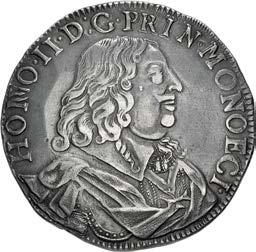
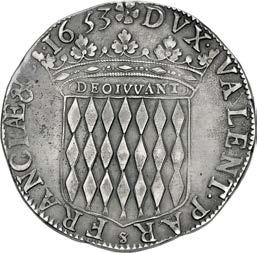
873. MONACO. Honoré II. 1604-1662. AR Écu (40mm, 26.99 g, 12h). Third emission. Dated 1653. Armored bust right / Crowned coat-of-arms. C&C 34; Davenport 4306; KM 23. Toned. In NGC encapsulation 6896874-008, graded AU 50. ($1500)
Ex Künker 217 (9 October 2012), lot 2915 (hammer €2500).

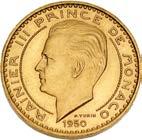
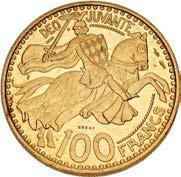
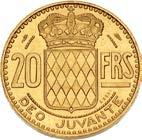
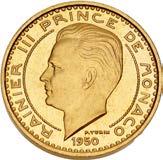

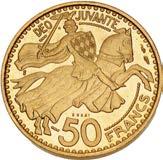

874. MONACO. Rainier III. 1949-2005. Set of four (4) AV Piedfort Essais. Paris mint; différents: cornucopia and wing. Dated 1950. Includes: (a) Piedfort AV Essai de 100 Francs. KM PE9a. In NGC encapsulation 6909515-001, graded MS 65. Top Pop // (b) Piedfort AV Essai de 50 Francs. KM PE8a. In NGC encapsulation 6909515-002, graded MS 64 // (c) Piedfort AV Essai de 20 Francs. KM PE7a. In NGC encapsulation 6909515-003, graded MS 65 // (d) Piedfort AV Essai de 10 Francs. KM PE6. In NGC encapsulation 6909515-004, graded MS 64. All NGC graded MS 64 or MS 65. Only 325 struck of each denomination. Four (4) coins in lot. ($4000)
From the Alexander Christopher Collection.
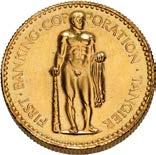

875. MOROCCO, French Protectorate. First Banking Corporation, Tangier. AV One Ounce Ingot – 500 Dirhems (25mm, 33.93 g, 12h). Refined by N.M. Rothschild & Sons. Struck 1954. Hercules standing facing, holding club and lion’s skin / Refiner’s logo. KM (X) 12. In NGC encapsulation 6908072-006, graded MS 65. ($1500)
From the Alexander Christopher Collection.

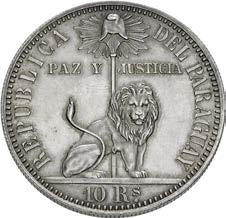
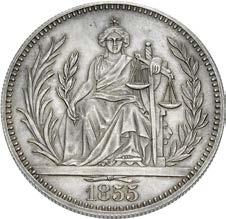

876. PARAGUAY, Republic. 1811-pres. Pattern AR 10 Reales (37mm, 25.40 g, 6h). Paris mint. Dated 1855 REPUBLICA DEL PARAGUAY, lion seated right, head facing, before radiant Liberty cap on pole; PAZ Y JUSTICIA across field; 10 RS below / Justice seated facing, holding olive branch, scaples, and sword, within wreath of palm frond and laurel branch; 1855 in exergue. KM Pn8. Toned, hairlines. AU. ($3000)
From the Alexander Christopher Collection.
At the time of the creation of this pattern, only a single regular issue of coins had been made by the state of Paraguay in 1845, when 2.88 million copper 1/12 reales were struck at the Birmingham mint, with a smaller issue of 288,000 struck in Ascuncion. In 1854 and 1855, a series of pattern 10 Reales were made in Paris, but they were never adopted for the circulating coinage. It would not be until 1889 that the Paraguayan state would issue their own silver coinage.




877. PERU, Colonial. Felipe V. King of Spain, second reign, 1724-1746. AV 8 Escudos (27mm, 26.95 g, 6h). Cob type. Lima mint. Dated 1737 L N. Quartered coat-of-arms of Spain / Crowned Pillars of Hercules set upon waves; crown above. Menzel Lm-207; KM 38.2; Friedberg 7. Lustrous, minor edge split. EF. ($4000)
From the Gerald F. Borrmann (Northern California Gentleman) Collection, purchased from M. Dunigan, 2004.

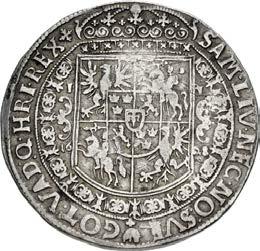
878. POLAND, Monarchy. Zygmunt III Wasa. 1587-1632. AR Talar – Taler (41mm, 28.49 g, 2h). Bydgoszcz (Bromberg) mint. Dated 1628 I I. Crowned and armored half-length bust right, wearing ruff and holding sword and globus cruciger / Crowned and collared coat-of-arms. Kopicki 1375; Davenport 4316; KM 48.1. Toned, lightly chased, edge marks. VF. ($1000)
From the Alexander Christopher Collection.


879. POLAND, Monarchy. Wladyslaw IV Wasa. 1632-1648. AR Talar – Taler (45mm, 28.50 g, 9h). Torún (Thorn) mint. Dated 1637 I I. Crowned and armored bust right, wear lace collar, holding sword over shoulder and globus cruciger / Coatof-arms in ornate frame supported by angel with wings spread. D&S, Thorvnensis 1500; Kopicki 8276; MP 1883e; Davenport 4374; KM 21. Toned, glue on reverse, chased, mount marks. VF. ($1500)
From the Alexander Christopher Collection.


880. POLAND, Monarchy. Stanislaw August Poniatowski. 1764-1795. AR Talar – Taler (43mm, 28.04 g, 12h). Warszawa (Warsaw) mint. Dated 1766 FS. Armored bust right / Crowned coat-of-arms within wreath of oak and palm fronds. Kopicki 2456; MP 1228; Davenport 1618; KM 187. Toned, hairlines, edge marks. AU. ($750)
From the Alexander Christopher Collection.

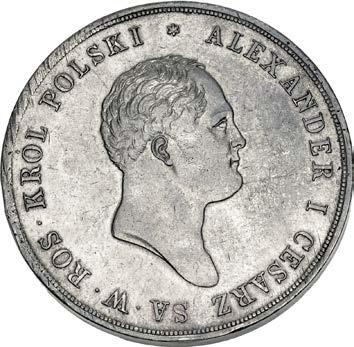

881. POLAND, Congress Poland. Aleksandr I Pavlovich. 1801-1825. AR 10 Złotych (38mm, 30.99 g, 12h). Warszawa (Warsaw) mint. Dated 1822 IB. Bare head right / Crowned double-headed eagle holding sword, scepter, and globus cruciger; crowned and mantled coat-of-arms on breast. Parchimowicz 1041c; Kopicki 2716; Bitkin 821; KM (C) 101. Toned. In NGC encapsulation 6909359-013, graded AU Details, cleaned. ($1500)
From the Alexander Christopher Collection.


882. POLAND, Congress Poland. Aleksandr I Pavlovich. 1801-1825. AR 2 Złote (25mm, 9.13 g, 12h). Warszawa (Warsaw) mint. Dated 1824 IB. Bare head right / Crowned double-headed eagle holding sword, scepter, and globus cruciger; crowned and mantled coat-of-arms on breast. Parchimowicz 1035f; Kopicki 2699; Bitkin 840; KM (C) 99b. Toned. In NGC encapsulation 6909501-002, graded AU 58. Top Pop. Rare in this high grade. ($600)
From the Alexander Christopher Collection.




883. POLAND, Congress Poland. Nikolai I Pavlovich. 1825-1855. AR 15 Kopiejek – 1 Złoty (18mm, 3.10 g, 12h). Warszawa (Warsaw) mint. Dated 1832 HΓ. Crowned double-headed eagle with wings spread, collared coat-of-arms on breast, coat-of-arms on wings, holding scepter and globus cruciger. St. George with mantle / Denomination and date. Parchimowicz 1031a; Kopicki 2684; Bitkin 1111; KM (C) 129. Toned. In NGC encapsulation 6909478-012, graded MS 63. ($750)
From the Alexander Christopher Collection.
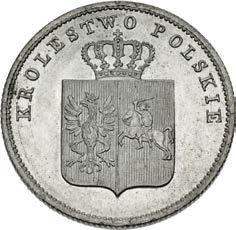


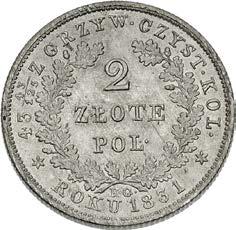
884. POLAND, November Uprising. 1830-1831. AR 2 Złote (25mm, 9.10 g, 12h). Warszawa (Warsaw) mint. Dated 1831 KG. Crowned coat-of-arms / Denomination within wreath. Parchimowicz 1057a; Kopicki 2748; KM (C) 123. Lustrous. In NGC encapsulation 6909501-003, graded MS 65. ($1000)
From the Alexander Christopher Collection.



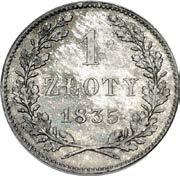
885. POLAND, Krakow (Free City). 1815-1846. AR Złoty (19mm, 3.10 g, 12h). A. Woppenstein (Vienna) mint. Dated 1835. Crowned coat-of-arms / Denomination and date within wreath. Parchimowicz 1062; Kopicki 7859; KM (C) 13. Toned. In NGC encapsulation 6909501-001, graded MS 63. ($500)
From the Alexander Christopher Collection.


886. POLAND, Republic of Poland. 1919-1939. Proof NI 50 Groszy (23mm, 5.00 g, 12h). Dated 1923. Crowned eagle left with wings spread, head left / Denomination within wreath. Parchimowicz P118d; KM (Y) 13. See Antykwariat Numismaticzny 40 (16 September 2023), lot 604 for another example. In NGC encapsulation 6909501-004, graded PF 66. Extremely rare. KM gives a proof mintage of only 10 examples. ($750)
From the Alexander Christopher Collection.


887. ROMANIA, Kingdom. Carol I. 1881-1914. AV 50 Lei (40mm, 16.17 g, 1h). Commemorating the 40th Year of His Reign. Brussels mint. Dated 1866 and 1906. Uniformed bust left / Carol on horseback right. MBR 82; KM 39; Friedberg 6. In NGC encapsulation 6890893-005, graded AU 58. ($1500)
From the Alexander Christopher Collection.

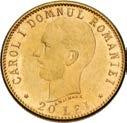

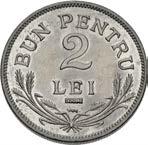
888. ROMANIA, Kingdom. Carol I. 1881-1914. AV 20 Lei (21mm, 6.46 g, 12h). Commemorating the 40th Year of His Reign. Brussels mint. Dated 1866 and 1906. Bare old head of Carol left / Bare youthful head of Carol left. MBR 80; KM 37; Friedberg 5. In NGC encapsulation 3890893-001, graded MS 61. ($1000)
From the Alexander Christopher Collection.
889. ROMANIA, Kingdom. Ferdinand I. 1914-1927. CU-NI 2 Lei Essai (23mm, 7.03 g, 6h). Poissy mint. Dated 1924. Crowned coat-of-arms with leonine supporters / Denomination over grain ears. MBR –; KM PnA217. In NGC encapsulation 6909480-001, graded MS 65. An attractive essai. ($500)
From the Alexander Christopher Collection.

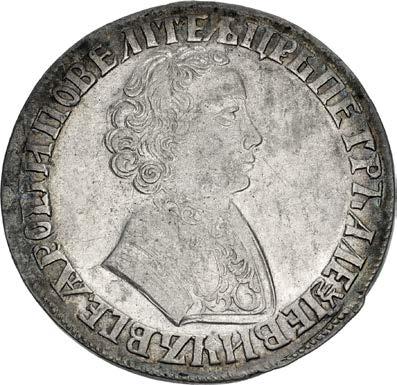

RUSSIA, Empire. Petr I Alexeyevich Velikiy (Peter the Great). 1682-1725. AR Rouble (43mm, 1h). Krasny (Red) mint. Dated 1705 (in OCS numerals). Armored bust right / Crowned double-headed eagle facing with wings spread, holding scepter and globus cruciger; closed crown above. Diakov 4; Bitkin 798; KM 122.2. Toned. In NGC encapsulation 6906866006, graded AU Details, spot removed. ($3000)
From the Alexander Christopher Collection.
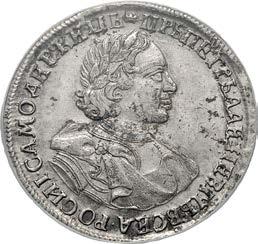

891. RUSSIA, Empire. Petr I Alexeyevich Velikiy (Peter the Great). 1682-1725. AR Rouble (40mm, 12h). Kadashevsky mint. Dated 1720 (in OCS numerals). Laureate, draped, and armored bust right / Crowned double-headed eagle facing with wings spread, holding scepter and globus cruciger; crown above. Diakov 8; Bitkin 226; KM 157.4. Toned. In PCGS encapsulation 33437200, graded XF 45. ($1000)


892. RUSSIA, Empire. Ekaterina I Alexeyevna. 1725-1727. AR Rouble (43mm, 28.78 g, 1h). St. Petersburg mint. Dated 1725. Crowned bust left / Crowned double-headed eagle facing, holding scepter and globus cruciger; crown above. Diakov 10; Bitkin 103; KM 168. Toned. In NGC encapsulation 6906688-011, graded XF 40. ($500)
From the Alexander Christopher Collection.


893. RUSSIA, Empire. Petr II Alexeyevich. 1727-1730. AR Rouble (39mm, 28.35 g, 12h). Kadashevsky mint. Dated 1728. Cuirassed and draped bust right / Crowned cruciform П monogram; II in each quarter. Diakov 19; Bitkin 61; KM 182.2. Toned. In NGC encapsulation 6906688-003, graded AU 53. ($750)
From the Alexander Christopher Collection.
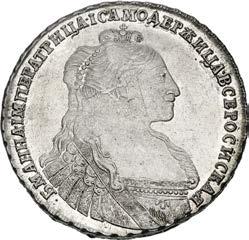
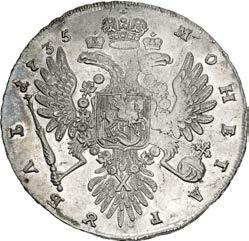
894. RUSSIA, Empire. Anna Ioannovna. 1730-1740. AR Rouble (41mm, 25.98 g, 12h). Kadashevsky mint. Dated 1735. Crowned bust right / Crowned double-headed eagle facing, holding scepter and globus cruciger; crown above, collared coat-of-arms on breast. Diakov 7; Bitkin 122; KM 197. Toned with underlying luster. In NGC encapsulation 6906612-004, graded UNC Details, cleaned. ($750)
From the Alexander Christopher Collection.

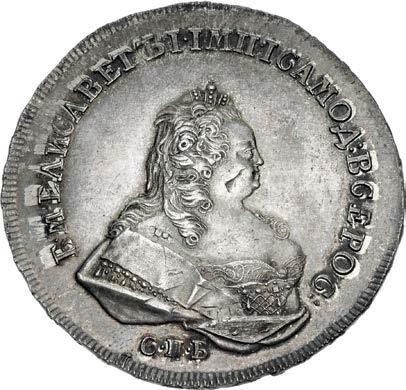
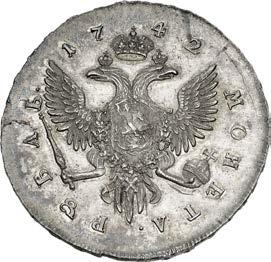
895. RUSSIA, Empire. Yelizaveta Petrovna (Elizabeth). 1741-1762. AR Rouble (44mm, 25.94 g, 12h). St. Petersburg mint. Dated 1742 СПБ. Crowned bust right / Crowned double-headed eagle facing, holding scepter and globus cruciger; crown above, collared coat-of-arms on breast. Diakov 35; Bitkin 245; KM (C) 19b.3. Deeply toned with underlying luster. In NGC encapsulation 6906684-001, graded MS 63+. An attractive example. ($2500)
From the Alexander Christopher Collection.

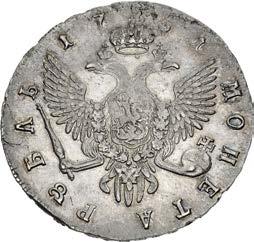
896. RUSSIA, Empire. Yelizaveta Petrovna (Elizabeth). 1741-1762. AR Rouble (40mm, 26.02 g, 12h). St. Petersburg mint. Dated 1751 СПБ. Crowned bust right / Crowned double-headed eagle facing, holding scepter and globus cruciger; crown above, collared coat-of-arms on breast. Diakov 242; Bitkin 266; KM (C) 19b.4. Toned. In NGC encapsulation 6906688002, graded AU 58. ($750)
From the Alexander Christopher Collection.

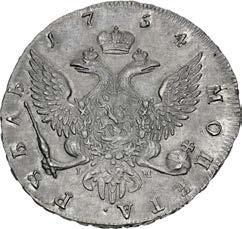
897. RUSSIA, Empire. Yelizaveta Petrovna (Elizabeth). 1741-1762. AR Rouble (39mm, 25.35 g, 12h). St. Petersburg mint. Dated 1754 СПБ IM. Crowned bust right / Crowned double-headed eagle facing, holding scepter and globus cruciger; crown above, collared coat-of-arms on breast. Diakov 309; Bitkin 273; KM (C) 19c.2. Toned. In NGC encapsulation 6806688015, graded AU 55. ($750)
From the Alexander Christopher Collection.


898. RUSSIA, Empire. Yelizaveta Petrovna (Elizabeth). 1741-1762. AR Rouble (40mm, 26.27 g, 12h). St. Petersburg mint. Dated 1755 СПБ ЯI. Crowned bust right / Crowned double-headed eagle facing, holding scepter and globus cruciger; crown above, collared coat-of-arms on breast. Diakov 340; Bitkin 276; KM (C) 19c.2. Toned. In NGC encapsulation 6906612001, graded AU 55. ($500)
From the Alexander Christopher Collection.


899. RUSSIA, Empire. Yelizaveta Petrovna (Elizabeth). 1741-1762. CU Kopeck (32mm, 20.11 g, 5h). St. Petersburg mint. Dated 1756 СПБ. Eagle nestled right in clouds, head left, with wings spread, supporting ornate shield inscribed with royal cypher; crown above / Eagle nestled right in clouds, head left, with wings spread, supporting ornate shield inscribed with denomination in three lines; crown above. Edge: cross hatched. Brekke 54; Diakov 416; Bitkin 534; KM (C) 3.3. In NGC encapsulation 6908067-010, graded AU 53 BN. Overstruck on a 1726 Kopeck. ($500)
From the Alexander Christopher Collection.
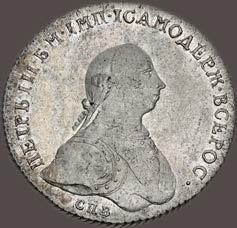



900. RUSSIA, Empire. Petr III Fyodorovitch. 1762. AR Rouble (39mm, 11h). St. Petersburg mint. Dated 1762 СПБ HK. Armored bust right / Crowned double-headed eagle facing, holding scepter and globus cruciger; crown above, collared coat-of-arms on breast. Edge: engrailed. Diakov 7; Bitkin 11; KM (C) 47.2. Lightly toned and lustrous. In NGC encapsulation 6906866-002, graded MS 62. Rare. ($6000)
From the Alexander Christopher Collection.
The son of Anna Ioannova, the daughter of Petr I and Ekaterina I, Petr III was adopted by Yelizaveta and following her death became Tsar. He was a political disaster and following a very short reign, he was assassinated by Alexei Orlov, the favorite of Sophie, Princess of AnhaltZerbst, who then became Ekaterina II (“the Great”).
For an issue of Petr III as the Duke of Schleswig-Holstein-Gottorp, see lot 819.


901. RUSSIA, Empire. Ekaterina II Velikaya (the Great). 1762-1796. AR Poltina (31mm, 11.36 g, 12h). St. Petersburg mint. Dated 1764 СПБ ЯI. Crowned and draped bust right / Crowned double-headed eagle facing, holding scepter and globus cruciger; crown above, collared coat-of-arms on breast. Diakov 83; Bitkin 274; KM (C) 66.2a. Toned. In NGC encapsulation 6906684-010, graded AU 55. ($500)
From the Alexander Christopher Collection.
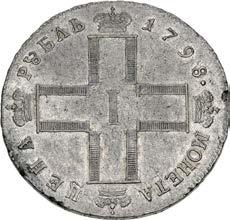

902. RUSSIA, Empire. Pavl I Petrovich. 1796-1801. AR Rouble (38mm, 20.54 g, 6h). St. Petersburg mint. Dated 1798
CM MБ. Crowned cruciform П monogram; I in center / Legend in four lines within table set in ornate frame. Edge: lettered. Bitkin 32; KM (C) 101a. Toned. In NGC encapsulation 6906684-004, graded AU 58. ($750)
From the Alexander Christopher Collection.



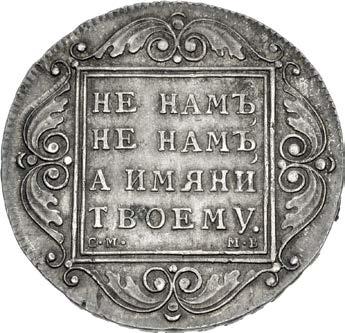
903. RUSSIA, Empire. Pavl I Petrovich. 1796-1801. AR Rouble (38mm, 20.59 g, 6h). St. Petersburg mint. Dated 1799
CM MБ. Crowned cruciform П monogram; I in center / Legend in four lines within table set in ornate frame. Edge: lettered. Bitkin 35; KM (C) 101a. Toned. In NGC encapsulation 6906688-010, graded MS 62. ($2000)
From the Alexander Christopher Collection.


Enlargements of Lot 904

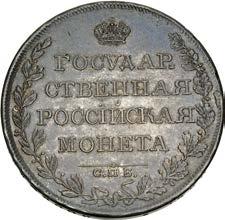
904. RUSSIA, Empire. Aleksandr I Pavlovich. 1801-1825. AR Rouble (36mm, 20.66 g, 12h). St. Petersburg mint. Dated 1808 СПБ MK. Crowned double-headed eagle facing, holding scepter and globus cruciger; crown above, collared coat-of-arms on breast / Crowned legend in four lines within wreath. Bitkin 72; KM (C) 125a. Toned. In NGC encapsulation 6906684-005, graded MS 61. ($2000)
From the Alexander Christopher Collection.
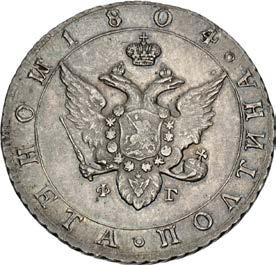
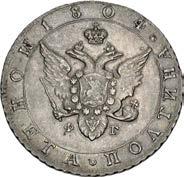

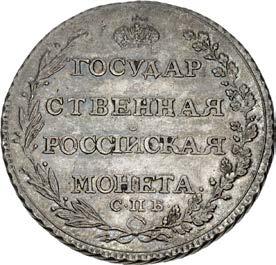
905. RUSSIA, Empire. Aleksandr I Pavlovich. 1801-1825. AR Poltina (29mm, 10.17 g, 12h). St. Petersburg mint. Dated 1804 СПБ ФГ. Crowned double-headed eagle facing, holding scepter and globus cruciger; crown above, collared coat-of-arms on breast / Crowned legend in four lines within wreath. Bitkin 46; KM (C) 123. Toned. In NGC encapsulation 6906612-014, graded AU 55. ($1500)
From the Alexander Christopher Collection.
Toned High Grade Copper Novodel




906. RUSSIA, Empire. Nikolai I Pavlovich. 1825-1855. CU 5 Kopeck Novodel (35mm, 22.47 g, 12h). Ekaterinburg mint. Dated 1834 EM ФХ. Crowned double-headed eagle facing with wings spread, holding torches, thunderbolts, and wreath; coat-of-arms on breast, crown above / Denomination in two lines. Edge: plain. Brekke –; Bitkin H390; KM –. Iridescent toning. In NGC encapsulation 6906684-012, graded MS 65 BN. Rare. Top Pop. ($750)
From the Alexander Christopher Collection.


907. RUSSIA, Empire. Nikolai I Pavlovich. 1825-1855. CU 3 Kopeck (37mm, 32.05 g, 12h). Izhora mint. Dated 1843 СПМ. Crowned NI monogram / Denomination and date in four lines. Brekke 216; Bitkin 813; KM (C) 146.3. In NGC encapsulation 6908067-014, graded MS 63 BN. ($500)
From the Alexander Christopher Collection.

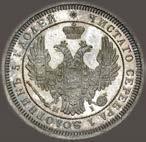

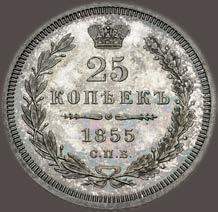

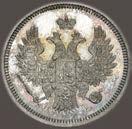


908. RUSSIA, Empire. Aleksandr II Nikolaevich. 1855-1881. Proof AR 25 Kopecks (23mm, 5.15 g, 12h). St. Petersburg mint. Dated 1855 СПБ HI. Crowned double-headed eagle facing, holding scepter and globus cruciger; crown above, collared coat-of-arms on breast, coats-of-arms on wings / Crowned denomination and date within wreath. Cf. Bitkin 53 (business strike); KM (C) 166.1. Iridescent toning. In NGC encapsulation 6906612-007, graded PF 63. ($1500)
From the Alexander Christopher Collection.
909. RUSSIA, Empire. Aleksandr II Nikolaevich. 1855-1881. Proof AR 20 Kopecks (21mm, 4.18 g, 12h). St. Petersburg mint. Dated 1855 СПБ HI. Crowned double-headed eagle facing, holding scepter and globus cruciger; crown above, collared coat-of-arms on breast, coats-of-arms on wings / Crowned denomination and date within wreath. Cf. Bitkin 58 (business strike); KM (C) 165. Iridescent toning. In NGC encapsulation 6906612-008, graded PF 65. Top Pop. ($2000)
From the Alexander Christopher Collection.

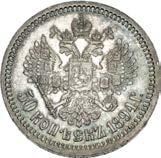
910. RUSSIA, Empire. Aleksandr III Aleksandrovich. 1881-1894. AR 50 Kopeks (27mm, 10.03 g, 12h). St. Petersburg mint. Dated 1894 АГ. Bare head right / Crowned double-headed eagle facing, holding scepter and globus cruciger; crown above, collared coat-of-arms on breast, coats-of-arms on wings. Bitkin 87; KM (Y) 45. Iridescent toning. In NGC encapsulation 6906612-003, graded MS 64. ($750)
From the Alexander Christopher Collection.




911. RUSSIA, Empire. Aleksandr III Aleksandrovich. 1881-1894. Proof AR 25 Kopeks (22mm, 5.00 g, 12h). St. Petersburg mint. Dated 1890 АГ. Bare head right / Crowned double-headed eagle facing, holding scepter and globus cruciger; crown above, collared coat-of-arms on breast, coats-of-arms on wings. Cf. Bitkin 93 (for business strike); KM (Y) 44. Even gray toning. In NGC encapsulation 6906684-014, graded PF 63. ($3000)
From the Alexander Christopher Collection.

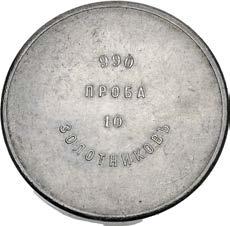
912. RUSSIA, Empire. Aleksandr III Aleksandrovich. 1881-1894. AR 10 Zolotniks Ingot (37mm, 42.58 g, 12h). St. Petersburg mint. Struck circa 1885. Crowned double-headed eagle facing, holding scepter and globus cruciger; crown above, collared coat-of-arms on breast, coats-of-arms on wings; A Д flanking tail / Weight and denomination. Bitkin 258; KM (X) 4. Toned. In NGC encapsulation 6906688-001, graded MS 62. ($1000)
From the Alexander Christopher Collection.
In late 19th century Russia, gold mine owners who supplied gold to the imperial mints would receive recovered silver back in the form of these ingots.
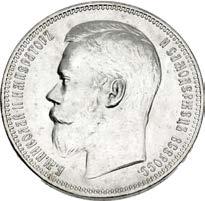

913. RUSSIA, Empire. Nikolai II Aleksandrovich. 1894-1917. AR Rouble (34mm, 19.97 g, 12h). St. Petersburg mint. Dated 1896 АГ. Bare head left / Crowned double-headed eagle facing, holding scepter and globus cruciger; crown above, collared coat-of-arms on breast, coats-of-arms on wings. Bitkin 39; KM 59.3. Lustrous. In NGC encapsulation 6906612-002, graded MS 63. ($1000)
From the Alexander Christopher Collection.
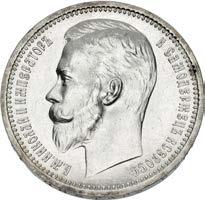
Empire. Nikolai II

1894-1917. AR
(34mm, 19.99 g, 12h). St. Petersburg mint. Dated 1912 ЗБ. Bare head left / Crowned double-headed eagle facing, holding scepter and globus cruciger; crown above, collared coat-of-arms on breast, coats-of-arms on wings. Bitkin 66; KM 59.3. Lustrous. In NGC encapsulation 6906612-005, graded MS 63. ($500)
From the Alexander Christopher Collection.




Petersburg
1913 ЗБ. Bare head left / Crowned double-headed eagle facing, holding scepter and globus cruciger; crown above, collared coat-of-arms on breast, coats-of-arms on wings. Bitkin 67; KM 59.3. Light peripheral toning. In NGC encapsulation 6906866001, graded MS 64. Key date. ($5000)
From the Alexander Christopher Collection.
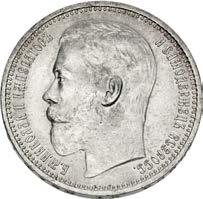
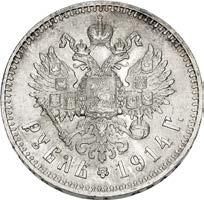
916. RUSSIA, Empire. Nikolai II Aleksandrovich. 1894-1917. AR Rouble (34mm, 19.99 g, 12h). St. Petersburg mint. Dated 1914 BC. Bare head left / Crowned double-headed eagle facing, holding scepter and globus cruciger; crown above, collared coat-of-arms on breast, coats-of-arms on wings. Bitkin 69; KM 59.3. Lustrous. In NGC encapsulation 6909501-006, graded MS 63. ($1500)
From the Alexander Christopher Collection.
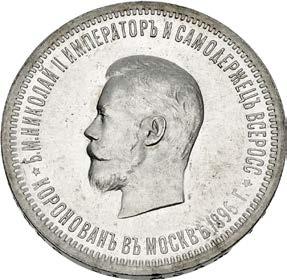



917. RUSSIA, Empire. Nikolai II Aleksandrovich. 1894-1917. AR Rouble (33mm, 12h). Coronation issue. St. Petersburg mint. Dated 1896 AГ. Bare head left / Crowned orb over crossed sword and scepter all within wreath. Bitkin 322; KM (Y) 60. Lustrous. In NGC encapsulation 6906688-014, graded MS 62. ($1000)
From the Alexander Christopher Collection.




918. RUSSIA, Empire. Nikolai II Aleksandrovich. 1894-1917. AR Rouble (34mm, 20.01 g, 12h). Commemorating the centennial of the defeat of Napoléon. St. Petersburg mint. Dated 1912 ЗВ. Crowned double-headed eagle with collared coat-ofarms on breast, holding scepter and globus cruciger, set on crowned orb with six crowned coats-of-arms around / Legend in seven lines. Bitkin 334; KM (Y) 68. Light golden toning. In NGC encapsulation 6906688-012, graded MS 64. ($4000)
From the Alexander Christopher Collection.


919. SOUTH AFRICA, South African Republic. 1881-1902. AV Pond (22mm, 7.98 g, 12h). Pretoria mint. Dated 1898 Bust of Paul Kruger left / Coat-of-arms (with Voortrekker-style wagon) over four crossed banners; above, eagle standing facing, head right, wings spread; ribbon below. KM 10.2; Friedberg 2. Lustrous. In NGC encapsulation 690872-003, graded MS 64. ($750)
From the Alexander Christopher Collection.



920. SOUTH AFRICA, Orange Free State. 1854-1902. Pattern Æ Penny (29mm, 9.63 g, 6h). Otto Nolt & Company, Berlin. Dies by L.C. Lauer. Dated 1874. ORANJE FRIJ STAAT, tree; three horns around; facing head and anchor in legend / EEN/ PENNY/ 1874 within wreath; MUNTSPROEVE below. KM (X) Pn1. In NGC encapsulation 6909490-010, graded MS 64 BN. ($500)
From the Alexander Christopher Collection. Ex Wayte Raymond Collection (Part IV, NASCA, 8 December 1978), lot 4631.
This interesting piece is part of a now mostly forgotten series of fantasy patterns produced by Lauer and others in the late 19th century. While some contemporaries, such as the English dealer Daniel F. Howarth welcomed these pieces, others felt they were deceitful. American numismatist Lyman Low was particularly outraged, calling the patterns fraudulent. He wrote in The Numismatist, “It is noticeable that they purport to belong principally to obscure and unimportant countries where detection would be comparatively difficult. Any attempt to issue such pieces elsewhere would contravene the coinage laws and involve penalties... The entire list given by Mr. Howorth may, in my opinion, be pronounced a sham, and I heartily agree with him in classifying them as ‘apocryphal,’ and echo his words of warning against them. The few we have published will be withdrawn from our lists and catalogs.”
Despite the outrage at the time, collectors today – including this cataloger – heartily welcome these pieces into their collections. In many cases, these so-called ‘apocryphal’ coins are the only examples from these countries available.
For further information, see Courtney L. Coffing, “Apocryphal coins shed bad names,” in Coin World, 12 January 1977, p. 64-67.
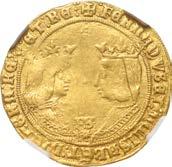

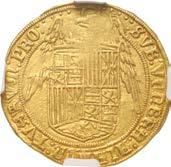
921. SPAIN, Castile & León. Fernando V & Isabel I (Los Reyes Católicos - the Catholic royals). 1474-1504. AV Dobla excelente (27mm, 2h). Sevilla mint. Struck after 1497. Crowned confronted busts of Fernando and Isabel; cross with four pellets, S with four pellets between, and eight-pointed star / Crowned coat-of-arms; behind, eagle facing, head left, with wings spread and wearing nimbus crown. Cf. MEC 6, 772; ME 2933; Calicó y Trigo 72; Friedberg 129. In NGC encapsulation 570300-002, graded AU 55. ($1000)
Ex Stack’s Bowers Galleries (22 February 2021), lot 74470.




922. SPAIN, Kingdom. Felipe II el Prudente. 1556-1598. AV 2 Escudos (25mm, 6.72 g, 7h). Sevilla mint. Undated issue. Crowned coat of arms; to left, S over quadrate D; II (mark of value) to right / Jerusalem cross within quatrelobe; annulets in spandrels and lis in cusps. ME 4098; Calicó y Trigo 60; Friedberg 169. In NGC encapsulation 6507877-012, graded AU 58. ($1500)



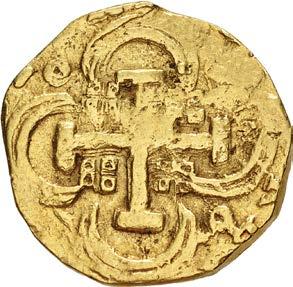
923. SPAIN, Kingdom. Felipe IV el Grande. 1621-1665. AV 8 Escudos (32mm, 26.84 g). Cob type. Sevilla mint. Struck 1630s-1640s. Crowned coat-of-arms / Jerusalem cross within quatrelobe; rosettes in spandrels and lis in cusps. Cf. Calicó y Trigo 54-68; Cf. ME 6786; KM 59.2; Friedberg 200. Date off flan, usual poor strike. VF. ($4000)
From the Gerald F. Borrmann (Northern California Gentleman) Collection



924. SPAIN, Kingdom. José I Bonaparte. 1808-1813. AR 5 Pesetas (39mm, 27.06 g). Barcelona mint. Dated 1811 Denomination in two lines over crossed palm fronds; all within wreath of 24 rosettes / Coat-of-arms within wreath. ME 14708; Calicó y Trigo 17; KM 69. In NGC encapsulation 6898712-009, graded MS 64. ($750)
From the Alexander Christopher Collection.




925. SPAIN, Kingdom. Isabel II. 1833-1868. Proof AR 20 Reales (37mm, 26.14 g, 12h). First Decimal issue. Madrid mint. Dated 1850 M CL. Bare head right / Crowned and collared coat-of-arms within wreath. O’Connor p. 118; cf. ME 17185; cf. Calicó y Trigo 170; cf. KM 592.1 (for business strike). Toned. In PCGS encapsulation 49713779, graded PR 62. Extremely rare in proof. ($7500)
From the Alexander Christopher Collection.
O’Connor gives a rarity of R7 (fewer than 10 known) for high grade UNC examples. He notes proofs only for the variety without a dot below 2A in the obverse, and values that at $12,000. This example, which does exhibit a pellet, is undoubtedly even rarer and more desirable.
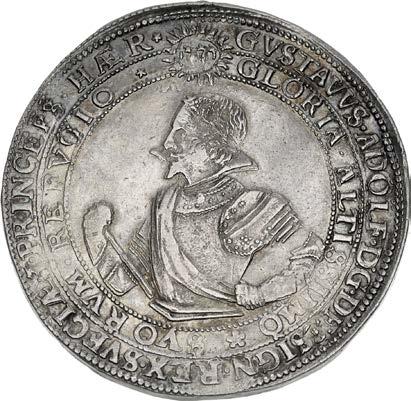


926. SWEDEN. Gustav II Adolf den store (the Great). 1611–1632. AR Riksdaler (45mm, 29.10 g, 2h). Stockholm mint. Dated 1615. Laureate and armored half-length bust left, resting hand on hilt of sword; above, radiant Tetragrammaton. Legend ends in HAER / Radiant Christ standing facing, holding globus cruciger and raising hand in benediction; to left, crown over three coats-of-arms. Delzanno 14; AAH 23b; Davenport 4515; KM 69. Toned. In NGC encapsulation 2156706-001, graded AU 53. Top Pop ($1000)
From the Alexander Christopher Collection.



927. SWEDEN. Kristina. 1632–1654. AR Riksdaler (42mm, 28.27 g, 5h). Stockholm mint. Dated 1643 AG (in Roman numerals). Crowned bust facing slightly left / Christ standing facing, raising hand in benediction and holding globus cruciger. Delzanno 25; Davenport 4525; KM 187. Toned, a few light scratches, hairlines, edge marks. VF. ($1000)
Ex Classical Numismatic Group Electronic Auction 492 (26 May 2021), lot 638.



928. SWITZERLAND, Canton of Bern. Bern. AR Doppeltaler (50mm, 57.19 g, 12h). Struck early 18th century. View of the city across the Rhine; seven ships in river / Dragon standing left, head right, with wings spread, resting claw on coat-ofarms; coats-of-arms around. HMZ 2-98a; Davenport 1742a; KM 130. Toned, hairlines. AU. ($750)
From the Alexander Christopher Collection.


929. SWITZERLAND, Canton of Luzern. Beromünster. AR Halbtaler – Michaelspfennig (35mm, 13.72 g, 12h). Commemorating the Millenium of the Founding of the Beromünster Abbey. Dated 720, struck 1720. Coat-of-arms surmounted by plumed helm and set on palm frond and olive branch / St. Michael holding shield and flaming sword, slaying demon at feet. HMZ –; KM 5. Deep iridescent toning. In NGC encapsulation 6898712-004, graded MS 62. ($500)
From the Alexander Christopher Collection.




930. SWITZERLAND, Republic and Canton of Genève. Genève. AR 5 Francs (35mm, 26.02 g, 6h). Dated 1848 Coat-of-arms / Denomination within wreath. HMZ 2-364a; Davenport 375; KM 137. Lustrous. In NGC encapsulation 6909515-005, graded MS 63 PL. Mintage of only 1176. ($750)
From the Alexander Christopher Collection.



931. SWITZERLAND, Helvetic Republic. 1798-1803. AR 10 Batzen (28mm, 7.71 g, 6h). Bern mint. Dated 1799 B Armored soldier standing left, holding flag and resting hand on hilt of sword / Denomination within wreath. HMZ 2-1187b; KM A1. Rich iridescent toning. In NGC encapsulation 6909515-007, graded MS 66. A stunning high grade example. Top Pop. ($750)
From the Alexander Christopher Collection.


932. SWITZERLAND, Swiss Confederation. 1848-present. AR 5 Francs (35mm, 24.98 g, 12h). Federal Shooting Festival in Zürich. Dated 1859. Rifleman standing left, head right, resting rifle on ground / Three coats-of-arms with leonine supporters. Richter 1723a; HMZ 2-1843c; Davenport 379; KM (X) S5. Deep purple toning. In NGC encapsulation 6909515006, graded MS 65. ($500)
From the Alexander Christopher Collection.
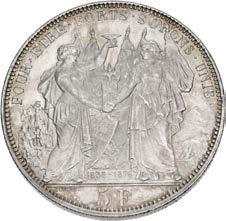


933. SWITZERLAND, Swiss Confederation. 1848-present. AR 5 Francs (36mm, 24.97 g, 6h). Federal Shooting Festival in Lausanne. Dated 1876. City view / Two female figures clasping hands, one raising cup, the other holding banner; between them, fasces and four flags; grape vines to left, mountains to right. Richter 1560a; HMZ 2-1843k; Davenport 387; KM (X) S13. Light golden toning. In NGC encapsulation 6887558-001, graded MS 65. ($500)


934. TRANSYLVANIA, Principality. Gábor Bethlen. 1613-1629. AR Taler (45mm, 28.70 g, 9h). Körmöcbánya (Kremnitz / Kremnica) mint. Dated 1621 KB. Armored half-length bust right, holding scepter over shoulder; coat-of-arms and Madonna with child in legend / Crowned coat-of-arms. Resch 109; MBR 1326; Davenpor 4710; KM 134. Lightly toned, hairlines, slight double strike, minor edge marks. EF. ($1000)
From the Alexander Christopher Collection.

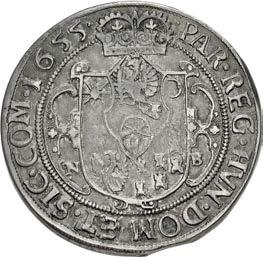
935. TRANSYLVANIA, Principality. György Rákóczi II. 1648-1660. AR Taler (44mm, 28.63 g, 12h). Nagybánya (Frauenbach / Baia Mare) mint. Dated 1655 NB. Half-length armored bust right, holding scepter over shoulder and resting hand on hilt of sword, wearing short brimmed fur cap with feather / Crowned coat-of-arms. Resch 93; MBR 2147; Davenport 4751; KM 286. Toned, minor marks. Good VF. ($750)
From the Alexander Christopher Collection.



936. TRANSYLVANIA, Principality. Mihály Apafi I. 1662-1690. AR 2 Taleri Klippe (46x45mm, 58.34 g, 6h). Gyulafehérvár (Karslburg / Alba Iulia) mint. Dated 1678 AI, though a later restrike. Half-length armored bust right, holding scepter over shoulder and resting hand on hilt of sword, wearing short brimmed fur cap with feather / Crowned coat-of-arms. Cf. Resch 230; cf. MBR 2599; cf. Davenport 4818; cf. KM 465B (all for regular taler). Toned, lightly chased, scratches. Near EF. ($2000)
From the Alexander Christopher Collection.
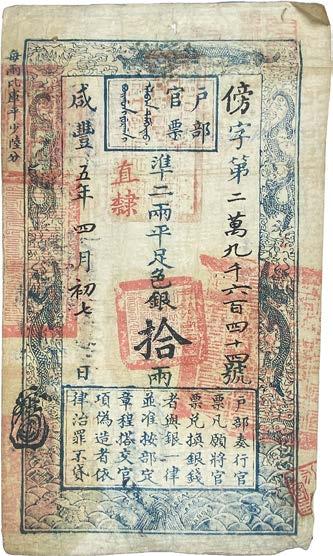

937. CHINA, Qīng dynasty. 10 Taels. Board of Revenue. Dated Xiánfēng year 5 (AD 1855). Pick A12c. In PMG encapsulation 2299325-001, graded Very Fine 25. An attractive example with well-defined stamps. Stamped over the seal of Guangzong County on the reverse left. ($3000)
From the Norman Frank Collection.


938. CHINA, Qīng dynasty. 500 Cash. Dated Xiánfēng year 5 (AD 1855). (125x229mm). Pick A1c. In PMG encapsulation 2518301-004, graded Very Fine 25, spindle hole at issue. ($500)
From the Norman Frank Collection.
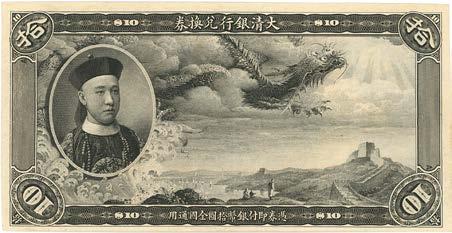

939. CHINA, Qīng dynasty. Ta Ching Government Bank. 10 Dollars. 1910 issue. BEPA Remainder. (181x91mm). A wonderful design featuring a picture of the regent Zaifeng and a dragon flying over the Great Wall. Pick A81r. In PMG encapsulation 2518301-001, graded Choice Very Fine 35. Rare recto-verso registration. ($750)
From the Norman Frank Collection.

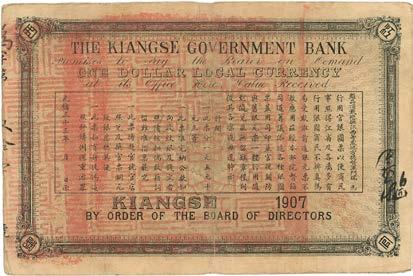
From the Norman Frank Collection.
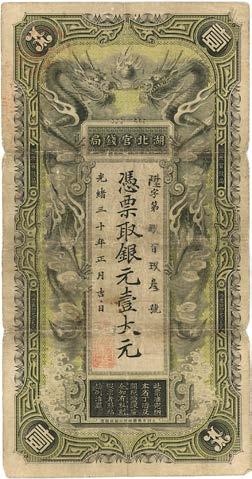
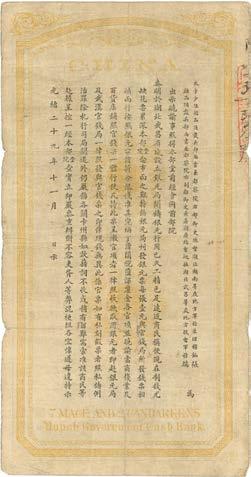



942. ARMENIA. Circa 18th century. Gilt Æ Medal (35mm, 7.97 g, 12h). Dated 1558. St. Gregory the Illuminator enthroned facing, holding in his left hand the pontifical crosier and raising right hand in blessing; A and H (in Armenian) at shoulders, A.1558.K. below / South-west view of the Cathedral of Holy Etchmiadzin; A.301.P. (in Armenian; “Savior of All”) below. H.V. Sarkissian, “A Group of Armenian Religious Medals of the Eighteenth Through Twentieth Century,” Armenian Numismatic Journal XV.1 (1989), 1. See Triton V, lot 2320 for another. Chipped with original loop missing, scratches. VF. ($2000) St. Gregory the Illuminator (regnal period 302-305 AD) was the first catholicos, or pontiff, of the Armenian Church. King Tiridates, whom he baptized, aided St. Gregory to construct the Cathedral of Holy Etchmiadzin (Etchmiadzin in Armenian means “the place where the Only Begotten Son descended”) which is commemorated by the reverse of this medal. The cathedral remains today the Holy See of the Armenian Church where the Catholicos of all Armenians still occupies his throne (see Y.T. Nercessian, “Armenia and the Los Angeles Medals; 2. Etchmiadzin,” in Armenian Numismatic Studies, pp. 579-580).




943. CAMBODIA, Kingdom. Norodom Suramarit. 1955-1960. AV Medal (27mm, 13.57 g, 12h). On his death. Paris mint. By A. David. Dated 1960. Bust right; legend in Khmer around / FUNERAILLES DE S.M. NORODOM SURAMARIT ROI DU CAMBODGE · 1960 ·, funeral stupa in the Royal Palace complex in Phnom Penh. Edge: cornucopia and 1 OR. Lustrous, a few hairlines, minor edge marks. AU. Very rare. Only 500 produced in silver and with no gold examples traced in the last 20 years. ($750)
From the Alexander Christopher Collection.


944. MEXICO, Colonial. Carlos IV. King of Spain, 1788-1808. AR Medal (41mm, 12h). Proclamation by the Consulado in Mexico City. By G. Gil. Dated 1789. CARLOS * IV POR LA * GRACIA * DE * DIOS * REY * DE ESPAÑA * Y * EMPERADOR * DE * LAS * * INDIAS *, armored and draped bust right / * A * SU * PROCLAMCION * EL * CONSULADO * DE* MEXICO, crowned coat-of-arms; to left, Mercury standing right, holding caduceus; ship in background to right, various trade goods around; in exergue, * AÑO * DE * 1789 *. Grove C-26a; Medina 165; Herrera 168. Toned. In NGC encapsulation 4660818-011, graded MS 61. ($500)
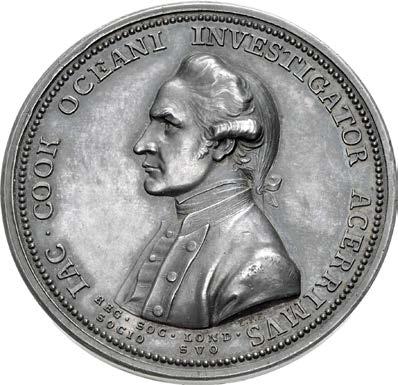


945. Captain James Cook, explorer, navigator, and cartographer. 1728-1779. AR Medal (44mm, 39.52 g, 12h). Memorial to Captain Cook. By L. Pingo. Struck 1784. IAC · COOK OCEANI INVESTIGATOR ACERRIMVS (the most intrepid detective of the seas), bust left; in two lines below, REG · SOC · LOND ·/SOCIO SVO / NIL INTENTATVM NOSTRI LIQVERE (our men have left nothing unattempted), Fortune standing left, leaning upon column to right, cradling spear in left arm, and resting right hand upon rudder set on globe to left; in three lines in exergue, AVSPICIIS/GEORGII/III. Eimer, Pingo 64; Betts 553; BHM 258; Eimer 780. Toned. In PCGS encapsulation 49695744, graded MS 62. ($1500)
From the Gerald F. Borrmann (Northern California Gentleman) Collection.
In 1776, British Captain James Cook was dispatched to the south Pacific. Sailing with two ships, the Resolution and the Discovery, Cook first called at Tahiti to return a native who had traveled to Europe with a previous expedition. The ships then sailed northeast, diagonally across the Pacific towards North America, in hopes of finding the fabled Northwest Passage. This course led them to be the first Europeans to land on the Hawaiian Islands, dubbed by them the Sandwich Islands.
After spending the warmer months exploring the northwest coast of North America, Cook returned to Hawaii for the winter. The British were initially met with a warm reception as they circled the archipelago in search of an appropriate anchorage, as their arrival coincided with the important Makahiki harvest festival. The British ships settled and remained at Kealakeukua Bay for a month before again setting sail, only for the foremast of the Resolution to break, forcing an unexpected return to Hawaii. This time, Cook faced a colder, more hostile populace. While his crew repaired the mast, a group of native Hawaiians stole a small landing boat. While this was not an uncommon problem for British ships in Polynesia, Cook responded by taking hostages to hold as collateral until the return of the vessel. The British tried to lure King Kalaniʻōpuʻu back to the ships, but the Hawaiians realized it was a trap and turned on the British party, pursuing them to the beach. As the captain attempted to launch the landing boats, he was struck on the head and fell facing down in the surf, where he was then stabbed to death.


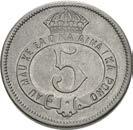

946. Kingdom of Hawaii. Kalākaua. 1874-1891. Fantasy Pattern NI 5 Cents (21mm, 4.75 g, 6h). Dated 1881. KALAKAUA KING OF SANDWICH ISLANDS * 1881 *, bare head left / 5 within crowned garter inscribed AU MAU KE EA O KA AINA I KA PONO. Cf. Medcalf & Russell 2CN-1 (for official issue) and p. 39 (for fantasy strike). Toned. In PCGS encapsulation 49695755, graded PR 62. Rare. ($1000)
From the Gerald F. Borrmann (Northern California Gentleman) Collection.
The reign of King Kalākaua was a time of both great prosperity and great risk for Hawaii. In 1875, Hawaii signed the Treaty of Reciprocity, granting the kingdom free access to the lucrative American sugar market, while providing a guarantee that no Hawaiian land would be leased to any other foreign power. The treaty opened a flood of American investment in thr sugar industry, exponentially increasing the amount and value of exports, but also allowing more power and influence to fall into the hands of American business interests. In 1887, a brief rebellion broke out in Honolulu backed by the Hawaiian League, an organization that aimed to overthrow the monarchy and annex the islands to the United States. The king was forced to sign the Bayonet Constitution, abdicating much of his power to the legislature, by now dominated by pro-American businessmen. The constitution also stripped native Hawaiians and Asians of their voting rights, ensuring the domination of the leading faction.
In 1881, Kalākaua embarked on a world tour to promote his kingdom’s foreign interests. While on the voyage, he was approached by the owner of a nickel mine, who offered to have nickel coins struck for the kingdom. Designs were made and approximately 200 patterns were struck in Paris for distribution in Hawaii. Nothing came of these patterns and no circulating nickel coins were ever issued for the kingdom. This example is from an unofficial fantasy issue that can be distinguished by the thicker flan and absence of a cross at the pinnacle of the crown.


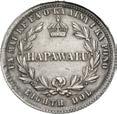
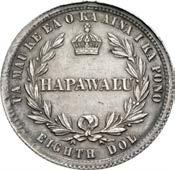
947. Kingdom of Hawaii. Kalākaua. 1874-1891. Fantasy Pattern AR Hapawalu – Eighth Dollar – 12½ Cents (18mm, 2.58 g, 6h). After dies by Charles Barber. Dated 1883. KALAKAUA I KING OF HAWAII • 1883 •, bare head right / UA MAU KE EA O KA AINA I KA PONO EIGHTH DOL, crown over HAPAWALU within wreath. Edge: reeded. Cf. Medcalf & Russell 2CS-2 (for official pattern) and pl. 42 (for fantasy strike). Toned. In PCGS encapsulation 49695754, graded AU 55. Rare. ($2000)
From the Gerald F. Borrmann (Northern California Gentleman) Collection.
At the start of Kalākaua’s reign, the circulating medium in Hawaii consisted of American silver, legal tender to $50, and gold. Copper coins had been issued under Kamehameha III, but saw only limited circulation and had long since disappeared from the marketplace. In 1883, the Kingdom authorized their agent, the businessman Claus Spreckels, to make arrangements for the production of a series of coins in the United States.
Agreements were reached through contacts in the San Francisco mint and soon a series of patterns were created by chief engraver Charles Barber, in Philadelphia. Hawaiian law had earlier authorized coins denominated one dollar, fifty cents, twenty-five cents, and 12½ cents (ie, half a quarter, one bit). However, it also specified that they were to be the same size, weight, and fineness as the coinage of the United States, which had never issued a 12½ Cents. Mint director Preston highlighted this discrepancy, but no response came from Hawaii, and so Barber went ahead and created a 12½ Cents pattern. Ultimately, the smallest denomination would be changed to a 10 cents coin, to match the American dimes. Today, the pattern Hapawalu – 12½ Cents is the rarest of the official coinage of Hawaii and key to the series. The present example is from an unofficial fantasy issue, distinguished by the “lazy eights” in the date, that nevertheless remains popular with collectors.




948. Kingdom of Hawaii. Kalākaua. 1874-1891. AR Medal (16.5mm, 2.22 g, 12h). The King’s Jubilee. By an uncertain medallist. Dated 16 November 1836 and 1886. 1836 1886 NOV · 16 ·, bare head right / I KA PIHA ANA/ O NA MAKAHIKI HE/ KANALIMA O KA/ MOI KALAKAUA · in four lines. Medcalf & Russell 2RM-13. Toned. In PCGS encapsulation 49695745, graded AU Details, mount removed. Rare. ($1000)
From the Gerald F. Borrmann (Northern California Gentleman) Collection.




949. Kingdom of Hawaii. Liliʻuokalani. 1891-1893. Proof Pattern AR Akahi Dala – Dollar (38mm, 25.05 g, 12h). By John H. Pinches, for Reginald Huth. Dated 1891 (18 93 in stars). LILIVOCALANIA · DEI · GRATIA, crowned bust left / HAWAIARVM REGINA 1891 ★ AKAHI DALA ★, globe with view of the Hawaiian Islands. Medcalf & Russell 2MH-1; KM (X) M1. Light iridescent toning over mirror-like surfaces. In PCGS encapsulation 49695747, graded PR 63 Deep Cameo. Extremely rare – only 50 struck. ($20,000)
From the Gerald F. Borrmann (Northern California Gentleman) Collection.
Liliʻuokalani took the throne following the death of her brother, Kalākaua. The new queen attempted to win back the power abrogated by her brother in 1887 by promulgating a new constitution. Members of her cabinet opposed the constitution, recognizing that it would inevitably lead to unrest and possibly violence with the anti-monarchists. They were soon proven correct.
Events unfolded rapidly in January 1893. The anti-monarchists formed the Committee of Safety with the goal of ousting the queen and annexing the islands to the United States. On 16 January, the government learned of their plot and placed the kingdom under martial law. However, American diplomat John Stevens, a strong supporter of the Committee’s annexation plan, ordered American marines from the USS Boston to take up strategic positions around the U. S. Consulate and Legation, providing a check to the royalist forces.
The following day, a wagon carrying weapons to the Committee was stopped by native Hawaiian policeman Lealoha. Committee supporters opened fire, killing the policeman. Fearing a government reprisal, the anti-monarchists acted fast, mustering a group of non-native men, approaching the palace, and issuing an ultimatum to Liliʻuokalani: abdicate or face their guns. The queen had no army, no support from the local police, and no equivalent royalist militia. In her own words, “since the troops of the United States had been landed to support the revolutionists, by the order of the American minister, it would be impossible for us to make any resistance.” To prevent further bloodshed, Liliʻuokalani, the first queen and the last monarch of Hawaii, abdicated her throne.
The rebels quickly set up an interim government while awaiting the realization of their ultimate goal of American annexation. But President Cleveland opposed this action, stating before Congress that “the military demonstration upon the soil of Honolulu was of itself an act of war.” The interim government reorganized itself into the Republic of Hawaii and awaited a change in American sentiment, which came with the election of William McKinley in 1897. On 12 August 1898, Hawaii was formally annexed to the United States.
This silver pattern is from a fascinating series of fantasies commissioned by the British collector Reginald Huth, primarily featuring crownsized coins for various reigning queens. Fantasy patterns for Ranavalona III of Madagasar, Lili’uokalani and Ka’iulani of Hawaii, Isabel II of Spain, and Queen Victoria were struck by the Pinches of London. In several cases, these are the only “coins” bearing that monarch’s portrait, and all are highly sought after by modern collectors.




950. Kingdom of Hawaii. Kaʻiulani. Princess and heir apparent, 1891-1893/1899. Proof AR Medal (38mm, 24.29 g, 12h). On her 18th birthday. By John H. Pinches, for Reginald Huth. Dated 16 October 1893 (18 95 in pellets). CAIVLANIA LILIVOCALANIAE REGINAE SORORIS FILIA, diademed head right; dolphin below / SPES PVBLICA • OCT. XVI. MDCCCXCIII •, globe with view of the Hawaiian Islands; HONOLOLU marked; 18 95 in pellets. Medcalf & Russell 2MH-3; KM (X) M3. Light golden toning over mirror-like surfaces. In PCGS encapsulation 49695749, graded PR 63 Cameo. Extremely rare – only 20 struck. ($20,000)
From the Gerald F. Borrmann (Northern California Gentleman) Collection.
Kaʻiulani, born in 1875, was the heir apparent to the Hawaiian throne until the overthrow of the monarchy in 1893. Educated in Britain, the young princess was still abroad completing her studies when Liliʻuokalani abdicated. She went on a tour across the United States, speaking in support of her native land, but failing to drum up sufficient opposition to prevent annexation. When the transfer ceremony was held, she wrote to the former queen: “I am sure you would be disgusted if you could see the way the town is decorated for the American troops. Honolulu is making a fool of itself and I only hope we won’t be ridiculed.”
Kaʻiulani died of a sudden illness on 6 March 1899. Her funeral was well attended by both native Hawaiians and other residents of Honolulu.
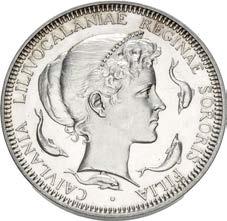

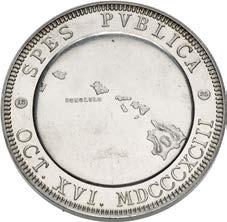

951. Kingdom of Hawaii. Kaʻiulani. Princess and heir apparent, 1891-1893/1899. Proof AR Medal (38mm, 24.89 g, 12h). On her 18th birthday. By John H. Pinches, for Reginald Huth. Dated 16 October 1893 (18 95 in pellets). CAIVLANIA LILIVOCALANIAE REGINAE SORORIS FILIA, diademed head right; four dolphins around / SPES PVBLICA • OCT. XVI. MDCCCXCIII •, globe with view of the Hawaiian Islands; HONOLOLU marked; 18 95 in pellets. Medcalf & Russell 2MH-5; KM (X) M4. Light golden toning over mirror-like surfaces. In PCGS encapsulation 49695748, graded PR 62. Extremely rare – only 30 struck. ($20,000)
From the Gerald F. Borrmann (Northern California Gentleman) Collection.
The obverse of this and the previous medal are derived from the famous Syracusan dekadrachms of the 4th century BC (see lots 41-44, above), depicting the sea nymph Arethousa. The choice of this model is particularly appropriate for Kaʻiulani, who was an avid swimmer and surfer. She claimed, “I’m sure I was a seal in another world because I am so fond of the water.”


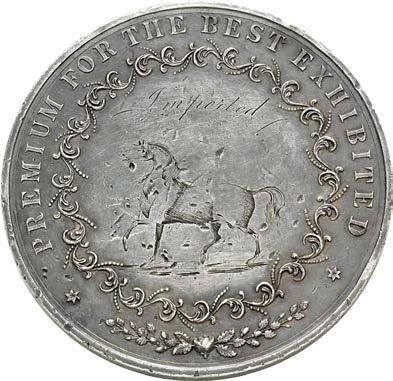
952. Kingdom of Hawaii. Royal Agricultural Society – Prize Medal. Circa 1850s. AR Medal (63mm, 87.87 g, 12h). Philadelphia mint. By Francis N. Mitchell. Dated 1850, though struck 1854-1857. * ROYAL HAWAIIAN
SOCIETY * ESTABLISHED A.D. 1850, plow and agricultural implements beside two bags labeled COFFEE; to left, two bushels of wheat below palm tree, other fruits on ground; to right, two barrels, one labeled SUGAR, both before ships masts; in background at center, ship under sail right before rising sun; crown above, all within oak reath / PREMIUM FOR THE BEST EXHIBITED , engraved at center Imported over horse prancing left; all within ornamental border, rose and oak spray below. Medcalf & Russell 2RM-6; Julian AM-24a. Toned, a few scattered surface and edge marks. VF. Extremely rare example in silver, particularly notable as it was actually presented to a recipient in Hawaii. ($3000)
From the Gerald F. Borrmann (Northern California Gentleman) Collection. Ex Heritage 1208 (7 August 2014), lot 5022; Heritage 1151 (7 January 2011), lot 6467 (realized $6,325).
The Royal Hawaiian Agricultural Society was a short-lived organization active in the 1850s to promote trade and agriculture in Hawaii. The obverse of this medal depicts the main agricultural products key to the Hawaiian economy: notably sugar and coffee. The medal was designed by Francis N. Mitchell, a Boston based engraver, and struck at the United States Mint in Philadelphia.




953. Kingdom of Hawaii. The Royal Order of Kamehameha I – Knight’s Companion Cross. Made by Madame Kretly, Paris, France. Diameter of device: 36mm. White enamel Maltese cross with monogram in gold filigree, KAMEHAMEHA I around. On reverse, E HOOKANAKA around plain field. All below crown suspended from red-white striped ribbon with modern(?) pin clasp. Medcalf & Russell 2R0-3. A few cracks in enamel. With intact ribbon. Very rare. ($15,000)
From the Gerald F. Borrmann (Northern California Gentleman) Collection.
The Royal Order of Kamehameha I was founded in 1865 under Kamehameha V and active until 1886. Membership was granted to those who performed distiguished service to the Kingdom. Forty-three were awarded in total, with Hawaiian subjects paying a $75 admittance fee.

954. Plantation & Related Tokens. Lahainaluna Seminary, Maui. Framed Set of six (6) notes. Issued 1843-1844. Includes: 3 Keneta. Beehive and bees. Medcalf & Russell 2PE-10 // Hapaumi – 1/16 Dala. Scales. Medcalf & Russell 2PE-11 // Hapawalu – 1/8 Dala. Telescope and tripod. Medcalf & Russell 2PE-12// Hapaha – 1/4 Dala. Two globes. Medcalf & Russell 2PE-13 // Hapalua – 1/2 Dala. View of the coast and town of Lahaina. Medcalf & Russell 2PE-14 // Hookahi Dala. Map of the Hawaiian Islands with Hawaiian flag. Medcalf & Russell 2PE-15. Some surface tearing, cancellation holes. Very Fine. Six (6) notes in lot. All in modern frame. Extremely rare. ($10,000) From the Gerald F. Borrmann (Northern California Gentleman) Collection. These rare pieces of scrip were issued to address a shortage of coins. They were printed at the Seminary itself, then cut and pasted on cardboard to strengthen them for circulation. The designs represent the subjects taught at the seminary: industry, law, science, geography, and education.



955. Plantation & Related Tokens. John T. Waterhouse, importer. WM Advertising Token (34mm, 13.09 g, 12h). Struck circa 1855-1860. HIS MAJESTY KAMEHAMEHA IV, facing bust of King Kamehameha IV / JOHN THOMAS WATERHOUSE • HALE MAIKAI •, beehive with bees above, plants to either side; IMPORTER above. Medcalf & Russell 2TE-1. In PCGS encapsulation 49695746, graded VF Details, environmental damage. ($1500)
From the Gerald F. Borrmann (Northern California Gentleman) Collection. John Waterhouse operated two stores in Honolulu. The Hawaiian portion of the reverse legend, HALE MAIKAI, directly translates to “house excellent,” or “a good place to do business.” Medcalf & Russell note that this token is “virtually impossible to find above EF condition.”


956. Plantation & Related Tokens. Wailuku Plantation. CU 12½ Cent – Real Token (23mm, 5.20 g, 2h). Dated 1871. WP/ 12½/ 1871; four stars around / HI over narrow starfish; ten stars around. Medcalf & Russell 2TE-2. In PCGS encapsulation 49695750, graded F 15 BN. ($500)
From the Gerald F. Borrmann (Northern California Gentleman) Collection.
These early Wailuku tokens were struck on site at the blacksmith shop. A journal entry form the shop dated November 1872 records seven days of work to make the dies and punch the tokens. On this occasion, 1060 reals and 1013 hapas were struck, but it is not clear if there were more struck at other times.

Plantation & Related


1

(22mm, 7h). Dated 1880. W.P./ 1880; nine stars above / 1 R,l monogram. Medcalf & Russell 2TE-6. In PCGS encapsulation 30890137, graded AU 55. ($5000)
From the Gerald F. Borrmann (Northern California Gentleman) Collection. Ex Heritage 1216 (9 January 2015), lot 6639 (sold for $12,925).
The Wailuku sugar plantation was established in 1862, sending its first shipment to market in 1864. The plantation operated well into the 20th century.




958. Plantation & Related Tokens. The Kahului & Wailuku Railroad. CU 12½ Cent Token (21mm, 2.00 g, 8h).
Dated 1879. • T • H • H •/ ★ –•– ★/ • 12 •; ornamental sprays above and below / ★ R
R
/
1879 • ★; ornaments above and below. Medcalf & Russell 2TE-8. In PCGS encapsulation 49695752, graded VF Details, environmental damage. ($500)
From the Gerald F. Borrmann (Northern California Gentleman) Collection.
The Kahului & Wailuku Railroad was founded in 1879 by Captain Thomas H. Hobron to expand his shipping empire. The first narrow gauge tracks were laid on June 30th, with the entirety of the line being completed on September 10th. The first engine arrived from, likely shipped from Britain, on June 26th and was fully operational by July 17th. The tokens, paid to railroad laborers, were redeemable at Hobron’s store in Kahului and circulated broadly in the islands.


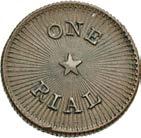

959. Plantation & Related Tokens. Haiku Sugar Plantation. CU 1 Rial Token (22mm, 8.53 g, 6h). Dated 1882. HAIKU/ 1882 within wreath of sugar cane and taro / ONE/ RIAL around central radiant star. Medcalf & Russell 2TE-15. In PCGS encapsulation 49695753, graded AU 55 BN. ($1000)
From the Gerald F. Borrmann (Northern California Gentleman) Collection.
The Haiku Sugar Plantation was located in north central Maui. The first sugar operation on the site was started in 1858 and was reformed as the Haiku Sugar Plantation by two men from Wailuku Sugar Company in 1879. Medcalt & Russell note that these are, “undoubtedly the most artistic and well struck of the early metal tokens.” They were possibly made in San Francisco.
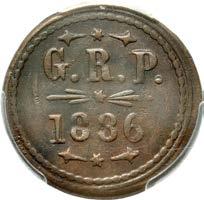



960. Plantation & Related Tokens. Grove Ranch Plantation. CU 12½ Cent – One Bit Token (20mm, 11h). Dated 1886. G.R.P./ 1836 / 12½. Medcalf & Russell TE-16. In PCGS encapsulation 82920888, graded XF 45. Very rare. ($2000)
From the Gerald F. Borrmann (Northern California Gentleman) Collection. Ex Heritage 1253 (4 April 2017), lot 16121.
Grove Ranch Plantation, a sugar plantation located in Haliimaile on Maui, was founded in 1850 as Haliimaile Plantation. It operated as Grove Ranch Plantation from 1880 to 1889, when it merged with Paia Plantation.

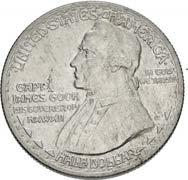


961. Hawaii Sesquicentennial Commemorative Half Dollar. Philadelphia mint. By Juliette Mae Fraser and Chester Beach. Dated 1778 and 1928. Uniformed bust of Captain James Cook left; below, eight “volcanoes” representing the eight largest islands of Hawaii / Native Hawaiian chief in full regalia standing left, gesturing left towards village of huts on Waikiki Beach. Toned. In PCGS encapsulation 49695756, graded UNC Details, cleaned. ($500)
From the Gerald F. Borrmann (Northern California Gentleman) Collection.
The reverse design was adapted from the statue of King Kamehameha I in Honolulu, originally commissioned in honor of the centennial of Cook’s arrival in 1878. The coins were sold by the Bank of Hawaii on behalf of the Captain Cook Sesquicentennial Committee, with half allocated for sale in Hawaii, the rest in the mainland United States. The commemorative proved an instant success and sold quickly, remaining one of the most popular and valuable of the classic U.S. commemorative series to this day.




962. “Statehood Dala” Commemorating the 25th Anniversary of Hawaiian Statehood. Two (2) medals in gold and bronze. Dated 1959 and 1984. LILUOKALANI · HAWAII ·, crowned bust of Liliʻuokalani left / UA · MAU · KE · EA · O · KA · AINA · I · KA · PONO STATEHOOD DALA, seal of the State of Hawaii; 1959 1984 above. AV 1 Oz Medal. Reeded edge, no. 244. Medcalf & Russell 2M-396. In NGC encapsulation 3160209-012, graded PF 68 Ultra Cameo // Æ Medal. Reeded edge, no number. In NGC encapsulation 3160209-014, graded MS 66 RD Ultra Cameo. Both NGC graded. ($1500)
From the Gerald F. Borrmann (Northern California Gentleman) Collection. Ex Heritage 231649 (8 December 2016), lot 62262.
End of Session 3
Session 4 – Wednesday, September 18, 2024 — 2 PM

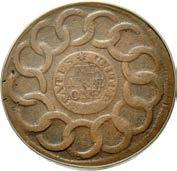
963. Federal contract coinage. 1787 Fugio Cent. Newman 15-Y; W-6915. PCGS XF40. 4894075. New Haven mint. Four cinquefoils, eight-pointed stars on reverse. ($750)
Ex Heritage 1326 (24 January 2021), lot 7016.

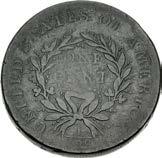
964. 1793 Flowing Hair Wreath Cent. Vine-and-Bars Edge. S-8. Rarity Low 3. NGC VG 8 BN. 6906859-001. An attractive example in this grade. ($1500)
From the Samuel K. Clark Collection.


965. 1937-D Three-Legged Buffalo Nickel. NGC AU 53. 6898740-003. ($500)
From the William H. Birkinshaw Collection.




966. 1875-S Twenty-Cent Piece. BF-5. Rarity 2. NGC MS 61. 6898740-008. Rim break on obverse at 6 o’clock. Major die break and cracks on reverse. ($500)
From the William H. Birkinshaw Collection.
967. 1875-S/S Twenty-Cent Piece. Misplaced Date, Repunched Mintmark. BF-16; FS-302. NGC MS 61. 6898740009. The top of an errant 5 is present in the denticles beneath the 7 in the date. The mintmark is sharply repunched. Coins with this reverse are commonly called the ‘$’ variety because the serifs are so widely separtated. ($500)
From the William H. Birkinshaw Collection.
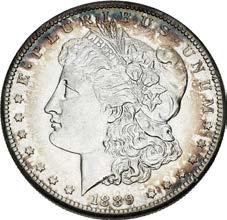
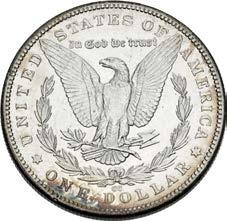
968. 1889-CC Morgan Dollar. NGC AU Details. 6906857-001. Iridescent toning around the peripheries. ($2000)
From the Samuel K. Clark Collection.




969. 1893 Morgan Dollar. NGC MS 61. 6906859-004. ($1000)
From the Samuel K. Clark Collection. 970. 1893-CC Morgan Dollar. NGC AU Details. 6906859-003. Iridescent toning about the peripheries. ($1000)
From the Samuel K. Clark Collection.


971. 1893-S Morgan Dollar. NGC AU Details. 6906857-002. Colorful peripheral iridescent toning. The key date in the series with the lowest mintage of the circulation strikes. ($5000)
From the Samuel K. Clark Collection.

972



972. 1903-S Morgan Dollar. NGC MS 63. 6906859-006. ($3000)
From the Samuel K. Clark Collection.
973. 1904-S Morgan Dollar. NGC MS 63. 6906859-005. ($2000)
From the Samuel K. Clark Collection.


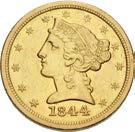

974. 1834 Classic Head Half Eagle. Block 8, Plain 4. HM-2. Rarity 3. NGC AU 55. 6904546-004. A radial die crack between stars 6 and 7 extends between B and E in LIBERTY and runs most of the way through the portrait. A lovely example of the type. ($750)
From the Samuel K. Clark Collection.
975. 1844-O Liberty Head Half Eagle. NGC AU 58. 6904546-001. ($750)
From the Samuel K. Clark Collection.


976. 1850 Liberty Head Double Eagle. NGC AU 53. The first collectible year of the denomination and type from the Philadelphia mint. ($3000)
From the Samuel K. Clark Collection.

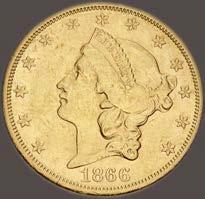
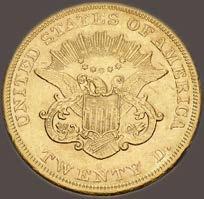

977. 1866-S Liberty Head Double Eagle. No Motto. NGC AU 55. 6904465-003. Of Type One Liberty Head Double Eagles the 1866-S No Motto is the second rarest San Francisco Mint issue after the famous 1861-S Paquet Reverse. It is estimated that 120,000 1866-S No Motto Double Eagles were struck but only about 200 survive in any grade. Rare, especially so in this grade. ($20,000)
From the Samuel K. Clark Collection.


From the Samuel K. Clark Collection.


From the Samuel K. Clark Collection.


From the Samuel K. Clark Collection.


a


982. Eagle Mining Co. Silver Ingot. 999/ FINE/ VALUE/ $7.58 on the face. OZS/ 5.88/ NO. 426 in three lines on the back. Minted in the 1950s-1960s. Poured. The ingot itself measures 31mm wide, 61mm tall, and 9mm deep. This type is listed in vintagesilver.com/hallmark-library/eagle-mining-co/ as Very Rare. Occurence frequency is given as Unobtainable. ($1000)
From the Alexander Christopher Collection.



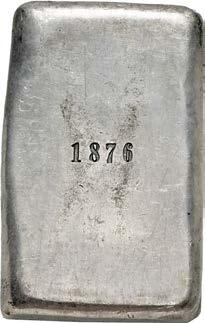
983. Louis & Mac Key Silver Ingot. 5.75 ounces, 999 Fine, No.46. The ingot itself measures 36mm wide, 60mm tall, and 8mm deep. Cf. Heritage (10 May 2007), lot 2441 (sold for $1,725). ($500)
From the Alexander Christopher Collection.
984. Nevada Silver Co. Silver Ingot. SILVER/ VAL. $6.33/ 999 FINE/ 4.91 OZS. No. 254 on the top edge. Dated 1876 on the back. Poured. The ingot itself measures 33mm wide, 52.5mm tall, and 8mm deep. Very Rare. Cf. Stack’s Bowers (24 March 2021), lot 6130 (price realized $4,080). ($1000)
From the Alexander Christopher Collection.
The Harl Collection presents a particularly good selection of Anglo-Saxon and Norman mints. The collectors generally opted for a scarcer or rarer mint when selecting the coins.
Aylesbury 1059
Bath 1027
Bedford 1075
Cambridge 996, 1012, 1037, 1050, 1076
Canterbury 994, 1060, 1095
Chester 1096
Chichester 1080, 1085
Colchester 1013, 1014, 1038
Derby 990
Dover 1039, 1051, 1077
Exeter 1028, 1057
Guildford 1040
Hastings 1081, 1086, 1102
Hereford 1002, 1109
Hertford 1015, 1053
Huntingdon 997, 1087
Ilchester 1016
Ipswich 1017
Lewes 1029, 1061, 1068, 1078, 1117
Lincoln 991, 1018, 1030, 1041, 1042, 1062, 1069
London 985, 986, 992, 993, 998, 999, 1003, 1019, 1031, 1043, 1052, 1058, 1071, 1092, 1108, 1112, 1114, 1118, 1123, 1124, 1125, 1127, 1129, 1130
Maldon 1032
Northampton 1070, 1082, 1088
Norwich 987, 988, 989, 1007, 1008, 1020, 1054, 1106, 1131
Oxford 1056, 1103
Rochester 995, 1033
Romney 1089, 1093, 1099, 1110
Salisbury 1116
Sandwich 1065, 1105, 1111, 1115
Shaftesbury 1005, 1044
Southwark 1000, 1021, 1022, 1083, 1119, 1126
Stamford 1004, 1009, 1034, 1035
Steyning 1090
Sudbury 1023
Thetford 1010, 1011, 1024, 1025, 1045, 1046, 1047, 1066, 1097, 1107, 1128
Uncertain 1120
Wallingford 1055
Wilton 1072, 1100
Winchester 1001, 1048, 1063, 1079, 1084, 1104, 1121, 1122
Worcester 1113
York 1006, 1026, 1036, 1049, 1064, 1067, 1073, 1074, 1091, 1094, 1098, 1101


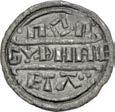
985. ANGLO-SAXON, Kings of Mercia. Burgred. 852-874. AR Penny (19mm, 1.20 g, 9h). Lunette Type C. London mint; Guthhere, moneyer. Struck circa 868/70-874. ዛ⎍ያűዞዝ ያዞม , diademed bust right / ű⎍ T ዡዞያዞ across central field; ዦℽዧ ዞͿ¨ Ḩ in broken lunettes above and below. MacKay H11.84-7 (dies O16/R–; unlisted rev. die); SCBI 67 (BM), 378 (same obv. die); North 425; SCBC 942B. Toned. Good VF. Very rare reverse type. ($1000)
Ex Owl Ltd. FPL III.2 (Winter 1977), no. 91; Baldwin’s inventory, circa 1954.
Burgred was the last independent king of Mercia and brother-in-law of Alfred the Great, King of Wessex. He warred against the Welsh, but he fled his kingdom and retired to Rome when he failed to check the Viking Great Army (865-879), which had overthrown the kingdoms of East Anglia and Northumbria. In 874, the Danes appointed as their vassal king in southern Mercia, Ceolwulf II (874-879).



986. ANGLO-SAXON, Kings of Wessex. Edward the Elder. 899-924. AR Penny (23mm, 1.63 g, 6h). Bust Diademed (BD) type (BMC iii). London mint; Framwis, moneyer. Struck circa 920-924. ม ዞ²ዝ⎍⎍ዞያዝ ያዞҟ , diademed and draped bust left / ዞያ©ዦ⎍ / ⎍ዢӲ ዦɭ in two lines; three crosses pattée between, cross between two trefoils above, trefoil below. CTCE 22; SCBI –; BMC 79; North 621; SCBC 1084. Die flaws. Slightly uneven tone. VF. Rare as a regular London-style issue ($2500)
Ex Davissons 6 (29 February 1996), lot 239.
Edward the Elder, son of Alfred the Great, campaigned tirelessly against the Danes settled in the Danelaw and so initiated policy of the unification of England. London, recovered from treaty by Alfred the Great in 886, emerged as the main mint and future center of a united England.



987. ANGLO-SAXON, Kings of Wessex. Æthelstan. 924-939. AR Penny (21mm, 1.51 g, 10h). Bust Crowned (BC) type (BMC viii). Norwich mint; Man, moneyer. ม ዞ T ዞ⌦ӲͿ¨n ያዞҟ , crowned and draped bust right / ม n¨nɃዞ nɭ Ƀɭያዝዩዞ , small cross pattée. Blunt, Aethelstan 285; SCBI 34 (BM), 145; North 675; SCBC 1094. Minor edge loss. Find patina. VF. Rare. ($2500)
Ex Classical Numismatic Group 36 (5 December 1995), lot 1452.
Aethelstan, son of Edward the Elder, briefly united England and was hailed rex totius Britanniae, “king of all Britain.” He occupied Viking York in 927, and defeated a coalition of Hiberno-Norse, Scots, and Strathclyde Britons at the Battle of Brunanburh in 937. The Hiberno- Norse King Olaf Guthfrithson (939-942) seized York and reestablished Viking rule after Aethelstan’s death.

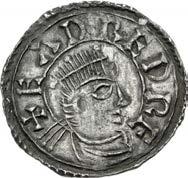
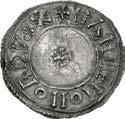
988. ANGLO-SAXON, Kings of Wessex. Eadred. 946-955. AR Penny (21mm, 1.28 g, 6h). Bust Crowned (BC) type (BMC v). Norwich mint; Man, moneyer. ม ዞ©ዝያዞዝ ያዞ , crowned and draped bust right / ม n²nnዞ nɭ nɭያዝዩ Ḩ ҟ , small cross pattée. CTCE 229; SCBI 34 (BM), 687-8; North 715; SCBC 1116. Slight double strike on reverse. A few minor marks. VF. Rare. ($2000)
Ex Classical Numismatic Review XXIII.1 (Winter 1998), no. 152; P. Finn FPL 10 (1997), no. 82.
King Eadred, the younger son of Edward the Elder and his third wife Eadgifu and succeeded his brother Edmund (939-946) and waged campaigns against the Hiberno-Norse kings who aimed to expand the Viking kingdom of York. In 954, the Christian Danish landowners expelled the Viking adventurer Erik the Bloodaxe for the second time and accepted Eadred as their king.

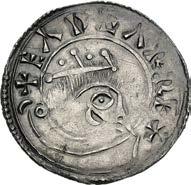
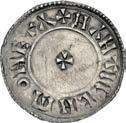
989. ANGLO-SAXON, Kings of All England. Eadgar. 959-975. AR Penny (21mm, 1.60 g, 2h). Bust Crowned (BC) type (BMC v). Mint in East Anglia (Norwich?); Manticen, moneyer. ม ዞ©ዝű©ያ ያዞม , crowned and draped bust right / ม n©n˶ዢ⌐ዞn ⍴ɭnዞ˶© , small cross pattée. CTCE 380; SCBI 34 (BM), 1179; North 750; SCBC 1138. Some light scratches. Toned. VF. A charming pre-reform local style portrait. Rare. ($2500)
Purchased from J. Linzalone, May 1998.
King Eadgar, the son of Edmund and his first wife Ælfgifu, from 957 ruled the lands north of the Thames, while his older brother Edwig (955959) ruled the ancestral kingdom of Wessex. With Edwig’s death in 959, Eadgar reigned over a united kingdom of England.

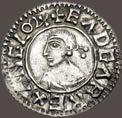


990. ANGLO-SAXON, Kings of All England. Eadgar. 959-975. AR Penny (20mm, 1.60 g, 3h). Reform Small Cross type (BMC vi). Derby mint; Asulfr, moneyer. Struck 973-975. Diademed and draped bust left / ม ɭӲ⎍⌦ዟ ዦ! ዝዞያዛӎ , small cross pattée. Jonsson p. 131-2; SCBI –; BMC 8 var. (mint name); North 752; SCBC 1141. Toned, areas of flat strike. Good VF. Pleasing portrait. Extremely rare. ($6000)
Ex M. Karlsson (Classical Numismatic Group 85, 15 September 2010), lot 1445 (hammer $15,000).
In ca. 973, Eadgar reformed the currency, discontinuing the striking of non-portrait pennies and ending the distinct regional styles. Hence, Anglo-Saxon mints struck a uniform coinage carrying exclusively an obverse portrait and a reverse type, (which were periodically altered), and naming the mint and moneyer. This superb specimen from the rare mint of Derby in the Danelaw is a historically significant coin in the history of English currency.
A superb companion penny from Derby struck by King Edward the Martyr (975-978), also from the Harl Collection, will be offered in our Triton XXVIII auction in January.



991. ANGLO-SAXON, Kings of All England. Æthelred II. 978-1016. AR Penny (21mm, 1.71 g, 2h). First Hand type (BMC iia, Hild. B1). Lincoln mint; Leofinc, moneyer. Struck circa 979-985. Diademed and draped bust right / ม ⌦ዢ⎍ዢnű ዦ!ɭ ⌦ዢnዝ⌐ɭ⌦ , manus Dei descending from clouds; barred © ѽ flanking. Mossop pl. III, 9 (dies A/a); cf. SCBI 27 (Lincolnshire), 34 (name as LEOFINC); North 766; SCBC 1144. Attractively toned. Good VF. Well struck on a broad flan. ($500)
Purchased from J. Linzalone, December 1996.
Aethelred II (978-1016) was rumored to have been complicit in the assassination of his predecessor and half-brother Edward the Martyr (975-978). The reverse types depicting the hand of God (manus Dei) project Aethelred’s legitimacy by virtue of the royal coronation–a ceremony based on the anointing by the prophets of the kings of Israel. The inclusion of Alpha and Omega alludes to the declaration of faith in Revelation 22:13.
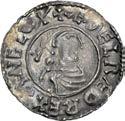


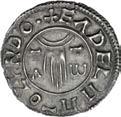
992. ANGLO-SAXON, Kings of All England. Æthelred II. 978-1016. AR Penny (21mm, 1.60 g, 9h). First Hand type (BMC iia, Hild. B1). London mint; Beorhtsige, moneyer. Struck circa 979-985. Diademed and draped bust right / ม ዛӎያ⎍ዡӲዢűዞ ዦ!ɭ ⌦⎍nዝɭ , manus Dei descending from clouds; barred © ѽ flanking. SCBI 36 (Berlin), 206 (same rev. die); North 766; SCBC 1144. Iridescent toning, some die wear. VF. ($400)
Purchased from York Coins, January 2009. Ex Duke of Argyll Collection.
993. ANGLO-SAXON, Kings of All England. Æthelred II. 978-1016. AR Penny (20mm, 1.59 g, 12h). First Hand type (BMC iia, Hild. B1). London mint; Eadhelm, moneyer. Struck circa 979-985. Diademed and draped bust right / ม ዞ©ዝዞ⌦ዦ ዦ!ɭ ⌦⎍nዝɭ , manus Dei descending from clouds; barred © ѽ flanking. SCBI 1 (Fitzwilliam), 633 var. (rev. legend); North 766; SCBC 1144. Deeply toned. VF. ($500)
Purchased from Spink, August 1976. Ex Duke of Argyll Collection.
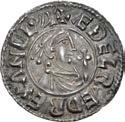

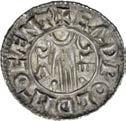
994. ANGLO-SAXON, Kings of All England. Æthelred II. 978-1016. AR Penny (21mm, 1.55 g, 9h). Second Hand type (BMC iid, Hild. B2). Canterbury mint; Eadweald, moneyer. Struck circa 985-991. Diademed and draped bust right; scepter to right / ม ዞ©ዝዩɭ⌦ዝ ዦ!ɭ ü ® nͿ , manus Dei descending from clouds; across field, barred © ѽ above pellets. SCBI 30 (American), 409 (same dies); North 768; SCBC 1146. Richly toned, small spot of red wax. Good VF. ($750)
Purchased from Spink, August 1976. Ex Duke of Argyll Collection.
Rochester Mint Benediction Hand

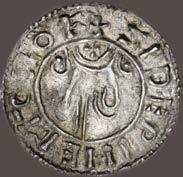

995. ANGLO-SAXON, Kings of All England. Æthelred II. 978-1016. AR Penny (20mm, 1.64 g, 4h). Benediction Hand type (BMC iif, Hild. B3). Rochester mint; Sidewine, moneyer. Struck circa 991. Draped bust right; cross-tipped scepter before / ม Ӳዢዝዞዩዢnዞ ዦ!ɭ ʼɭዟ , manus Dei, in Latin benediction form, descending from clouds; small cross pattée in clouds. SCBI 11 (Reading), 65 (same dies); North 769; SCBC 1147. Golden toning, a few peck marks. VF. Very rare. ($5000)
Ex Spink 1 (11 October 1978), lot 113.


996. ANGLO-SAXON, Kings of All England. Æthelred II. 978-1016. AR Penny (20mm, 1.51 g, 12h). Crux type (BMC iiia, Hild. C). Cambridge mint; Eadric, moneyer. Struck circa 991-997. Draped bust left; trefoil-tipped scepter to left / ม ዞዝያዢü ዦ!ɭ űʼ©nͿ , voided short cross; ü ʽ ⎍ ҟ in quarter. SCBI 50 (Hermitage), 324 (same dies); North 770; SCBC 1148. Vivid iridescent toning, peck marks. VF. ($400)
Ex Classical Numismatic Review XVIII.3 (Third Quarter 1993), no. 516.



997. ANGLO-SAXON, Kings of All England. Æthelred II. 978-1016. AR Penny (20mm, 1.76 g, 12h). Crux type (BMC iiia, Hild. C). Huntington mint; Ælfric, moneyer. Struck circa 991-997. Draped bust left; trefoil-tipped scepter to left / ม ® ⌦ዟያዢü ዦ!ɭ ዡ⎍nͿ , voided short cross; ü ʽ ⎍ ҟ in quarter. SCBI 7 (Copenhagen), 438; North 770; SCBC 1148. Deeply toned, two small peck marks. Good VF. Well struck. ($600)
Purchased from J. Linzalone, 20 October 2002.

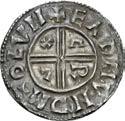


998. ANGLO-SAXON, Kings of All England. Æthelred II. 978-1016. AR Penny (21mm, 1.33 g, 6h). Crux type (BMC iiia, Hild. C). London mint; Eadmund, moneyer. Struck circa 991-997. Draped bust left; trefoil-tipped scepter to left /
ዦ!ɭ ⌦⎍nዝ , voided short cross; ü ʽ ⎍ ҟ in quarter. SCBI 20 (Mack), 865 (same dies); North 770; SCBC 1148. Toned, faint earthen deposits. VF. ($400)
Ex Ponterio 147 (16 September 2008), lot 234.
999. ANGLO-SAXON, Kings of All England. Æthelred II. 978-1016. AR Penny (20mm, 1.23 g, 7h). Crux type (BMC iiia, Hild. C). London mint; Leofstan, moneyer. Struck circa 991-997. Draped bust left; trefoil-tipped scepter to left / ม ⌦ዞɭዟӲͿ©n ዦ!ɭ ⌦⎍n , voided short cross; ü ʽ ⎍ ҟ in quarter. SCBI 7 (Copenhagen), 880; North 770; SCBC 1148. Deeply toned, some die rust. Good VF. ($500)
Ex Henry Christensen 58 (5 December 1975), lot 106.




1000. ANGLO-SAXON, Kings of All England. Æthelred II. 978-1016. AR Penny (20mm, 1.54 g, 6h). Crux type (BMC iiia, Hild. C). Southwark mint Ælfric, moneyer. Struck circa 991-997. Draped bust left; trefoil-tipped scepter to left / ม
ዦ!ɭ Ӳ⎍ዝű , voided short cross; ü ʽ ⎍ ҟ in quarter. SCBI 7 (Copenhagen), var. (rev. legend; same obv. die); North 770; SCBC 1148. Light tone, slight double strike. Good VF. ($400)
Ex Coin Galleries (5 November 1997), lot 1902.
1001. ANGLO-SAXON, Kings of All England. Æthelred II. 978-1016. AR Penny (21mm, 1.66 g, 6h). Crux type (BMC iiia, Hild. C). Winchester mint; Beorhtsige, moneyer. Struck circa 991-997. Draped bust left; trefoil-tipped scepter to left / ม
ዩዢn , voided short cross; ü ʽ ⎍ ҟ in quarter. Harvey 384 (dies A1/c); SCBI 7 (Copenhagen), 1362; North 770; SCBC 1148. A few small peck marks on reverse. Richly toned. VF. ($400)
Purchased from James King, 3 November 1977.


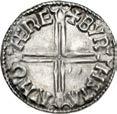

1002. ANGLO-SAXON, Kings of All England. Æthelred II. 978-1016. AR Penny (19mm, 1.73 g, 6h). Long Cross type (BMC iva, Hild. D). Hereford mint; Beorhstan, moneyer. Struck circa 997-1003. Draped bust left; pellet behind neck / ม ዛӎያ HӲͿ© n ዦ=ɭ H ያዞ , voided long cross, with pellet at center and triple-crescent ends. SCBI 50 (Hermitage), 695 (same dies); North 774; SCBC 1151. Lightly toned, a couple of pecks on reverse. Good VF. ($500)
Ex Classical Numismatic Group inventory 825609 (October 2008); Baldwin’s 57 (23 September 2008), lot 308.
The English pennies with reverse type of the Long Cross were struck in large numbers and were paid out in Danegeld. Reported payments totaled £180,000 (perhaps 43.2 million pennies). These pennies were widely imitated in Scandinavia and Hiberno-Norse Dublin (see lots 1146–56, below).
Aethelred II, nicknamed the Unready, from unræd (poor counsel) failed to check renewed Viking attacks from 991 on and frequently bought off Vikings by the payment of Danegeld. Aethelred, however, provoked a war of conquest by King Svend Forkbeard of Denmark and his son Cnut the Great (Knud) by ordering the St. Brice’s Day Massacre of recent Danish settlers on November 13, 1002.


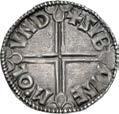
1003. ANGLO-SAXON, Kings of All England. Æthelred II. 978-1016. AR Penny (20mm, 1.72 g, 4h). Long Cross type (BMC iva, Hild. D). London mint; Sibwine, moneyer. Struck circa 997-1003. Draped bust left; pellet behind neck / ม
⌦ ⎍nዝ , voided long cross, with pellet at center and triple-crescent ends. SCBI 7 (Copenhagen), 931 (same dies); North 774; SCBC 1151. Old cabinet toning. Good VF. Well struck. ($500)
Purchased from Owl Ltd., 7 December 1977.
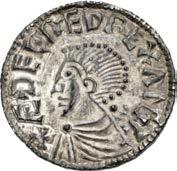



1004. ANGLO-SAXON, Kings of All England. Æthelred II. 978-1016. AR Penny (20mm, 1.19 g, 9h). Long Cross type (BMC iva, Hild. D). Stamford mint; Leofinc (?), moneyer. Struck circa 1000-1010. Draped bust left; pellet behind neck / ม
ɭ=ɭn ZͿ©Ƀ , voided long cross, with pellet at center and triple-crescent ends. Cf. SCBI 7 (Copenhagen), 1148 (for moneyer Svartgeirr; same obv. die); North 774; SCBC 1151. Toned. Good VF. ($1500)
Ex Classical Numismatic Group 45 (18 March 1999), lot 2764.
Stamford is known for using several crude, locally produced, and somewhat blundered dies in the Long Cross issue. This coin is currently thought to be an official issue, but with a blundered reverse legend. Evidently it was not used for long, as this cataloger can find no other examples.



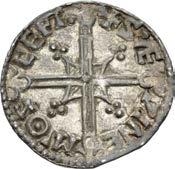
1005. ANGLO-SAXON, Kings of All England. Æthelred II. 978-1016. AR Penny (19mm, 1.47 g, 1h). Helmet type (BMC viii, Hild. E). Shaftesbury mint; Sæwine, moneyer. Struck circa 1003-1009. Helmeted bust left / ม Ӳ/
Ӳ
, voided long cross with triple-crescent ends and pellet at center; in each quarter, trefoil on pile. SCBI 50 (Hermitage), 1082 (same dies); North 775; SCBC 1152. Some obverse die wear. Light golden toning. VF. Rare. ($500)
Purchased from J. Linzalone, 6 December 1996.

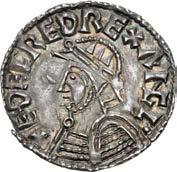

1006. ANGLO-SAXON, Kings of All England. Æthelred II. 978-1016. AR Penny (19mm, 1.33 g, 5h). Helmet type (BMC viii, Hild. E). York mint; Wulfsige, moneyer. Struck circa 1003-1009. Helmeted bust left / ม ዩ⎍⌦
, voided long cross with triple-crescent ends and pellet at center; in each quarter, trefoil on pile. SCBI 7 (Copenhagen), 327 (same dies); North 775; SCBC 1152. Deep iridescent toning, peck mark, edge slightly ragged. Good VF. ($600)
Purchased from York Coins, 8 January 2009.

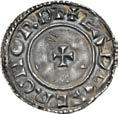


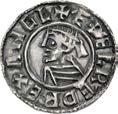

1007. ANGLO-SAXON, Kings of All England. Æthelred II. 978-1016. AR Penny (20mm, 1.31 g, 10h). Last Small Cross type (BMC i, Hild. A). Norwich mint; Eadwacer, moneyer. Struck circa 1009-1016. Diademed and draped bust left / ม ዞ©ዝዩ©üʼ ɭ nɭʼ T ዩ , small cross pattée. SCBI 7 (Copenhagen), 1008 (same dies); North 777; SCBC 1154. Rich iridescent toning, a few peck marks. Good VF. ($400)
Ex Vecchi 13 (4 September 1998), lot 1673; G.V. Doubleday (Glendining’s, 6 October 1987), lot 382; Duke of Argyll Collection.
Mints continued to strike pennies carrying the types of the Last Small Cross during the tumultuous fighting of 1013-1016. In 1013, Aethelred II fled England to Normandy as an exile when Svend Forkbeard invaded in force. But Svend died the next year; the Danish army proclaimed Cnut king; and Aethelred and his son Edmund Ironside mounted an effort to recover England in 1014-1016. Aethelred died on April 23, 1016. Edmund Ironside and Cnut agreed to a partition of England by a treaty after Cnut’s victory at Assandun (October 18, 1016). Edmund died prematurely a month later so that Cnut succeeded to the entirety of the English kingdom.
1008. ANGLO-SAXON, Kings of All England. Æthelred II. 978-1016. AR Penny (20mm, 1.67 g, 2h). Last Small Cross type (BMC i, Hild. A). Norwich mint; Leofwine, moneyer. Struck circa 1009-1016. Diademed and draped bust left / ม
ዦ∂
T, small cross pattée. SCBI 9 (Ashmolean), 626 (same dies); North 777; SCBC 1154. Toned with some iridescence, some die rust. Good VF. ($400)
Purchased from James King, 9 December 1977.
1009. ANGLO-SAXON, Kings of All England. Æthelred II. 978-1016. AR Penny (20mm, 1.30 g, 3h). Last Small Cross type (BMC i, Hild. A). Stamford mint; Leofwine, moneyer. Struck circa 1009-1016. Diademed and draped bust left /
ӲͿ©n , small cross pattée; ύ in fourth quarter. SCBI 7 (Copenhagen), 1140 (same rev. die); North 777; SCBC 1154. Toned, die flaws on obverse. Good VF. Rare with symbol. ($500)
Purchased from J. Linzalone, 6 December 1996.



1010. ANGLO-SAXON, Kings of All England. Æthelred II. 978-1016. AR Penny (19mm, 1.48 g, 8h). Last Small Cross type (BMC ia, Hild. Aa). Thetford mint; Fastulfr, moneyer. Struck circa 1009-1016. Diademed and draped bust right / ม ዟ©Ӳ˸⎍ዟ ዦ!ɭ T ዞɭ˸ዟ (crescent over pellet), small cross pattée. SCBI 7 (Copenhagen), 1214 (same dies); North 780; SCBC 1154A. Golden toning. Good VF. A very rare variety with bust right. ($1000)
Purchased from J. Linzalone. Ex Collection of an Underwriter (Classical Numismatic Group 90, 23 May 2012), lot 2389; ‘Charles’ Collection (Dix, Noonan, Webb 93, 26 September 2011), lot 1023.



1011. ANGLO-SAXON, Kings of All England. Æthelred II. 978-1016. AR Penny (19mm, 1.53 g, 6h). Last Small Cross type (BMC ic, Hild. Ac). Thetford mint; Man, moneyer. Struck circa 1009-1016. Diademed and draped bust left / ม ዦ¨nn¨ ɭn T ዞɭዝዟɭ (crescent over pellet), small cross pattée; four small crosses around. SCBI –; North 779; SCBC 1154. Golden toning. Good VF. Rare variety with additional crosses. ($600)
Purchased from J. Linzalone.
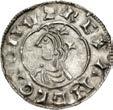
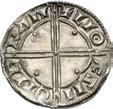



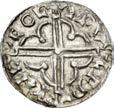
1012. ANGLO-SAXON, Kings of All England. Cnut. 1016-1035. AR Penny (19mm, 0.99 g, 9h). Quatrefoil type (BMC viii, Hild. E). Cambridge mint; Leofsige, moneyer. Struck circa 1016-1023. Crowned and draped bust left within quatrefoil / ม ⌦ዢ∂ ዟӲዢዢ ∂n ű ʼ©n , voided long cross with triple-crescent ends and pellet at center; all over quatrefoil. SCBI 15 (Copenhagen), 1095 (same dies); North 781; SCBC 1157. Lightly toned with hints of luster, tiny bit of die rust in field. Near EF. ($400)
Ex Davissons 10 (30 April 1998), lot 178.
Cnut the Great (1016-1035) maintained the system of Anglo-Saxon mints, striking a significant coinage of pennies (on a lower weight standard) that paid for his army and navy that maintained a North Sea Empire embracing England, Denmark, and, after 1028, Norway. Recorded levies total £82,500 (19.8 million pennies).
1013. ANGLO-SAXON, Kings of All England. Cnut. 1016-1035. AR Penny (18mm, 0.93 g, 12h). Quatrefoil type (BMC viii, Hild. E). Colchester mint; Ælfwine, moneyer. Struck circa 1016-1023. Crowned and draped bust left within quatrefoil / ม ® ⌦ ዟዩ ዢnዞ üɭ⌦ዞ , voided long cross with triple-crescent ends and pellet at center; all over quatrefoil. Turner 63 var. (rev. legend); SCBI 13 (Copenhagen), 247 (same dies); North 781; SCBC 1157. Toned. Good VF. ($400)
Purchased from J. Linzalone, 1976.
1014. ANGLO-SAXON, Kings of All England. Cnut. 1016-1035. AR Penny (19mm, 0.92 g, 3h). Quatrefoil type (BMC viii, Hild. E). Colchester mint; Wulfwine, moneyer. Struck circa 1016-1023. Crowned and draped bust left within quatrefoil / ม ዩ⎍ ⌦ዟዩ ዢnዞ üɭ⌦ , voided long cross with triple-crescent ends and pellet at center; all over quatrefoil. Turner 75; SCBI 13 (Copenhagen), 271 (same dies); North 781; SCBC 1157. Light golden toning. Good VF. ($400)
Purchased from Mike Vosper, 30 November 2000.
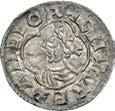


1015. ANGLO-SAXON, Kings of All England. Cnut. 1016-1035. AR Penny (19mm, 0.97 g, 10h). Quatrefoil type (BMC viii, Hild. E). Hertford mint; Leofing, moneyer. Struck circa 1016-1023. Crowned and draped bust left within quatrefoil / ม ⌦ӎዟ ዢnü Ḧ ɭn ʼ ዞ˸ዞ , voided long cross with triple-crescent ends and pellet at center; all over quatrefoil with pellets in spandrels. SCBI 13 (Copenhagen), 1507 var. (legends); North 781 var. (extra pellets); SCBC 1157 var. (same). Light golden toning, some peripheral weakness. Good VF. Very rare variety with additional pellets. ($500)
Purchased from York Coins, 1 October 2007. Ex D. Griffiths (Dix Noonan Webb, 7 October 2003), lot 603; D. Fish (Glendining, 7 March 1990), lot 1318; F. Elmore-Jones (Glendining, 12 May 1971), lot 60.


1016. ANGLO-SAXON, Kings of All England. Cnut. 1016-1035. AR Penny (18mm, 0.81 g, 9h). Quatrefoil type (BMC viii, Hild. E). Ilchester mint; Ælfsige, moneyer. Struck circa 1016-1023. Crowned and draped bust left within quatrefoil /
, voided long cross with triple-crescent ends and pellet at center; all over quatrefoil. SCBI 13 (Copenhagen), 937 (same dies); North 781; SCBC 1157. Lightly toned, bluntly struck. VF. Rare mint. ($600)
Purchased from Mike Vosper, 11 September 2000.

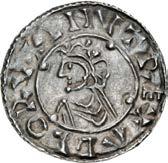
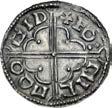
v1017. ANGLO-SAXON, Kings of All England. Cnut. 1016-1035. AR Penny (18mm, 1.02 g, 1h). Quatrefoil type (BMC viii, Hild. E). Ipswich mint; Eadric, moneyer. Struck circa 1016-1023. Crowned and draped bust left within quatrefoil / ม
, voided long cross with triple-crescent ends and pellet at center; all over quatrefoil. Sadler II 448 (dies 8/12; this coin); SCBI 13 (Copenhagen), 982 (same rev. die); North 781; SCBC 1157. Toned. VF. ($400)
Ex Classical Numismatic Group inventory 796080 (September 2007); Goldberg 31 (27 May 2007), lot 3158; St. James’s 2 (11 May 2005), lot 19.


1018. ANGLO-SAXON, Kings of All England. Cnut. 1016-1035. AR Penny (19mm, 0.96 g, 6h). Quatrefoil type (BMC viii, Hild. E). Lincoln mint; Asfrithr, moneyer. Struck circa 1016-1023. Crowned and draped bust left within quatrefoil / ม ɭӲ ዟዞʼ T ዦɭ ⌦ዢ ü, voided long cross with triple-crescent ends and pellet at center; all over quatrefoil. Mossop pl. XXXVII, 24 (dies F/j); SCBI 13 (Copenhagen), 1763; North 781; SCBC 1157. Old cabinet toning. Good VF. ($400)
Purchased from York Coins, 1 October 2007.



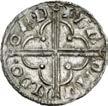
1019. ANGLO-SAXON, Kings of All England. Cnut. 1016-1035. AR Penny (18mm, 1.05 g, 3h). Quatrefoil type (BMC viii, Hild. E). London mint; Eadweald, moneyer. Struck circa 1016-1023. Crowned and draped bust left within quatrefoil / ม ዞዝ ዩ∂⌦ ዝ ∂ ⌦ ⎍ Ä, voided long cross with triple-crescent ends and pellet at center; all over quatrefoil. SCBI 14 (Copenhagen), 2490 (same dies); North 781; SCBC 1157. Rich colourful tone. Good VF. ($400)
Ex Henry Christensen 58 (5 December 1975), lot 107.
1020. ANGLO-SAXON, Kings of All England. Cnut. 1016-1035. AR Penny (18mm, 0.84 g, 10h). Quatrefoil type (BMC viii, Hild. E). Norwich mint; Eadmund, moneyer. Struck circa 1016-1023. Crowned and draped bust left within quatrefoil / ม ዞ¨ ዝዦ⎍ nዝ / ɭ ɭʼ T, voided long cross with triple-crescent ends and pellet at center; all over quatrefoil. SCBI 25 (Helsinki), 681 (same dies); North 781; SCBC 1157. Lightly toned, minor deposits. Good VF. ($400)
Purchased from A.G. and S. Gillis, 1999.
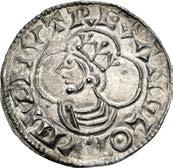



1021. ANGLO-SAXON, Kings of All England. Cnut. 1016-1035. AR Penny (19mm, 1.07 g, 8h). Quatrefoil type (BMC x, Hild. Ei). Southwark mint; Ælfsige, moneyer. Struck circa 1016-1023. Crowned and draped bust left within quatrefoil / ม
ዦ
Ӳ ⎍ዝű , voided long cross with triple-crescent ends and pellet at center; all over quatrefoil with triple pellets at apex of cusps. SCBI 15 (Copenhagen), 3695-6 (same rev. die); North 786; SCBC 1157 var. (rev. type). Lightly toned with hints of luster. Much as struck. Near EF. Rare variety with triple pellets on reverse. Exceptional style, detailing even the king’s hair beneath his crown. ($600)
Ex Classical Numismatic Group inventory 719086 (February 2000).


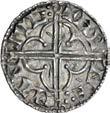
1022. ANGLO-SAXON, Kings of All England. Cnut. 1016-1035. AR Penny (19mm, 1.03 g, 12h). Quatrefoil type (BMC viii, Hild. E). Southwark mint; Hunman, moneyer. Struck circa 1016-1023. Crowned and draped bust left within quatrefoil; cross to right / ม ዡ⎍ nዞ Ḧ/ ዦ⎍n Ӳ⎍ű ḧ , voided long cross with triple-crescent ends and pellet at center; all over quatrefoil. SCBI –; North 781 var. (cross behind bust) and pl. 13, 25 (this coin illustrated); SCBC 1157 var. (same). Old iridescent toning, a few peck marks, slightly wavy. Good VF. Rare variety and sceptre behind bust. ($600)
Ex R.C. Lockett (Part IV, Glendining, 26 April 1960), lot 3754 (part of).

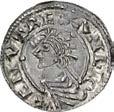


1023. ANGLO-SAXON, Kings of All England. Cnut. 1016-1035. AR Penny (19mm, 0.88 g, 7h). Quatrefoil type (BMC viiic, Hild. Eb). Sudbury mint; Mansige, moneyer. Struck circa 1016-1023. Crowned and draped bust left within quatrefoil / ม ዦ©
ɭn Ӳ ⎍ዛʼ / , voided long cross with triple-crescent ends and pellet at center, crosses in first and third quarters; all over quatrefoil. SCBI 15 (Copenhagen), 3732 (same dies); North 783; SCBC 1157 var. (bust to edge, crosses on reverse). Toned, slightly wavy. Near EF. Extremely rare and likely the finest known example. ($1500)
Ex Classical Numismatic Review XXII.3 (Fall/Winter 1997), no. 144.
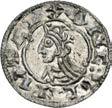

1024. ANGLO-SAXON, Kings of All England. Cnut. 1016-1035. AR Penny (19mm, 0.83 g, 2h). Quatrefoil type (BMC viii, Hild. E). Thetford mint; Leofsige, moneyer. Struck circa 1016-1023. Crowned and draped bust left within quatrefoil / ม ዛʼ ⎍n˸ ©n ɭ ዝዢɭ , voided long cross with triple-crescent ends and pellet at center; all over quatrefoil. SCBI 15 (Copenhagen), 3789 var. (legends); North 781; SCBC 1157. Lightly toned with hints of luster. Near EF. ($400)
Purchased from M. Vosper, 5 April 2001.




1025. ANGLO-SAXON, Kings of All England. Cnut. 1016-1035. AR Penny (18mm, 0.90 g, 4h). Quatrefoil type (BMC viii, Hild. E). Thetford mint; Tidræd, moneyer. Struck circa 1016-1023. Crowned and draped bust left within quatrefoil; quatrefoil of pellets to right / ม
, voided long cross with triple-crescent ends and pellet at center, short crosses in second and fourth quarters; all over quatrefoil. SCBI –; North 781; SCBC 1157. Deep iridescent toning, slightly off center. Good VF. Rare moneyer and very rare variety with additional quatrefoil and crosses. ($600)
Purchased from J. Linzalone, 17 October 2010.



1026. ANGLO-SAXON, Kings of All England. Cnut. 1016-1035. AR Penny (20mm, 1.06 g, 10h). Quatrefoil type (BMC viii, Hild. E). York mint; Kolgrimr, moneyer. Struck circa 1016-1023. Crowned and draped bust left within quatrefoil / ม üɭ Ḧ ⌦űʼ ዢዦ
ɭ ዞɭዟ , voided long cross with triple-crescent ends and pellet at center; all over quatrefoil. SCBI 20 (Mack), 1085 (same obv. die); North 781; SCBC 1157. Old cabinet toning with splashes of iridescence. Near EF. ($600) Ex Classical Numismatic Group inventory 841842 (April 2009).

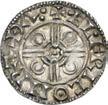
1027. ANGLO-SAXON, Kings of All England. Cnut. 1016-1035. AR Penny (18mm, 1.11 g, 10h). Pointed Helmet type (BMC xiv, Hild. G). Bath mint; Ælfric, moneyer. Struck circa 1023-1030. Bust left, wearing pointed helmet; trefoil-tipped scepter before / ม ® ⌦ዟʼዢü ∂n ዛ¨ T ¨ Ḧ , voided short cross, limbs united at base by two concentric circles with pellet in center; in each angle, broken annulet enclosing pellet. Grinsell 1; SCBI 13 (Copenhagen), 20 (same obv. die); North 787; SCBC 1158. Rich golden toning, some light die wear on obverse. Near EF. ($400)
Ex Classical Numismatic Group inventory 712424 (April 1999).
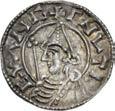

1028. ANGLO-SAXON, Kings of All England. Cnut. 1016-1035. AR Penny (18mm, 1.15 g, 9h). Pointed Helmet type (BMC xiv, Hild. G). Exeter mint; Sæwine, moneyer. Struck circa 1023-1030. Bust left, wearing pointed helmet; trefoil-tipped scepter before / ม ˫ ® ዩዢnዞ ∂n ዞüüҟüዞ Ḧ , voided short cross, limbs united at base by two concentric circles with pellet in center; in each angle, broken annulet enclosing pellet. Brettell, Exeter 167 (this coin); SCBI 13 (Copenhagen), 476 (same dies); North 787; SCBC 1158. Toned. Good VF. ($400)
Purchased from Spink, 10 December 1976. Ex R.P.V. Brettell (Glendining, 28 October 1970), lot 167; S. Simpson Collection (purchased en bloc by Brettell, 1955).


1029. ANGLO-SAXON, Kings of All England. Cnut. 1016-1035. AR Penny (18mm, 1.01 g, 9h). Pointed Helmet type (BMC xiv, Hild. G). Lewes mint; Ælfweard, moneyer. Struck circa 1023-1030. Bust left, wearing pointed helmet; trefoiltipped scepter before / ม ® /⌦/ዟዩዞ¨ʼዝ ɭn ⌦ ®, voided short cross, limbs united at base by two concentric circles with pellet in center; in each angle, broken annulet enclosing pellet. King 152-5 var. (rev. legend); SCBI 13 (Copenhagen), 1299-1300 var. (rev. legend); North 787; SCBC 1158. Toned, slightly wavy and double struck on reverse. Near EF. ($400)
Ex Vecchi 17 (15 December 1999), lot 1564.



1030. ANGLO-SAXON, Kings of All England. Cnut. 1016-1035. AR Penny (18mm, 0.94 g, 4h). Pointed Helmet type (BMC xiv, Hild. G). Lincoln mint; Wulfwine, moneyer. Struck circa 1023-1030. Bust left, wearing pointed helmet; trefoil-tipped scepter before; small cross to right / ม ዩ⎍⌦ዟዩዢnዞ ∂n ⌦ዢ , voided short cross, limbs united at base by two concentric circles with pellet in center; in each angle, broken annulet enclosing pellet. Mossop –; SCBI –; North 787 var. (small cross on obv.); SCBC 1158 var. (same). Lustrous, minor green deposits. Near EF. Very rare variety with cross on obverse. ($600)
Ex Triton X (9 January 2007), lot 1310.
Hildebrand and Mossop record crosses behind the heads on coins of helmet type for the Lincoln moneyers Brihtric, Godwine, Matathan, Osmund, Swerting, and Wulbern; but not for Wulfwine.
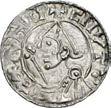


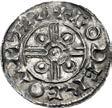
1031. ANGLO-SAXON, Kings of All England. Cnut. 1016-1035. AR Penny (18mm, 0.90 g, 9h). Pointed Helmet type (BMC xiv, Hild. G). London mint; Leofwine, moneyer. Struck circa 1023-1030. Bust left, wearing pointed helmet; trefoiltipped scepter before / ม ⌦ዞɭዟዩዢnዞ ɭn ⌦⎍nዝ / , voided short cross, limbs united at base by two concentric circles with pellet in center; in each angle, broken annulet enclosing pellet. SCBI 14 (Copenhagen), 2785 (same rev. die); North 787; SCBC 1158. Lightly toned. Near EF. ($400)
Ex Classical Numismatic Group Electronic Auction 309 (21 August 2013), lot 504.
1032. ANGLO-SAXON, Kings of All England. Cnut. 1016-1035. AR Penny (19mm, 0.95 g, 4h). Pointed Helmet type (BMC xiv, Hild. G). Maldon mint; Godhere, moneyer. Struck circa 1023-1030. Bust left, wearing pointed helmet; trefoiltipped scepter before / ม űɭዝዞʼዞ ɭn ዦ ® ⌦ዝ , voided short cross, limbs united at base by two concentric circles with pellet in center; in each angle, broken annulet enclosing pellet. SCBI 66 (Norwegian), 3111 (same dies); North 787; SCBC 1158. Richly toned, slightly wavy flan, struck with worn reverse die. Good VF. Rare. ($400)
Ex Classical Numismatic Group 46 (24 June 1998), lot 1862.
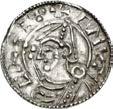

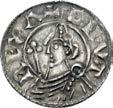

1033. ANGLO-SAXON, Kings of All England. Cnut. 1016-1035. AR Penny (19mm, 1.04 g, 9h). Pointed Helmet type (BMC xiv, Hild. G). Rochester mint; Ælfheah, moneyer. Struck circa 1023-1030. Bust left, wearing pointed helmet; trefoiltipped scepter before / ม ® ⌦ዟዞH ɭnn ʼɭዟዟዞ Ḧ , voided short cross, limbs united at base by two concentric circles with pellet in center; in each angle, broken annulet enclosing pellet. SCBI 15 (Copenhagen), 3303 var. (legends); North 787; SCBC 1158. Lightly toned, a few small marks on face. Good VF. ($400)
Purchased from Mike Vosper, 15 February 2000.
1034. ANGLO-SAXON, Kings of All England. Cnut. 1016-1035. AR Penny (18mm, 0.90 g, 6h). Pointed Helmet type (BMC xiv, Hild. G). Stamford mint; Leofric, moneyer. Struck circa 1023-1030. Bust left, wearing pointed helmet; trefoiltipped scepter before / ม ⌦ዞɭዟʼዢü ∂n Ӳ˸©ዢ , voided short cross, limbs united at base by two concentric circles with pellet in center; in each angle, broken annulet enclosing pellet. SCBI 15 (Copenhagen), 3586; North 787; SCBC 1158. Toned, slight bend. Good VF. ($400)
Ex Classical Numismatic Group inventory 770438 (May 2006).
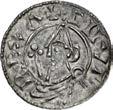

1035. ANGLO-SAXON, Kings of All England. Cnut. 1016-1035. AR Penny (19mm, 0.96 g, 9h). Pointed Helmet type (BMC xiv, Hild. G). Stamford mint; Leofric, moneyer. Struck circa 1023-1030. Bust left, wearing pointed helmet; trefoiltipped scepter before / ม ⌦ዞɭʼዢü ∂n Ӳ˸©n , voided short cross, limbs united at base by two concentric circles with pellet in center; in each angle, broken annulet enclosing pellet; extra pellets in second and third quarters. Cf. SCBI 27 (Lincolnshire), 1259 (for LEOFRIC with one extra pellet); North 787 var. (extra pellets on rev.); SCBC 1158 var. (same). Toned. VF. A rare variety with extra pellets on the reverse. ($400)
Ex Vecchi 13 (4 September 1998), lot 1675.
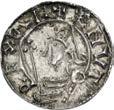


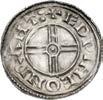
1036. ANGLO-SAXON, Kings of All England. Cnut. 1016-1035. AR Penny (18mm, 1.07 g, 59h). Pointed Helmet type (BMC xiv, Hild. G). York mint; Wulfnoth, moneyer. Struck circa 1023-1030. Bust left, wearing pointed helmet; trefoil-tipped scepter before / ม ዩ⎍⌦nɭ T ዦ O ɭ ዞɭዟʼ , voided short cross, limbs united at base by two concentric circles with pellet in center; in each angle, broken annulet enclosing pellet. SCBI 13 (Copenhagen), 909-10 (same obv. die); North 787; SCBC 1158. Golden toning, minor deposits, slightly rusted obverse die. Good VF. ($400)
Ex Stack’s (1 December 1999), lot 832.
1037. ANGLO-SAXON, Kings of All England. Cnut. 1016-1035. AR Penny (17mm, 1.17 g, 9h). Short Cross type (BMC xvi, Hild. H). Cambridge mint; Eadwine, moneyer. Struck circa 1029-1035. Diademed and draped bust left; scepter to left / ม ዞዝዩዢnዞ ɭn ʼ¨nͿ , voided short cross; annulet at center. SCBI 13 (Copenhagen), 1084 (same dies); North 790; SCBC 1159. Golden iridescent toning. Good VF. ($400)
Purchased from York Coins, 9 January 2007.
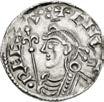
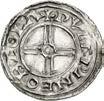


1038. ANGLO-SAXON, Kings of All England. Cnut. 1016-1035. AR Penny (16mm, 1.20 g, 12h). Short Cross type (BMC xvi, Hild. H). Colchester mint; Wulfwine, moneyer. Struck circa 1029-1035. Diademed and draped bust left; scepter to left / ม ዩ⎍⌦ዟዩዢnዞ ɭn üɭ⌦/a , voided short cross; annulet at center. SCBI 13 (Copenhagen), 277 (same dies); North 790; SCBC 1159. Lightly toned, slightly double struck on reverse. Good VF. ($400)
Purchased from Mike Vosper, 30 November 2000.
1039. ANGLO-SAXON, Kings of All England. Cnut. 1016-1035. AR Penny (18mm, 0.88 g, 6h). Short Cross type (BMC xvi, Hild. H). Dover mint; Boga, moneyer. Struck circa 1029-1035. Diademed and draped bust left; scepter to left / ม ዛɭű© ɭn ዝɭዟʼ Ḧ , voided short cross; annulet at center. SCBI 13 (Copenhagen), 321 (same dies); North 790; SCBC 1159. Toned. Good VF. ($400)
Ex Classical Numismatic Group inventory 783866 (January 2007); Bruun Rasmussen 764 (11 December 2006), lot 5460.


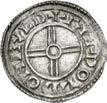

1040. ANGLO-SAXON, Kings of All England. Cnut. 1016-1035. AR Penny (18mm, 1.18 g, 3h). Short Cross type (BMC xvi, Hild. H). Guildford mint; Ælfweald, moneyer. Struck circa 1029-1035. Diademed and draped bust left; scepter to left / ม a⌦ዟዩɭ⌦ዝ ɭn űӎ⌦ዝ , voided short cross; annulet at center. SCBI 13 (Copenhagen), 1125 (same dies); North 790; SCBC 1159. Toned. Near EF. Rare mint and moneyer. Only one in SCBI, none of this moneyer in CoinArchives. ($1000)
Ex Vecchi 17 (19 December 1999), lot 1565.


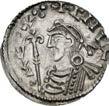

1041. ANGLO-SAXON, Kings of All England. Cnut. 1016-1035. AR Penny (18mm, 1.08 g, 12h). Short Cross type (BMC xvi, Hild. H). Lincoln mint; Vathlauss, moneyer. Struck circa 1029-1035. Diademed and draped bust left; scepter to left / ม ዩ²ዝ⌦ɭ˫ ɭ à ዢ ü ɭ⌦ , voided short cross; annulet at center. Mossop pl. LVI, 15 (dies K/i); SCBI 14 (Copenhagen), 1888 (same dies); North 790; SCBC 1159. Lustrous. Near EF. ($400)
Purchased from Mike Vosper, 5 April 2001.
1042. ANGLO-SAXON, Kings of All England. Cnut. 1016-1035. AR Penny (18mm, 1.28 g, 11h). Short Cross type (BMC xvi, Hild. H). Lincoln mint; Wulfwine, moneyer. Struck circa 1029-1035. Diademed and draped bust left; scepter to left / ม ዩ⎍⌦/ዟዩዢnዞ ɭn ⌦ዢnü , voided short cross; annulet at center. Mossop pl. LVII, 4 (dies C/d); SCBI 27 (Lincolnshire), 536 (same dies); North 790; SCBC 1159. Deep golden toning, off center. Near EF. ($400)
Purchased from York Coins, 1 October 2007.
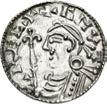
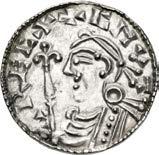

1043. ANGLO-SAXON, Kings of All England. Cnut. 1016-1035. AR Penny (18mm, 1.24 g, 9h). Short Cross type (BMC xvi, Hild. H). London mint; Wynsige, moneyer. Struck circa 1029-1035. Diademed and draped bust left; scepter to left / ม ዩӎn˫ዢűዞ ɭn ⌦⎍ ë, voided short cross; annulet at center. SCBI 14 (Copenhagen), 3058 (same dies); North 790; SCBC 1159. Lustrous. Near EF. ($400)
Purchased from Mike Vosper, 5 April 2001.

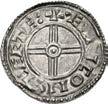


1044. ANGLO-SAXON, Kings of All England. Cnut. 1016-1035. AR Penny (18mm, 1.20 g, 3h). Short Cross type (BMC xvi, Hild. H). Shaftesbury mint; Æthelric, moneyer. Struck circa 1029-1035. Diademed and draped bust left; scepter to left / ม ® ⌦ʼዢü ɭn ˫ዞዞዟ˸ዞ Ḧ , voided short cross; annulet at center. SCBI 15 (Copenhagen), 3349 (same dies); North 790; SCBC 1159. Lightly toned, die flaws. Near EF. ($400)
Purchased from Mike Vosper, 2 February 2000.
1045. ANGLO-SAXON, Kings of All England. Cnut. 1016-1035. AR Penny (18mm, 1.04 g, 3h). Short Cross type (BMC xvi, Hild. H). Thetford mint; Ælfweald, moneyer. Struck circa 1029-1035. Diademed and draped bust left; scepter to left / ม ® ⌦ዩዩɭ⌦ዝ ɭn T ዞ , voided short cross; annulet at center. SCBI 15 (Copenhagen), 3783 var. (rev. legend); North 790; SCBC 1159. Golden toning. Near EF. ($400) Ex Coin Galleries (5 November 1997), lot 1903.




1046. ANGLO-SAXON, Kings of All England. Cnut. 1016-1035. AR Penny (18mm, 1.17 g, 9h). Short Cross type (BMC xvi, Hild. H). Thetford mint; Ælfwine, moneyer. Struck circa 1029-1035. Diademed and draped bust left; scepter to left / ม ® ⌦ዟዩዢnዞ ɭn T ዞɭ , voided short cross; annulet at center. SCBI 15 (Copenhagen), 3771 (same dies); North 790; SCBC 1159. Lightly toned, minor deposits. Near EF. ($400)
Purchased from Classical Numismatic Group, 25 October 2000. A gift to Sidney from his son Kenneth. 1047. ANGLO-SAXON, Kings of All England. Cnut. 1016-1035. AR Penny (17mm, 1.18 g, 5h). Short Cross type (BMC xvi, Hild. H). Thetford mint; Wineman, moneyer. Struck circa 1029-1035. Diademed and draped bust left; scepter to left / ม ዩዢnዞዦ⌃n ɭn T ዞɭ , voided short cross; annulet at center. SCBI 15 (Copenhagen), 3873-4 (same dies); North 790; SCBC 1159. Lightly toned, light deposits. Good VF. ($400)
Purchased from York Coins, 1 March 2005.
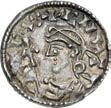
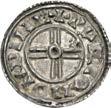


1048. ANGLO-SAXON, Kings of All England. Cnut. 1016-1035. AR Penny (18mm, 1.15 g, 12h). Short Cross type (BMC xvi, Hild. H). Winchester mint; Wulfnoth, moneyer. Struck circa 1029-1035. Diademed and draped bust left; scepter to left / ม ዩ⎍⌦n∂ T ∂n ዩዢnü , voided short cross; annulet at center. Harvey 1334 (dies B/b); SCBI 15 (Copenhagen), 4205-6 (same dies); North 790; SCBC 1159. Old cabinet toning, some die wear. Good VF. ($400)
Ex Classical Numismatic Group inventory 828452 (November 2008); M.J. Grover (Dix Noonan Webb 79, 24 September 2008), lot 3427.
1049. ANGLO-SAXON, Kings of All England. Cnut. 1016-1035. AR Penny (18mm, 1.11 g, 5h). Short Cross type (BMC xvi, Hild. H). York mint; Crucan, moneyer. Struck circa 1029-1035. Diademed and draped bust left; scepter to left / ม üʼ⎍ü©n ɭn ዞɭ Ḧ , voided short cross; annulet at center. SCBI 13 (Copenhagen), 590-1 (same rev. die); North 790; SCBC 1159. Rich iridescent toning. Good VF. ($400)
Ex Dave Hess FPL 3-68 (March 1968), no. 303c.

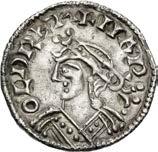
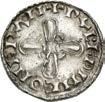
1050. ANGLO-SAXON, Kings of All England. Harold I Harefoot. 1035-1040. AR Penny (17mm, 1.12 g, 3h).
Jewel Cross type (BMC i, Hild. A). Cambridge mint; Wulfwine, moneyer. Struck 1035-circa 1038. Diademed bust left / ม ዩ⎍⌦/ዟዩዢnዞ ɭn űʼ©n , cross composed of four ovals united at base by two concentric circles enclosing a pellet. SCBI 40 (Stockholm), 134 (same dies); North 802; SCBC 1163. Golden toning, some porosity, crimped. Good VF. ($750)
Purchased from J. Linzalone, 9 January 2009. Ex T.L. Taylor (Baldwin’s 57, 24 September 2008), lot 367.
Harold I Harefoot, son of Cnut the Great and his first wife Aelgifu of Northampton, was acclaimed King by the Anglo-Danish nobility headed by Godwin, Earl of Wessex in 1037. Harthacnut was too preoccupied battling Magnus the Good of Norway to secure his claim to the English throne until the premature death of Harold Harefoot in 1040. Harold’s pennies (with two successive types) were minted for a period of three years.
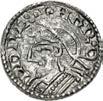


1051. ANGLO-SAXON, Kings of All England. Harold I Harefoot. 1035-1040. AR Penny (17mm, 0.98 g, 8h). Jewel Cross type (BMC i, Hild. A). Dover mint; Boga, moneyer. Struck 1035-circa 1038. Diademed bust left / ม ዛɭű© ɭ ó ዝɭዟʼ©ዢn , cross composed of four ovals united at base by two concentric circles enclosing a pellet. SCBI 40 (Stockholm), 194 (same dies); North 802; SCBC 1163. Porous. Good VF. Distinct large bust. Rare. ($750) Ex Classical Numismatic Group inventory 713526 (June 1999); William J. Conte Collection.


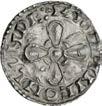

1052. ANGLO-SAXON, Kings of All England. Harold I Harefoot. 1035-1040. AR Penny (17mm, 1.07 g, 3h). Jewel Cross type (BMC i, Hild. A). London mint; Godwine, moneyer. Struck 1035-circa 1038. Diademed bust left / ม űɭዝዩዢnዞ ɭn ⌦⎍nዝዞ Ḧ , cross composed of four ovals united at base by two concentric circles enclosing a pellet. SCBI 40 (Stockholm), 426 (same dies); North 802; SCBC 1163. Toned, a few peck marks, slightly wavy. VF. ($750) Ex Allen F. Lovejoy (Stack’s, 2 December 1997), lot 1445. Reportedly ex Dolman (H. Spencer, with Sotheby’s, 1 June 1978).




1053. ANGLO-SAXON, Kings of All England. Harold I Harefoot. 1035-1040. AR Penny (19mm, 0.98 g, 12h). Fleurde-lis type (BMC vc, Hild. B). Hertford mint; Deorsige, moneyer. Struck circa 1038-1040. Diademed bust left; shield and lis-tipped scepter to left / ม ዝģ Ḧ ɭʼ˫ዢ ű ɭ H ዞʼ˶ , voided long cross; pellet in circle in center, fleur-de-lis (flanked by pellets) in angles. SCBI 40 (Stockholm), 876 (same dies); North 803; SCBC 1165. Toned. VF. Rare. ($1000)
Purchased from J. Linzalone, 8 January 2009. Ex Baldwin’s 57 (24 September 2008), lot 374.


1054. ANGLO-SAXON, Kings of All England. Harold I Harefoot. 1035-1040. AR Penny (18mm, 0.90 g, 12h). Fleurde-lis type (BMC vc, Hild. B). Norwich mint; Man, moneyer. Struck circa 1038-1040. Diademed bust left; shield and listipped scepter to left / ม ዦ¥n ዢዢ¥ ɭn nɭʼ T, voided long cross; pellet in circle in center, fleur-de-lis (flanked by pellets) in angles. SCBI 40 (Stockholm), 1264 (same dies); North 803; SCBC 1165. Old cabinet toning, weak in parts, a few pecks. Good VF. ($600)
Ex Seaby Coin & Medal Bulletin 673 (September 1974), no. 4484; W. F. Rose (Glendining’s, 13 March 1974), lot 137; H.A. Parsons Collection (not in Glendining sale).
Ex Drabble & P.W.P.


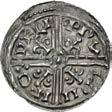

1055. ANGLO-SAXON, Kings of All England. Harold I Harefoot. 1035-1040. AR Penny (18mm, 1.04 g, 6h). Fleur-de-lis type (BMC vc, Hild. B). Wallingford mint; Wulfwine, moneyer. Struck circa 1038-1040. Diademed bust left; shield and lis-tipped scepter to left / ม ዩ⎍
, voided long cross; pellet in circle in center, fleur-de-lis (flanked by pellets) in angles. W&W 167 = SCBI 40 (Stockholm), 1432 (same dies); North 803; SCBC 1165. Some porosity under tone. VF. ($1000)
Purchased from Stack’s, October 1995. Ex G.C. Drabble (Part II, Glendining, 13 December 1943), lot 875; P.W.P. Carlyon-Britton (Part III, Sotheby, Wilkinson, & Hodge, 11 November 1918), lot 1766.




1056. ANGLO-SAXON, Kings of All England. Harold I Harefoot. 1035-1040. AR Penny (19mm, 1.12 g, 6h). Arm and Scepter type (BMC ii, Hild. B). Oxford mint; Godwine, moneyer. Struck 1040-1042. Diademed bust left, holding trefoiltipped scepter / ม
, quadrilateral, with pellet in center and angles, over voided short cross. Stainer 10; SCBI 40 (Stockholm), 1700 (same rev. die); North 811; SCBC 1168. Toned, a few peck marks, internal flan crack and perforation. VF. Very rare. ($1000)
Purchased from Spink, 9 December 1977.



1057. ANGLO-SAXON, Kings of All England. Edward the Confessor. 1042-1066. AR Penny (17mm, 1.16 g, 3h). Pacx type (BMC iv, Hild. D). Exeter mint; Leofwine, moneyer. Struck 1042-circa 1044. Diademed bust left; quatrefoil-tipped scepter to left / ม ⌦ዞ Ḧ ɭዟዩ / ዢnዞ ɭ ዞü , voided long cross with crescent at ends and pellet at center; ዩ a ü ҟ in quarters. Pagan, Pacx 77.1 (dies B/a; this coin); Freeman 91 (this coin cited); SCBI –; North 813; SCBC 1172. Old cabinet toning. VF. ($600)
Purchased from J. King, 3 November 1977. Ex Spink Numismatic Circular LXXXV.11 (November 1977), no. 11463; Spink Numismatic Circular LXXXIV.6 (June 1976), no. 4715; Spnk Numismatic Circular LXXXI.12 (December 1973), no. 9895; R.P.V. Brettell (Glendining, 28 October 1970), lot 210; R.C. Lockett (Part III, 4 November 1958), lot 2809 (part of); H.M. Reynolds (Sotheby, Wilkinson, & Hodge, 4 May 1914), lot 73 (part of).
Edward the Confessor, the son of Aethelred II and Emma, grew up an exile at the Norman court and was more inclined to the life of a monk rather than a king. The English nobility headed by Harold Godwinson, Earl of Wessex, invited him to assume the throne because they feared Magnus the Good of Norway would assert his claim at the head of a Viking fleet. The pennies of Edward’s long and troubled reign carry an imaginative range of types.
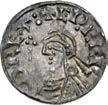

1058. ANGLO-SAXON, Kings of All England. Edward the Confessor. 1042-1066. AR Penny (18mm, 0.96 g, 3h). Pacx type (BMC iv, Hild. D). London mint; Wulfstan, moneyer. Struck 1042-circa 1044. Diademed bust left; quatrefoil-tipped scepter to left / ม ዩ/⎍ ⌦⎄Ϳ Ḧ ɭ n ⌦⎍ , voided long cross with crescent at ends and pellet at center; ዩ a ü ҟ in quarters. Pagan, Pacx 330.1 (dies G/g; this coin); Freeman 771; SCBI 18 (Copenhagen), 1102 var. (rev. legend); North 813; SCBC 1172. Toned with some luster, minor flan flaws on reverse. Good VF. ($600)
Purchased from J. Linzalone. Ex L. Stack (Sotheby’s, 22 April 1999), lot 564.
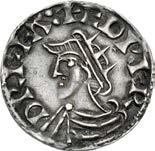
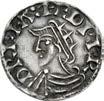
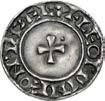

1059. ANGLO-SAXON, Kings of All England. Edward the Confessor. 1042-1066. AR Penny (17mm, 0.93 g, 5h). Radiate/Small Cross (BMC i, Hild. A). Aylesbury mint; Leofwine, moneyer. Struck circa 1044-1046. Radiate and draped bust left / ม ⌦ዞɭዟዩዢnዞ ɭn ® űዞ⌦ /Ḧ , short cross pattée; pellet in second quarter. Freeman 12; SCBI 30 (American), 561 (this coin); North 816; SCBC 1173. Toned. Good VF. Extremely rare mint. ($500)
Purchased from J. Linzalone. Ex L. Stack (Sotheby’s, 22 April 1999), lot 566; E.M. Norweb (Part IV, 17 June 1987), lot 1249; F. Elmore-Jones (Glendining, 12 May 1971), lot 62; Lord Grantley (Part III, Glendining, 22 March 1944), lot 1184 (part of).

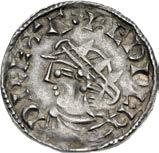

1060. ANGLO-SAXON, Kings of All England. Edward the Confessor. 1042-1066. AR Penny (17mm, 1.12 g, 6h). Radiate/Small Cross (BMC i, Hild. A). Canterbury mint; Leofwine, moneyer. Struck circa 1044-1046. Radiate and draped bust left / ม ⌦ዞɭዟዩዢnዞዞ ɭn üዞn , short cross pattée. Freeman 112; SCBI –; North 816; SCBC 1173. Old cabinet toning. VF. ($500)
Purchased from J. King, 5 May 1976.




1061. ANGLO-SAXON, Kings of All England. Edward the Confessor. 1042-1066. AR Penny (18mm, 1.10 g, 4h). Radiate/Small Cross (BMC i, Hild. A). Lewes mint; Osweald, moneyer. Struck circa 1044-1046. Radiate and draped bust left / ม ɭ˨ዩɭ⌦ዝ ɭn ⌦ ® ዩዞ , short cross pattée. King 213 (this coin); Freeman 122 (this coin cited); SCBI 54 (Stockholm), 431; North 816; SCBC 1173. Minor marks under tone. VF. Rare. ($500)
Ex Spink Numismatic Circular CVII.3 (April 1999), no. 1331; R.J. Eaglen (Baldwin’s 18, 13 October 1998), lot 1424; Sussex Mints Collection (Glendining, 14 October 1985), lot 136; H. King; F.A. Walters (Sotheby, Wilkinson, & Hodge, 26 May 1913), lot 36.
1062. ANGLO-SAXON, Kings of All England. Edward the Confessor. 1042-1066. AR Penny (19mm, 1.00 g, 12h). Trefoil Quadrilateral type (BMC iii, Hild. C). Lincoln mint; Eadric, moneyer. Struck circa 1046-1048. Diademed and draped bust left; scepter pommée to left / ม ዞዝʼዢü ɭn ⌦ዢnüɭ , quadrilateral, with pellet in center and trefoils at angles, over voided short cross. Mossop pl. LXX, 13 (dies B/b); Freeman 123; SCBI 27 (Lincolnshire), 621 (same dies); North 817; SCBC 1174. Old cabinet toning. Good VF. ($600)
Purchased from J. King, 1 April 1976.



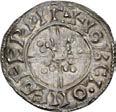
1063. ANGLO-SAXON, Kings of All England. Edward the Confessor. 1042-1066. AR Penny (19mm, 1.11 g, 1h). Trefoil Quadrilateral type (BMC iii, Hild. C). Winchester mint; Leofing, moneyer. Struck circa 1046-1048. Diademed and draped bust left; scepter pommée to left / ม ⌦ዢዟዢnüü ɭn ዩዢnüዞ , quadrilateral, with pellet in center and trefoils at angles, over voided short cross. Harvey 1553 var. (dies –/c; unlisted obv. die); Freeman 233; cf. SCBI 20 (Mack), 1147 (for type); North 817; SCBC 1174. Toned, wavy flan, peck marks. VF. An interestingly shaped voided cross at center of reverse. ($500)
Purchased from A.G. & S. Gilles, 20 November 2000.
1064. ANGLO-SAXON, Kings of All England. Edward the Confessor. 1042-1066. AR Penny (19mm, 1.13 g, 6h). Trefoil Quadrilateral type (BMC iii, Hild. C). York mint; Ioketill, moneyer. Struck circa 1046-1048. Diademed and draped bust left; scepter pommée to left / ม ዢɭkዞ⌦ ɭn ዞɭዟዞʼዩዢü , quadrilateral, with pellet in center and trefoils at angles, over voided short cross. Freeman 173; SCBI 21 (Yorkshire), 244 (same dies); North 817; SCBC 1174. Toned, bluntly struck. VF. ($400)
Ex Davissons 11 (23 June 1999), lot 232.



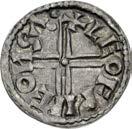
1065. ANGLO-SAXON, Kings of All England. Edward the Confessor. 1042-1066. AR Penny (14mm, 1.00 g, 3h). Small Flan type (BMC ii, Hild. B). Sandwich mint; Leofwine, moneyer. Struck circa 1048-1050. Diademed and draped bust left / ม ⌦ዞɭዟዩዢɉ
, voided short cross with pellet at center. Freeman 16; SCBI 20 (Mack), 1169 (same dies); North 818; SCBC 1175. Toned. Good VF. ($500)
Ex Classical Numismatic Group 54 (14 June 2000), lot 2106.




1066. ANGLO-SAXON, Kings of All England. Edward the Confessor. 1042-1066. AR Penny (14mm, 1.19 g, 9h). Small Flan type (BMC ii, Hild. B). Thetford mint; Ælfsige, moneyer. Struck circa 1048-1050. Diademed and draped bust left / ม ® ⌦Ӳዢűዞ ɭn T ዞ˸ , voided short cross with pellet at center. Freeman 4 (this coin cited); SCBI 20 (Mack), 1170 (this coin); North 818; SCBC 1175. Toned, die breaks. Good VF. ($500)
Ex Triton I (2 December 1997), lot 2237; R.P. Mack Collection; Duke of Argyll Collection; Lord Grantley (Part III, Glendining, 22 March 1944), lot 1192 (part of).
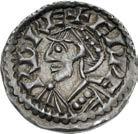



1067. ANGLO-SAXON, Kings of All England. Edward the Confessor. 1042-1066. AR Penny (15mm, 1.22 g, 1h). Small Flan type (BMC iia, Hild. B var.). York mint; Arngrimr, moneyer. Struck circa 1048-1050. Diademed and draped bust left / ม
é ʼዢዦ ɭn ዞɭ , voided short cross with pellet at center; annulet in second quarter. Freeman 54; SCBI 1 (Fitzwilliam), 855 (same dies); North 818; SCBC 1175. Toned. Good VF. ($500)
Ex Spink Numismatic Circular LXXXIV.9 (September 1976), no. 6932; Duke of Argyll Collection; Lord Grantley (Part III, Glendining, 22 March 1944), lot 1193 (part of).




1068. ANGLO-SAXON, Kings of All England. Edward the Confessor. 1042-1066. AR Penny (19mm, 1.12 g, 10h). Expanding Cross type, light issue (BMC v, Hild. E). Lewes mint; Ælfsige, moneyer. Struck circa 1050-1053. Diademed bust left; scepter to left / ม ® ⌦ዟ/˨ዢዞ ɭn ⌦ ® ዩዞዞ Ḧ , voided short cross with expanding limbs; at center, circle around pellet-incircle. King 227; Freeman 5 (this coin cited); SCBI 42 (South-Eastern), 1192-3 (same dies); North 820; SCBC 1176. Toned, some hard green. VF. ($600)
Ex L. Stack (Sotheby’s, 22 April 1999), lot 573; R.C. Lockett (Part I, Glendining, 6 June 1955), lot 816 (part of).
1069. ANGLO-SAXON, Kings of All England. Edward the Confessor. 1042-1066. AR Penny (20mm, 1.75 g, 6h). Expanding Cross type, heavy issue (BMC v, Hild. E). Lincoln mint; Authgrimr, moneyer. Struck circa 1050-1053. Diademed bust left; scepter to left / ม ɭዝűʼዢዦ ɭn ⌦ዢnü , voided short cross with expanding limbs; at center, circle around pellet-incircle. Mossop pl. LXXV, 3 (dies D/f); Freeman 235; SCBI 27 (Lincolnshire), 703 (same dies); North 823; SCBC 1177. Iridescent toning, weak in part. VF. ($500)
Ex Coin Galleries (5 November 1997), lot 1904.
Ex P. Carlyon-Britton


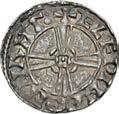
1070. ANGLO-SAXON, Kings of All England. Edward the Confessor. 1042-1066. AR Penny (19mm, 1.71 g, 4h). Expanding Cross type, heavy issue (BMC v, Hild. E). Northampton mint; Ælfwine, moneyer. Struck circa 1050-1053. Diademed bust left; scepter to left / ม
, voided short cross with expanding limbs; at center, circle around pellet-in-circle. Freeman 5 (this coin cited); SCBI 20 (Mack), 1197 (this coin); North 823; SCBC 1177. Slight roughness under iridescent toning. Good VF. ($600)
Ex Davissons 13 (2 May 2000), lot 186; Seaby Coin & Medal Bulletin 711 (November 1977), no. E1158; R.P. Mack Collection (Part I, Glendining, 18 November 1975), lot 193, purchased from Spink, 1959; P.W.P. Carlyon-Britton (Part II, Sotheby, Wilkinson & Hodge, 20 November 1916), lot 1128a (illustrated).


1071. ANGLO-SAXON, Kings of All England. Edward the Confessor. 1042-1066. AR Penny (20mm, 1.67 g, 12h). Expanding Cross type, heavy issue (BMC v, Hild. E). London mint; Leofsige, moneyer. Struck circa 1050-1053. Diademed bust left; scepter to left / ม ⌦ዞɭዟSዢዞ ɭn ⌦⎍nዝዞnዞ , voided short cross with expanding limbs; at center, circle around pelletin-circle. Freeman 565; SCBI 54 (Stockholm), 1175 (same dies); North 823; SCBC 1177. Richly toned. VF. ($500)
Purchased from R.C. Becker, 25 February 1977.




1072. ANGLO-SAXON, Kings of All England. Edward the Confessor. 1042-1066. AR Penny (20mm, 1.63 g, 6h).
Expanding Cross type, heavy issue (BMC v, Hild. E). Wilton mint; Ælfweald, moneyer. Struck circa 1050-1053. Diademed bust left; scepter to left / ม ® ⌦ዟዩɭ⌦ዝ ɭn ዩዢ⌦Ϳ⎍nዞ , voided short cross with expanding limbs; at center, circle around pellet-in-circle. Shortt –; Freeman 35; SCBI 20 (Mack), 1183 var. (rev. legend); North 823; SCBC 1177. Toned with some iridescence. Good VF. ($600)
Ex Coin Galleries (14 April 1999), lot 1235.
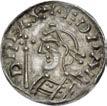



1073. ANGLO-SAXON, Kings of All England. Edward the Confessor. 1042-1066. AR Penny (18mm, 1.21 g, 9h).
Expanding Cross type, light issue (BMC va, Hild. E var.). York mint; Arngrimr, moneyer. Struck circa 1050-1053. Diademed bust left; scepter to left / ม ¥ʼnűʼዢዦ ɭn ዞɭዟ , voided short cross with expanding limbs; at center, circle around pellet-incircle; annulet in third quarter. Freeman 55 (this coin cited); SCBI 18 (Copenhagen), 825 (same dies); North 820; SCBC 1176. Toned. Good VF. ($600)
Ex Spink Numismatic Circular LXXXVI.5 (May 1978), no. 6358.
1074. ANGLO-SAXON, Kings of All England. Edward the Confessor. 1042-1066. AR Penny (18mm, 1.19 g, 12h). Expanding Cross type, light issue (BMC va, Hild. E var.). York mint; Arnketill, moneyer. Struck circa 1050-1053. Diademed bust left; scepter to left / ม ¥ʼüዢ⌦ ɭn ዞɭዟዞʼ / , voided short cross with expanding limbs; at center, circle around pelletin-circle; annulet in first quarter. Freeman 45; cf. SCBI 18 (Copenhagen), 820 (for type); North 820; SCBC 1176. Iridescent toning. Good VF. ($600)
Ex L. Stack (Sotheby’s, 22 April 1999), lot 574.



1075. ANGLO-SAXON, Kings of All England. Edward the Confessor. 1042-1066. AR Penny (20mm, 1.41 g, 6h). Pointed Helmet type (BMC vii, Hild. F). Bedford mint; Wulfwig, moneyer. Struck circa 1053-1056. Bust right, wearing pointed helmet and holding scepter pattée / ม ዩ⎍⌦ዩዢ ɭn [ ዛዞ ] ዝዞዟɭʼ , voided short cross with pellet-in-annulet at center and triple crescents at each end. Freeman 86 (this coin cited); SCBI –; North 825; SCBC 1179. Toned, slightly wavy, areas of weak strike. VF. Very rare mint and moneyer. One of only two known to Freeman, with no additional examples in SCBI or in CoinArchives. ($750)
Ex Spink Numismatic Circular CVII.3 (April 1999), no. 1334; R.J. Eaglen (Baldwin’s 18, 13 October 1998), lot 1345; R.C. Lockett (Part I, Glendining, 6 June 1955), lot 822 (part of).



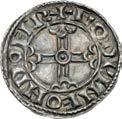
1076. ANGLO-SAXON, Kings of All England. Edward the Confessor. 1042-1066. AR Penny (20mm, 1.25 g, 9h). Pointed Helmet type (BMC vii, Hild. Fb). Cambridge mint; Ælfwig, moneyer. Struck circa 1053-1056. Bust right, wearing pointed helmet and holding scepter fleury / ม ® ⌦ዟዩዢዢ ɭn űʼ²nͿዞዞ , voided short cross with pellet-in-annulet at center and triple crescents at each end. Freeman 6 (this coin cited); SCBI 1 (Fitzwilliam), 875 (same dies); North 825; SCBC 1179. Toned. VF. ($500)
Purchased from York Coins, 19 October 2009. Ex K.A. Jacob (Baldwin’s 7, 2 May 1996), lot 439, purchased from Spink, December 1963 R.C. Lockett (Part I, Glendining, 6 June 1955), lot 822 (part of).
1077. ANGLO-SAXON, Kings of All England. Edward the Confessor. 1042-1066. AR Penny (19mm, 1.16 g, 11h). Pointed Helmet type (BMC vii, Hild. F). Dover mint; Godwine, moneyer. Struck circa 1053-1056. Bust right, wearing pointed helmet and holding scepter pattée / ม űɭዝዩዢnዞ
, voided short cross with pellet-in-annulet at center and triple crescents at each end. Freeman 56 (this coin cited); SCBI 42 (South-Eastern), 1264 var. (rev legend; same obv. die); North 825; SCBC 1179. Iridescent toning, double struck, a few minor green deposits. Good VF. ($500)
Purchased from Spink, 3 July 2000. Ex R.J. Eaglen (Baldwin’s 18, 13 October 1998), lot 1394; F. Elmore-Jones (Glendining, 12 May 1971), lot 271; R.C. Lockett (Part I, Glendining, 6 June 1955), lot 824 (part of).


1078. ANGLO-SAXON, Kings of All England. Edward the Confessor. 1042-1066. AR Penny (19mm, 1.39 g, 5h). Pointed Helmet type (BMC vii, Hild. F). Lewes mint; Eadwine, moneyer. Struck circa 1053-1056. Bust right, wearing pointed helmet and holding scepter fleury / ม ዞዝዩዢnዞ
, voided short cross with pellet-in-annulet at center and triple crescents at each end. King 239; Freeman 66; cf. SCBI 42 (South-Eastern), 1288 var. (scepter tip, legends); North 825; SCBC 1179. A few die breaks. Toned, traces of red wax. Good VF. ($500)
Purchased from J. Linzalone, 19 December 1979.
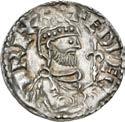


1079. ANGLO-SAXON, Kings of All England. Edward the Confessor. 1042-1066. AR Penny (20mm, 1.37 g, 3h). Pointed Helmet type (BMC vii, Hild. F). Winchester mint; Leofing, moneyer. Struck circa 1053-1056. Bust right, wearing pointed helmet and holding scepter fleury / ม ⌦ዢዟዢnű ɭn
, voided short cross with pellet-in-annulet at center and triple crescents at each end. Harvey 1701 (dies B/b); Freeman 236; SCBI 20 (Mack), 1226 (same dies); North 825; SCBC 1179. Light iridescent toning. Good VF. ($500)
Purchased from J. King, 3 March 1976.

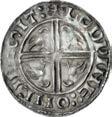
1080. ANGLO-SAXON, Kings of All England. Edward the Confessor. 1042-1066. AR Penny (19mm, 1.35 g, 3h). Sovereign/Eagles type (BMC ix, Hild. H). Chichester mint; Godwine, moneyer. Struck circa 1056-1059. Edward seated facing on throne, holding scepter and globus cruciger / ม
, voided cross, with martlet in each quarter. King 110; Freeman 17; SCBI 42 (South-Eastern), 1352 (same dies); North 827; SCBC 1181. Toned, wear in part. Good VF. ($500)
Purchased from J. Linzalone, June 1980. 1076 1077


1081. ANGLO-SAXON, Kings of All England. Edward the Confessor. 1042-1066. AR Penny (20mm, 1.28 g, 12h). Sovereign/Eagles type (BMC ix, Hild. H). Hastings mint; Dunning, moneyer. Struck circa 1056-1059. Edward seated facing on throne, holding scepter and globus cruciger / ม ዝ⎍ɃɃዢɃü ɭɃɃ H ® ⎄ / , voided cross, with martlet in each quarter. King 118; Freeman 37 (this coin cited); SCBI 20 (Mack), 1232 (same dies); North 827; SCBC 1181. Dusky tone. Good VF. ($500)
Ex Spink 1 (11 October 1978), lot 129.



1082. ANGLO-SAXON, Kings of All England. Edward the Confessor. 1042-1066. AR Penny (20mm, 1.38 g, 12h). Sovereign/ Eagles type (BMC ix, Hild. H). Northampton mint; Wulfnoth, moneyer. Struck circa 1056-1059. Edward seated facing on throne, holding scepter and globus cruciger / ม ዩ⎍⌦nɭ T ɭn H©ዦ Ḧ , voided cross, with martlet in each quarter. Freeman 67 (this coin cited); SCBI 18 (Copenhagen), 4281 (same dies); North 827; SCBC 1181. Toned, Some ghosting. Good VF. ($600)
Ex L. Stack (Sotheby’s, 22 April 1999), lot 589; Ridgemount (Spink 69, 20 April 1989), lot 101; Spink Numismatic Circular LXXXIII.12 (December 1975), no. 11046; F. Elmore-Jones (Glendining, 12 May 1971), lot 610.


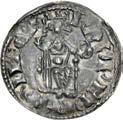
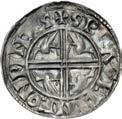
1083. ANGLO-SAXON, Kings of All England. Edward the Confessor. 1042-1066. AR Penny (20mm, 1.25 g, 6h). Sovereign/Eagles type (BMC ix, Hild. H). Southwark mint; Godman, moneyer. Struck circa 1056-1059. Edward seated facing on throne, holding scepter and globus cruciger / ม űɭዝዦ©n ɭn ⎄⎍ T űዞ ḧ , voided cross, with martlet in each quarter. Freeman 57 (this coin cited); SCBI –; North 827; SCBC 1181. Reverse off centre. Slightly wavy flan. Toned. Good VF. Very rare. One of only three known to Freeman, with no further examples in SCBI or in CoinArchives. ($600)
Ex L. Stack (Sotheby’s, 22 April 1999), lot 590; F. Elmore-Jones (Glendining, 12 May 1971), lot 772; R.C. Lockett (Part I, Glendining, 6 June 1955), lot 838 (part of).
1084. ANGLO-SAXON, Kings of All England. Edward the Confessor. 1042-1066. AR Penny (21mm, 1.18 g, 12h). Sovereign/Eagles type (BMC ix, Hild. H). Winchester mint; Spracling, moneyer. Struck circa 1056-1059. Edward seated facing on throne, holding scepter and globus cruciger / ม ⎄ዩʼ©űü⌦ዢnű ɭn ዩዢ ü ዞ⎄ , voided cross, with martlet in each quarter. Harvey 1746a (dies F/f; this coin); Freeman 287; SCBI 42 (South-Eastern), 1408 var. (legends); North 827; SCBC 1181. Toned, with hints of luster, some die wear. Good VF. ($600)
Ex L. Stack (Sotheby’s, 22 April 1999), lot 591; H.A. Parsons Collection (not in Glendining sale).




1085. ANGLO-SAXON, Kings of All England. Edward the Confessor. 1042-1066. AR Penny (20mm, 1.29 g, 1h). Hammer Cross type (BMC xi, Hild. G). Chichester mint; Ælfwine, moneyer. Struck circa 1059-1062. Crowned bust right, scepter before / ม ® ⌦ዟዩዢnዞ ɭn üዢüዞዢ˶ Ḧ , voided cross, arms terminating in inward-facing crescents. King 117; Freeman 9; SCBI 42 (South-Eastern), 1433-5 (same dies); North 828; SCBC 1182. Toned. VF. ($500)
Purchased from J. Linzalone, 19 December 1979.
1086. ANGLO-SAXON, Kings of All England. Edward the Confessor. 1042-1066. AR Penny (19mm, 1.42 g, 9h). Hammer Cross type (BMC xi, Hild. G). Hastings mint; Wulfric, moneyer. Struck circa 1059-1062. Crowned bust right, scepter before / ม ዩ⎍⌦ዟʼዢü ɭn H ® ˞Ϳ , voided cross, arms terminating in inward-facing crescents. King 128; Freeman 68; SCBI 42 (South-Eastern), 1477-87 (same dies); North 828; SCBC 1182. Toned. VF. ($500)
Ex Owl Ltd. FPL III.4 (Winter 1978), no. 147.


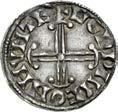
1087. ANGLO-SAXON, Kings of All England. Edward the Confessor. 1042-1066. AR Penny (19mm, 1.38 g, 6h). Hammer Cross type (BMC xi, Hild. G). Huntingdon mint; Godwine, moneyer. Struck circa 1059-1062. Crowned bust right, scepter before / ม űɭዝዩዢnዞ ɭn H⎍nͿዞ , voided cross, arms terminating in inward-facing crescents. Freeman 38 (this coin cited); SCBI 20 (Mack), 1249 (this coin); North 828; SCBC 1182. Toned. Good VF. Rare. ($600) Ex Vecchi 13 (4 September 1998), lot 1677; R.P. Mack (Part I, Glendining, 18 November 1975), lot 207, purchased from Baldwin’s, 1954.


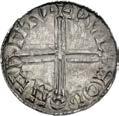
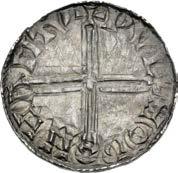
1088. ANGLO-SAXON, Kings of All England. Edward the Confessor. 1042-1066. AR Penny (19.5mm, 1.24 g, 3h). Hammer Cross type (BMC xib, Hild. G var.). Northampton mint; Wulfnoth, moneyer. Struck circa 1059-1062. Crowned bust right, scepter before / ม ዩ⎍⌦ዟnɭዝ ɭn H²ዦͿ⎍ , voided cross. Freeman 68; SCBI 11 (Reading), 169 (same dies); BMC 530; North 829; SCBC 1182 var. (rev. cross). Toned, some light scratches under tone, double struck on reverse. VF. Extremely rare voided cross reverse: one of only five known. ($750)
Purchased from J. Linzalone, 2010. Ex Spink 204 (30 September 2010), lot 216; Classical Numismatic Group inventory 732843 (May 2003); W.J. Conte Collection; P. Finn FPL (Winter 1994/5), no. 63.

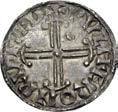
1089. ANGLO-SAXON, Kings of All England. Edward the Confessor. 1042-1066. AR Penny (19mm, 1.32 g, 6h). Hammer Cross type (BMC xi, Hild. G). Romney mint; Wulfmær, moneyer. Struck circa 1059-1062. Crowned bust right, scepter before / ม ዩ⎍⌦ዦ ® ʼ ɭn ʼ⎍ዦዞዝ , voided cross, arms terminating in inward-facing crescents; pellet in second quarter. Freeman 8 (this coin cited); SCBI 42 (South-Eastern), 1528 var. (extra pellet; same dies in earlier state); North 828; SCBC 1182. Toned. Good VF. ($750)
Purchased from J. Linzalone, 13 April 1999. Ex J. Linzalone Collection (Stack’s, 7 December 1994), lot 2375; R.C. Lockett (Part IV, Glendining, 26 April 1960), lot 3817 (part of); P. Carlyon-Britton (Sotheby, Wilkinson, & Hodge, 20 November 1916), lot 1159 (part of).




1090. ANGLO-SAXON, Kings of All England. Edward the Confessor. 1042-1066. AR Penny (20mm, 1.32 g, 12h). Hammer Cross type (BMC xi, Hild. G). Steyning mint; Deorman, moneyer. Struck circa 1059-1062. Crowned bust right, scepter before / ม ዝዢɭʼዦ©n ɭn ˞Ϳ ® nዢű , voided cross, arms terminating in inward-facing crescents. King 35; Freeman 8; SCBI 42 (South-Eastern), 1539 (same dies); North 828; SCBC 1182. Toned. VF. ($500)
Purchased from J. Linzalone, October 1979.
1091. ANGLO-SAXON, Kings of All England. Edward the Confessor. 1042-1066. AR Penny (20mm, 1.37 g, 4h). Hammer Cross type (BMC xia, Hild. G var.). York mint; Ulfketill, moneyer. Struck circa 1059-1062. Crowned bust right, scepter before / ม ⎍⌦ዟüͿዞ⌦ ɭn ዞɭዟʼ , voided cross, arms terminating in inward-facing crescents; annulet in fourth quarter. Freeman 408; SCBI 21 (Yorkshire), 486 (same rev. die); North 828; SCBC 1182. Some die wear. Minor deposits. Good VF. ($400)
Ex Classical Numismatic Group inventory 724608 (February 2001); W.J. Conte Collection. A gift to Sidney from his son Kenneth.

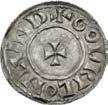
1092. ANGLO-SAXON, Kings of All England. Edward the Confessor. 1042-1066. AR Penny (18mm, 0.91 g, 3h).
Facing Bust/Small Cross type (BMC xiii, Hild. Ac). London mint; Godric, moneyer. Struck circa 1062-1065. Crowned facing bust / ม Żɭዝʼዢü ɭn ⌦⎍nዝ , small cross pattée. Freeman 488; SCBI 9 (Ashmolean), 1027 (same dies); North 830; SCBC 1183. Toned. Good VF. ($500)
Ex Owl Ltd. FPL III.4 (Winter 1978), no. 148.



1093. ANGLO-SAXON, Kings of All England. Edward the Confessor. 1042-1066. AR Penny (17mm, 0.98 g, 9h).
Facing Bust/Small Cross type (BMC xiii, Hild. Ac). Romney mint; Wulmær, moneyer. Struck circa 1062-1065. Crowned facing bust / ม ዩ⎍⌦ዦ ® ʼ ɭn ʼ⎍ዦዞዝ , small cross pattée. Freeman 9 (this coin cited); SCBI 20 (Mack), 1294 (same dies); North 830; SCBC 1183. Toned, some die wear. Good VF. Rare. ($750)
Ex J. Jordan (Classical Numismatic Group 49, 17 March 1999), lot 2222; G.V. Doubleday (Glendining, 6 October 1987), lot 433; R.C. Lockett (Part I, Glendining, 6 June 1955), lot 855 (part of).
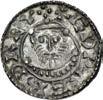

1094. ANGLO-SAXON, Kings of All England. Edward the Confessor. 1042-1066. AR Penny (17mm, 1.10 g, 2h).
Facing Bust/Small Cross type (BMC xiiia, Hild. Ac var.). York mint; Thorr, moneyer. Struck circa 1062-1065. Crowned facing bust / ม T ɭʼʼ ɭn ዞɭዟዞʼዩዢ , small cross pattée; annulet in first quarter. Freeman 389; SCBI 9 (Ashmolean), 1059 (same dies); North 830 var. (annulet on rev.); SCBC 1183 var. (same). Toned, some deposits. Good VF. ($500)
Ex Davissons 10 (30 April 1998), lot 180.



1095. ANGLO-SAXON, Kings of All England. Edward the Confessor. 1042-1066. AR Penny (19mm, 1.35 g, 12h). Pyramids type (BMC xv, Hild. I). Canterbury mint; Ælfweard, moneyer. Struck circa 1065-1066. Crowned bust right; scepter before / ม ® ⌦ዟዩaʼዝ ɭn üan , voided cross with annulet in center; pyramids in quarters. Freeman 40 (this coin cited); SCBI 42 (South-Eastern), 1642 (same dies); North 831; SCBC 1184. Toned, off center. Good VF. A striking portait. ($500)
Purchased from Stack’s, 1995. Ex R.C. Lockett (Part III, Glendining, 4 November 1958), lot 2829 (part of).


1096. ANGLO-SAXON, Kings of All England. Edward the Confessor. 1042-1066. AR Penny (18mm, 1.40 g, 11h). Pyramids type (BMC xv, Hild. I). Chester mint; Ealhsige, moneyer. Struck circa 1065-1066. Crowned bust right; scepter before / ม ©⌦ҟҟዢ ɭn ⌦ዞgዞüዞ / , voided cross with annulet in center; pyramids in quarters. Freeman 50; SCBI 5 (Grosvenor), 373 (same dies); North 831; SCBC 1184. Toned, weak in part. Good VF. An unusual rendering of the moneyer’s name. ($500)
Ex Allen F. Lovejoy (Stack’s, 2 December 1997), lot 1448.


1097. ANGLO-SAXON, Kings of All England. Edward the Confessor. 1042-1066. AR Penny (19mm, 1.10 g, 12h). Pyramids type (BMC xv, Hild. I). Thetford mine; Ælfwine, moneyer. Struck circa 1065-1066. Crowned bust right; scepter before / ม ዢዞ⌦ዟዩዢnዞ ɭn T ዞ˸ , voided cross with annulet in center; pyramids in quarters. Freeman 30 (this coin cited); SCBI –; BMC –; North 831; SCBC 1184. Toned, some hard green deposits. Good VF. With official die mark on reverse, as seen on some Hammer Cross types from Thetford. Extremely rare moneyer. The sole example known to Freeman, with no further specimens in SCBI or in CoinArchives. ($500)
Ex Seaby Coin & Medal Bulletin 734 (October 1979), no. E448.

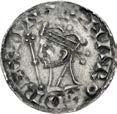

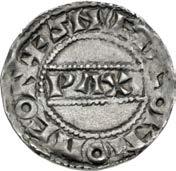
1098. ANGLO-SAXON, Kings of All England. Harold II. 1066. AR Penny (20mm, 1.53 g, 9h). Pax type (BMC i, Hild. A). York mint; Snæbjorn, moneyer. Crowned head left, scepter to left / ม Ӳn ® ዛዞɭʼn ɭn ዞɭn , ዩ © ҟ across central field. SCBI 2 (Hunterian), 1222 (same dies); North 836; SCBC 1186. Toned, slight double strike on obverse. Good VF. Rare. ($2500)
Ex David Hess FPL 10-167 (November 1967), no. 1726.
Harold II Godwinson was the last Anglo-Saxon king of England (January 5-October14, 1066). The reverse type of PAX was a hopeful pledge to his subjects that he could defend England from the two other contenders: Harald Hardrada of Norway and William, the Duke of Normandy. Harold won a decisive victory over Harald Hardrada at Stamford Bridge (September 25, 1066), but risked battle against Duke William too soon and fell at Hastings.

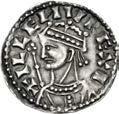
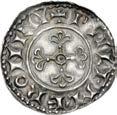

1099. NORMAN. William I ‘the Conqueror’. 1066-1087. AR Penny (20mm, 1.15 g, 9h). Profile/Cross Fleurée (BMC i). Romney mint; Wulfmær, moneyer. Struck 1066-circa 1068. Crowned bust left; scepter to left / ม
, cross fleurée, with pellet-in-annulet at center. SCBI 12 (Ashmolean), 11-7 (same dies); BMC 39-41 (same dies); North 839; SCBC 1250. Toned. Good VF. ($2000)
Ex Classical Numismatic Group inventory 709157 (December 1998); Baldwin’s 18 (13 October 1998), lot 1754; L.E. Bruun (Sotheby, Wilkinson, & Hodge, 18 May 1925), lot 194 (part of).
William the Conqueror, the victor for the throne of England in 1066, maintained the mints and currency of England, which was superior to the deniers of the Norman duchy. Many of the moneyers were of English or Danish origin. The pennies of the Harl Collection are high grade specimens of William’s seven major types, many with provenances and several rare variants.



1100. NORMAN. William I ‘the Conqueror’. 1066-1087. AR Penny (20mm, 1.31 g, 6h). Profile/Cross Fleurée (BMC i). Wilton mint; Owi, moneyer. Struck 1066-circa 1068. Crowned bust left; scepter to left / ม ɭዩዢ ɭn ዩዢ⌦˸⎍n©ዩ , cross fleurée, with pellet-in-annulet at center. SCBI –; BMC 50 (same dies); North 839; SCBC 1250. Toned, mount marks. Good VF. ($750)
Purchased from Charles H. Wolfe, 8 October 1975. Ex R.C. Lockett (Part III, Glendining, 4 November 1958), lot 2841.

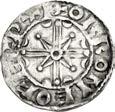


1101. NORMAN. William I ‘the Conqueror’. 1066-1087. AR Penny (19mm, 1.44 g, 5h). Bonnet type (BMC ii). York mint; Thorr, moneyer. Struck circa 1068-1070. Crowned facing bust / ม î ɭʼʼ ɭn ዞɭዟዞʼዩ , voided cross, with annulet at center, pile in each quarter, and pellet-between-crescents at each end. SCBI 21 (Yorkshire), 746-51 (same dies); BMC 178 (same dies?); North 842; SCBC 1251. Toned, slightly double struck. VF. ($750)
Ex Davissons 10 (30 April 1998), lot 181.
1102. NORMAN. William I ‘the Conqueror’. 1066-1087. AR Penny (19mm, 1.28 g, 11h). Canopy type (BMC iii). Hastings mint; Dunning, moneyer. Struck circa 1070-1072. Crowned facing bust within canopy of two columns / ม ዝ⎍nnዢnü ɭn ® S˸ዢn , double quadrilateral, with incurved sides, annulet at center, and fleur at each limb. SCBI –; BMC –; North 843; SCBC 1252. Toned, slight bend, minor edge crack. VF. Rare mint and moneyer. ($750)
Ex Classical Numismatic Group inventory 713515 (November 1999); W.J. Conte Collection.
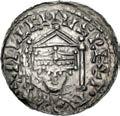
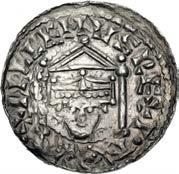
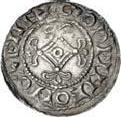
1103. NORMAN. William I ‘the Conqueror’. 1066-1087. AR Penny (19mm, 1.26 g, 5h). Canopy type (BMC iii). Oxford mint; Godwine, moneyer. Struck circa 1070-1072. Crowned facing bust within canopy of two columns / ม gɭዝዩዢnዞ
, double quadrilateral, with incurved sides, annulet at center, and fleur at each limb. Stainer 3; SCBI –; BMC –; North 843; SCBC 1252. Light tone, flip over double strike. VF. Rare. ($750)
Ex Classical Numismatic Group 46 (24 June 1998), lot 1868.

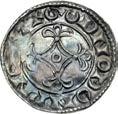
1104. NORMAN. William I ‘the Conqueror’. 1066-1087. AR Penny (19mm, 1.26 g, 2h). Canopy type (BMC iii). Winchester mint; Godnoth, moneyer. Struck circa 1070-1072. Crowned facing bust within canopy of two columns / ม gɭዝnɭ T ɭn ዩዢnüዞ⎄Ϳ , double quadrilateral, with incurved sides, annulet at center, and fleur at each limb. Harvey 1923 (dies A/a); SCBI 42 (South-Eastern), 1741 (same dies); BMC 220 var. (rev. legend); North 843; SCBC 1252. Iridescent toning, area of weak strike. VF. ($750)
Purchased from J. Linzalone, 20 October 2009.


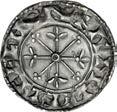

1105. NORMAN. William I ‘the Conqueror’. 1066-1087. AR Penny (19mm, 1.10 g, 10h). Two Scepters type (BMC iv). Sandwich mint; Ælfheah, moneyer. Struck circa 1072-1074. Crowned facing bust; cross-tipped scepter to left, trefoil-tipped scepter to right / ม ® ⌦ዟዞዞH ɭn Sዢዢn , cross fleurée, with annulet at center; all over cross botonnée in saltire. SCBI –; BMC –; North 844; SCBC 1253. Toned, flan crack. VF. Extremely rare and likely unique. ($750)
Ex Triton XI (8 January 2008), lot 1657.


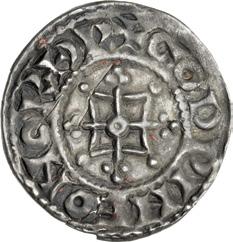
1106. NORMAN. William I ‘the Conqueror’. 1066-1087. AR Penny (20mm, 1.31 g, 9h). Two Stars type (BMC v). Norwich mint; Godwine, moneyer. Struck circa 1074-1077. Crowned facing bust; stars flanking, pellet to left / ม gɭዝዩዢnዞ ɭ nɭʼ T ዩ , cross botonnée with central annulet over quadrilateral with incurved sides. SCBI 20 (Mack), 1383 (this coin); BMC –; North 845; SCBC 1254. Holed and skillfully plugged (evident in the 1913 photo). Some perforations. Toned. VF. ($500)
Purchased from Spink, 10 December 1976. Ex R.P. Mack (Part I, Glendining, 18 November 1975), lot 232; R.C. Lockett (Part III, Glendining, 4 November 1958), lot 2865 (part of); P.W.P. Carlyon-Britton (Part I, Sotheby, Wilkinson, & Hodge, 17 November 1913), lot 709; J.E. Brown (Sotheby, Wilkinson, & Hodge, 14 November 1910), lot 82 (part of).




1107. NORMAN. William I ‘the Conqueror’. 1066-1087. AR Penny (19mm, 1.35 g, 6h). Sword type (BMC vi). Thetford mint; Godric, moneyer. Struck circa 1077-1080. Crowned facing bust, holding sword over right shoulder / ม gɭዝʼዢü ɭn T Ϳዟዢ , cross pattée; all over quadrilateral, with incurved sides and fleur in each quarter. SCBI 54 (Stockholm), 1301 var. (rev. legend); BMC 435 var. (same); North 845; SCBC 1254. Some porosity under light tone. VF. ($750)
Ex Classical Numismatic Review XIX.2 (Second Quarter 1994), no. 434.
1108. NORMAN. William I ‘the Conqueror’. 1066-1087. AR Penny (19mm, 1.06 g, 9h). Profile Right type (BMC vii). London mint; Ælfwine, moneyer. Struck circa 1080-1083. Crowned bust right, holding scepter / ม ዢዞ⌦ዟዩዢɉ
⌦ዢዢዢ , cross pattée, with annulet at center and voided trefoil in each quarter. SCBI 11 (Stockholm), 46; BMC 461; North 847; SCBC 1256. Weak in parts. Some deposits. Good Fine. ($500)
Purchased from J. Linzalone, 6 December 1996.




1109. NORMAN. William I ‘the Conqueror’. 1066-1087. AR Penny (20mm, 1.44 g, 12h). Paxs type (BMC viii). Hereford mint; Æthelwine, moneyer. Struck circa 1083-1086. Crowned facing bust, holding scepter; annulet on right shoulder / ม ዢዞgዞ⌦ዩዢnዞ ɭn Hʼዟ , cross pattée; letters of ዩ a ҟ S in annulets within quarters. SCBI 17 (Midlands), 570-1; BMC 700; North 848; SCBC 1257. Toned, slightly wavy flan. VF. ($750)
Ex J. Jordan (Classical Numismatic Group 49, 17 March 1999), lot 2230; F. Elmore-Jones (Part II, Glendining, 13 April 1983), lot 1047.
1110. NORMAN. William I ‘the Conqueror’. 1066-1087. AR Penny (20mm, 1.39 g, 3h). Paxs type (BMC viii). Romney mint; Wulfmær, moneyer. Struck circa 1083-1086. Crowned facing bust, holding scepter; annulet on right shoulder / ม
ʼዢዦ , cross pattée; letters of ዩ a ҟ S in annulets within quarters. SCBI 20 (Mack), 1442 var. (rev. legend; same obv. die); BMC 879-80 var. (same); North 848; SCBC 1257. Toned. VF. ($750)
Ex J. Jordan (Classical Numismatic Group 49, 17 March 1999), lot 2234; Spink Numismatic Circular LXXXV.9 (September 1977), no. 8296.



1111. NORMAN. William I ‘the Conqueror’. 1066-1087. AR Penny (20mm, 1.83 g, 10h). Paxs type (BMC viii). Sandwich mint; Ælfeah, moneyer. Struck circa 1083-1086. Crowned facing bust, holding scepter; annulet on right shoulder / ม ዢዞዟዩዢnዞ ∂n Sዢዢnዝዩ , cross pattée; letters of ዩ a ҟ S in annulets within quarters. SCBI 20 (Mack), 14444 (same rev. die); BMC 912 (same rev. die); North 848; SCBC 1257. Toned. Good VF. ($750)
Ex J. Jordan (Classical Numismatic Group 49, 17 March 1999), lot 2231.
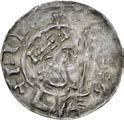
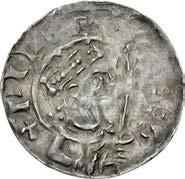

1112. NORMAN. William II Rufus. 1087-1100. AR Penny (20mm, 1.43 g, 12h). Profile type (BMC i). London mint; Eadwig, moneyer. Struck circa 1086-1089. Crowned bust right, holding sword / ม
ɭn ⌦ዢዢn [ ዝnዞn ], cross pattée, with annulet at center; all over cross fleurée in saltire. SCBI 11 (Stockholm), 165 (same dies); BMC 33; North 851; SCBC 1258. Toned, areas of weak strike. VF. Rare. ($1000)
Ex Classical Numismatic Review XVIII.3 (Third Quarter 1993), no. 524.




1113. NORMAN. William II Rufus. 1087-1100. AR Penny (20mm, 1.28 g, 12h). Profile type (BMC i). Worcester mint; Eastmær, moneyer. Struck circa 1086-1089. Crowned bust right, holding sword / ม ዞSͿዦዢዞʼ ɭn ዩዢHʼ , cross pattée, with annulet at center; all over cross fleurée in saltire. Cf. SCBI 17 (Midlands), 640; BMC 64 (same dies); North 851; SCBC 1258. Toned, traces of red wax. VF. Overstruck on a PAXS penny of William I. Extremely rare as such. ($1500)
Purchased from J. Linzalone, 26 May 1998. Ex W.L. Gantz Collection (purchased en bloc by Seaby, 1926); P. Carlyon-Britton (Part II, Sotheby, Wilkinson, & Hodge, 20 November 1916), lot 1285.
William II Rufus, the second son of William I and Queen Matilda of Flanders, succeeded to the throne of England, while his older brother Robert Curthose inherited the Duchy of Normandy. When William died mysteriously in a hunting accident, Henry Beauclerc, the third son of William the Conqueror, seized the throne.
This overstrike of a penny of William I for the new King William II Rufus is an important specimen in determining the sequence of issues of the Norman pennies.

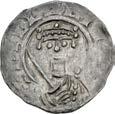

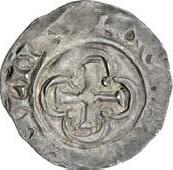
1114. NORMAN. William II Rufus. 1087-1100. AR Penny (19mm, 1.44 g, 9h). Cross in Quatrefoil type (BMC II). London mint; Godwine, moneyer. Struck circa 1089-1092. Crowned facing bust, holding sword / ม gɭዝዩ [
] ɭn ⌦ዢዢn ë, cross pattée within quatrefoil with pellets in angles. SCBI 11 (Stockholm), 703; BMC 113-4; North 852; SCBC 1259. Toned, areas of weak strike. VF. Rare. ($1500)
Purchased from J. Linzalone, 15 March 2009.
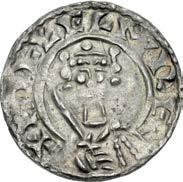



1115. NORMAN. William II Rufus. 1087-1100. AR Penny (20mm, 1.18 g, 6h). Cross in Quatrefoil type (BMC II). Sandwich mint; Alfheah, moneyer. Struck circa 1089-1092. Crowned facing bust, holding sword / ม ዢዞ⌦ዟዞዞH ɭn Sዢዢ ë, cross pattée within quatrefoil with pellets in angles. SCBI –; BMC –; North 852; SCBC 1259. A few light marks under tone. VF. Very rare. This moneyer unknown to Allen for this type. ($1500)
Ex Classical Numismatic Review XXV (Summer/Fall 2000), no. 117.


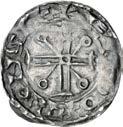

1116. NORMAN. William II Rufus. 1087-1100. AR Penny (21mm, 1.41 g, 6h). Cross Voided type (BMC iii). Salisbury mint; Eadweard, moneyer. Struck circa 1092-1095. Crowned facing bust; stars flanking / ม ® ዝዩɭʼዝ ɭn Sዢዞ , voided cross pattée, with annulet at center; all over cross annulettée. Shortt p. 177; EMC 1300.0026 (same dies); SCBI –; BMC 216 (same obv. die); North 853; SCBC 1260. Toned, minor delamination. VF. Very rare. ($1500)
Ex Triton XI (8 January 2008), lot 1666; W.F. Rose (Glendining, 13 March 1974), lot 199; P. Carlyon-Britton Collection (Part I, Sotheby, Wilkinson & Hodge, November 17, 1913), lot 772.




1117. NORMAN. William II Rufus. 1087-1100. AR Penny (19mm, 1.30 g, 12h). Cross Fleurée and Piles type (BMC v). Lewes mint; Beorhtmær, moneyer. Struck circa 1098-1100. Crowned facing bust, holding scepter; star to right /
, cross fleurée, with pile surmounted by pellet in each quarter. King 320 var. (rev. legend); SCBI –; BMC 266 (same dies); North 856; SCBC 1262. Toned, minor mark. VF. Very rare. ($1500)
Ex Classical Numismatic Group 47 (16 September 1998), lot 2410; Sussex Mints Collection (Glendining, 14 October 1985), lot 175.



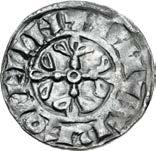
1118. NORMAN. Henry I. 1100-1135. AR Penny (17mm, 1.40 g, 3h). Profile/Cross Fleury type (BMC ii). London mint; Wulfric, moneyer. Struck circa 1102. Crowned bust left; trefoil-tipped scepter to left / ม ዩዢዢ⌦ዟʼü ɭ à ዢዢn , cross fleurée, annulet at center. EMC 2007.0173 = Coin Register 2007, 297 (this coin); SCBI –; BMC –; North 858; SCBC 1263A. Toned. VF. Unique – the only known example of this moneyer for Henry. ($1000)
Purchased from J. Linzalone, 20 October 2009. Found Hereford, Herefordshire, 2007.
Henry I married Matilda of Scotland (Good Queen Maud), who was the granddaughter of Edward Aethling, the son of Edmund Ironside. By this marriage, Henry united the Norman royal family to the house of Wessex. In 1106, at the Battle of Tinchebray (September 28, 1106), Henry defeated his elder brother Duke Robert Curthose and so united the thrones of England and Normandy.

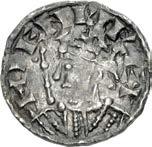

1119. NORMAN. Henry I. 1100-1135. AR Penny (17mm, 1.34 g, 6h). Profile/Cross Fleury type (BMC ii). Southwark mint; Sprot, moneyer. Struck circa 1102. Crowned bust left; trefoil-tipped scepter to left / ม ˨ዩʼɭ˸
, cross fleurée, annulet at center. EMC 1996.0279 = Coin Register 1996, 279 (this coin); SCBI 51 (Estonian), 1155 (same dies); BMC 22 (same dies); North 858; SCBC 1263A. Some die wear. Light porosity. VF. Very rare. ($750)
Purchased from J. Linzalone, 20 October 2009. Found north of Brandon, Suffolk, before September 1991.

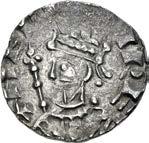

1120. NORMAN. Henry I. 1100-1135. AR Penny (17mm, 1.26 g). Profile/Cross Fleury type (BMC ii). Uncertain mint and moneyer. Struck circa 1102. Crowned bust left; trefoil-tipped scepter to left / [...] ዞʼ , cross fleurée, annulet at center. North 858; SCBC 1263A. Toned, light porosity. VF. ($750)
Ex Triton XI (8 January 2009), lot 1671.

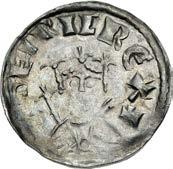

1121. NORMAN. Henry I. 1100-1135. AR Penny (19mm, 1.35 g, 6h). Annulets and Piles type (BMC iv). Winchester mint; Snirweald, moneyer. Struck circa 1105. Crowned facing bust, holding scepter / ม ˨ዢʼዩɭ⌦ዝ ɭ ú ዢ ü, quatrefoil, with annulet at center and within each limb. Harvey –; SCBI –; BMC –; North 860; SCBC 1265. Excellent metal and iridescent toning. VF. Extremely rare. ($1000)
Purchased from J. Linzalone. Ex Baldwin’s 83 (24 September 2013), lot 4314.

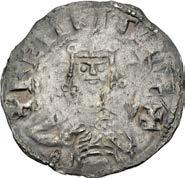

1122. NORMAN. Henry I. 1100-1135. AR Penny (20mm, 1.16 g, 1h). Voided Cross and Fleurs type (BMC v). Winchester mint; Godwine, moneyer. Struck circa 1106. Crowned facing bust, holding scepter / ม gɭዝዩዢnዞ ḧ ɭn ḧ ዩዢnüዞ , voided cross potent, with voided fleur in each quarter. Harvey 2172 var. (unlisted dies); SCBI 20 (Mack), 1517; BMC –; North 861 var. (no stars); SCBC 1266 var. (same). Bent and flattened with associated cracks. Near VF. Extremely rare, especially so for this variety lacking the stars on the obverse. ($750)
Ex Classical Numismatic Review XXIII.2 (Fall/Winter 1998), no. 98.
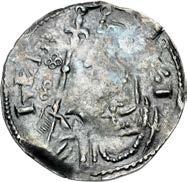



1123. NORMAN. Henry I. 1100-1135. AR Penny (21mm, 1.34 g, 10h). Double Inscription type (BMC xi). London mint; Theodric, moneyer. Struck circa 1115. Crowned and draped bust left, holding cross-tipped scepter; two quatrefoils to left / ม T
ü⎍ / ม S ɭn ⌦⎍n , small cross pattée; quatrefoils-in-annulets in outer legend. EMC 2022.0334; SCBI –; BMC –; North 867; SCBC 1272. Weak in parts. Some light marks. Official edge snick. Near VF. Rare. ($1000)
Purchased from J. Linzalone, 23 November 2010.



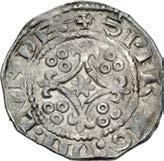
1124. NORMAN. Henry I. 1100-1135. AR Penny (18mm, 1.40 g, 10h). Star in Lozenge Fleury type (BMC xiii). London mint; Sperling, moneyer. Struck circa 1121. Crowned bust left, holding scepter / ม Sዩዞʼ⌦ዢg Ḧ ɭn Ḧ ⌦⎍nዝዞ Ḧ , lozenge with incurved sides; star at center, fleur at each end, and trefoil of annulets in each quarter. SCBI 11 (Stockholm), 287 (same dies); BMC 95 var. (rev. legend); North 869; SCBC 1274. Lightly toned, peck on face. VF. Rare. ($1000)
Purchased from J. Linzalone. Ex Baldwin’s 80 (8 May 2013), lot 2322.


1125. NORMAN. Henry I. 1100-1135. AR Penny (20mm, 1.34 g, 8h). Pellets in Quatrefoil type (BMC xiv). London mint; Ordgar, moneyer. Struck circa 1123. Crowned facing bust, holding scepter; star to right / ม [ ɭʼ ] ዝg¥ʼ Ḧ ɭn Ḧ ⌦⎍nዝ , quatrefoil with central star and three pellets in each limb; lis in each quarter. Allen, Henry 348 (dies F/e; this coin); SCBI 27 (Lincolnshire), 2241 (same obv. die); BMC 145 (same dies); North 870; SCBC 1275. Deep iridescent toning. VF. ($600)
Ex Davissons 6 (29 February 1996), lot 258; G.V. Doubleday (Glendining, 8 June 1988), lot 749. Possibly ex 1901 Bournemouth Hoard.


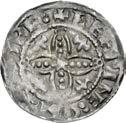
1126. NORMAN. Henry I. 1100-1135. AR Penny (21mm, 1.09 g, 8h). Pellets in Quatrefoil type (BMC xiv). Southwark mint; Leofwine, moneyer. Struck circa 1123. Crowned facing bust, holding scepter; star to right / ม
, quatrefoil with central star and three pellets in each limb; lis in each quarter. Allen, Henry 746 (dies J/k; this coin); SCBI 42 (South-Eastern), 1923 var. (obv. legend); BMC 175 var. (same); North 870; SCBC 1275. Old cabinet toning. VF. Well struck. ($750)
Ex Triton XII (9 January 2009), lot 1131; G.W. de Wit (Künker 137, 11 March 2008), lot 3185, purchased from Spink, 1973.

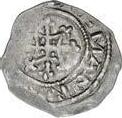


1127. NORMAN. Henry I. 1100-1135. AR Penny (20mm, 1.39 g, 6h). Quadrilateral on Cross Fleurée type (BMC xv). London mint; Dereman R, moneyer. Struck 1125-1135. Crowned bust facing slightly left, holding scepter / [ ม ዝዞʼ ] ዞዦ¥n
[ ɭn
⌦⎍n ], quadrilateral with incurved sides and fleurs at limbs; all over cross fleurée. ESC 1200.0094 (same dies); SCBI –; BMC 244-7 var. (rev. legend); North 871; SCBC 1276. Weak in part. Deeply toned. VF. ($500)
Ex David Hess FPL 8-67 (August 1967), no. 1350.
1128. NORMAN. Stephen. 1135-1154. AR Penny (19mm, 1.37 g, 10h). Cross Moline (‘Watford’) type (BMC i). Thetford mint; Baldwin, moneyer. Struck circa 1136-1145. Crowned bust right, holding lis-tipped scepter / ม ዛ [
˸ዞ˸ዞ , cross moline. Mack 37a; SCBI 26 (East Anglia), 1458 (same dies); BMC 106; North 873; SCBC 1278. Toned, off center. Near VF. ($500)
Purchased from Charles H. Wolfe, 19 August 1975.
Stephen, Count of Blois, and son of the reluctant Crusader and namesake and Adela, the strong-willed daughter of William the Conqueror, seized the English throne upon the death of his uncle Henry I. Stephen, however, was opposed by Henry’s only surviving daughter Matilda, the “Empress” and widow of the Holy Roman Emperor Henry V. The ensuing wars of succession known as the Anarchy (1139-1154) saw the final breakdown of the system of Anglo-Saxon currency as barons asserted regional power and coined in their names. By the Treaty of Wallingford (1154), Stephen recognized as his heir the future Henry II, son of Matilda the Empress and her second husband Count Geoffrey V of Anjou. Upon the death of Stephen (October 25, 1154), Henry II succeeded the English throne.
Pennies of the Plantagenet dynasty in the Harl Collection, including Tealby, Short Cross, and Long Cross types of the reigns of Henry II and Henry III will be offered in a future sale.




1129. NORMAN. Stephen. 1135-1154. AR Penny (18mm, 1.26 g, 10h). Voided Cross and Mullets type (BMC ii). London mint; Rodbert, moneyer. Struck circa 1145-1150. Crowned bust facing slightly left, holding scepter / ม
⌦⎍n , voided cross; mullets in quarters. Mack 61e; SCBI 20 (Mack), 1614; BMC 156; North 878; SCBC 1280. A few scratches under tone. Near VF. ($600)
Purchased from J. Linzalone, 26 August 2010.
1130. NORMAN. Stephen. 1135-1154. AR Penny (20mm, 1.38 g, 6h). Profile/Cross and Piles type (BMC vi). London mint; Alisandre, moneyer. Struck circa 1150-1154. Crowned bust left, holding scepter / ม ¥⌦ዢS¥nዝ Ḧ ɭn Ḧ ⌦⎍ , cross fleurée, with saltire cross at center and piles surmounted by trefoils in each quarter. Mack –; SCBI –; BMC –; North 879; SCBC 1281. Some light marks. Near VF. Very rare. ($750)
Purchased from J. Linzalone, 8 January 2008.
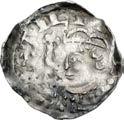

1131. NORMAN. Stephen. 1135-1154. AR Penny (20mm, 1.45 g, 2h). Profile/Cross and Piles type (BMC vi). Norwich mint; Thorr, moneyer. Struck circa 1150-1154. Crowned bust left, holding scepter / ม ˸ƌɭˊ Ḧ ɭn Ḧ [ nɭˊዩ ] ዢ , cross fleurée, with saltire cross at center and piles surmounted by trefoils in each quarter. Mack 91; SCBI 26 (East Anglia), 1461; BMC –; North 879; SCBC 1281. Light earthen deposits. Near VF. Very rare. ($750)
Purchased from J. Linzalone, 26 May 1998.
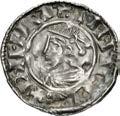
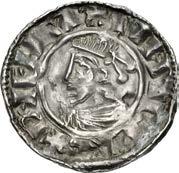

1132. IRELAND, Hiberno-Norse. Sihtric III Olafsson. Circa 995-1036. AR Penny (19mm, 1.14 g, 9h). Phase I coinage, Short Cross type. ‘London’ mint; ‘Dgdoan,’ moneyer. Struck circa 1010-1016. ม
, diademed and draped bust left / ม ዝüዝ ∂ / ¨n∂ ⌦⎍nዝʼ / , small cross pattée. O’S –; SCBI 8 (BM), 55-8; SCBI 22 (Copenhagen), 46-8; SCBI 32 (Ulster), 33; SCBC 6118. Lightly toned, wavy flan, peck marks. Near VF. Very rare. ($1000)
Purchased from J. Linzalone, 2009. Ex Baldwin’s inventory, March 2006.
This is a historically important penny in the history of Irish currency. Sihtric III Silkbeard (Old Norse Sigtryggr) struck pennies imitating the types of Aethelred II and Cnut the Great. He patronized Norse poets, promoted Christianity, and aspired to match his contemporary Cnut the Great. He wisely avoided the Battle of Clontarf (April 23, 1014), and so he ruled in Dublin until his death in 1035.


1133. IRELAND, Hiberno-Norse. Phase III. Circa 1035-1055/60. AR Penny (17mm, 0.90 g, 2h). Uncertain mint signature and moneyer. Draped bust left / Voided long cross, with triple crescent ends; ‘hands’ in second and fourth quarters, pellet in first. O’S 16 var. (no pellet); SCBI 8 (BM), 128 (same dies); SCBI 22 (Copenhagen), 186 (same dies); SCBI 32 (Ulster), 219-26 (same dies); SCBC 6132. Attractively toned. VF. ($500)
Ex Classical Numismatic Group Electronic Auction 272 (25 January 2012), lot 487 (hammer $1400).
This imitative penny was struck by unknown authorities for circulation in the Hiberno-Norse towns, where many residents still spoke a Scandinavian dialect in the thirteenth century.
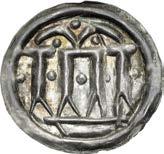

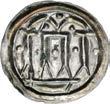

1134. DENMARK. Harald Blåtand (Bluetooth). Circa 958/9-986. AR Halvbrakteat (18mm, 0.27 g). Imitating class 2 deniers of Charlemagne from Dorestadt. Haithabu (Hedeby) mint. Struck circa 960s-970s. Four parallel vertical lines; double crescent above; additional pellets around / Incuse of obverse. Malmer, Nordiska, Group KG 9b-c; Hauberg 1; De Wit Group 2. Golden iridescent toning. EF. ($750)
Ex Classical Numismatic Group 47 (16 September 1998), lot 2216.
Harald Bluetooth, son of Gorm the Old, forged a territorial kingdom of Denmark and constructed military encampments and the Danvirke (defensive wall to protect Jutland from German attacks). He and his Queen Thyyra are buried at Jelling where his runestone proclaims “that he won the whole of Denmark and Norway and made the Danes Christian.”

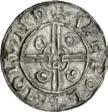


1135. DENMARK. Knud II den Store (the Great). 1019-1035. AR Penny (19mm, 0.81 g, 6h). Pointed Helmet type. Lund mint; Ælfweald, moneyer. Bust left, wearing pointed helmet; cross-tipped scepter before / ม ©⌦ዟዩɭ⌦ዝ ዦɭ ⌦⎍nዝ , voided short cross, limbs united at base by two concentric circles with pellet in center; in each angle, broken annulet enclosing pellet. Cf. Hauberg 10; Hede –; Becker Collection –; SCBI –; Hild. –; BMC –; cf. North 787 (for English issue); cf. SCBC 1158 (same). Toned, minor deposits. VF. Very rare. ($400)
Purchased from York Coins, 26 October 2011.
Knud II was proclaimed king by the Danish army in England in 1014 upon the death of his father Svend Forkbeard. In 1016, upon the death of Edmund Ironside (son of the exiled Aethelred II), all of England passed to Knud. He succeeded to the Danish throne after the death of his half-brother Harald II (1014-1018).
The moneyer Ælfweald does not appear to be recorded for Cnut at London, except for the list on North p. 154. This cataloger could find no other specimens to compare. As the present coin is a bit crude and low weight, it may tentatively be considered an early Danish issue of Cnut.
1136. DENMARK. Hardeknud (Knud III, the Hardy). 1035-1042. AR Penny (19mm, 1.04 g, 9h). Long Cross type. East Danish standard. Lund mint; Alfwarth, moneyer. Struck circa 1040-1042. Draped and armored bust left / ม a ⌦ዟዩ ʼዝ Ḧ ɭn ⌦ , voided long cross with triple-crescent ends and pellet at center, annulets and pellets in alternating fields. Becker dies H38/18s; Becker Collection 41 var. (rev. fields; same obv. die); Hede –; cf. Hauberg 28. Toned, peck marks. VF. ($500)
Purchased from York Coins, 9 January 2007.
Hardeknud was the son of Knud the Great and Emma, daughter of Duke Richard I of Normandy, and widow of King Aethelred II of England. Knud married Emma in 1017. Hardeknud ruled as king of England (1040-1042) after the unexpected death of his brother King Harold I Harefoot (1035-1040).


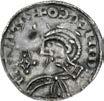
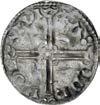
1137. DENMARK. Hardeknud (Knud III, the Hardy). 1035-1042. AR Penny (17mm, 1.21 g, 12h). Long Cross type. East Danish standard. Lund mint; Othinkarl, moneyer. Struck circa 1040-1042. Helmeted and armored bust left / ม ∂ T T ዞn
ü©ʼ
, voided long cross, with triple-crescent ends; crescents in first and third quarters. Becker dies H6/161; Becker Collection 30 (this coin); Hede II 31 var. (obv. legend; same rev. die); cf. Hauberg 28. Slightly wavy flan, peck on reverse. Toned. VF. Rare. ($600)
Purchased from York Coins, 20 October 2007. Ex C.J. Becker (Høiland 3, 13 October 1998), lot 30.
1138. DENMARK. Stridsperioden (Civil War). 1044-1047. AR Penny (16mm, 1.02 g, 11h). Long Cross type. East Danish standard. Lund mint; Ardln, moneyer. Diademed bust left; to left, open lozenge with pellets and ends / ม ©Ḧ ʼዝǮ nɭ Ǯዮዝዢ , voided long cross with triple-crescent ends; circle and pellet at center. Becker dies MX28/37a; Becker Collection 77 (same dies); Hede –; Hauberg –. Toned, peck marks, indentation. VF. ($600)
Purchased from York Coins, 1 August 2006.
The royal name was deliberately blundered by the engraver to avoid declaring his loyalty during the civil war, first between Magnus the Good and Svein Estrithsen or then between Harald Hardrada and Svein Estirthsen



1139. DENMARK. Stridsperioden (Civil War). 1044-1047. AR Penny (18mm, 1.03 g, 6h). Long Cross type. East Danish standard. Lund mint; Thorkil, moneyer. Helmeted and armored bust left / ม T
⌦⎍ , voided long cross, with triple-crescent ends. Becker dies MX29/207; Becker Collection 78 (this coin); Hede –; cf. Hauberg 1 (Magnus). Toned. EF. ($600)
Ex Classical Numismatic Group inventory 709403 (November 1998); C.J. Becker (Høiland 3, 13 October 1998), lot 78.
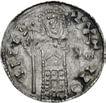
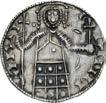

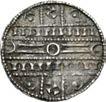
1140. DENMARK. Svend II Estridsen. 1047-1075. AR Penny (17mm, 1.12 g, 6h). East Danish standard. Lund mint. Crowned figure standing facing, holding globus cruciger in left hand and long cross-tipped scepter in right / Crowned figure standing facing, holding globus cruciger in left hand and long cross-tipped scepter in right. Becker Collection 81 (this coin); Hede I 45 (same dies); cf. Hauberg 4 (for type). Toned, a few peck marks, minor deposits. Good VF. ($500)
Ex Classical Numismatic Group inventory 709404 (November 1998); C.J. Becker (Høiland 3, 13 October 1998), lot 81.
Svend Estridsen, nephew of Knud the Great, was the son of Knud’s half sister Estrid and Jarl Ulf Thorgilsson. Ever resilient in defeat, Svend emerged from wars of succession in 1035-1066 as King of Denmark and his heirs ruled until 1375.
1141. DENMARK. Svend II Estridsen. 1047-1075. AR Penny (18mm, 1.02 g). East Danish standard. Roskilde mint. Openwork cross fleurée with central pellet-in-annulet, triple pellets in three of the voids and trefoil terminals on three of the bars, upper bar consisting of small globe set on larger globe; all within large open linear convex cross with pellet terminals and joined at ends by double line / Ornate “tapestry” pattern: central design consisting of pellet-in-annulets joined by double lines; on either side, IIIIIOIII and IICIIDII within pelleted border; at outer ends, cross pattée within pelleted border; pellet and crescent in outer voids. Becker Collection 104 (same dies); Hede II 53; cf. Hauberg 36 (for type). Toned, surface flan crack, deposits. Good VF. ($400)
Ex Classical Numismatic Group 47 (16 September 1998), lot 2216.




1142. DENMARK. Harald III Hein. 1075-1080. AR Penny (17mm, 1.15 g, 6h). Lund mint; Thurgot, moneyer. Christ standing facing, holding crozier and Gospels / ม T ⎍˃űɭ˸ / ዢ ⌦⎍nዝ / , cross composed of four ovals united at base by two concentric circles enclosing a pellet. Cf. Becker Collection 115 (for type); cf. Hede III 64 (same); cf. Hauberg 1 (same). Toned. Good VF. Very rare. ($2500)
Ex Classical Numismatic Group inventory 789307 (April 2007); G.W. de Wit (Part I, Künker 121, 12 March 2007), lot 638; Peus 309 (2 May 1984), lot 302.
Harald Hein, an illegitimate son of Svend Estridsen, promoted peace and standardized the Danish coinage.
The jewel cross reverse was introduced in the posthumous English issues of Knud II den Store (Cnut the Great), circa 1035. It proved a popular type in Denmark, and was used for various issues of all succeeding kings through Knud IV den Hellige (Cnut the Saint; 1080-1086).




1143. DENMARK. Niels. 1104-1134. AR Penny (19mm, 0.66 g, 1h). Roskilde mint; Estman, moneyer. Crowned bust right; standard to right / Edifice; ዞ˞Ϳ across lower roof. Becker Collection 120; cf. Hede I 67 (same); Hauberg 9. Toned. Good VF. Very rare. ($1000)
Ex Classical Numismatic Group inventory 789308 (April 2007); G.W. de Wit (Part I, Künker 121, 12 March 2007), lot 641; Hornung’s Møntauktioner 35 (2 May 1992), lot 45; Ahlstrom 4 (6 October 1973), lot 929.
Niels was the last of the sons of Svend Estridsen to succeed to the Danish throne. He was defeated by his nephew Erik Emune, “the Unforgettable” (1134-1137) at the Battle of Fotevik (4 June, 1134) where German knights in Erik’s employ won the battle. Niels fled the field, but he was captured and executed soon afterwards.



1144. NORWAY. Olav III (Haraldsson) Kyrre (the Peaceful). 1067-1093. AR Penny (16mm, 0.87 g, 6h). Crude draped bust left; trefoil-tipped scepter to left / Voided long cross; blundered Latin inscription around. Stenersen Class C; ABH 10. Lightly toned, Small edge crack. Near VF. Rare. ($1000)
Purchased from Numisma Mynthandel, Oslo, 20 February 2015.
Olav was the son of Harald Hardrada, who fell at the Battle of Stamford Bridge (25 September, 1066).


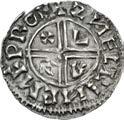

1145. SWEDEN. Olof Skötkonung (the Treasurer). 995–1022. AR Penny (20mm, 1.54 g, 1h). Sigtuna mint; Snelling, moneyer. Struck 995-1000/5. ม ɭ⌦/©ዟ ʼҟ ɭɃ Z˸ቯ ì, draped bust of Olof left; scepter to left / ม ZɃዞ⌦⌦/ዢɃዞ
, voided short cross; ü ʼ ⎍ ҟ . SMH 5 (same dies); Malmer, Sigtuna single, dies 3.72; Person Group III, type Ab; Lagerqvist 3. Toned, slightly ragged edge. VF. Very rare, especially so with bust left. ($2500)
Purchased from J. Linzalone, 16 October 2013.
This imitative coin is likely the first issue in the name of King Olof Skötkonung, because so many English pennies of the Crux and Long Cross types arrived in Scandinavia in hands of warriors serving the Danish King Svein Forkbeard, who had obtained the coins as booty or payments of Danegeld.
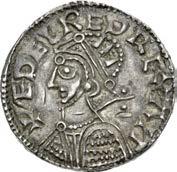



1146. SWEDEN. Olof Skötkonung (the Treasurer). 995–1022. AR Penny (20mm, 2.11 g, 9h). Imitation of Æthelred II Helmet type. Sigtuna mint. Struck circa 1003-1020. ม ® ዝዞ⌦ያዞዝ
, helmeted bust left
voided long cross, with pellet in center and triple crescent ends, over square with trefoil at each point; annulet in third quarter. Dolley, “Imitation and Imitation of Imitation: Some Problems Posed by the non-English Helmet Pennies with the Name of Æthelræd II,” in Studies in Northern Coinages of the Eleventh Century (Copenhagen, 1981), p. 95, no. 15 (dies K/c); SMH 518 (same dies); Malmer, Sigtuna chain 24, 308.801. Rich old cabinet toning with splashes of gold, a few peck marks. Good VF. Very rare. ($2000)
Purchased from James King, April 1976 (as an English issue).
Olof Skötkonung, the son of Erik the Victorious, converted to Christianity and laid the foundations for the territorial monarchy of Sweden.



1147. POMERANIA, Wolin (Jomsborg). Circa 1030-1043. AR Penny (21mm, 1.33 g). Imitating the Long Cross/Crux/ Helmet types of Æthelred II of England. Draped bust left; trefoil-tipped scepter to left / Voided long cross with triple-crescent ends and pellet at center; in each quarter, trefoil on pile. SCBI 36 (Berlin), 1128 (same dies). For context on the series of Pomeranian imitations, see: Mateusz Bogucki & Jack Magiera, “Lund – Odense – Lund – Kołobrzeg. Danish influences in the Zemuzil Bomeraniorum Coinage” in Festkrift Till Kenneth Jonsson (2015), p. 11-20. Toned, slightly wavy flan. VF. Very rare. ($750)
Purchased from J. Linzalone. Ex Wolfgang Fried (Künker 232, 17 June 2013), lot 26.
A series of imitations of English coins in a “pearly” style were struck in Pomerania in the early-mid 11th century. These types are believed to have been made in the town of Wolin prior to its invasion by the Danish king Magnus in 1043. For another example of this style, see Triton XVII, lot 1429.
Archaeology has uncovered a Scandinavian-Slavic settlement at Wolin, which has been identified as the legendary Jomsborg, the encampment of the company of the Jomsvikings.


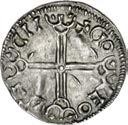
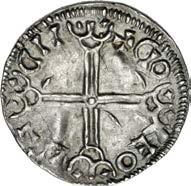
1148. SCANDINAVIA. 11th century AD. AR Penny (21mm, 1.98 g, 12h). Imitating the Long Cross type of Æthelred II of England. ‘Northern’ die chain. Struck circa 1000/1005-1020. Draped bust left; pellet behind neck / Voided long cross, with pellet at center and triple-crescent ends. Malmer chain 136, 221.1245; SMH 212. Toned, slightly wavy flan, a few peck marks. Good VF. Rare. ($750)
Purchased from J. Linzalone, 23 November 2010. Ex G.W. de Wit (Part I, Künker 121, 12 March 2007), lot 671; M.C. Hirsch 3 (15 February 1975), lot 51.
The selection of imitative Scandinavian pennies was based on English pennies, notably those of Æthelred II (the Crux and Long Cross types) which arrived in Scandinavia in hands of warriors serving the Danish King Svein Forkbeard who had obtained the coins as booty or payments of Dangeld.
A note from the cataloger: The imitative types presented here are some of the earliest issues of the Danish and Swedish Kings. Mostly struck in the early 11th century, numismatists have been able to arrange them into a number of ‘die chains,’ helping to develop an idea of where these were struck. Some chains remain unconnected, while others can be arranged into “Northern” or “Southern” groups. The Northern group was likely struck at Sigtuna (or possibly other mints) and links to the named coinage of Olof Skötkonung. The Southern group hails from Denmark and consists of the first coinage of the Lund mint under Svein Forkbeard. The die chains are quite complex, with individual dies appearing to move between England, Denmark, Sweden, and even Pomerania. As such, we have presented this group as a separate Scandinavian section, so that collectors can consider this fascinating series as a cohesive yet ever-evolving group.


1149. SCANDINAVIA. 11th century AD. AR Penny (21mm, 2.00 g). Imitating the Long Cross type of Æthelred II of England. ‘Northern’ die chain. Struck circa 1000/1005-1020. Draped bust left; pellet behind neck / Voided long cross, with pellet at center and triple-crescent ends. Malmer chain 117, 367.1502; SMH 236. Lightly toned, a few peck marks. Good VF. Rare. ($750)
Purchased from J. Linzalone. Ex Künker 217 (9 October 2012), lot 3016.


1150. SCANDINAVIA. 11th century AD. AR Penny (20mm, 1.93 g). Imitating the Small Cross types of Æthelred II of England. ‘Northern’ die chain. Struck circa 1000/1005-1020. Diademed and draped bust left / Small cross pattée. Malmer chain 118, 652.1851; SMH 545. Toned. Good VF. ($500)
Purchased from J. Linzalone. Ex Spink 219 (24 September 2013), lot 137; ‘Viking’ Collection (Spink 150, 14 March 2001), lot 1204.

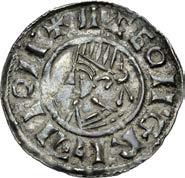

1151. SCANDINAVIA. 11th century AD. AR Penny (20mm, 1.20 g, 1h). Imitating the Small Cross types of Æthelred II of England. ‘Southern’ or ‘Northern’ die chain. Diademed and draped bust left / Small cross pattée. Malmer chain 136, 651.1365. Old collection toning. Good VF. Rare. ($1000)
Purchased from J. Linzalone. Ex Künker 228 (12 March 2013), lot 3327.

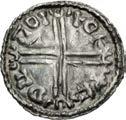


1152. SCANDINAVIA. 11th century AD. AR Penny (20 mm, 1.97 g, 6h). Imitating the Long Cross type of Æthelred II of England. ‘Southern’ die chain. Draped bust left; pellet behind neck / Voided long cross, with pellet at center and triple-crescent ends. Malmer chain 163, 251.1224. Toned, slightly wavy fan, a few peck marks. VF. Rare. ($600)
Purchased from J. Linzalone, 2010.
1153. SCANDINAVIA. 11th century AD. AR Penny (20mm, 1.14 g, 6h). Imitating the Crux type of Æthelred II of England. Draped bust left; trefoil-tipped scepter to left / Voided short cross; ü ʽ ⎍ ҟ in quarters. Malmer ‘single’ chain, 16.1018. Lightly toned, slightly wavy flan, areas of weak strike. VF. ($400)
Purchased from J. Linzalone, 2010. 1152 1153


1154. SCANDINAVIA. 11th century AD. AR Penny (20mm, 1.75 g, 10h). Imitating the Long Cross type of Æthelred II of England. Draped bust left; pellet behind neck / Voided long cross, with pellet at center and triple-crescent ends; pellet in fourth quarter. Malmer ‘single’ chain, 263.9118. Toned, porous. VF. Rare. ($500)
Purchased from Standbergs Mynthandel, 20 June 2007.


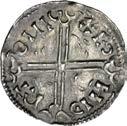
1155. SCANDINAVIA. 11th century AD. AR Penny (22mm, 1.64 g, 1h). Imitating the Helmet and Long Cross types of Æthelred II of England. Helmeted and draped bust left / Voided long cross, with pellet at center and triple-crescent ends. Malmer chain 4-L, 469.1223; cf. SMH A24 (for same obv. die with short cross rev.). Toned, a few peck marks. Good VF. Charming style. Rare. ($750)
Purchased from J. Linzalone. Ex Künker 217 (8 October 2012), lot 3017.

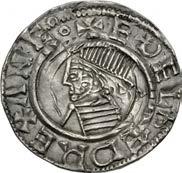

1156. SCANDINAVIA. 11th century AD. AR Penny (20mm, 1.24 g, 7h). Imitating the Small Cross type of Æthelred II of England. ‘Lincoln’ mint; ‘Swiferleth,’ moneyer. Struck circa 1013-1020s. Diademed and draped bust left / ม Ӳ⎍ዢዟዞʼ⌦ዞ
ዦ!ɭ ⌦ዢ⌦ዢɃ , small cross pattée. Malmer –; SCBI 36 (Berlin), 998 var. (rev. legend; same obv. die); SCBI 7 (Copenhagen), 1473 (same dies). Double struck, a few peck marks. VF. Charming style. Likely of Danish origin. ($1000)
Purchased from J. Linzalone, 2010.


1157. ANGLO-SAXON, Kings of Mercia. Coenwulf. 796-821. AR Penny (19mm, 1.30 g, 12h). Large portrait type. Canterbury mint; Tidbeorht, moneyer. Struck circa 810-821. Diademed bust right / ม ˸ዢዝዛዞ¥ʼ h ዦɭnዞ˸© , double pincershaped cross superimposed on cross pommée; wedges in angles. Naismith C44.2g; SCBI 42 (South-Eastern), 642; North 347; SCBC 916. In NGC encapsulation 6327709-005, graded “Chipped”. ($750)
Ex Historical Scholar Collection (Heritage 23225, 21 December 2022), lot 64491.

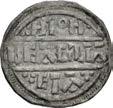


1158. ANGLO-SAXON, Kings of Mercia. Burgred. 852-874. AR Penny (18mm, 1.10 g, 12h). Lunette type D (BMC d). London mint; Beagstan, moneyer. Struck circa 866-868/70. Diademed bust right / ዛዞ⌈űZ˸⌈ across central field; /Ḧ ó ɭn Ḧ/ /Ḧ ዞ˸⌈ Ḧ/ in lunettes above and below. MacKay V5.15 (dies O13/R13); SCBI 50 (Hermitage); North 423; SCBC 941B. Toned, faint porosity. VF. ($500)
From the Alexander Christopher Collection.
1159. ANGLO-SAXON, Kings of Wessex. Edward the Elder. 899-924. AR Penny (21mm, 1.58 g, 12h). Small cross/ Horizontal-Trefoil 1 (HT 1) type (BMC ii). Wessex dies; Ealhstan, moneyer. Struck circa 915-920. Small cross pattée / ዞ²⌦Ӳ / ˸²n ዦ!∂ in two lines; three crosses, trefoils above and below. CTCE 177; SCBI 26 (East Anglia), 1388 (same dies); North 649; SCBC 1087. Toned. In NGC encapsulation 2903563-001, graded AU 50. ($500)

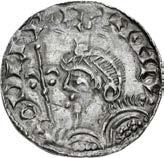

1160. ANGLO-SAXON, Kings of All England. Harold I Harefoot. 1035-1040. AR Penny (18mm, 1.00 g, 9h). Fleurde-lis type (BMC vc, Hild. B). Lincoln mint; Ælfwine, moneyer. Struck circa 1038-1040. Diademed bust left; shield and listipped scepter to left / ม ⌦ዞዟ ዩዢnዞ ɭn ⌦ዢ Ḧ ዢ ü ɭ⌦ , voided long cross; pellet in circle in center, fleur-de-lis (flanked by pellets) in angles. Mossop pl. LXI, 14 var. (dies –/f [unlisted obv. die]); SCBI 18 (Copenhagen), 228 (same rev. die); North 803; SCBC 1165. Toned, peck marks. Good VF. ($750)
From the Alexander Christopher Collection, purchased from J. Linzalone.
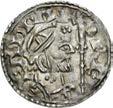



1161. ANGLO-SAXON, Kings of All England. Edward the Confessor. 1042-1066. AR Penny (18mm, 1.23 g, 6h). Pyramids type (BMC xv, Hild. I). Winchester mint; Leofweald, moneyer. Struck circa 1065-1066. Crowned bust right; scepter before / ม ⌦ዞɭዟዩɭ⌦ዝ ɭn ዩዢnü , voided cross with annulet in center; pyramids in quarters. Harvey 1844-5 var. (dies B/–[unlisted rev. die]); Freeman 230; BMC 744 (same obv. die); North 831; SCBC 1184. Iridescent toning, worn reverse die. Good VF. An interesting variety with the large scepter breaking the obverse legend. ($500)
From the Alexander Christopher Collection. 1162. NORMAN. William I ‘the Conqueror’. 1066-1087. AR Penny (20mm, 1.39 g, 12h). Paxs type (BMC viii). Canterbury mint; Wulfric, moneyer. Struck circa 1083-1086. Crowned facing bust, holding scepter; annulet on right shoulder / ม ዩዢዢ⌦ዟʼዢü ɭn ünͿዞ , cross pattée; letters of ዩ a ҟ S in annulets within quarters. SCBI 26 (East Anglia), 1373 (same dies); BMC 581; North 848; SCBC 1257. Richly toned. Good VF. ($600) Ex Classical Numismatic Group inventory 25020 (January 2020).




1163. NORMAN. William II Rufus. 1087-1100. AR Penny (20mm, 1.34 g, 6h). Cross Fleurée and Piles type (BMC v). Colchester mint; Sveinn, moneyer. Struck circa 1098-1100. Crowned facing bust, holding scepter; star to right / ม ˨ዢዩዞʠዞ ɭ ü ɭ⌦ዢ , cross fleurée, with pile surmounted by pellet in each quarter. SCBI –; BMC 262; North 856; SCBC 1262. Toned, flan cracks. VF. Very rare. ($1500)
From the St. George Collection.


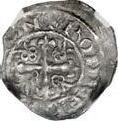
1164. NORMAN. Stephen. 1135-1154. AR Penny (18mm, 1.33 g, 6h). Profile/Cross and Piles type (BMC vi). Canterbury(?) mint; Rodbert, moneyer. Struck circa 1150-1154. Crowned bust left, holding scepter / ม ʼɭዝዛዞʼ
ü¥ ] n , cross fleurée, with saltire cross at center and piles surmounted by trefoils in each quarter. Mack 79; SCBI 20 (Mack), 1618; North 879; SCBC 1281; Wicklewood Hoard 76a (same rev. die). In NGC encapsulation 2903563-002, graded XF 45. Bold portrait. Very rare. ($1000)
Ex Classical Numismatic Group 123 (23 May 2023), lot 952.
Ex Elias Treaty Period Noble



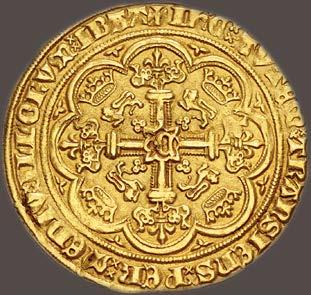
1165. PLANTAGENET. Edward III. 1327-1377. AV Noble (34mm, 7.62 g, 2h). Fourth coinage, Treaty period. Calais mint. Struck 1361-1369. Edward standing facing in ship, holding sword and shield; ornaments -11-11, ropes 3/2, quatrefoils 3/4, lis 4; flag at stern / Voided short cross potent over cross fleurée; in each angle, crown over lion passant over voided trefoil; at center, ý within quadrilobe; all within polylobe, with trefoils in spandrels. Lawrence 5; Schneider 102; North 1236; SCBC 1504. In NGC encapsulation 6909359-002, graded AU 58. ($7500)
Ex E. Elias (Spink 77, 21 June 1990), lot 552; Seaby Coin & Medal Bulletin 551 (April 1964), no. G796.


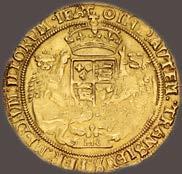
1166. TUDOR. Henry VIII. 1509-1547. AV Half Sovereign (30mm, 6.18 g, 2h). Third coinage. Type IIb. Tower (London) mint; im: pellet-in-annulet. Struck 1544-1547. Henry enthroned facing, holding scepter and globus cruciger; rose below / Crowned coat-of-arms with dragon and lion supporters standing on crown. Whitton IIb, 1; Schneider 612-4 var. (legends and stops); North 1827; SCBC 2294. From the earliest 96 grain issue with ornamental Hs and saltire stops. Toned. In NGC encapsulation 6891729003, graded MS 62. A captivating portrait. Very rare. The SCBC plate coin in the pre-color era. Top Pop. ($7500)
Ex Spink 97 (13 May 1993), lot 7; W.L. Raynes (Glendining, 15 February 1950), lot 82.
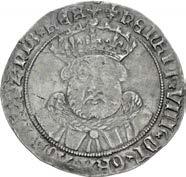
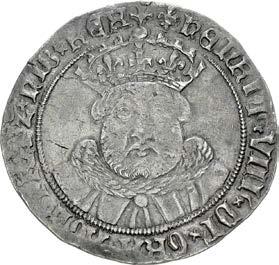

1167. TUDOR. Henry VIII. 1509-1547. AR Testoon (30mm, 7.82 g, 3h). Third coinage. Tower (London) mint; im: lis. Struck 1544-1545. Crowned facing bust / Crowned rose; crowned h R flanking. Jacob O.1/R.1; Whitton A(1), a(i); North 1841; SCBC 2364. Toned, a few marks, usual weak strike on face. Near VF. ($3000)
From the Alexander Christopher Collection. Ex Stack’s (7 December 1993), lot 2985.
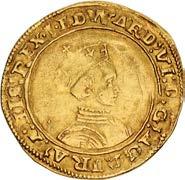


1168. TUDOR. Edward VI. 1547-1553. AV Half Sovereign (31mm, 5.30 g, 11h). Second period. Tower (London) mint; im: arrow. Struck January 1549-April 1550. Crowned and armored bust right / Crowned coat-of-arms; E R flanking. Schneider 672/673 (obv. type/same rev. die); North 1911; SCBC 2438. Richly toned, some die wear, obv. slightly double struck in legends. Good VF. Rare. ($7500)
Ex Spink Numismatic Circular XCIX.8 (October 1991), no. 6418 (’a full pleasing coin’).

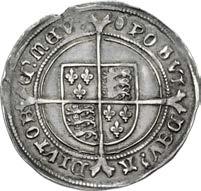
1169. TUDOR. Edward VI. 1547-1553. AR Shilling (33mm, 6.14 g, 9h). Third period, fine silver issue. Tower (London) mint; im: tun. Struck 1551-1553. Crowned and mantled bust facing slightly left; rose to left, XII to right / Coat-of-arms over long cross fourchée. North 1937; SCBC 2482. Small striking split and a few marks under rich old tone. Good VF. A handsome portrait piece. ($500)
Ex Classical Numismatic Group 115 (16 September 2020), lot 1144; Succession Bernard (Poindessault & Burgan, 25 May 2018), lot 333.



1170. TUDOR. Lady Jane Grey. 10 July–19 July 1553. Fantasy AR “Testoon” (34mm, 14.54 g, 12h). William Taylor, engraver(?). Dated 1553 (though struck by Emery, 1840s). Crowned bust facing slightly left / Crowned rose; crowned I R flanking. H.E. Pagan, “Mr. Emery’s Mint” in BNJ 40 (1971), 87. Old cabinet toning, a few minor scratches. EF. ($750)
From the Alexander Christopher Collection.
In the early 1840s, a glut of counterfeit ancient and British coins appeared on the London market. The forgeries were struck by an individual by the name of Emery, possibly a London plate glass maker. The dies are of fine quality and have been suggested to be the work of William Taylor, a notorious engraver also responsible for the 1847 Liberian coinage and many of the restrikes of Soho mint issues.
Though given by Pagan as a “jeton or medal,” the design and fabric of this coin clearly harkens back to the hammered silver testoons of Henry VIII. Two varieties are known, one with a hammered fabric and gothic lettering (the present type), another with Roman lettering and the fabric of a 19th century medal. Regardless, this type is a wonderful example of the Emery series and effectively the only way for collectors to acquire a coin of Lady Jane Grey in period-appropriate style.


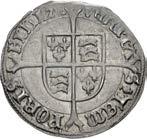
1171. TUDOR. Mary 1553-1554. AR Groat (24mm, 2.01 g, 10h). Tower (London) mint; im: pomegranate. Crowned bust left / Coat-of-arms over long cross fourchée. North 1960; SCBC 2492. Rich iridescent toning, light scratches. Good VF. ($750)
From the Alexander Christopher Collection.
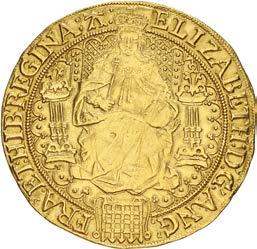



1172. TUDOR. Elizabeth I. 1558-1603. AV Sovereign (43mm, 15.47 g, 8h). Sixth issue. Tower (London) mint; im: A. Struck 1582-1584. Elizabeth, holding lis-tipped scepter and globus cruciger, enthroned facing; all within tressure of arches; portcullis (with chains) below / Coat-of-arms at center of Tudor rose. Brown & Comber A9; Schneider 778 (same dies); North 2003; SCBC 2529. Toned, extensive hairlines and light scratches, minor edge marks. VF. ($10,000)
Ex Morton & Eden 97 (28 November 2018), lot 493; Glendining (31 March 1965), lot 119.


1173. TUDOR. Elizabeth I. 1558-1603. AR Shilling (32mm, 6.24 g, 7h). Second issue. Tower (London) mint; im: martlet. Struck May-October 1561. Crowned bust (3Cvi) left / Coat-of-arms over long cross fourchée. BCW MR-4Hvi/MR-b3; North 1985; SCBC 2555. Light golden toning with underlying luster, area of weak strike. Near EF. ($500)
From the Alexander Christopher Collection.


1174. TUDOR. Elizabeth I. 1558-1603. AR Crown (43mm, 29.33 g, 3h). Seventh issue. Tower (London) mint. Struck 1601-1602. Crowned and draped bust (9A) left, wearing ruff, holding lis-tipped scepter and orb / Coat-of-arms over long cross fourchée. Barr/Cooper dies C/1; BCW 1-1/1-a1; North 2012; SCBC 2582. Lightly toned, minor marks, flan flaw, flan crack, edge marks. VF. ($1500)
Ex Sincona 63 (8 June 2020), lot 1053.



1175. TUDOR. Elizabeth I. 1558-1603. AR Halfcrown (35mm, 14.82 g, 9h). Seventh issue. Tower (London) mint. Struck 1601-1602. Crowned and draped bust (9B) left, wearing ruff, holding lis-tipped scepter and orb / Coat-of-arms over long cross fourchée. BCW 1-1/1-a2; North 2013; SCBC 2583. Toned, edge marks. VF. ($1500)
From the Alexander Christopher Collection.


1176. TUDOR. Elizabeth I. 1558-1603. AR Shilling (29.5mm, 6.20 g, 6h). Milled coinage, medium flan variety. Tower (London) mint; im: star. Struck 1560-1561. Crowned bust left, wearing ruff / Coat-of-arms over long cross fourchée. Borden & Brown 16-O3/16-R3; North 2023; SCBC 2591. Lightly toned, a few light marks in fields. Good VF. ($1000)
Ex Classical Numismatic Group 111 (29 May 2019), lot 1107.



1177. TUDOR. Elizabeth I. 1558-1603. AR Sixpence (26mm, 3.20 g, 7h). Milled coinage. Tower (London) mint; im: star. Dated 1562. Crowned bust (C) left, with decorated dress, wearing ruff; rose to right / Coat-of-arms over long cross fourchée. Borden & Brown 24, dies O3/R6; North 2026; SCBC 2595. Deep iridescent toning, minor scratch. Good VF. ($750)
From the Alexander Christopher Collection.

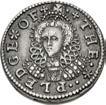


1178. TUDOR. Elizabeth I. 1558-1603. Cast AR Pattern Pledge Penny (18mm, 2.10 g, 6h). Dated 1601. · + THE · · · PLEDGE OF + ·, crowned and draped bust facing slightly left, wearing elaborate collar / · · A · PEN NY · ·, crowned monogram; 16 01 across field. Peck 3; North 2051. Toned, edge marks, a few marks on obverse. Good VF. Rare. ($1000)
From the Alexander Christopher Collection.


1179. STUART. Charles I. 1625-1649. AV Unite (35mm, 9.12 g, 4h). Group A, class II. Tower (London) mint; im: lis. Struck 1625. Crowned first bust right, wearing coronation robes and large ruff; XX (mark of value) to right / Crowned coat-ofarms. Brooker 124; Schneider 114; North 2146; SCBC 2685. Lustrous, hairlines, slightly double struck, minor areas of weak strike. Near EF. ($2000)


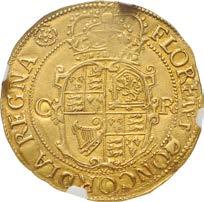
1180. STUART. Charles I. 1625-1649. AV Unite (34mm, 8.98 g, 7h). Group C, class IIa. Tower (London) mint; im: rose. Struck 1631-1632. Crowned bust 3a left, wearing ruff; XX (mark of value) to right / Crowned coat-of-arms; C R flanking. Brooker 74; Schneider 141 var. (obv. legend); North 2150; SCBC 2690. In NGC encapsulation 4883505-004, graded AU 55. A finely engraved example of bust 3a. ($3000) Ex Heritage 3073 (25 April 2019), lot 31078; Dix Noonan Webb 119 (4 December 2013), lot 2501; H. Selig (Spink 70, 31 May 1989), lot 22.


1181. STUART. Charles I. 1625-1649. AR Halfcrown (35mm, 14.78 g, 6h). Briot’s Second Milled issue. Tower (London) mint under Briot; im: в and anchor. Struck 1638-1639. Charles on horseback left, holding reins and sword / Garnished coatof-arms; crowned C R over pellets flanking. Brooker 724 (same dies); North 2304; SCBC 2858. Deep iridescent toning, adjustment marks, hairlines, edge marks. VF. ($750)
From the Alexander Christopher Collection.


1182. STUART. Charles I. 1625-1649. AR Halfcrown (35mm, 15.12 g, 12h). Type VI. York mint; im: lion passant. Struck 1643-1644. Charles on horseback trotting left, holding sword and reins; EBOR below / Crowned coat-of-arms; crowned C R across field. Brooker 1083 (same dies); North 2314; SCBC 2868. Toned, old scrapes on both sides. Good VF. ($750)
Ex Lockdale’s 45 (21 November 2004), lot 931.



1183. STUART. Charles I. 1625-1649. AR Shilling (30mm, 6.03 g, 5h). Aberystwyth mint; im: open book. Struck 1638/9-1642. Crowned bust left; plumes to left, XII (mark of value) to right / Coat-of-arms; plumes above. Brooker 753 (same obv. die); North 2331; SCBC 2883. Toned, slight ghosting in crown. Good VF. Well struck on a neat flan. ($1500)




1184. STUART. Charles I. 1625-1649. AR Pound (52mm, 118.33 g, 10h). Declaration in Cartouche type. Oxford mint; im: plume. Dies by T. Rawlins. Dated 1644. Charles on horseback left, holding sword and reins, trampling pile of arms below; Oxford plume to right / - EXVRGAT - DEVS - DISSIPENTVR - INIMICI -, RELIG : PROT/: LEG : ANG :/LIBER : PAR : in three lines within cartouche; above, large Oxford plume above -XX- (mark of value); below, 1644 above OX. Morrieson, Oxford, A-1; Brooker 865 (same dies); North 2402; SCBC 2943. Attractive cabinet toning, edge ding, slight doubling. VF. Extremely rare. ($30,000)
Ex V.J.E. Ryan (Part II, Glendining, 21 January 1952), lot 1228; E.H. Wheeler (Seaby Coin & Medal Bulletin 157 [February 1931]), no. EH172; C.A. Watters (Glendining, 21 May 1917), lot 403; E.W. Rashleigh (Sotheby, Wilkinson, & Hodge, 21 June 1909), lot 890; Stanesby Alchorne (S. Leigh Sotheby & Co., 11 May 1848), lot 108.
The celebrated Cartouche pound of 1644 is remarkable for its exquisite design, as well as its rarity. The obverse die was reworked from one used to strike earlier pounds. The king is depicted in higher relief, and his upper body and head have been brought forward. Furthermore, the arms and armor below the horse have been enhanced in certain areas. To complement this revitalized obverse, Rawlins chose to adopt an entirely new reverse design that displayed Charles’ Declaration of Wellington in an ornate cartouche. The resulting coin is, in the words of the Reverend Arnold Mallinson, ‘probably the finest thing in English coins, and stands unrivaled by similar pieces elsewhere.’



1185. STUART. Charles I. 1625-1649. AR Halfpound (46mm, 58.21 g, 12h). Declaration type. Oxford mint; im: plume. [Dated 1642]. Charles on horseback left, holding sword and reins, trampling small pile of arms below; Oxford plume to right / RELIG : PROT/: LEG : ANG :/LIBER : PAR : in three lines within cartouche; [above, three plumes above -X- (mark of value); below, 1642]. Upper reverse field engraved with a depiction of Charles kneeling at the block with Bishop William Juxon to his left, the executioner (Richard Brandon?) to his right, and two soldiers flanking. The lower field engraved with a depiction of several figures on horseback, wearing broad-rimmed caps (Cromwell among them?), one carrying an English flag, among a group of soldiers. Morrieson, Oxford, A-2; Brooker 868 (same dies); North 2404; SCBC 2945. Richly toned, edge smoothed. VF. An extremely rare and priceless artifact. ($2000)
Ex Elvira Elisa Clain-Stefanelli (“Demarete”) Collection (Stack’s, Bowers & Ponterio 174, 11 January 2013), lot 1318.
The reverse of this Oxford half pound has been re-engraved to show one of the most important moments in English history: the execution of Charles I on 30 January 1649, in front of the Banqueting House in Whitehall. The King is seen kneeling in prayer, with his friend Bishop Juxon to his right and the executioner, ax over shoulder, approaching from his left. The engraver certainly either copied from one of the several contemporary prints made of the execution or, more interestingly, may have even been an eyewitness to the death of Charles.
Before the headsman approached, Charles spoke to Juxon, “I go from a corruptible to an incorruptible crown; where no disturbance can be, no disturbance in the world.” He then turned to the executioner, saying “When I put out my hands this way, then... stay for the sign.” After a brief pause, Charles reached out his hands. The ax fell and his head was severed in a single, swift blow.
The re-engraved lower field, while not as dramatic as the upper, nonetheless suggests some tantalizing information about the creator of this object. The engraving depicts a group of mounted figures, all wearing broad-rimmed caps, with one of them carrying an English flag. Around these are several pikemen. Taken in context with the upper field, this should be interpreted as showing a detachment of Cromwell’s New Model Army, with one of the mounted figures perhaps representing the Lord Protector himself. Accordingly, this piece should be seen as celebrating the death of the King, rather than lamenting it.

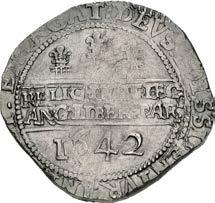
1186. STUART. Charles I. 1625-1649. AR Halfcrown (33mm, 14.70 g, 2h). Declaration type. Oxford mint; im: plumes. Dated 1642. Charles on horseback left on ground line, holding sword and reins; Oxford plume to upper right / RELIG : PROT : LEG/ ANG : LIBER : PAR; three plumes above, 1642 below. Bull, Oxford 593/C; Brooker 881 (same dies); North 2411; SCBC 2952. Toned, usual weak strike and die flaws. VF. Sharp details. Rare variety. ($1000)
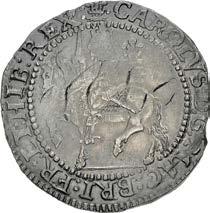

1187. STUART. Charles I. 1625-1649. AR Halfcrown (34mm, 14.82 g, 10h). Declaration type. Oxford mint; im: plumes. Dated 1642. Charles on horseback left on ground line, holding sword and reins; Oxford plume to upper right. ‘Chain mail’ saddle / RELIG : PROT : LEG/ ANG : LIBER : PAR; three plumes above, 1642 below. Bull, Oxford 592/C; cf. Brooker 877 (for type; same rev. die); North 2411; SCBC 2954A. Toned, flan flaws and weakly struck at center. VF. An exceedingly rare variety with ‘chain mail’ saddle. ($1000)




1188. STUART. Charles I. 1625-1649. AR Sixpence (27mm, 3.05 g, 2h). Declaration type. Oxford mint; im: open book/–. Dated 1643. Crowned bust left; VI (mark of value) to right, small Oxford plume to left / RELIG : PROT/ LEG : ANG/ LIBER · PAR; three plumes above, 1643 below. Brooker 953 (same dies); North 2459; SCBC 2981. Deeply toned, a few scratches. Good VF. ($750)
From the Alexander Christopher Collection.
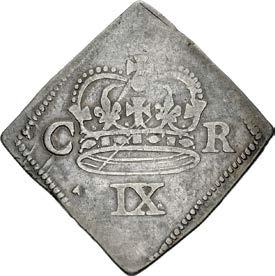

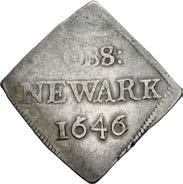

1189. STUART, Siege money. Newark. 1645-1646. AR Ninepence (23x24mm, 4.41 g, 12h). In the name of Charles I. Dated 1646. Large crown; C R flanking; IX (mark of value) below / OBS :/ NEWARK/ 1646. Brooker 1227; North 2641; SCBC 3144. Toned, minor marks. VF. ($1000) From the Alexander Christopher Collection.



1190. COMMONWEALTH. Oliver Cromwell. Lord Protector, 1653-1658. AR Halfcrown. Blondeau’s mint, Drury House, London. Dies by Thomas Simon. Dated 1658. Lessen I26; Bull 242; ESC 447; SCBC 3227A. Toned, scratches. Good VF. ($2000)
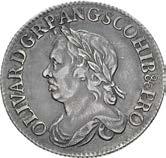


1191. COMMONWEALTH. Oliver Cromwell. Lord Protector, 1653-1658. AR Shilling (27mm, 5.99 g, 6h). Blondeau’s mint, Drury House, London. Dies by Thomas Simon. Dated 1658. Lessen J28; ESC 1005; North 2745; SCBC 3228. Lovely iridescent toning, light scratches in obverse field under tone. Near EF ($2000)
Ex Lampasas (Triton XXIV, 19 January 2021), lot 1430; Classical Numismatic Group 81 (20 May 2009), lot 1402; Davissons 22 (28 April 2005), lot 221; Bebee (Bowers & Merena, 26 August 1987), lot 3439.


1192. STUART. Charles II. 1660-1685. AR Shilling. Dated 1663. First bust variety. Bull 506; ESC 1025; SCBC 3272. Toned. In NGC encapsulation 6909501-013, graded AU 55. ($500)
From the Alexander Christopher Collection.


1193. STUART. Charles II. 1660-1685. AR Crown. Dated 1666 and RY XVIII. Second bust variety. Elephant below bust. Bull 368; ESC 33; SCBC 3356. Toned, minor edge marks. Good Fine. ($1000)
From the Alexander Christopher Collection.
Coins bearing an elephant below the king’s bust were struck from silver provided by the Royal African Company, whose badge was the elephant and castle.


1194. STUART. James II. 1685-1688. AR Crown. Dated 1687 and RY TERTIO. Second bust. Bull 743; ESC 78; SCBC 3407. Toned. In NGC encapsulation 6904463-001, graded AU 58. ($750)
From the Alexander Christopher Collection.

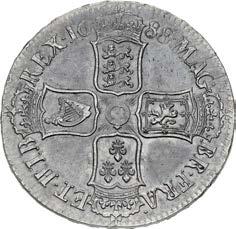
1195. STUART. James II. 1685-1688. AR Crown. Dated 1688 and RY QVARTO. Second bust. Bull 746; ESC 80; SCBC 3407. Toned. In NGC encapsulation 6904463-002, graded AU 53. ($500)
From the Alexander Christopher Collection.

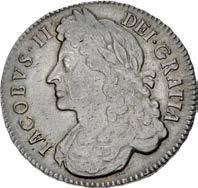

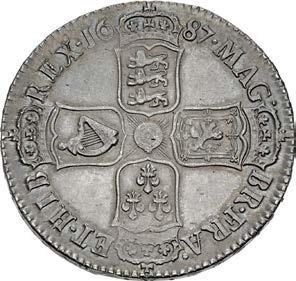
1196. STUART. James II. 1685-1688. AR Halfcrown. Dated 1687 and RY TERTIO. First bust. Bull 753; ESC 498; SCBC 3408. Toned. In NGC encapsulation 6909498-005, graded MS 61. Top Pop ($1000)
From the Alexander Christopher Collection.


1197. STUART. James II. 1685-1688. AR Shilling. Dated 1686. Bull 765; ESC 1070; SCBC 3410. Toned. In NGC encapsulation 6909501-011, graded AU 55. ($500)
From the Alexander Christopher Collection.


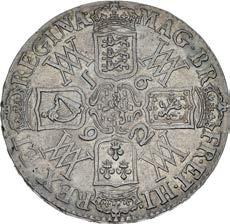
1198. STUART (ORANGE). William III & Mary. 1688-1694. AR Crown. Dated 1692 (over inverted 2) and RY QVINTO. Bull 824; ESC 85; SCBC 3433. Toned. In NGC encapsulation 6909359-005, graded AU 53. ($2000)
From the Alexander Christopher Collection.


1199. STUART (ORANGE). William III. 1694-1702. AR Crown. Dated 1700 and RY DVODECIMO. Third bust variety. Bull 1010; ESC 97; SCBC 3474. Lightly toned with some luster. In NGC encapsulation 6904463-004, graded MS 62. ($1000)
From the Alexander Christopher Collection.




1200. STUART (ORANGE). William III. 1694-1702. Proof AR Farthing. Dated 1699. Peck 682; cf. SCBC 3558 (for business strike in copper). Iridescent toning with underlying luster. In NGC encapsulation 6909490-008, graded PF 62. Rare. ($750)
From the Alexander Christopher Collection.

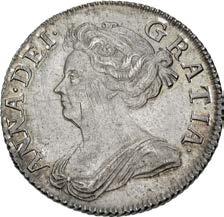

1201. STUART. Anne. 1702-1714. AR Shilling. Dated 1707. Post-Union issue. Bull 1395; ESC 1141; SCBC 3610. Toned. In NGC encapsulation 6909498-015, graded MS 64. ($750)
From the Alexander Christopher Collection.



1202. STUART. Anne. 1702-1714. Proof Pattern Bronzed CU Halfpenny (28mm, 9.86 g, 6h). Tower (London) mint. Struck 1714. ANNA · D : G · MAG : BR · FR : ET · HIB : REG : , crowned and draped bust left / Crown over thistle and rose grown from same stem. Edge: plain. Peck 726 var. (edge and finish). In NGC encapsulation 6909490-012, graded PF 62 BN. ($600)
From the Alexander Christopher Collection.



1203. HANOVER. George I. 1714-1727. AR Crown. Dated 1726 and RY D. TERTIO. Roses & plumes in angles. Bull 1546; ESC 115; SCBC 3639A. Toned with underlying luster. In NGC encapsulation 6909498-008, graded AU 58. ($2000)
From the Alexander Christopher Collection.




1204. HANOVER. George II. 1727-1760. AR Halfcrown. Dated 1750 and RY V. QVARTO. Old head. Bull 1692; ESC 609; SCBC 3696. Iridescent toning. In NGC encapsulation 6909390-006, graded MS 63. ($1000)
From the Alexander Christopher Collection.
1205. HANOVER. George II. 1727-1760. Proof CU Halfpenny. Dated 1729. Thick flan. Peck 835; cf. SCBC 3717 (for business strike). In NGC encapsulation 6898674-010, graded PF 63 BN. ($750)
From the Alexander Christopher Collection.
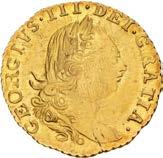



1206. HANOVER. George III. 1760-1820. Pattern AV Third Guinea (18mm, 2.85 g, 6h). Tower (London) mint. Dies by Richard Yeo. Dated 1775. GEORGIVS · III · DEI · GRATIA · , laureate head right / · MAG · BRI
FR
ET
HIB
REX
17 75, crowned lion standing left, head facing, atop crown. Edge: grained. W&R 136; Bull, Gold 883. Lustrous, hairlines and light scratches. AU. ($1500)
From the Alexander Christopher Collection.

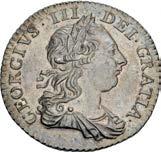


1207. HANOVER. George III. 1760-1820. AR Shilling. Dated 1763. Young head. ‘Northumberland’ type. Bull 2124; ESC 1214; ESC 3742. Iridescent toning. In NGC encapsulation 6907997-008, graded MS 63. ($1000)
From the Alexander Christopher Collection.


1208. HANOVER. George III. 1760-1820. Proof Pattern Bronzed CU Halfpenny (16.30 g). Soho (Birmingham) mint. Dies by Droz. Dated 1790. Late Soho strike. GEORGIVS III ◊ D ◊ G ◊ REX (tassel), laureate head right; DROZ F in incuse on truncation / BRITAN NIA (tassel), Britannia seated left on globe, holding spear, raising arm and resting other on shield; 1790 ◊ in exergue. Edge: RENDER TO CESAR THE THIN GS WHICH ARE CE SARS :. Peck 971. In NGC encapsulation 6909490-001, graded PF 62 BN. ($500)
From the Alexander Christopher Collection.


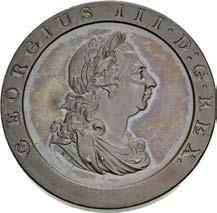

1209. HANOVER. George III. 1760-1820. Proof Bronzed CU Twopence. ‘Cartwheel’ type. Soho (Birmingham) mint. Dated 1797. Late Soho strike. Peck 1068; SCBC 3776. In NGC encapsulation 6907997-001, graded PF 63 BN. ($750)
From the Alexander Christopher Collection.
1210. HANOVER. George III. 1760-1820. Proof Bronzed CU Penny. Soho (Birmingham) mint. Dated 1797. Late Soho strike. Peck 1125; SCBC 3777. In NGC encapsulation 6907997-015, graded PF 64 BN. ($500)
From the Alexander Christopher Collection.



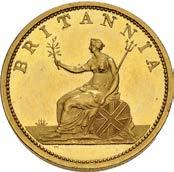
1211. HANOVER. George III. 1760-1820. Proof Gilt CU Penny. Soho (Birmingham) mint. Dated 1806. Late Soho strike. Peck 1322; SCBC 3780. In NGC encapsulation 6907997-002, graded PF 62. ($500)
From the Alexander Christopher Collection.
1212. HANOVER. George III. 1760-1820. Proof Gilt CU Halfpenny. Soho (Birmingham) mint. Dated 1806. Early Soho strike. Peck 1357; SCBC 3781. In NGC encapsulation 6907997-003, graded PF 63. ($500)
From the Alexander Christopher Collection.




1213. HANOVER. George III. 1760-1820. Proof Gilt CU Farthing. Soho (Birmingham) mint. Dated 1806. Early Soho strike. Peck 1387; SCBC 3782. In NGC encapsulation 6907997-005, graded PF 65 Cameo. ($500)
From the Alexander Christopher Collection.
1214. HANOVER. George III. 1760-1820. Proof AR 1 Shilling Sixpence. Bank of England issue. Dated 1811. Bull 2113; ESC 970; SCBC 3771. In NGC encapsulation 6907997-011, graded PF 64 Ultra Cameo. ($500)
From the Alexander Christopher Collection.




From the Alexander Christopher Collection.



From the Alexander Christopher Collection.
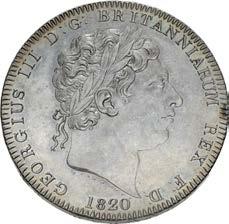


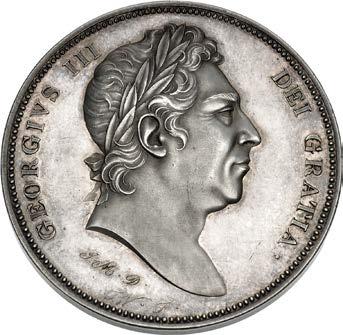



1218. HANOVER. George III. 1760-1820. Proof Pattern AR Crown (37mm, 28.12 g, 12h). Dies by Webb & Mills. Struck for James Mudie, 1820. GEORGIVS III DEI GRATIA, laureate head right / Crowned cruciform coat-of-arms around central garter; shamrock, horse, thistle, and rose in angles. Edge: plain. Linecar & Stone 214; Bull 2055; ESC 221. Toned. In NGC encapsulation 6909359-004, graded PF 62. ($2000)
From the Alexander Christopher Collection.




1219. HANOVER. George IV 1820-1830. AR Crown. Dated 1822 and RY TERTIO. Bull 2320; ESC 252; SCBC 3805. Deep iridescent toning. In NGC encapsulation 6908078-011, graded MS 64. ($2000)
From the Alexander Christopher Collection.


1220. HANOVER. George IV. 1820-1830. AR Halfcrown. Dated 1825. Bull 2371; ESCB 639; SCBC 3808. Toned. In NGC encapsulation 6907997-014, graded MS 64. ($500)
From the Alexander Christopher Collection.


1221. HANOVER. George IV. 1820-1830. Proof AR Halfcrown. Dated 1826. Bull 2376; ESCB 647; SCBC 3808. Rich iridescent toning. In NGC encapsulation 2722138-002, graded PF 63. Rare. ($2000)
Ex New York Sale 55 (12 January 2022), lot 1176.
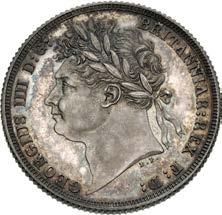

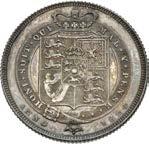
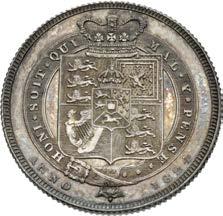
1222. HANOVER. George IV. 1820-1830. Proof AR Shilling. Dated 1824. Edge: milled. Bull 2401 (R4); ESC 1252; SCBC 3811. Deep iridescent toning. In NGC encapsulation 6907997-013, graded PF 64 Cameo. An extremely rare proof issue with perhaps fewer than 20 examples known. Only two in CoinArchives, and seemingly none offered in a major auction since 2005. ($1500)
From the Alexander Christopher Collection. Ex Spink Numismatic Circular XCVIII.1 (February 1990), no. 385.


1223. HANOVER. George IV. 1820-1830. Proof CU Farthing. Dated 1821. Peck 1408; SCBC 3822. Iridescent toning. In NGC encapsulation 6907997-009, graded PF 64 BN. ($500)
From the Alexander Christopher Collection.



1224. HANOVER. William IV. 1830-1837. Proof AR Shilling. Dated 1831. Edge: plain. Bull 2488; ESC 1266; SCBC 3835. In NGC encapsulation 6907997-006, graded PF 63 Cameo. A captivating specimen with deeply toned fields and a striking cameo portrait. ($500)
From the Alexander Christopher Collection.
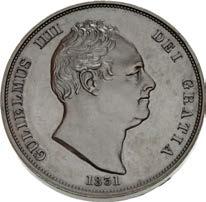

1225. HANOVER. William IV. 1830-1837. Proof Bronzed CU Penny. Dated 1831. Die axis 11h. Peck 1456; SCBC 3845. In NGC encapsulation 6907997-007, graded PF 62 BN. ($500)
From the Alexander Christopher Collection.



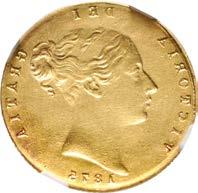
1226. HANOVER. Victoria. 1837-1901. AV Half Sovereign. Obverse brockage. Dated 1875. Marsh 450; SCBC 3860D. In NGC encapsulation 5787818-001, graded Mint Error AU Details, removed from jewelry. Very rare. ($1500)


1227. HANOVER. Victoria. 1837-1901. AR Crown. Dated 1845 and RY VIII. Young head. Bull 2564; ESC 282; SCBC 3882. Toned. In NGC encapsulation 6909498-011, graded AU 58+. ($1000)
From the Alexander Christopher Collection.

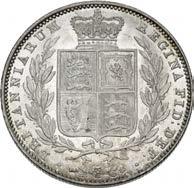
1228. HANOVER. Victoria. 1837-1901. AR Halfcrown. Dated 1849. Young head. Large date. Bull 2370; ESC 682; SCBC 3888. Lustrous with light peripheral iridescence. In NGC encapsulation 6909498-008, graded MS 62. ($500)
From the Alexander Christopher Collection.

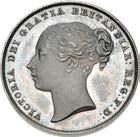


1229. HANOVER. Victoria. 1837-1901. Proof AR Shilling. Dated 1839. Die axis 12h. Edge: plain. Bull 2977; ESC 1282; SCBC 3903. Deep iridescent toning. In NGC encapsulation 6898707-005, graded PF 64 Cameo. Rare. ($1500)
From the Alexander Christopher Collection.



1230. HANOVER. Victoria. 1837-1901. Proof AR Sixpence. Dated 1853. Young head. Edge: reeded. Bull 3190; ESC 1699; SCBC 3908. Iridescent toning. In NGC encapsulation 6909498-010, graded PF 64. ($500)
From the Alexander Christopher Collection.
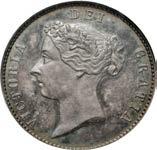

1231. HANOVER. Victoria. 1837-1901. Proof Pattern AR Shilling – Half Florin (22m, 6h). By C. Weiner and W. Taylor. Dated 1865 (in Roman numerals). VICTORIA DEI GRATIA, head left, wearing wreath of thistle, rose, and shamrock / HALF FLORIN MDCC CLXV, crowned coat-of-arms within tressure of arches with trefoils at cusps; over long cross moline. Bull 3107; ESC 1386. Iridescent toning with strong splashes of blue. In NGC encapsulation 155824-018, graded PF 64. NGC generation 4.0 holder, graded August 1989-1992. ($1500)
From the Alexander Christopher Collection.
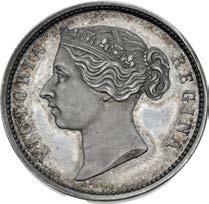

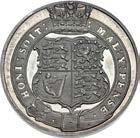

1232. HANOVER. Victoria. 1837-1901. Proof Pattern AR Shilling (22mm, 6.28 g, 6h). By C. Weiner and W. Taylor. Struck 1865. VICTORIA REGINA, crowned head left / Crowned coat-of-arms within garter inscribed HONI : SOIT : MAL : Y : PENSE. Bull 3121; ESC 1395. Toned. In NGC encapsulation 6909490-003, graded PF 64. ($2000)
From the Alexander Christopher Collection.
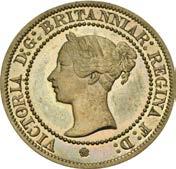



1233. HANOVER. Victoria. 1837-1901. Proof Pattern CU-NI Cent (19mm, 4.35 g, 12h). London mint. Dies by J. Wyon(?). Struck 1859. (rosette) VICTORIA D : G :BRITANNIAR : REGINA : F : D :, laureate head left / ONE/ CENT within wreath. Peck 2005 var. (metal); Freeman 709. In NGC encapsulation 6909490-006, graded PF 64. Extremely rare. ($1000)
From the Alexander Christopher Collection.


1234. HANOVER. Victoria. 1837-1901. Proof Pattern Bronzed CU Penny (29mm, 11.00 g, 12h). Dies by J. Moore. Dated 1860, though an 1886 restrike. VICTORIA QUEEN · 1860 ·, laureate head left / Britannia seated left on rock, holding trident and olive branch, resting hand on shield. Peck 2133. In NGC encapsulation 6909490-004, graded PF 63 BN. ($500)
From the Alexander Christopher Collection.

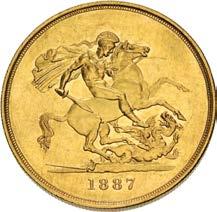
1235. HANOVER. Victoria. 1837-1901. AV Five Pounds. Dated 1887. Jubilee type. SCBC 3864. Lustrous. In PCGS encapsulation 49542287, graded UNC Details, spot removed. ($2000)


1236. HANOVER. Victoria. 1837-1901. AV Two Pounds. Dated 1887. Jubilee type. SCBC 3865. In NGC encapsulation 6890883-014, graded MS 62. ($750)
From the Alexander Christopher Collection.
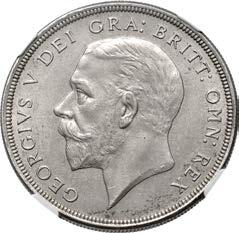

1237. WINDSOR. George V. 1910-1936. Proof AR Crown. Dated 1928. Bull 3634 (R5); ESC 368A; SCBC 4036. Exceptionally well struck with considerable brilliance in fields. In NGC encapsulation 6473207-009, graded MS 64+, though in our opinion a very rare proof striking. LOT SOLD AS IS, NO RETURNS. ($1500)
Ex Gainsborough Collection (Classical Numismatic Group 121, 6 October 2022), lot 1426; Spink 168 (15 April 2004), lot 300 (there in PCGS encapsulation graded PR64).
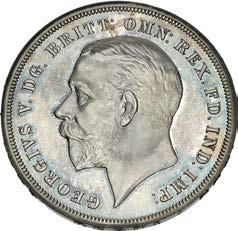

1238. WINDSOR. George V. 1910-1936. Proof AR Crown. Dated 1935. St. George and dragon type. Raised edge lettering. Bull 3655; ESC 378; SCBC 4048. Iridescent toning. In NGC encapsulation 6898707-008, graded PF 65 Cameo ($1500)
From the Alexander Christopher Collection.


1239. SCOTLAND. David I. 1124-1153. AR Penny (20.5mm, 1.36 g). Phase D. Uncertain mint. Posthumous issue, struck 1153-1165. Crowned bust right, scepter before / Cross fleurée; pellets in angles. Burns 16 (fig. 16; same dies); SCBI 35 (Ashmolean & Hunterian) 10 (same dies); SCBC 5009. Toned. In NGC encapsulation 6330848-002, graded XF 45. Rare. ($1500)
Ex Historical Scholar (Heritage 61305, 22 January 2023), lot 23276; James & Martha Robertson (Classical Numismatic Group 114, 13 May 2020), lot 1370; Arthur M. Fitts III (Classical Numismatic Group 103, 14 September 2016), lot 1213; A. Sutherland (Spink 64, 23 June 1988), lot 2.
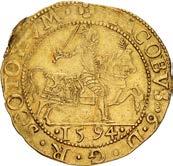


1240. SCOTLAND. James VI. 1567-1625. AV Rider (28mm, 5.05 g, 4h). Seventh coinage. Edinburgh mint. Dated 1594. Armored figure of James riding right on caparisoned horse, holding sword and reins / Crowned coat-of-arms. Burns 4-5; SCBI 58 (Edinburgh), 1278-82; SCBC 5458. Minor scratches, slightly ragged flan. Good VF. ($2000)
From the Alexander Christopher Collection.



1241. SCOTLAND. James VI. 1567-1625. AR Ryal – Sword Dollar (41mm, 7h). First coinage. Edinburgh mint. Dated 1567. Crowned coat-of-arms; crowned I R flanking / Crowned upright sword; pointing hand to upper left, XXX (mark of value) to upper right. Burns 2 (fig. 921); SCBI 58 (Edinburgh), 1329-31; SCBC 5472. Old collection toning with splashes of golden color in legends. In NGC encapsulation 2311759-007, graded XF 40. ($1000) Ex Heritage 3109 (17 August 2023), lot 33171 (hammer $2400).





1243. SCOTLAND. James VIII. Pretender, 1688-1766. Pattern AR Guinea (27mm, 6.46 g, 5h). Matthew Young restrike. Dies by J. Roettiers. Dated 1716, but struck 1828. IACOBVS · III · DEI · GRATIA, laureate and draped bust right / SCO AN · FRA ET · HIB REX · 17 16 ·, crowned cruciform coats-of-arms with thistle at center; scepters in angles. Woolf 33.2; Burns 2 (fig. 1095); SCBC 5725. Deep iridescent toning. In NGC encapsulation 6909490-007, graded MS 62. ($500)
From the Alexander Christopher Collection.
Although the dies were engraved in 1716 by Roettiers, no specimens are known to have been struck at that time. All extant examples were struck by the celebrated coin dealer Matthew Young in 1828. Young presented the dies to the British Museum in 1829.



1244. SCOTLAND. James VIII. Pretender, 1688-1766. Pattern AR Crown (41mm, 28.42 g, 5h). Matthew Young restrike. Dies by J. Roettiers. Dated 1716, but struck 1828. IACOBVS · VIII · · DEI · GRATIA ·, laureate and draped bust right / SCOT · ANGL · FRAN · ET · HIB · REX · 17 16 ·, crowned coat-of-arms. Woolf 33.1; Burns 1 (fig. 1094); SCBC 5731. Deep iridescent toning, usual die rust as evident on all examples. In NGC encapsulation 6909490-005, graded MS 63. Very rare. Burns notes that only 60 examples were struck in silver. ($1500)
From the Alexander Christopher Collection.



1245. IRELAND, Hiberno-Norse. Phase III. Circa 1035-1055/60. AR Penny (18mm, 0.91 g). Phase III coinage. Imitating the Long Cross type of Æthelred II. Uncertain mint signature and moneyer. Draped bust right; quatrefoil on neck / Voided long cross, with triple crescent ends; ‘hand’ in first angle, retrograde S in third, pellet in second and fourth. SCBI 8 (BM), 108 (same rev. die); SCBI 22 (Copenhagen), 209; SCBI 32 (Ulster), 279 (same dies); SCBC 6133. Toned, slightly wavy flan. Near EF. ($750)
From the Alexander Christopher Collection.




1246. IRELAND. James II. 1685-1691. Proof AR Halfpenny. Emergency ‘Pewter Money’ coinage. Dated 1690. D&F 483; SCBC 6591A. Toned. In NGC encapsulation 6909515-008, graded PF 58. ($1000)
From the Alexander Christopher Collection.
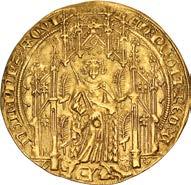
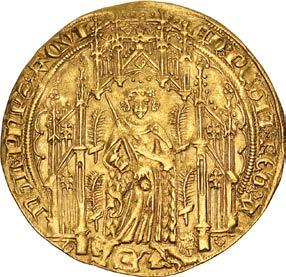
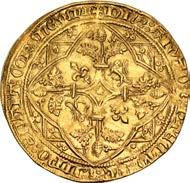
1247. ANGLO-GALLIC. Edward the Black Prince. As Prince of Aquitaine, 1362-1372. AV Noble guyennois à la rose – Pavillon d’or (30mm, 5.35 g, 2h). La Rochelle mint. Struck 1362(?). Edward wearing rose wreath, standing facing, holding sword up in right hand and raising left hand; at feet, two leopards couchant; to left and right, two ostrich feathers with tips curved inward; all within ornate Gothic portico / Ornate cross quernée with rose in center, lion passant and lis in opposite quarters; all within arched quatrefoil set on quadrate frame with roses in angles; pelleted cinquefoils in spandrals. AGC 157A, 4/c; cf. Schneider 44-8 (for type); SCBC 8123. In NGC encapsulation 6865696-047, graded MS 61. ($5000)




1248. HANOVER. George I. 1714-1727. AV Medal (35mm, 23.62 g, 12h). Coronation. By J. Croker. Dated 20 October 1714 (in Roman numerals). GEORGIVS · D : G · MAG · BR · FR · ET · HIB · REX ·, laureate, draped, and armored bust right / George seated right on throne, being crowned by Britannia standing left, holding spear and shield; in two lines in exergue, INAVGVRAT · XX · OCT ·/MDCCXIIII ·. MI 424/9; Eimer 470. In NGC encapsulation 6909383-003, graded MS 62. Very rare. ($10,000)
From the Alexander Christopher Collection.

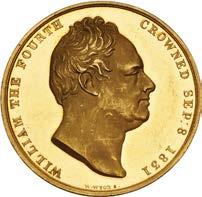


1249. HANOVER. William IV, with Adelaide. 1830-1837. Proof AV Medal (33mm, 26.25 g, 12h). Coronation. London mint. By W. Wyon, after F. Chantrey. Dated 8 September 1831. WILLIAM THE FOURTH CROWNED SEP: 8 1831, head of William right / ADELAIDE. QUEEN CONSORT. CROWNED SEP: 8 1831, diademed head of Adelaide right. BHM 1475; Eimer 1251. In NGC encapsulation 6909383-001, graded PF 62 Ultra Cameo. ($5000)
From the Alexander Christopher Collection.

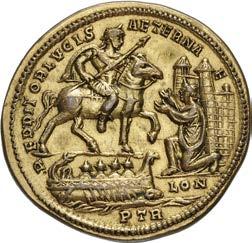
1250. ROMAN IMPERIAL. Constantius I. As Caesar, AD 293-305. Gilt WM Electrotype Medal – Multiple (42.5mm, 23.89 g, 12h). Liberation of London. Electrotype of the now lost medal from the Arras Hoard, discovered in 1922. Made by Étienne Bourgey in Paris, circa 1929. Laureate, draped, and cuirassed bust right / Constantius on horseback right, holding spear, approaching London kneeling in supplication before city gate; below, galley sailing right. Cf. P. Bastien, Le Tresor de Beaurains (dit d’Arras), 218 (for original). As made. Important historical type. Rare Bourgey original. ($1500)
From the Dr. Malcolme Lyne Collection. Ex Classical Numismatic Group Electronic Auction 460 (29 January 2020), lot 1047.
Photos reduced


1251. ROMAN. Imperial. Papyrus fragment of agricultural accounts. 2nd century AD. Bureaucratic papyrus fragment citing parcels of land and quantities of grain produced for an unknown area in Egypt, possibly to be assessed for taxation. Largely numeric Greek text in two columns on one side and one column only on other, with precise grain measurement down to minute quantities. Professionaly matted and sealed between heavy-duty glass with lot number attached. Dimensions of document: 145x55mm. Overall dimension: 215x163mm. Evidence of insect damage, part of the fragment separated but present, otherwise sizeable fragment. Extremely rare. ($1500)
From the Gerald F. Borrmann (Northern California Gentleman) Collection. Ex Maggs Bros. Ltd. 1059 (1985), lot 6 (catalog included).
End of Session 4
Banti
Please refer to our online bibliography at www.cngcoins.com for a complete listing of specialized and general references used, and abbreviations.
A. Banti. I grandi bronzi imperiali 9 Vols. Florence. 1983-1986.
BMC Various authors. Catalogue of Greek Coins in the British Museum. 29 Vols. London. 1873-1927.
BMCRE
BN
Bodenstedt
H. Mattingly et al. Coins of the Roman Empire in the British Museum. 6 Vols. London. 1932-1962.
J. Giard. Bibliothèque Nationale, catalogue des monnaies de l’empire romain 3 Vols. Paris. 1976-present.
F. Bodenstedt. Die Elektronmünzen von Phokaia und Mytilene. Tübingen. 1981. Boehringer
E. Boehringer Die Münzen von Syrakus. Berlin and Leipzig. 1929. Bopearachchi
O. Bopearachchi. Monnaies Gréco-Bactriennes et Indo-Grecques. Paris. 1991. Depeyrot
G. Depeyrot. Les monnaies d’or (Diocletian à Constantin I, Constantin II à Zenon). Wetteren. 1995-1996. Calicó
X. Calicó. The Roman avrei catalogue 2 Vols. Barcelona. 2002.
CNS R. Calciati. Corpus Nummorum Siculorum: la monetazione di bronzo. 3 Vols. Italy. 1983-87. Crawford M. Crawford. Roman Republican Coinage. 2 Vols. Cambridge. 1974.
CRI
D. Sear The History and Coinage of the Roman Imperators 49-27 BC. London. 1998. Fischer-Bossert
W. Fischer-Bossert. Chronologie der Didrachmenprägung von Tarent 510-280 v.Chr. Berlin 1999. Flament
C. Flament. Le monnayage en argent d’Athènes. De l’époque archaïque à l’époque hellénistique (c. 550-c. 40 av. J.-C.). Lovainla-Neuve. 2007.
Hendin D. Hendin. Guide to Biblical Coins. 6th Edition. New York. 2021. HN Italy
N.K. Rutter, ed. Historia Numorum. Italy. London. 2001.
Kumar S. Kumar. Treasures of the Gupta Empire. A Catalogue of Coins of the Gupta Dynasty. San Francisco. 2017. Meshorer
Y. Meshorer. A Treasury of Jewish Coins from the Persian Period to Bar Kokhba. Jerusalem. 2001.
MK R. Göbl. Münzprägung des Kušanreiches. Vienna. 1984.
MIR R. Göbl, et al. Moneta Imperii Romani. Vienna. 1984-present.
Price
M.J. Price. The Coinage in the Name of Alexander the Great and Philip Arrhidaeus. London. 1991.
Prieur M. Prieur A type corpus of the Syro-Phoenician tetradrachms and their fractions from 57 BC to AD 253. Lancaster. 2000.
RIC H. Mattingly, et al. The Roman Imperial Coinage. 10 Vols in 13 Parts. London. 1923-present.
RPC A. Burnett, et al. Roman Provincial Coinage. London and Paris. 1992-present.
RSC D. Sear, et al. Roman Silver Coins 5 Vols. London. 1978-1987.
SC A. Houghton & C. Lorber Seleucid Coins: A Comprehensive Catalog. 2 Parts. Lancaster. 2002 and 2008.
Sellwood D. Sellwood. An Introduction to the Coinage of Parthia. 2nd edition. London. 1980.
SNG ANS Sylloge Nummorum Graecorum, American Numismatic Society. New York. 1969-present.
SNG BM Black Sea Sylloge Nummorum Graecorum, British Museum, 1: The Black Sea. London. 1993.
SNG Copenhagen Sylloge Nummorum Graecorum, Danish National Museum Copenhagen. 1942-1979.
SNG BN Sylloge Nummorum Graecorum, Cabinet des Médailles, Bibliothèque Nationale. Paris. 1993-2001.
SNG Kayhan Sylloge Nummorum Graecorum, Turkey I: The Muharrem Kayhan Collection. 2 Vols. Istanbul. 2002 and 2015.
SNG Levante Sylloge Nummorum Graecorum, Switzerland; E Levante - Cilicia Bern. 1986.
SNG Lloyd Sylloge Nummorum Graecorum, Lloyd Collection. London. 1933-1937.
SNG Lockett Sylloge Nummorum Greacorum, Lockett Collection. London. 1938-1949.
SNG München Sylloge Nummorum Graecorum, München Staatlische Münzsammlung Berlin. 1968-present.
SNG von Aulock Sylloge Nummorum Graecorum, Sammlung Hans Von Aulock. Berlin. 1957-1968.
Starr C. Starr Athenian coinage 480-449 BC. London. 1970.
Svoronos J. Svoronos.
. Athens. 1904-08.
Traité E. Babelon. Traité des monnaies grecques et romaines. 9 Vols. Paris. 1901-1932. Weidauer L. Weidauer. Probleme der frühen Elektronprägung Fribourg. 1975.
Album S. Album. A Checklist of Popular Islamic Coins 3rd ed. Santa Rosa. 2011. Biaggi E. Biaggi. Monete e zecche medievali italiane dal seculo VIII al seculo XV. Torino. 1992. Bitkin V. Bitkin. Composite Catalogue of Russian Coins. 2 vols. Kiev. 2003.
BMC Vandals W. Wroth. Catalogue of the Coins of the Vandals, Ostrogoths and Lombards and of the Empires of Thessalonica, Nicaea and Trebizond in the British Museum. London. 1911. (Reprinted as Western and Provincial Byzantine Coins in the British Museum.) CIS S. Goron and J.P. Goenka. The Coins of the Indian Sultanates. New Delhi. 2001.
CNI Corpus Nummorum Italicorum. 20 Vols. Rome. 1910-1943. Davenport J.S. Davenport. Various works on European crowns.
ESC H.A. Seaby & P.A. Rayner. The English Silver Coinage from 1649 London. 1992. Friedberg R. Friedberg. Gold Coins of the World. 8th ed. Clifton. 2009.
KM C.L. Krause & C. Mishler Standard Catalogue of World Coins. Krause Publications. Iola. Levinson R.A. Levinson. The Early Dated Coins of Europe. Clifton, NJ. 2007. Lunardi G. Lunardi. Le monete delle repubblica di genova. Genoa. 1975.
MEC P. Grierson & M. Blackburn. Medieval European Coinage. Cambridge. 1986.
MIB W. Hahn. Moneta Imperii Byzantini 3 Vols. Vienna. 1973-81.
MIBE W. Hahn and M.A. Metlich. Money of the Incipient Byzantine Empire. Vienna. 2000.
MIR Various. Monete Italiane Regionali. 5 Vols. Pavia. ND.
NM G. Depeyrot. Le numéraire mérovingien. 5 vols. Wetteren. 1998-2001.
North J.J. North. English Hammered Coinage. 2 Vols. London. 1963, 1975.
SB D. Sear, et al. Byzantine Coins and Their Values 2nd edition. London. 1987.
SCBC Standard Catalogue of British Coins. London. Annually.
SCBI Various authors. Sylloge of the Coins of the British Isles.


